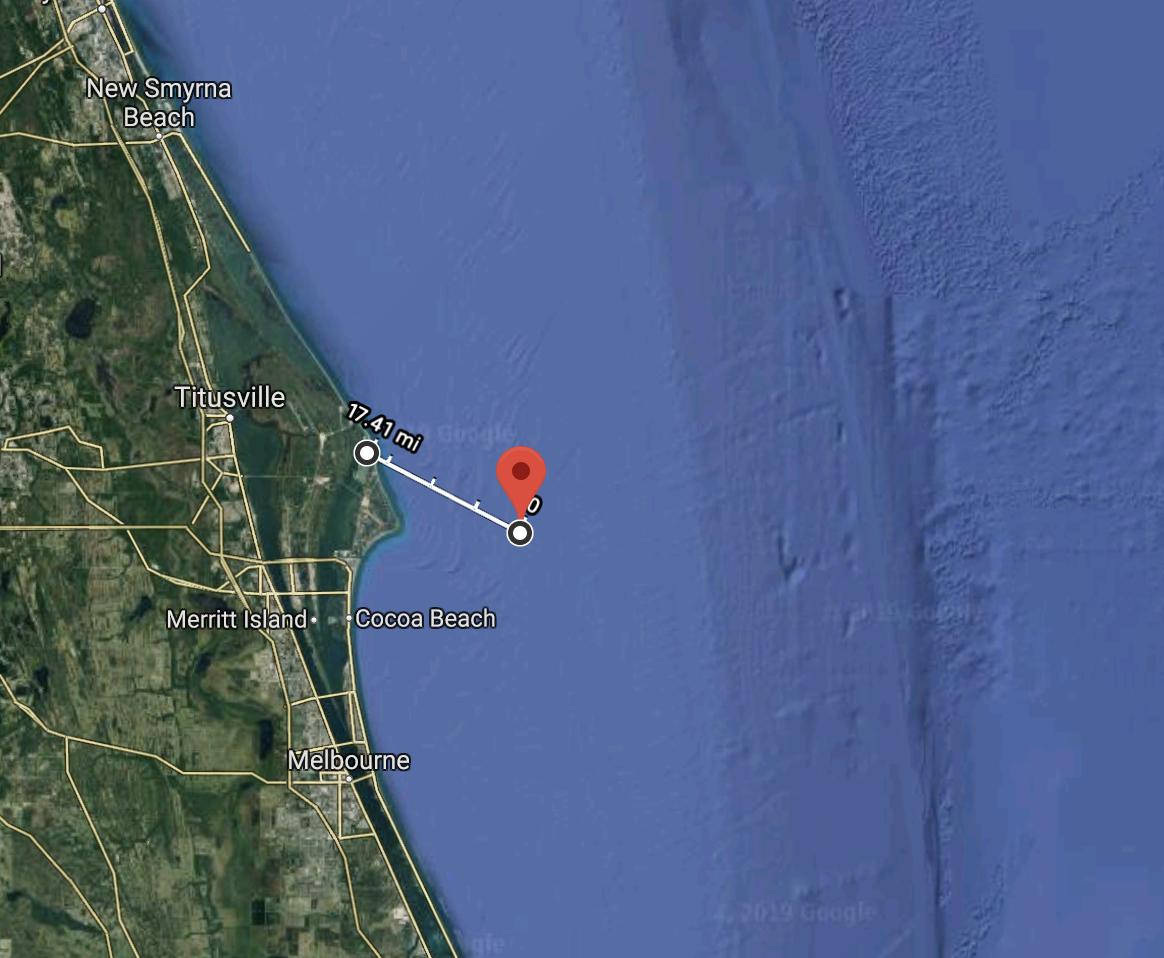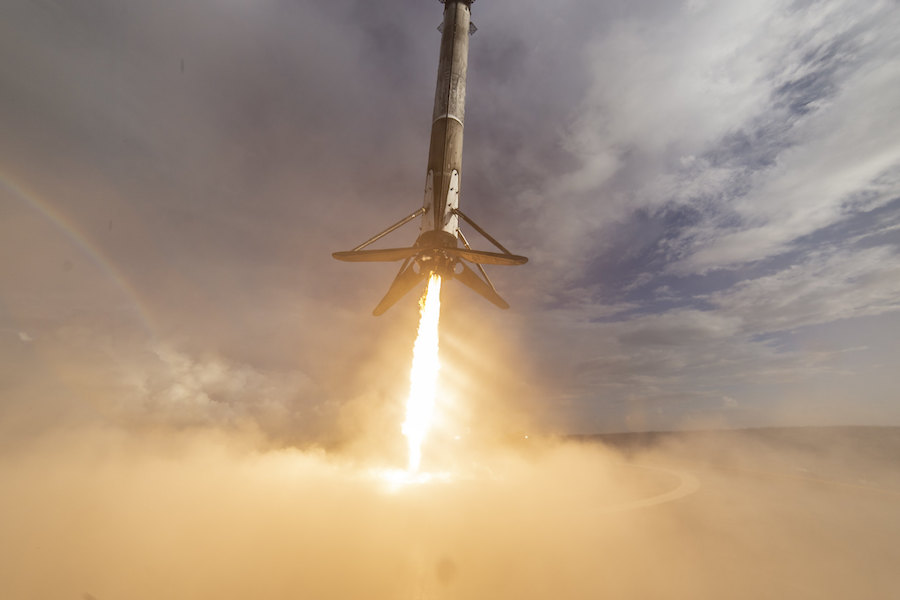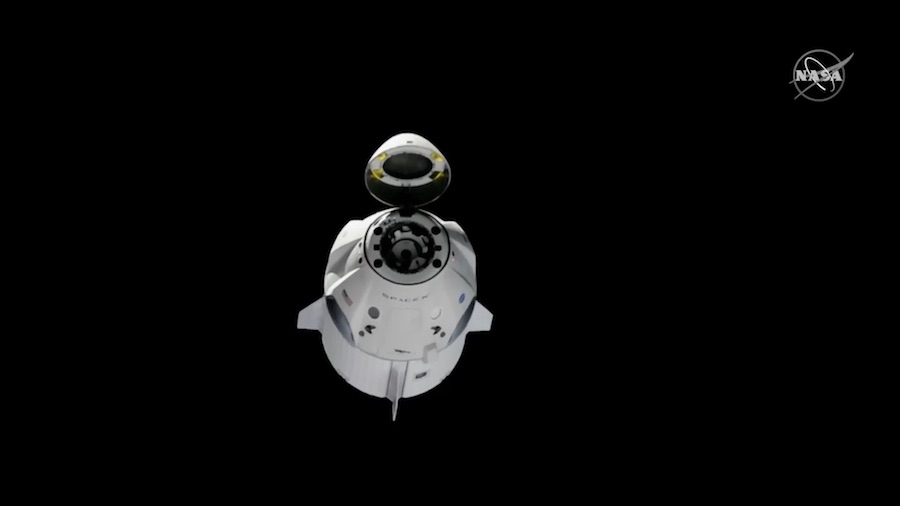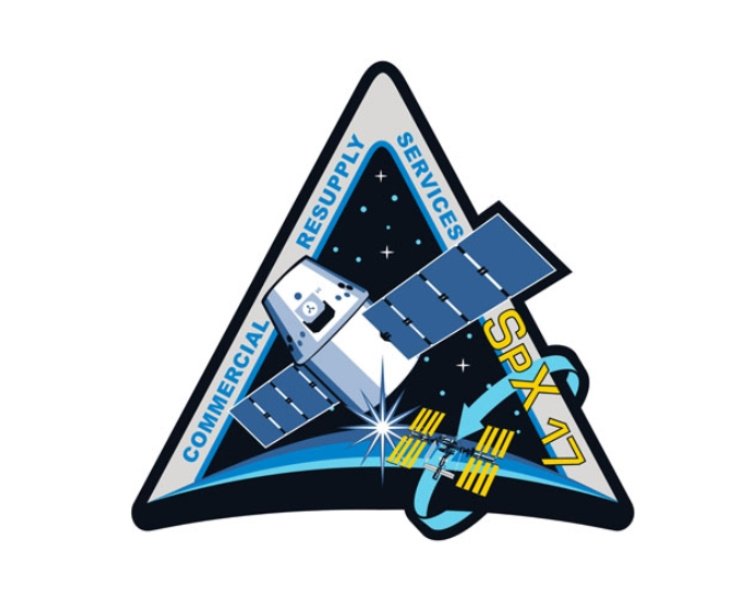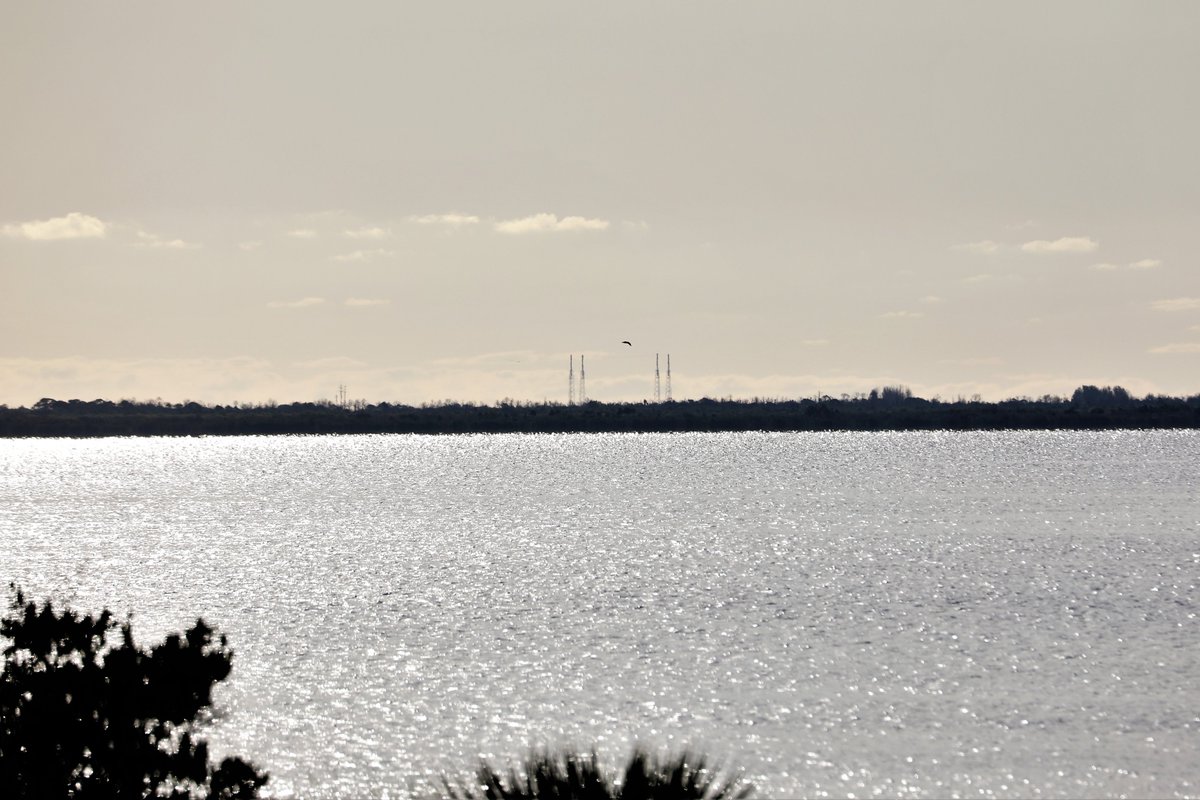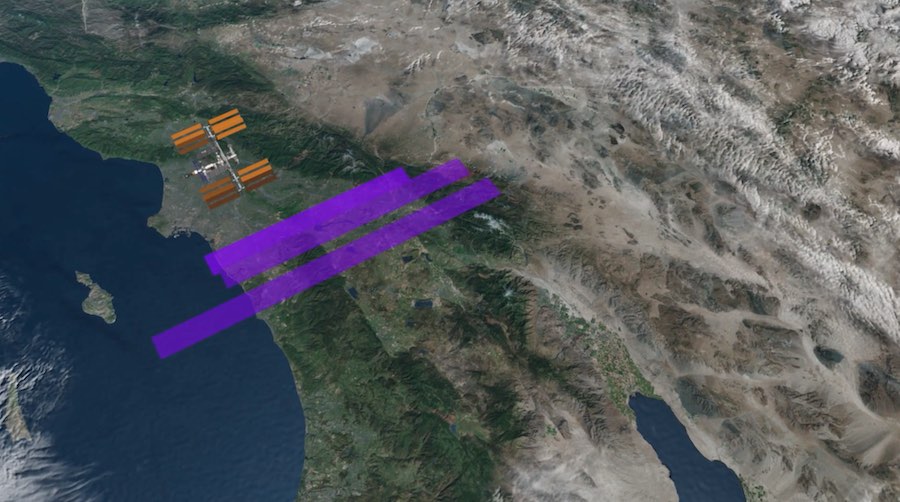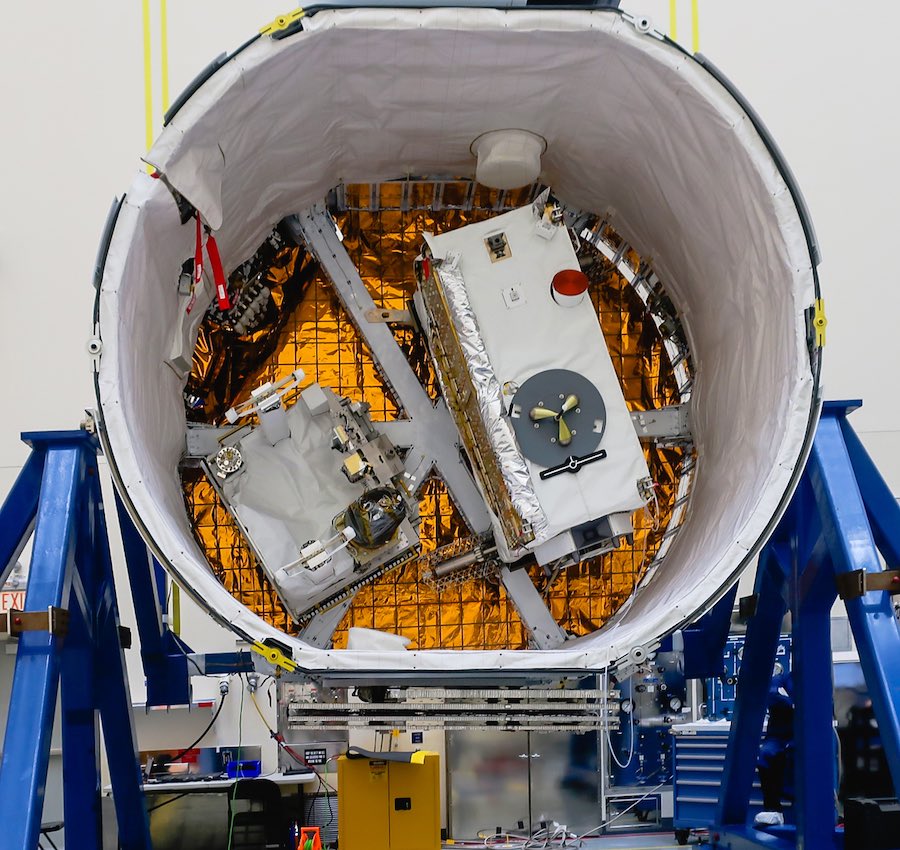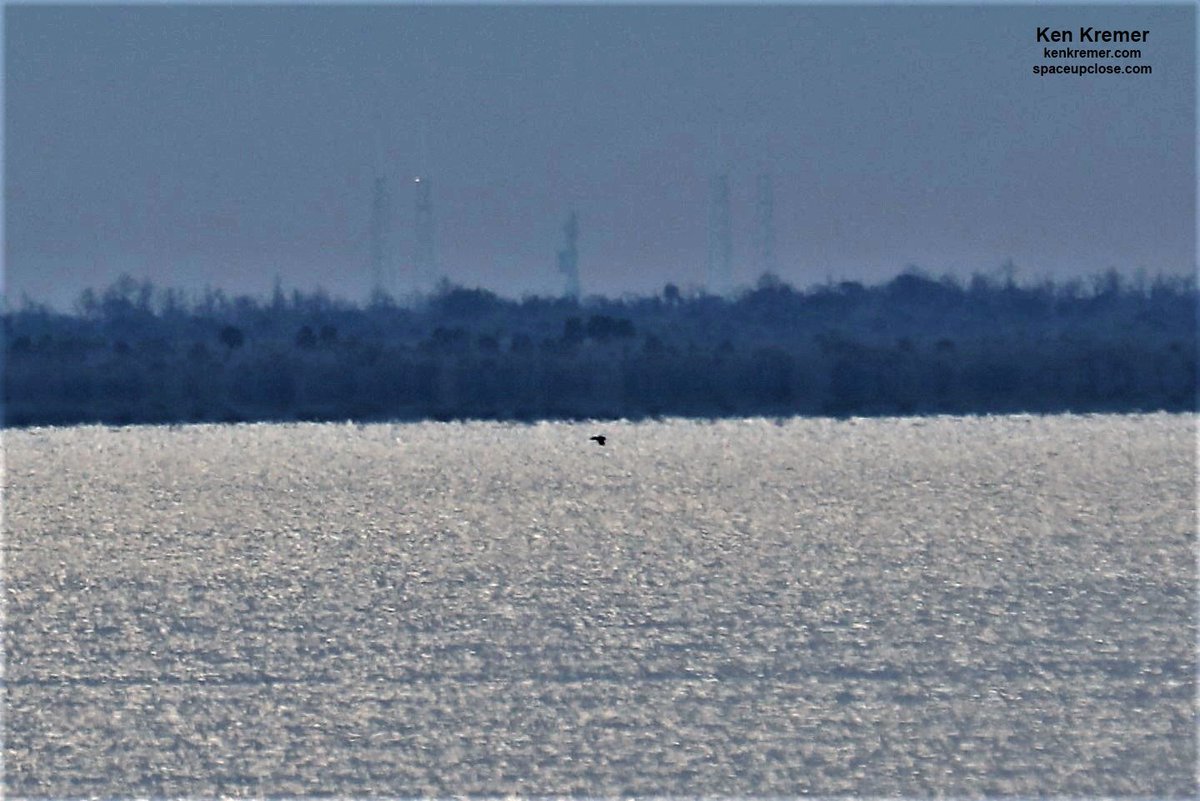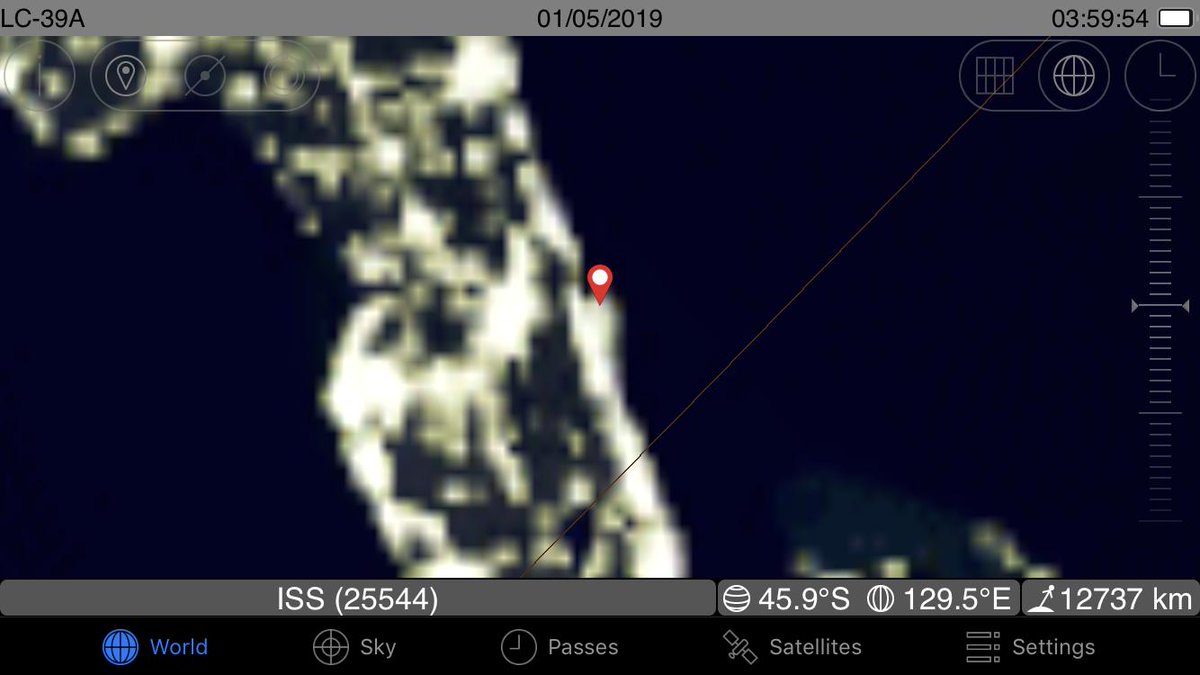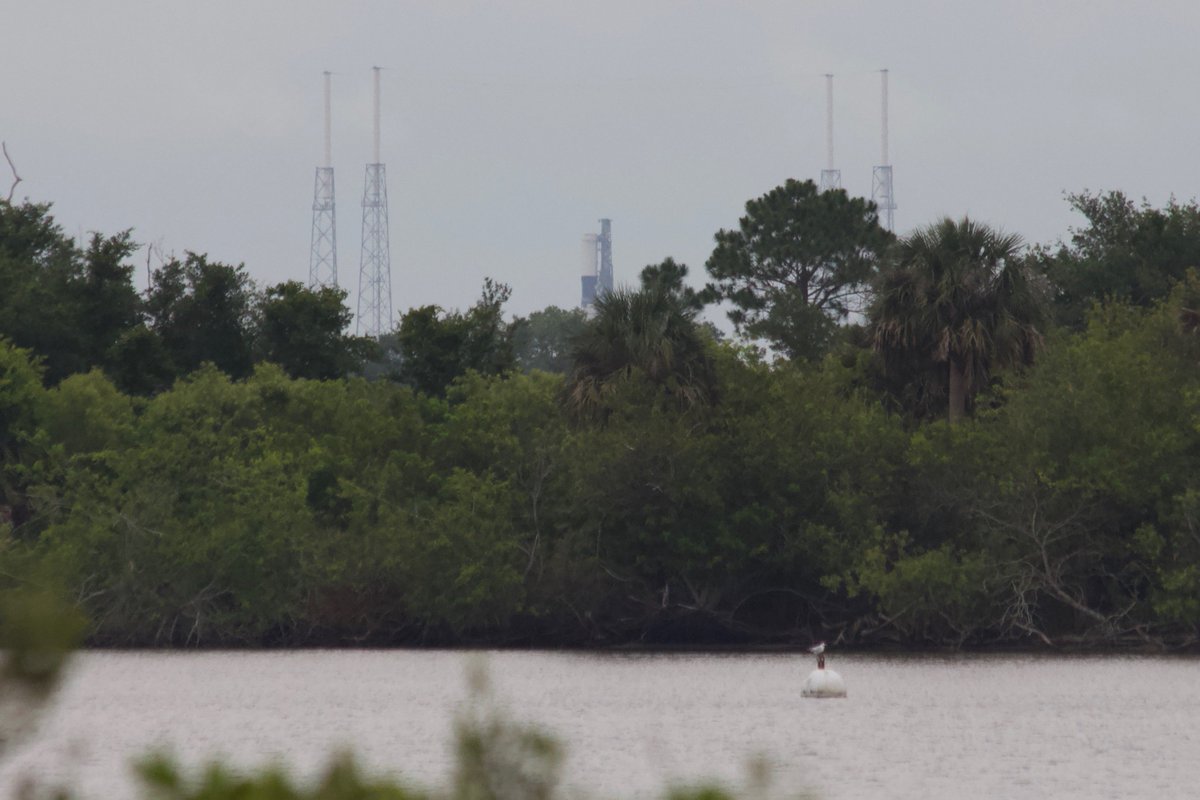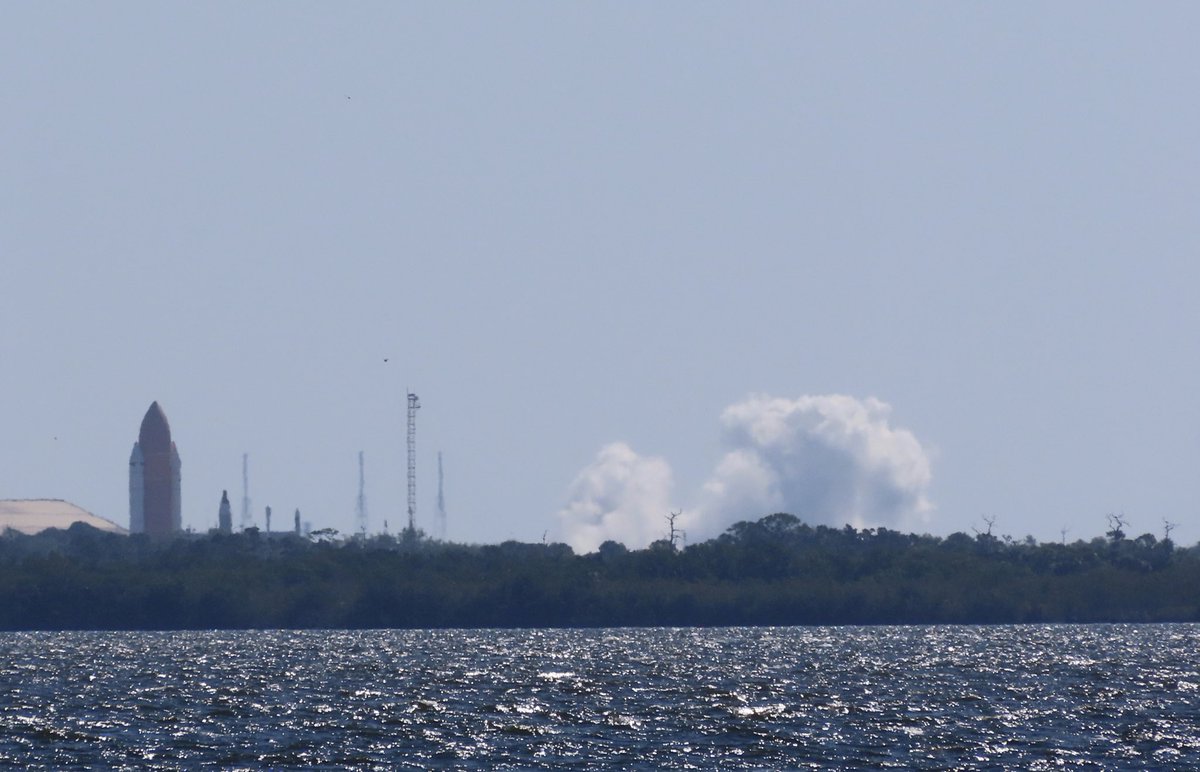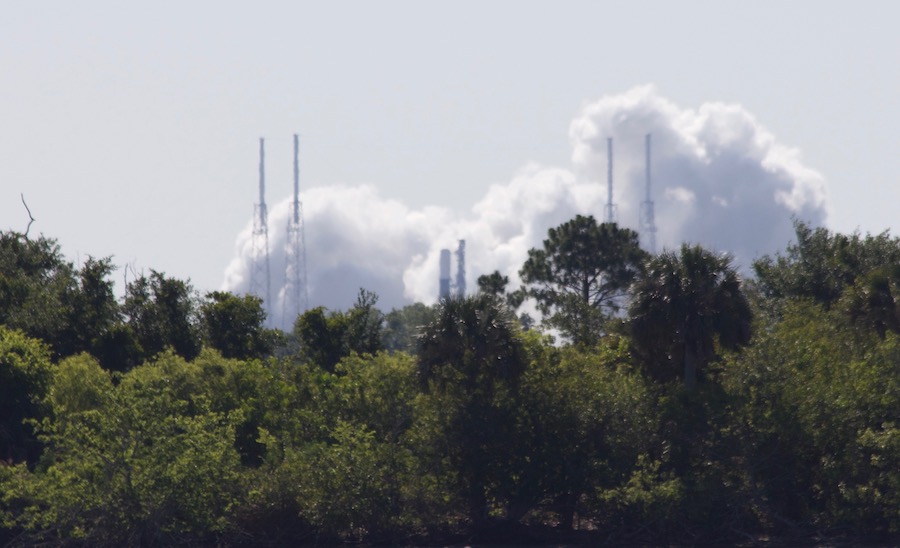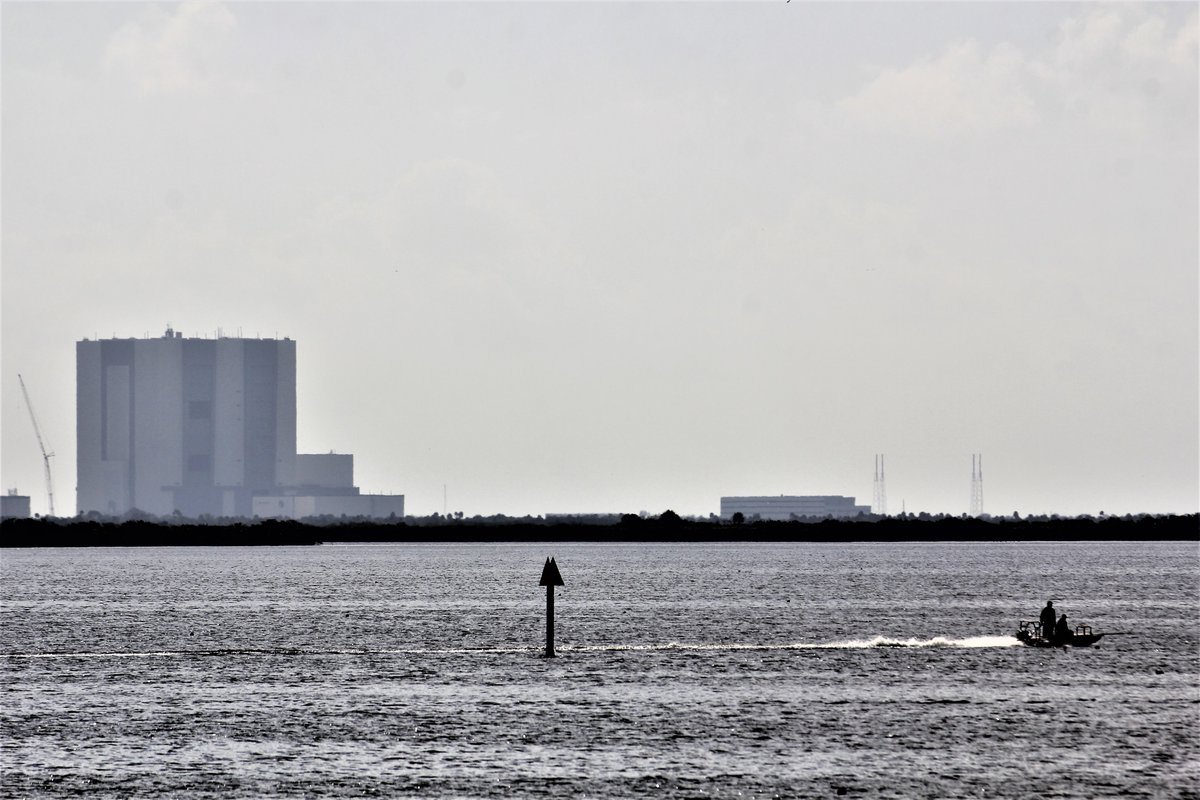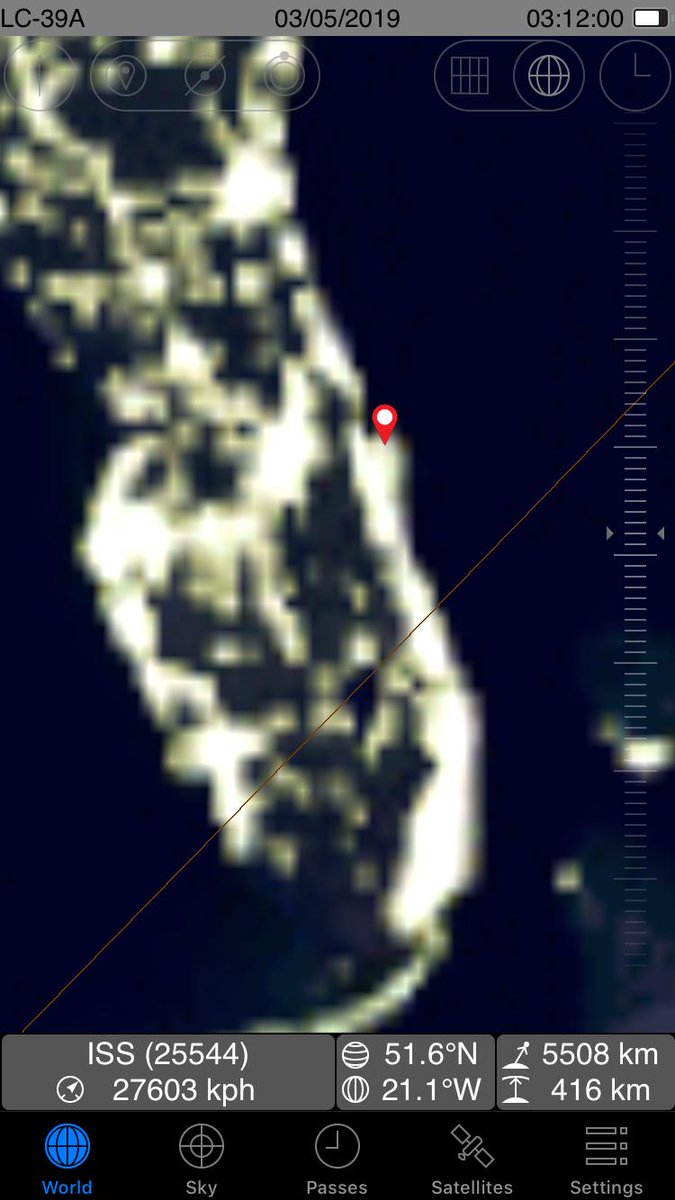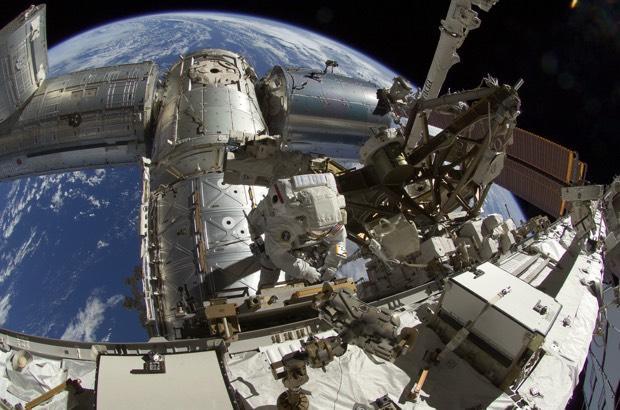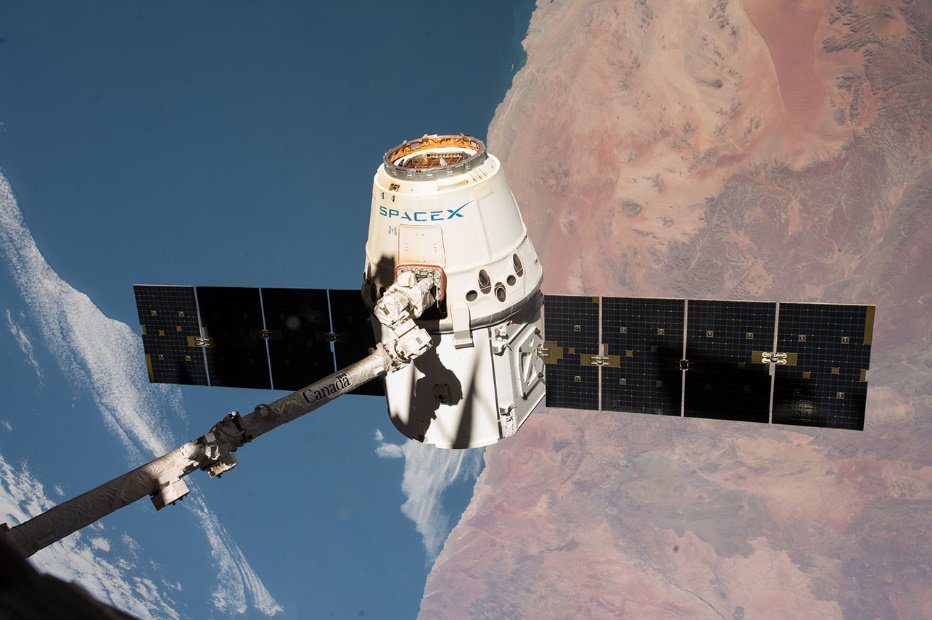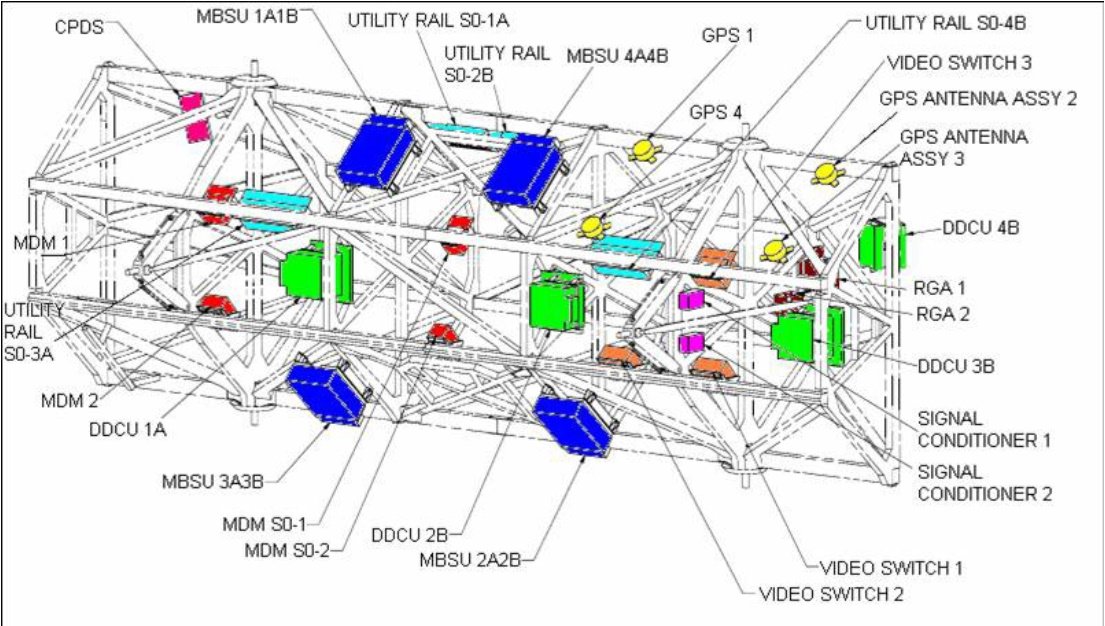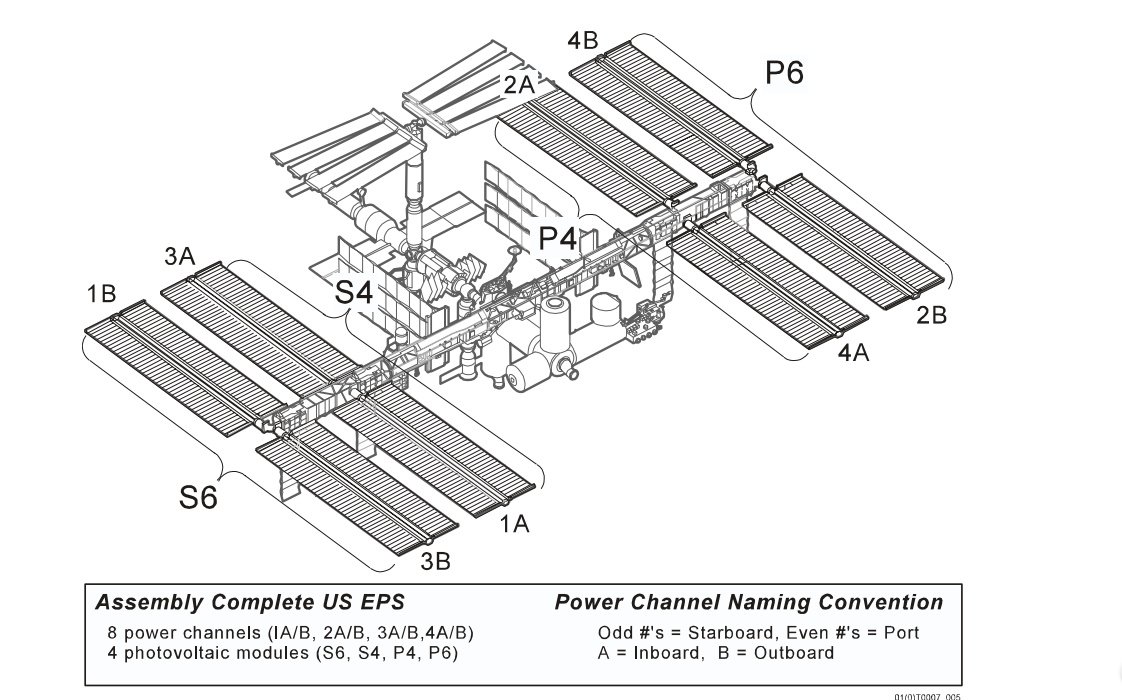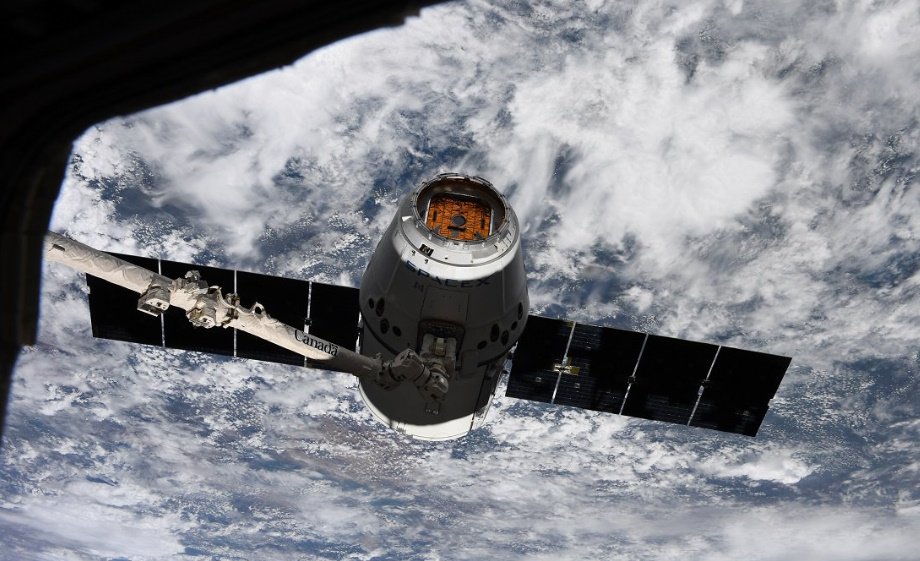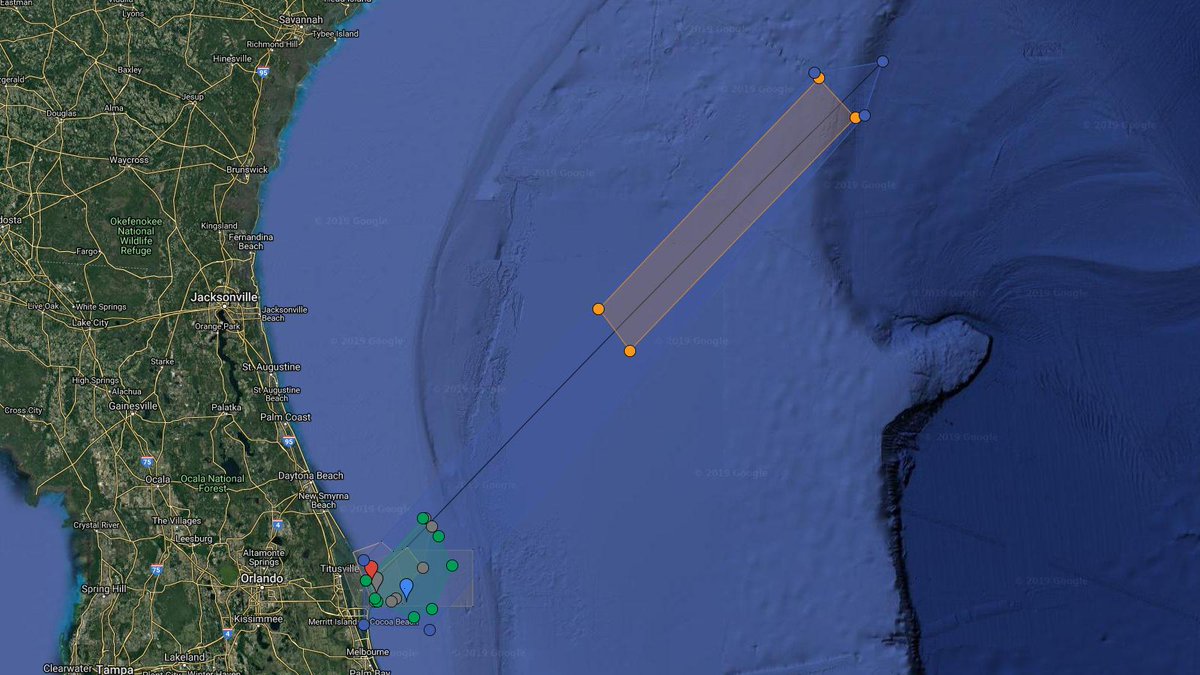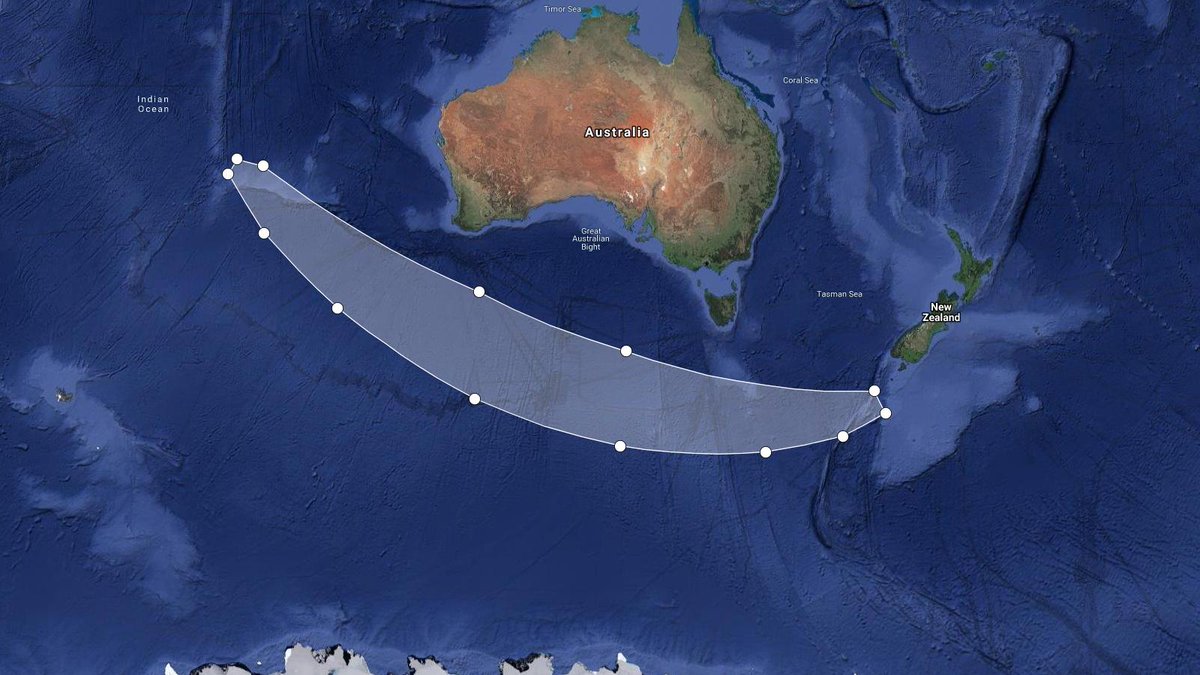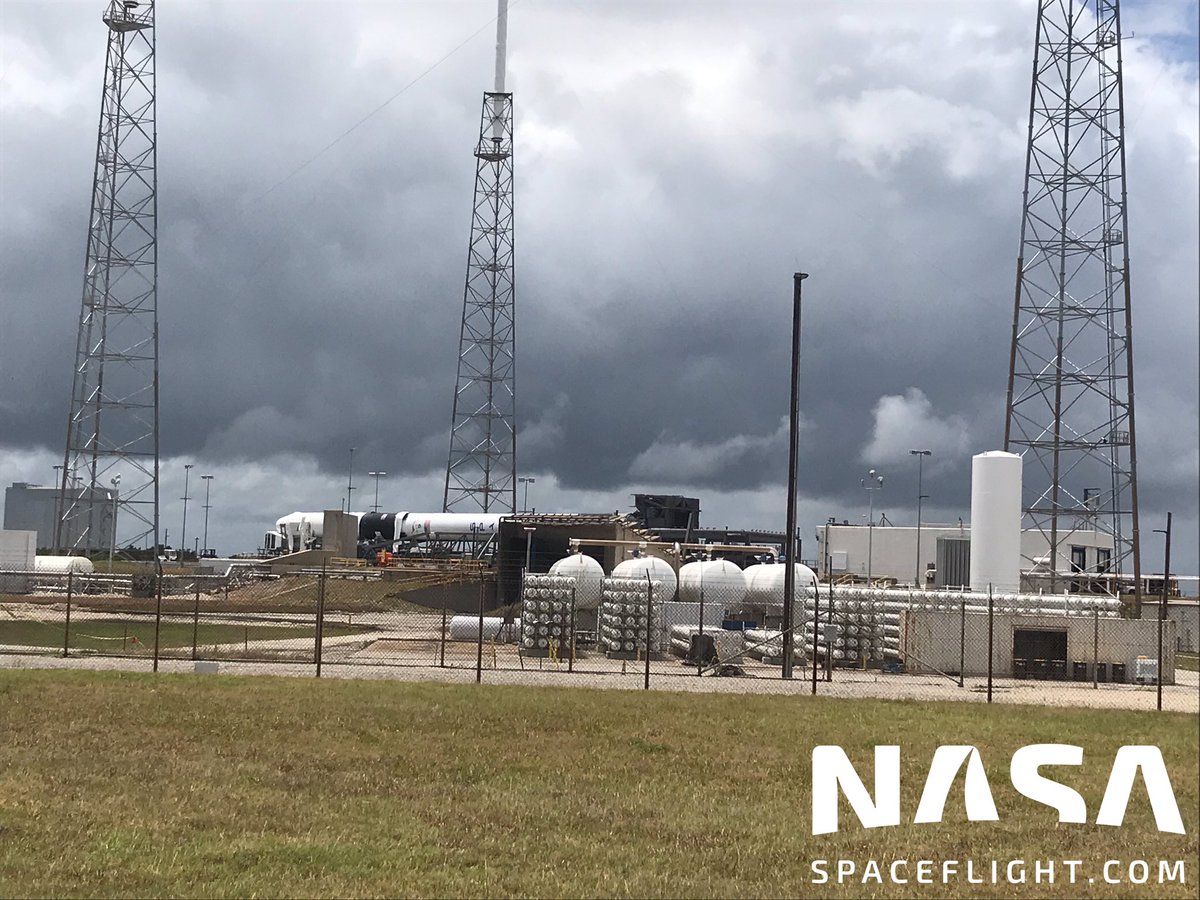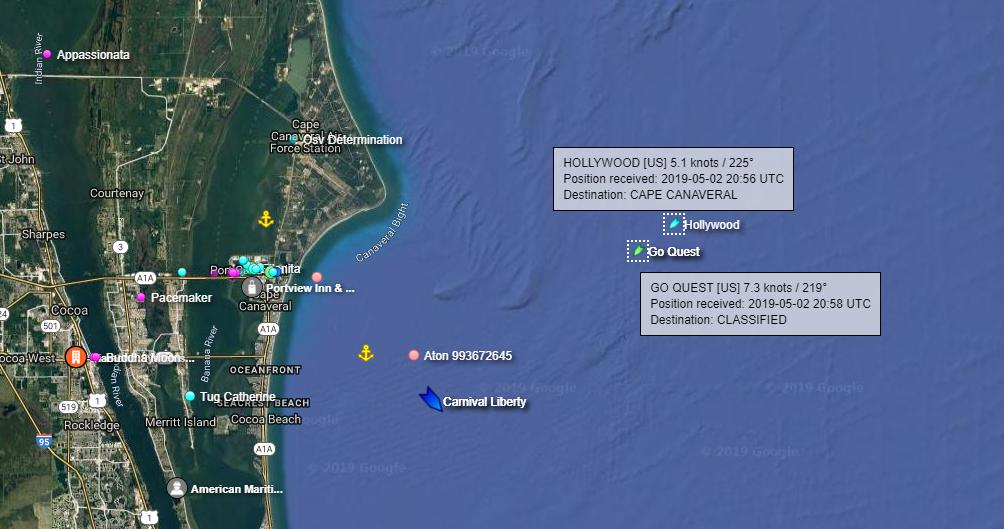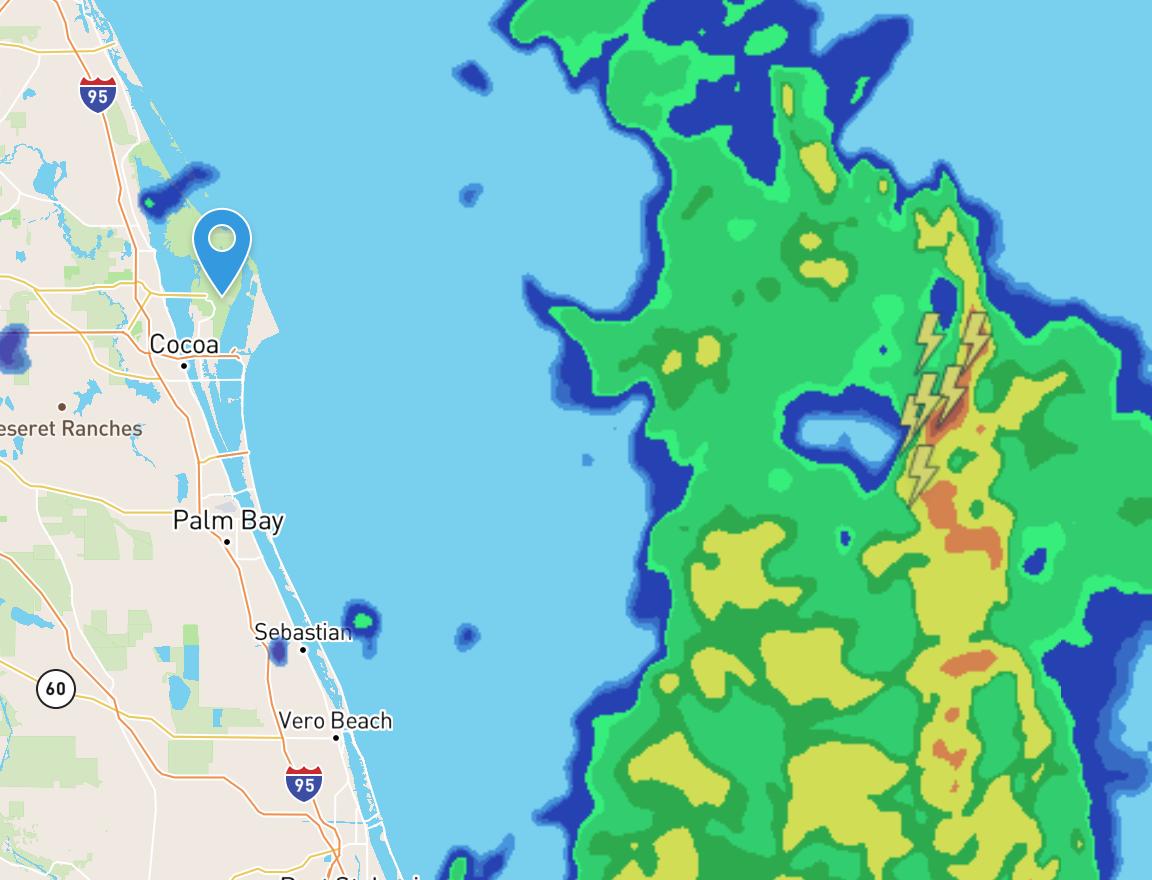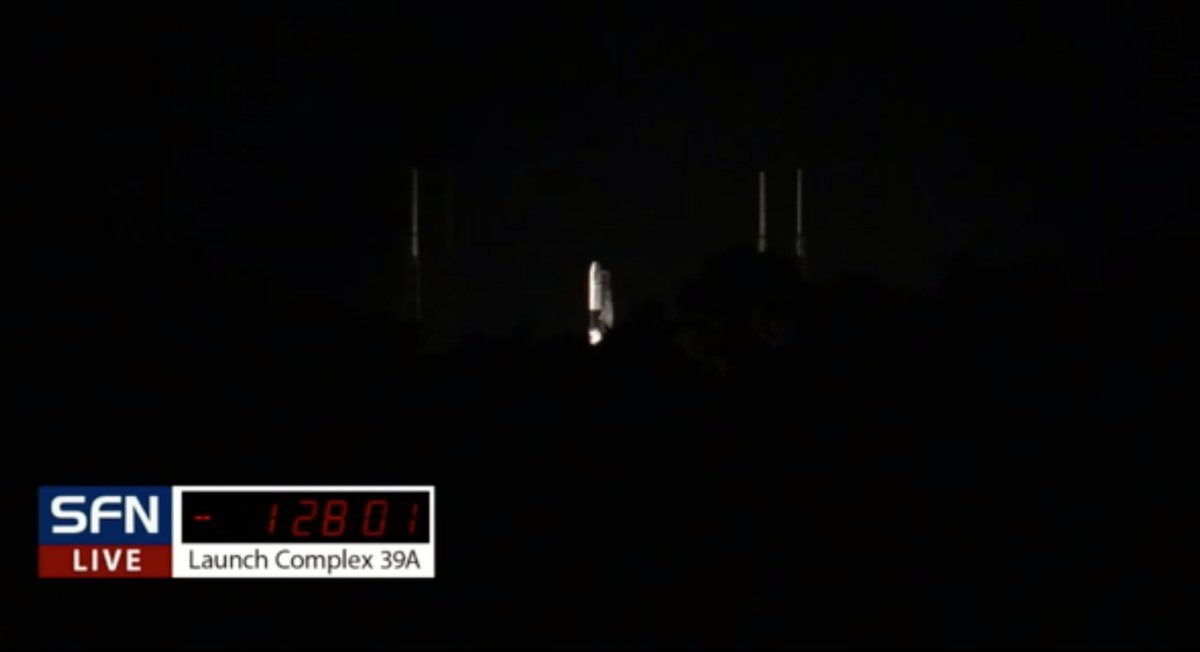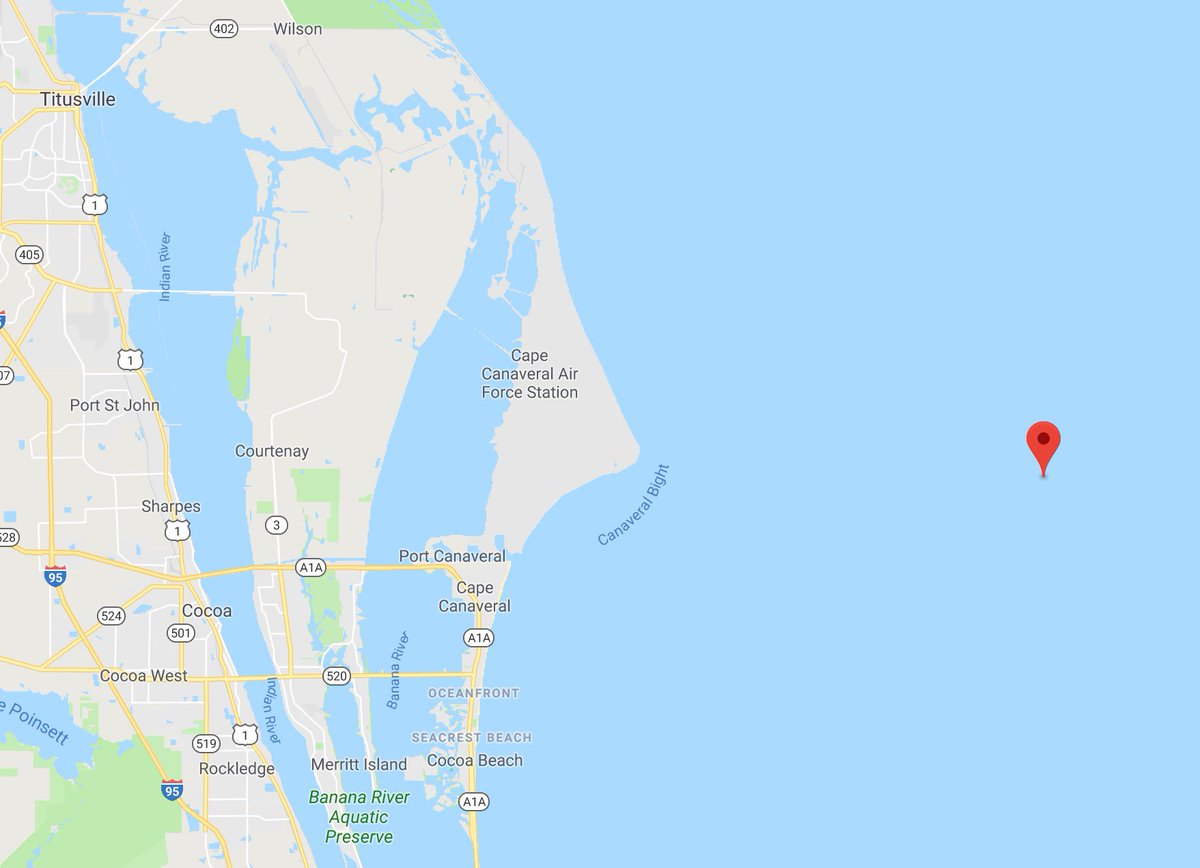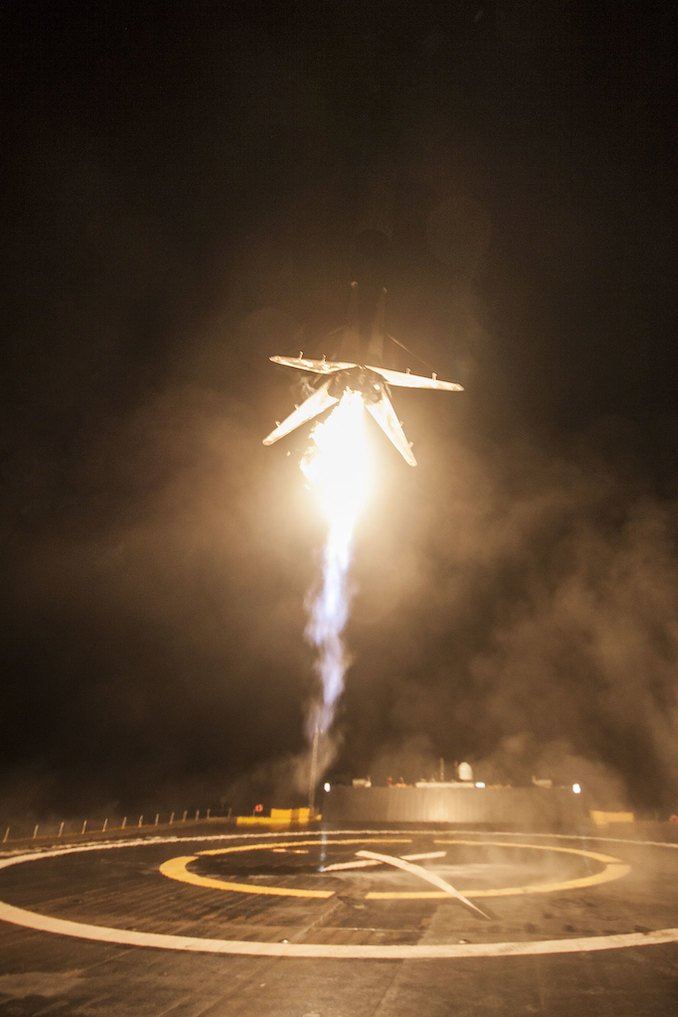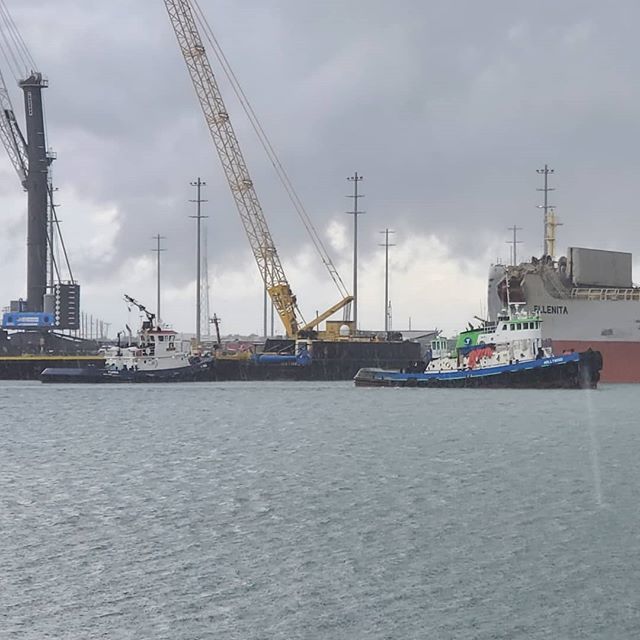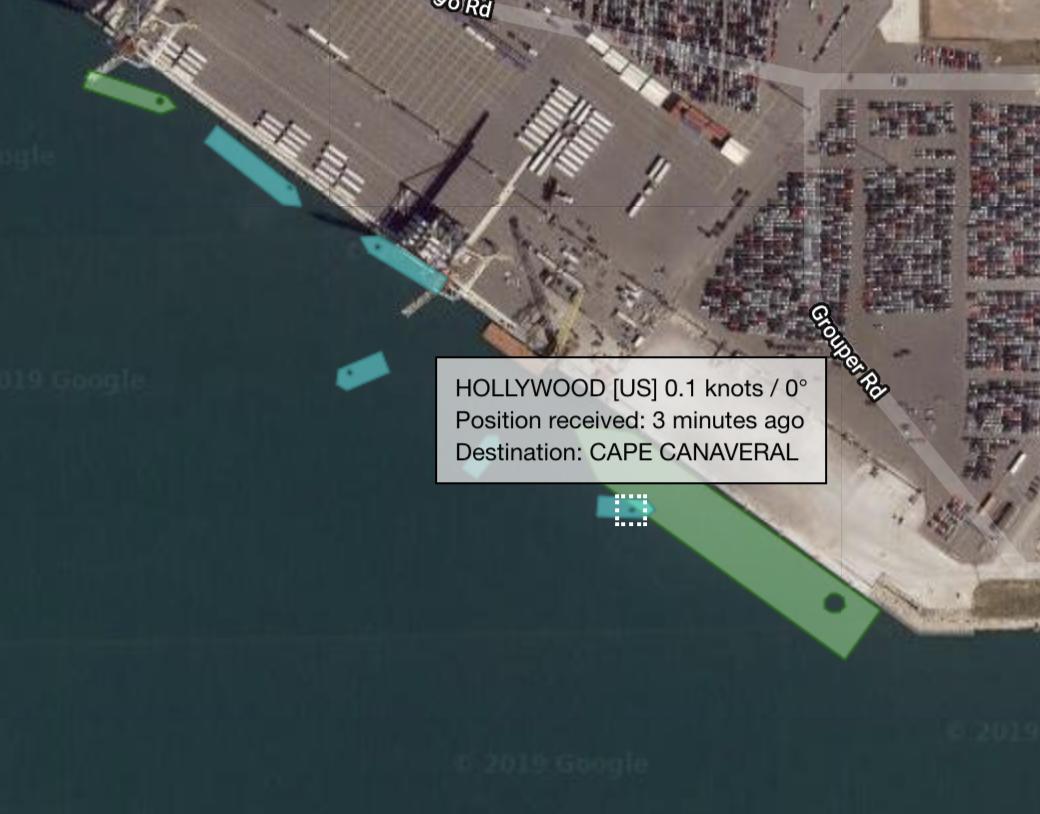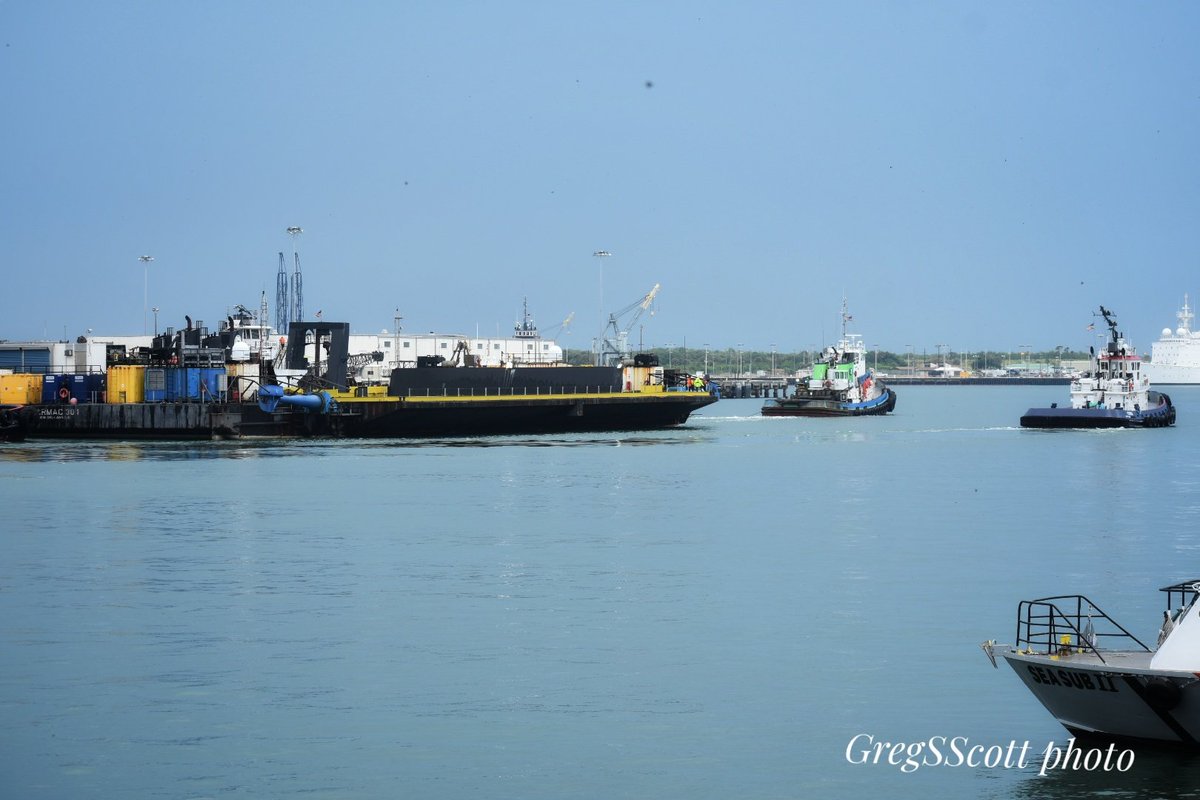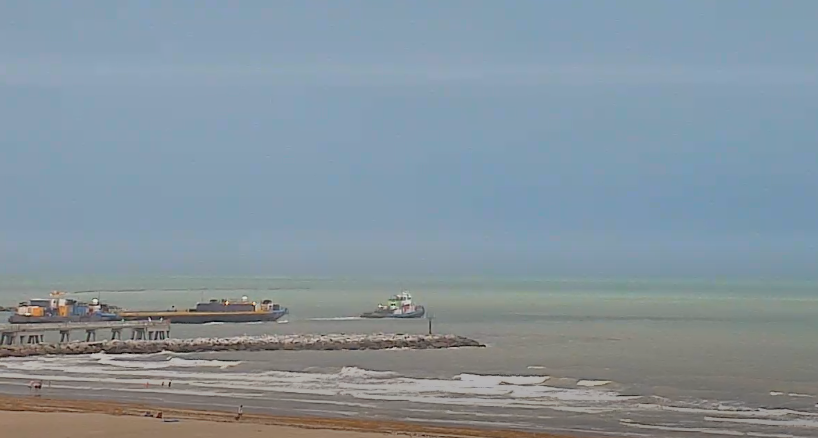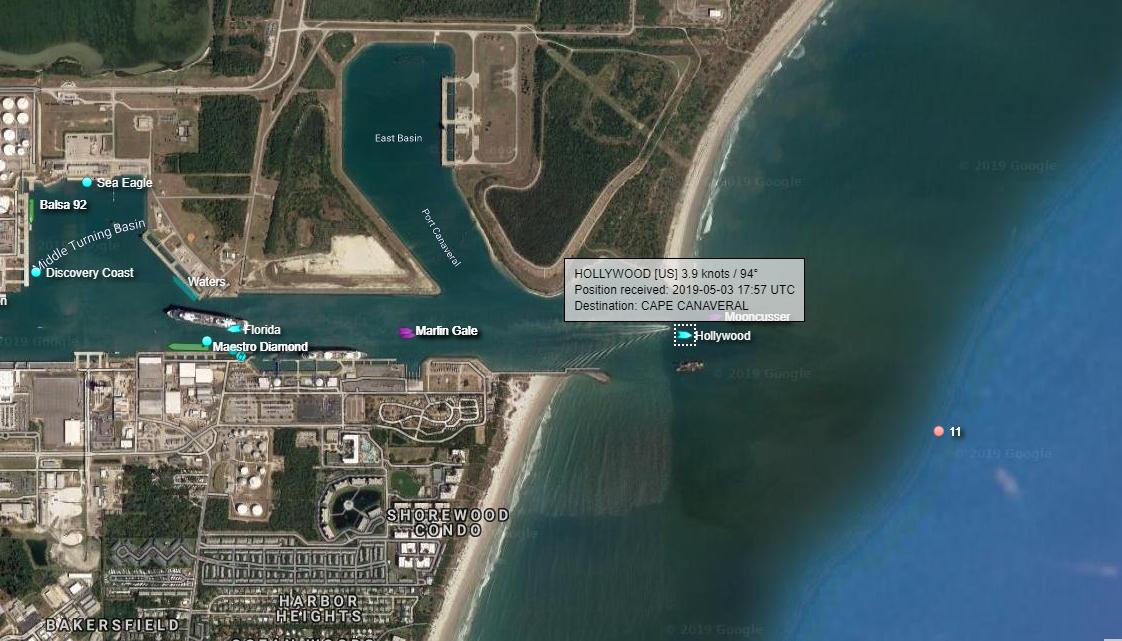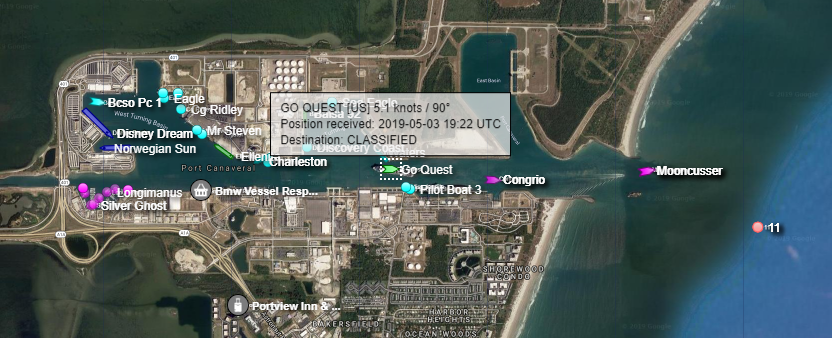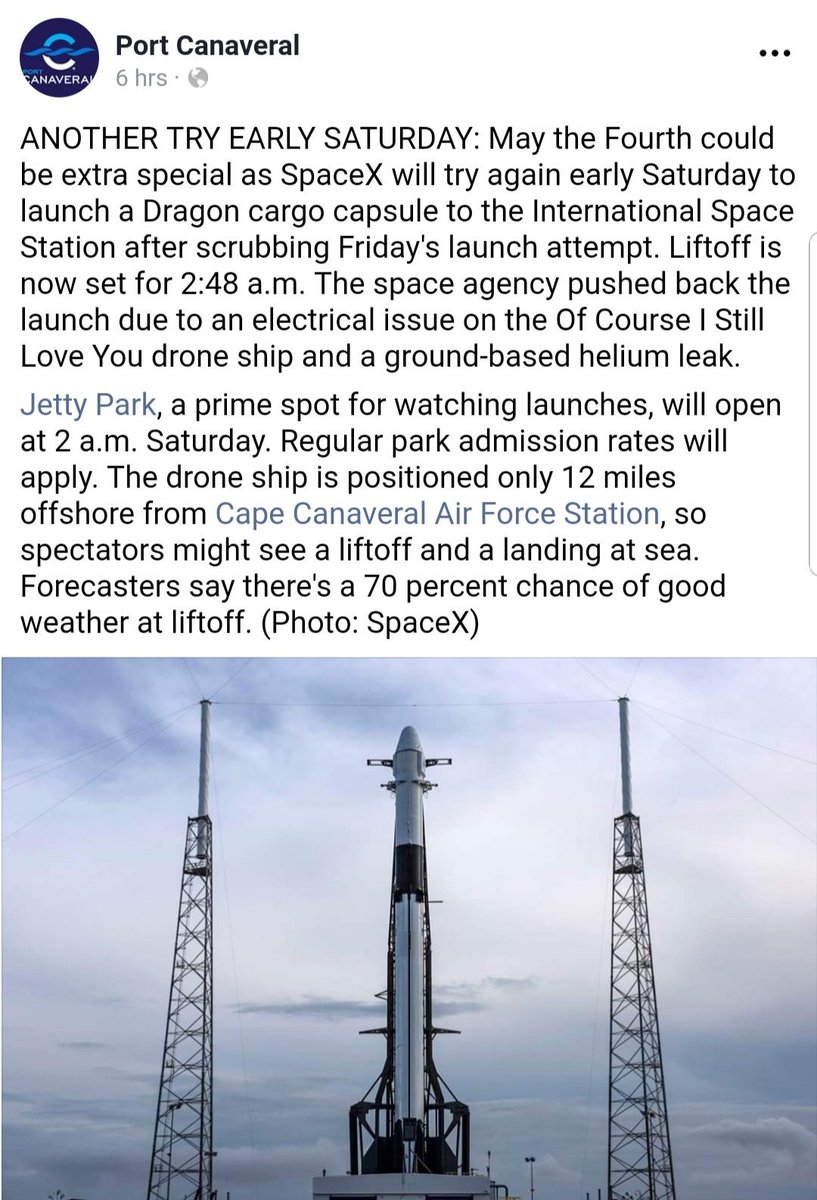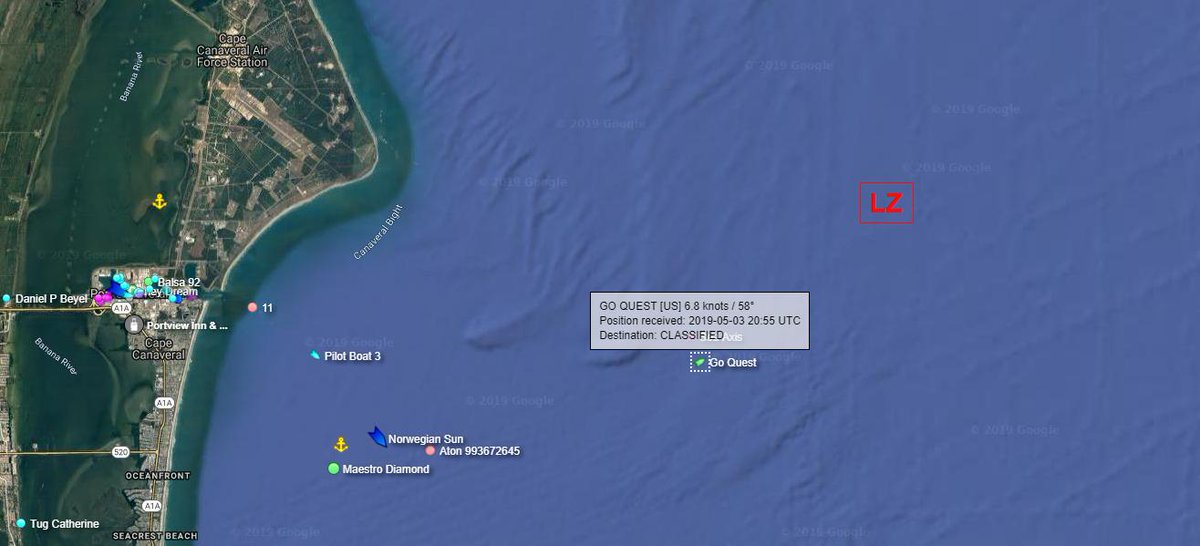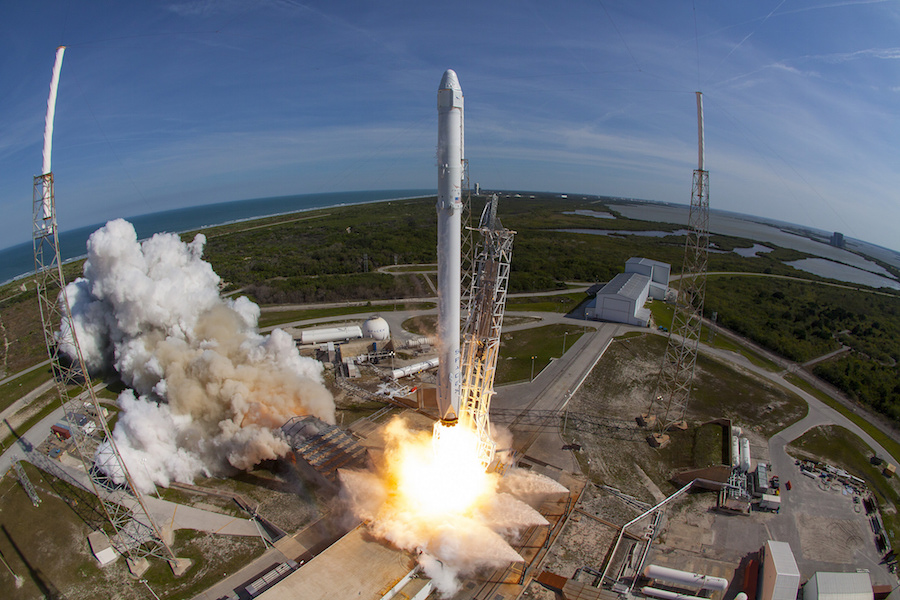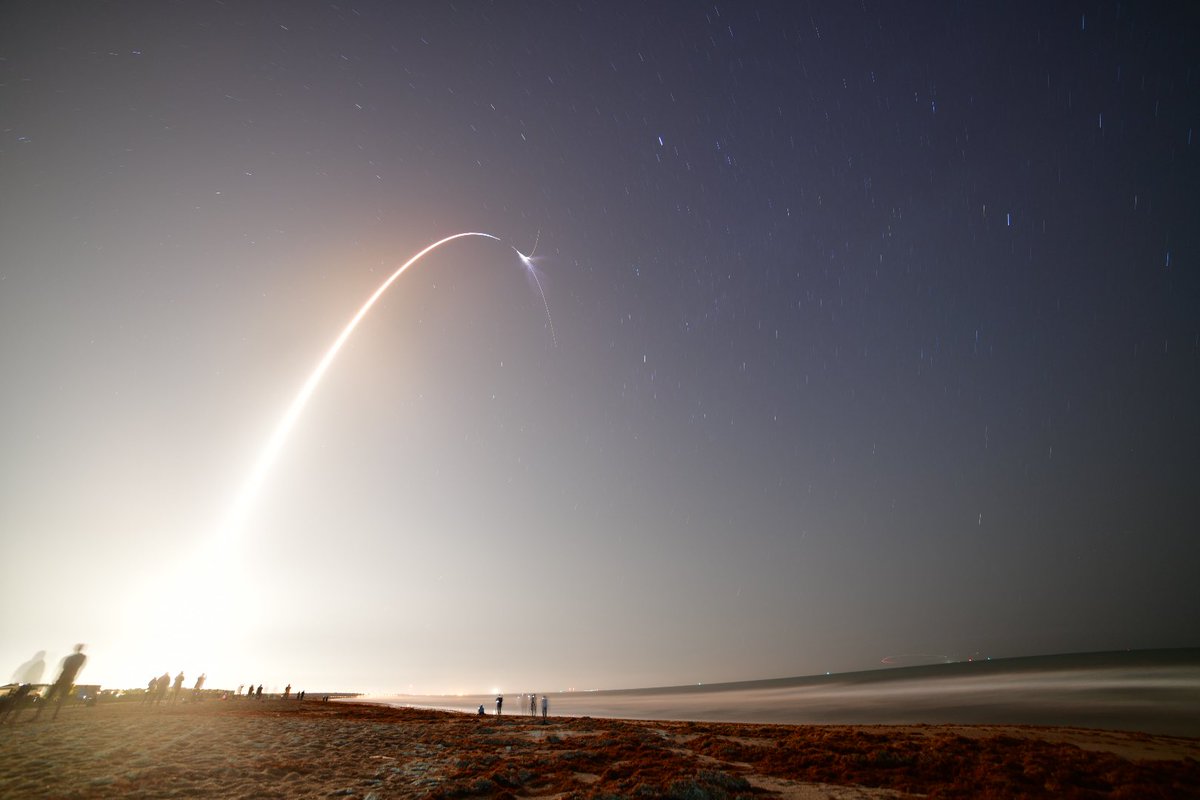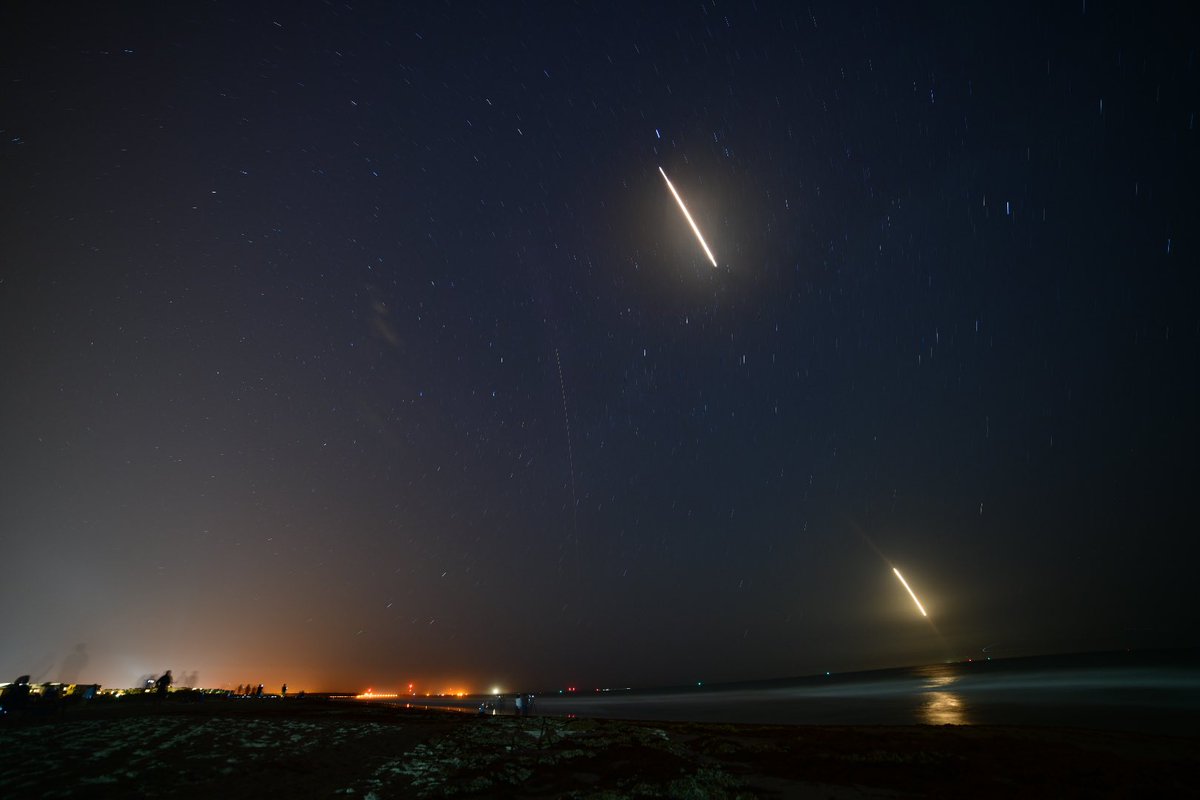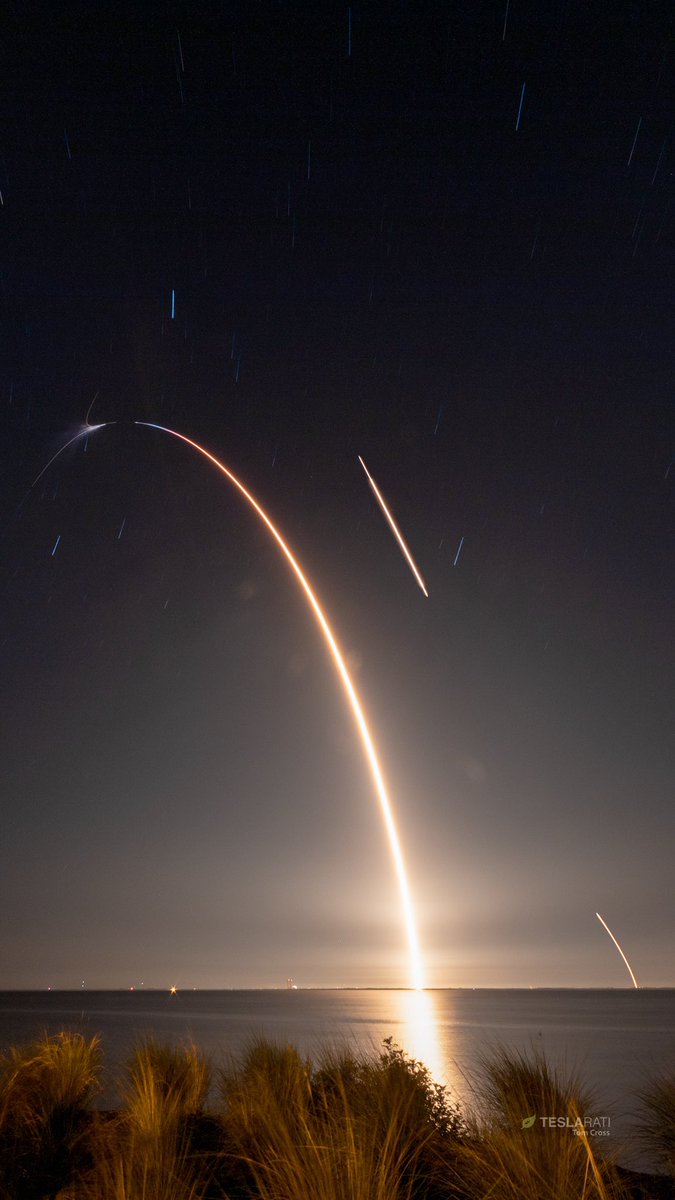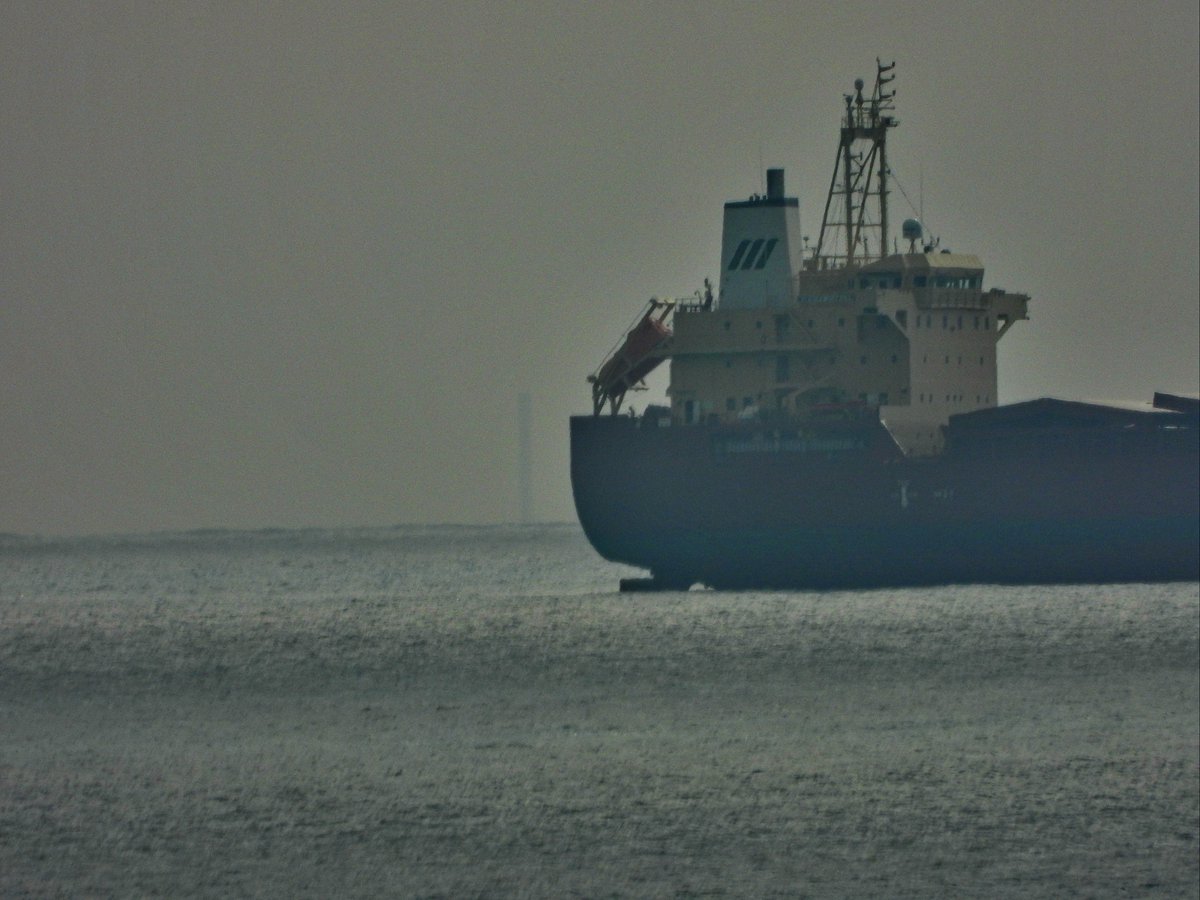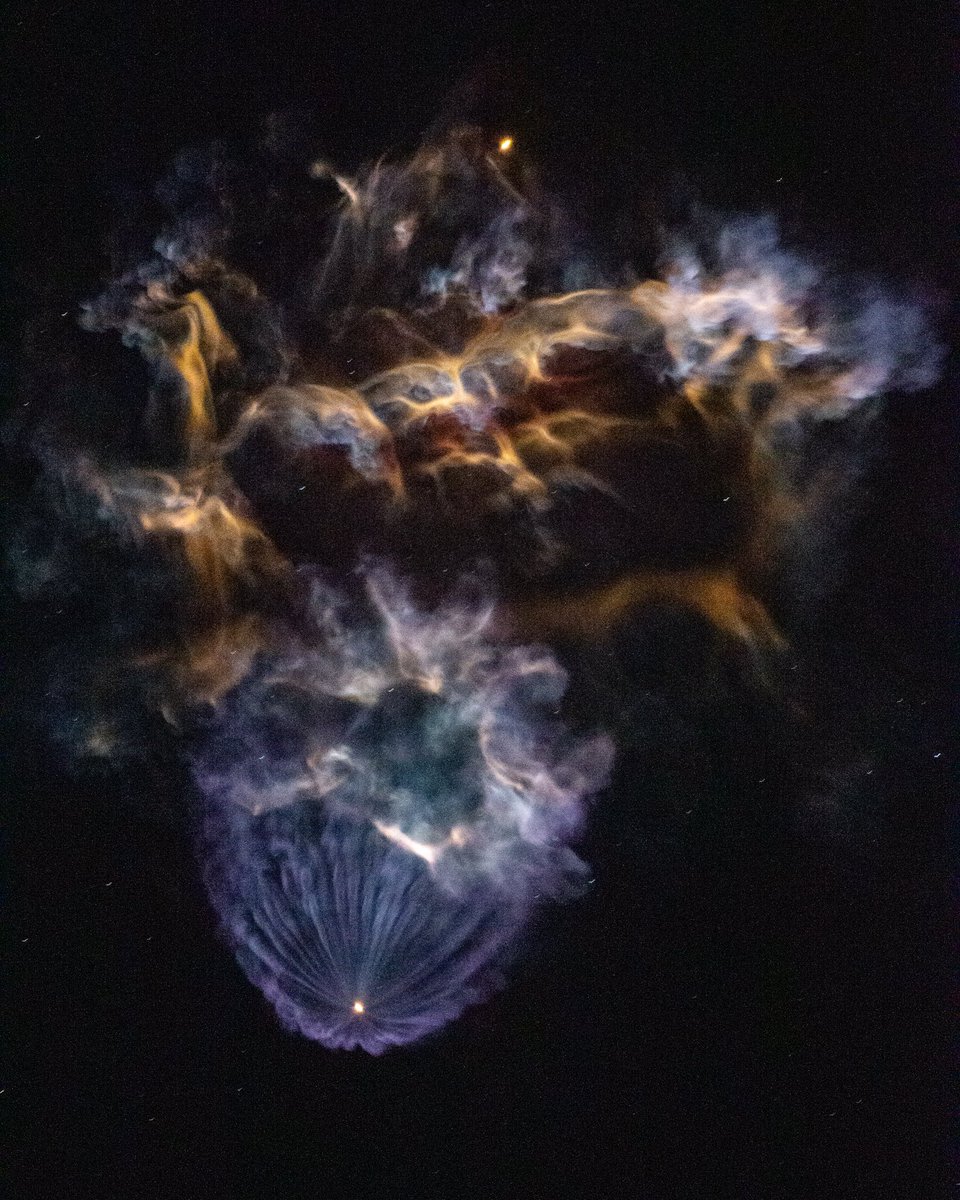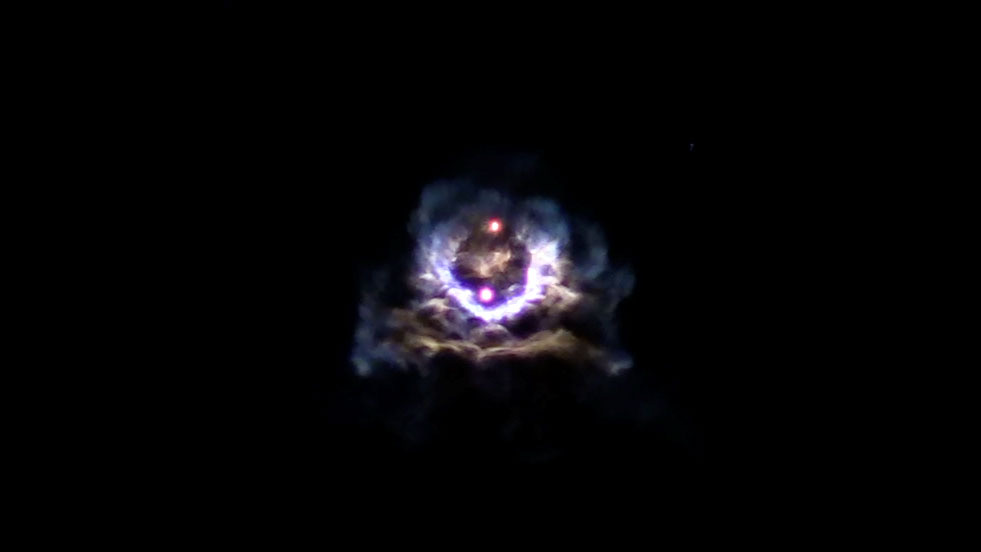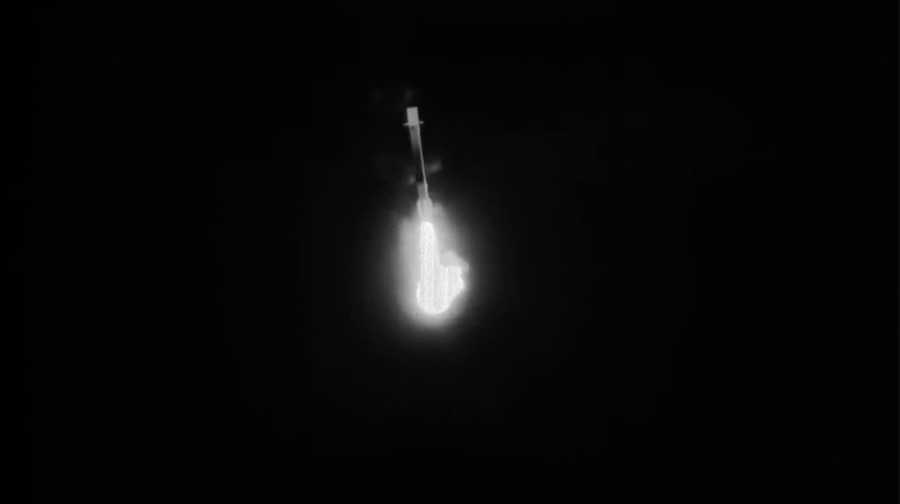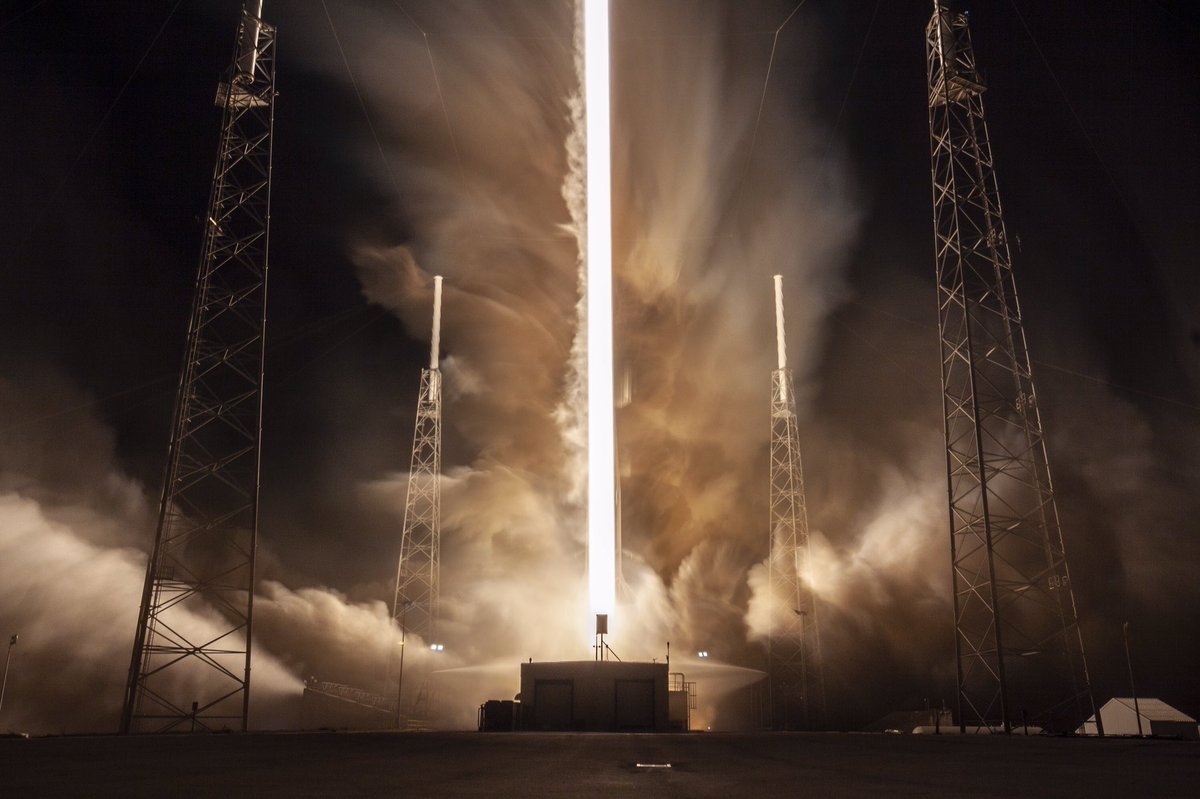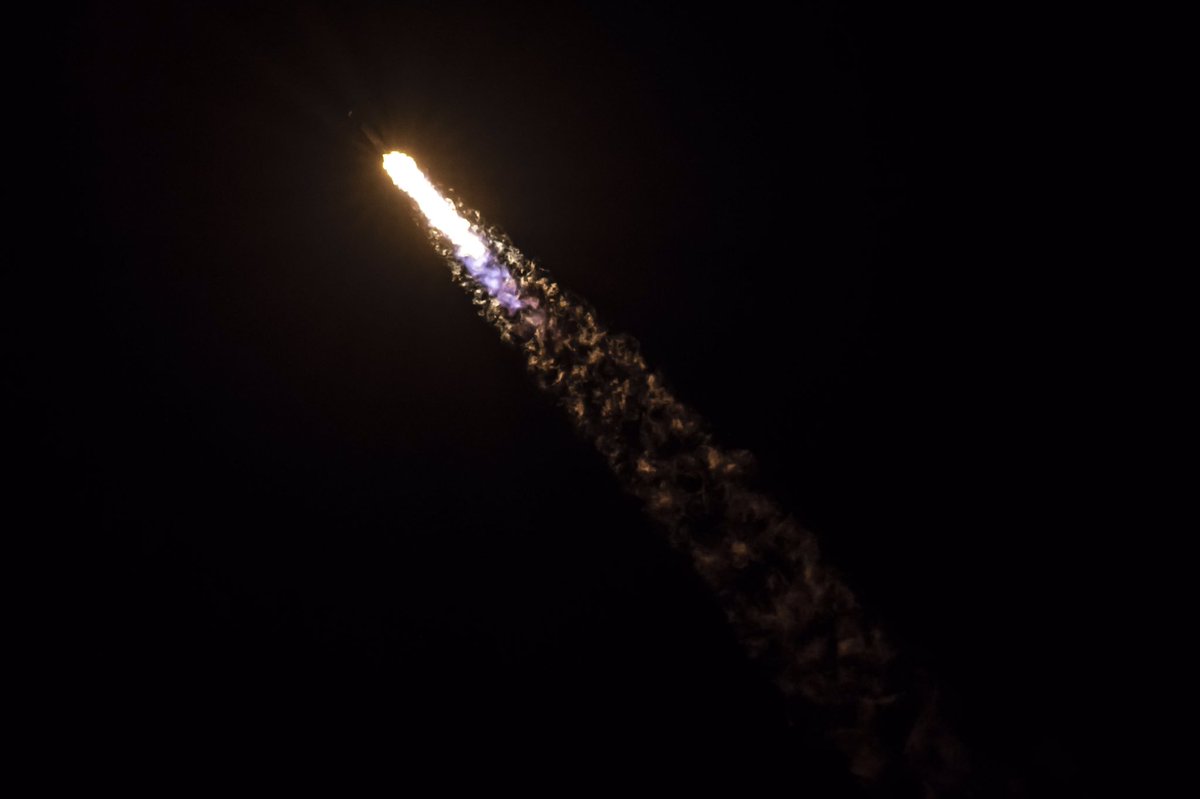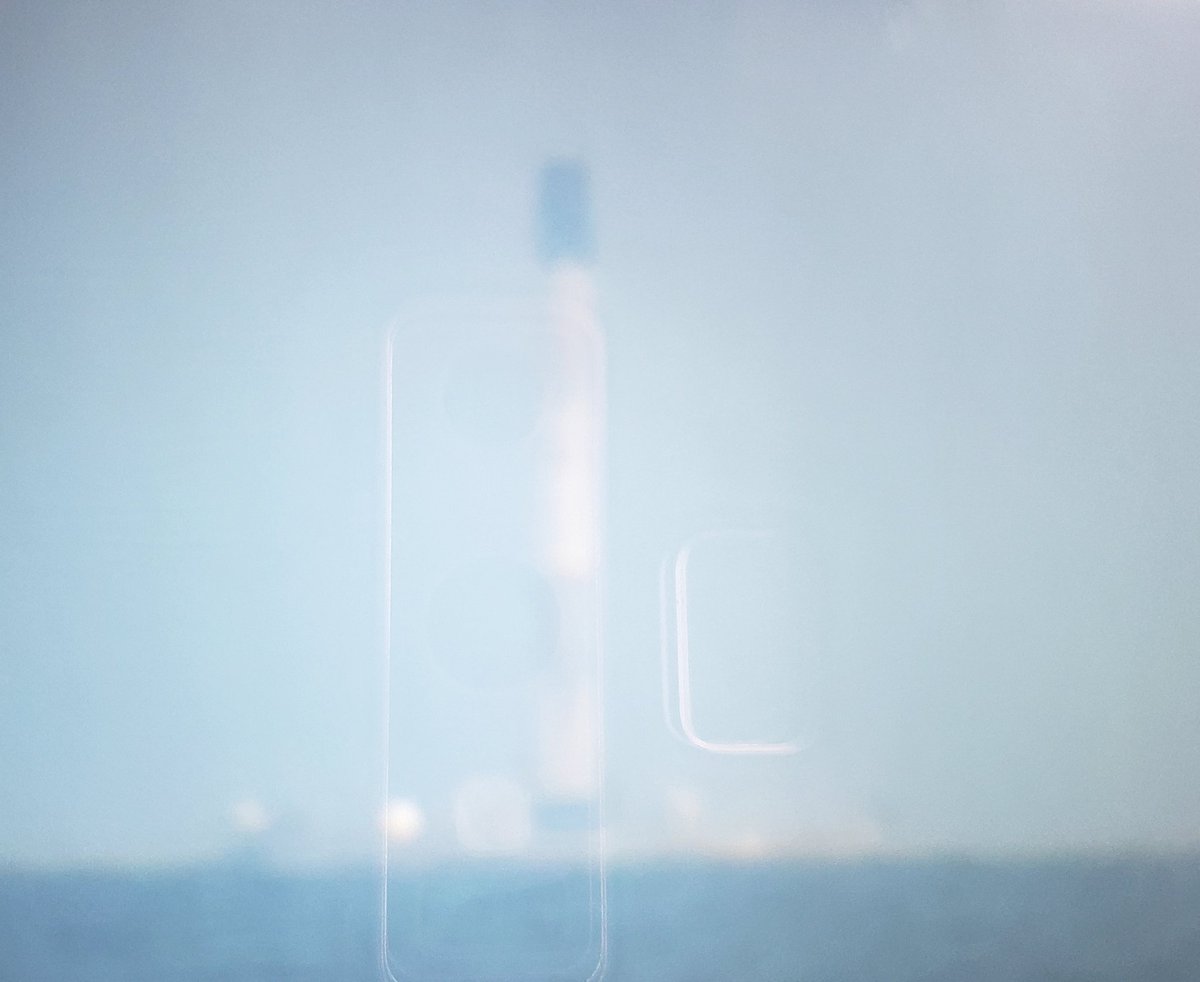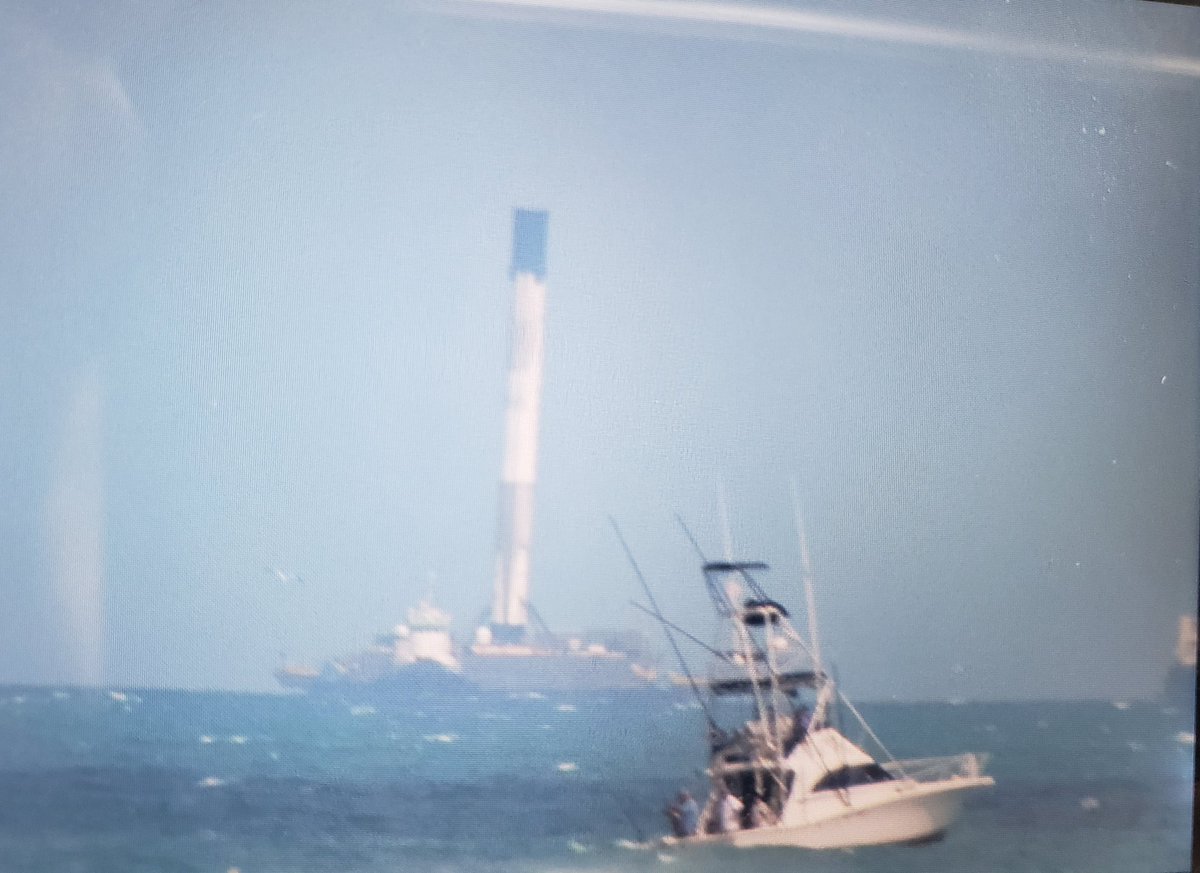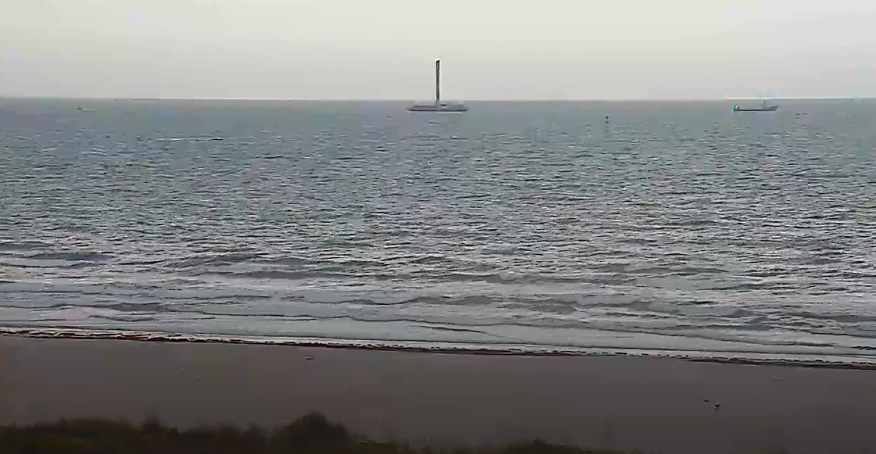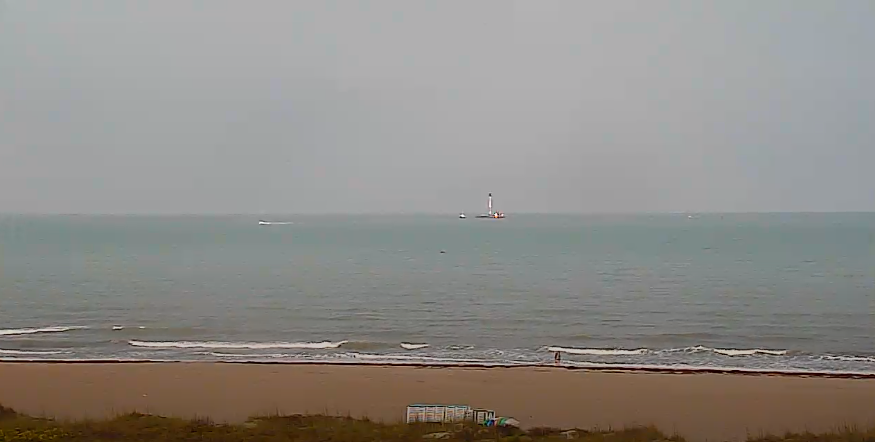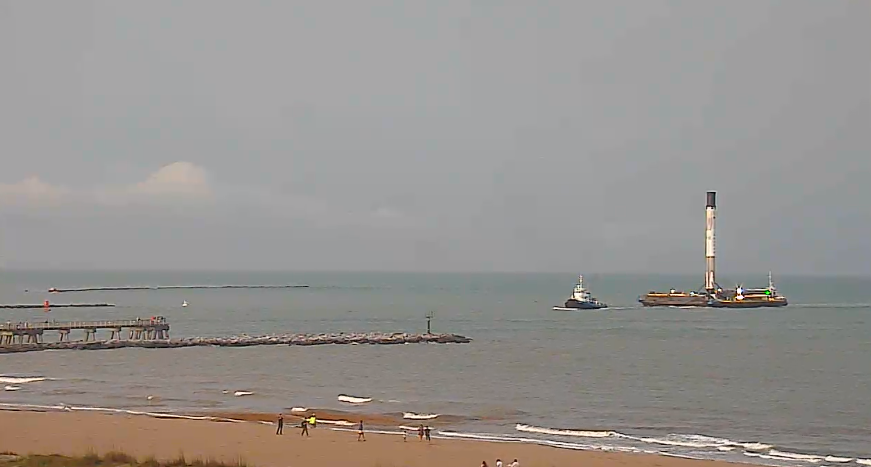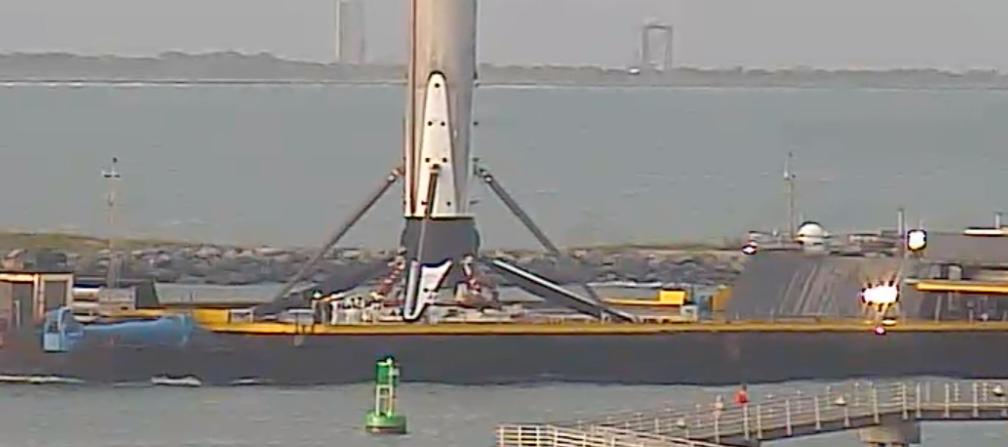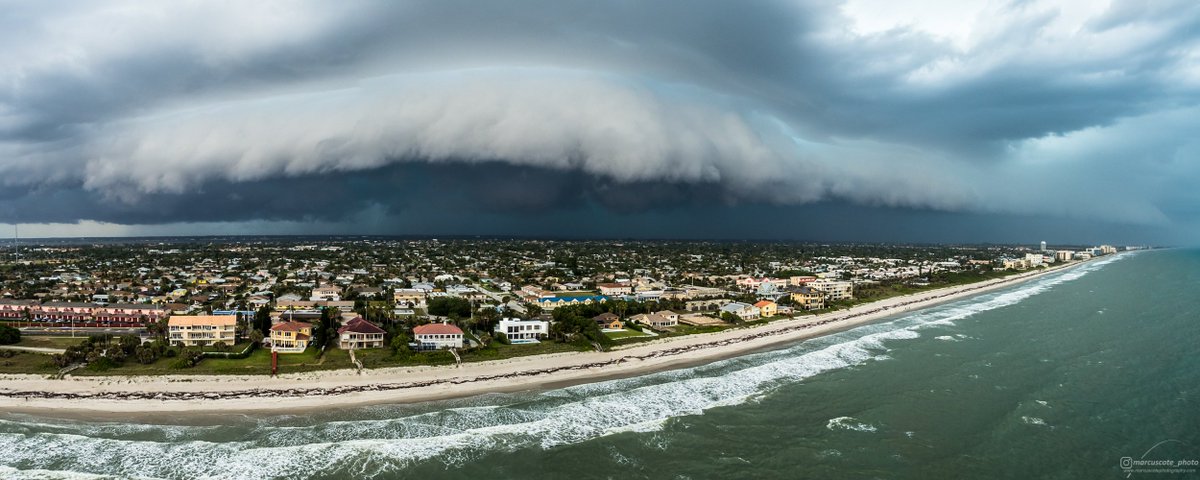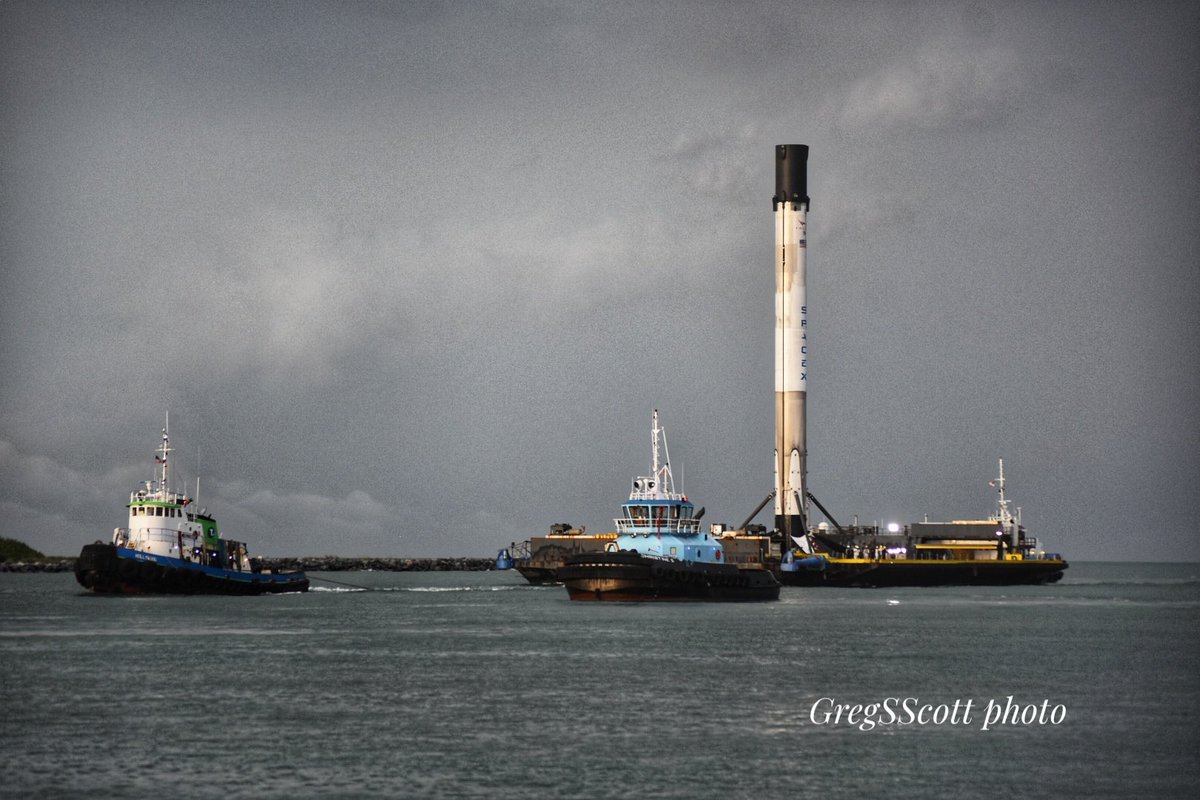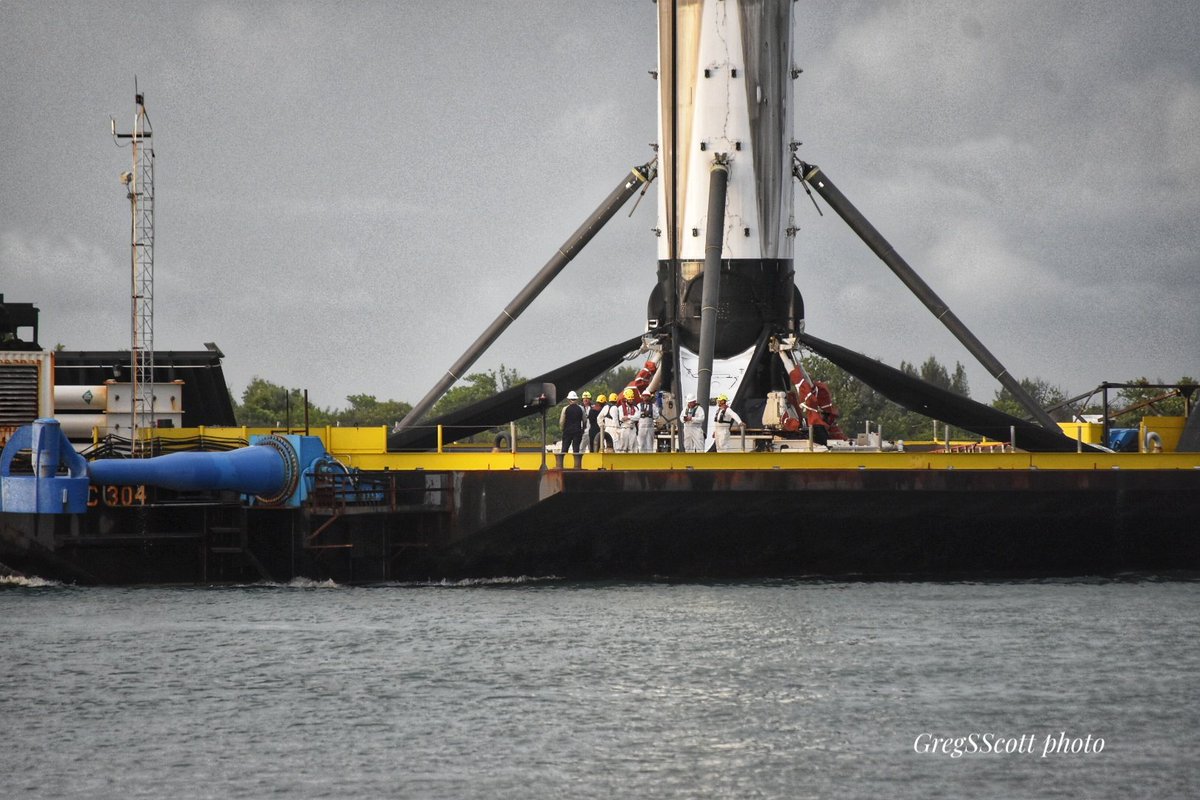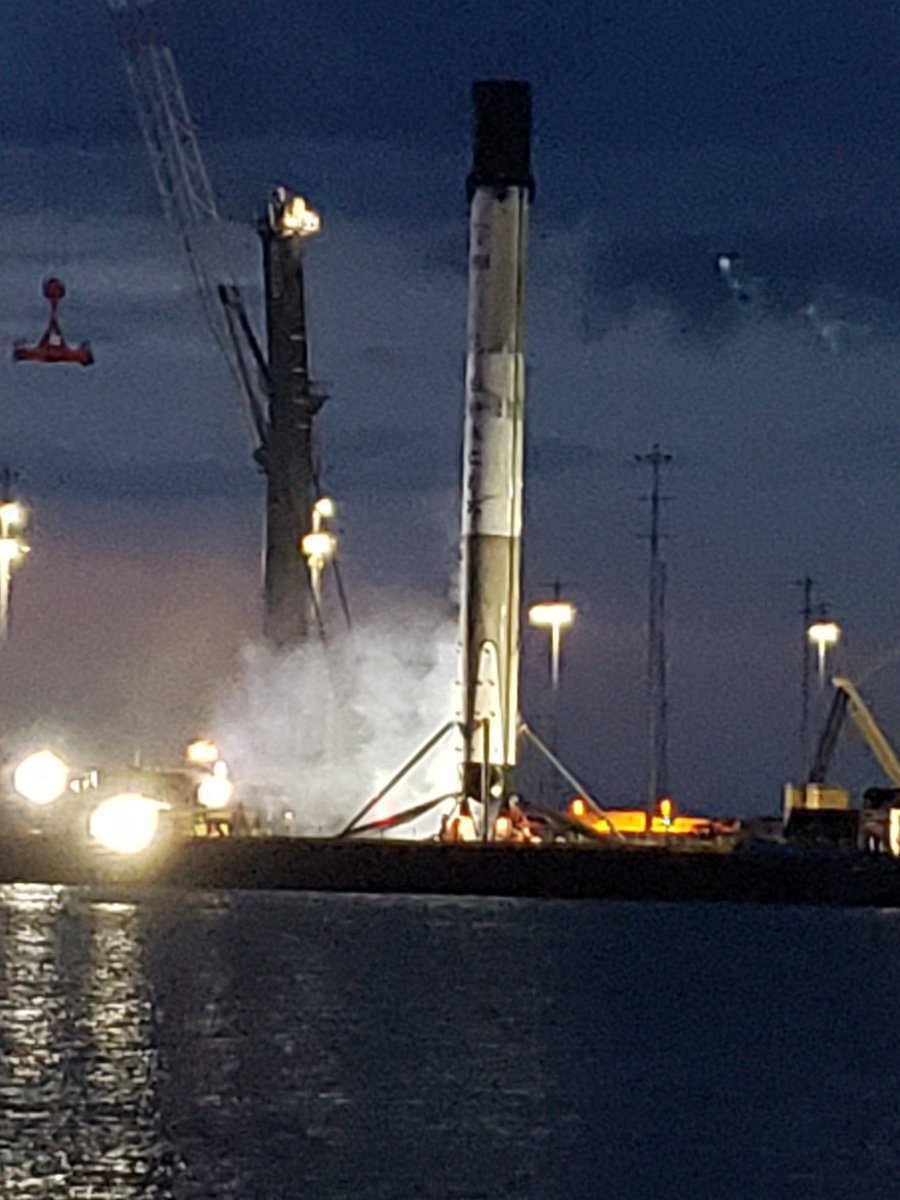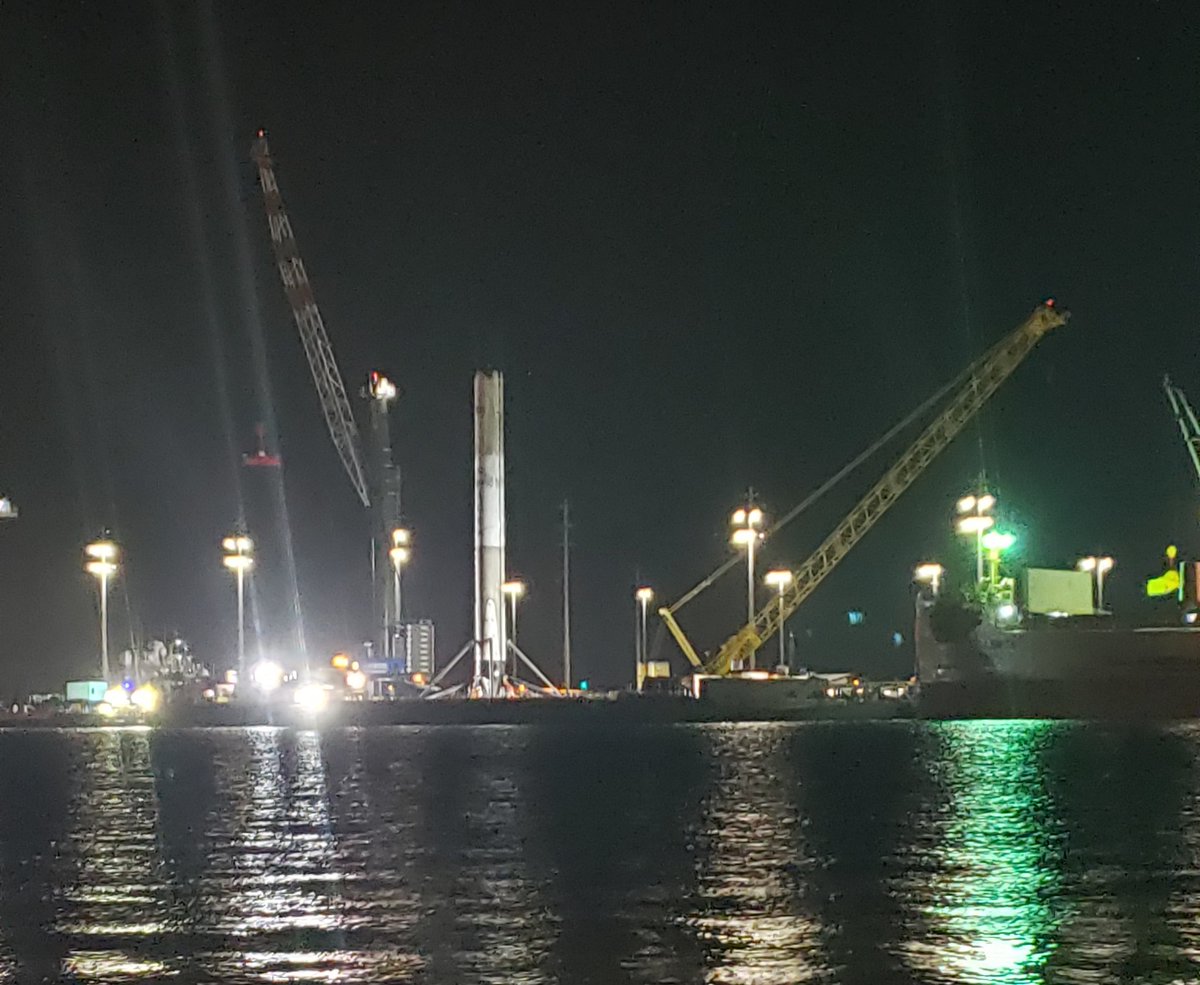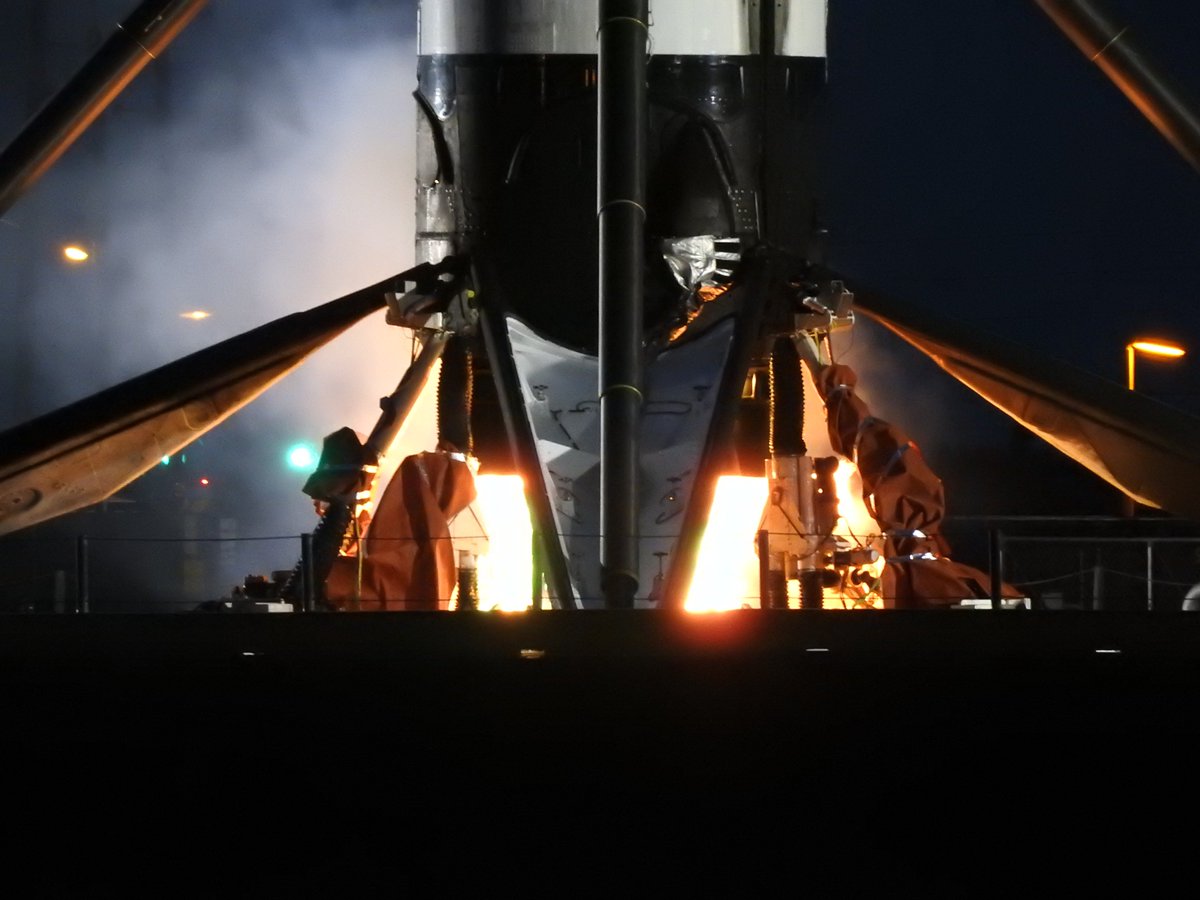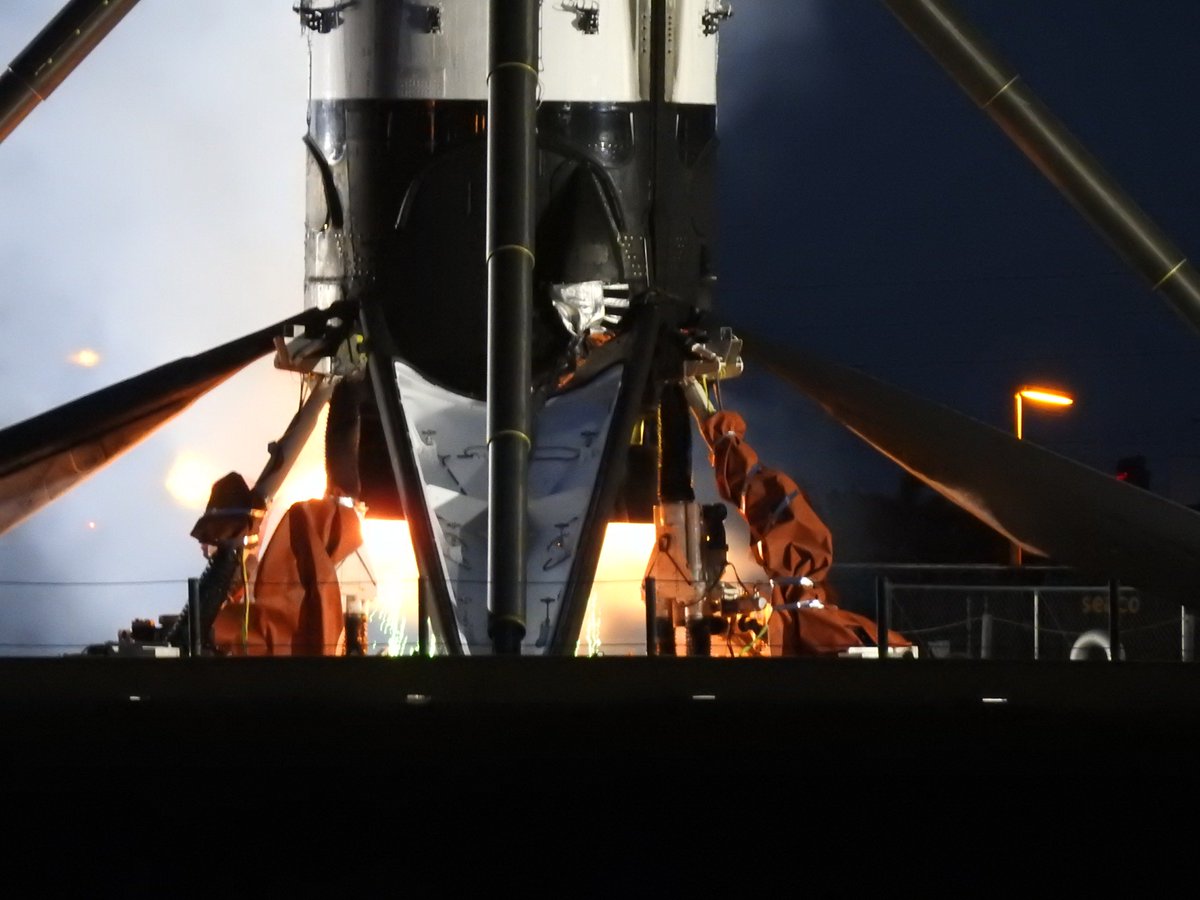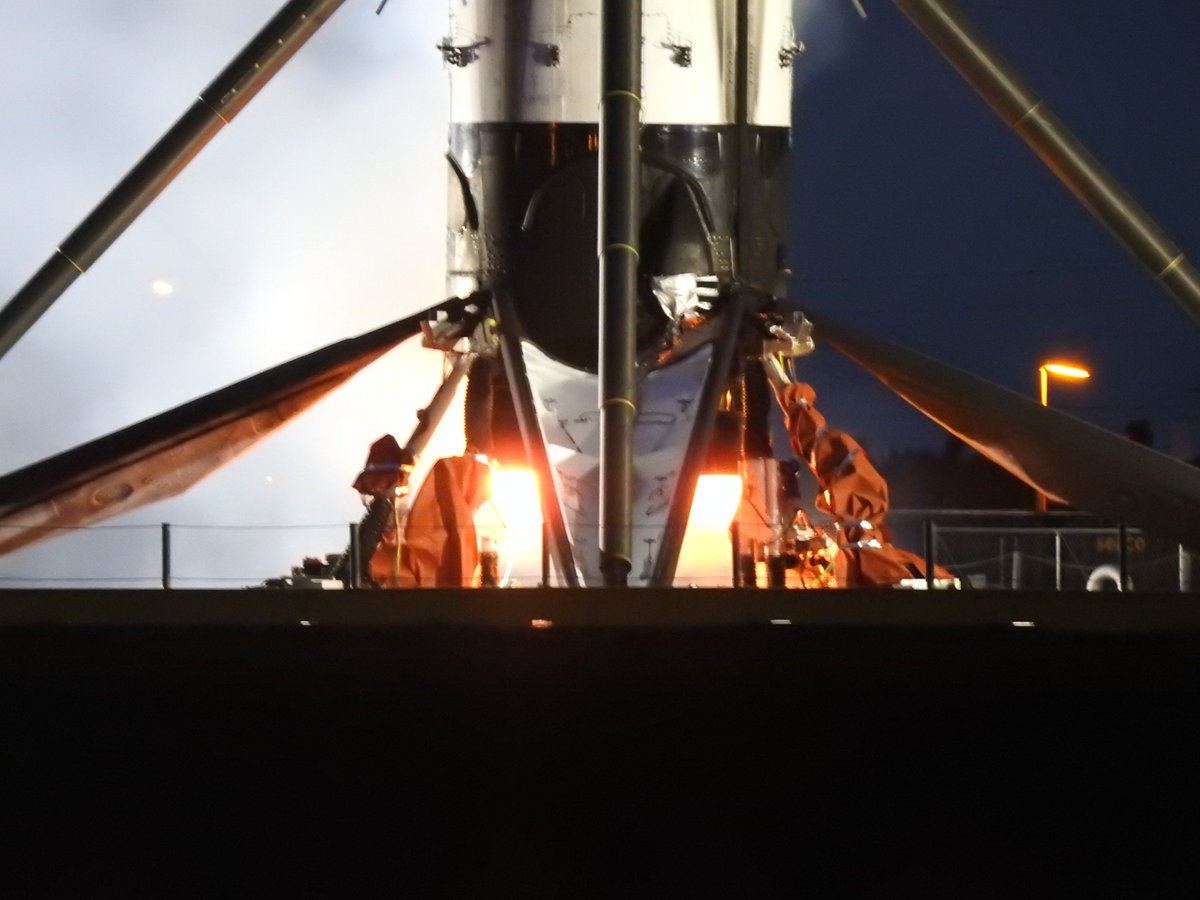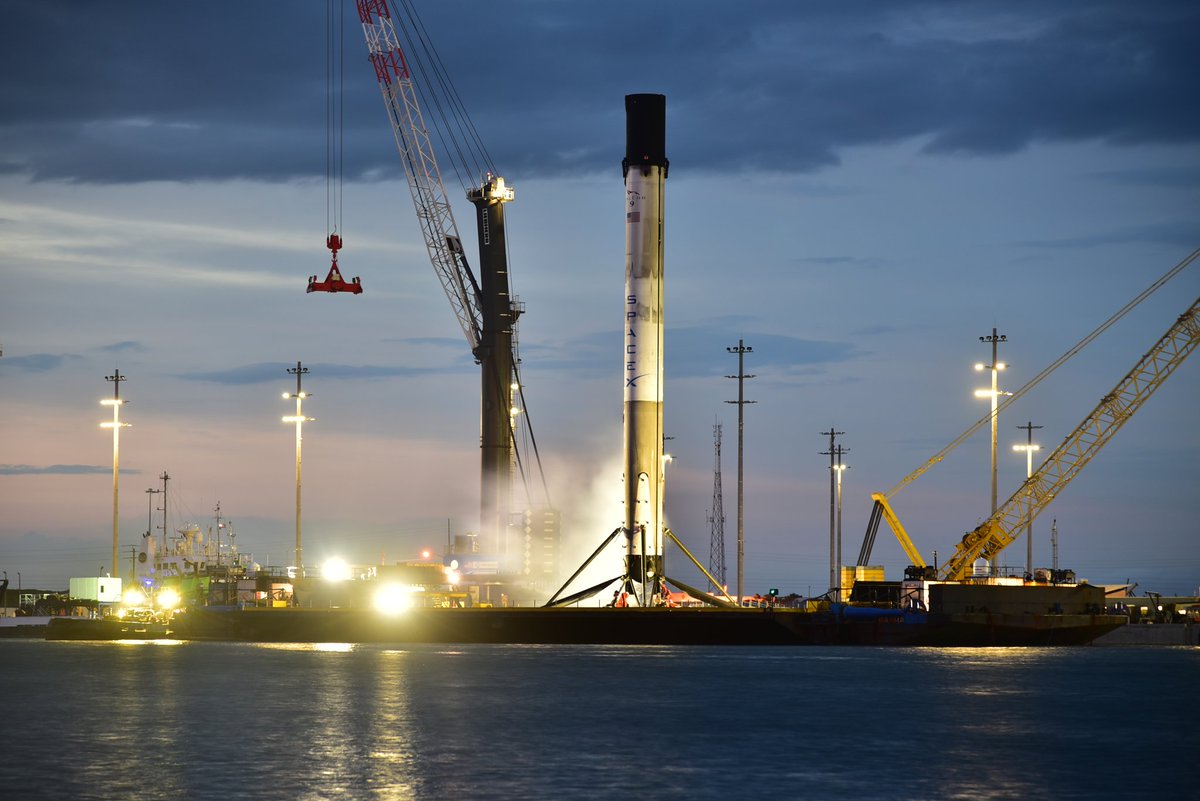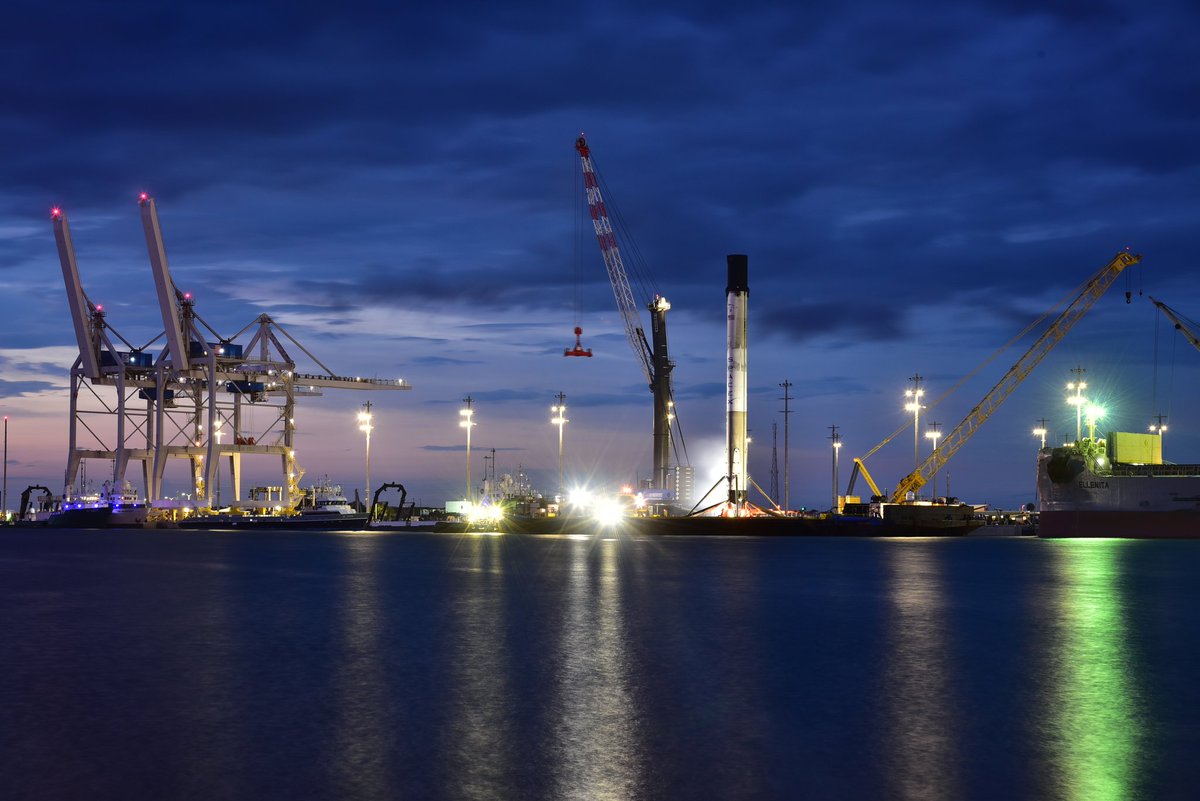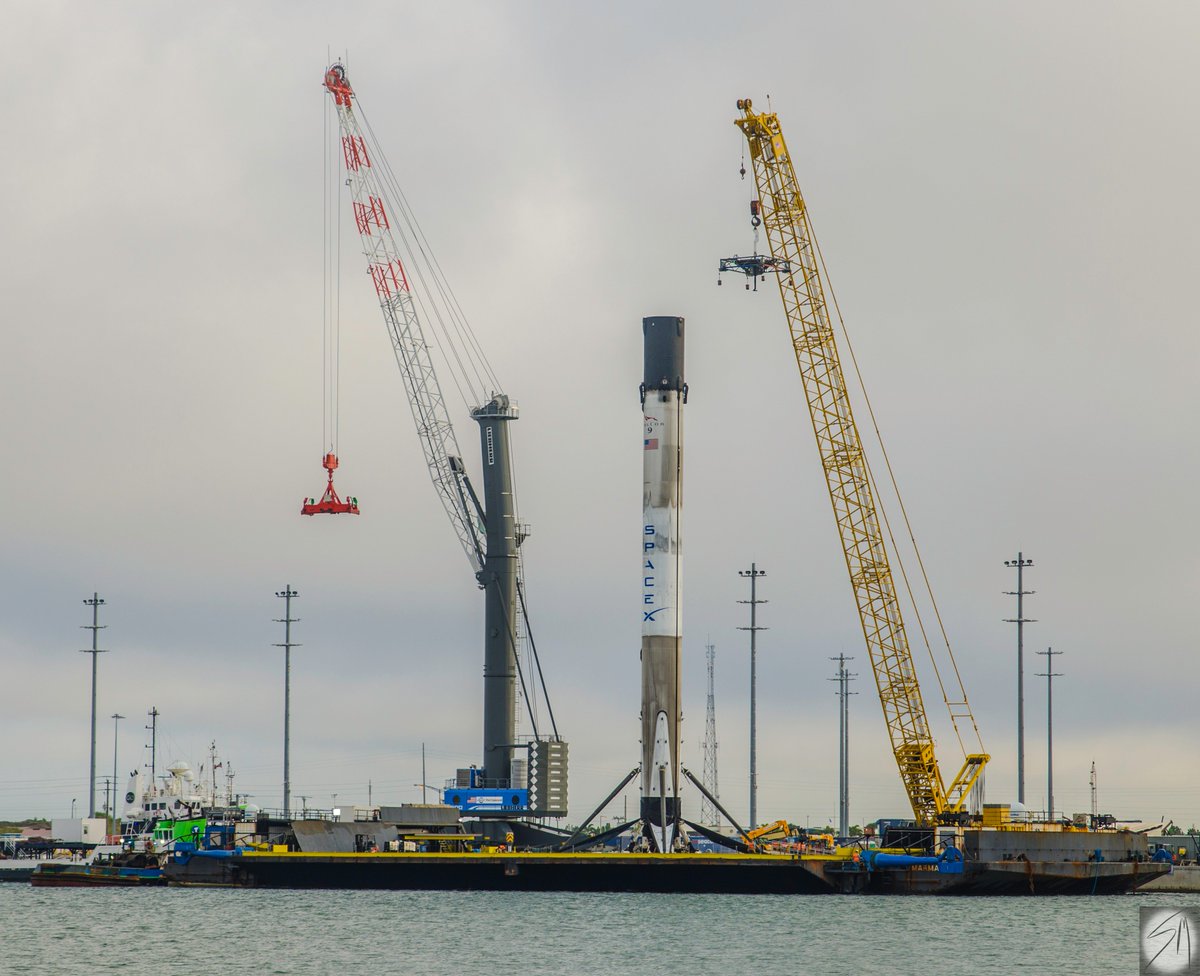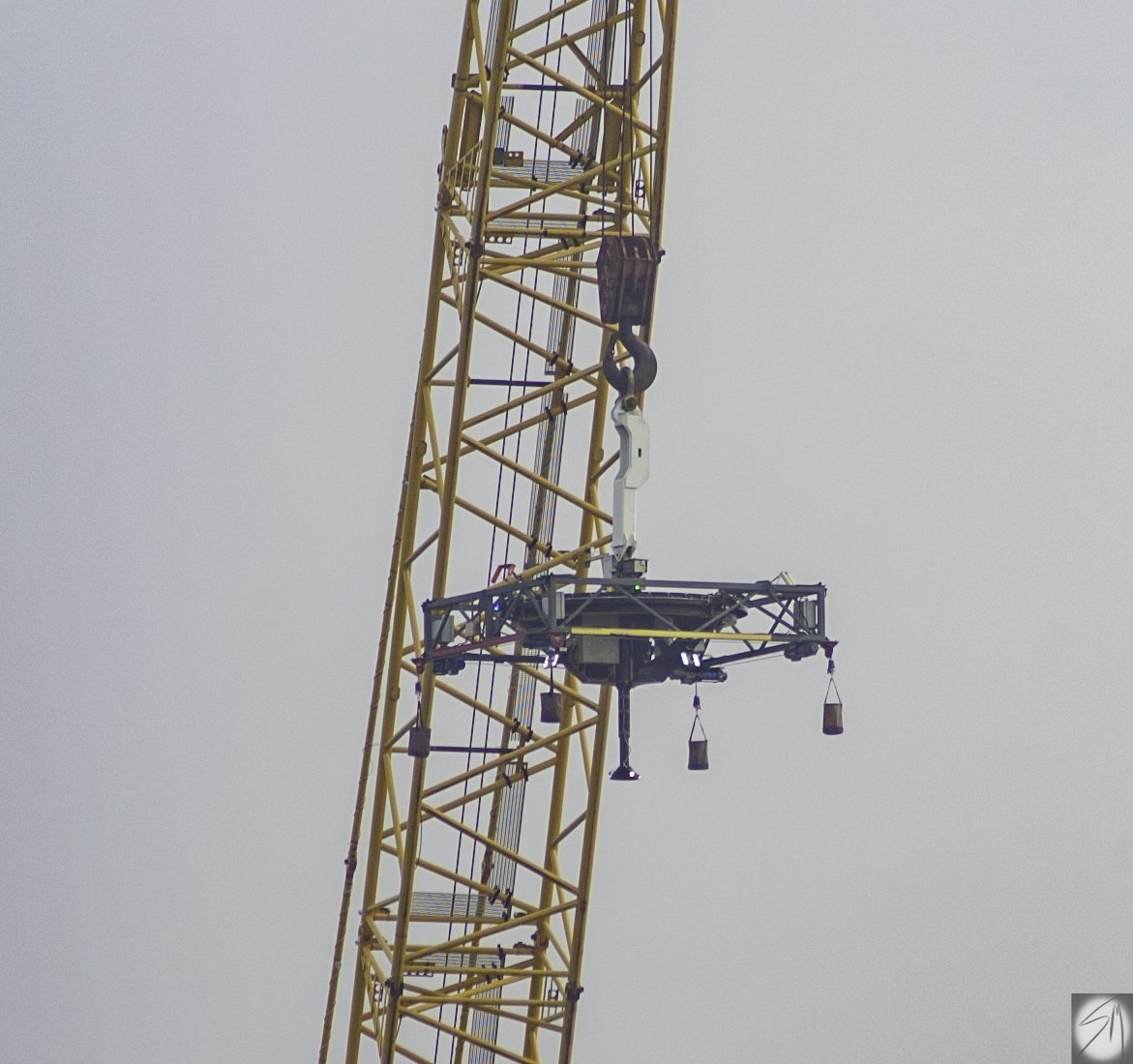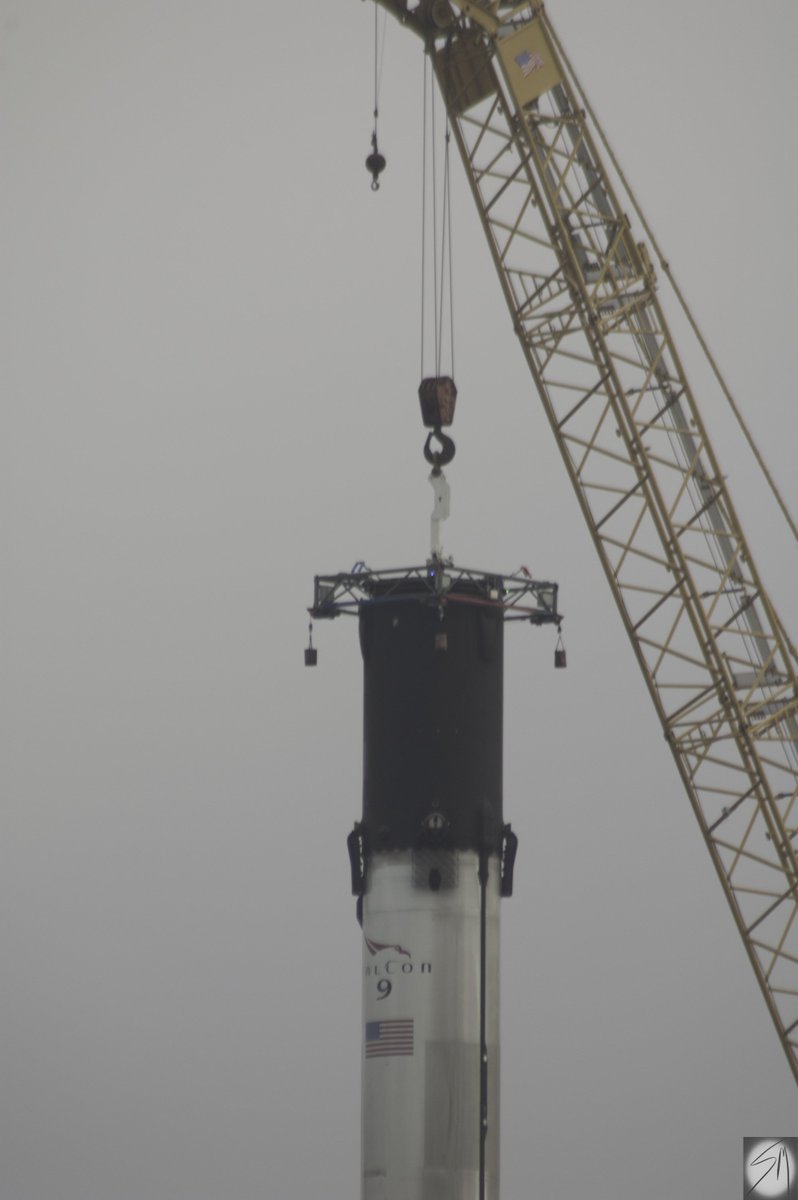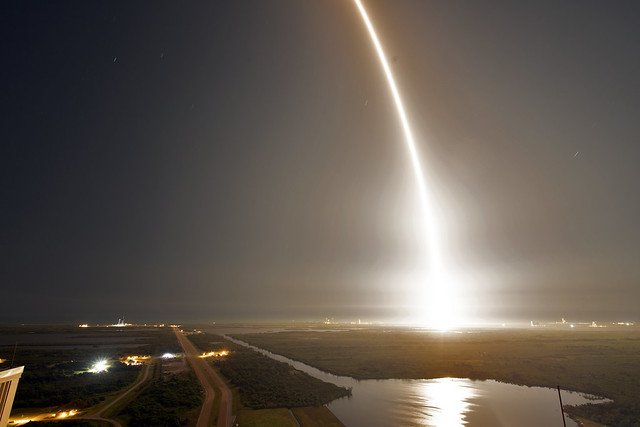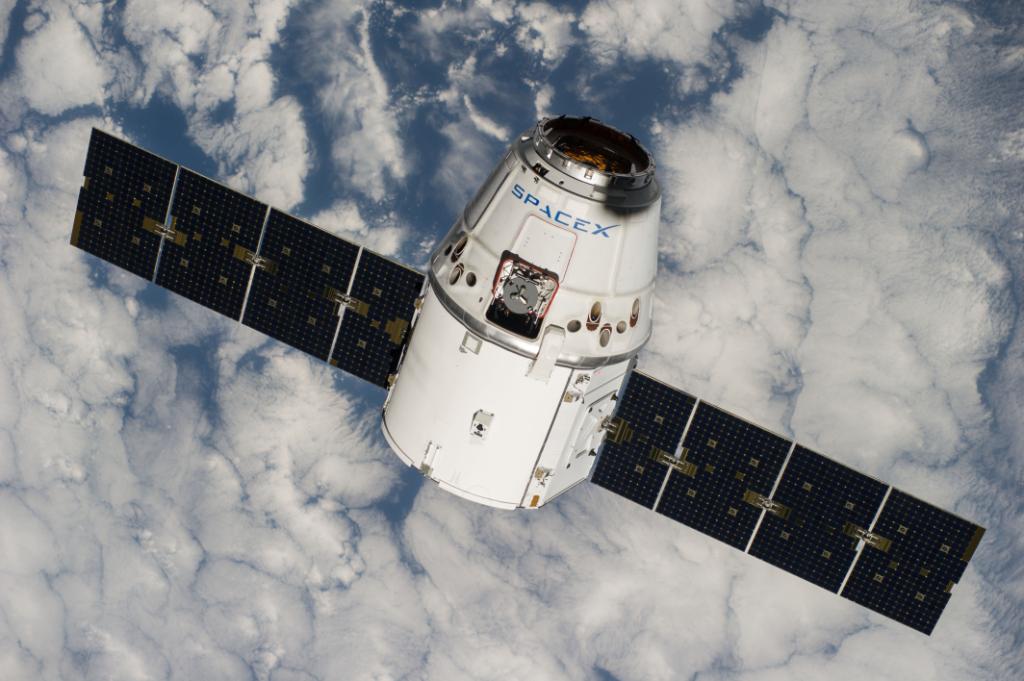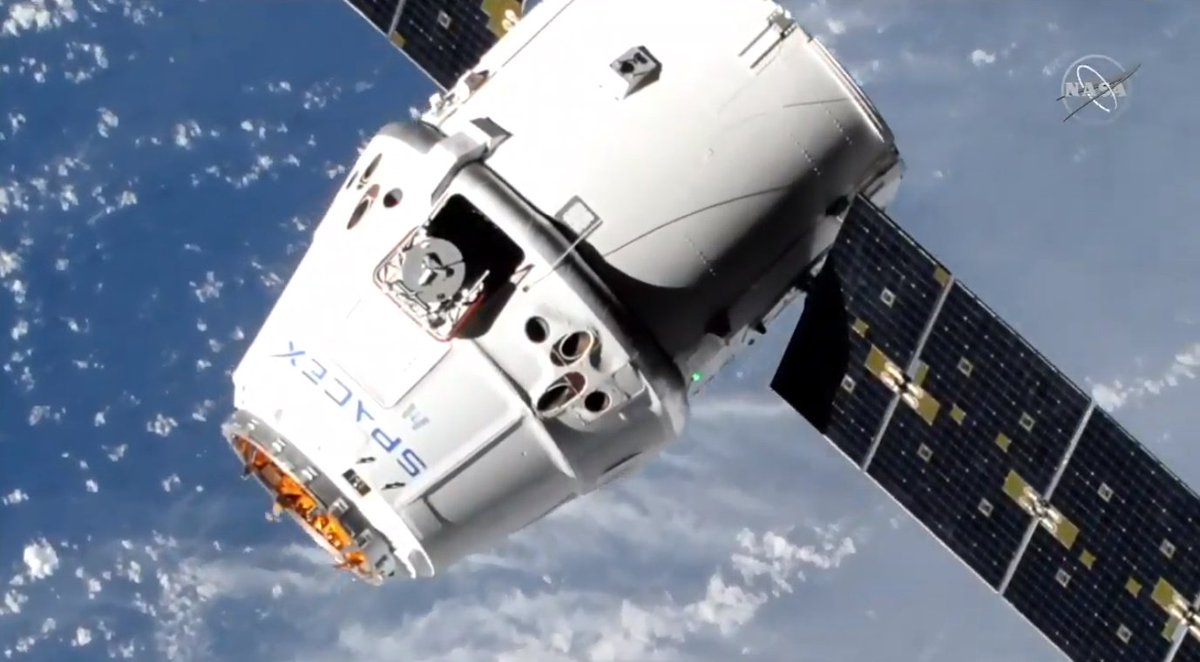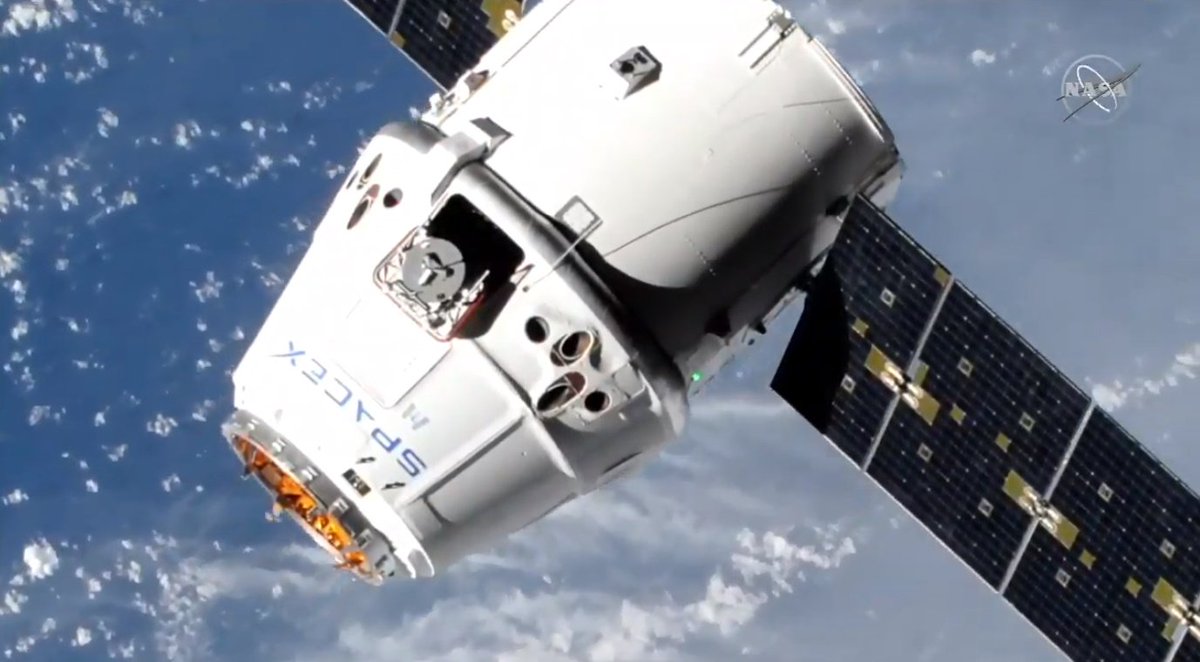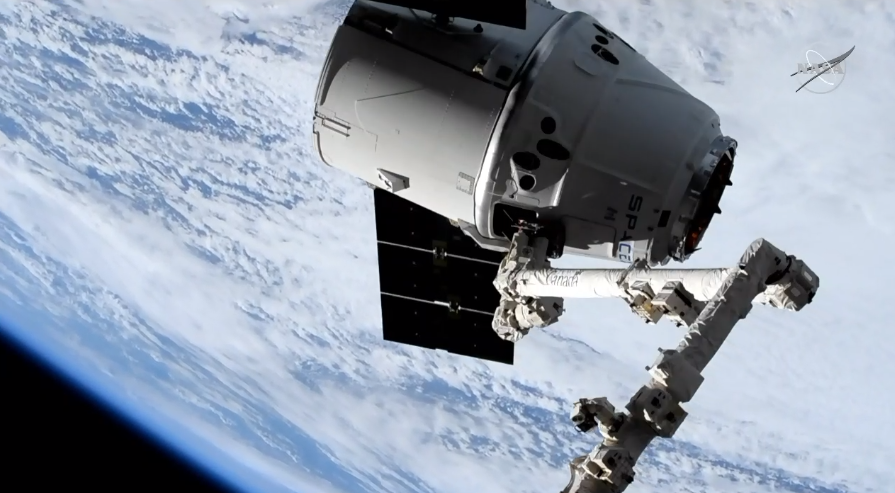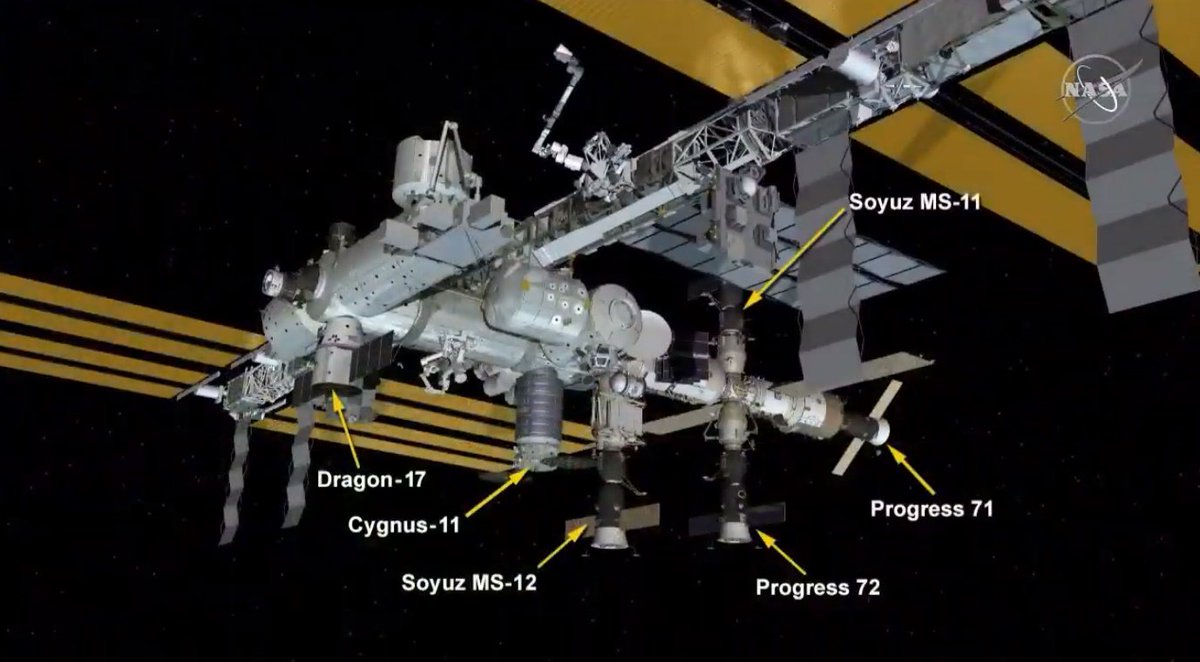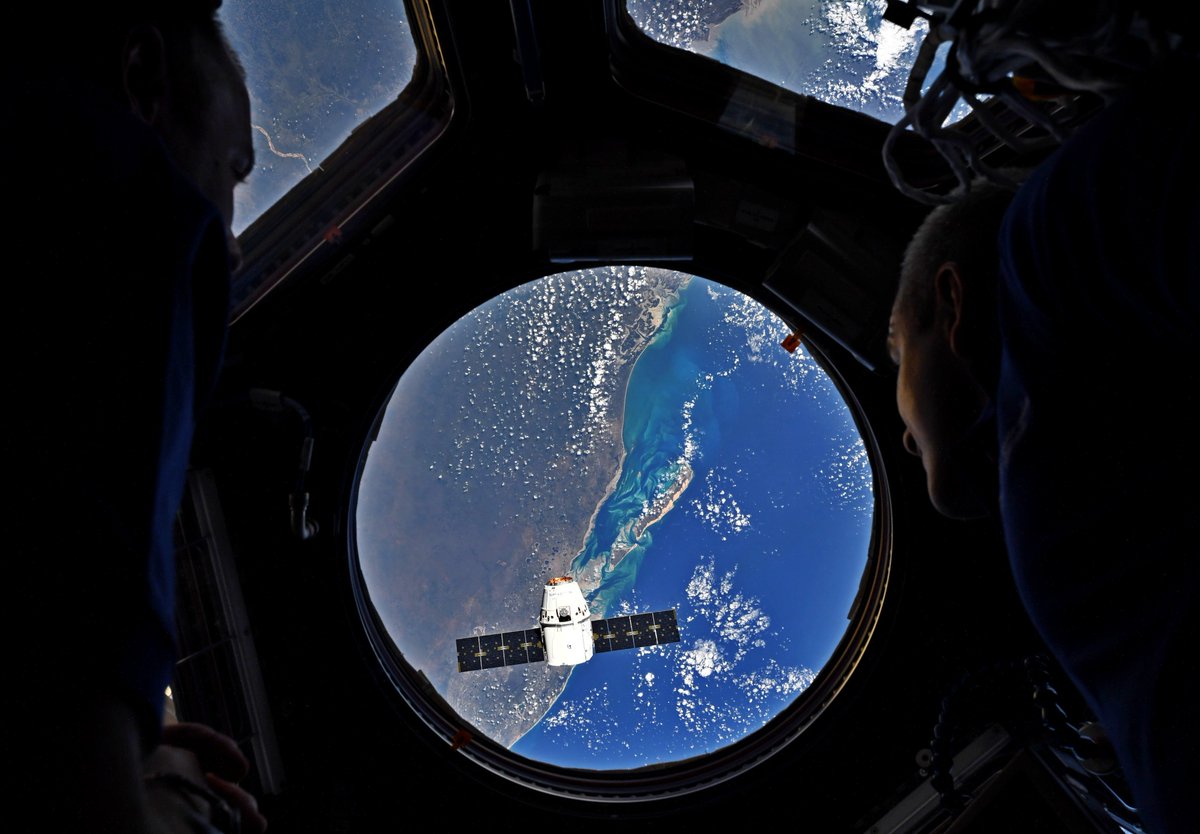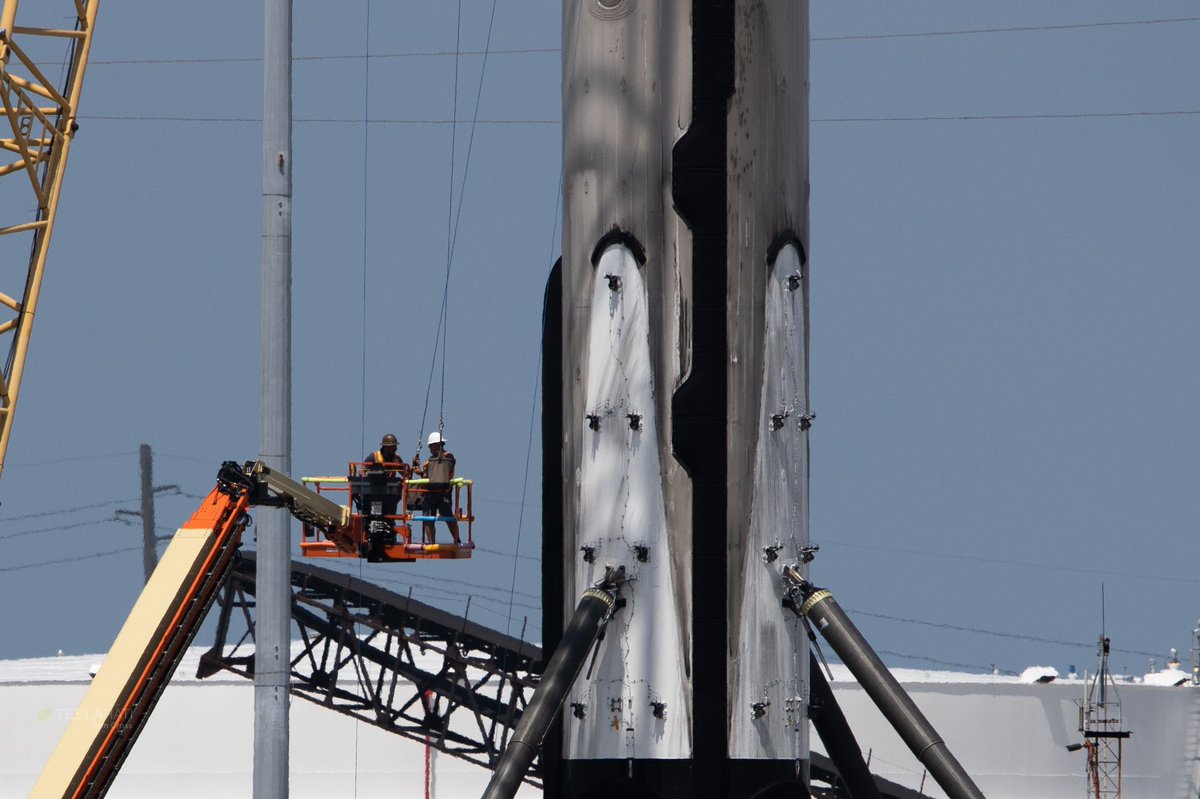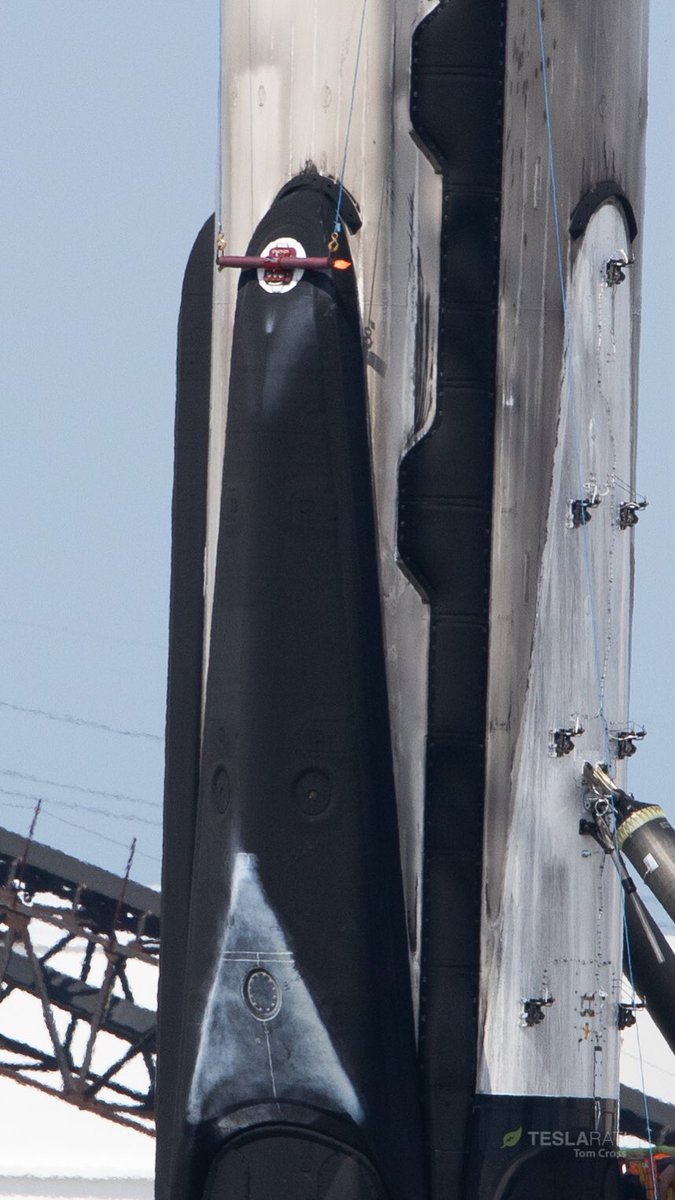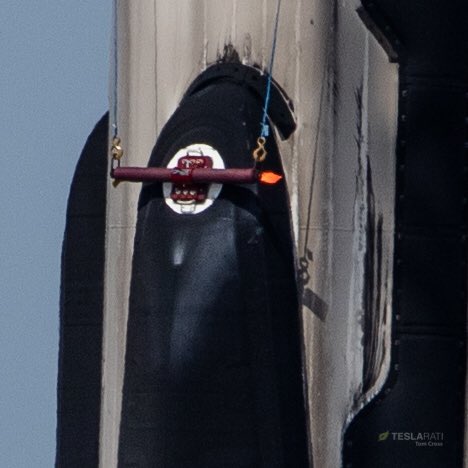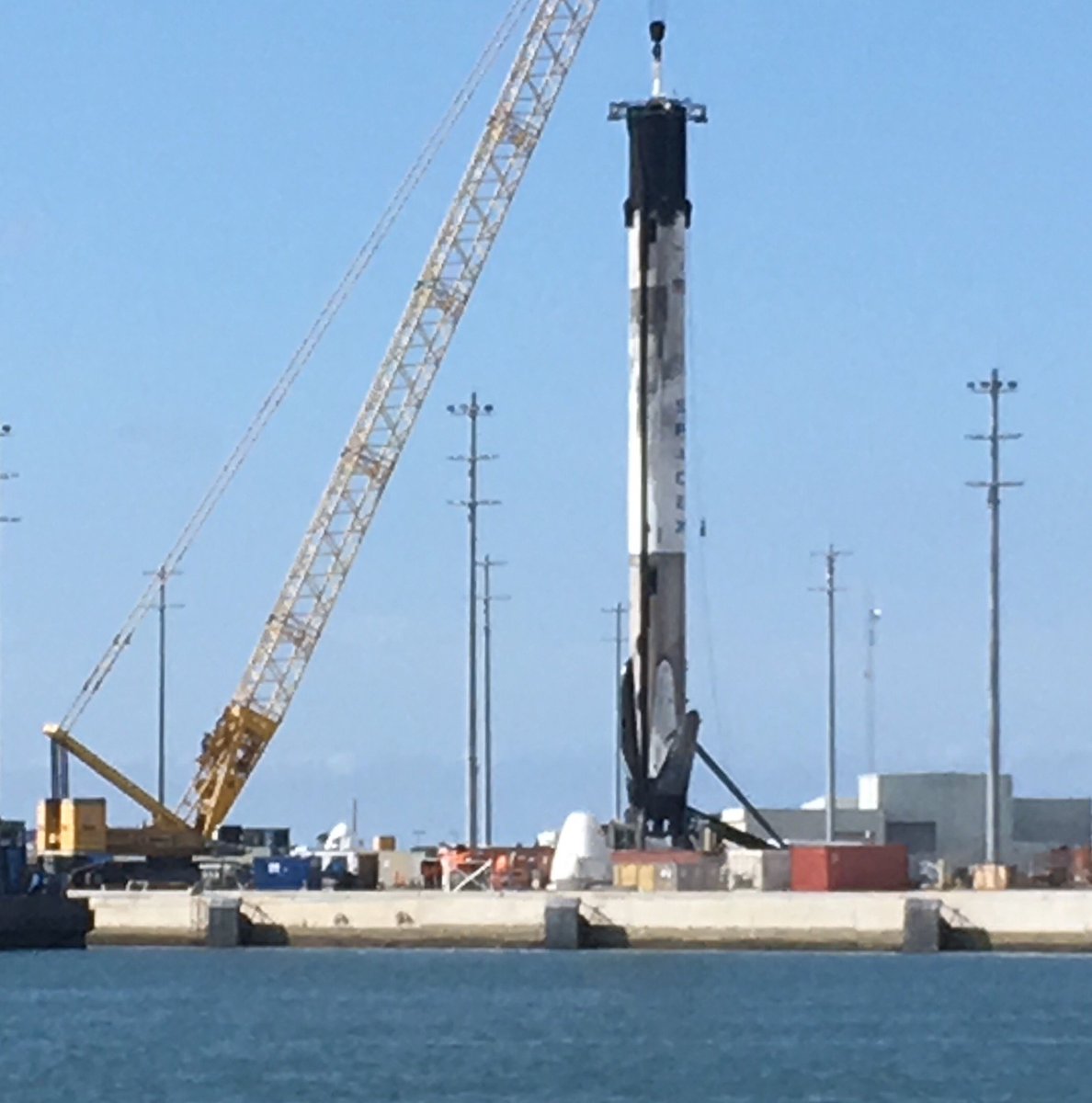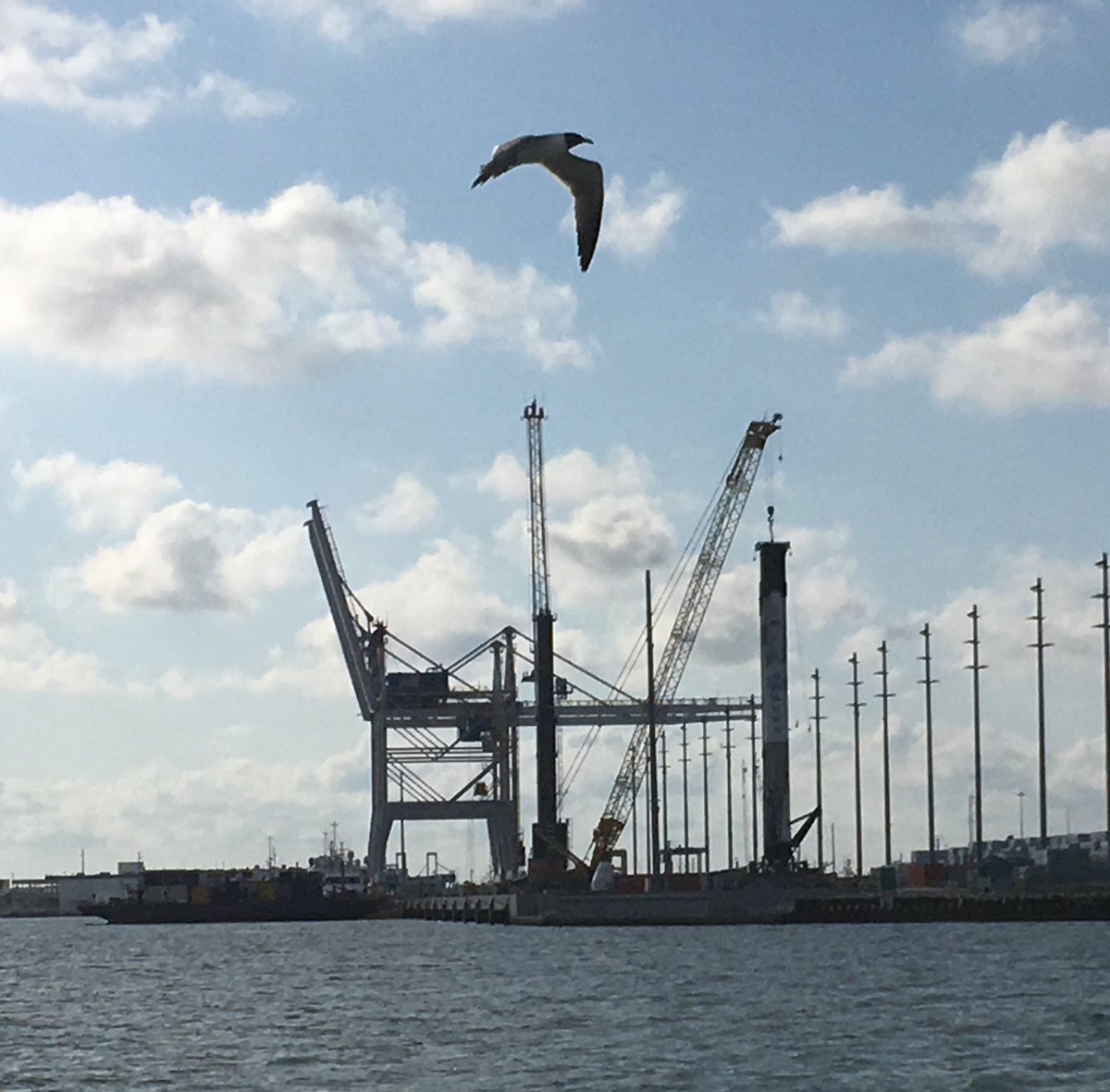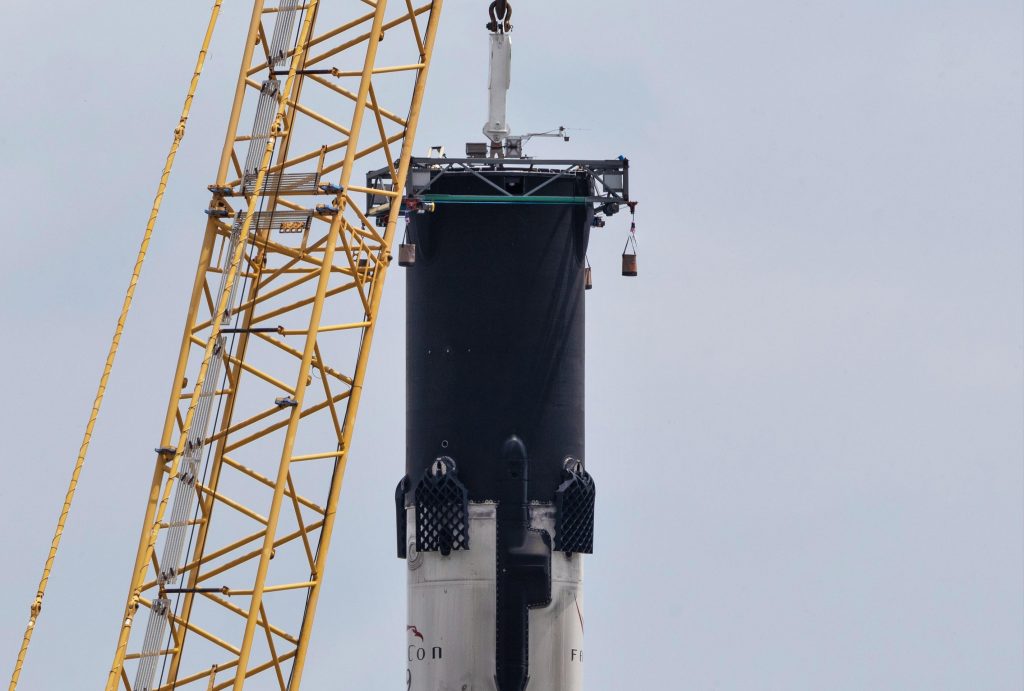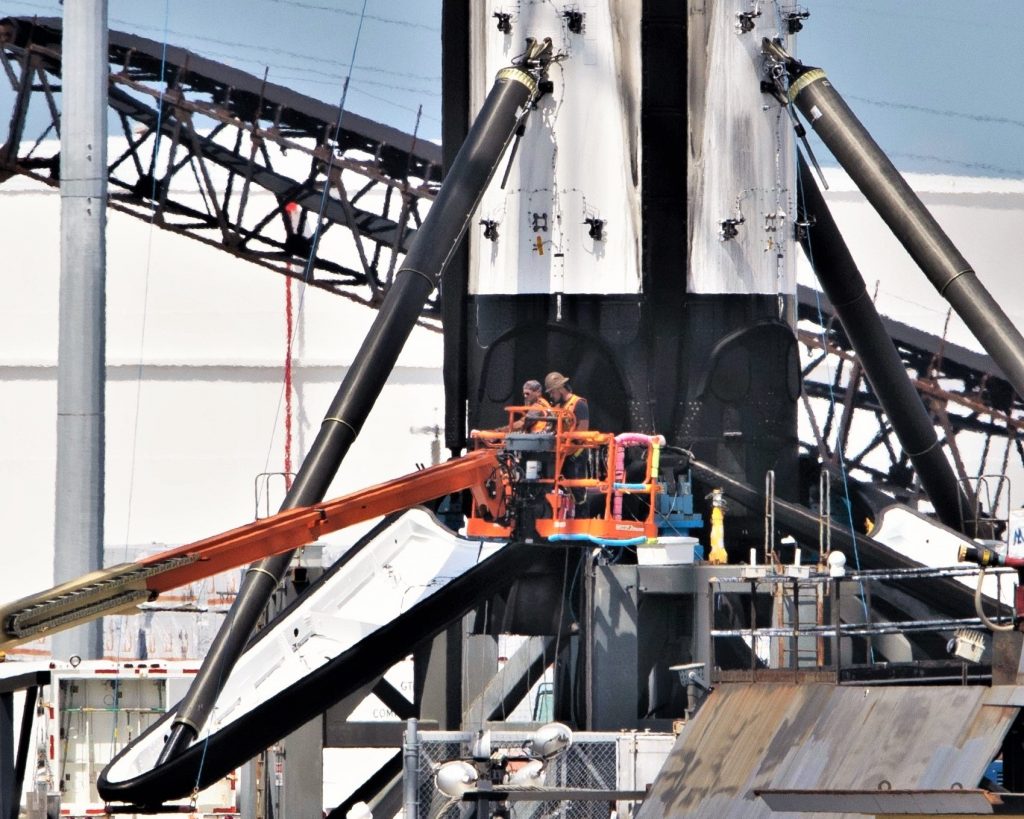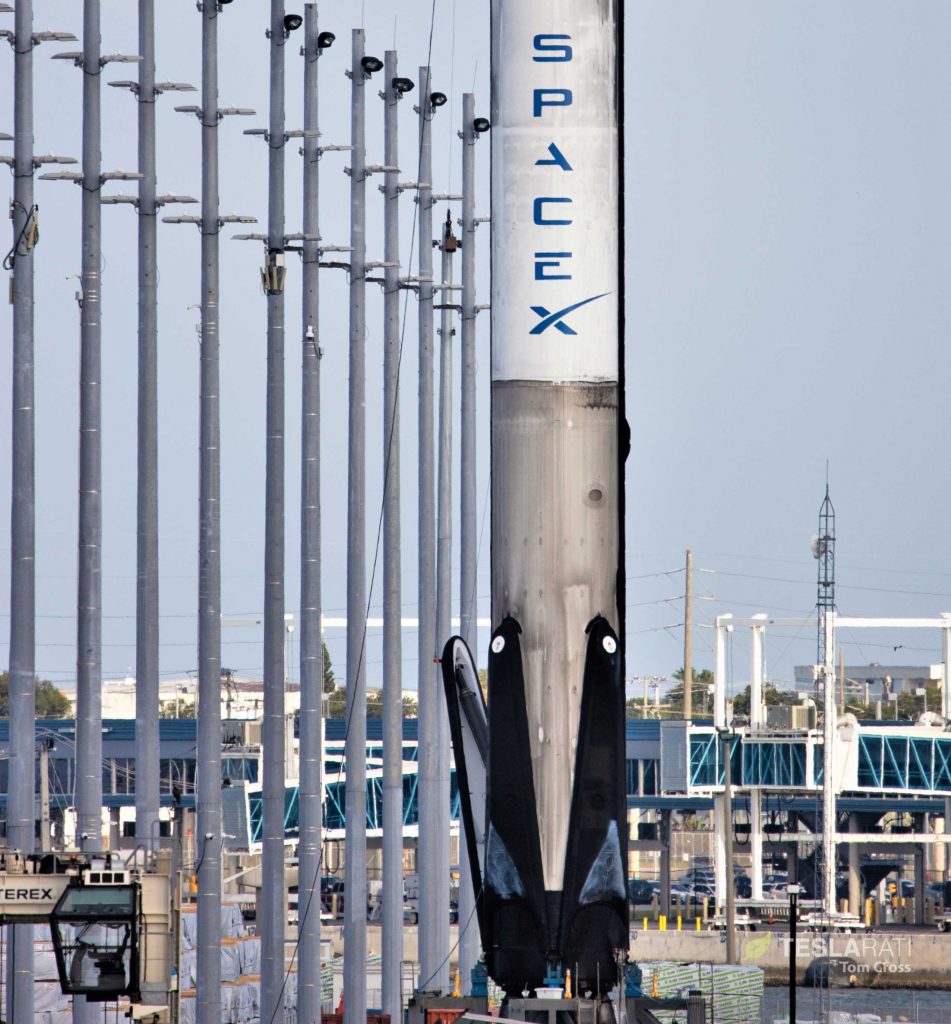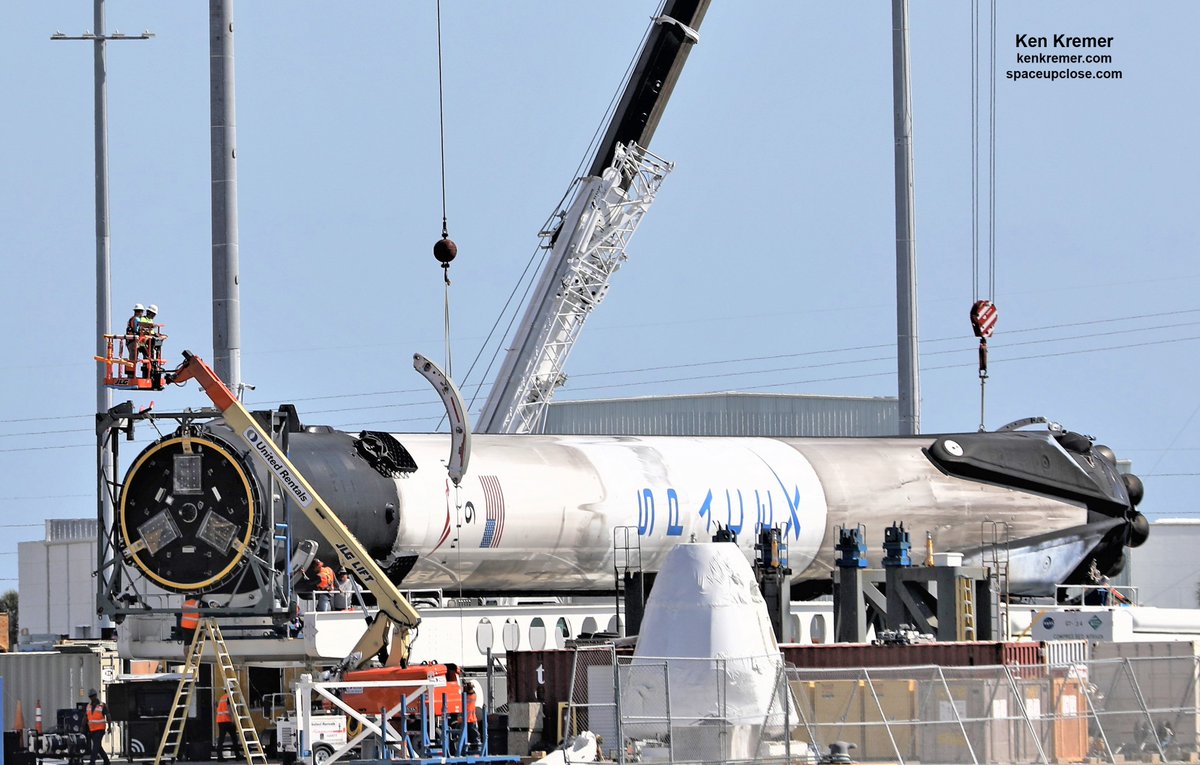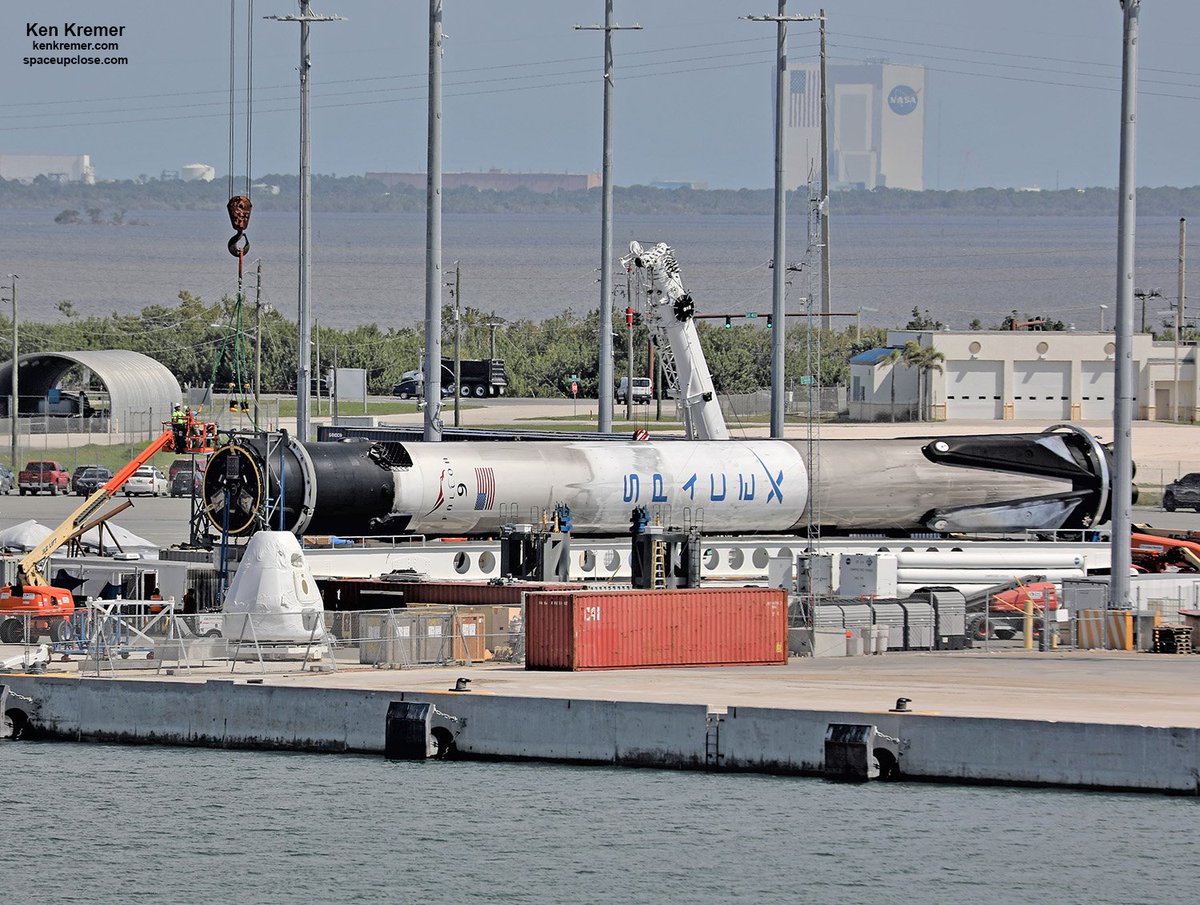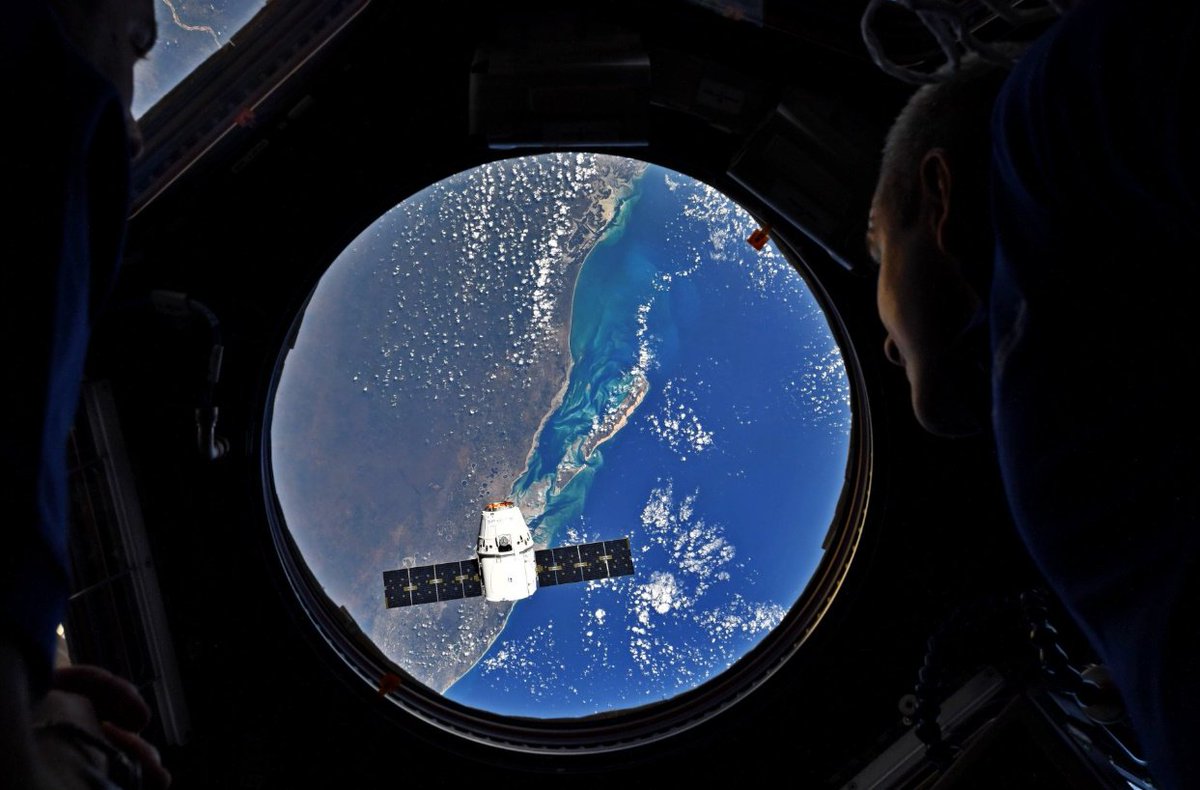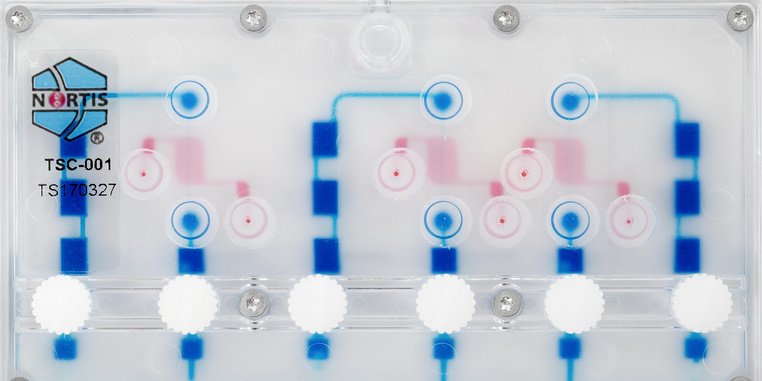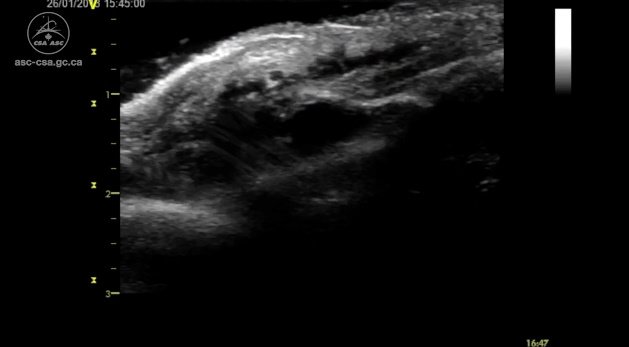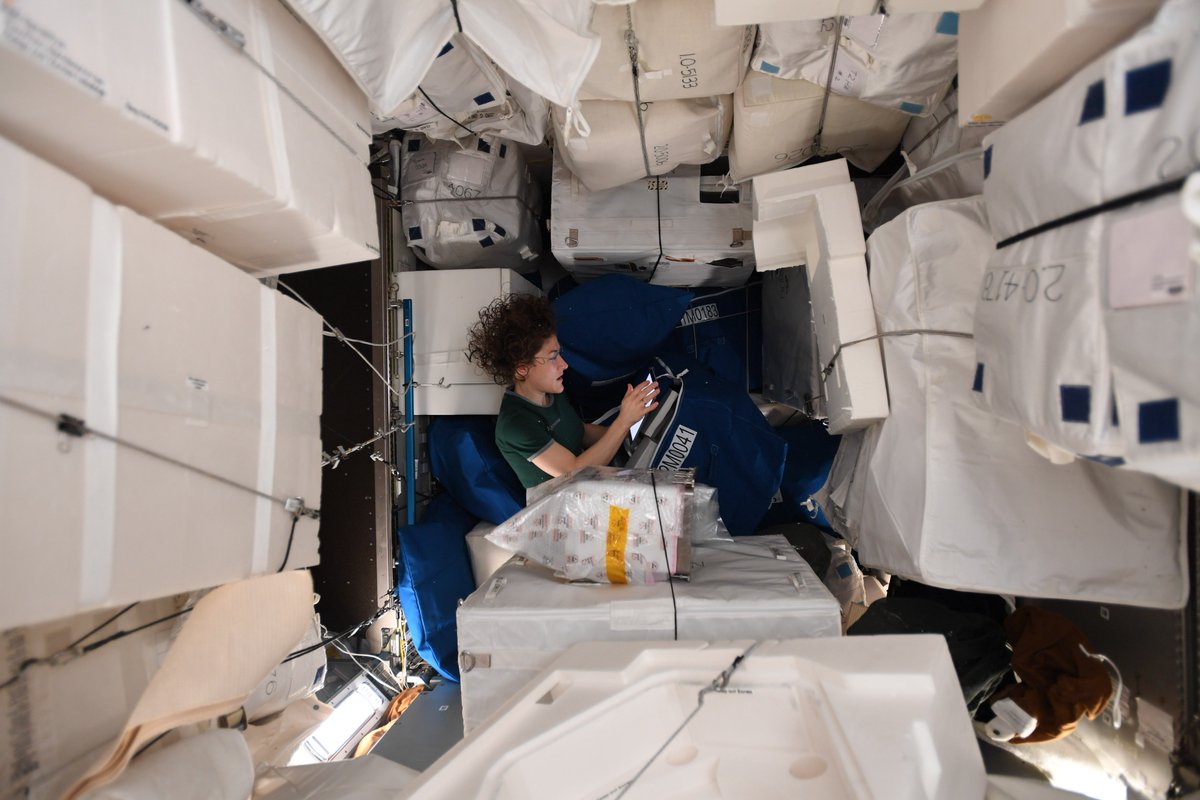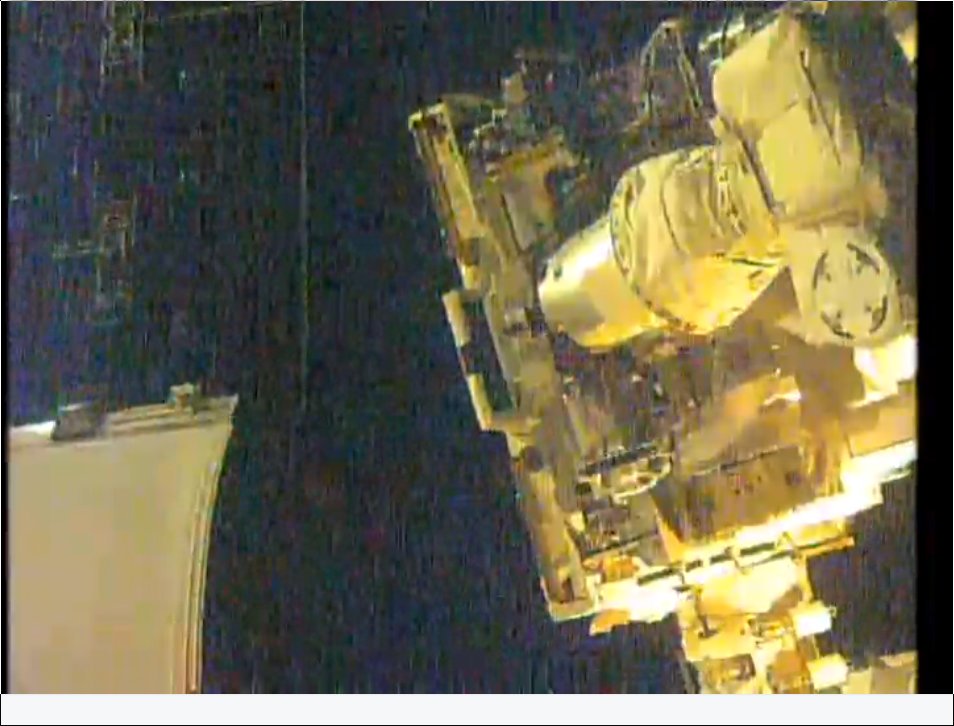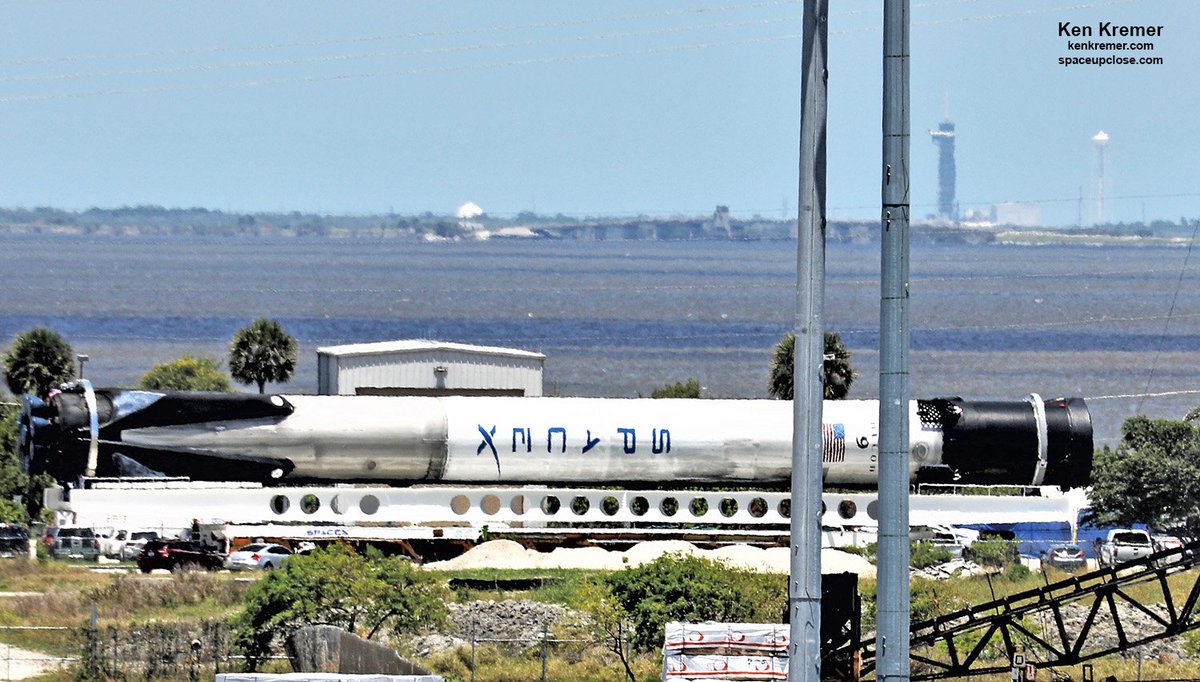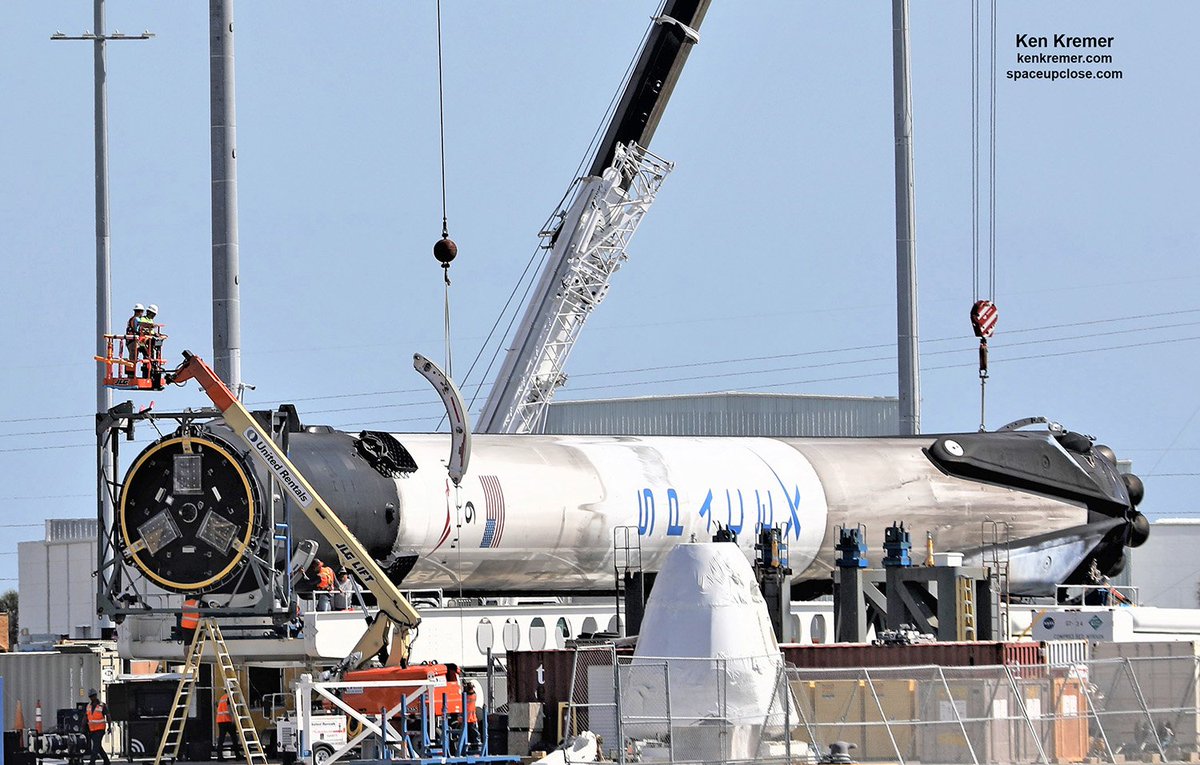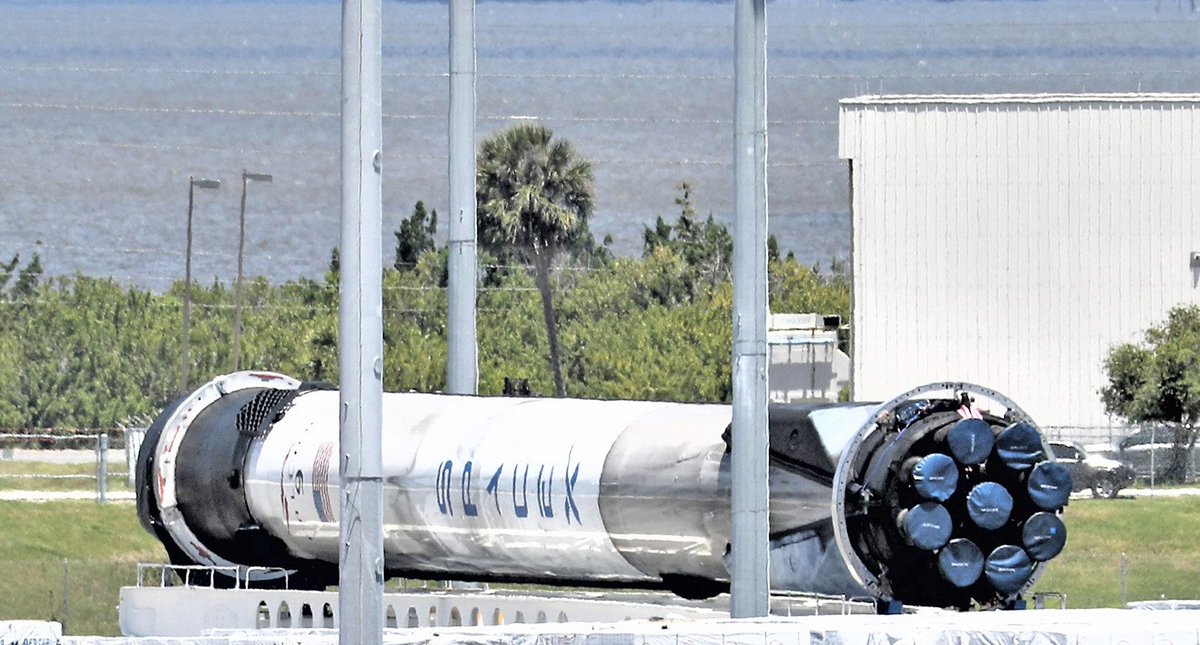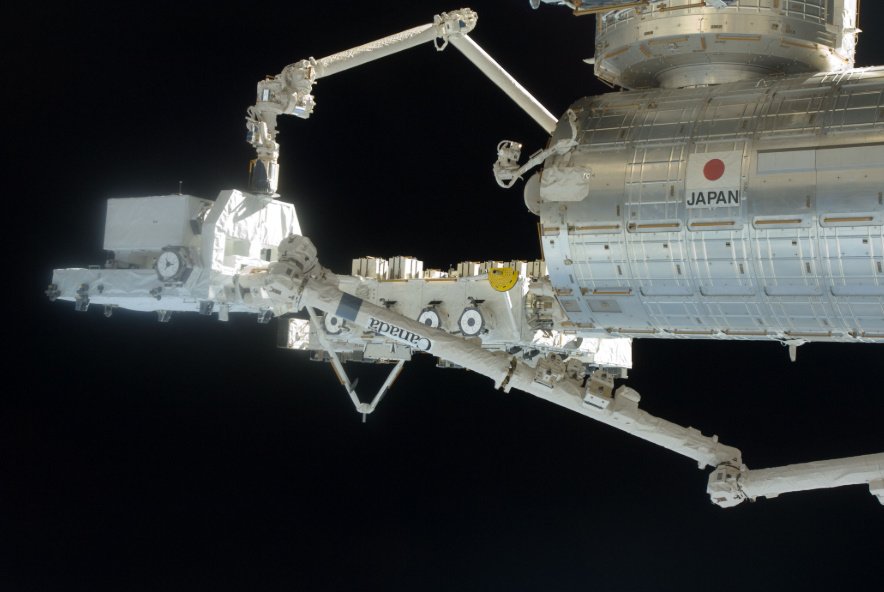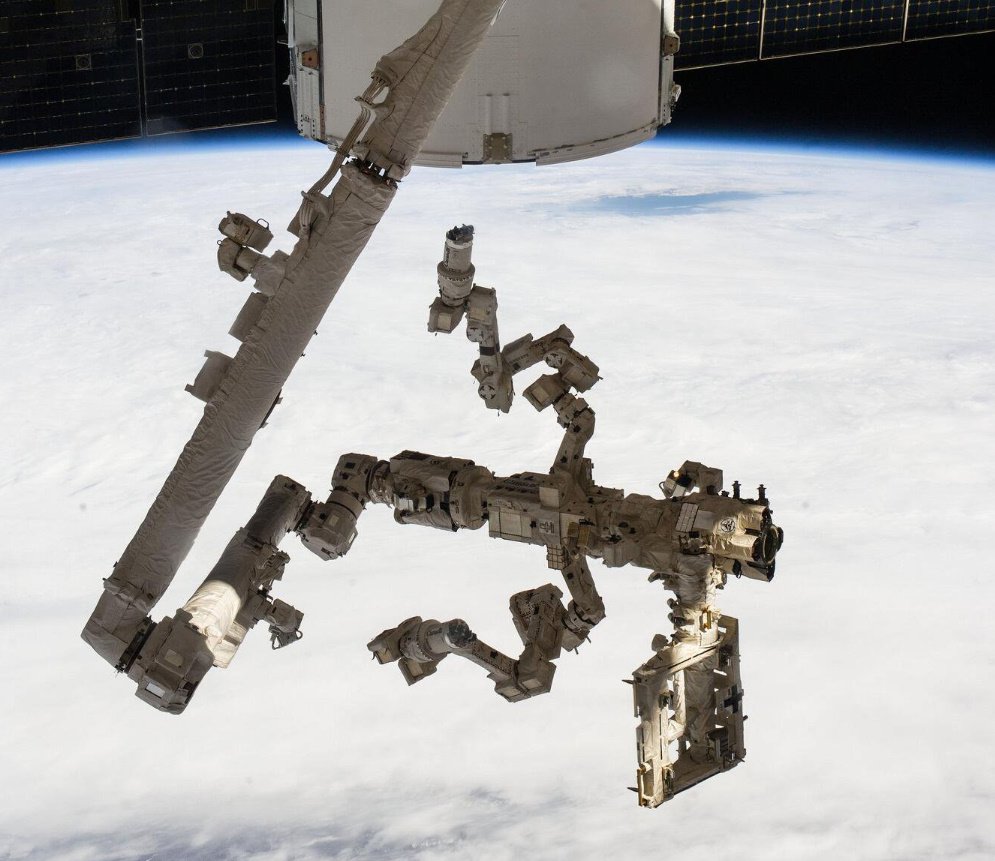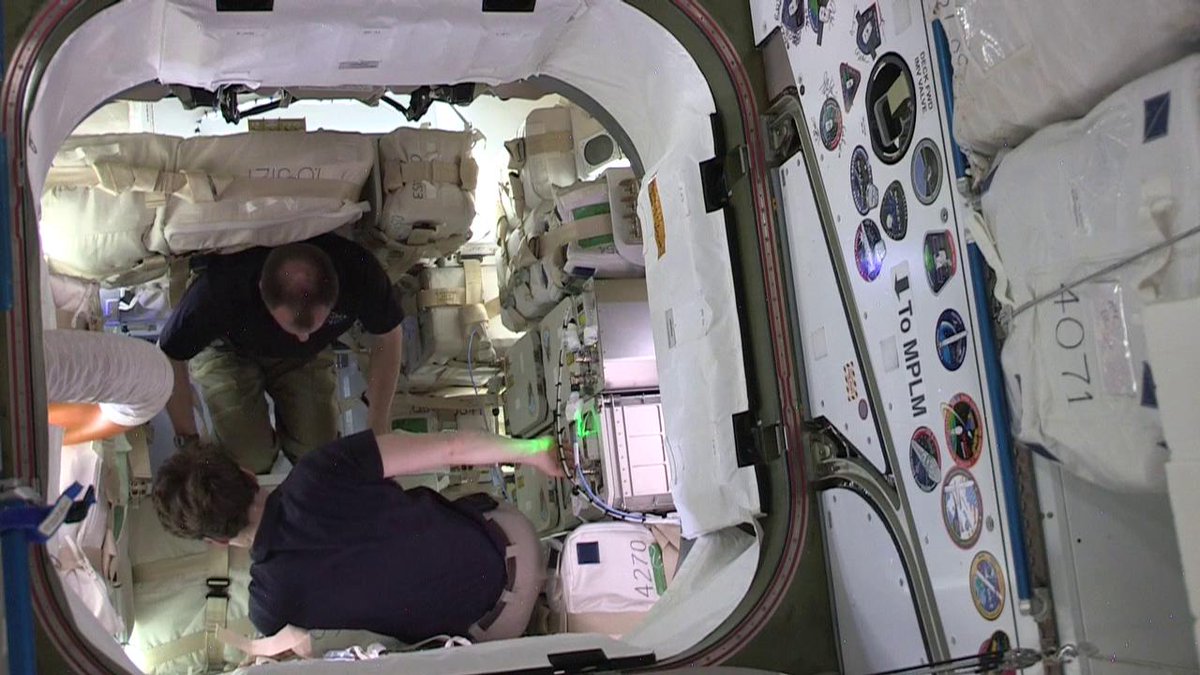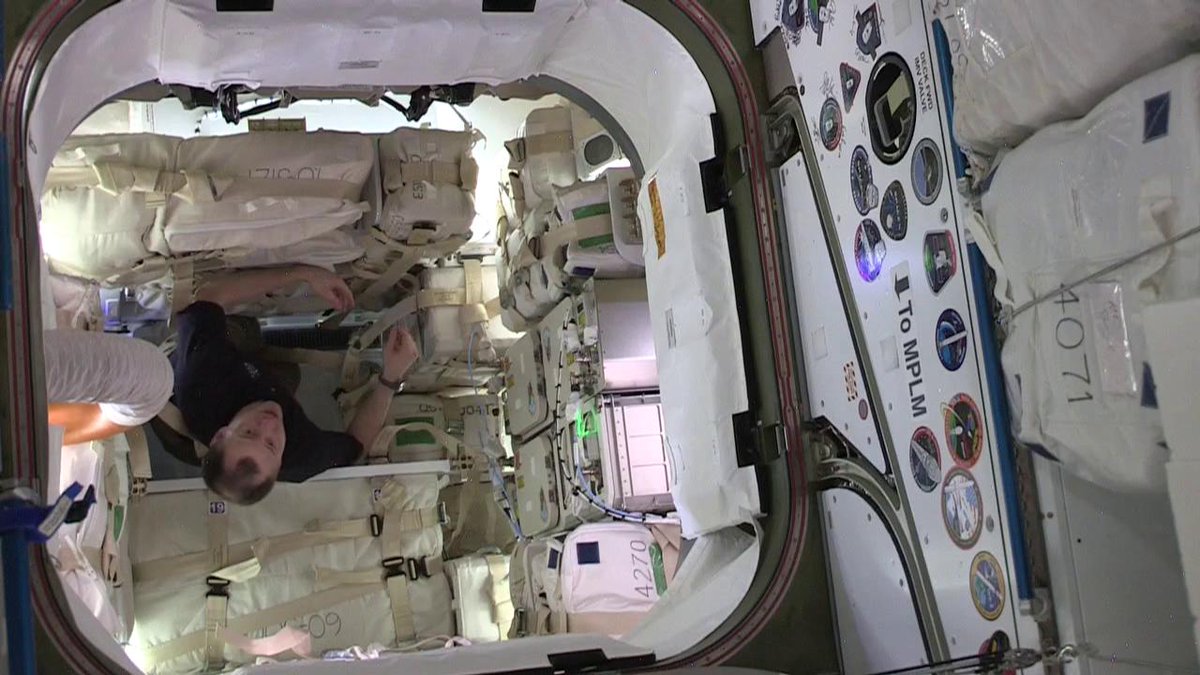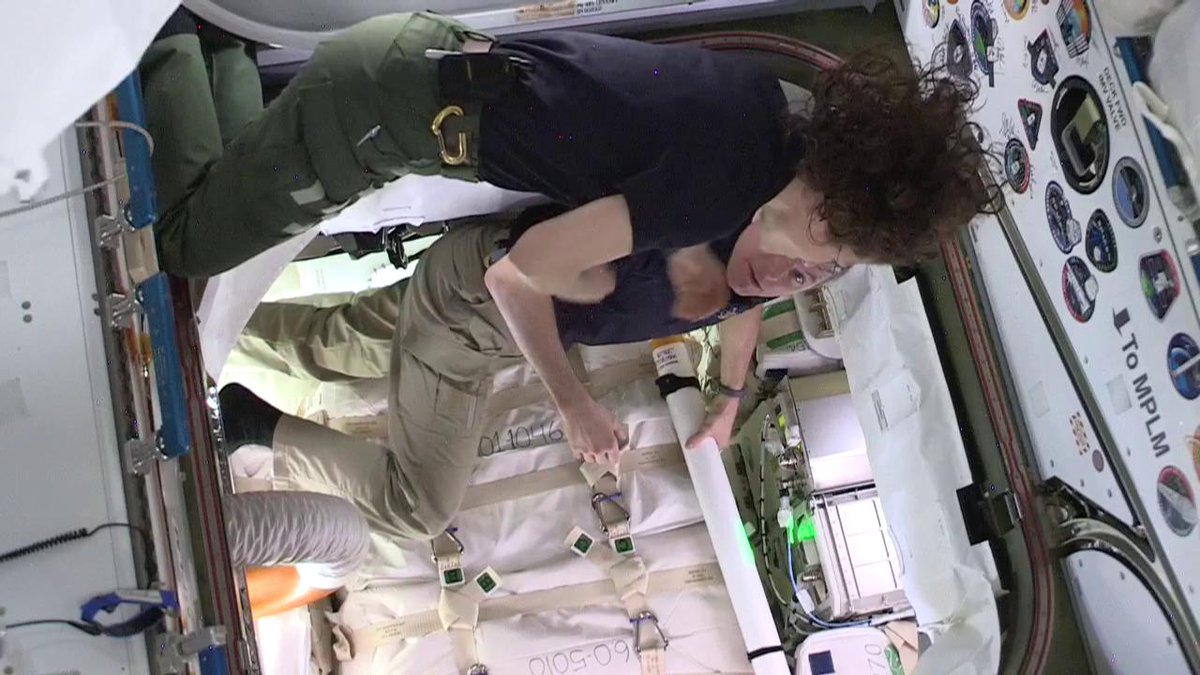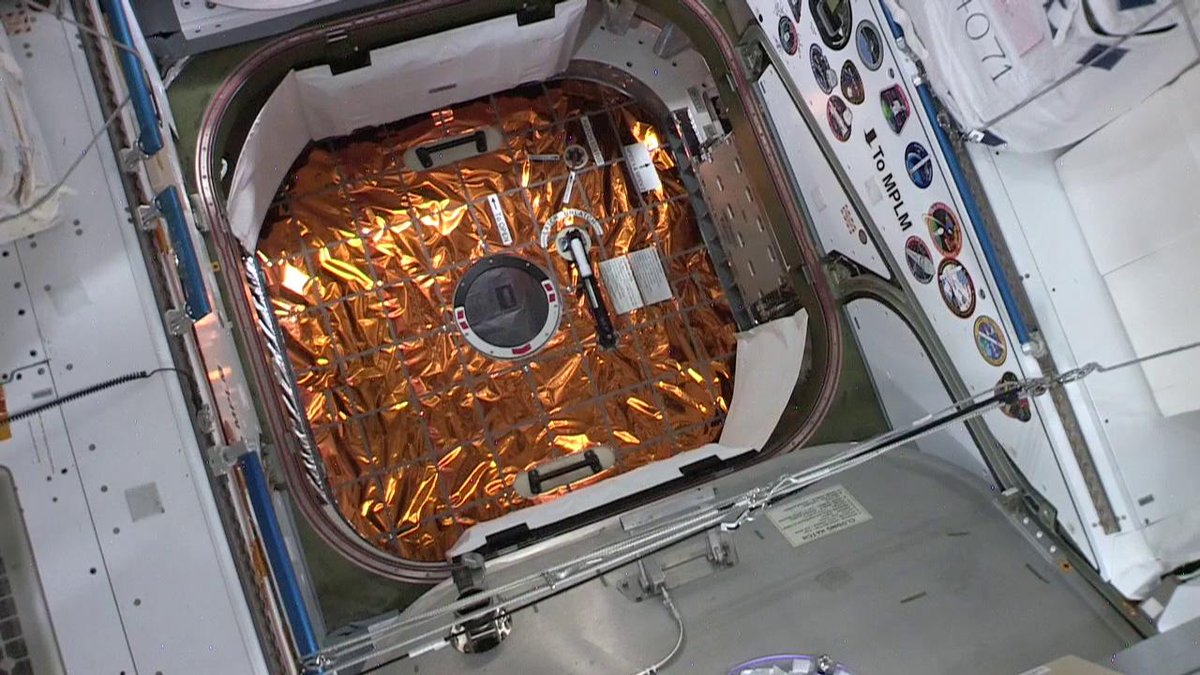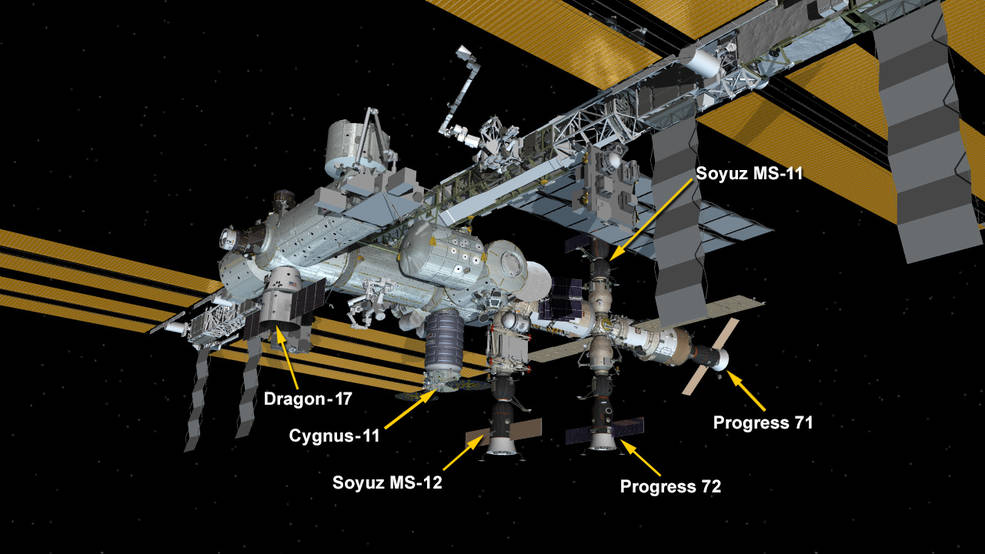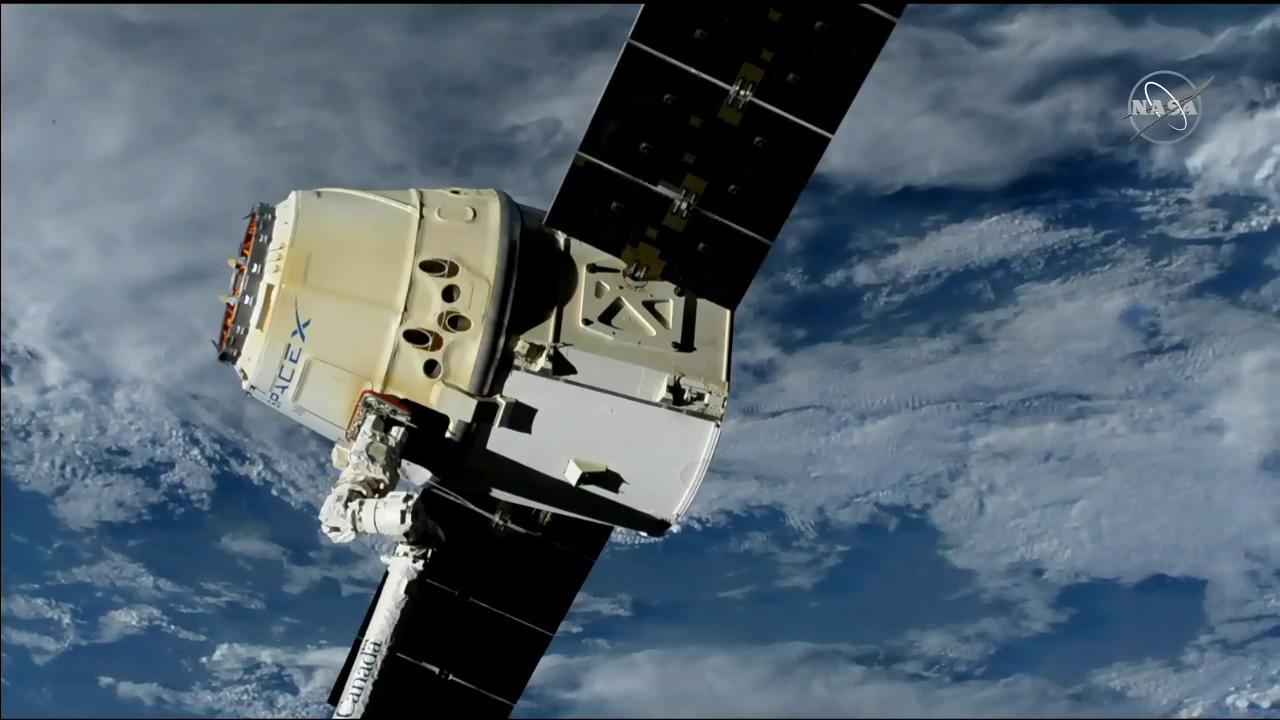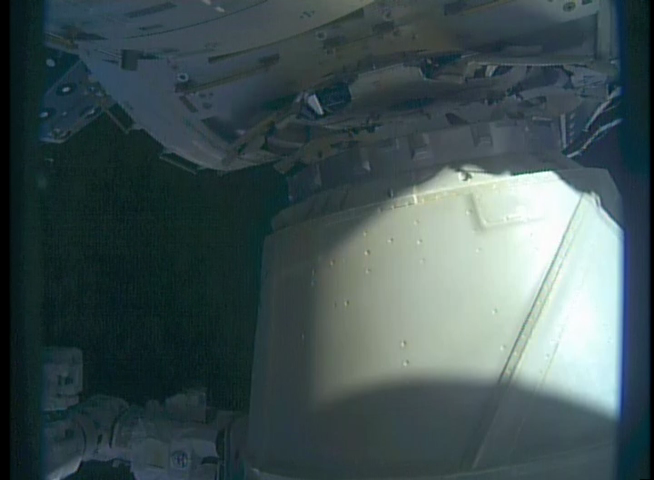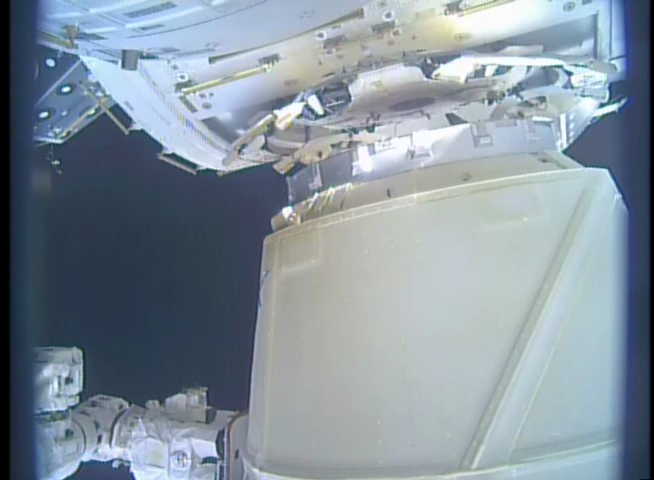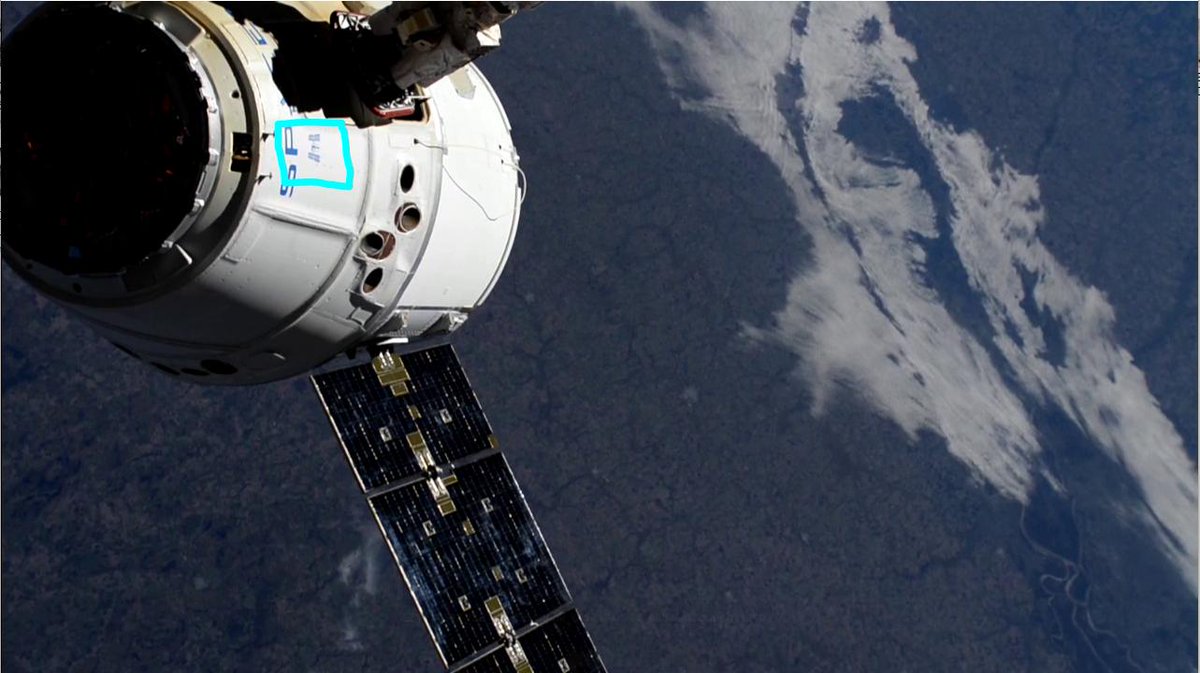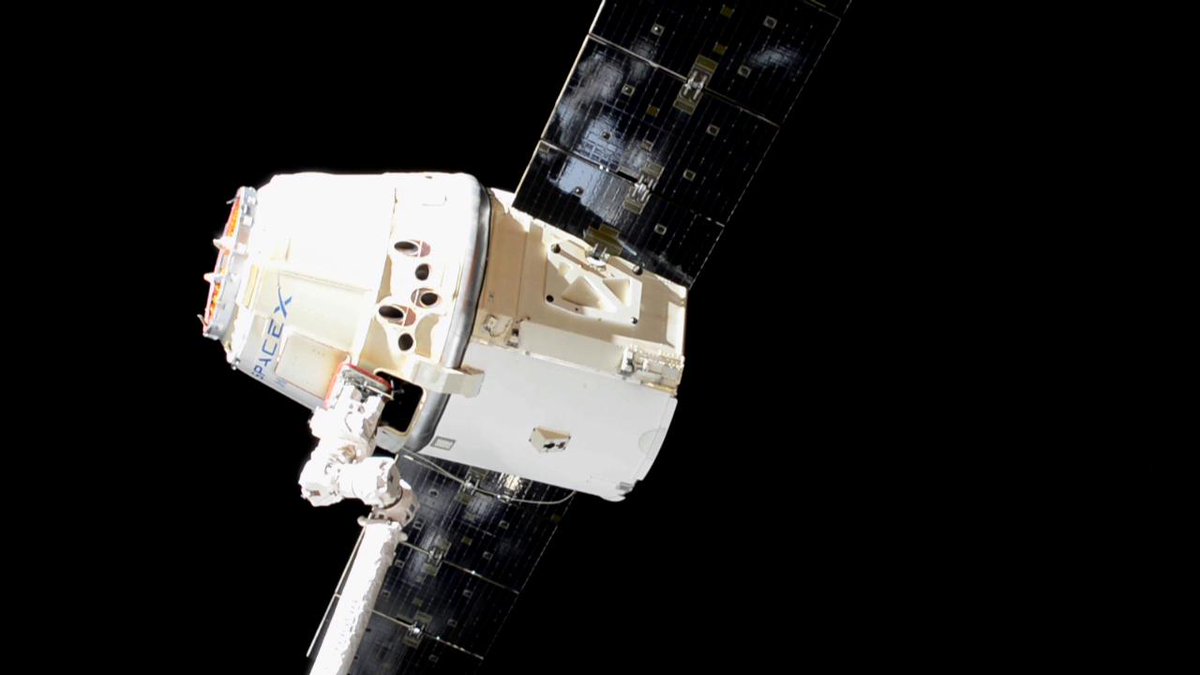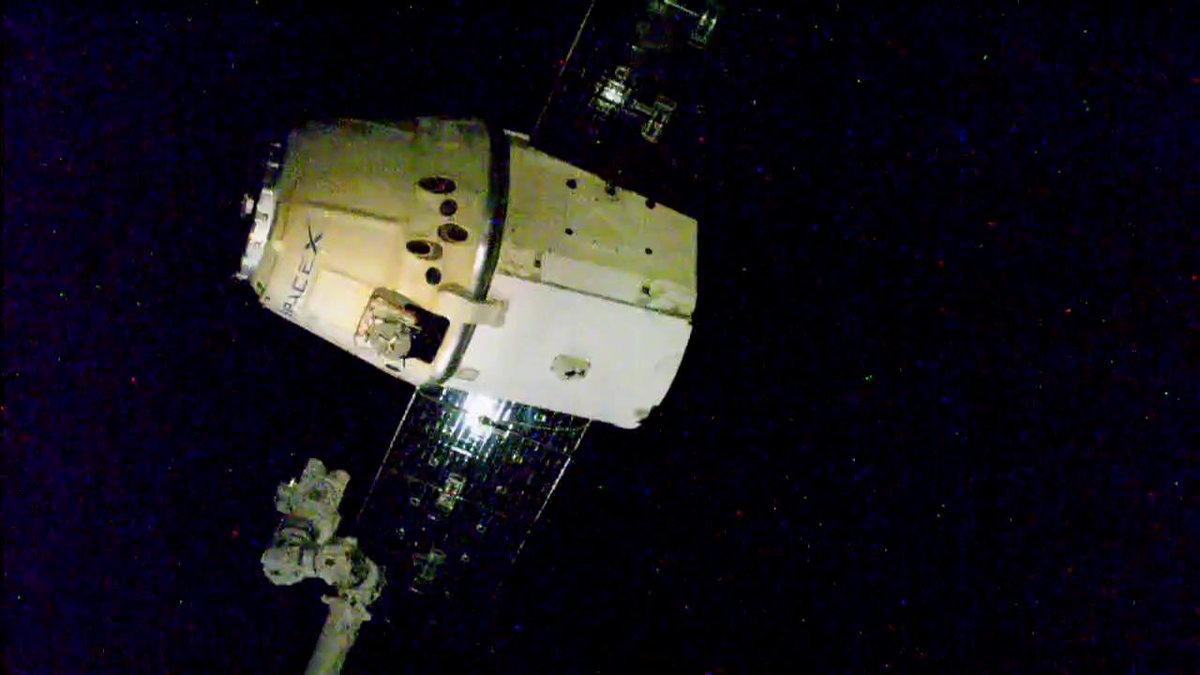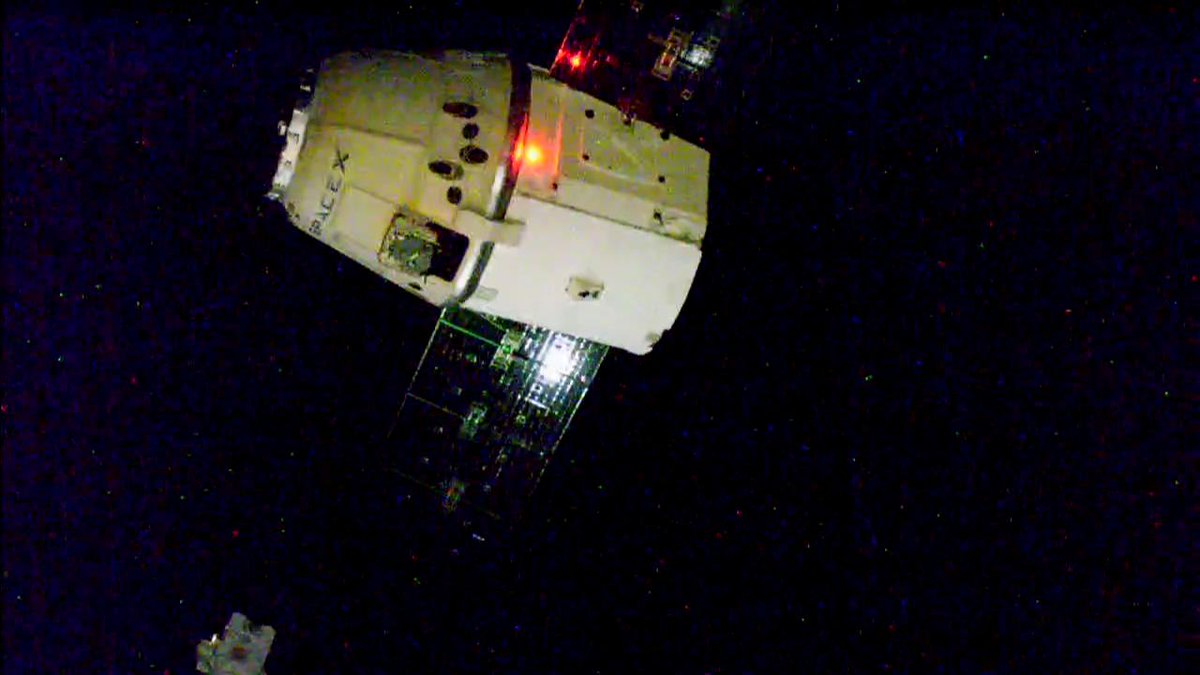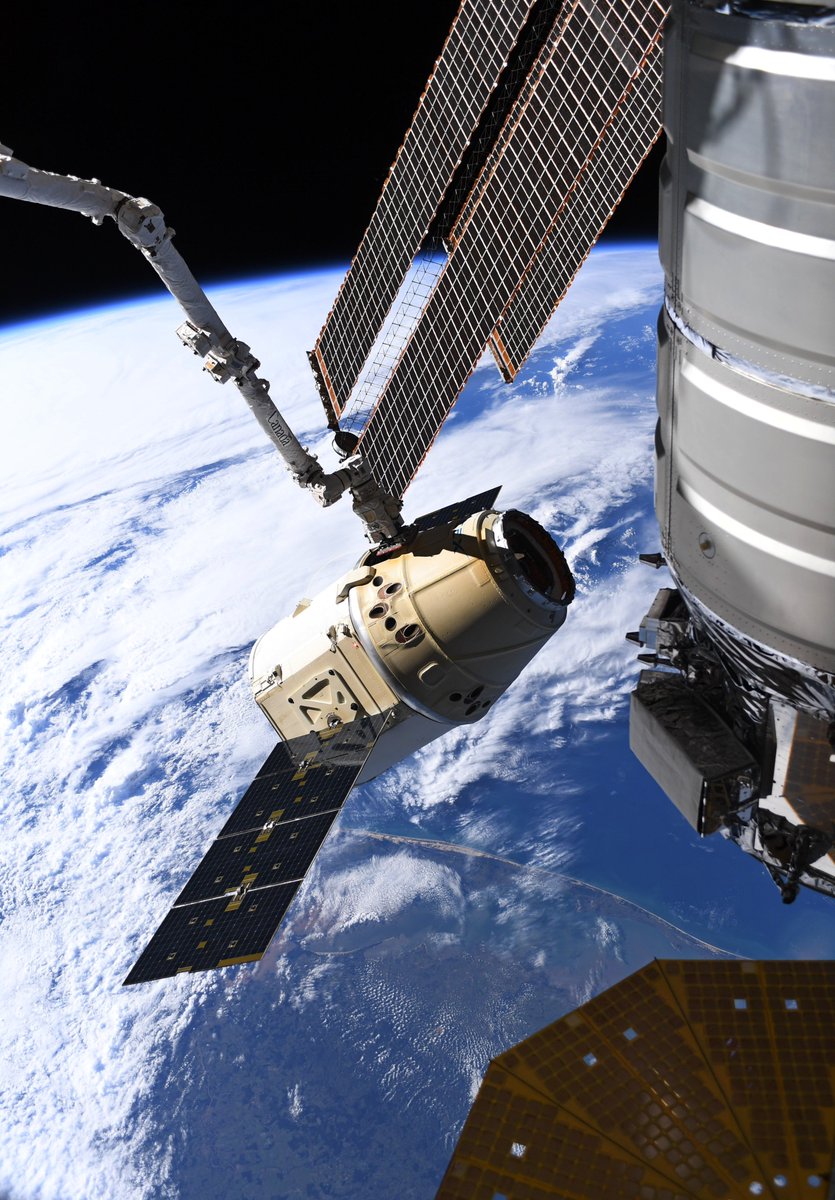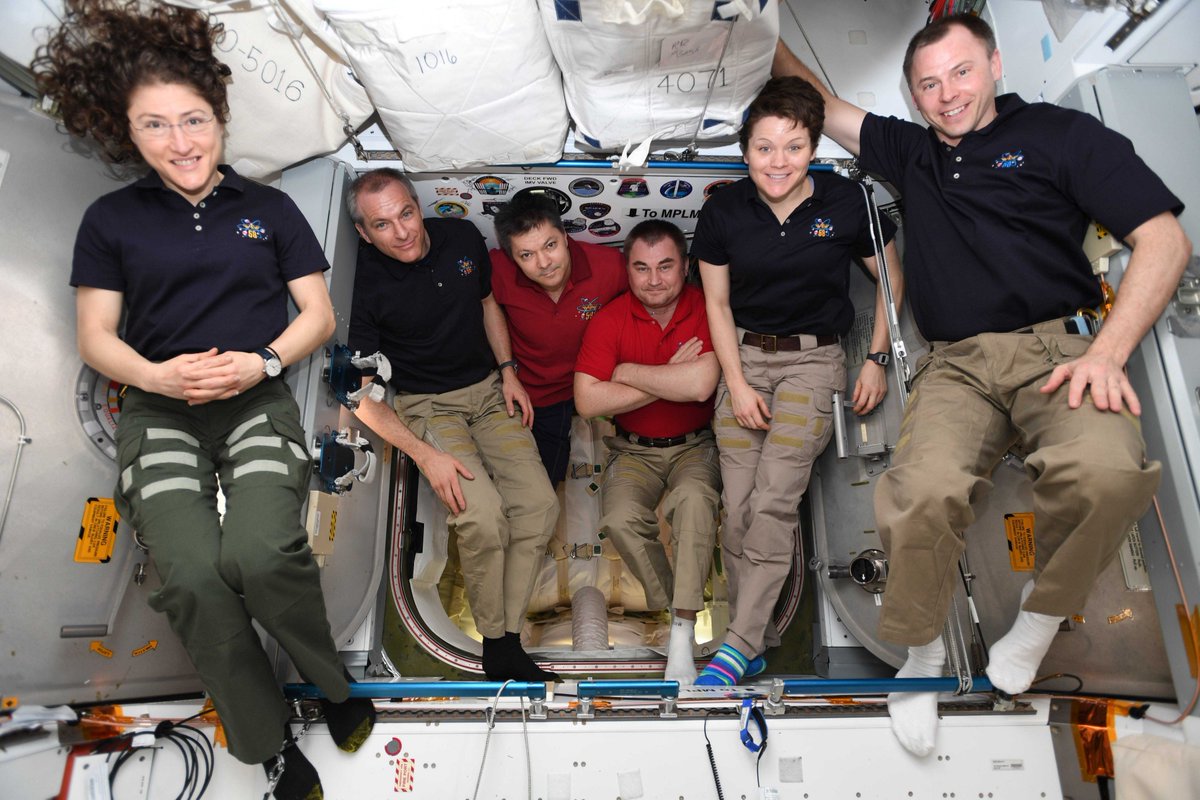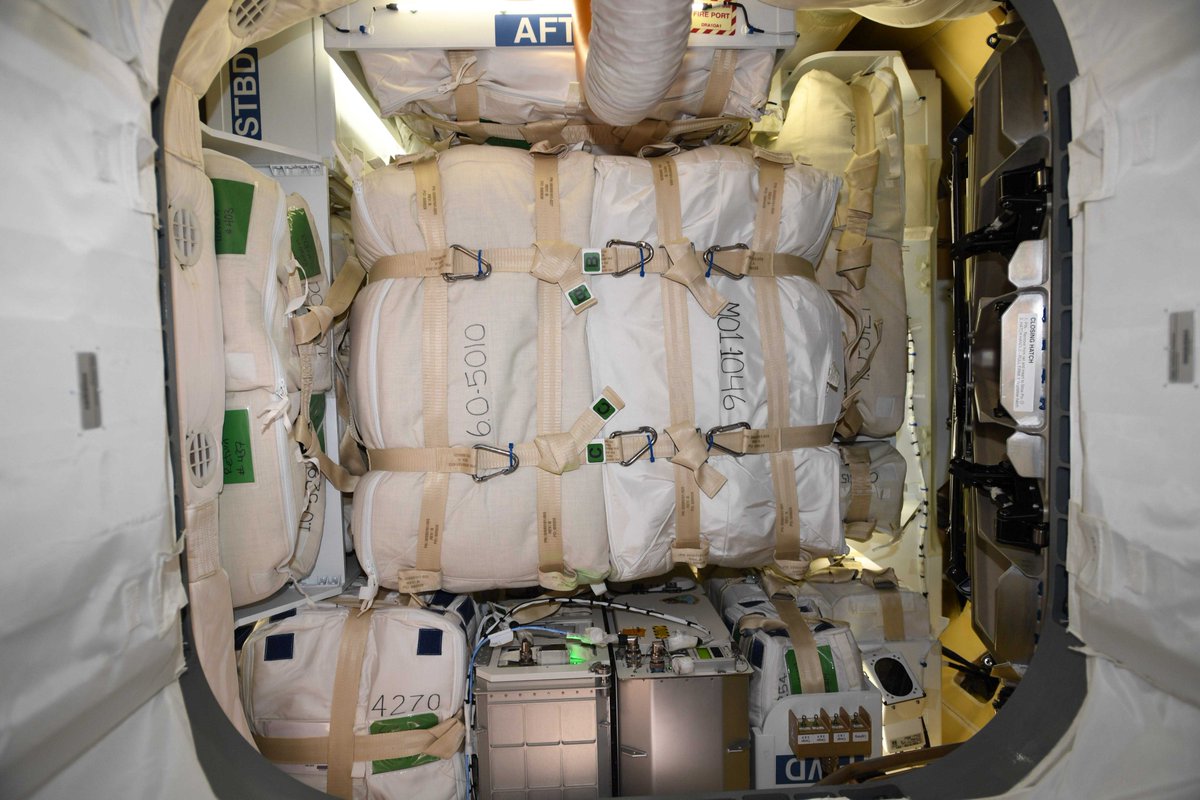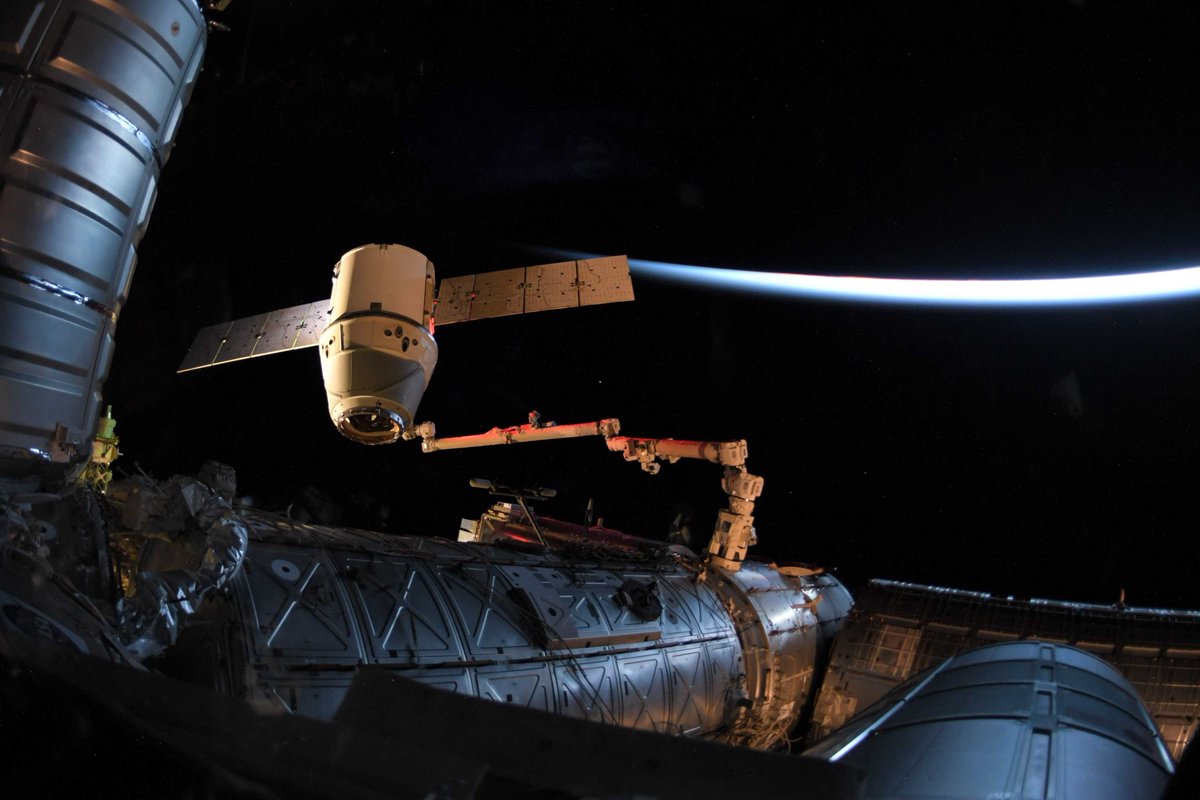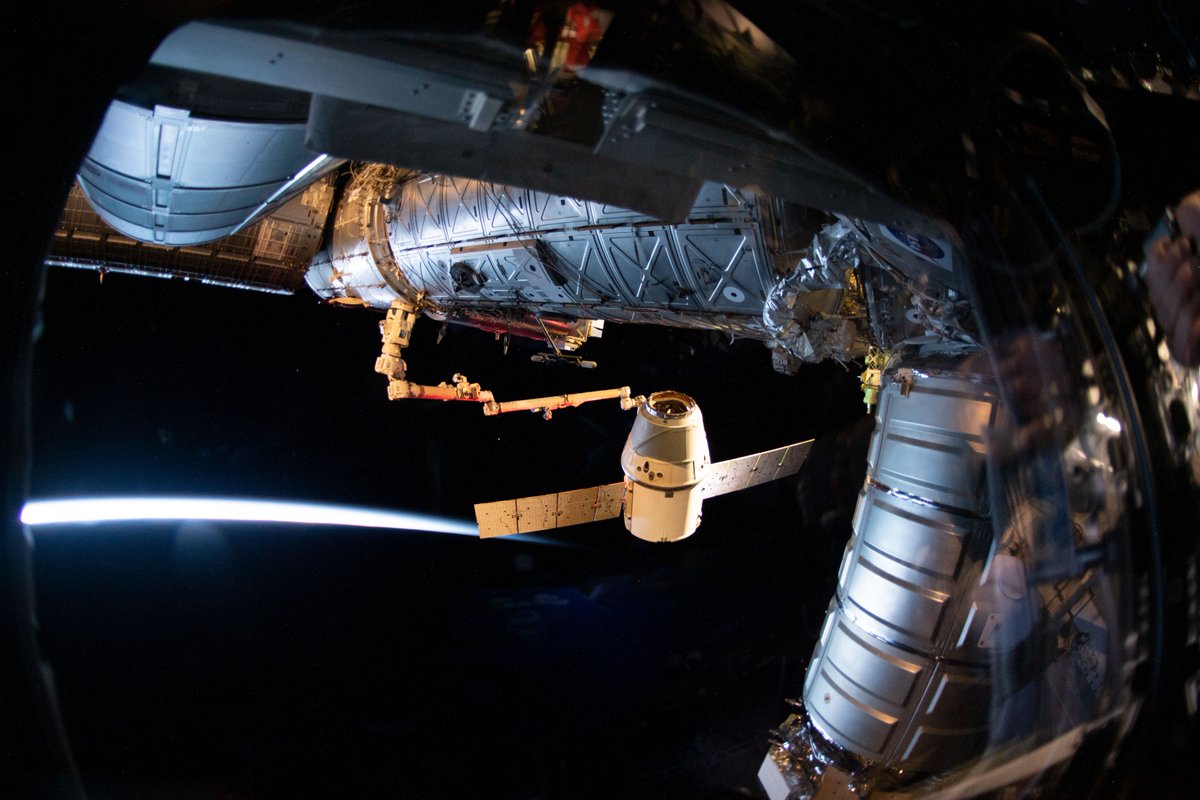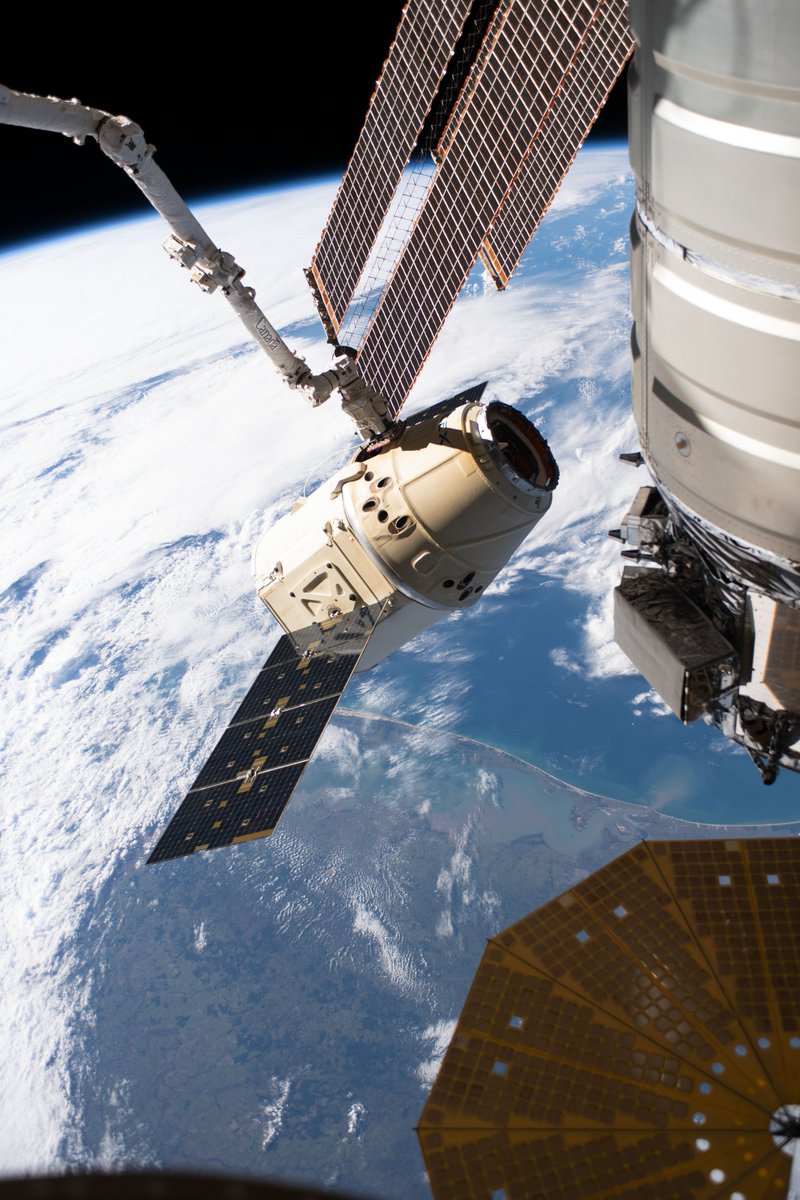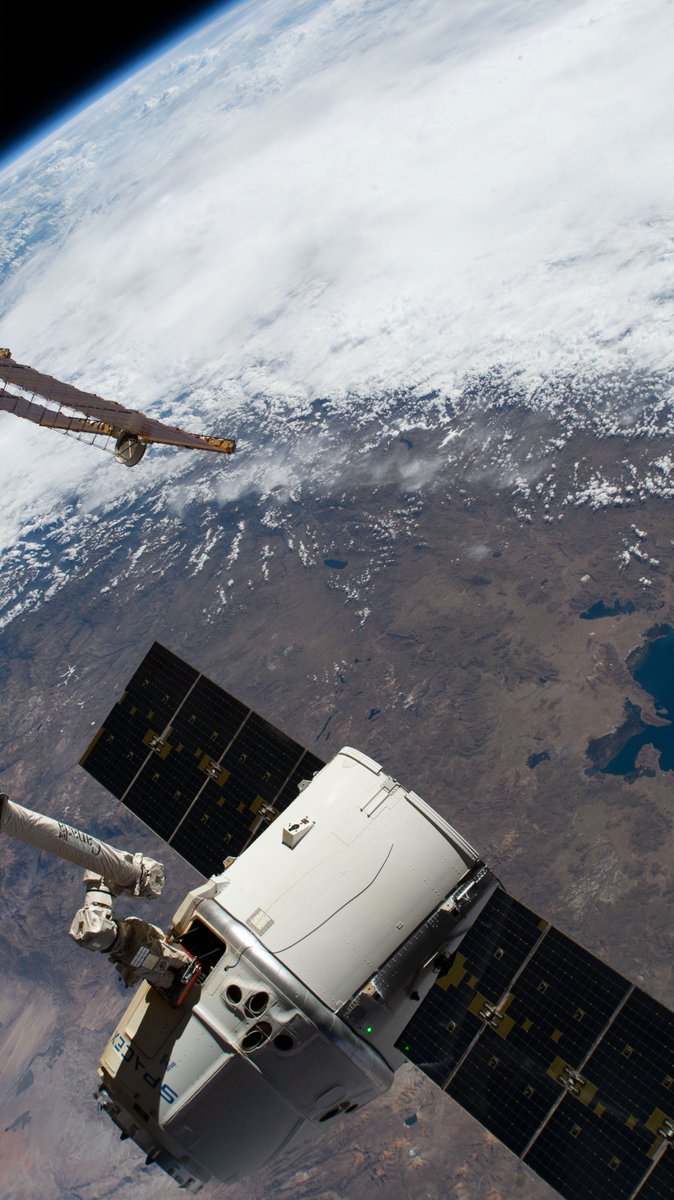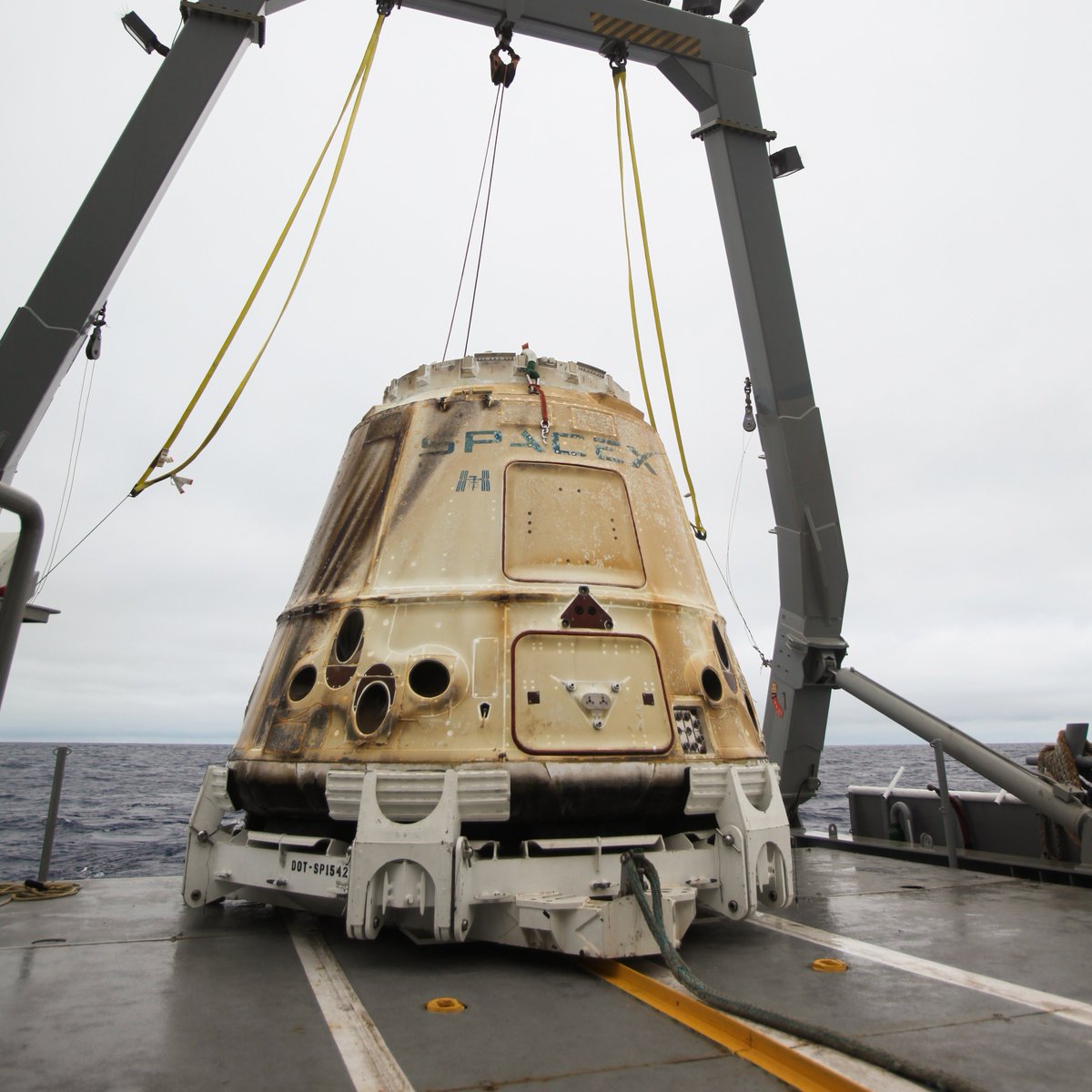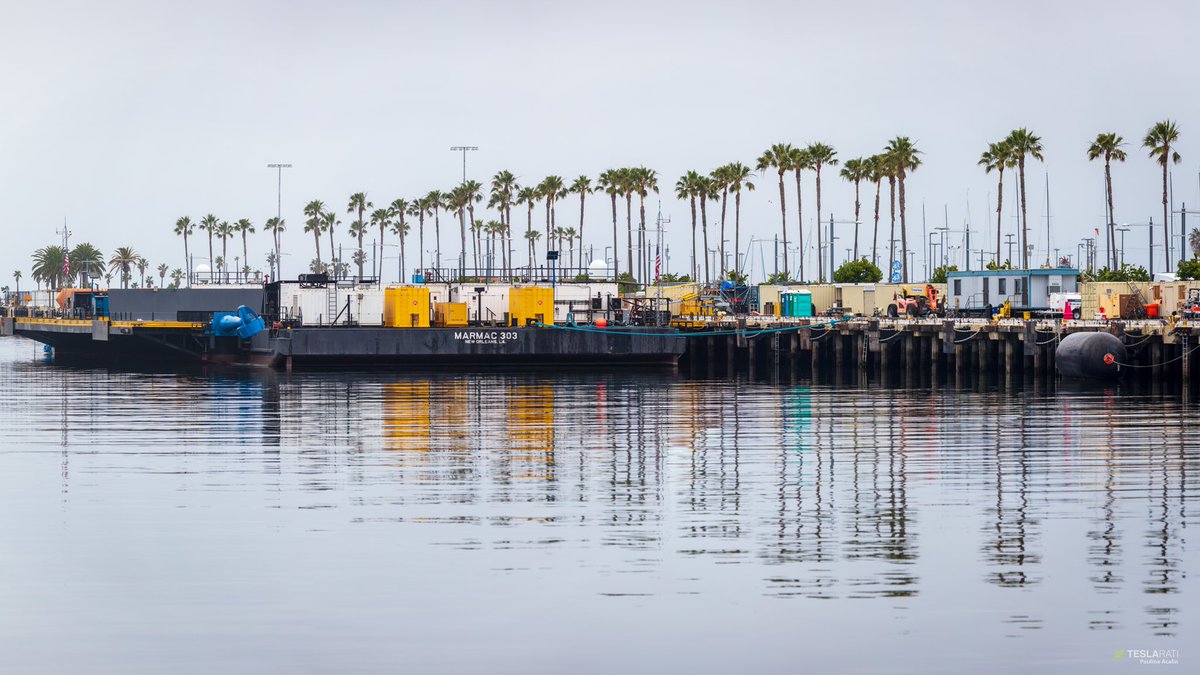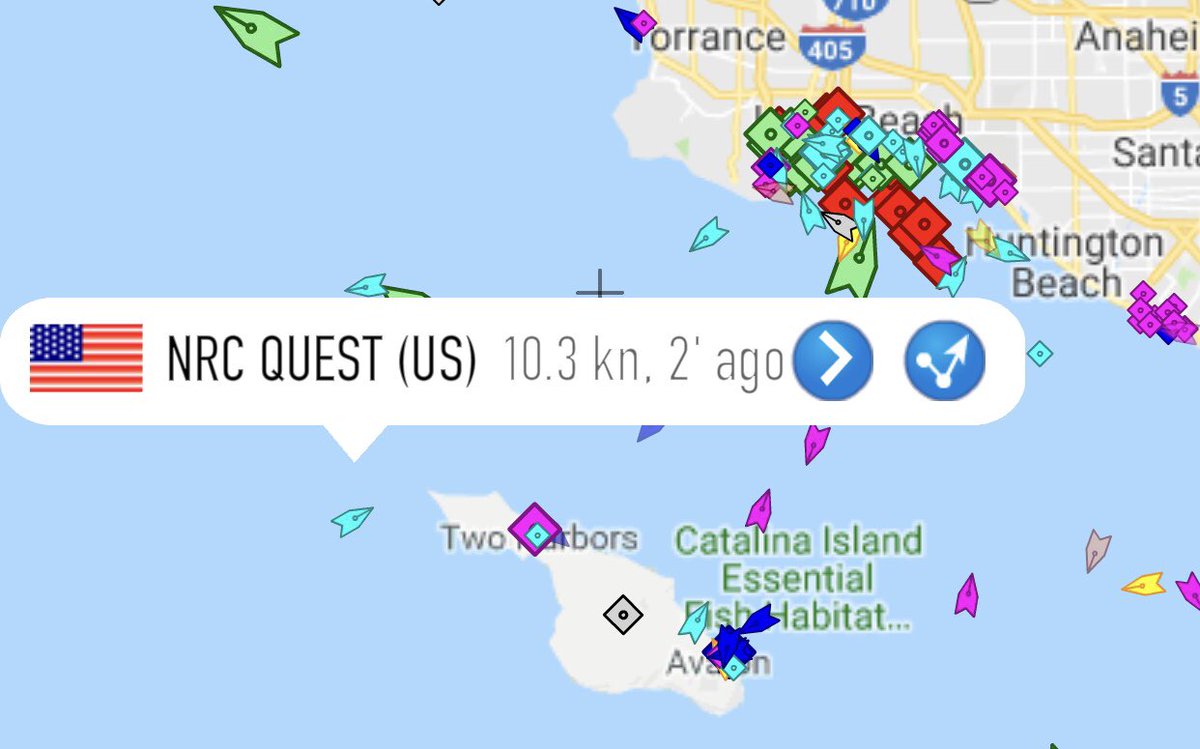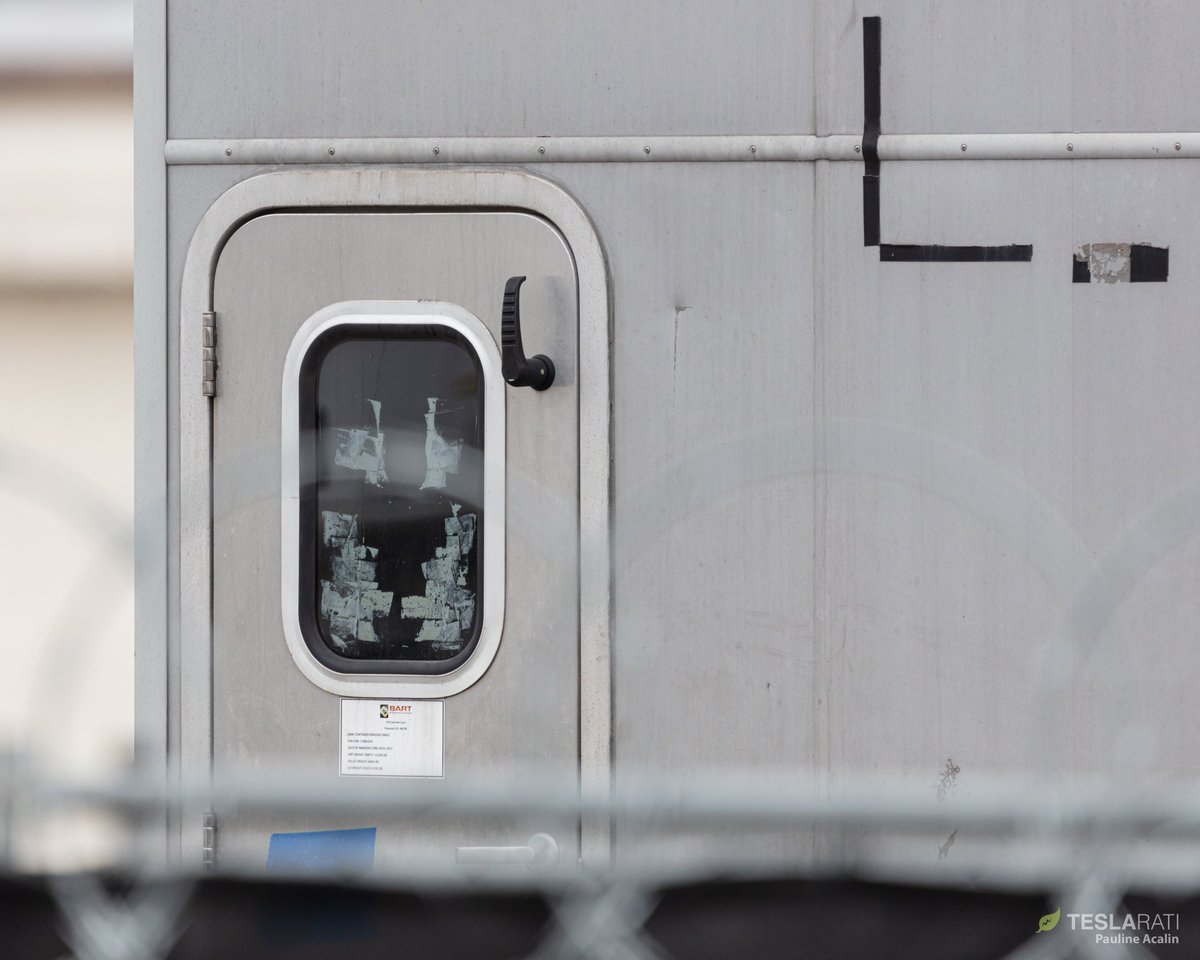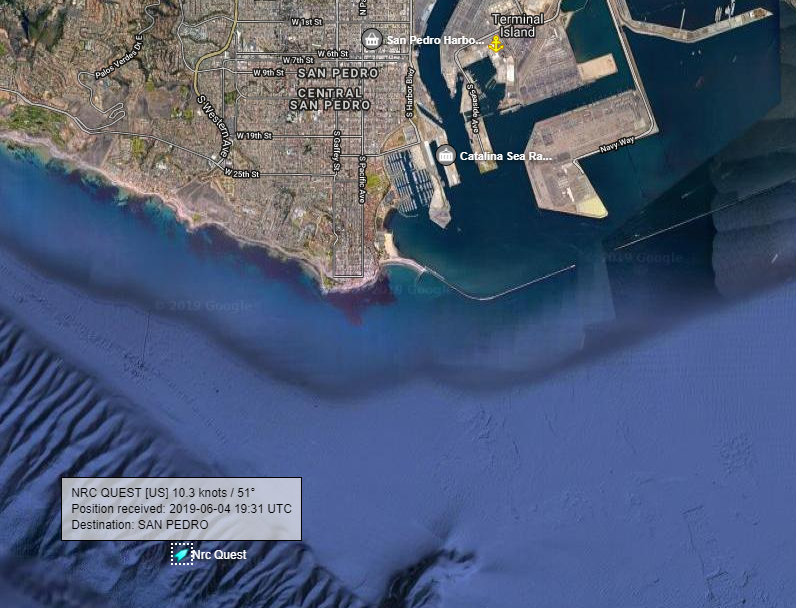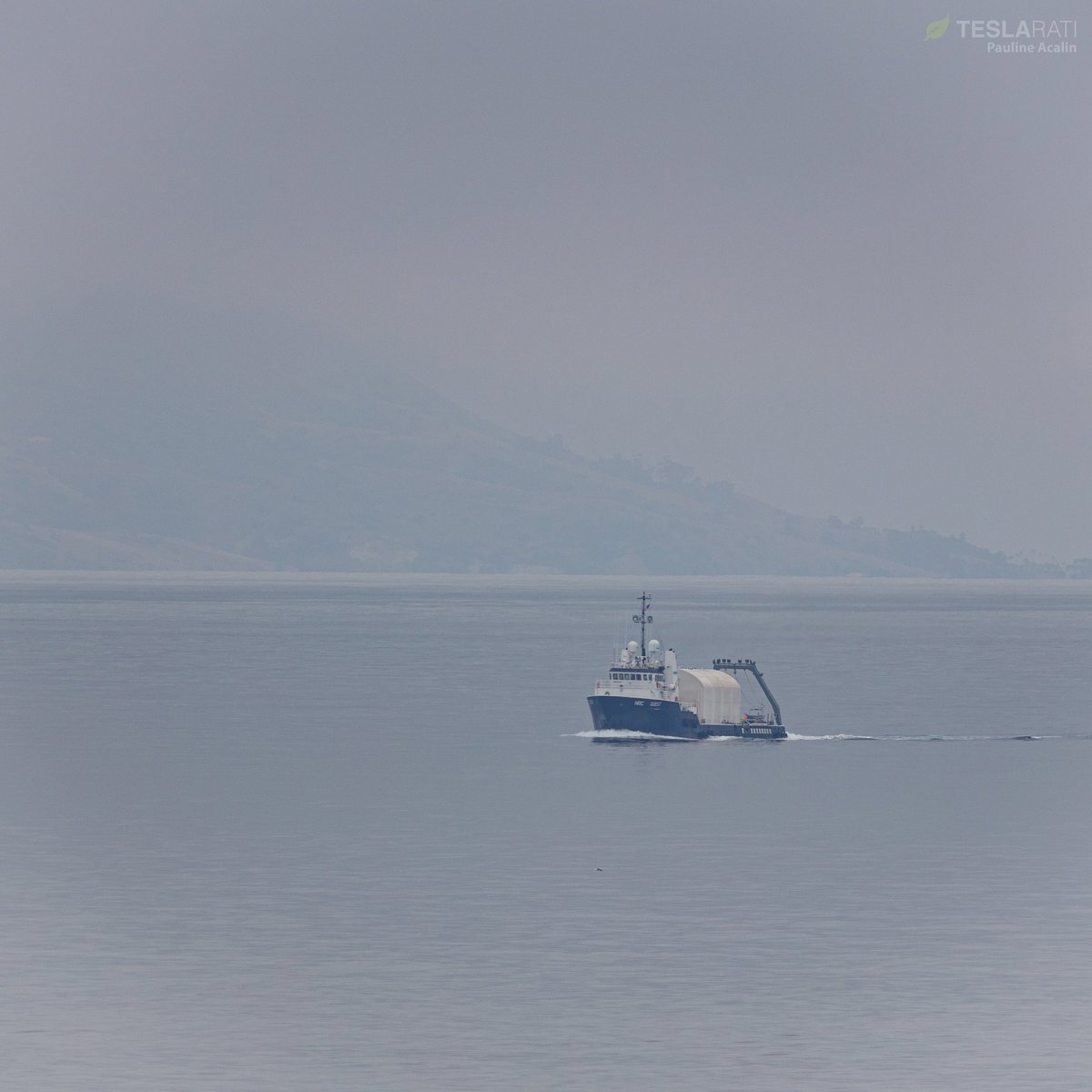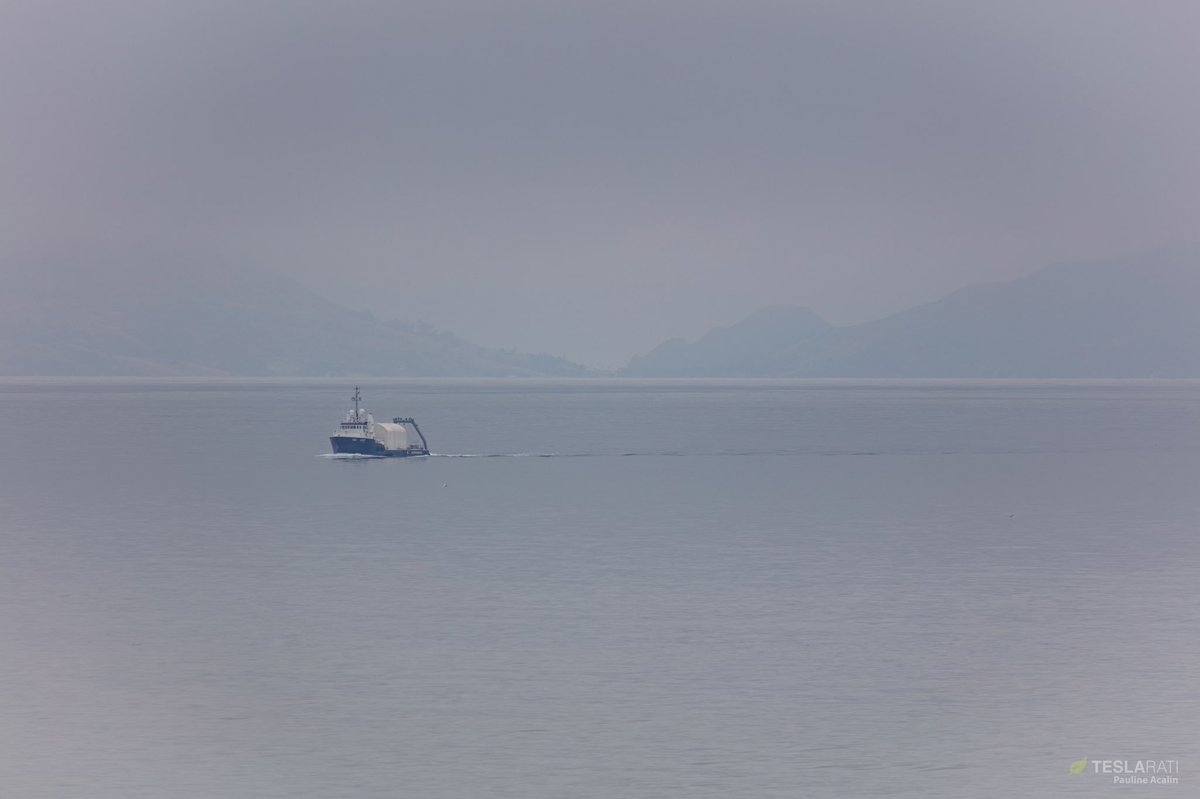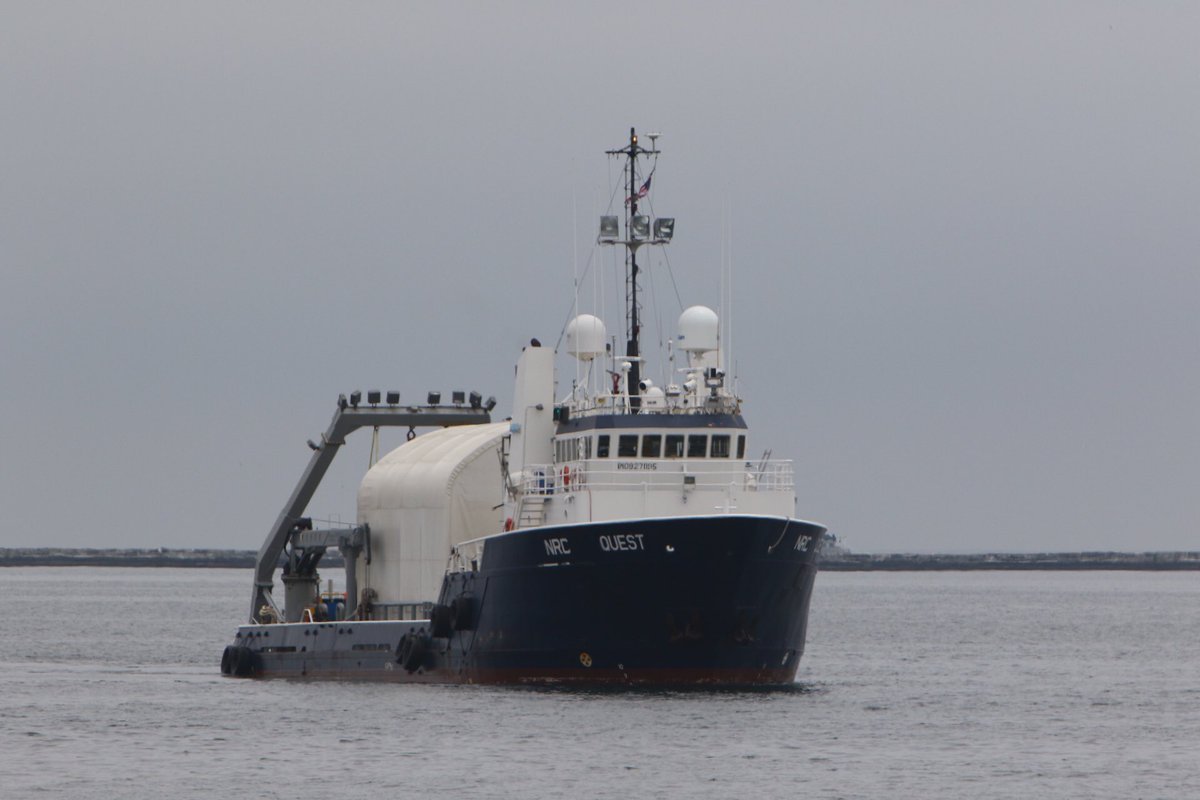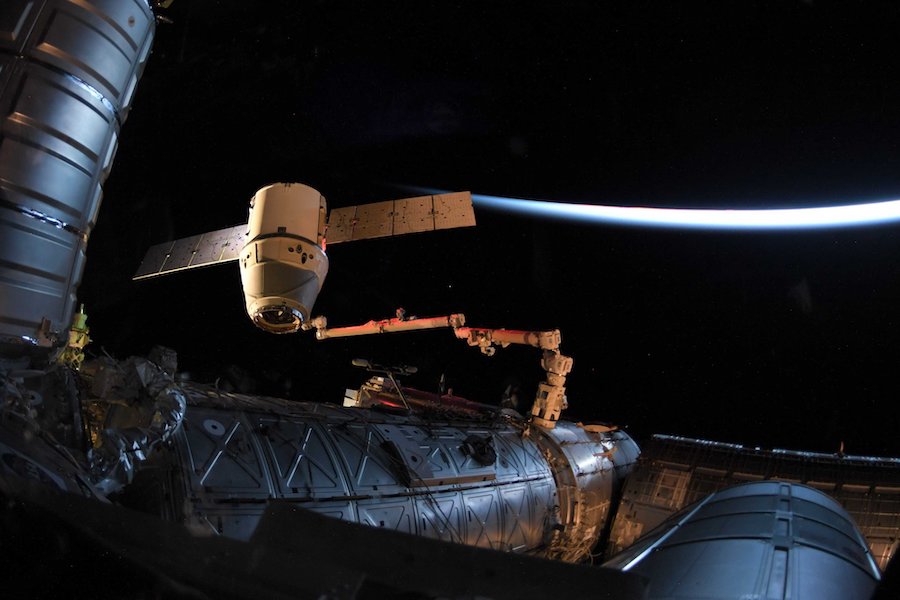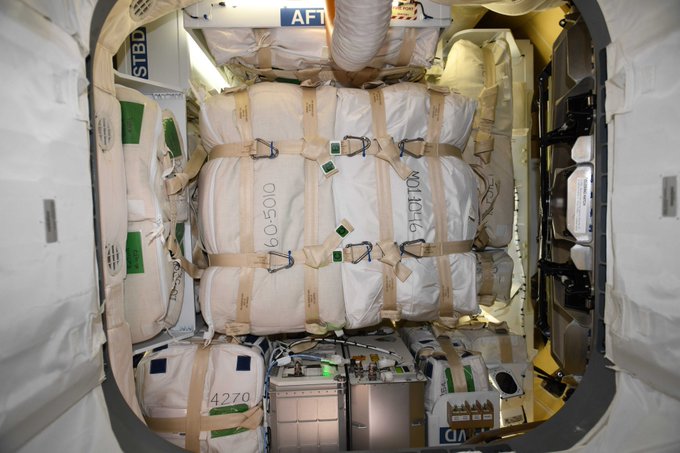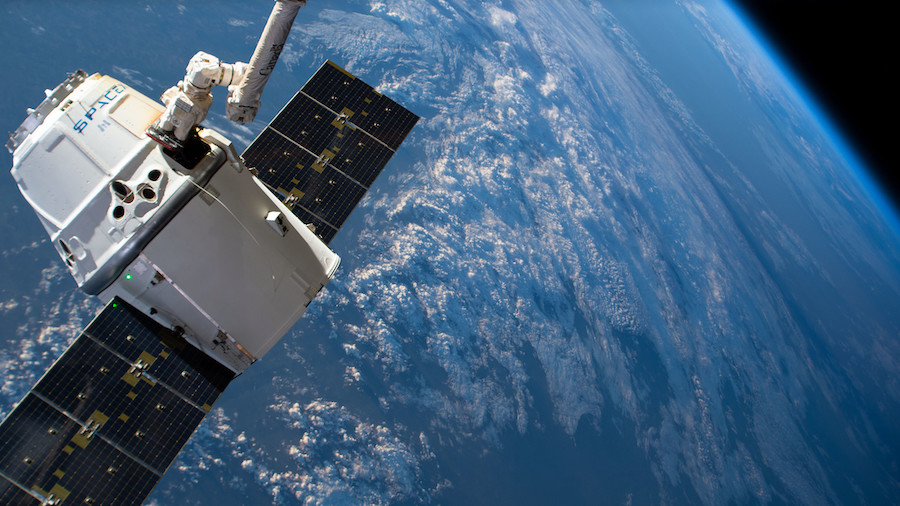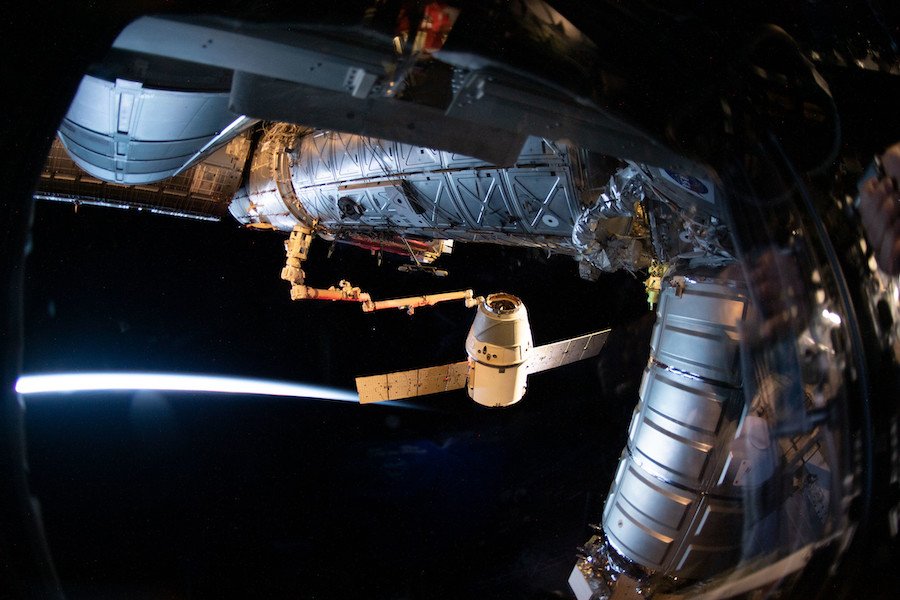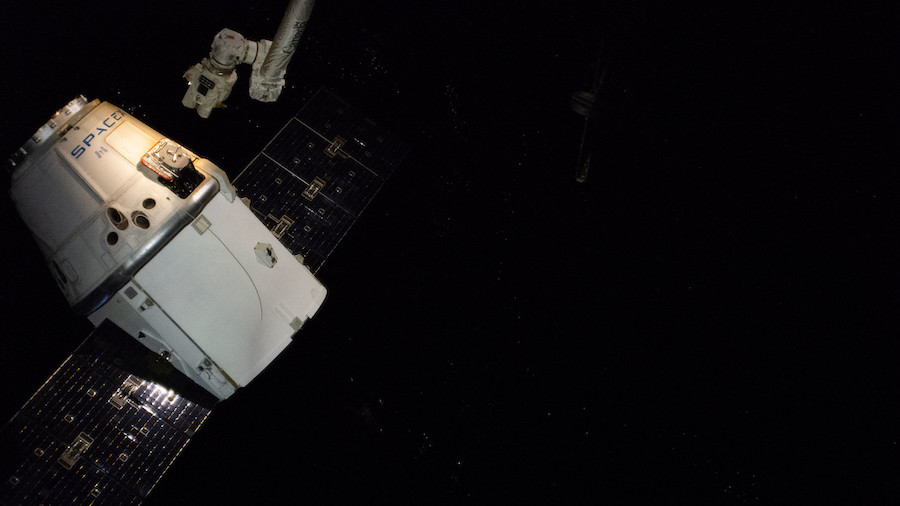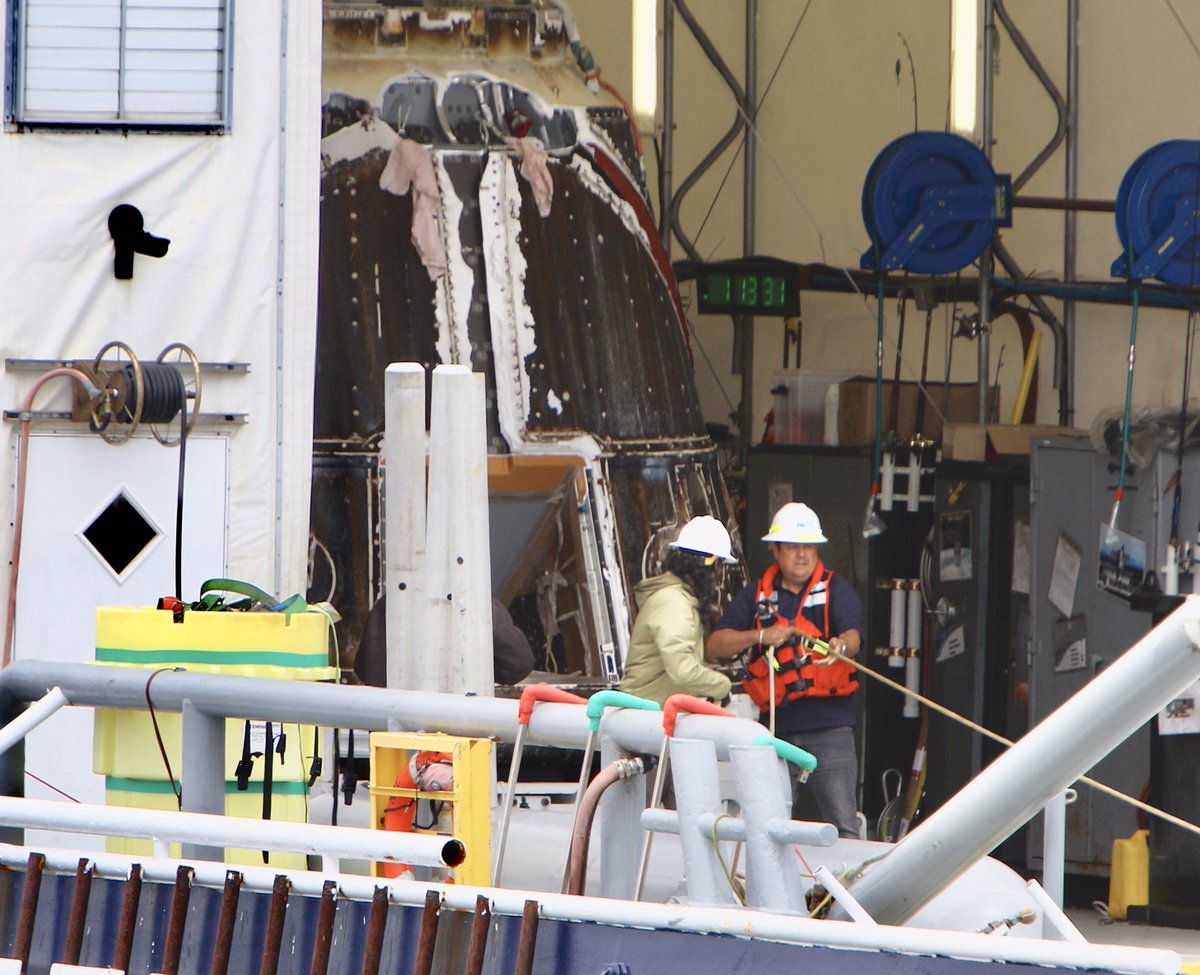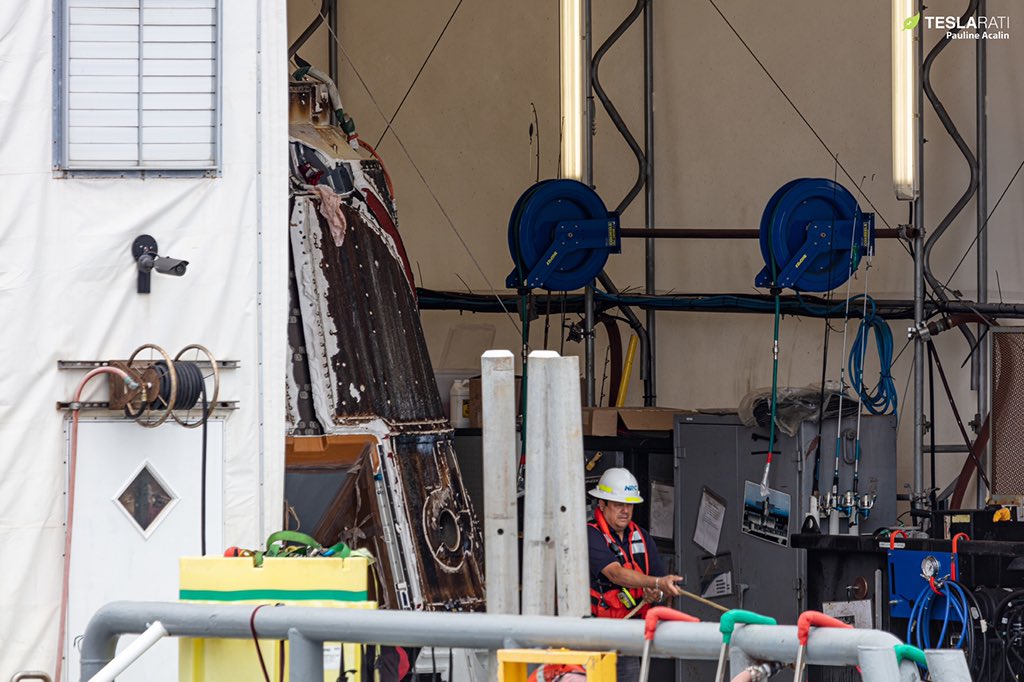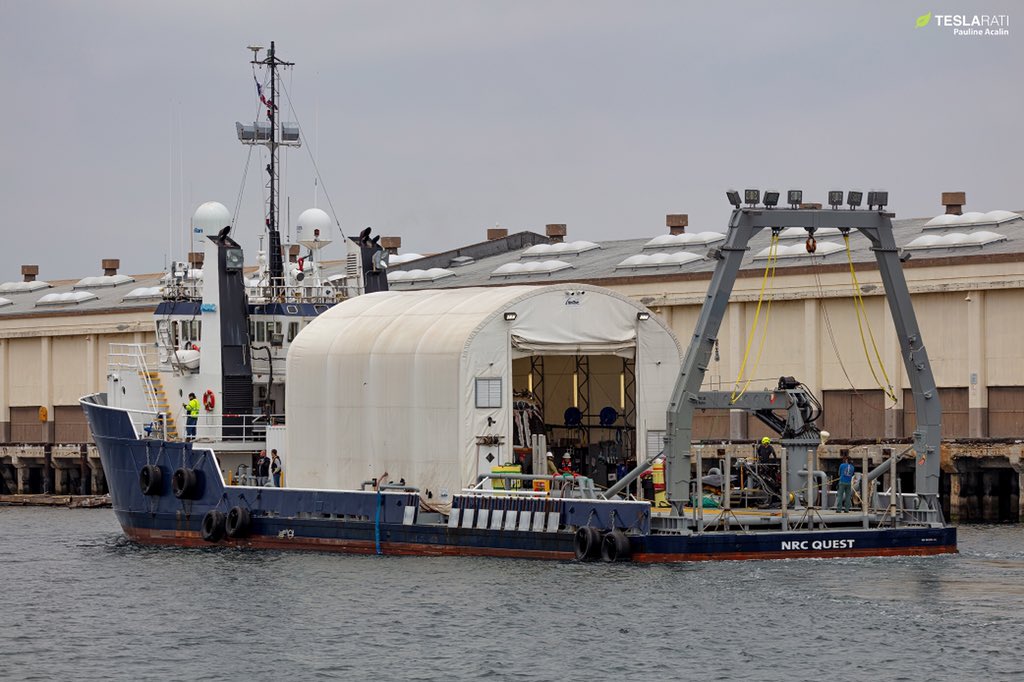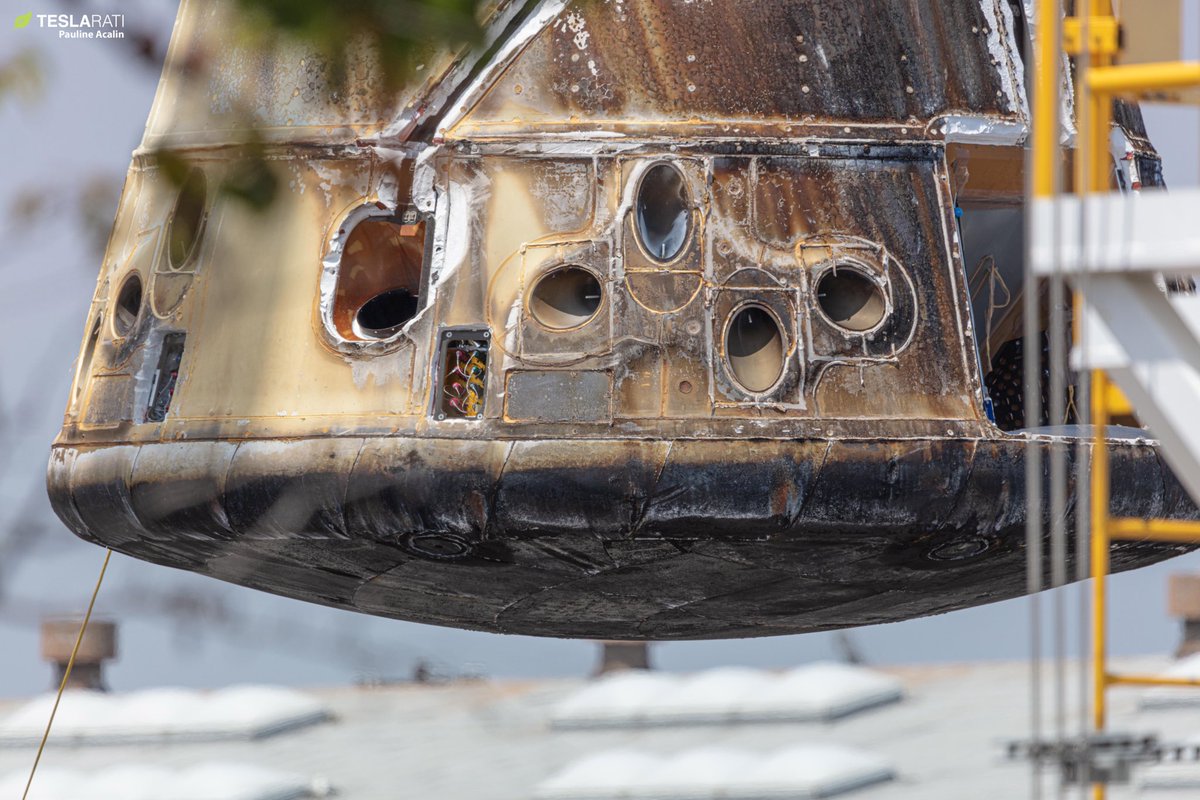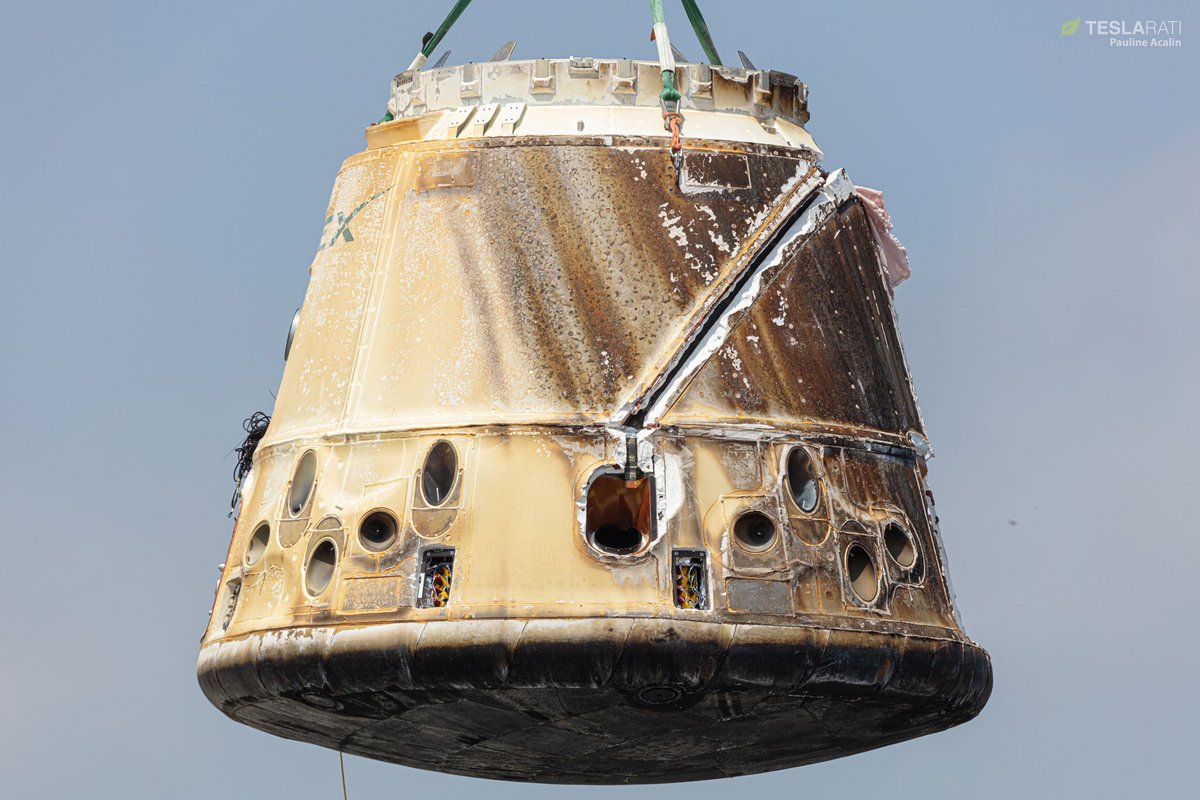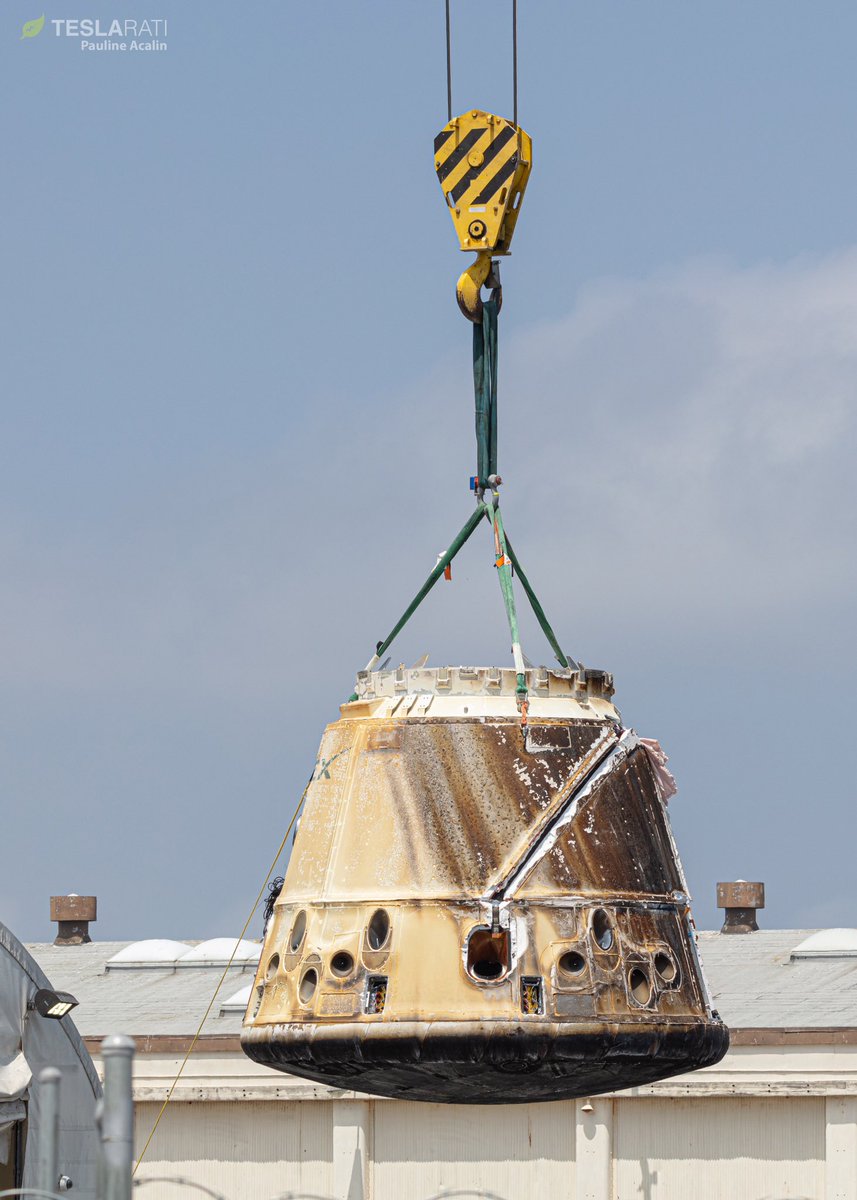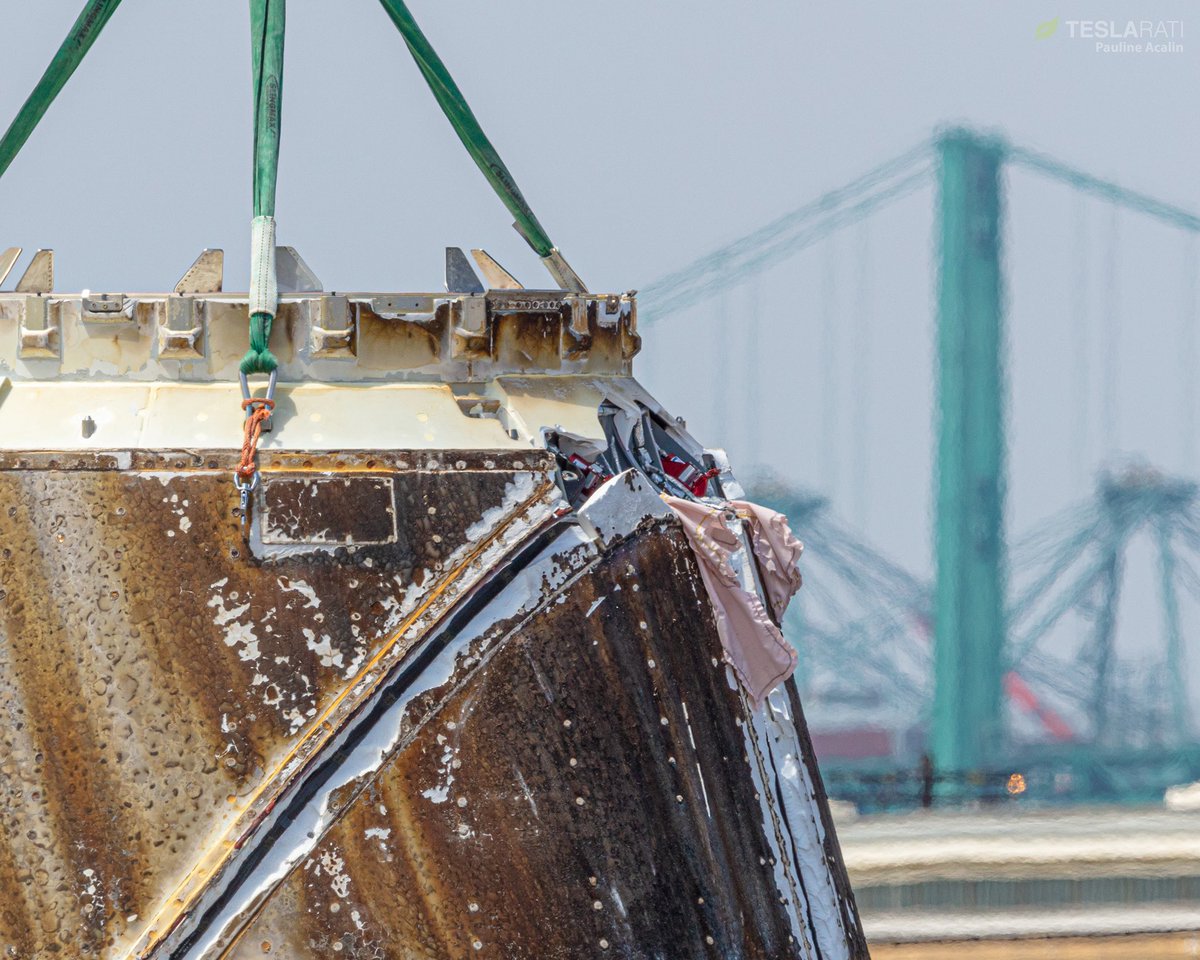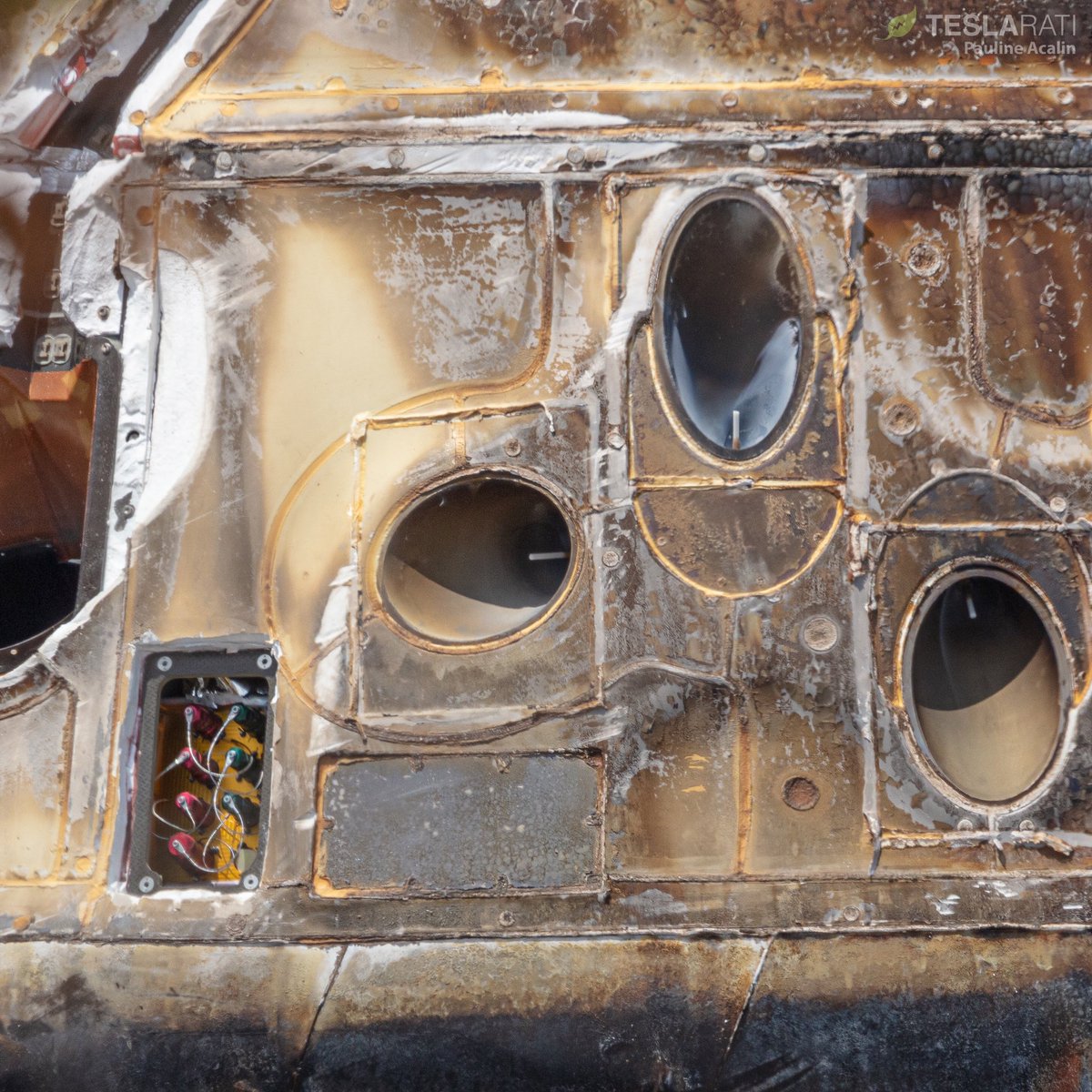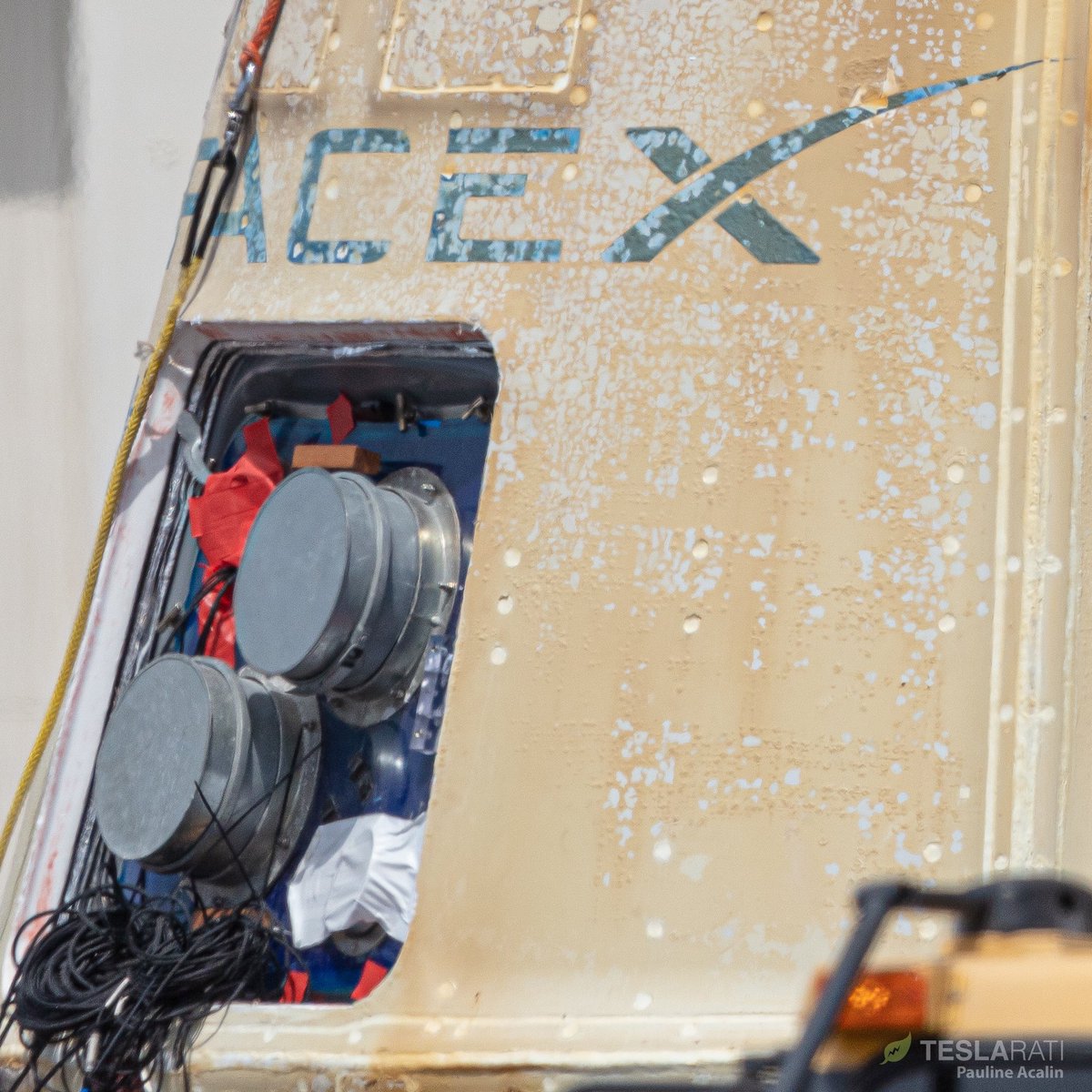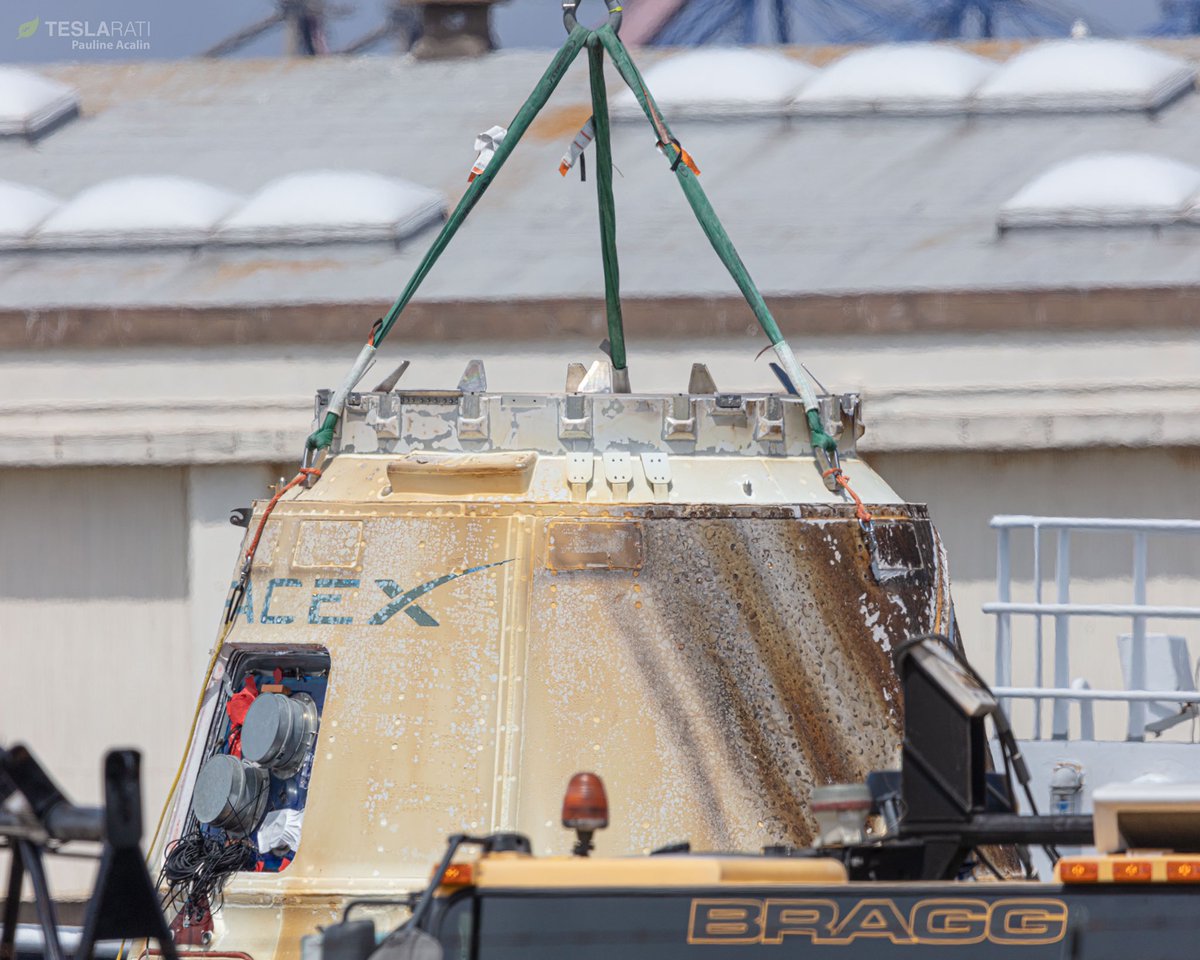Название: Dragon SpX-17 (CRS-17), OCO-3, STP-H6 - Falcon 9-071 (B1056.1) - CCAFS SLC-40 - 04.05.2019 06:48 UTC
Отправлено: tnt22 от 20.03.2019 19:48:30
Отправлено: tnt22 от 20.03.2019 19:48:30
ЦитироватьNASAПодлинная учетная запись @NASA (https://twitter.com/NASA) 20 мин. назад (https://twitter.com/NASA/status/1108404229062963202)
We're opening our doors for social media users to come behind the scenes for the next @SpaceX (https://twitter.com/SpaceX) cargo launch to the International @Space_Station (https://twitter.com/Space_Station), currently targeted for late April. Apply to attend this #NASASocial (https://twitter.com/hashtag/NASASocial?src=hash) event at @NASAKennedy (https://twitter.com/NASAKennedy) in Florida: https://go.nasa.gov/2FogkGD (https://t.co/YAxvYYVz4K)Chris B - NSF @NASASpaceflight (https://twitter.com/NASASpaceflight) 15 мин. назад (https://twitter.com/NASASpaceflight/status/1108405543964684288)
This one is Range Approved (but still NET, as always) for April 25 (early morning T-0)Chris G - NSF @ChrisG_NSF (https://twitter.com/ChrisG_NSF) 8 мин. назад (https://twitter.com/ChrisG_NSF/status/1108406869192773632)
Per @NASASpaceflight (https://twitter.com/NASASpaceflight)'s last tweet about #CRS17 (https://twitter.com/hashtag/CRS17?src=hash) #Dragon (https://twitter.com/hashtag/Dragon?src=hash) confirmed on the Range for 25 April, launch that morning would be at 06:20 EDT (1020 UTC). A pre-dawn launch from the Cape. #SpaceX (https://twitter.com/hashtag/SpaceX?src=hash) #NASASocial (https://twitter.com/hashtag/NASASocial?src=hash) #NASA (https://twitter.com/hashtag/NASA?src=hash)
Название: Dragon SpX-17 (CRS-17), OCO-3, STP-H6 - Falcon 9-071 (B1056.1) - CCAFS SLC-40 - NET 25.04.2019, 10:20 UTC
Отправлено: tnt22 от 05.04.2019 03:36:26
Отправлено: tnt22 от 05.04.2019 03:36:26
ЦитироватьNASA's OCO-3: A New View of Carbon (mission overview)https://www.youtube.com/watch?v=7GMjU5pSufkhttps://www.youtube.com/watch?v=7GMjU5pSufk (https://www.youtube.com/watch?v=7GMjU5pSufk) (2:26)
NASA Jet Propulsion Laboratory (https://www.youtube.com/channel/UCryGec9PdUCLjpJW2mgCuLw)
Опубликовано: 2 апр. 2019 г.
NASA's OCO-3 mission is ready for launch to the International Space Station. This follow-on to OCO-2 brings new techniques and new technologies to carbon dioxide observations of Earth from space.
Название: Dragon SpX-17 (CRS-17), OCO-3, STP-H6 - Falcon 9-071 (B1056.1) - CCAFS SLC-40 - NET 25.04.2019, 10:20 UTC
Отправлено: tnt22 от 10.04.2019 00:25:09
Отправлено: tnt22 от 10.04.2019 00:25:09
https://blogs.nasa.gov/spacex/2019/04/09/spacex-crs-17-targets-april-26-launch/
ЦитироватьSpaceX CRS-17 Targets April 26 Launch
Anna Heiney (https://blogs.nasa.gov/spacex/author/aheiney/)
Posted Apr 9, 2019 at 4:38 pm(https://blogs.nasa.gov/spacex/wp-content/uploads/sites/227/2018/12/SpaceX-Launch-with-Smoke.jpg)
A SpaceX Falcon 9 rocket lifts off from Space Launch Complex 40 at Cape Canaveral Air Force Station in Florida on April 2, 2018, carrying the SpaceX Dragon resupply spacecraft on the company's 14th Commercial Resupply Services contract mission to the International Space Station. Photo credit: NASA/Tony Gray, Tim Powers, Tim Terry
A SpaceX Dragon cargo spacecraft is scheduled to launch at 5:55 a.m. EDT on Friday, April 26, on a Falcon 9 rocket from Space Launch Complex 40 at Cape Canaveral Air Force Station in Florida. This will be SpaceX's 17th Commercial Resupply Services contract mission to the International Space Station (https://www.nasa.gov/mission_pages/station/main/index.html) for NASA.
Launch on April 26 results in an arrival at the space station for a robotic capture by Expedition 59 (https://www.nasa.gov/mission_pages/station/expeditions/expedition59/index.html) crew members David Saint-Jacques (http://www.asc-csa.gc.ca/eng/astronauts/canadian/active/bio-david-saint-jacques.asp) of the Canadian Space Agency and Nick Hague (https://www.nasa.gov/astronauts/biographies/tyler-nick-hague) of NASA on Sunday, April 28, at 7 a.m. EDT for a month-long stay.
Название: Dragon SpX-17 (CRS-17), OCO-3, STP-H6 - Falcon 9-071 (B1056.1) - CCAFS SLC-40 - NET 25.04.2019, 10:20 UTC
Отправлено: tnt22 от 10.04.2019 01:00:56
Отправлено: tnt22 от 10.04.2019 01:00:56
ЦитироватьNASA's OCO-3: Watching Plants Grow and Glowhttps://www.youtube.com/watch?v=_x-VzdEeq0chttps://www.youtube.com/watch?v=_x-VzdEeq0c (https://www.youtube.com/watch?v=_x-VzdEeq0c) (0:42)
NASA Jet Propulsion Laboratory (https://www.youtube.com/channel/UCryGec9PdUCLjpJW2mgCuLw)
Опубликовано: 9 апр. 2019 г.
OCO-3 will be mounted on the International Space Station where it will measure both atmospheric carbon and plant activity from orbit. During photosynthesis, plants absorb carbon dioxide from the atmosphere and emit a small amount of light. Measuring this "solar-induced fluorescence" will help scientists better understand the role plants have in removing carbon dioxide from the atmosphere.
Название: Dragon SpX-17 (CRS-17), OCO-3, STP-H6 - Falcon 9-071 (B1056.1) - CCAFS SLC-40 - NET 25.04.2019, 10:20 UTC
Отправлено: tnt22 от 10.04.2019 22:57:44
Отправлено: tnt22 от 10.04.2019 22:57:44
https://blogs.nasa.gov/spacestation/2019/04/10/crew-trains-to-capture-u-s-spaceship-and-studies-the-brain-and-breathing/
ЦитироватьCrew Trains to Capture U.S. Spaceship and Studies the Brain and Breathing
Mark Garcia (https://blogs.nasa.gov/spacestation/author/magarcia/)
Posted Apr 10, 2019 at 3:40 pm
The Expedition 59 (https://www.nasa.gov/mission_pages/station/expeditions/expedition59/index.html) crew is now training to capture a U.S. cargo ship when it arrives at the International Space Station (https://www.nasa.gov/mission_pages/station/main/index.html) next week. ...
...
SpaceX has announced April 26 (https://blogs.nasa.gov/spacex/2019/04/09/spacex-crs-17-targets-april-26-launch/) as the launch date for its next Dragon cargo mission. The private space freighter will blast off from Cape Canaveral in Florida arriving at the station April 28. This time Saint-Jacques will lead the robotics capture activities while Hague backs him up.
Название: Dragon SpX-17 (CRS-17), OCO-3, STP-H6 - Falcon 9-071 (B1056.1) - CCAFS SLC-40 - NET 25.04.2019, 10:20 UTC
Отправлено: кукушка от 14.04.2019 10:38:46
Отправлено: кукушка от 14.04.2019 10:38:46
26 апреля к МКС отправится грузовой корабль Dragon c миссией снабжения CRS-17. (https://vk.com/spacex?w=wall-41152133_127815)Предполагается, что для запуска будет использоваться новая первая ступень Falcon 9 B1056
Помимо грузов для экипажа и оборудования для исследований и экспериментов, Dragon доставит на станцию в своём негерметичном отсеке два прибора.
Космическая углеродная обсерватория - 3 (Orbiting Carbon Observatory/OCO-3) и Space Test Program-Houston-6 (STP-H6) уже установлены в негерметичном отсеке корабля Dragon в космическом центре Кеннеди во Флориде 23 марта 2019 года.
 STP-H6 - это исследование рентгеновской связи, которое будет использоваться для демонстрации в космосе новой технологии генерации пучков модулированных рентгеновских лучей. Эта технология может быть полезна для обеспечения эффективной связи с исследовательскими зондами дальнего космоса или для связи с гиперзвуковыми транспортными средствами, где плазменные оболочки во время их движения препятствуют традиционной радиосвязи.
STP-H6 - это исследование рентгеновской связи, которое будет использоваться для демонстрации в космосе новой технологии генерации пучков модулированных рентгеновских лучей. Эта технология может быть полезна для обеспечения эффективной связи с исследовательскими зондами дальнего космоса или для связи с гиперзвуковыми транспортными средствами, где плазменные оболочки во время их движения препятствуют традиционной радиосвязи.
 OCO-3 будет установлен на внешней стороне японского экспериментального модуля космической станции, где он будет измерять и наносить на карту количество двуокиси углерода, поступающей из космоса, чтобы обеспечить более глубокое понимание взаимосвязи между углеродом и климатом.
OCO-3 будет установлен на внешней стороне японского экспериментального модуля космической станции, где он будет измерять и наносить на карту количество двуокиси углерода, поступающей из космоса, чтобы обеспечить более глубокое понимание взаимосвязи между углеродом и климатом.
Запуск миссии CRS-17 планируется со стартовой площадки SLC-40 базы ВВС на мысе Канаверал.
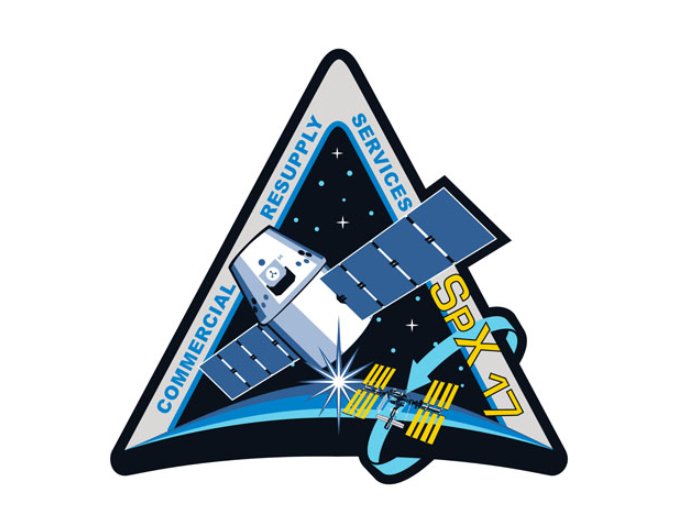
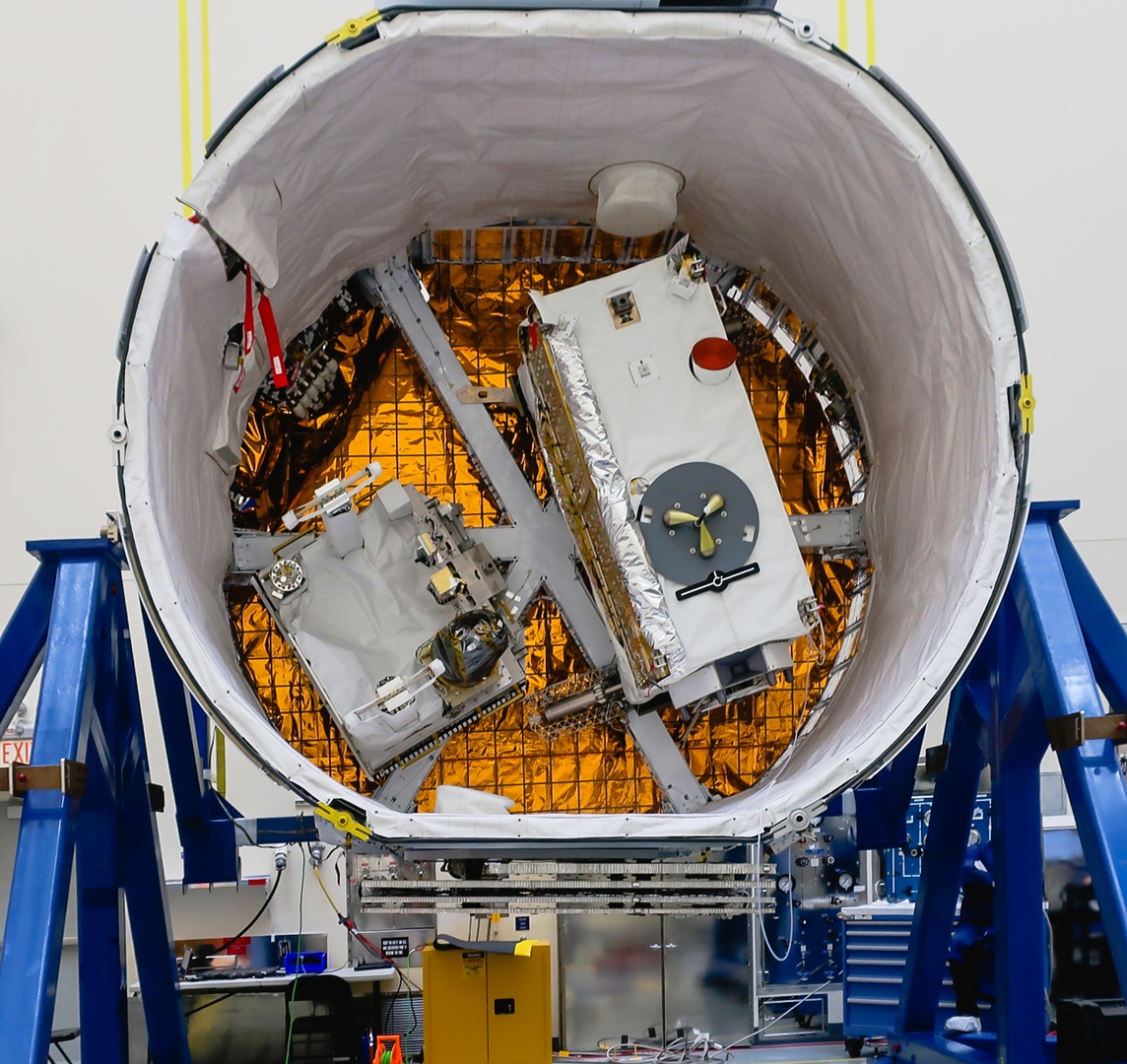
Помимо грузов для экипажа и оборудования для исследований и экспериментов, Dragon доставит на станцию в своём негерметичном отсеке два прибора.
Космическая углеродная обсерватория - 3 (Orbiting Carbon Observatory/OCO-3) и Space Test Program-Houston-6 (STP-H6) уже установлены в негерметичном отсеке корабля Dragon в космическом центре Кеннеди во Флориде 23 марта 2019 года.
 STP-H6 - это исследование рентгеновской связи, которое будет использоваться для демонстрации в космосе новой технологии генерации пучков модулированных рентгеновских лучей. Эта технология может быть полезна для обеспечения эффективной связи с исследовательскими зондами дальнего космоса или для связи с гиперзвуковыми транспортными средствами, где плазменные оболочки во время их движения препятствуют традиционной радиосвязи.
STP-H6 - это исследование рентгеновской связи, которое будет использоваться для демонстрации в космосе новой технологии генерации пучков модулированных рентгеновских лучей. Эта технология может быть полезна для обеспечения эффективной связи с исследовательскими зондами дальнего космоса или для связи с гиперзвуковыми транспортными средствами, где плазменные оболочки во время их движения препятствуют традиционной радиосвязи. OCO-3 будет установлен на внешней стороне японского экспериментального модуля космической станции, где он будет измерять и наносить на карту количество двуокиси углерода, поступающей из космоса, чтобы обеспечить более глубокое понимание взаимосвязи между углеродом и климатом.
OCO-3 будет установлен на внешней стороне японского экспериментального модуля космической станции, где он будет измерять и наносить на карту количество двуокиси углерода, поступающей из космоса, чтобы обеспечить более глубокое понимание взаимосвязи между углеродом и климатом. Запуск миссии CRS-17 планируется со стартовой площадки SLC-40 базы ВВС на мысе Канаверал.


Название: Dragon SpX-17 (CRS-17), OCO-3, STP-H6 - Falcon 9-071 (B1056.1) - CCAFS SLC-40 - NET 25.04.2019, 10:20 UTC
Отправлено: tnt22 от 18.04.2019 20:08:33
Отправлено: tnt22 от 18.04.2019 20:08:33
ЦитироватьHighlights of Science Launching on SpaceX CRS-17https://www.youtube.com/watch?v=XI9bgWEwv8chttps://www.youtube.com/watch?v=XI9bgWEwv8c (https://www.youtube.com/watch?v=XI9bgWEwv8c) (1:24)
NASA Johnson (https://www.youtube.com/channel/UCmheCYT4HlbFi943lpH009Q)
Опубликовано: 18 апр. 2019 г.
A SpaceX Dragon cargo spacecraft scheduled to launch in late April takes supplies and a variety of scientific experiments to the International Space Station. Lifted into orbit by a Falcon 9 rocket from Cape Canaveral Air Force Station in Florida, the craft represents the 17th SpaceX Commercial Resupply Services contract mission for NASA.
Название: Dragon SpX-17 (CRS-17), OCO-3, STP-H6 - Falcon 9-071 (B1056.1) - CCAFS SLC-40 - NET 25.04.2019, 10:20 UTC
Отправлено: tnt22 от 19.04.2019 06:43:41
Отправлено: tnt22 от 19.04.2019 06:43:41
https://www.nasa.gov/mission_pages/station/research/news/spx17-research
ЦитироватьApril 18, 2019
Dragon's 17th Flight Carries Science to the Space Station
Dragon's 17th Flight Carries Science to the Space Station
A SpaceX Dragon cargo spacecraft scheduled to launch in late April takes supplies and a variety of scientific experiments to the International Space Station (https://www.nasa.gov/mission_pages/station/research/index.html). Lifted into orbit by a Falcon 9 rocket from Cape Canaveral Air Force Station in Florida, the craft represents the 17th SpaceX Commercial Resupply Services contract mission for NASA.
Read more about some of the scientific investigations traveling to the space station on this launch.
Measuring atmospheric CO2 from spacePutting microalgae on the menuСпойлер
The Orbiting Carbon Observatory-3 (OCO-3 (https://www.nasa.gov/mission_pages/station/research/experiments/explorer/Investigation.html?#id=1786)) examines the complex dynamics of Earth's atmospheric carbon cycle. Installed on the Japanese Experiment Module-Exposed Facility, called JEM-EF (https://www.nasa.gov/mission_pages/station/research/experiments/explorer/Facility.html?#id=134), it collects measurements to quantify variations in a specific type of atmospheric carbon dioxide. Having the observatory on the space station enables sampling during all sunlit hours and targeted local mapping of emission hotspots.(https://www.nasa.gov/sites/default/files/thumbnails/image/ksc-20190323-ph_spx01_0001_orig.jpg)
NASA's Orbiting Carbon Observatory 3 (OCO-3) and Space Test Program-Houston 6 (STP-H6) shown in the SpaceX Dragon spacecraft at NASA's Kennedy Space Center in Florida in preparation for launch to the space station. Robotically installed on the outside of the space station, OCO-3 measures and maps atmospheric carbon dioxide to provide further understanding of the relationship between carbon and climate.
Credits: NASA
OCO-3's precise measurements will provide scientists with a better understanding of surface carbon dioxide sources and storage sinks on regional scales, as well as the processes controlling their variability from seasonal cycles. Understanding these sources and sinks can help in forecasting increased atmospheric heat retention and reducing its long-term risks. The investigation preserves continuity of previously collected atmospheric records.[свернуть]Organs on Chips advance human health researchСпойлер
Current life support systems in space use physicochemical processes, such as steam and chemical reactions, to generate oxygen and water and remove carbon dioxide from the space station. The Photobioreactor (https://www.nasa.gov/mission_pages/station/research/experiments/explorer/Investigation.html?#id=7426) investigation demonstrates using biological processes to create a hybrid life support system. The investigation tests the cultivation of microalgae for food and as part of a life support system to generate oxygen and consume carbon dioxide.
On future long-duration missions, this approach could reduce the amount of food, water and other essentials that crews have to bring from Earth. This type of research on the station is critical for NASA to understand and overcome the challenges of long-duration spaceflight, and necessary for a sustainable presence on the Moon and missions deeper into the solar system, including Mars.[свернуть]Multi-use microgravity experiment platformСпойлер
Tissue chips, or organs on chips, are small devices that contain human cells in a three-dimensional matrix. Scientists use them to test how those cells respond to stresses, drugs and genetic changes. This launch includes four Tissue Chips in Space (https://ncats.nih.gov/tissuechip/projects/space) investigations:[/li]
- Lung Host Defense in Microgravity (https://www.nasa.gov/mission_pages/station/research/experiments/explorer/Investigation.html?#id=7984) uses a lung and bone marrow organ-on-a-chip to compare response to infection in microgravity and on Earth. The investigation expands understanding of the biological basis of immune system suppression in space and provides insight into ways to counter it.
- Cartilage-Bone-Synovium Microphysiological System (https://www.nasa.gov/mission_pages/station/research/experiments/explorer/Investigation.html?#id=7663) studies how spaceflight affects musculoskeletal disease and tests potential drugs for preventing progression of Post-traumatic Osteoarthritis, arthritis that occurs after loss of cartilage and bone due to a traumatic joint injury.
- Organs-On-Chips as a Platform for Studying Effects of Microgravity on Human Physiology (https://www.nasa.gov/mission_pages/station/research/experiments/explorer/Investigation.html?#id=7912) analyzes the effect of microgravity and other space-related stressors on the brain blood barrier. This may provide insight into the relationship between inflammation and brain function and a better understanding of neurodegenerative diseases such as Alzheimer's and Parkinson's.
- Effects of Microgravity on the Structure and Function of Proximal and Distal Tubule MPS (https://www.nasa.gov/mission_pages/station/research/experiments/explorer/Investigation.html?#id=7819) (Kidney Cells) examines how kidney health is affected by microgravity and other factors of space travel, including water conservation and recycling, and altered dietary intake. Knowledge gained can help protect the health of astronauts and contribute to better treatments for kidney related conditions on Earth.
(https://www.nasa.gov/sites/default/files/thumbnails/image/46750074624_52c6cfeef3_o.jpg)
An example of a Tissue Chip in Space device. These contain human cells in a three-dimensional matrix used in investigations that test how various types of cells respond to stresses, drugs, and genetic changes.
Credits: NASA Photo/Josh Valcarcel
These investigations are a collaboration between the National Center for Advancing Translational Sciences at the National Institutes for Health and the ISS U.S. National Lab (https://www.issnationallab.org/) in partnership with NASA[свернуть]Watching cells make DNA repairsСпойлер
Hermes (https://www.nasa.gov/mission_pages/station/research/experiments/explorer/Facility.html?#id=7557) is a reconfigurable on-orbit facility that provides a platform for investigations with applications to asteroids, planetary science, and exploration. These investigations will provide researchers with insight into the formation and behavior of asteroids and comets, impact dynamics, and planetary evolution. The facility is capable of accommodating up to four experiments at a time and can operate for hours, days, or even months. Hermes is equipped with lighting to illuminate experiments as necessary and four sets of cameras to provide imagery or video for experiment monitoring. Depending on a particular investigation, Hermes may contain different mechanical components and sensors to obtain additional data.(https://www.nasa.gov/sites/default/files/thumbnails/image/jsc2019e014147.jpg)
The Hermes Facility headed to the International Space Station supports material investigations with applications to asteroids, planetary science, and exploration.
Credits: NASA/Johnson Space Center[свернуть]Спойлер
Increased exposure to radiation in space can cause damage to deoxyribonucleic acid (DNA) known as double strand breaks. Cells repair these breaks but such repairs are prone to errors, causing insertions or deletions of DNA bases. Buildup of these errors can have detrimental effects, such as cancer, and affect the long-term health of astronauts.(https://www.nasa.gov/sites/default/files/thumbnails/image/iss051e029016_orig.jpg)
The miniPCR is used for Genes in Space investigations aboard the International Space Station. Spaceflight causes many changes to the human body, including alterations in DNA and a weakened immune system and this technology enables DNA studies in space that can help safeguard crew health.
Credits: NASA
Genes in Space-6 (https://www.nasa.gov/mission_pages/station/research/experiments/explorer/Investigation.html?#id=7893) evaluates the process of DNA repair in the spaceflight environment by causing double strand breaks in the yeast Saccharomyces cerevisiae and assessing the subsequent mutations and repairs while still in space. The Miniature Polymerase Chain Reaction (miniPCR (https://www.minipcr.com/)) and the MinION (https://www.nasa.gov/mission_pages/station/research/news/biomolecule_sequencer) sequencer tools aboard the space station make this assessment possible.[свернуть]Last Updated: April 18, 2019Спойлер
https://www.youtube.com/watch?v=XI9bgWEwv8c (https://www.youtube.com/watch?v=XI9bgWEwv8c)
Melissa Gaskill
International Space Station Program Science Office
Johnson Space Center (http://www.nasa.gov/centers/johnson/home/index.html)[свернуть]
Editor: Michael Johnson
Название: Dragon SpX-17 (CRS-17), OCO-3, STP-H6 - Falcon 9-071 (B1056.1) - CCAFS SLC-40 - NET 25.04.2019, 10:20 UTC
Отправлено: tnt22 от 19.04.2019 17:37:12
Отправлено: tnt22 от 19.04.2019 17:37:12
https://blogs.nasa.gov/spacex/2019/04/19/spacex-crs-17-launch-now-scheduled-for-april-30/
ЦитироватьSpaceX CRS-17 Launch Now Scheduled for April 30
Sarah Loff (https://blogs.nasa.gov/spacex/author/sloff/)
Posted Apr 19, 2019 at 10:35 am
A SpaceX Dragon cargo spacecraft is now scheduled to launch at 4:22 a.m. EDT on Tuesday, April 30, on a Falcon 9 rocket from Space Launch Complex 40 at Cape Canaveral Air Force Station in Florida. This will be SpaceX's 17th Commercial Resupply Services contract mission to the International Space Station (http://www.nasa.gov/station) for NASA.(https://blogs.nasa.gov/spacex/wp-content/uploads/sites/227/2019/04/31737796067_d5b6fc97f3_o.jpg)
A SpaceX Dragon cargo craft is pictured attached to the International Space Station's Harmony module. Credit: NASA
SpaceX will take advantage of the additional time to perform a static fire test and pre-flight checkouts. Falcon 9 and Dragon are on track to be flight ready for an earlier launch attempt, however, April 30 is the most viable date for both NASA and SpaceX due to station and orbital mechanics constraints.
NASA will host a media teleconference (https://www.nasa.gov/press-release/nasa-highlights-science-on-17th-spacex-resupply-mission-to-international-space-station) at 11 a.m. Monday, April 22, to discuss sel ect science investigations the Dragon will deliver to the astronauts living and working aboard the orbiting laboratory. NASA will stream audio fr om the discussion at http://www.nasa.gov/live.
Название: Dragon SpX-17 (CRS-17), OCO-3, STP-H6 - Falcon 9-071 (B1056.1) - CCAFS SLC-40 - NET 25.04.2019, 10:20 UTC
Отправлено: tnt22 от 19.04.2019 17:57:48
Отправлено: tnt22 от 19.04.2019 17:57:48
https://www.nasa.gov/multimedia/nasatv/schedule.html
ЦитироватьNASA Television Upcoming EventsUTC = (EDT + 4h) MOD 24
Watch NASA TV (https://www.nasa.gov/multimedia/nasatv/index.html#public)
All times Eastern
APRIL
April 25, Thursday
9:30 a.m. – SpaceX CRS-17 What's On Board Briefing (All Channels)
1 p.m. – SpaceX CRS-17 Pre-Launch News Conference (All Channels)
April 30, Tuesday
3:45 a.m. – Coverage of the Launch of the SpaceX CRS-17 Dragon Cargo Craft Mission to the International Space Station; launch is scheduled at 4:22 a.m. ET (All Channels)
5:30 a.m. – SpaceX CRS-17 Post-Launch News Conference (time subject to change) (All Channels)
MAY
May 2, Thursday
5:30 a.m. – Coverage of the rendezvous and capture of the SpaceX CRS-17 Dragon cargo craft at the International Space Station; capture scheduled at 7 a.m. ET (All Channels)
9 a.m. – Coverage of the installation of the SpaceX CRS-17 Dragon cargo craft to the International Space Station (All Channels)
Название: Dragon SpX-17 (CRS-17), OCO-3, STP-H6 - Falcon 9-071 (B1056.1) - CCAFS SLC-40 - NET 25.04.2019, 10:20 UTC
Отправлено: tnt22 от 19.04.2019 20:15:05
Отправлено: tnt22 от 19.04.2019 20:15:05
https://ria.ru/20190419/1552864981.html
ЦитироватьЗапуск грузового корабля Dragon к МКС перенесли на 30 апреля
18:57
МОСКВА, 19 апр - РИА Новости. Запуск американского корабля Dragon с грузами для экипажа Международной космической станции состоится 30 апреля, сообщило в пятницу НАСА.
Ранее НАСА сообщало, что старт планируется на 26 апреля.
На сайте НАСА отмечается, что запуск Dragon состоится 30 апреля в 11:22 мск.
В качестве причины отсрочки старта названо то, что дата 30 апреля наиболее подходящая по баллистическим условиям.
Название: Dragon SpX-17 (CRS-17), OCO-3, STP-H6 - Falcon 9-071 (B1056.1) - CCAFS SLC-40 - NET 25.04.2019, 10:20 UTC
Отправлено: tnt22 от 22.04.2019 18:17:50
Отправлено: tnt22 от 22.04.2019 18:17:50
ЦитироватьJeff Foust @jeff_foust (https://twitter.com/jeff_foust) 13 мин. назад (https://twitter.com/jeff_foust/status/1120342336272248832)
At a beginning of a media telecon on the science flying on the next Dragon cargo mission, NASA says the mission is still scheduled for launch April 30, the date reported last week week prior to this weekend's Crew Dragon incident.
Название: Dragon SpX-17 (CRS-17), OCO-3, STP-H6 - Falcon 9-071 (B1056.1) - CCAFS SLC-40 - NET 25.04.2019, 10:20 UTC
Отправлено: tnt22 от 22.04.2019 20:31:11
Отправлено: tnt22 от 22.04.2019 20:31:11
https://blogs.nasa.gov/spacestation/2019/04/22/new-life-science-begins-next-dragon-cargo-mission-due-next-week/
ЦитироватьNew Life Science Begins; Next Dragon Cargo Mission Due Next Week
Mark Garcia (https://blogs.nasa.gov/spacestation/author/magarcia/)
Posted Apr 22, 2019 at 12:47 pm
... The 17th SpaceX Dragon mission is now due to launch next week to replenish the International Space Station (https://www.nasa.gov/mission_pages/station/main/index.html).
...
The SpaceX Dragon (https://www.nasa.gov/spacex) cargo craft is due to join the five other spacecraft (https://www.nasa.gov/feature/visiting-vehicle-launches-arrivals-and-departures) parked at the station after it launches from Florida April 30. Dragon is scheduled to arrive May 2 and Saint-Jacques will command the Canadarm2 (https://www.nasa.gov/mission_pages/station/structure/elements/mobile-servicing-system.html) robotic arm to reach out and capture the cargo vessel. Dragon will deliver over 5,000 pounds of new science, supplies and hardware to the orbital lab.
...
Название: Dragon SpX-17 (CRS-17), OCO-3, STP-H6 - Falcon 9-071 (B1056.1) - CCAFS SLC-40 - NET 25.04.2019, 10:20 UTC
Отправлено: tnt22 от 22.04.2019 20:33:35
Отправлено: tnt22 от 22.04.2019 20:33:35
ЦитироватьEmre KellyПодлинная учетная запись @EmreKelly (https://twitter.com/EmreKelly) 4 мин. назад (https://twitter.com/EmreKelly/status/1120378972397875200)
Both NASA and the 45th Space Wing have confirmed #SpaceX (https://twitter.com/hashtag/SpaceX?src=hash) is still targeting April 30 to launch a *cargo* Dragon from CCAFS. NASA put heavy emphasis on "as of today," so it could change depending on investigation into Crew Dragon or other factors. Targeted for 0422 ET (0822 UTC).
Название: Dragon SpX-17 (CRS-17), OCO-3, STP-H6 - Falcon 9-071 (B1056.1) - CCAFS SLC-40 - NET 25.04.2019, 10:20 UTC
Отправлено: tnt22 от 23.04.2019 01:10:33
Отправлено: tnt22 от 23.04.2019 01:10:33
ЦитироватьEmulate Tissue Chip Research on the International Space Stationhttps://www.youtube.com/watch?v=I5i9WCHbkz0https://www.youtube.com/watch?v=I5i9WCHbkz0 (https://www.youtube.com/watch?v=I5i9WCHbkz0) (2:05)
Center for the Advancement of Science In Space (CASIS) (https://www.youtube.com/channel/UCezcn0GHbLgOkZ85oV5xqZA)
Опубликовано: 22 апр. 2019 г.
Emulate is an innovative and emerging biotechnology company sending a tissue chip investigation to the International Space Station U.S. National Laboratory. Learn about tissue chip technology, and how the microgravity environment of the space station can influence science to benefit patient care on Earth.
Название: Dragon SpX-17 (CRS-17), OCO-3, STP-H6 - Falcon 9-071 (B1056.1) - CCAFS SLC-40 - NET 25.04.2019, 10:20 UTC
Отправлено: tnt22 от 23.04.2019 01:15:14
Отправлено: tnt22 от 23.04.2019 01:15:14
ЦитироватьM.I.T. Osteoarthritis Tissue Chips to the International Space Stationhttps://www.youtube.com/watch?v=33o8W3qehu4https://www.youtube.com/watch?v=33o8W3qehu4 (https://www.youtube.com/watch?v=33o8W3qehu4) (1:46)
Center for the Advancement of Science In Space (CASIS) (https://www.youtube.com/channel/UCezcn0GHbLgOkZ85oV5xqZA)
Опубликовано: 22 апр. 2019 г.
There are no disease-modifying drugs for any type of osteoarthritis on Earth other than painkillers, which do not halt the progression of disease. These investigations on the ISS National Lab, which involve human tissue explants of cartilage, bone and synovial tissue, have the potential to lead to the discovery of treatments and treatment regimens that, if administered immediately after a joint injury, may halt the progression of the disease before it becomes irreversible. The goal of this research is to treat the root cause of post-traumatic osteoarthritis disease and prevent permanent joint damage, rather than mask the symptoms with painkillers later in life, as is currently done.
Название: Dragon SpX-17 (CRS-17), OCO-3, STP-H6 - Falcon 9-071 (B1056.1) - CCAFS SLC-40 - NET 25.04.2019, 10:20 UTC
Отправлено: tnt22 от 23.04.2019 01:17:48
Отправлено: tnt22 от 23.04.2019 01:17:48
ЦитироватьISS National Lab Research Overview, SpaceX CRS-17https://www.youtube.com/watch?v=gZD-e_PrJuQhttps://www.youtube.com/watch?v=gZD-e_PrJuQ (https://www.youtube.com/watch?v=gZD-e_PrJuQ) (2:32)
Center for the Advancement of Science In Space (CASIS) (https://www.youtube.com/channel/UCezcn0GHbLgOkZ85oV5xqZA)
Опубликовано: 22 апр. 2019 г.
The International Space Station U.S. National Laboratory is sponsoring an array of research projects that will launch onboard SpaceX's Dragon spacecraft. This mission includes biotechnology, plant biology, pharmaceutical drug delivery research, and more. To learn more about this science on SpaceX's 17th resupply mission to the space station, check out the ISS National Lab research video!
Название: Dragon SpX-17 (CRS-17), OCO-3, STP-H6 - Falcon 9-071 (B1056.1) - CCAFS SLC-40 - NET 25.04.2019, 10:20 UTC
Отправлено: tnt22 от 23.04.2019 06:16:51
Отправлено: tnt22 от 23.04.2019 06:16:51
ЦитироватьMichael Baylor @nextspaceflight (https://twitter.com/nextspaceflight) 3 ч. назад (https://twitter.com/nextspaceflight/status/1120480991934590977)
#SpaceX (https://twitter.com/hashtag/SpaceX?src=hash) may move the first stage recovery for #CRS17 (https://twitter.com/hashtag/CRS17?src=hash) to a droneship according to FCC filings. This comes after Landing Zone 1 was contaminated with toxic hypergolic during the Crew Dragon anomaly this weekend.
Map of the potential droneship location:
3 ч. назад (https://twitter.com/nextspaceflight/status/1120481502091980801)
Note that this filing is pending FCC approval. Let's see if this gets processed in time!
Название: Dragon SpX-17 (CRS-17), OCO-3, STP-H6 - Falcon 9-071 (B1056.1) - CCAFS SLC-40 - NET 25.04.2019, 10:20 UTC
Отправлено: tnt22 от 23.04.2019 22:35:43
Отправлено: tnt22 от 23.04.2019 22:35:43
ЦитироватьEmre KellyПодлинная учетная запись @EmreKelly (https://twitter.com/EmreKelly) 1 ч. назад (https://twitter.com/EmreKelly/status/1120753846194778115)
Confirmed: #SpaceX (https://twitter.com/hashtag/SpaceX?src=hash) will likely attempt to land Falcon 9 booster on OCISLY drone ship after next week's (April 30) CRS-17 launch from Cape Canaveral. This will help preserve valuable information during investigation into Crew Dragon incident.
Название: Dragon SpX-17 (CRS-17), OCO-3, STP-H6 - Falcon 9-071 (B1056.1) - CCAFS SLC-40 - NET 25.04.2019, 10:20 UTC
Отправлено: tnt22 от 24.04.2019 07:04:26
Отправлено: tnt22 от 24.04.2019 07:04:26
https://spaceflightnow.com/2019/04/23/spacex-likely-to-move-next-rocket-landing-to-drone-ship/
ЦитироватьSpaceX likely to move next rocket landing to drone ship
April 23, 2019 (https://spaceflightnow.com/2019/04/) | Stephen Clark (https://spaceflightnow.com/author/stephen-clark/)
File photo of a Falcon 9 booster landing on SpaceX's drone ship "Of Course I Still Love You" in the Atlantic Ocean following a launch in November 2018. Credit: SpaceX
SpaceX is likely to land the first stage of the Falcon 9 rocket set for launch April 30 on a drone ship just off the coast of Cape Canaveral, not at the company's onshore recovery site as originally planned, after a ground test of the company's Crew Dragon capsule at the landing pad ended in an explosion Saturday.
Workers were examining wreckage fr om the Crew Dragon spacecraft at Landing Zone 1, the site wh ere Falcon 9 boosters return to Cape Canaveral, prompting the company to apply for authority from the Federal Communications Commission to land the first stage on next week's mission on SpaceX's drone ship in the Atlantic Ocean.
SpaceX's Falcon 9 rocket, featuring a brand new first stage, is set for liftoff at 4:22 a.m. EDT (0822 GMT) April 30 from Cape Canaveral's Complex 40 launch pad. The launcher will carry into orbit a Dragon cargo capsule packed with several tons of supplies and experiments heading for the International Space Station.
Industry officials confirmed Tuesday that SpaceX will likely attempt a drone ship landing on next week's mission to "ensure the integrity" of the Landing Zone 1 area and "preserve valuable information" in the aftermath of Saturday's Crew Dragon test mishap.
According a SpaceX license application dated Monday, the drone ship will be positioned roughly 17 miles (28 kilometers) southeast of pad 40, or due east of the easternmost point of Cape Canaveral. Weather permitting, the rocket's predawn return to Earth should be visible from land.
The landing will allow SpaceX to refurbish and re-fly the booster on a future mission. Falcon 9 launches with Dragon cargo freighters carry sufficient fuel reserves for the first stage to reverse course and return to Cape Canaveral, rather than land on SpaceX's drone ship.
Information in SpaceX's new license application to the Federal Communications Commission suggests the Falcon 9 rocket's first stage will likely target a landing aboard the company's drone ship in the Atlantic Ocean a few minutes after liftoff April 30 on a space station resupply mission. Credit: Google Maps/Spaceflight Now
A NASA spokesperson said, as of Monday, that the Dragon cargo mission remained scheduled for launch April 30. It will be SpaceX's 17th resupply mission to the station since 2012 under a NASA contract valued at more than $3 billion.
A hold-down firing of the Falcon 9's Merlin main engines at pad 40 is scheduled for Thursday.
SpaceX and NASA officials in the coming days are expected to review any potential impacts on the resupply mission stemming from the investigation into the Crew Dragon test accident.Спойлер
The Crew Dragon spacecraft, also known as Dragon 2, is a much different spacecraft than SpaceX's first-generation Dragon capsule.
Saturday's accident occurred during a hotfire test of the Crew Dragon's SuperDraco abort thrusters, according to SpaceX and NASA officials. The SuperDraco thrusters, which would be activated to save astronauts from a failing rocket, do not fly on the Dragon variant set for launch next week.
The spacecraft that exploded on the test stand Saturday was the same vehicle that completed a six-day test flight to the International Space Station last month. SpaceX was conducting ground tests on the capsule in preparation for its reuse on an in-flight abort demonstration in the next few months, a test intended to verify the SuperDraco thrusters can safely propel the spacecraft away from a Falcon 9 rocket under extreme aerodynamic pressures.
SpaceX and NASA have said little about Saturday's accident, but the mishap is expected to delay the Crew Dragon program by months. A different test vehicle will have to be used for the in-flight abort test, which was planned to be one of the final milestones before NASA approves the spacecraft to carry astronauts to the space station.
With the Demo-1 capsule no longer available for the in-flight abort, SpaceX will have to shuffle its plans and outfit a different vehicle for the high-altitude escape test.
The unpiloted Crew Dragon test flight to the space station in early March, designated Demo-1, achieved all of its major objectives, including the first automated docking of a U.S. spacecraft to the station. But NASA officials said at the time that engineers needed to complete further testing and analysis on the Crew Dragon's thrusters and parachutes, along with pressurant tanks on the spacecraft and the Falcon 9 rocket, before deeming the capsule ready for human occupants.
The Crew Dragon spacecraft backs away from the International Space Station after undocking March 8. The same spacecraft was involved in an accident during ground testing Saturday at Cape Canaveral. Credit: SpaceX
NASA astronauts Bob Behnken and Doug Hurley are assigned to the Crew Dragon's first piloted mission, named Demo-2.
The most recent schedule indicated the Demo-2 launch was targeted for no earlier than July 25 from pad 39A at NASA's Kennedy Space Center in Florida. Officials familiar with the schedule said before Saturday's mishap that the Demo-2 mission was likely to be pushed back to late September or early October.
The Crew Dragon is one of two commercial spaceships funded by NASA to ferry astronauts to and from the space station.
SpaceX has won a series of NASA contracts totaling more than $3.1 billion since 2010 to develop the human-rated Crew Dragon spacecraft. The crew contracts are separate from SpaceX's multibillion-dollar cargo-carrying deal with NASA.
A similar set of contracts were awarded to Boeing, worth more than $4.8 billion, to support the design and development of the CST-100 Starliner spacecraft.
The Crew Dragon is designed to launch aboard SpaceX's Falcon 9 rocket from pad 39A at Kennedy, while the Starliner capsule will lift off on United Launch Alliance's Atlas 5 rocket from nearby pad 41 at Cape Canaveral Air Force Station. Both are designed to accommodate up to seven crew members, but will typically ferry four astronauts at a time, along with cargo.
SpaceX's crew capsule returns to Earth with a splashdown at sea under four parachutes. Cushioned by airbags, the Starliner will land under chutes on the ground in the Western United States.
Both vehicles use liquid-fueled "pusher" escape systems to quickly boost the capsules away from a launch emergency. Other crew capsules, such as Russia's Soyuz, NASA's 1960s-era Apollo and future Orion spacecraft, use a "tractor" abort system relying on top-mounted towers with solid-fueled rocket motors to "pull" the vehicle away from its launch vehicle.
Once the rocket is out of the atmosphere, the abort towers are jettisoned because they are no longer needed. The Crew Dragon's SuperDraco thrusters, which SpaceX originally designed to support propulsive pinpoint touchdowns, stay with the spacecraft from liftoff through landing.
SpaceX did away with the propulsive landing plan in 2017, electing to return the Crew Dragon capsules to Earth with more conventional ocean landings.
The Crew Dragon's thrusters consume hygergolic hydrazine and nitrogen tetroxide propellants, which chemically ignite when mixed together. The ship's Draco thrusters are used for in-orbit maneuvers and pointing, while eight larger SuperDraco thrusters — packaged in pairs into four propulsion modules — are used for launch aborts.
Each SuperDraco engine has a 3D-printed chamber and can produce up to 16,000 pounds of thrust, with the ability to restart multiple times.
Boeing has also run into trouble during abort testing.
During a hotfire of the Starliner's abort engines last year, stuck valves in the craft's propulsion system led to a fuel spill on a test stand in New Mexico.
Each CST-100 service module carries four launch abort engines, built by Aerojet Rocketdyne. The engines would only fire in flight in the event of a launch emergency, igniting with 40,000 pounds of thrust each for a few seconds to propel the capsule away from its rocket.
Like the Crew Dragon's SuperDraco engines, the Starliner abort engines burn a mixture of toxic hydrazine and nitrogen tetroxide propellants, and are designed to almost instantly ramp up to full thrust and fire for only a few seconds. The requirement demands the abort engines to guzzle huge quantities of propellant pushed into the thrusters at high pressure.
Boeing officials said the fuel leak did not damage the test article, but the mishap forced engineers to make minor design changes to part of the Starliner's propulsion system, including hardware and software modifications.
Earlier this month, Boeing said new valves were being installed into the Starliner's abort engines for another hotfire test, followed by a pad abort test to prove the system's ability to safely propel the capsule away from danger on the launch pad.
SpaceX successfully accomplished the pad abort test in May 2015 using a boilerplate version of the Crew Dragon. When the agency negotiated the commercial crew contracts, NASA did not require either company to complete an in-flight abort demonstration, and Boeing decided to forego such a test.
Boeing now plans the Starliner's first orbital test fight, without astronauts, in mid-August, followed by the capsule's first test flight with astronauts in November. Both demo missions will dock with the space station.[свернуть]
Название: Dragon SpX-17 (CRS-17), OCO-3, STP-H6 - Falcon 9-071 (B1056.1) - CCAFS SLC-40 - NET 25.04.2019, 10:20 UTC
Отправлено: tnt22 от 24.04.2019 08:10:08
Отправлено: tnt22 от 24.04.2019 08:10:08
Пресс-брифинги, ранее планировавшиеся на 25 апреля (#10 (http://novosti-kosmonavtiki.ru/forum/messages/forum10/topic16730/message1846988/#message1846988)), перенесены на 29 апреля.
https://www.nasa.gov/multimedia/nasatv/schedule.html
https://www.nasa.gov/multimedia/nasatv/schedule.html
ЦитироватьNASA Television Upcoming EventsUTC = (EDT + 4h) MOD 24
Watch NASA TV (https://www.nasa.gov/multimedia/nasatv/index.html#public)
All times Eastern
APRIL
April 29, Monday
10:30 a.m. – SpaceX CRS-17 What's On Board Briefing (All Channels)
1 p.m. – SpaceX CRS-17 Pre-Launch News Conference (All Channels)
Название: Dragon SpX-17 (CRS-17), OCO-3, STP-H6 - Falcon 9-071 (B1056.1) - CCAFS SLC-40 - NET 25.04.2019, 10:20 UTC
Отправлено: tnt22 от 24.04.2019 16:48:59
Отправлено: tnt22 от 24.04.2019 16:48:59
Цитировать15:00 - 21:00 UTC net 25.04Chris B - NSF @NASASpaceflight (https://twitter.com/NASASpaceflight) 2 ч. назад (https://twitter.com/NASASpaceflight/status/1121016351143940098)
Falcon 9 Static Fire ahead of the CRS-17 Dragon mission to the ISS is NET (No Earlier Than) April 25 with the window 11 am to 5 pm local (Eastern). Launch NET April 30. As you know, booster landing will now target the drone ship (ASDS) "Of Course I Still Love You".
NASA Patch:
Название: Dragon SpX-17 (CRS-17), OCO-3, STP-H6 - Falcon 9-071 (B1056.1) - CCAFS SLC-40 - NET 25.04.2019, 10:20 UTC
Отправлено: tnt22 от 24.04.2019 20:32:23
Отправлено: tnt22 от 24.04.2019 20:32:23
https://blogs.nasa.gov/spacestation/2019/04/24/more-head-and-eye-pressure-research-and-dragon-robotics-training/
ЦитироватьMore Head and Eye Pressure Research and Dragon Robotics Training
Mark Garcia (https://blogs.nasa.gov/spacestation/author/magarcia/)
Posted Apr 24, 2019 at 12:54 pm
Saint-Jacques is also training today to capture the SpaceX resupply ship with the Canadarm2 robotic arm (https://www.nasa.gov/mission_pages/station/structure/elements/mobile-servicing-system.html) when it arrives next Thursday. Dragon will be the sixth spaceship parked at the station and occupy the Harmony module (https://www.nasa.gov/mission_pages/station/structure/elements/harmony)'s Earth-facing port.
Название: Dragon SpX-17 (CRS-17), OCO-3, STP-H6 - Falcon 9-071 (B1056.1) - CCAFS SLC-40 - NET 25.04.2019, 10:20 UTC
Отправлено: tnt22 от 25.04.2019 14:53:52
Отправлено: tnt22 от 25.04.2019 14:53:52
Опубликован локальный (https://www.navcen.uscg.gov/pdf/lnms/lnm07172019.pdf) NOTMAR
стр 4

стр 4
Название: Dragon SpX-17 (CRS-17), OCO-3, STP-H6 - Falcon 9-071 (B1056.1) - CCAFS SLC-40 - NET 25.04.2019, 10:20 UTC
Отправлено: tnt22 от 25.04.2019 16:08:59
Отправлено: tnt22 от 25.04.2019 16:08:59
ЦитироватьKen Kremer @ken_kremer (https://twitter.com/ken_kremer) 26 мин. назад (https://twitter.com/ken_kremer/status/1121393634790842375)
Nothing but a bird at #Pad40 (https://twitter.com/hashtag/Pad40?src=hash) on a beautiful Space Cost morning. @SpaceX (https://twitter.com/SpaceX) Static fire test at opening of 11 am window seems doubtful #SpaceX (https://twitter.com/hashtag/SpaceX?src=hash) #Falcon9 (https://twitter.com/hashtag/Falcon9?src=hash) #CRS17 (https://twitter.com/hashtag/CRS17?src=hash). Launch to @Space_Station (https://twitter.com/Space_Station) targeting Apr 30Chris B - NSF @NASASpaceflight (https://twitter.com/NASASpaceflight) 7 мин. назад (https://twitter.com/NASASpaceflight/status/1121398700419555330)
No Rocket, No Static Fire. "Critical Support" window (not the same as the SF window) has moved to point towards a test NET this evening. Totally normal, they have plenty of time to make the 30th on the launch date.
Название: Dragon SpX-17 (CRS-17), OCO-3, STP-H6 - Falcon 9-071 (B1056.1) - CCAFS SLC-40 - NET 25.04.2019, 10:20 UTC
Отправлено: tnt22 от 25.04.2019 17:16:43
Отправлено: tnt22 от 25.04.2019 17:16:43
https://blogs.nasa.gov/stationreport/2019/04/24/iss-daily-summary-report-4242019/
ЦитироватьISS Daily Summary Report – 4/24/2019
SpaceX (SpX)-17 Arrival Preparations:
In preparation for SpX-17 launch currently planned for April 30 and berthing on May 2, the crew completed the following On-Board Training (OBT):[/li]
- Dragon Rendezvous: On-board proficiency training on the Dragon mission profile, Dragon rendezvous crew procedures and crew interfaces for monitoring and commanding the vehicle.
- Robotics Onboard Trainer (ROBoT) Session 1: The crew practiced a 30-meter approach, two capture point hold runs, and 2-meter runs.
Название: Dragon SpX-17 (CRS-17), OCO-3, STP-H6 - Falcon 9-071 (B1056.1) - CCAFS SLC-40 - NET 25.04.2019, 10:20 UTC
Отправлено: tnt22 от 25.04.2019 19:36:51
Отправлено: tnt22 от 25.04.2019 19:36:51
45-е КК извещает об открытии полигона для предпусковых и пусковых мероприятий
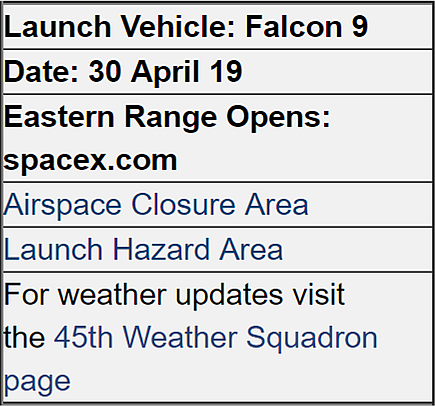
Название: Dragon SpX-17 (CRS-17), OCO-3, STP-H6 - Falcon 9-071 (B1056.1) - CCAFS SLC-40 - NET 25.04.2019, 10:20 UTC
Отправлено: tnt22 от 25.04.2019 19:43:17
Отправлено: tnt22 от 25.04.2019 19:43:17
45-е КК опубликовало
Airspace Closure Area (https://www.patrick.af.mil/Portals/14/CRS%2017%20Airspace%20Closure%20Area.pdf)
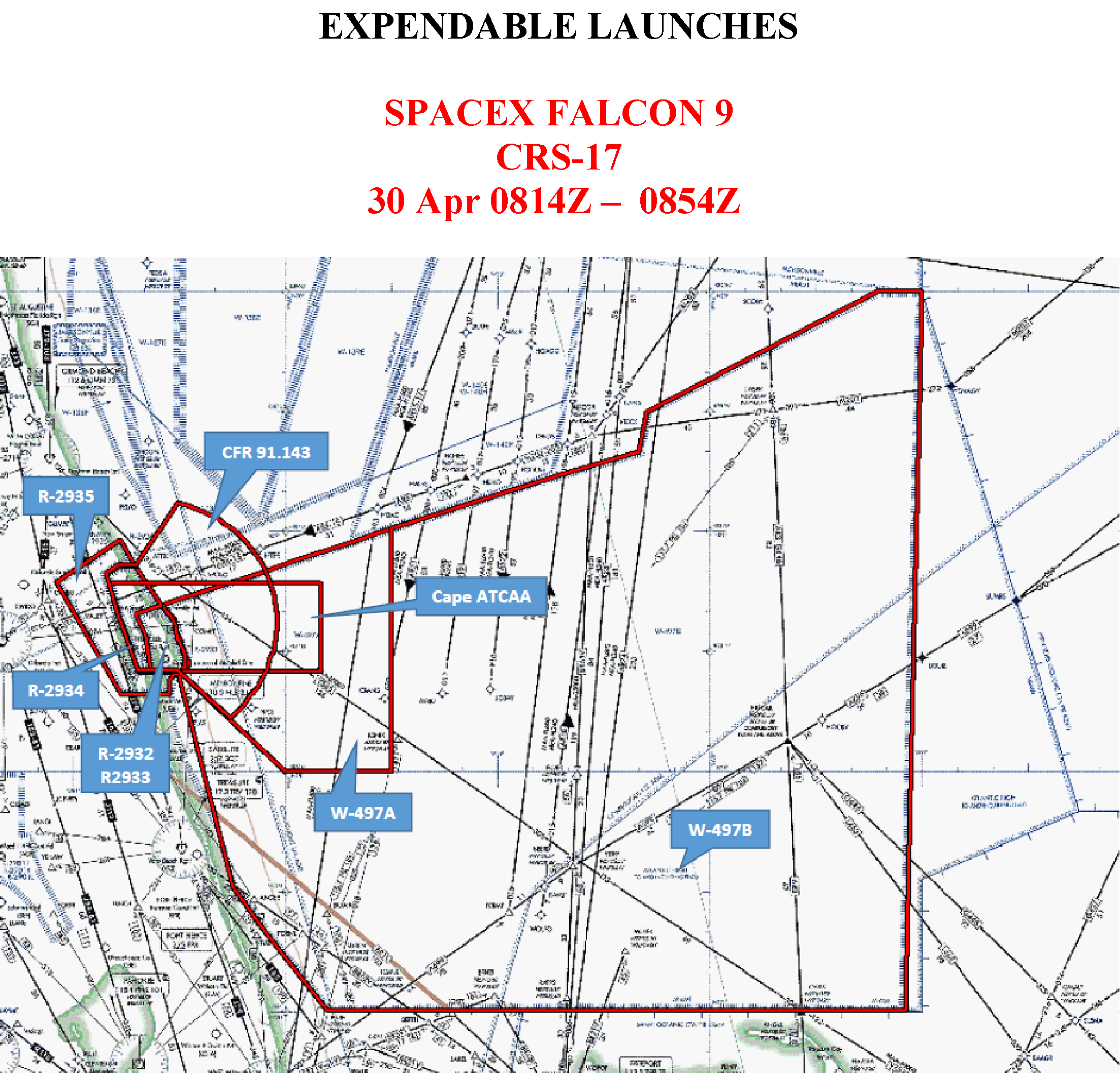
Airspace Closure Area (https://www.patrick.af.mil/Portals/14/CRS%2017%20Airspace%20Closure%20Area.pdf)
Название: Dragon SpX-17 (CRS-17), OCO-3, STP-H6 - Falcon 9-071 (B1056.1) - CCAFS SLC-40 - NET 25.04.2019, 10:20 UTC
Отправлено: tnt22 от 25.04.2019 19:47:22
Отправлено: tnt22 от 25.04.2019 19:47:22
Объявлена
Launch Hazard Area (https://www.patrick.af.mil/Portals/14/CRS-17%20LHA%20%2030%20Apr%2019.pdf)

Launch Hazard Area (https://www.patrick.af.mil/Portals/14/CRS-17%20LHA%20%2030%20Apr%2019.pdf)
Название: Dragon SpX-17 (CRS-17), OCO-3, STP-H6 - Falcon 9-071 (B1056.1) - CCAFS SLC-40 - NET 25.04.2019, 10:20 UTC
Отправлено: tnt22 от 25.04.2019 20:00:51
Отправлено: tnt22 от 25.04.2019 20:00:51
Предварительный прогноз (https://www.patrick.af.mil/Portals/14/Weather/25APR19.pdf?ver=2019-04-25-075224-810) погоды на пуск (30.04.2019)
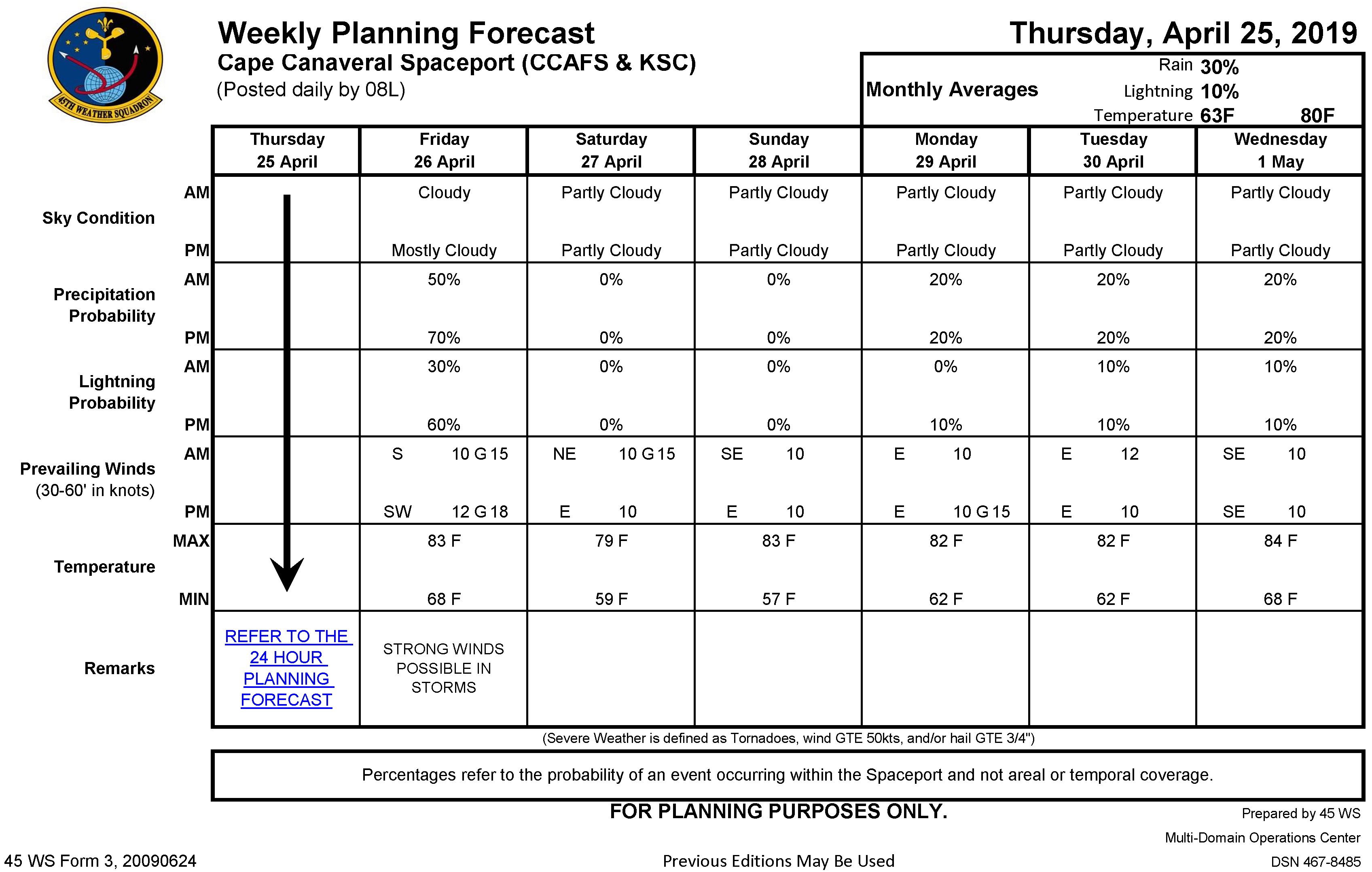
Температура воздуха от 17-ти до 28°C, переменная облачность с вероятностью осадков 20%, вероятность молниеобразования 10%, ветер с Атлантики 5 - 6 м/с.
Температура воздуха от 17-ти до 28°C, переменная облачность с вероятностью осадков 20%, вероятность молниеобразования 10%, ветер с Атлантики 5 - 6 м/с.
Название: Dragon SpX-17 (CRS-17), OCO-3, STP-H6 - Falcon 9-071 (B1056.1) - CCAFS SLC-40 - NET 25.04.2019, 10:20 UTC
Отправлено: tnt22 от 25.04.2019 20:13:14
Отправлено: tnt22 от 25.04.2019 20:13:14
https://blogs.nasa.gov/spacestation/2019/04/25/biomedical-and-botany-research-today-as-station-preps-for-sixth-spacecraft/
ЦитироватьBiomedical and Botany Research Today as Station Preps for Sixth Spacecraft
...
The SpaceX Dragon resupply ship is due to liftoff Tuesday at 4:21 a.m. EDT (https://www.nasa.gov/press-release/nasa-to-broadcast-next-space-station-resupply-launch-prelaunch-activities-0) on its 17th contracted cargo mission to the station. Canadian Space Agency astronaut David Saint-Jacques (http://www.asc-csa.gc.ca/eng/astronauts/canadian/active/bio-david-saint-jacques.asp) is training to capture Dragon with the Canadarm2 robotic arm when it arrives Thursday May 2 at 6:50 a.m. A pair of new experiments it is delivering will explore atmospheric carbon dioxide (https://www.nasa.gov/mission_pages/station/research/experiments/explorer/Investigation.html?#id=1786) as well as X-ray frequency communication (https://www.nasa.gov/mission_pages/station/research/experiments/explorer/Investigation.html?#id=7947) techniques.
Название: Dragon SpX-17 (CRS-17), OCO-3, STP-H6 - Falcon 9-071 (B1056.1) - CCAFS SLC-40 - NET 25.04.2019, 10:20 UTC
Отправлено: tnt22 от 25.04.2019 20:28:06
Отправлено: tnt22 от 25.04.2019 20:28:06
https://www.nasa.gov/press-release/nasa-to-broadcast-next-space-station-resupply-launch-prelaunch-activities-0
ЦитироватьApril 24, 2019
MEDIA ADVISORY M19-030
NASA to Broadcast Next Space Station Resupply Launch, Prelaunch Activities
Editor's Note: Launch time has been upd ated to 4:21 a.m. EDT and spacecraft capture now is se t for 6:50 a.m. NASA TV coverage off capture will begin at 5 a.m. (Updated April 25, 2019)
NASA commercial cargo provider SpaceX is targeting no earlier than 4:21 a.m. EDT Tuesday, April 30, for the launch of its next resupply mission to the International Space Station (http://www.nasa.gov/station). Live coverage will begin on NASA Television and the agency's website (https://www.nasa.gov/live) Monday, April 29, with prelaunch events.
This is the 17th SpaceX mission under NASA's Commercial Resupply Services contract. The Dragon spacecraft will deliver supplies and critical materials to support dozens of the more than 250 science and research investigations that will occur during Expeditions 59 and 60. The spacecraft'sunpressurized trunk will transport NASA's Orbiting Carbon Observatory-3 (https://ocov3.jpl.nasa.gov/) (OCO-3) and Space Test Program-Houston 6 (https://www.nasa.gov/mission_pages/station/research/experiments/explorer/Investigation.html?#id=7947) (STP-H6).
OCO-3 will be installed robotically on the exterior of the space station's Japanese Experiment Module Exposed Facility Unit, where it will measure and map carbon dioxide fr om space to increase our understanding of the relationship between carbon and climate. STP-H6 is an X-ray communication investigation that will be used to perform a space-based demonstration of a new technology for generating beams of modulated X-rays. This technology may be useful for providing efficient communication to deep space probes, or communicating with hypersonic vehicles wh ere plasma sheaths prevent traditional radio communications.
The spacecraft will take two days to reach the space station before installation on Thursday, May 2. When it arrives, astronaut David Saint-Jacques of the Canadian Space Agency will grapple Dragon, with NASA astronaut Nick Hague (https://www.nasa.gov/astronauts/biographies/tyler-nick-hague) serving as backup. NASA astronaut Christina Koch (https://www.nasa.gov/astronauts/biographies/christina-h-koch) will assist by monitoring telemetry during Dragon's approach. After Dragon capture, mission control in Houston will send commands to the station's arm to rotate and install the spacecraft on the bottom of the station's Harmony module.
Full mission coverage is as follows (all times Eastern):
Monday, April 29[/li]
[/li][/LIST]- 10:30 a.m. – What's on Board science briefing from NASA's Kennedy Space Center in Florida. This briefing will highlight the following research:
- Mike Roberts, deputy chief scientist of the International Space Station U.S. National Laboratory, will give an overview of the science heading to station as part of the ISS National Lab.
- Genes in Space (https://www.genesinspace.org/press/genes-space-stem-competition-announces-winning-high-school-team/) winners Rebecca Li, Aarthi Vijayakumar, Michelle Sung and David Li will discuss their experiment to study how cells repair their own DNA in space.
- Kristen John, principal investigator at NASA's Johnson Space Center, will discuss the Hermes Facility (https://www.nasa.gov/mission_pages/station/research/experiments/2779.html), a reconfigurable testing facility that can accommodate up to four experiments at a time. The facility will be used for investigations into the formation and behavior of asteroids and comets, impact dynamics, and planetary evolution.
- Annmarie Eldering, project scientist at NASA's Jet Propulsion Laboratory, will discuss how OCO-3 observes the complex dynamics of Earth's atmospheric carbon cycle.
- Lucie Low, scientific program manager at the National Center for Advancing Translational Sciences at the National Institutes of Health, and Geraldine Hamilton, president and chief scientific officer of Emulate, Inc.,will discuss Tissue Chips in Space (https://www.iss-casis.org/press-releases/casis-and-ncats-announce-five-projects-selected-from-international-space-station-funding-opportunity-focused-on-human-physiology-research/), research that will employ tissue chip technology (https://www.nasa.gov/tissue-chips) to develop and advance novel medical technologies on Earth.
[/li]
Tuesday, April 30- 1 p.m. – Prelaunch news conference with representatives from NASA's International Space Station Program, SpaceX and the U.S. Air Force's 45th Space Wing.
[/li]
Thursday, May 2- 4 a.m. – NASA TV launch coverage begins for the 4:21 a.m., liftoff
- 5:30 a.m. – Postlaunch news conference with representatives from NASA's International Space Station Program and SpaceX.
[/li]
Dragon will remain at the space station until May 31, when the spacecraft will return to Earth with research and return cargo.- 5 a.m. – Dragon rendezvous and capture coverage begins. Capture is scheduled for approximately 6:50 a.m.
- 9 a.m. – Dragon installation to the nadir port of the Harmony module of the station
Last Updated: April 25, 2019
Editor: Sean Potter
Название: Dragon SpX-17 (CRS-17), OCO-3, STP-H6 - Falcon 9-071 (B1056.1) - CCAFS SLC-40 - NET 25.04.2019, 10:20 UTC
Отправлено: tnt22 от 26.04.2019 00:00:09
Отправлено: tnt22 от 26.04.2019 00:00:09
https://www.nasa.gov/feature/hermes-to-bring-asteroid-research-to-the-iss
ЦитироватьApril 24, 2019
Hermes to Bring Asteroid Research to the ISS
Asteroid researchers on Earth will soon gain a powerful new way to remotely conduct experiments aboard the International Space Station (https://www.nasa.gov/mission_pages/station/research/index.html). The device, called the Hermes (https://www.nasa.gov/mission_pages/station/research/experiments/2603.html) Facility, is an experiment station that can communicate with scientists on the ground and give them the ability to control their studies almost as if they were in space themselves. Hermes will be carried to the space station aboard the SpaceX CRS-17 ferry flight.
Hermes is the creation of Dr. Kristen John, a researcher with the Astromaterials Research and Exploration Science (https://ares.jsc.nasa.gov/) (ARES) division at NASA's Johnson Space Center (JSC). John and her research team developed Hermes as a way to study how samples of simulated asteroid particles behave in microgravity and the vacuum of space.(https://www.nasa.gov/sites/default/files/thumbnails/image/john.jpg)
Hermes Principal Investigator, Kristen John, stands in front of the Hermes hardware. On the right is the Hermes Facility, and on the the left is Cassette-1, the first set of science experiments to be installed in the Facility.
Credits: NASA
Researching RegolithMessages from SpaceСпойлер
The material John is studying with Hermes is called asteroid regolith. The term is used for the layer of dusty, fragmented debris covering asteroids and moons created by impacts from meteorites and other forces on their surfaces.
"We need to study this material to understand how it's going to affect our spacecraft that interact with the surface of asteroids, or the joints of spacesuits worn by astronauts one day exploring them," John said.
Studying regolith also helps scientists understand the underpinning of how asteroids, moons and planets, such as our Earth, developed.[свернуть]The ExperimentСпойлер
John and her team designed Hermes to connect to the station's existing systems – including communications – so that it could be completely monitored and controlled from the ground. Hermes is also made to be easily adapted to many types of experiments.
"We named it for the Greek messenger god, Hermes, because we've designed a system that can deliver research data and experiments back forth between space and scientists," John said.(https://www.nasa.gov/sites/default/files/thumbnails/image/imgonline-com-ua-resize-iyz2qw4yquqbb52v.jpg)
The Cassette-1 hardware sits in a lab at Johnson Space Center. The Cassette includes the four experiments, electronics to control the experiments, and a vacuum system on the underside consisting of transducers, pipes, hoses, and valves.
Credits: NASA
Hermes is roughly the size of a large desktop computer and the experiments themselves are housed inside a removable carrier, called a cassette, which slides into Hermes.
John was assisted in designing and building Hermes by a team consisting of JSC, the University of Central Florida and researchers and students affiliated with Texas A&M University through a partnership with Texas Space, Technology, Applications and Research.
The JSC team included Kenton Fisher, an ARES engineer who led the development of Hermes' vacuum system, and project manager Veronica Saucedo with the Project Management and Integration Office of the Engineering Directorate.
"There is no greater satisfaction than seeing this project through from concept to delivery," Saucedo said. "I'm excited to see how the capability of this game-changing facility impacts asteroid, planetary science and exploration research."[свернуть]Charlie PlainСпойлер
The space station crew will install Hermes into an EXPRESS rack aboard the lab.
"After that, the crew will flip a few switches, and we'll basically take over from there," John said.
John's experiments for Cassette-1 are housed inside four clear, 10-inch plastic tubes containing materials meant to simulate regolith. Three of the tubes hold different-sized particles of silica glass. The fourth tube has a meteorite simulant which is a blend of variously sized particles, formulated especially for the experiment by Professor Addie Dove and students from the University of Central Florida.
"This experiment gave our students a chance to work on hardware that will actually fly on the ISS," Dove said. "They had to understand the experiment design and fabrication cycle, how to meet specifications and produce a quality product. This is much different than what they have to do in classes and provides valuable experience."
Over the coming months, John and her team will be watching to see how the regolith particles behave in response to long duration exposure to microgravity, and to changes in pressure, temperature, shocks from impacts and other forces. Once the regolith experiments inside Cassette-1 are complete, it will be removed from Hermes, returned to Earth and replaced with a new cassette of different experiments.[свернуть]
International Space Station Program Science Office
Johnson Space Center
Last Updated: April 25, 2019
Editor: Noah Michelsohn
Название: Dragon SpX-17 (CRS-17), OCO-3, STP-H6 - Falcon 9-071 (B1056.1) - CCAFS SLC-40 - NET 25.04.2019, 10:20 UTC
Отправлено: tnt22 от 26.04.2019 11:37:16
Отправлено: tnt22 от 26.04.2019 11:37:16
https://spaceflightnow.com/2019/04/25/carbon-monitoring-instrument-poised-for-launch-to-international-space-station/
ЦитироватьCarbon-monitoring instrument poised for launch to International Space Station
April 25, 2019 (https://spaceflightnow.com/2019/04/) | Stephen Clark (https://spaceflightnow.com/author/stephen-clark/)
An astronaut on the International Space Station captured this image of the Florida peninsula April 20. Credit: NASA
A $110 million NASA science instrument twice targeted for cancellation by the Trump administration is set for launch Tuesday inside the trunk of a SpaceX Dragon cargo capsule for delivery to the International Space Station, where it will spend three years charting changing carbon dioxide concentrations in Earth's atmosphere.
Once mounted outside the space station's Kibo lab module, the instrument package will scan the planet between 52 degrees north and 52 degrees south latitude with the sensitivity to measure carbon dioxide levels to a precision better than one part per million, or within about 0.3 to 0.5 percent of the total carbon dioxide present in the atmosphere.
The Orbiting Carbon Observatory-3, or OCO-3, instrument is a follow-up to NASA's OCO-2 satellite launched in 2014. OCO-2 was designed for a two-year mission, but continues collecting carbon dioxide data in its fifth year of operations.
"The key motivation for the OCO-3 experiment is to continue this record of carbon dioxide," said Annmarie Eldering, OCO-3 project scientist at NASA's Jet Propulsion Laboratory in Pasadena, California. "OCO-2 was built to last two years, we've had it up there for four years, but there's always a risk it's not going to survive.
"We'd like to have measurements that cover a long duration, and OCO-3 is going to help add to that record," Eldering said.
OCO-3's high-resolution spectrometers are fitted to an Earth-pointing telescope with the ability to scan side-to-side, allowing the instrument to measure carbon dioxide in 50-mile by 50-mile (80-kilometer) squares in as little as two minutes. Within that zone, OCO-3 can collect a snapshot of carbon dioxide levels over 1-mile-wide (1.6-kilometer) footprints.
The instrument will also observe faint light emitted by plants during photosynthesis, the process by which they convert light into energy, breathing in carbon dioxide and putting out oxygen. The light signal is called solar-induced fluorescence.
"When plants are doing photosynthesis, they emit a little bit of light, and we can sense that light in our measurements," Eldering said. "So we have a measure of plant photosynthesis activity in combination with the carbon dioxide."
Teams at JPL built OCO-3 around a spare instrument originally manufactured for OCO-2, but the new mission is more than a carbon copy, according to NASA scientists.Спойлер
OCO-2 flies in a polar sun-synchronous orbit providing nearly global coverage, whereas the space station's orbit does not pass over the poles. OCO-2's orbit is timed to allow the spacecraft to fly over the same region of the planet in the early afternoon — roughly 1:30 p.m. local time — every day.
An illustration of the OCO-3 instrument's scanning path under the space station's orbit. Credit: NASA/JPL-Caltech
The space station's orbit is not synchronized with the sun, allowing observations over time to cover the entire day, fr om sunrise to sunset.
"That's really important because plants respond to sun, so we need to see them behaving across the day," Eldering said.
"We can see how they're acting in the morning, at midday, what happens when it's really hot in the afternoon?" she said.
And OCO-2 flies at an altitude of around 438 miles (705 kilometers), nearly 200 miles (300 kilometers) above the space station's orbit.
"It is the same spectrometer (as OCO-2)," Eldering told reporters Monday. "The telescope is a little different because the orbit altitude is a little different."
The OCO-3 mission cost around $110 million, including expenses to modify the already-built sensors for use on the space station, according to Eldering. NASA spent $467 million on the instrument, spacecraft and launch vehicle for the OCO-2 mission. Most of those expenses are not required for a hosted payload flying on the space station.
NASA's efforts to establish a series of carbon dioxide-monitoring satellites have faced setbacks.
The first Orbiting Carbon Observatory, or OCO-1, was lost in a launch failure on a Taurus XL rocket in 2009. The Obama administration approved the OCO-2 replacement mission, which launched in July 2014 on a Delta 2 booster, and the follow-on OCO-3 mission using spare hardware.
Since the beginning of the Trump administration, the White House twice proposed eliminating OCO-3 fr om NASA's budget, along with other Earth science missions, including the Earth-facing instruments on the Deep Space Climate Observatory spacecraft stationed a million miles (1.5 million kilometers) fr om Earth.
The Trump administration has also proposed cancelling the Plankton, Aerosol, Cloud, ocean Ecosystem, or PACE, satellite mission, and the Climate Absolute Radiance and Refractivity Observatory Pathfinder, or CLARREO Pathfinder mission, on three occasions. The White House's fiscal year 2020 budget proposal, released earlier this year, did away with the request to terminate funding for the OCO-3 and DSCOVR missions.
Congress continued to fund OCO-3 and the other Earth science missions in fiscal year 2018 and 2019 budget bills signed by President Trump, keeping the projects alive.
NASA's Orbiting Carbon Observatory-3 (OCO-3) and the U.S. military's Space Test Program-Houston 6 (STP-H6) payloads are in view installed in the trunk of SpaceX's Dragon spacecraft inside the SpaceX facility at NASA's Kennedy Space Center in Florida on March 23, 2019. Credit: NASA
"Since about the start of the industrial revolution, we've seen CO2 levels in the atmosphere increase by about 30 percent," said Ralph Basilio, NASA's OCO-3 project manager at JPL. "Human activity is causing a tipping of the scales, this very fine delicate balance that we have in what we call the carbon cycle."
"OCO-3 is going to specifically produce a dataset of carbon dioxide measurements," Basilio said. "We'd like to be able to keep an eye on this atmospheric CO2. Wh ere did it come from? Wh ere is it going? And how is it related to other global processes?"
Carbon dioxide is a greenhouse gas, and scientists say rising levels of CO2 in the atmosphere caused by the burning of fossil fuels is driving temperatures warmer. Like its predecessor OCO-2, the OCO-3 instrument will seek to identify natural and human-made sources and sinks of carbon dioxide, places wh ere the gas is emitted into the atmosphere and ingested into plants and oceans.
Eldering said plants and oceans take out about half of the carbon dioxide produced by human activity, dampening the impact of rising CO2 emissions. But there's some variability year-to-year.
"We think it's tied to things like El Niño, drought, precipitation and temperature, but we really need to understand more if we want to predict accurately what will happen in the future," Eldering said. "We've got to understand these processes."
Using the new targeted pointing capability, which is not available on the OCO-2 satellite, the OCO-3 instrument will take snapshots of carbon dioxide concentrations over the oceans, forested regions, volcanoes, cities and industrial zones, such as power plants.
"This capability of OCO-3 to map out some of those areas and start to see some change over time, that really is how we're going to advance our understanding and our modeling for the future of understanding our climate," Eldering said.
OCO-3's ability to measure carbon dioxide at all times of the day will also help scientists collect more observations without interference from clouds, which are more prevalent in the afternoon, when OCO-2 flies overhead.
"For example, the vast carbon stores of the rapidly changing Amazon rainforest are a critical part of Earth's carbon cycle, but when OCO-2 flies over the forest at about 1:30 p.m., afternoon clouds have usually built up, hiding the region from the instrument's view," NASA said in a press release. "OCO-3 will pass the Amazon at all times of day, capturing far more cloud-free data.
https://www.youtube.com/watch?v=syU1rRCp7E8 (https://www.youtube.com/watch?v=syU1rRCp7E8)
In the above video, scientists used data from NASA's OCO-2 satellite to create a model of carbon dioxide motion in the atmosphere from Sept. 1, 2014, to Aug. 31, 2015.
The OCO-3 instrument is about the size of a refrigerator. The package will ride to the space station in the rear payload bay of a SpaceX Dragon cargo capsule set for launch Tuesday from Cape Canaveral.
Assuming an on-time launch, the robotic cargo carrier is scheduled to arrive at the space station next Thursday, May 2. Several days later, the station's Canadian-built Dextre robot will pull the instrument from the Dragon spacecraft's unpressurized trunk and hand it off to a Japanese robotic arm, which will position OCO-3 on the external science deck outside of the station's Kibo lab module.
After activation, OCO-3 is designed to collect carbon dioxide data for at least three years, and it requires no assistance from the astronauts living on the space station.
OCO-3 will be joined in the Dragon's trunk by a pallet sponsored by the U.S. military's Space Test Program containing multiple experiments for the Defense Department, NASA and university researchers. The STP-H6 payload will also be mounted outside the space station to conduct its investigations, which include an X-ray communications experiment that could prove useful for deep space probes and hypersonic missiles.
Several tons of food, experiments and supplies will also ride to the station inside the Dragon capsule's pressurized compartment.[свернуть]
Название: Dragon SpX-17 (CRS-17), OCO-3, STP-H6 - Falcon 9-071 (B1056.1) - CCAFS SLC-40 - NET 25.04.2019, 10:20 UTC
Отправлено: tnt22 от 26.04.2019 17:33:34
Отправлено: tnt22 от 26.04.2019 17:33:34
ЦитироватьKen Kremer @ken_kremer (https://twitter.com/ken_kremer) 2 ч. назад (https://twitter.com/ken_kremer/status/1121750823447535618)
8 AM Update 4/26: At last #Falcon9 (https://twitter.com/hashtag/Falcon9?src=hash) is raised at #Pad40 (https://twitter.com/hashtag/Pad40?src=hash) on FL Space Coast this hazy morning for #SpaceX (https://twitter.com/hashtag/SpaceX?src=hash) hot fire test NET later today. Launch target 4/30 @SpaceX (https://twitter.com/SpaceX) #CargoDragon (https://twitter.com/hashtag/CargoDragon?src=hash) #CRS17 (https://twitter.com/hashtag/CRS17?src=hash) to #ISS (https://twitter.com/hashtag/ISS?src=hash)Chris B - NSF @NASASpaceflight (https://twitter.com/NASASpaceflight) 2 ч. назад (https://twitter.com/NASASpaceflight/status/1121752495355830273)
Falcon 9 booster has rolled out and is now vertical for the Static Fire test ahead of the CRS-17 mission. We expect Falcon 9 will be feasting on an RP-1/LOX lunch shortly after midday.
Название: Dragon SpX-17 (CRS-17), OCO-3, STP-H6 - Falcon 9-071 (B1056.1) - CCAFS SLC-40 - NET 25.04.2019, 10:20 UTC
Отправлено: tnt22 от 26.04.2019 18:54:30
Отправлено: tnt22 от 26.04.2019 18:54:30
ЦитироватьChris B - NSF @NASASpaceflight (https://twitter.com/NASASpaceflight) 10 мин. назад (https://twitter.com/NASASpaceflight/status/1121801544054132736)
Rumor that the Falcon 9 Static Fire is now NET Saturday, which puts the Tuesday launch date for CRS-17 in doubt.
Название: Dragon SpX-17 (CRS-17), OCO-3, STP-H6 - Falcon 9-071 (B1056.1) - CCAFS SLC-40 - NET 25.04.2019, 10:20 UTC
Отправлено: tnt22 от 26.04.2019 20:20:31
Отправлено: tnt22 от 26.04.2019 20:20:31
https://blogs.nasa.gov/spacestation/2019/04/26/crew-juggles-emergency-drill-space-biology-and-dragon-preps/
ЦитироватьCrew Juggles Emergency Drill, Space Biology and Dragon Preps
Mark Garcia (https://blogs.nasa.gov/spacestation/author/magarcia/)
Posted Apr 26, 2019 at 12:57 pm
...
NASA Flight Engineers Nick Hague (https://www.nasa.gov/astronauts/biographies/tyler-nick-hague) ... later checked out command and communications gear he and astronaut David Saint-Jacques (http://www.asc-csa.gc.ca/eng/astronauts/canadian/active/bio-david-saint-jacques.asp) will use when the SpaceX Dragon resupply ship arrives next week. Saint-Jacques will command the Canadarm2 robotic arm (https://www.nasa.gov/mission_pages/station/structure/elements/mobile-servicing-system.html) to capture Dragon early Friday, May 2, two days after it launches from Florida. Hague will monitor Dragon's telemetry during its approach and rendezvous. NASA TV (https://www.nasa.gov/nasatv) is broadcasting the pre-flight activities and mission events (https://www.nasa.gov/press-release/nasa-to-broadcast-next-space-station-resupply-launch-prelaunch-activities-0) live.
...
Название: Dragon SpX-17 (CRS-17), OCO-3, STP-H6 - Falcon 9-071 (B1056.1) - CCAFS SLC-40 - NET 25.04.2019, 10:20 UTC
Отправлено: К.А. от 26.04.2019 20:34:16
Отправлено: К.А. от 26.04.2019 20:34:16
Каким номером капсула летит, известно?
Название: Dragon SpX-17 (CRS-17), OCO-3, STP-H6 - Falcon 9-071 (B1056.1) - CCAFS SLC-40 - NET 25.04.2019, 10:20 UTC
Отправлено: tnt22 от 26.04.2019 22:24:18
Отправлено: tnt22 от 26.04.2019 22:24:18
ЦитироватьJames DeanПодлинная учетная запись @flatoday_jdean (https://twitter.com/flatoday_jdean) 2 ч. назад (https://twitter.com/flatoday_jdean/status/1121833267769036802)
First forecast shows 80% chance of favorable weather for 4:22am ET Tuesday launch of SpaceX's #CRS17 (https://twitter.com/hashtag/CRS17?src=hash) resupply mission to ISS, if schedule holds. Same odds for 3:59am Wednesday attempt, if necessary.
Название: Dragon SpX-17 (CRS-17), OCO-3, STP-H6 - Falcon 9-071 (B1056.1) - CCAFS SLC-40 - NET 25.04.2019, 10:20 UTC
Отправлено: tnt22 от 27.04.2019 01:53:18
Отправлено: tnt22 от 27.04.2019 01:53:18
Цитировать07:59 UTCMichael Baylor @nextspaceflight (https://twitter.com/nextspaceflight) 10 мин. назад (https://twitter.com/nextspaceflight/status/1121907274665144320)
#SpaceX (https://twitter.com/hashtag/SpaceX?src=hash) is now targeting no-earlier than May 1st for the launch of #CRS17 (https://twitter.com/hashtag/CRS17?src=hash) from SLC-40 at Cape Canaveral. April 30th is no longer possible due to delays with the static fire which is now scheduled for Saturday.
7 мин. назад (https://twitter.com/nextspaceflight/status/1121908021146324992)
The launch would occur around 4:00 local (8:00 UTC) if May 1st ends up working out.
Название: Dragon SpX-17 (CRS-17), OCO-3, STP-H6 - Falcon 9-071 (B1056.1) - CCAFS SLC-40 - NET 25.04.2019, 10:20 UTC
Отправлено: tnt22 от 27.04.2019 02:53:15
Отправлено: tnt22 от 27.04.2019 02:53:15
ЦитироватьChris G - NSF @ChrisG_NSF (https://twitter.com/ChrisG_NSF) 34 мин. назад (https://twitter.com/ChrisG_NSF/status/1121916045323853824)
For a bit more launch time context for the #SpaceX (https://twitter.com/hashtag/SpaceX?src=hash) launch of #CRS17 (https://twitter.com/hashtag/CRS17?src=hash) on NET 1 May, liftoff looks to be tracking 03:59:54-ish EDT. Launch will be instantaneous, so to-the-second time is important. Could be off by ~15secs but looking like 0359/0400 EDT for that day.
#Dragon (https://twitter.com/hashtag/Dragon?src=hash) #Falcon9 (https://twitter.com/hashtag/Falcon9?src=hash)
35 мин. назад (https://twitter.com/ChrisG_NSF/status/1121916046162694145)
And since you're not allowed to attach an image to a quote tweet, here's the image showing the 03:59:54 EDT prediction.
#SpaceX (https://twitter.com/hashtag/SpaceX?src=hash) #Dragon (https://twitter.com/hashtag/Dragon?src=hash) #Falcon9 (https://twitter.com/hashtag/Falcon9?src=hash) #CRS17 (https://twitter.com/hashtag/CRS17?src=hash)
Название: Dragon SpX-17 (CRS-17), OCO-3, STP-H6 - Falcon 9-071 (B1056.1) - CCAFS SLC-40 - NET 25.04.2019, 10:20 UTC
Отправлено: tnt22 от 27.04.2019 16:56:46
Отправлено: tnt22 от 27.04.2019 16:56:46
ЦитироватьSpaceflight Now @SpaceflightNow (https://twitter.com/SpaceflightNow) 15 мин. назад (https://twitter.com/SpaceflightNow/status/1122133424255524867)
SpaceX's Falcon 9 rocket set for liftoff next week to resupply the International Space Station is on the launch pad at Cape Canaveral today for a hold-down engine-firing expected at 10am EDT (1400 GMT). Live updates: https://spaceflightnow.com/2019/04/27/falcon-9-crs-17-launch-preps/ ... (https://t.co/fyDXwlHzgE)
Название: Dragon SpX-17 (CRS-17), OCO-3, STP-H6 - Falcon 9-071 (B1056.1) - CCAFS SLC-40 - NET 25.04.2019, 10:20 UTC
Отправлено: tnt22 от 27.04.2019 16:59:16
Отправлено: tnt22 от 27.04.2019 16:59:16
https://spaceflightnow.com/2019/04/27/falcon-9-crs-17-launch-preps/
Цитировать04/27/2019 16:42 Stephen Clark
A puff of vapor is now appearing at the Complex 40 launch pad, suggesting fueling is well underway and the static fire test is on track for 10 a.m. EDT (1400 GMT), the opening of today's test window.
Название: Dragon SpX-17 (CRS-17), OCO-3, STP-H6 - Falcon 9-071 (B1056.1) - CCAFS SLC-40 - NET 25.04.2019, 10:20 UTC
Отправлено: tnt22 от 27.04.2019 17:02:46
Отправлено: tnt22 от 27.04.2019 17:02:46
Цитировать04/27/2019 16:57 Stephen Clark
The strongback umbilical tower at Complex 40 is retracting into position for engine start, suggesting the hold-down firing of the Falcon 9 rocket's nine first stage Merlin engines remains on track for 10 a.m. EDT (1400 GMT).
This firing will last several seconds as the rocket ramps up to 1.7 million pounds of thrust, while hold-down restraints keep the Falcon 9 on the ground.
Название: Dragon SpX-17 (CRS-17), OCO-3, STP-H6 - Falcon 9-071 (B1056.1) - CCAFS SLC-40 - NET 25.04.2019, 10:20 UTC
Отправлено: tnt22 от 27.04.2019 17:03:27
Отправлено: tnt22 от 27.04.2019 17:03:27
ЦитироватьSpaceflight Now @SpaceflightNow (https://twitter.com/SpaceflightNow) 53 сек. назад (https://twitter.com/SpaceflightNow/status/1122138780880769025)
The Falcon 9 rocket's Merlin main engines have ignited at Cape Canaveral, a key test before launch early Wednesday to respuply the International Space Station. We'll await confirmation of a successful test from SpaceX. https://spaceflightnow.com/2019/04/27/falcon-9-crs-17-launch-preps/ ... (https://t.co/fyDXwlHzgE)
Название: Dragon SpX-17 (CRS-17), OCO-3, STP-H6 - Falcon 9-071 (B1056.1) - CCAFS SLC-40 - NET 25.04.2019, 10:20 UTC
Отправлено: tnt22 от 27.04.2019 17:07:51
Отправлено: tnt22 от 27.04.2019 17:07:51
ЦитироватьTom McCool @Cygnusx112 (https://twitter.com/Cygnusx112) 1 мин. назад (https://twitter.com/Cygnusx112/status/1122139266908291072)
Based on the plume of smoke at 10am I would say #SpaceX (https://twitter.com/hashtag/SpaceX?src=hash) just completed the static fire for #CRS17 (https://twitter.com/hashtag/CRS17?src=hash). @NASASpaceflight (https://twitter.com/NASASpaceflight)
Цитировать04/27/2019 17:03 Stephen Clark
A plume of rocket exhaust over the launch pad suggests the Falcon 9 rocket's Merlin engines ignited at 10 a.m. EDT (1400 GMT). We'll stand by for confirmation from SpaceX of a successful test.
Название: Dragon SpX-17 (CRS-17), OCO-3, STP-H6 - Falcon 9-071 (B1056.1) - CCAFS SLC-40 - NET 25.04.2019, 10:20 UTC
Отправлено: tnt22 от 27.04.2019 17:25:18
Отправлено: tnt22 от 27.04.2019 17:25:18
ЦитироватьSpaceXПодлинная учетная запись @SpaceX (https://twitter.com/SpaceX) 57 сек. назад (https://twitter.com/SpaceX/status/1122144287162896384)
Static fire test of Falcon 9 complete—targeting May 1 launch from Pad 40 in Florida for Dragon's seventeenth mission to the @Space_Station (https://twitter.com/Space_Station)
Название: Dragon SpX-17 (CRS-17), OCO-3, STP-H6 - Falcon 9-071 (B1056.1) - CCAFS SLC-40 - NET 25.04.2019, 10:20 UTC
Отправлено: tnt22 от 27.04.2019 18:12:48
Отправлено: tnt22 от 27.04.2019 18:12:48
ЦитироватьNASA's Kennedy Space CenterПодлинная учетная запись @NASAKennedy (https://twitter.com/NASAKennedy) 23 мин. назад (https://twitter.com/NASAKennedy/status/1122150597992513537)
Packed with more than 5,500 pounds of research, supplies and hardaware, @SpaceX (https://twitter.com/SpaceX)'s #Dragon (https://twitter.com/hashtag/Dragon?src=hash)will launch at 3:59 a.m. ET on May 1.
Название: Dragon SpX-17 (CRS-17), OCO-3, STP-H6 - Falcon 9-071 (B1056.1) - CCAFS SLC-40 - NET 25.04.2019, 10:20 UTC
Отправлено: tnt22 от 27.04.2019 18:18:30
Отправлено: tnt22 от 27.04.2019 18:18:30
https://spaceflightnow.com/2019/04/27/falcon-9-rocket-completes-static-fire-test-aims-for-launch-early-wednesday/
ЦитироватьFalcon 9 rocket completes static fire test, aims for launch early Wednesday
April 27, 2019 (https://spaceflightnow.com/2019/04/) | Stephen Clark (https://spaceflightnow.com/author/stephen-clark/)
A plume of exhaust appears at Cape Canaveral's Complex 40 launch pad at 10 a.m. EDT (1400 GMT) Saturday as the Falcon 9 rocket's nine Merlin main engines ignite for a hold-down test-firing. Credit: Steven Young/Spaceflight Now
A week after a test-firing of SpaceX's new crew capsule went awry, SpaceX successfully completed a hold-down firing of its next Falcon 9 launcher Saturday morning at Cape Canaveral in preparation for a predawn liftoff Wednesday carrying several tons of food, supplies and experiments to the International Space Station.
The Falcon 9 rocket, without its Dragon cargo capsule, ignited nine Merlin 1D first stage engines at 10 a.m. EDT (1400 GMT) Saturday, sending a plume of exhaust into the air as the kerosene-fueled powerplants ramped up to full throttle, producing 1.7 million pounds of thrust.
SpaceX confirmed a good test in a tweet soon after the hold-down firing.
Hold-down restraints kept the Falcon 9 rocket firmly on the ground during the test, which lasted several seconds. SpaceX will lower the Falcon 9 rocket at the Complex 40 launch pad and return it to a nearby hangar for attachment with the Dragon spacecraft, which is being reused after a previous trip to the space station.
The Falcon 9 and return will roll back to the pad next week in preparation for liftoff Wednesday, May 1, at 3:59 a.m. EDT (0759 GMT), roughly the moment Earth's rotation brings the launch pad under the space station's orbital plane.Assuming the Falcon 9 takes off Wednesday, the Dragon supply ship is due to reach the space station early Saturday. The station astronauts will grapple the Dragon cargo freighter using the orbiting lab's Canadian-built robotic arm, then move the supply ship to a berthing port for a stay planned to last around one month.Спойлер
SpaceX plans to land the Falcon 9's first stage on a drone ship in the Atlantic Ocean approximately 17 miles (28 kilometers) southeast of the launch pad, or due east from the easternmost point of Cape Canaveral.
SpaceX's Landing Zone 1, a former Atlas launch pad at Cape Canaveral Air Force Station, was the site of the April 20 explosion of a Crew Dragon spacecraft during ground testing. Investigators and ground teams are safing the site after the accident, and collecting evidence to help determine the cause of the mishap, which dealt a major setback to the commercial crew capsule program developed in partnership between SpaceX and NASA.
The accident prompted SpaceX to move the landing of the rocket on the next Falcon 9 launch from the onshore facility to the offshore drone ship. Resupply missions to the space station do not require all of the Falcon 9's lift capacity, leaving enough fuel in the first stage to reverse course and return to Cape Canaveral, so the drone ship will be positioned just off the coast, not the more typical distance of several hundred miles downrange.
NASA and SpaceX officials are assessing whether last weekend's accident may raise any concerns about the next Dragon resupply mission, according to members of NASA's Aerospace Safety Advisory Panel. But the Dragon cargo craft is much different from the Crew Dragon, and the accident April 20 occurred during a hotfire test of the crew capsule's SuperDraco abort engines, which are not used on Dragon spacecraft set for liftoff next week.
SpaceX is pressing ahead with preparations for Wednesday's launch, but the Crew Dragon accident could again be discussed by senior managers during a launch readiness review planned for Tuesday.
The mission was previously slated for liftoff Tuesday, following a test-firing of the Falcon 9's engines Friday. But the static fire was delayed to Saturday for unspecified reasons — SpaceX does not usually discuss the timing of pre-launch hotfire tests before they are completed — forcing a one-day delay in the launch to Wednesday.
A forecast issued Friday by the U.S. Air Force's 45th Weather Squadron predicted an 80 percent probability of favorable weather conditions for a predawn launch Wednesday.
NASA's Orbiting Carbon Observatory-3 (OCO-3) and the U.S. military's Space Test Program-Houston 6 (STP-H6) payloads are in view installed in the trunk of SpaceX's Dragon spacecraft inside the SpaceX facility at NASA's Kennedy Space Center in Florida on March 23, 2019. Credit: NASA[свернуть]Wednesday's launch will be SpaceX's fifth mission of the year, and the fifth launch overall from Cape Canaveral so far in 2019.Спойлер
While astronauts unpack the food, provisions and biological experiments carried inside Dragon's pressurized compartment, robotic arms outside the station will retrieve a pair of instrument packages to be mounted on science decks outside the complex.
One of the experiments, developed by NASA's Jet Propulsion Laboratory, will measure the amount of carbon dioxide in Earth's atmosphere over a three-year mission. Scientists want to extend a record of space-based carbon dioxide measurements begun in 2014 by NASA's Orbiting Carbon Observatory satellite mission, which has exceeded its design life.
Another external unit inside Dragon managed by the U.S. military's Space Test Program hosts several investigations, including a novel X-ray communications experiment developed by NASA and the Naval Research Laboratory. X-ray signals could provide a new way to communicate with deep space probes or hypersonic missiles in flight, according to scientists.[свернуть]
Название: Dragon SpX-17 (CRS-17), OCO-3, STP-H6 - Falcon 9-071 (B1056.1) - CCAFS SLC-40 - NET 25.04.2019, 10:20 UTC
Отправлено: tnt22 от 27.04.2019 18:27:14
Отправлено: tnt22 от 27.04.2019 18:27:14
https://tass.ru/kosmos/6385480
Цитировать27 АПР, 18:11
Запуск корабля Dragon с грузом для МКС перенесен на 1 мая
ТАСС, 27 апреля. Запуск ракеты-носителя Falcon 9 компании SpaceX с кораблем Dragon и грузом, предназначенным для экипажа Международной космической станции (МКС), перенесен на 1 мая. Об этом SpaceX сообщила в субботу в своем Twitter (https://twitter.com/SpaceX/status/1122144287162896384).
"Старт 17-й миссии Dragon к МКС со стартового комплекса 40 [на базе ВВС США на мысе Канаверал] во Флориде намечен на 1 мая", - отмечается в сообщении. В компании также заявили, что огневые испытания готовящейся к пуску ракеты-носителя завершены. До этого запуск планировалось осуществить 30 апреля.Спойлер
В последний раз запуск Dragon к МКС осуществлялся 5 декабря. Он доставил на станцию свыше 2,5 т грузов, в том числе продовольствие, материалы для исследований и приборы, предназначенные для изучения явлений в атмосфере Земли. 14 января корабль вернулся на Землю, доставив с МКС результаты научных экспериментов. Он приводнился в Тихом океане у южного побережья штата Калифорния, причем это впервые произошло в темное время суток.[свернуть]
Название: Dragon SpX-17 (CRS-17), OCO-3, STP-H6 - Falcon 9-071 (B1056.1) - CCAFS SLC-40 - NET 25.04.2019, 10:20 UTC
Отправлено: tnt22 от 28.04.2019 00:36:50
Отправлено: tnt22 от 28.04.2019 00:36:50
О коррекции времени начала некоторых трансляций пусковой кампании (см #32 (http://novosti-kosmonavtiki.ru/forum/messages/forum10/topic16730/message1848392/#message1848392))
https://www.nasa.gov/press-release/nasa-to-broadcast-next-space-station-resupply-launch-prelaunch-activities-0
https://www.nasa.gov/press-release/nasa-to-broadcast-next-space-station-resupply-launch-prelaunch-activities-0
ЦитироватьEditor's Note: Launch time has been updated to 3:59 a.m. EDT, Wednesday, May 1. The What's on Board Science Briefing time of 10:30 a.m., Monday, April 29 is unchanged. The prelaunch news conference will be held on Tuesday, April 30 at 1 p.m. (Updated April 27, 2019)Время начала трансляции пуска будет скорректировано позже.
Название: Dragon SpX-17 (CRS-17), OCO-3, STP-H6 - Falcon 9-071 (B1056.1) - CCAFS SLC-40 - NET 25.04.2019, 10:20 UTC
Отправлено: tnt22 от 28.04.2019 00:48:57
Отправлено: tnt22 от 28.04.2019 00:48:57
Расписание трансляций НАСА ТВ скорректировано
https://www.nasa.gov/multimedia/nasatv/schedule.html
https://www.nasa.gov/multimedia/nasatv/schedule.html
ЦитироватьNASA Television Upcoming EventsUTC = EDT + 4 h
Watch NASA TV (https://www.nasa.gov/multimedia/nasatv/index.html#public)
All times Eastern
APRIL
April 29, Monday
10:30 a.m. – SpaceX CRS-17 What's On Board Briefing (All Channels)
April 30, Tuesday
1 p.m. – SpaceX CRS-17 Pre-Launch News Conference (All Channels)
MAY
May 1
3:30 a.m. – Coverage of the Launch of the SpaceX CRS-17 Dragon Cargo Craft Mission to the International Space Station; launch is scheduled at 3:59 a.m. ET (All Channels)
5:30 a.m. – SpaceX CRS-17 Post-Launch News Conference (time subject to change) (All Channels)
May 2, Thursday
5 a.m. – Coverage of the rendezvous and capture of the SpaceX CRS-17 Dragon cargo craft at the International Space Station; capture scheduled at 6:50 a.m. ET (All Channels)
9 a.m. – Coverage of the installation of the SpaceX CRS-17 Dragon cargo craft to the International Space Station (All Channels)
Название: Dragon SpX-17 (CRS-17), OCO-3, STP-H6 - Falcon 9-071 (B1056.1) - CCAFS SLC-40 - NET 25.04.2019, 10:20 UTC
Отправлено: tnt22 от 28.04.2019 01:02:10
Отправлено: tnt22 от 28.04.2019 01:02:10
Предварительный прогноз (https://www.patrick.af.mil/Portals/14/Weather/27APR19.pdf?ver=2019-04-27-032332-680) погоды на пуск (01.05.2019)
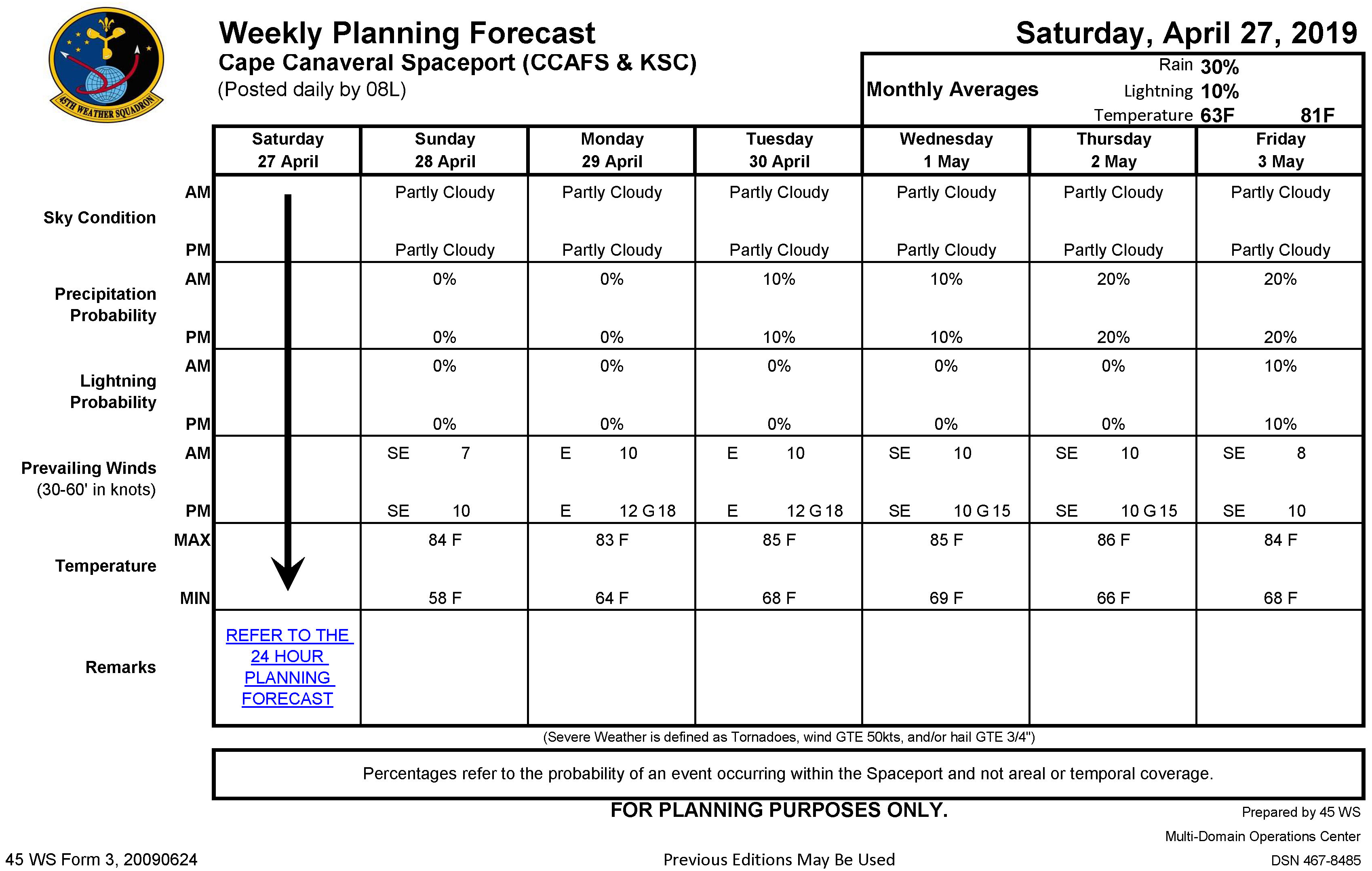
Температура воздуха от 20-ти до 29°C, переменная облачность с вероятностью осадков 10%, ветер с юго-востока 5 м/с.
Температура воздуха от 20-ти до 29°C, переменная облачность с вероятностью осадков 10%, ветер с юго-востока 5 м/с.
Название: Dragon SpX-17 (CRS-17), OCO-3, STP-H6 - Falcon 9-071 (B1056.1) - CCAFS SLC-40 - NET 25.04.2019, 10:20 UTC
Отправлено: tnt22 от 28.04.2019 02:01:40
Отправлено: tnt22 от 28.04.2019 02:01:40
https://blogs.nasa.gov/spacex/2019/04/27/spacex-crs-17-launch-now-scheduled-for-may-1/
ЦитироватьSpaceX CRS-17 Launch Now Scheduled for May 1
Sarah Loff (https://blogs.nasa.gov/spacex/author/sloff/)
Posted Apr 27, 2019 at 11:08 am
NASA's commercial cargo provider SpaceX is targeting 3:59 a.m. EDT on Wednesday, May 1, for the launch of its 17th resupply mission to the International Space Station (https://www.nasa.gov/station) after successful completion of its static fire engine test. Packed with more than 5,500 pounds of research, crew supplies and hardware, the SpaceX Dragon spacecraft will launch on a Falcon 9 rocket from Space Launch Complex 40 at Cape Canaveral Air Force Station.(https://blogs.nasa.gov/spacex/wp-content/uploads/sites/227/2018/12/CRS-16-SpaceX-Falcon-9-on-Pad.jpg)
A SpaceX Falcon 9 rocket and Dragon spacecraft at Space Launch Complex 40 at Cape Canaveral Air Force Station in Florida. Photo credit: NASA
Follow along with the coverage of the SpaceX CRS-17 mission with prelaunch events on NASA Television and at www.nasa.gov/live (https://www.nasa.gov/live).[/li]
- Monday, April 29 at 10:30 a.m. – What's On Board science briefing
- Tuesday, April 30 at 1 p.m. – Prelaunch news conference
- Wednesday, May 1 at 3:30 a.m. – NASA TV launch coverage
Название: Dragon SpX-17 (CRS-17), OCO-3, STP-H6 - Falcon 9-071 (B1056.1) - CCAFS SLC-40 - NET 25.04.2019, 10:20 UTC
Отправлено: ОАЯ от 28.04.2019 13:04:02
Отправлено: ОАЯ от 28.04.2019 13:04:02
https://www.accuweather.com/ru/us/miami-fl/33128/may-weather/347936
Погода в Маями:
29 апреля гроза
2 мая гроза
3 мая гроза
7 мая гроза
Посмотрим как пройдет старт.
Погода в Маями:
29 апреля гроза
2 мая гроза
3 мая гроза
7 мая гроза
Посмотрим как пройдет старт.
Название: Dragon SpX-17 (CRS-17), OCO-3, STP-H6 - Falcon 9-071 (B1056.1) - CCAFS SLC-40 - NET 25.04.2019, 10:20 UTC
Отправлено: tnt22 от 28.04.2019 20:52:44
Отправлено: tnt22 от 28.04.2019 20:52:44
Прогноз погоды L-3
L-3 Forecast 1 May Launch (https://www.patrick.af.mil/Portals/14/Weather/L-3%20Forecast%201%20May%2019%20Launch.pdf?ver=2019-04-28-114627-263)
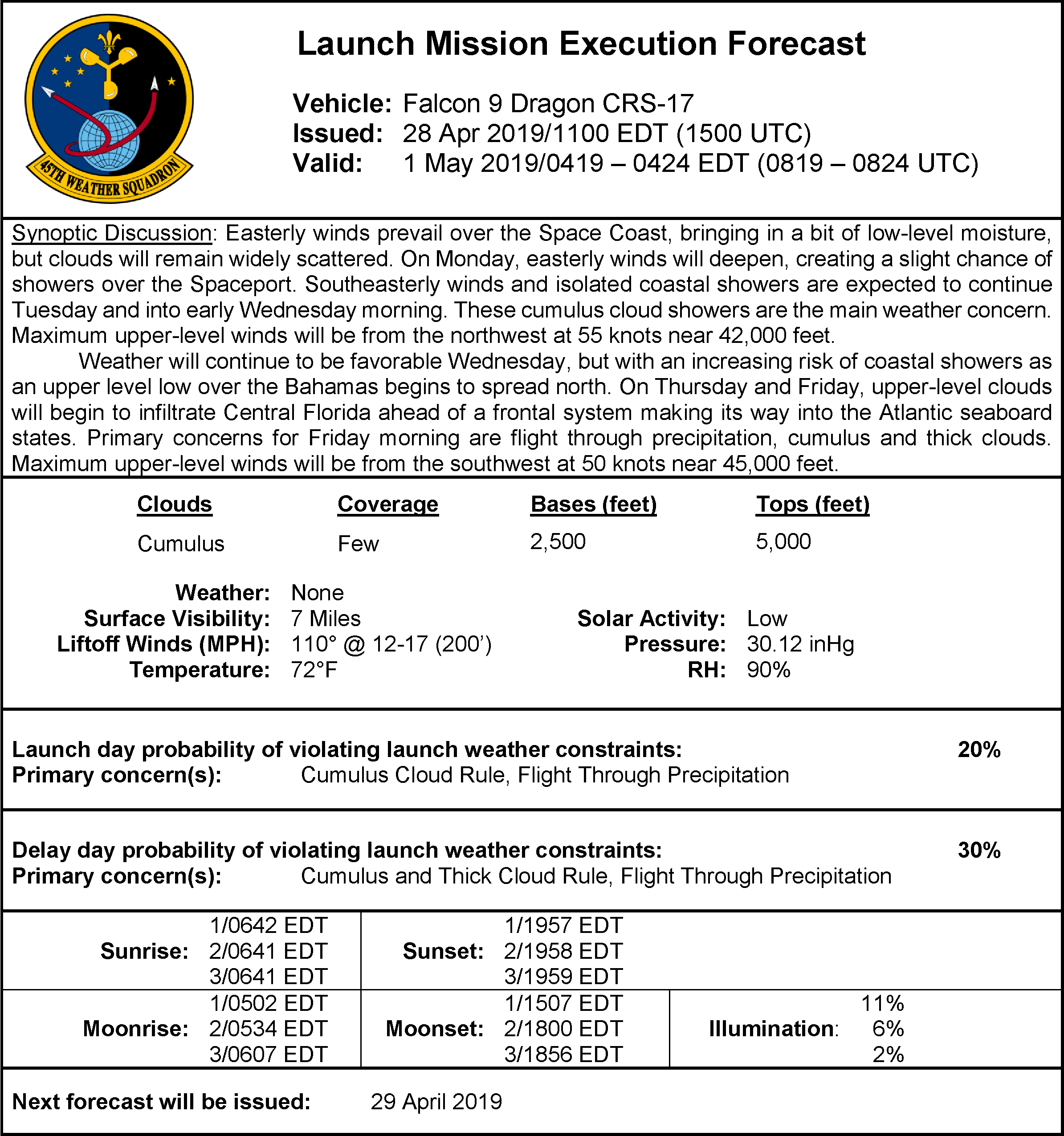
Пусковой день (01.05) - 80 % GO
Резервный день (02.05) - 70 % GO
L-3 Forecast 1 May Launch (https://www.patrick.af.mil/Portals/14/Weather/L-3%20Forecast%201%20May%2019%20Launch.pdf?ver=2019-04-28-114627-263)
Пусковой день (01.05) - 80 % GO
Резервный день (02.05) - 70 % GO
Название: Dragon SpX-17 (CRS-17), OCO-3, STP-H6 - Falcon 9-071 (B1056.1) - CCAFS SLC-40 - NET 25.04.2019, 10:20 UTC
Отправлено: tnt22 от 29.04.2019 05:57:21
Отправлено: tnt22 от 29.04.2019 05:57:21
NOTAMs на 2-ю ст РН
ЦитироватьYMMM
F1091/19 - ROCKET LAUNCH WILL TAKE PLACE
FLW RECEIVED FROM GOVERNMENT OF UNITED STATES OF AMERICA:
HAZARDOUS OPS WILL BE CONDUCTED FOR ATMOSPHERIC RE-ENTRY AND
SPLASHDOWN OF LAUNCH VEHICLE FALCON-9 CRS-17 STAGE 2 AND
PARTICIPATING SUPPORT ACFT WI THE FOLLOWING AREAS:
2925S 8846E
2750S 8947E
2832S 9255E
4038S 11815E
4542S 13529E
4852S 16430E
5034S 16551E
5216S 16051E
5324S 15146E
5258S 13445E
4929S 11740E
4204S 10134E
3515S 9259E TO BEGINNING.
SFC - UNL, PRI RE-ENTRY 1904300854-0943
BACKUP RE-ENTRY 1905010831-0921,
30 APR 08:54 2019 UNTIL 01 MAY 09:21 2019.
CREATED: 19 APR 20:39 2019
NZZO
B2440/19 - TEMPO DANGER AREA NZD026 (EAST AUCKLAND OCEANIC FIR) IS PRESCRIBED AS FLW:
ALL THAT AIRSPACE BOUNDED BY A LINE JOINING
48 52 00.0 S 164 30 00.0 E
50 34 00.0 S 165 51 00.0 E
51 32 08.4 S 163 00 00.0 E
48 45 00.0 S 163 00 00.0 E
ACTIVITY: SPACE DEBRIS RETURN
USER AGENCY: FOREIGN SPACE AGENCY
PRESCRIBED PURSUANT TO CIVIL AVIATION RULE PART 71 UNDER A DELEGATED AUTHORITY ISSUED BY THE DIRECTOR OF CIVIL AVIATION.
SFC - FL999, 30 APR 08:50 2019 UNTIL 30 APR 09:50 2019.
CREATED: 29 APR 02:08 2019
Название: Dragon SpX-17 (CRS-17), OCO-3, STP-H6 - Falcon 9-071 (B1056.1) - CCAFS SLC-40 - NET 25.04.2019, 10:20 UTC
Отправлено: tnt22 от 29.04.2019 17:14:13
Отправлено: tnt22 от 29.04.2019 17:14:13
https://blogs.nasa.gov/spacex/2019/04/29/spacex-targeting-wednesday-may-1-at-359-edt-for-crs-17-launch/
https://blogs.nasa.gov/kennedy/2019/04/29/spacex-targeting-wednesday-may-1-at-359-edt-for-crs-17-launch/
https://blogs.nasa.gov/kennedy/2019/04/29/spacex-targeting-wednesday-may-1-at-359-edt-for-crs-17-launch/
ЦитироватьSpaceX Targeting Wednesday, May 1 at 3:59 EDT for CRS-17 Launch
James Cawley (https://blogs.nasa.gov/spacex/author/jjcawley/)
Posted Apr 29, 2019 at 9:40 am(https://blogs.nasa.gov/spacex/wp-content/uploads/sites/227/2019/04/CRS-16-with-bushes.jpg)
The two-stage Falcon 9 launch vehicle lifts off Space Launch Complex 40 at Cape Canaveral Air Force Station in Florida during SpaceX's 16th commercial resupply services mission to the International Space Station on Dec. 5, 2018. SpaceX is targeting Wednesday, May 1, at 3:59 EDT for its CRS-17 mission launch. Photo credit: NASA/Kim Shiflett
NASA's commercial cargo provider SpaceX is targeting 3:59 a.m. EDT on Wednesday, May 1, for the launch of its 17th resupply mission to the International Space Station (http://www.nasa.gov/station) after successful completion of its static fire engine test. Packed with more than 5,500 pounds of research, crew supplies and hardware, the SpaceX Dragon spacecraft will launch on a Falcon 9 rocket from Space Launch Complex 40 at Cape Canaveral Air Force Station.
Follow along with the coverage of the SpaceX CRS-17 mission with prelaunch events on NASA Television and at www.nasa.gov/live (http://www.nasa.gov/live).[/li]
- Monday, April 29 at 10:30 a.m. — What's On Board science briefing
- Tuesday, April 30 at 1 p.m. — Prelaunch news conference
- Wednesday, May 1 at 3:30 a.m. — NASA TV launch coverage
Название: Dragon SpX-17 (CRS-17), OCO-3, STP-H6 - Falcon 9-071 (B1056.1) - CCAFS SLC-40 - NET 25.04.2019, 10:20 UTC
Отправлено: tnt22 от 29.04.2019 17:29:51
Отправлено: tnt22 от 29.04.2019 17:29:51
Название: Dragon SpX-17 (CRS-17), OCO-3, STP-H6 - Falcon 9-071 (B1056.1) - CCAFS SLC-40 - NET 25.04.2019, 10:20 UTC
Отправлено: tnt22 от 29.04.2019 17:33:18
Отправлено: tnt22 от 29.04.2019 17:33:18
Название: Dragon SpX-17 (CRS-17), OCO-3, STP-H6 - Falcon 9-071 (B1056.1) - CCAFS SLC-40 - NET 25.04.2019, 10:20 UTC
Отправлено: tnt22 от 29.04.2019 17:41:36
Отправлено: tnt22 от 29.04.2019 17:41:36
Название: Dragon SpX-17 (CRS-17), OCO-3, STP-H6 - Falcon 9-071 (B1056.1) - CCAFS SLC-40 - NET 25.04.2019, 10:20 UTC
Отправлено: tnt22 от 29.04.2019 17:44:32
Отправлено: tnt22 от 29.04.2019 17:44:32
Название: Dragon SpX-17 (CRS-17), OCO-3, STP-H6 - Falcon 9-071 (B1056.1) - CCAFS SLC-40 - NET 25.04.2019, 10:20 UTC
Отправлено: tnt22 от 29.04.2019 17:45:09
Отправлено: tnt22 от 29.04.2019 17:45:09
Название: Dragon SpX-17 (CRS-17), OCO-3, STP-H6 - Falcon 9-071 (B1056.1) - CCAFS SLC-40 - NET 25.04.2019, 10:20 UTC
Отправлено: tnt22 от 29.04.2019 17:51:56
Отправлено: tnt22 от 29.04.2019 17:51:56
Название: Dragon SpX-17 (CRS-17), OCO-3, STP-H6 - Falcon 9-071 (B1056.1) - CCAFS SLC-40 - NET 25.04.2019, 10:20 UTC
Отправлено: tnt22 от 29.04.2019 17:55:20
Отправлено: tnt22 от 29.04.2019 17:55:20
Название: Dragon SpX-17 (CRS-17), OCO-3, STP-H6 - Falcon 9-071 (B1056.1) - CCAFS SLC-40 - NET 25.04.2019, 10:20 UTC
Отправлено: tnt22 от 29.04.2019 18:01:34
Отправлено: tnt22 от 29.04.2019 18:01:34
Название: Dragon SpX-17 (CRS-17), OCO-3, STP-H6 - Falcon 9-071 (B1056.1) - CCAFS SLC-40 - NET 25.04.2019, 10:20 UTC
Отправлено: tnt22 от 29.04.2019 18:12:02
Отправлено: tnt22 от 29.04.2019 18:12:02
Название: Dragon SpX-17 (CRS-17), OCO-3, STP-H6 - Falcon 9-071 (B1056.1) - CCAFS SLC-40 - NET 25.04.2019, 10:20 UTC
Отправлено: tnt22 от 29.04.2019 18:30:46
Отправлено: tnt22 от 29.04.2019 18:30:46
Название: Dragon SpX-17 (CRS-17), OCO-3, STP-H6 - Falcon 9-071 (B1056.1) - CCAFS SLC-40 - NET 25.04.2019, 10:20 UTC
Отправлено: tnt22 от 29.04.2019 18:32:58
Отправлено: tnt22 от 29.04.2019 18:32:58
Название: Dragon SpX-17 (CRS-17), OCO-3, STP-H6 - Falcon 9-071 (B1056.1) - CCAFS SLC-40 - NET 25.04.2019, 10:20 UTC
Отправлено: tnt22 от 29.04.2019 18:33:57
Отправлено: tnt22 от 29.04.2019 18:33:57
Название: Dragon SpX-17 (CRS-17), OCO-3, STP-H6 - Falcon 9-071 (B1056.1) - CCAFS SLC-40 - NET 25.04.2019, 10:20 UTC
Отправлено: tnt22 от 29.04.2019 18:57:25
Отправлено: tnt22 от 29.04.2019 18:57:25
Прогноз погоды L-2
L-2 Forecast 1 May Launch (https://www.patrick.af.mil/Portals/14/Weather/L-2%20Forecast%201%20May%2019%20Launch.pdf?ver=2019-04-29-111234-210)
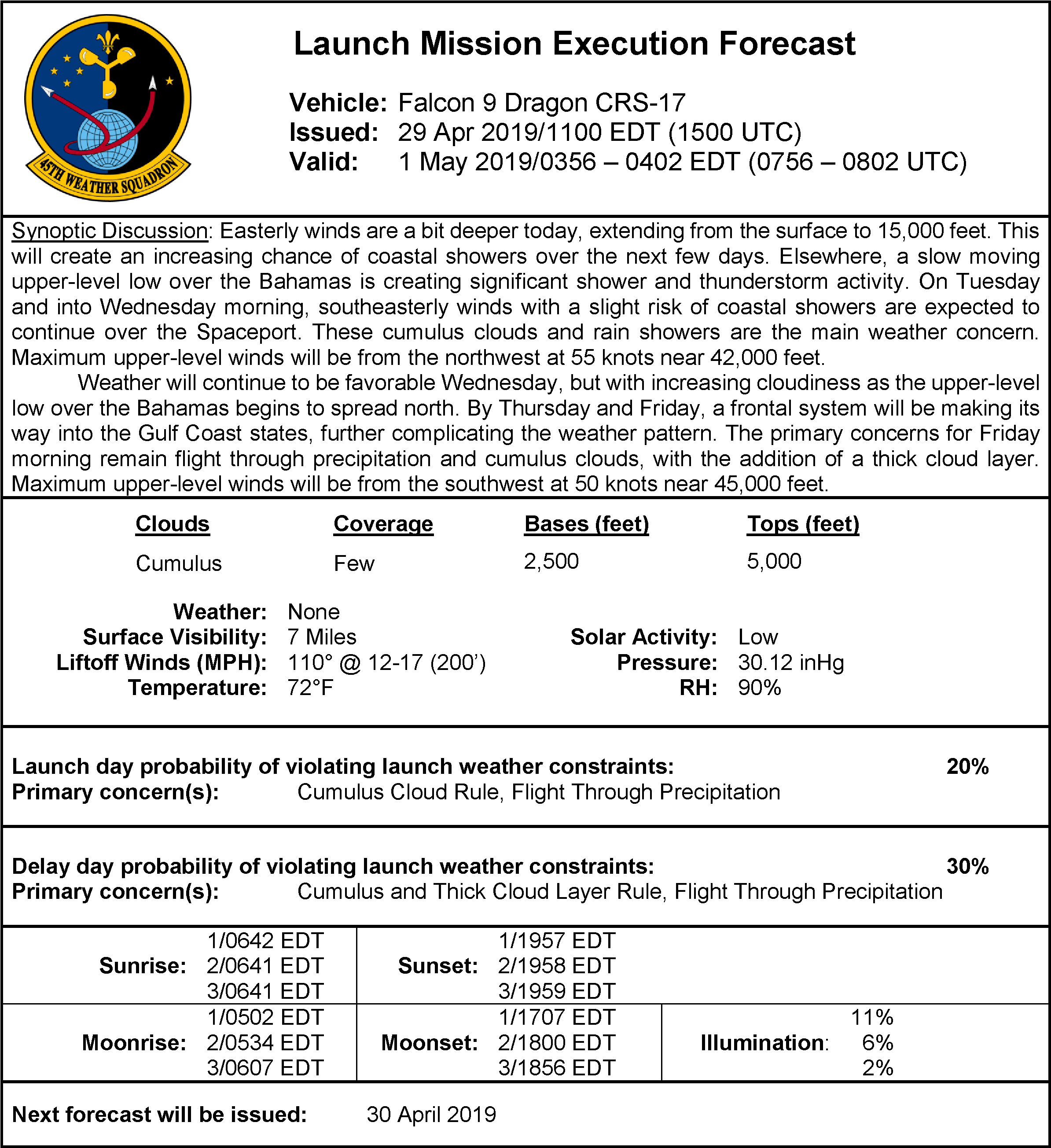
Пусковой день (01.05) - = 80 % GO
Резервный день (02.05) - = 70 % GO
L-2 Forecast 1 May Launch (https://www.patrick.af.mil/Portals/14/Weather/L-2%20Forecast%201%20May%2019%20Launch.pdf?ver=2019-04-29-111234-210)
Пусковой день (01.05) - = 80 % GO
Резервный день (02.05) - = 70 % GO
Название: Dragon SpX-17 (CRS-17), OCO-3, STP-H6 - Falcon 9-071 (B1056.1) - CCAFS SLC-40 - NET 25.04.2019, 10:20 UTC
Отправлено: tnt22 от 29.04.2019 19:01:41
Отправлено: tnt22 от 29.04.2019 19:01:41
Зона затопления 2-й ст РН (см #57 (http://novosti-kosmonavtiki.ru/forum/messages/forum10/topic16730/message1849467/#message1849467))
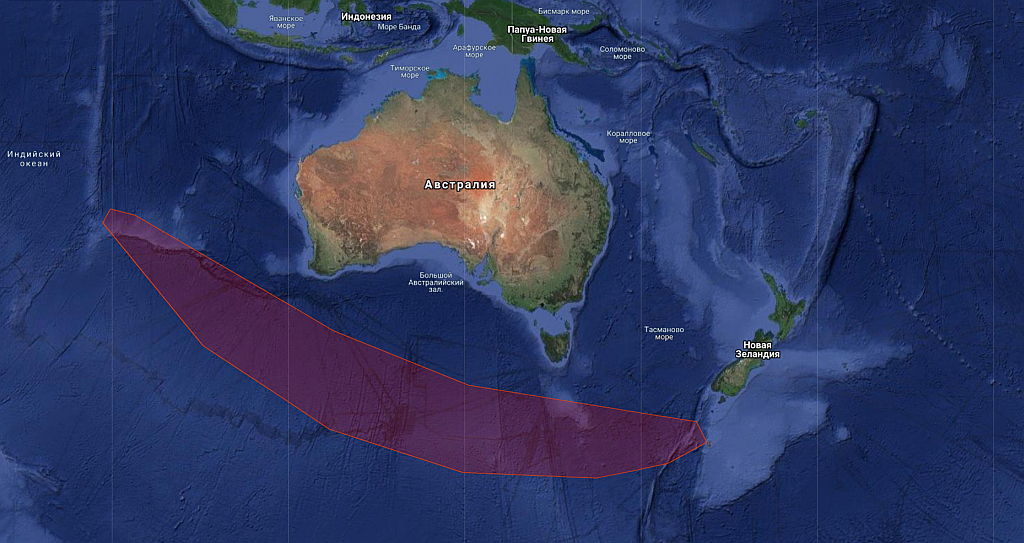
Название: Dragon SpX-17 (CRS-17), OCO-3, STP-H6 - Falcon 9-071 (B1056.1) - CCAFS SLC-40 - NET 25.04.2019, 10:20 UTC
Отправлено: tnt22 от 29.04.2019 19:25:10
Отправлено: tnt22 от 29.04.2019 19:25:10
ЦитироватьHighlights of Science Launching on SpaceX's Dragon Spacecrafthttps://www.youtube.com/watch?v=ObkvrRPX-tshttps://www.youtube.com/watch?v=ObkvrRPX-ts (https://www.youtube.com/watch?v=ObkvrRPX-ts) (1:24)
NASA (https://www.youtube.com/channel/UCLA_DiR1FfKNvjuUpBHmylQ)
Опубликовано: 29 апр. 2019 г.
A SpaceX Dragon cargo spacecraft scheduled to launch May 1, 2019 takes supplies and a variety of scientific experiments to the International Space Station. Lifted into orbit by a Falcon 9 rocket from Cape Canaveral Air Force Station in Florida, the craft represents the 17th SpaceX Commercial Resupply Services contract mission for NASA.
Название: Dragon SpX-17 (CRS-17), OCO-3, STP-H6 - Falcon 9-071 (B1056.1) - CCAFS SLC-40 - NET 25.04.2019, 10:20 UTC
Отправлено: tnt22 от 29.04.2019 20:14:27
Отправлено: tnt22 от 29.04.2019 20:14:27
Трансляция стыковки Дракона SpX-17 запланирована на 4 мая:
https://www.nasa.gov/multimedia/nasatv/schedule.html
https://www.nasa.gov/multimedia/nasatv/schedule.html
ЦитироватьNASA Television Upcoming Events
Watch NASA TV (https://www.nasa.gov/multimedia/nasatv/index.html#public)
All times Eastern
MAY
May 4, Saturday
5 a.m. - Coverage of the Rendezvous and Capture of the SpaceX CRS-17 Dragon Cargo Craft at the International Space Station; capture scheduled at 6:45 a.m. ET (All Channels)
9 a.m. - Coverage of the Installation of the SpaceX CRS-17 Dragon Cargo Craft to the International Space Station (All Channels)
Название: Dragon SpX-17 (CRS-17), OCO-3, STP-H6 - Falcon 9-071 (B1056.1) - CCAFS SLC-40 - NET 25.04.2019, 10:20 UTC
Отправлено: tnt22 от 29.04.2019 20:59:36
Отправлено: tnt22 от 29.04.2019 20:59:36
Цитировать04/29/2019 20:53 Stephen Clark
A weather forecast released this morning by the U.S. Air Force's 45th Weather Squadron predicts an 80 percent chance of favorable conditions for launch of a SpaceX Falcon 9 rocket from Cape Canaveral early Wednesday.
The 213-foot-tall (65-meter) Falcon 9 rocket is set for liftoff at 3:59 a.m. EDT (0759 GMT) Wednesday from Cape Canaveral's Complex 40 launch pad carrying a Dragon cargo capsule heading to the International Space Station.
The only slight weather concerns Wednesday morning will be clouds and coastal showers that could violate the Falcon 9 and Dragon's cumulus cloud and flight through precipitation weather constraints.
"On Tuesday and into Wednesday morning, southeasterly winds with a slight risk of coastal showers are expected to continue over the spaceport," today's forecast said. "These cumulus clouds and rain showers are the main weather concern. Maximum upper level winds will be from the northwest at 55 knots near 42,000 feet."
At launch time, forecasters expect a few cumulus clouds at 2,500 feet, winds from the east-southeast at 12 to 17 mph, and a temperature of 72 degrees Fahrenheit.
If weather or technical issues prevent launch Wednesday, there is a backup launch opportunity early Friday.
SpaceX and NASA managers are expected to meet Tuesday morning for a launch readiness review to formally clear the Falcon 9 rocket and Dragon supply ship for final launch preparations, including the final loading of time-sensitive cargo into the spacecraft.
Название: Dragon SpX-17 (CRS-17), OCO-3, STP-H6 - Falcon 9-071 (B1056.1) - CCAFS SLC-40 - NET 25.04.2019, 10:20 UTC
Отправлено: tnt22 от 29.04.2019 21:01:09
Отправлено: tnt22 от 29.04.2019 21:01:09
ЦитироватьEmre KellyПодлинная учетная запись @EmreKelly (https://twitter.com/EmreKelly) 26 мин. назад (https://twitter.com/EmreKelly/status/1122917046893850624)
If #SpaceX (https://twitter.com/hashtag/SpaceX?src=hash) CRS-17 is delayed for some reason (on target for 0359 ET / 0759 UTC May 1), the next launch opportunity will be during a similar window on May 3. Weather 80% go for May 1.
Название: Dragon SpX-17 (CRS-17), OCO-3, STP-H6 - Falcon 9-071 (B1056.1) - CCAFS SLC-40 - NET 25.04.2019, 10:20 UTC
Отправлено: tnt22 от 29.04.2019 21:39:26
Отправлено: tnt22 от 29.04.2019 21:39:26
ЦитироватьKen Kremer @ken_kremer (https://twitter.com/ken_kremer) 2 ч. назад (https://twitter.com/ken_kremer/status/1122909070275555329)
#SpaceX (https://twitter.com/hashtag/SpaceX?src=hash) #Falcon9 (https://twitter.com/hashtag/Falcon9?src=hash) has been lowered, rolled back away fr om #pad40 (https://twitter.com/hashtag/pad40?src=hash) to hangar wh ere techs now attaching the #CargoDragon (https://twitter.com/hashtag/CargoDragon?src=hash) for @NASA (https://twitter.com/NASA) #CRS17 (https://twitter.com/hashtag/CRS17?src=hash) resupply launch to #ISS (https://twitter.com/hashtag/ISS?src=hash) May 1, 358 AM ET & #OCISLY (https://twitter.com/hashtag/OCISLY?src=hash) droneship landing 8 min later just offshore of @jettypark (https://twitter.com/jettypark)
Название: Dragon SpX-17 (CRS-17), OCO-3, STP-H6 - Falcon 9-071 (B1056.1) - CCAFS SLC-40 - NET 25.04.2019, 10:20 UTC
Отправлено: tnt22 от 29.04.2019 22:22:51
Отправлено: tnt22 от 29.04.2019 22:22:51
https://blogs.nasa.gov/spacestation/2019/04/29/crew-waits-for-dragon-mission-while-teams-troubleshoot-power-issue/
ЦитироватьCrew Waits for Dragon Mission While Teams Troubleshoot Power Issue
Mark Garcia (https://blogs.nasa.gov/spacestation/author/magarcia/)
Posted Apr 29, 2019 at 3:08 pm
A SpaceX Dragon (http://www.nasa.gov/spacex) cargo craft is poised to liftoff this week from Florida to the International Space Station (https://www.nasa.gov/mission_pages/station/main/index.html). The Expedition 59 (https://www.nasa.gov/mission_pages/station/expeditions/expedition59/index.html) crew will welcome Dragon when it arrives three days later carrying nearly 5,500 pounds of cargo.
Dragon will be encapsulated atop the Falcon 9 rocket at Cape Canaveral Air Force Station for a countdown to its Wednesday launch at 3:59 a.m. EDT. Astronaut David Saint-Jacques (http://www.asc-csa.gc.ca/eng/astronauts/canadian/active/bio-david-saint-jacques.asp) will be at the controls of the robotics workstation Saturday commanding the Canadarm2 (https://www.nasa.gov/mission_pages/station/structure/elements/mobile-servicing-system.html) to capture Dragon around 6:45 a.m. NASA TV will broadcast the launch and capture activities live.
He and fellow flight engineers Nick Hague (https://www.nasa.gov/astronauts/biographies/tyler-nick-hague), Anne McClain (https://www.nasa.gov/astronauts/biographies/anne-c-mcclain) and Christina Koch (https://www.nasa.gov/astronauts/biographies/christina-h-koch) are familiarizing themselves with the complex cargo unpacking procedures today. Dragon is also carrying external cargo, including the Orbiting Carbon Observatory-3 (https://www.nasa.gov/mission_pages/station/research/experiments/explorer/Investigation.html?#id=1786), that will be removed by robotics controllers and installed on the station.
Название: Dragon SpX-17 (CRS-17), OCO-3, STP-H6 - Falcon 9-071 (B1056.1) - CCAFS SLC-40 - NET 25.04.2019, 10:20 UTC
Отправлено: tnt22 от 29.04.2019 23:38:06
Отправлено: tnt22 от 29.04.2019 23:38:06
Переобъявлена
Airspace Closure Area (https://www.patrick.af.mil/Portals/14/ACA%20SpaceX%20Falcon%209%20CRS-17.pdf)
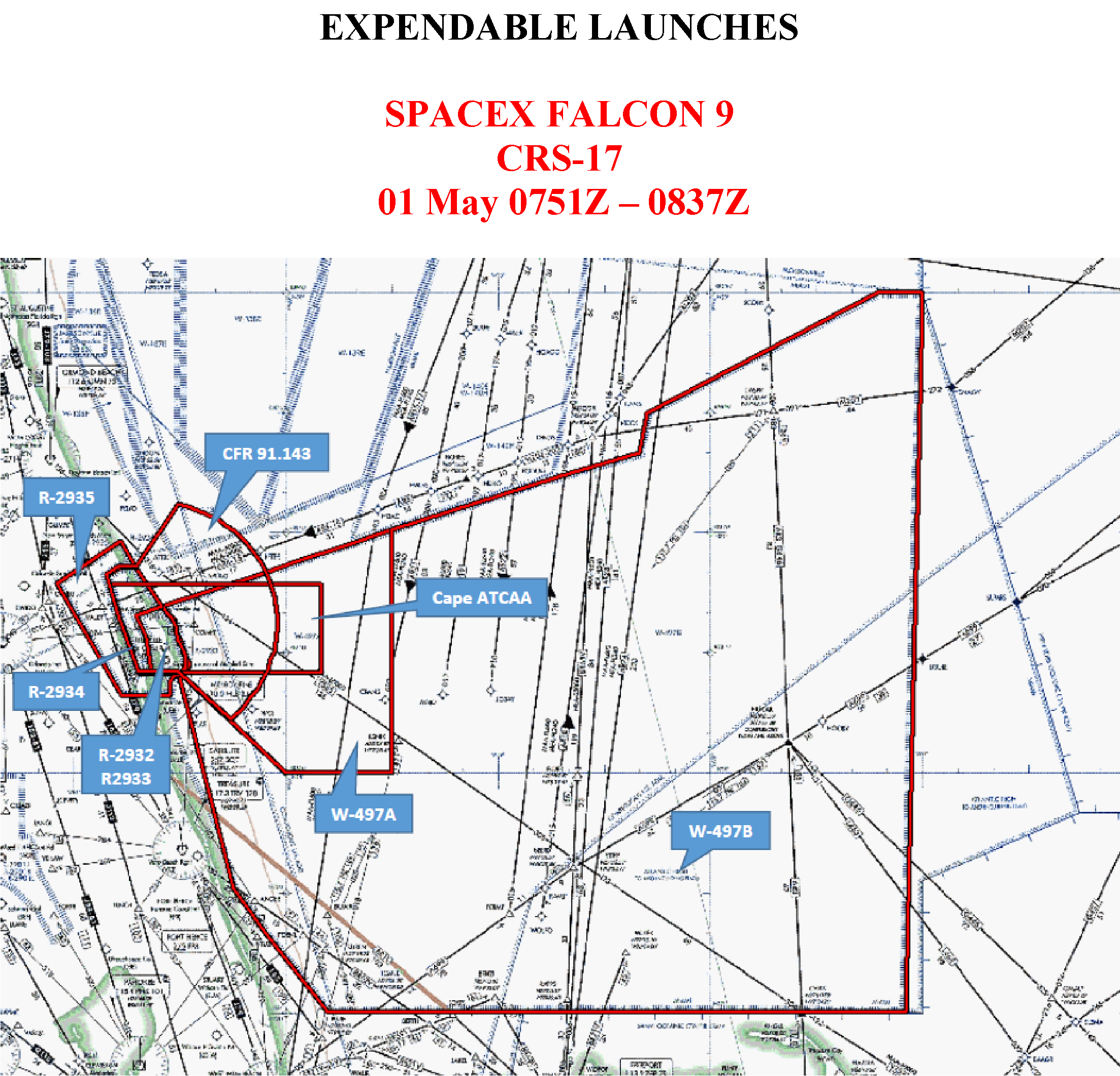
Airspace Closure Area (https://www.patrick.af.mil/Portals/14/ACA%20SpaceX%20Falcon%209%20CRS-17.pdf)
Название: Dragon SpX-17 (CRS-17), OCO-3, STP-H6 - Falcon 9-071 (B1056.1) - CCAFS SLC-40 - NET 25.04.2019, 10:20 UTC
Отправлено: tnt22 от 29.04.2019 23:38:54
Отправлено: tnt22 от 29.04.2019 23:38:54
Обновлена
Launch Hazard Area (https://www.patrick.af.mil/Portals/14/LHA%20SpaceX%20Falcon%209%20CRS-17_1.pdf)
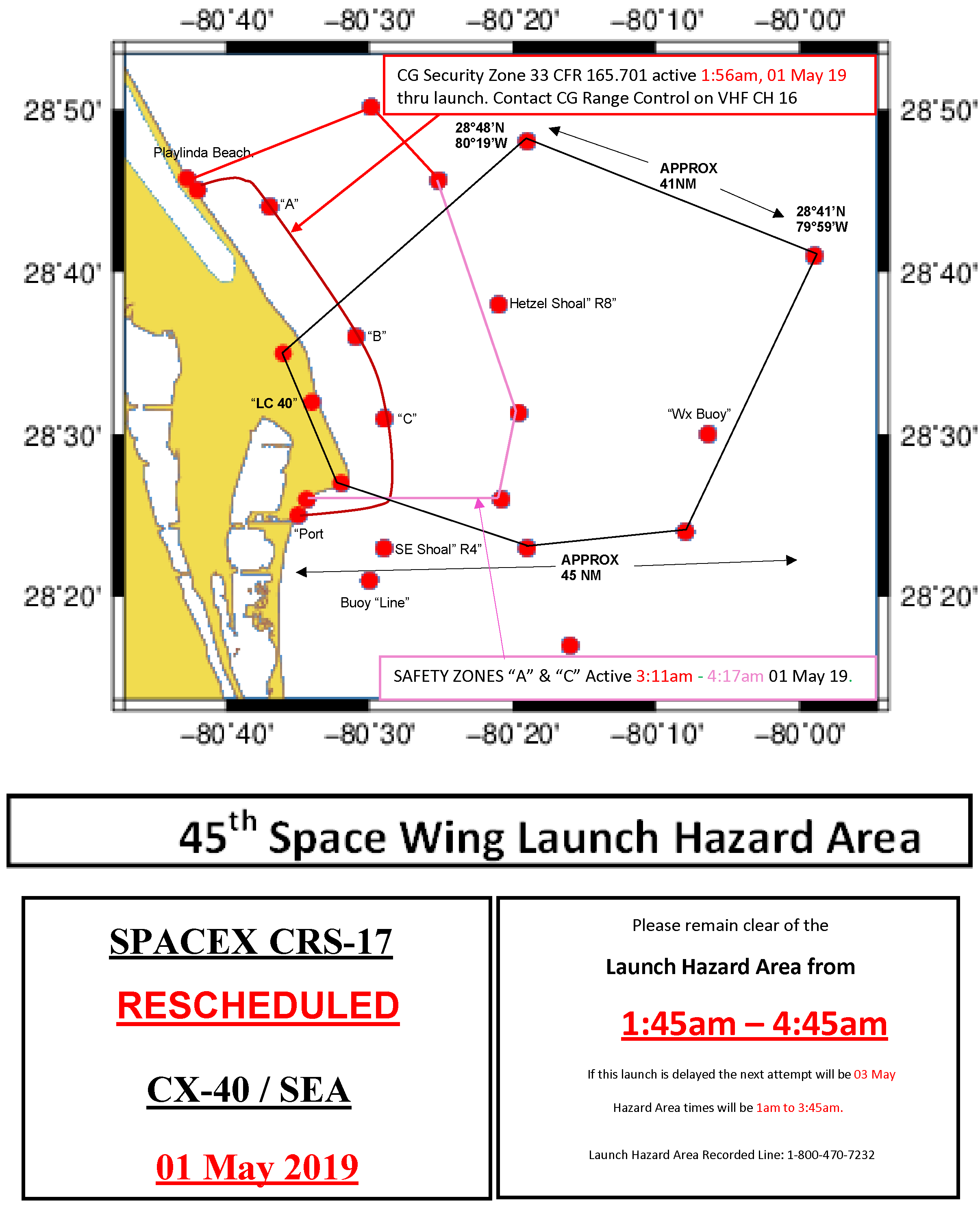
Launch Hazard Area (https://www.patrick.af.mil/Portals/14/LHA%20SpaceX%20Falcon%209%20CRS-17_1.pdf)
Название: Dragon SpX-17 (CRS-17), OCO-3, STP-H6 - Falcon 9-071 (B1056.1) - CCAFS SLC-40 - NET 25.04.2019, 10:20 UTC
Отправлено: tnt22 от 29.04.2019 23:40:56
Отправлено: tnt22 от 29.04.2019 23:40:56
Цитировать04/29/2019 23:37 Stephen Clark
NASA managers are discussing whether an issue in the International Space Station's electrical power system detected Monday could impact Wednesday's scheduled launch of a SpaceX Dragon cargo capsule to deliver food and experiments to the orbiting research complex.
Mission control in Houston have been studying the electrical system issue since Monday morning, NASA said in a statement.
"Monday morning, teams identified an issue with the International Space Station's electrical power system and are working to identify the root cause and restore full power to the system," the space agency said in an upd ated posted on its website. "There are no immediate concerns for the crew or the station."
In the update posted Monday afternoon, officials said engineers were examining an unspecified issue with a Main Bus Switching Unit, which distributes electricity generated by the space station's solar panels to key systems on-board the outpost.
The suspect unit under evaluation distributes power to two of eight power channels on the space station.
"Flight controllers have been working to route power through the remaining six power channels," NASA said. "Electrical power generated by the station's solar arrays is fed to all station systems through these power channels. Discussions are underway to determine any impacts to SpaceX's CRS-17 cargo resupply mission targeted for launch May 1."
Assuming the launch from Cape Canaveral is cleared for takeoff Wednesday, the Dragon cargo capsule is scheduled to arrive at the station early Saturday.
A launch readiness review is se t for Tuesday morning for SpaceX and NASA officials to discuss the status of the Falcon 9 rocket, Dragon cargo craft, the space station and ground systems ahead of final preflight preparations.
Название: Dragon SpX-17 (CRS-17), OCO-3, STP-H6 - Falcon 9-071 (B1056.1) - CCAFS SLC-40 - NET 25.04.2019, 10:20 UTC
Отправлено: tnt22 от 30.04.2019 05:01:45
Отправлено: tnt22 от 30.04.2019 05:01:45
Перенос не ранее чем на пятницу
Цитировать04/30/2019 04:28 Stephen Clark
The launch of SpaceX's next cargo resupply mission to the International Space Station is expected to be rescheduled for no earlier than Friday morning, according to multiple sources.
The delay will allow time for NASA flight controllers in Houston to continue troubleshooting an issue with a distribution box in the space station's electrical power system. Engineers detected an issue with the Main Bus Switching Unit on Monday morning, and ground teams may elect to replace the component later this week, ahead of the SpaceX cargo launch.
The unit is one of several that routes power from the space station's U.S. solar arrays to the research outpost's electrical channels. The suspect unit distributes power to two of the eight electrical channels on the station.
Ground teams have replaced a failed Main Bus Switching Unit using the station's robotic arm before, eliminating the need for astronauts to conduct the work on a spacewalk.
Название: Dragon SpX-17 (CRS-17), OCO-3, STP-H6 - Falcon 9-071 (B1056.1) - CCAFS SLC-40 - NET 25.04.2019, 10:20 UTC
Отправлено: tnt22 от 30.04.2019 05:03:28
Отправлено: tnt22 от 30.04.2019 05:03:28
ЦитироватьMichael Baylor @nextspaceflight (https://twitter.com/nextspaceflight) 15 мин. назад (https://twitter.com/nextspaceflight/status/1123041045418213376)
#CRS17 (https://twitter.com/hashtag/CRS17?src=hash) is slipping to May 3rd due to issues with the power systems on the International Space Station. According to predictions via the GoISSWatch app, the T-0 should be around 3:12 local time (7:12 UTC). #SpaceX (https://twitter.com/hashtag/SpaceX?src=hash)
Название: Dragon SpX-17 (CRS-17), OCO-3, STP-H6 - Falcon 9-071 (B1056.1) - CCAFS SLC-40 - NET 25.04.2019, 10:20 UTC
Отправлено: tnt22 от 30.04.2019 08:52:56
Отправлено: tnt22 от 30.04.2019 08:52:56
https://www.cbsnews.com/news/space-station-power-glitch-spacex-launch-preps/
ЦитироватьSpace station power glitch could delay SpaceX launch plans
BY WILLIAM HARWOOD
APRIL 29, 2019 / 6:20 PM / CBS NEWS
An electrical distribution unit aboard the International Space Station malfunctioned Monday, taking down two of the lab's eight power channels. The crew is in no danger while engineers troubleshoot the problem, officials said, but if it can't be resolved, the electrical box in question might have to be replaced with a spare, possibly prompting NASA to delay launch of a SpaceX Dragon supply ship Wednesday.
Assuming an on-time launch atop a Falcon 9 rocket, the Dragon cargo capsule, loaded with nearly 5,500 pounds of equipment and supplies, is expected to catch up with the station early Friday and then stand by while the lab's robot arm locks on and pulls it in for berthing.
The Canadian-built robot arm can be operated with a single power source, but NASA flight rules require two for redundancy. As it turns out, one of the two power circuits supporting arm operations was knocked out by the main bus switching unit problem that cropped up Monday.
During a 2012 spacewalk, Sunita Williams, seen here, and Aki Hoshide, out of view, completed installation of a replacement main bus switching unit, or MBSU, one of which is visible at lower right. Four MBSUs distribute electrical power from the station's solar arrays through eight power channels. An MBSU malfunctioned Monday, taking down two of those channels. Engineers are studying how to re-route that power in the near term. Spares are available if the MBSU has to be replaced.
NASA
A NASA official said power from the two channels fed by the main bus switching unit, or MBSU, could be re-routed using jumpers, but it was not clear whether that included power to the robot arm. NASA flight rules require redundant power for robot arm operations. If secondary power to the arm cannot somehow be re-routed or otherwise restored, and if the flight rule remains in force, the Dragon launch presumably would be delayed until after the MBSU could be replaced, either robotically or during a spacewalk.
The space station's primary solar power system consists of four rotating solar wings, two on the right side of the outpost's pressurized modules and two on the left. Four MBSU's, mounted in the center of the station's solar array truss, distribute power from the arrays downstream to various electrical circuits. The MBSU that malfunctioned took down power channels 3A and 3B. The system was designed so channels can be "cross tied" as needed to work around failures.
In 2017, an MBSU powering channels 2A and 2B suffered a malfunction, prompting flight controllers to replace it using the station's robot arm. Another MBSU was replaced during two spacewalks in 2012.
First published on April 29, 2019 / 6:20 PM
© 2019 CBS Interactive Inc. All Rights Reserved.
Название: Dragon SpX-17 (CRS-17), OCO-3, STP-H6 - Falcon 9-071 (B1056.1) - CCAFS SLC-40 - NET 25.04.2019, 10:20 UTC
Отправлено: tnt22 от 30.04.2019 16:44:44
Отправлено: tnt22 от 30.04.2019 16:44:44
https://ria.ru/20190430/1553173719.html
ЦитироватьЗапуск корабля Dragon перенесли на 3 мая, сообщил источник
10:30
МОСКВА, 30 апр - РИА Новости. Запуск грузового корабля Dragon перенесен с 1 на 3 мая вследствие проблем с системой электропитания американского сегмента МКС, сообщил РИА Новости во вторник источник в ракетно-космической отрасли.
В понедельник НАСА сообщило, что в системе электропитания американского сегмента МКС отказал блок подключения электропитания MBSU, в результате чего отключились два из восьми каналов электропитания. Специалисты перераспределяют электропитание через шесть работоспособных каналов.Цитировать"Запуск корабля Dragon отложен с 1 на 3 мая. Это даст специалистам НАСА дополнительное время, чтобы разобраться с проблемой в системе электропитания", - сказал собеседник агентства.Спойлер
В настоящее время на борту МКС находится экипаж из россиян Олега Кононенко и Алексея Овчинина, американцев Энн Макклейн, Ника Хейга и Кристины Кук, а также канадца Давида Сен-Жака.[свернуть]
Название: Dragon SpX-17 (CRS-17), OCO-3, STP-H6 - Falcon 9-071 (B1056.1) - CCAFS SLC-40 - NET 25.04.2019, 10:20 UTC
Отправлено: tnt22 от 30.04.2019 16:51:24
Отправлено: tnt22 от 30.04.2019 16:51:24
Прогноз погоды L-2 (пуск 3 мая)
L-2 Forecast 3 May Launch (https://www.patrick.af.mil/Portals/14/Weather/L-2%20Forecast%203%20May%2019%20Launch.pdf?ver=2019-04-30-090154-463)
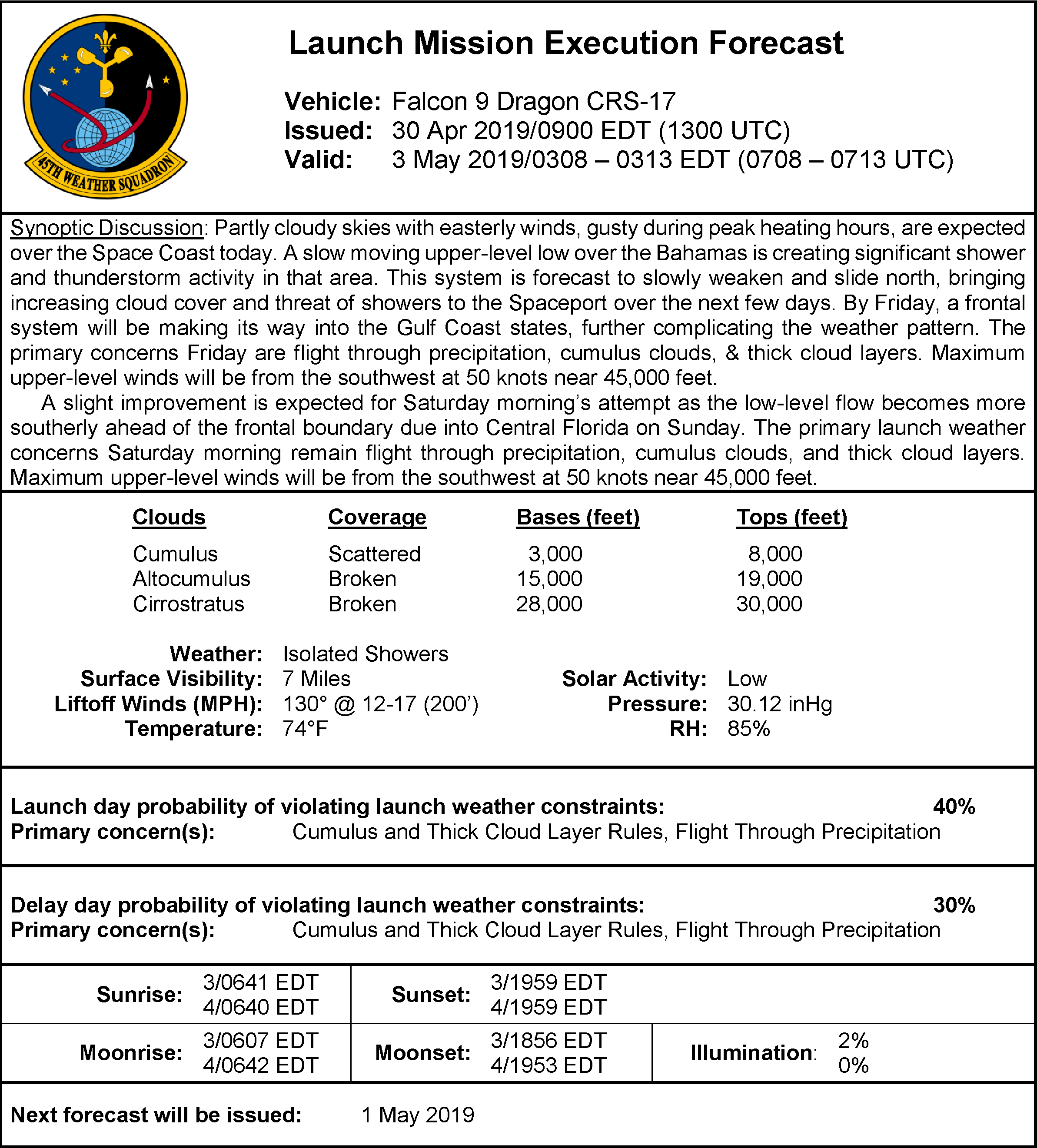
Пусковой день (03.05) - 60 % GO
Резервный день (04.05) - 70 % GO
L-2 Forecast 3 May Launch (https://www.patrick.af.mil/Portals/14/Weather/L-2%20Forecast%203%20May%2019%20Launch.pdf?ver=2019-04-30-090154-463)
Пусковой день (03.05) - 60 % GO
Резервный день (04.05) - 70 % GO
Название: Dragon SpX-17 (CRS-17), OCO-3, STP-H6 - Falcon 9-071 (B1056.1) - CCAFS SLC-40 - NET 25.04.2019, 10:20 UTC
Отправлено: tnt22 от 30.04.2019 16:52:35
Отправлено: tnt22 от 30.04.2019 16:52:35
Цитировать04/30/2019 16:36 Stephen Clark
Increasing cloud cover and rain chances over Florida's Space Coast are forecast later this week, and the official weather outlook for a possible Falcon 9 launch attempt early Friday calls for 60 percent probability for acceptable conditions at Cape Canaveral.
"Partly cloudy skies with easterly winds, gusty during peak heating hours, are expected over the Space Coast today," the Air Force's 45th Weather Squadron wrote in a forecast issued this morning. "A slow moving upper-level low over the Bahamas is creating significant shower and thunderstorm activity in that area. This system is forecast to slowly weaken and slide north, bringing increasing cloud cover and threat of showers to the spaceport over the next few days."
Mostly cloudy skies and isolated rain showers are forecast to be in the area at Friday's launch time of 3:11 a.m. EDT (0711 GMT).
"By Friday, a frontal system will be making its way into the Gulf Coast states, further complicating the weather pattern. The primary concerns Friday are flight through precipitation, cumulus clouds, and thick cloud layers. Maximum upper-level winds will be from the southwest at 50 knots near 45,000 feet."
Surface winds will be from the southeast at 12 to 17 mph, and the temperature at launch time will be around 74 degrees Fahrenheit.
Название: Dragon SpX-17 (CRS-17), OCO-3, STP-H6 - Falcon 9-071 (B1056.1) - CCAFS SLC-40 - NET 25.04.2019, 10:20 UTC
Отправлено: tnt22 от 30.04.2019 16:55:24
Отправлено: tnt22 от 30.04.2019 16:55:24
ЦитироватьChris B - NSF @NASASpaceflight (https://twitter.com/NASASpaceflight) 5 мин. назад (https://twitter.com/NASASpaceflight/status/1123222255713103872)
ARTICLE:
Electrical issue on Station delays Dragon launch -
https://www.nasaspaceflight.com/2019/04/electrical-issue-station-dragon-crs-17/ ... (https://t.co/Pw8geLDYGu)
Warning, technical - so expect a bowl of acronym soup.
Название: Dragon SpX-17 (CRS-17), OCO-3, STP-H6 - Falcon 9-071 (B1056.1) - CCAFS SLC-40 - NET 25.04.2019, 10:20 UTC
Отправлено: tnt22 от 30.04.2019 19:14:05
Отправлено: tnt22 от 30.04.2019 19:14:05
https://blogs.nasa.gov/spacestation/2019/04/30/dragon-cargo-mission-launch-no-earlier-than-may-3/
ЦитироватьDragon Cargo Mission Launch No Earlier than May 3
Mark Garcia (https://blogs.nasa.gov/spacestation/author/magarcia/)
Posted Apr 30, 2019 at 11:23 am(https://flic.kr/p/QoSioE)
The International Space Station was pictured by an Expedition 56 crewmember aboard a departing Soyuz crew ship on Oct. 4, 2018.
NASA has requested SpaceX move off from May 1 for the launch of the company's 17th commercial resupply mission to the International Space Station.
On April 29, the space station team identified an issue with one of the station's Main Bus Switching Units that distributes power to two of the eight power channels on the station. There are no immediate concerns for the crew or the station. Teams are working on a plan to robotically replace the failed unit and restore full power to the station system. Additional information will be provided as it becomes available. The earliest possible launch opportunity is no earlier than Friday, May 3.
Название: Dragon SpX-17 (CRS-17), OCO-3, STP-H6 - Falcon 9-071 (B1056.1) - CCAFS SLC-40 - NET 25.04.2019, 10:20 UTC
Отправлено: tnt22 от 30.04.2019 19:33:26
Отправлено: tnt22 от 30.04.2019 19:33:26
ЦитироватьRaul @Raul74Cz (https://twitter.com/Raul74Cz) 4 ч. назад (https://twitter.com/Raul74Cz/status/1123203399695179777)
Launch Hazard Areas for #SpaceX (https://twitter.com/hashtag/SpaceX?src=hash) #CRS (https://twitter.com/hashtag/CRS?src=hash)-17 mission according NOTMAR/NOTAMs, including B1056 droneship landing 20km offshore. Stage2 Reentry Debris Area south of Australia on the first orbit. https://goo.gl/HXcS8Q (https://t.co/GDVgqX2Y0Y)
Название: Dragon SpX-17 (CRS-17), OCO-3, STP-H6 - Falcon 9-071 (B1056.1) - CCAFS SLC-40 - NET 25.04.2019, 10:20 UTC
Отправлено: tnt22 от 30.04.2019 19:59:22
Отправлено: tnt22 от 30.04.2019 19:59:22
https://blogs.nasa.gov/spacex/2019/04/30/spacex-crs-17-launch-no-earlier-than-friday-may-3/
https://blogs.nasa.gov/kennedy/2019/04/30/spacex-crs-17-launch-no-earlier-than-friday-may-3/
https://blogs.nasa.gov/kennedy/2019/04/30/spacex-crs-17-launch-no-earlier-than-friday-may-3/
ЦитироватьSpaceX CRS-17 Launch No Earlier Than Friday, May 3
James Cawley (https://blogs.nasa.gov/spacex/author/jjcawley/)
Posted Apr 30, 2019 at 11:49 am(https://blogs.nasa.gov/spacex/wp-content/uploads/sites/227/2019/04/CRS-17-mission-patch-graphic.png)
CRS-17 is SpaceX's 17th Commercial Resupply Services Mission to the International Space Station. It will launch from from Space Launch Complex 40 at Cape Canaveral Air Force Station no earlier than Friday, May 3. Photo credit: SpaceX image
NASA has requested SpaceX move off from May 1 for the launch of the company's 17th commercial resupply mission to the International Space Station.
On April 29, the space station team identified an issue with one of the station's Main Bus Switching Units that distributes power to two of the eight power channels on the station. There are no immediate concerns for the crew or the station. Teams are working on a plan to robotically replace the failed unit and restore full power to the station system. Additional information will be provided as it becomes available. The earliest possible launch opportunity is no earlier than Friday, May 3.
Название: Dragon SpX-17 (CRS-17), OCO-3, STP-H6 - Falcon 9-071 (B1056.1) - CCAFS SLC-40 - NET 25.04.2019, 10:20 UTC
Отправлено: tnt22 от 30.04.2019 20:07:27
Отправлено: tnt22 от 30.04.2019 20:07:27
https://spaceflightnow.com/2019/04/30/spacex-resupply-launch-delayed-by-malfunction-on-space-station/
ЦитироватьSpaceX resupply launch delayed by malfunction on space station
April 30, 2019 (https://spaceflightnow.com/2019/04/) | Stephen Clark (https://spaceflightnow.com/author/stephen-clark/)
EDITOR'S NOTE: Updated at 12 p.m. EDT (1600 GMT) with NASA's confirmation of the delay.
A portion of a solar array wing on the International Space Station is visible in this image. Credit: NASA
A SpaceX Dragon supply ship packed with nearly three tons of experiments, crew provisions and supplies will remain on the ground until at least Friday morning to allow more time for NASA flight controllers to troubleshoot a problem with an electrical distribution unit on the International Space Station.
Multiple sources said Monday that the commercial resupply launch from Cape Canaveral, previously scheduled for Wednesday, will be pushed back at least two days to no earlier than Friday at 3:11 a.m. EDT (0711 GMT).
NASA confirmed the launch delay Tuesday.
The delay will allow time for NASA flight controllers at the Johnson Space Center in Houston to continue troubleshooting an issue with a distribution box in the space station's electrical power system. Engineers detected an issue with the Main Bus Switching Unit on Monday morning, and ground teams plan to replace the component later this week, ahead of the SpaceX cargo launch.
"Teams are working on a plan to robotically replace the failed unit and restore full power to the station system," NASA said in a statement Tuesday. "The earliest possible launch opportunity is no earlier than Friday, May 3."
The Main Bus Distribution Unit is one of several that routes power from the space station's U.S. solar arrays to the research outpost's electrical channels. The suspect unit distributes power to two of the eight electrical channels on the station, including a power supply for the space station's robotic arm, which the station astronauts will use to capture the Dragon cargo craft as it approaches the complex.
While the robotic arm remains powered through a separate channel, NASA flight rules require redundant power supplies for the arm during critical operations, such as the grapple of a free-flying spacecraft.
Ground teams have replaced a failed Main Bus Switching Unit using the station's robotic arm before. The capability to robotically replace the power distribution box means astronauts will not have to conduct a spacewalk for the task.
The electrical system glitch does not pose any immediate concern to the station or its six-person crew, NASA said.
NASA's Orbiting Carbon Observatory-3 (OCO-3) and the U.S. military's Space Test Program-Houston 6 (STP-H6) payloads are in view installed in the trunk of SpaceX's Dragon spacecraft inside the SpaceX facility at NASA's Kennedy Space Center in Florida on March 23, 2019. Credit: NASA
"Flight controllers have been working to route power through the remaining six power channels," NASA said in a previous statement released Monday. "Electrical power generated by the station's solar arrays is fed to all station systems through these power channels."
If the Dragon spacecraft had launched Wednesday, it was due to arrive at the station early Saturday. Assuming a launch from Cape Canaveral on Friday morning, the Dragon cargo freighter is scheduled to reach the complex early Sunday.
Forecasters with the U.S. Air Force's 45th Weather Squadron predict a 60 percent chance of favorable conditions for Friday's predawn launch opportunity, which is timed for when the space station's orbital plane passes over Cape Canaveral.
An outlook issued Tuesday identified concerns that weather at Cape Canaveral could violate weather rules relating to cumulus clouds, thick clouds and flight through precipitation.
Название: Dragon SpX-17 (CRS-17), OCO-3, STP-H6 - Falcon 9-071 (B1056.1) - CCAFS SLC-40 - NET 25.04.2019, 10:20 UTC
Отправлено: tnt22 от 30.04.2019 20:27:07
Отправлено: tnt22 от 30.04.2019 20:27:07
ЦитироватьJeff Foust @jeff_foust (https://twitter.com/jeff_foust) 3 мин. назад (https://twitter.com/jeff_foust/status/1123276599506477056)
Gerst: planning robotic changeout of faulty main bus switching unit on ISS on Thursday. If successful, move ahead with SpaceX Dragon cargo launch on Friday.
Название: Dragon SpX-17 (CRS-17), OCO-3, STP-H6 - Falcon 9-071 (B1056.1) - CCAFS SLC-40 - NET 25.04.2019, 10:20 UTC
Отправлено: tnt22 от 30.04.2019 20:39:17
Отправлено: tnt22 от 30.04.2019 20:39:17
Новое расписание трансляций НАСА (SpX-17)
https://www.nasa.gov/multimedia/nasatv/schedule.html
https://www.nasa.gov/multimedia/nasatv/schedule.html
ЦитироватьNASA Television Upcoming EventsUTC = EDT + 4 h (ДМВ = EDT + 7 h)
Watch NASA TV (https://www.nasa.gov/multimedia/nasatv/index.html#public)
All times Eastern
May 3, Friday
2:45 a.m. – Coverage of the launch of the SpaceX CRS-17 Dragon Cargo Craft Mission to the nternational Space Station; launch is scheduled at 3:11 a.m. ET (All Channels)
4:30 a.m. – SpaceX CRS-17 Post-Launch News Conference (time subject to change) (All Channels)
May 5, Sunday
5 a.m. - Coverage of the rendezvous and capture of the SpaceX CRS-17 Dragon Cargo Craft at the International Space Station; capture scheduled at 6:45 a.m. ET (All Channels)
9 a.m. - Coverage of the installation of the SpaceX CRS-17 Dragon Cargo Craft to the International Space Station (All Channels)
Название: Dragon SpX-17 (CRS-17), OCO-3, STP-H6 - Falcon 9-071 (B1056.1) - CCAFS SLC-40 - NET 25.04.2019, 10:20 UTC
Отправлено: tnt22 от 30.04.2019 20:57:37
Отправлено: tnt22 от 30.04.2019 20:57:37
https://tass.ru/kosmos/6394209
Цитировать30 АПР, 19:43https://tass.ru/kosmos/6394385
Запуск корабля Dragon с грузом для МКС состоится не ранее 3 мая
Его перенесли из-за неполадок энергооборудования Международной космической станции
НЬЮ-ЙОРК, 30 апреля. /ТАСС/. Запуск ракеты-носителя Falcon-9 американской компании SpaceX с кораблем Dragon и грузом для экипажа МКС перенесен из-за неполадок энергооборудования станции и состоится не ранее 3 мая. Об этом говорится в заявлении, размещенном во вторник на сайте (https://blogs.nasa.gov/spacestation/2019/04/30/dragon-cargo-mission-launch-no-earlier-than-may-3/) NASA.
"NASA запросило SpaceX перенести с 1 мая запуск 17-й коммерческой миссии по пополнению запасов на Международной космической станции", - говорится в документе. Согласно опубликованным данным, 29 апреля на МКС были обнаружены неполадки в энергооборудовании. Астронавты, находящиеся на станции, работают над их устранением. "Ближайшая возможная дата запуска [предвидится] не ранее пятницы, 3 мая", - сообщили в NASA.Спойлер
Ранее сообщалось о том, что в американской части Международной космической станции была выявлена поломка, не сказавшаяся на работе российского сегмента. "На американском сегменте МКС были зафиксированы некоторые проблемы с энергоснабжением. Поломка не сказалась на работе российского сегмента МКС. Все системы работают штатно", - отметили в госкорпорации Роскосмос.
В последний раз запуск Dragon к МКС осуществлялся 5 декабря прошлого года. Он доставил на станцию свыше 2,5 тонны грузов, в том числе продовольствие, материалы для исследований и приборы, предназначенные для изучения явлений в атмосфере Земли. 14 января корабль вернулся на Землю, доставив с МКС результаты научных экспериментов. Он приводнился в Тихом океане у южного побережья штата Калифорния, причем это впервые произошло в темное время суток.[свернуть]
Цитировать30 АПР, 20:47
В NASA назвали причину отсрочки запуска корабля Dragon к МКС
Это обусловлено неполадкой в блоке питания на Международной космической станции, отметили в Национальном управлении по аэронавтике и исследованию космического пространства США
НЬЮ-ЙОРК, 30 апреля. /ТАСС/. Перенос запуска ракеты-носителя Falcon-9 с космическим кораблем Dragon и грузом для экипажа Международной космической станции (МКС) на более поздний срок обусловлен неполадками в системе энергообеспечения американского сегмента МКС. Об этом сообщается во вторник на сайте (https://www.nasa.gov/) Национального управления по аэронавтике и исследованию космического пространства США (NASA).
"Команда, отвечающая за космическую станцию, 29 апреля выявила проблему с одним коммутационным блоком, распределяющим электроэнергию на две из восьми энерголиний станции. Оснований для тревоги за экипаж или станцию не имеется. Команды работают над планом, предусматривающим замену неисправного элемента с помощью робота и полное возобновление подачи электроэнергии в систему станции", - пояснило космическое ведомство США.
Ранее NASA объявило о третьей по счету отсрочке запуска Dragon к МКС. Теперь ориентировочное время старта ракеты Falcon-9 с пускового комплекса базы ВВС США на мысе Канаверал (штат Флорида) - 3 мая в 03:11 по времени Восточного побережья США (10:11 мск).Спойлер
Сейчас в составе экипажа МКС работают российские космонавты Олег Кононенко и Алексей Овчинин, астронавты Энн Макклейн, Кристина Кох, Ник Хейг (все трое - NASA) и Давид Сен-Жак (Канадское космическое агентство).[свернуть]
Название: Dragon SpX-17 (CRS-17), OCO-3, STP-H6 - Falcon 9-071 (B1056.1) - CCAFS SLC-40 - NET 25.04.2019, 10:20 UTC
Отправлено: tnt22 от 01.05.2019 11:07:29
Отправлено: tnt22 от 01.05.2019 11:07:29
Из переписки
Цитироватьyg1968 @yag1968 (https://twitter.com/yag1968) 8 ч. назад (https://twitter.com/yag1968/status/1123370904380219392)
В ответ @jeff_foust (https://twitter.com/jeff_foust)
Jeff, do we know when the CRS-17 pre-launch press conference will be?Jeff Foust @jeff_foust (https://twitter.com/jeff_foust) 8 ч. назад (https://twitter.com/jeff_foust/status/1123371842394296321)
No earlier than Thursday.
Название: Dragon SpX-17 (CRS-17), OCO-3, STP-H6 - Falcon 9-071 (B1056.1) - CCAFS SLC-40 - NET 25.04.2019, 10:20 UTC
Отправлено: tnt22 от 01.05.2019 18:15:32
Отправлено: tnt22 от 01.05.2019 18:15:32
https://blogs.nasa.gov/stationreport/2019/04/30/iss-daily-summary-report-4302019/
ЦитироватьISS Daily Summary Report – 4/30/2019
SpaceX (SpX)-17 Launch/Berthing Status:
Due to yesterday's MBSU 3 failure, SpX-17 launch is scheduled for May 3 with capture and berthing on May 5.
Название: Dragon SpX-17 (CRS-17), OCO-3, STP-H6 - Falcon 9-071 (B1056.1) - CCAFS SLC-40 - NET 25.04.2019, 10:20 UTC
Отправлено: tnt22 от 01.05.2019 19:54:58
Отправлено: tnt22 от 01.05.2019 19:54:58
Прогноз погоды L-1 (пуск 3 мая)
L-1 Forecast 3 May Launch (https://www.patrick.af.mil/Portals/14/Weather/L-1%20Forecast%203%20May%2019%20Launch.pdf?ver=2019-05-01-105537-050)
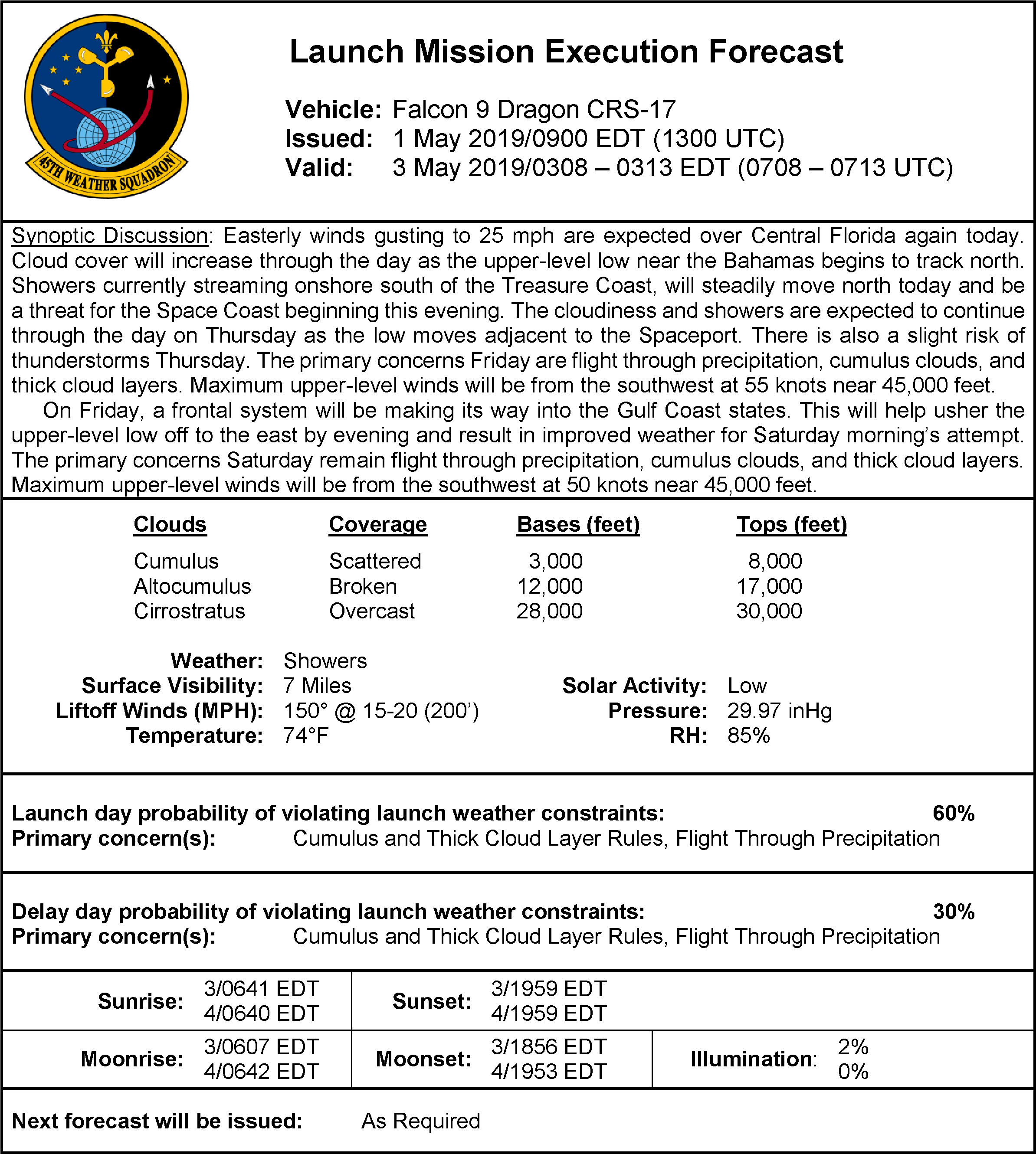
Пусковой день (03.05) - ↓ 40 % GO
Резервный день (04.05) - = 70 % GO
L-1 Forecast 3 May Launch (https://www.patrick.af.mil/Portals/14/Weather/L-1%20Forecast%203%20May%2019%20Launch.pdf?ver=2019-05-01-105537-050)
Пусковой день (03.05) - ↓ 40 % GO
Резервный день (04.05) - = 70 % GO
Название: Dragon SpX-17 (CRS-17), OCO-3, STP-H6 - Falcon 9-071 (B1056.1) - CCAFS SLC-40 - NET 25.04.2019, 10:20 UTC
Отправлено: tnt22 от 01.05.2019 19:56:55
Отправлено: tnt22 от 01.05.2019 19:56:55
Цитировать05/01/2019 19:34 Stephen Clark
The weather forecast for SpaceX's next Falcon 9 launch opportunity has worsened, with meteorologists at the Air Force's 45th Weather Squadron now predicting a 60 percent chance conditions will violate a launch weather rule.
Increasing cloudiness is expected over Florida's Space Coast today as a low pressure system over the Bahamas moves north.
"The cloudiness and showers are expected to continue through the day on Thursday as the low moves adjacent to the spaceport," forecasters wrote this morning. "There is also a slight risk of thunderstorms Thursday. The primary concerns Friday are flight through precipitation, cumulus clouds, and thick cloud layers. Maximum upper-level winds will be from the southwest at 55 knots near 45,000 feet."
Assuming the Falcon 9 rocket and Dragon cargo craft are cleared for liftoff, the launch is scheduled for 3:11 a.m. EDT (0711 GMT) Friday from Cape Canaveral's Complex 40 launch pad.
The Dragon supply ship is set to deliver several tons of experiments and provisions to the International Space Station and its six-person crew.
Ground controllers plan to replace a failed power distribution unit outside the station Thursday using the orbiting research lab's robotic arm. NASA asked SpaceX to delay the cargo launch from Wednesday to allow more time to address the power system failure, which cut off a quarter of the station's electricity supply.
Название: Dragon SpX-17 (CRS-17), OCO-3, STP-H6 - Falcon 9-071 (B1056.1) - CCAFS SLC-40 - NET 25.04.2019, 10:20 UTC
Отправлено: tnt22 от 01.05.2019 21:44:46
Отправлено: tnt22 от 01.05.2019 21:44:46
https://blogs.nasa.gov/spacestation/2019/05/01/astronauts-relax-today-before-robotics-work-and-dragon-cargo-mission/
ЦитироватьAstronauts Relax Today Before Robotics Work and Dragon Cargo Mission
Mark Garcia (https://blogs.nasa.gov/spacestation/author/magarcia/)
Posted May 1, 2019 at 1:26 pm
...
NASA (http://www.nasa.gov/) and SpaceX (http://www.nasa.gov/spacex) are pressing ahead to launch Dragon no earlier than Friday May 3 at 3:11 a.m. EDT to deliver nearly 5,500 pounds of science, supplies and hardware. Astronauts David Saint-Jacques (http://www.asc-csa.gc.ca/eng/astronauts/canadian/active/bio-david-saint-jacques.asp) and Nick Hague (https://www.nasa.gov/astronauts/biographies/tyler-nick-hague) will be in the cupola Sunday to command the Canadarm2 robotic arm (https://www.nasa.gov/mission_pages/station/structure/elements/mobile-servicing-system.html) to capture Dragon around 7 a.m.
Flight Engineers Anne McClain (https://www.nasa.gov/astronauts/biographies/anne-c-mcclain) and Christina Koch (https://www.nasa.gov/astronauts/biographies/christina-h-koch) will help unpack and activate the time critical experiments after Dragon is installed on the Harmony module. New lab mice will be quickly transferred and housed in specialized habitats for an immune system study (https://www.nasa.gov/mission_pages/station/research/experiments/explorer/Investigation.html?#id=7868). Fresh biological samples, such as kidney cells (https://www.nasa.gov/mission_pages/station/research/experiments/explorer/Investigation.html?#id=7819), will be also stowed in science freezers and incubators for later analysis.
Название: Dragon SpX-17 (CRS-17), OCO-3, STP-H6 - Falcon 9-071 (B1056.1) - CCAFS SLC-40 - NET 25.04.2019, 10:20 UTC
Отправлено: tnt22 от 01.05.2019 21:50:16
Отправлено: tnt22 от 01.05.2019 21:50:16
https://blogs.nasa.gov/spacex/2019/05/01/nasa-spacex-targeting-311-a-m-edt-for-crs-17-liftoff/
https://blogs.nasa.gov/kennedy/2019/05/01/crs-17-liftoff-no-earlier-than-friday-may-3-at-311-edt/
https://blogs.nasa.gov/kennedy/2019/05/01/crs-17-liftoff-no-earlier-than-friday-may-3-at-311-edt/
ЦитироватьCRS-17 Liftoff No Earlier Than Friday, May 3, at 3:11 EDT
James Cawley (https://blogs.nasa.gov/spacex/author/jjcawley/)
Posted May 1, 2019 at 1:53 pm
NASA and SpaceX are targeting no earlier than Friday, May 3, for the launch of the company's 17th commercial resupply mission to the International Space Station. Launch is scheduled for 3:11 a.m. EDT from Space Launch Complex 40 on Cape Canaveral Air Force Station in Florida.
On April 29, the space station team identified an issue with one of the station's Main Bus Switching Units (MBSU) that distributes power to two of the eight power channels on the station. There are no immediate concerns for the crew or the station.
Flight controllers are scheduled to perform a series of maneuvers to robotically swap the failed MSBU for a spare on Wednesday, May 1 and Thursday, May 2. After the swap is complete, flight controllers will conduct a series of checkouts on the newly installed MBSU and take steps to return the station to full power capability to support SpaceX capture and berthing.
Название: Dragon SpX-17 (CRS-17), OCO-3, STP-H6 - Falcon 9-071 (B1056.1) - CCAFS SLC-40 - NET 25.04.2019, 10:20 UTC
Отправлено: tnt22 от 01.05.2019 22:14:50
Отправлено: tnt22 от 01.05.2019 22:14:50
Расписание трансляций НАСА (SpX-17) - обновление от 01.05.2019
https://www.nasa.gov/multimedia/nasatv/schedule.html
https://www.nasa.gov/multimedia/nasatv/schedule.html
ЦитироватьNASA Television Upcoming Events
Watch NASA TV (https://www.nasa.gov/multimedia/nasatv/index.html#public)
All times Eastern
MAY
May 2, Thursday
11 a.m. – SpaceX CRS-17 Space Station Cargo Mission -- Pre-Launch News Conference (All Channels)
May 3, Friday
2:45 a.m. – Coverage of the launch of the SpaceX CRS-17 Dragon Cargo Craft Mission to the International Space Station; launch is scheduled at 3:11 a.m. ET (All Channels)
4:30 a.m. – SpaceX CRS-17 Post-Launch News Conference (time subject to change) (All Channels)
May 5, Sunday
5 a.m. - Coverage of the rendezvous and capture of the SpaceX CRS-17 Dragon Cargo Craft at the International Space Station; capture scheduled at 7 a.m. ET (All Channels)
9 a.m. - Coverage of the installation of the SpaceX CRS-17 Dragon Cargo Craft to the International Space Station (All Channels)
Название: Dragon SpX-17 (CRS-17), OCO-3, STP-H6 - Falcon 9-071 (B1056.1) - CCAFS SLC-40 - NET 25.04.2019, 10:20 UTC
Отправлено: tnt22 от 02.05.2019 17:44:06
Отправлено: tnt22 от 02.05.2019 17:44:06
https://blogs.nasa.gov/spacestation/2019/05/02/robotics-work-successful-station-returned-to-full-power/
ЦитироватьRobotics Work Successful, Station Returned to Full Power
Dan Huot (https://blogs.nasa.gov/spacestation/author/dhuot/)
Posted May 2, 2019 at 9:18 am
...
NASA's commercial cargo provider SpaceX is targeting 3:11 a.m. EDT on Friday, May 3, for the launch of its 17th resupply mission to the International Space Station (http://www.nasa.gov/station). Packed with more than 5,500 pounds of research, crew supplies and hardware, the SpaceX Dragon spacecraft will launch on a Falcon 9 rocket from Space Launch Complex 40 at Cape Canaveral Air Force Station.
Название: Dragon SpX-17 (CRS-17), OCO-3, STP-H6 - Falcon 9-071 (B1056.1) - CCAFS SLC-40 - NET 25.04.2019, 10:20 UTC
Отправлено: tnt22 от 02.05.2019 17:49:35
Отправлено: tnt22 от 02.05.2019 17:49:35
https://blogs.nasa.gov/spacex/2019/05/02/spacex-targeting-friday-may-3-at-311-a-m-for-crs-17-launch/
ЦитироватьSpaceX Targeting Friday, May 3, at 3:11 a.m. for CRS-17 Launch
James Cawley (https://blogs.nasa.gov/spacex/author/jjcawley/)
Posted May 2, 2019 at 9:27 am
NASA's commercial cargo provider SpaceX is targeting 3:11 a.m. EDT on Friday, May 3, for the launch of its 17th resupply mission to the International Space Station (http://www.nasa.gov/station). Packed with more than 5,500 pounds of research, crew supplies and hardware, the SpaceX Dragon spacecraft will launch on a Falcon 9 rocket from Space Launch Complex 40 at Cape Canaveral Air Force Station.(https://blogs.nasa.gov/spacex/wp-content/uploads/sites/227/2019/04/CRS-17-mission-patch-graphic.png)
CRS-17 is SpaceX's 17th Commercial Resupply Services Mission to the International Space Station. It is scheduled to launch from Space Launch Complex 40 at Cape Canaveral Air Force Station on Friday, May 3, at 3:11 a.m.
This morning, Robotics Ground Controllers in Mission Control Houston successfully completed an operation to remove a failed Main Bus Switching Unit-3 and replace it with a spare. The MBSU in question had failed on April 29 and reduced the station's power supply by about 25%. There were no immediate concerns for the crew or the station. The crew had installed a series of jumpers in Node 1 following the failure to reroute power to experiments and hardware and ensure limited impact to continued station operations.
The completion of the robotics work marks the second time an MBSU was swapped out by means other than a spacewalk. Since the successful replacement, the MBSU was powered up and checked out successfully with all station systems back to nominal power configuration, including redundant power to the Canadarm2 robotic arm.
NASA TV Coverage
Follow coverage of the SpaceX CRS-17 mission with prelaunch events on NASA Television and at www.nasa.gov/live (http://www.nasa.gov/live).[/li]
- 11 a.m. — Prelaunch news conference with representatives from NASA's International Space Station Program, SpaceX and the U.S. Air Force's 45th Space Wing
- 2:45 a.m. — Follow the countdown starting at 2:45 a.m. Friday on NASA Television,nasa.gov/live (http://www.nasa.gov/live) and on NASA's SpaceX Launch Blog (http://blogs.nasa.gov/spacex).
Название: Dragon SpX-17 (CRS-17), OCO-3, STP-H6 - Falcon 9-071 (B1056.1) - CCAFS SLC-40 - NET 25.04.2019, 10:20 UTC
Отправлено: tnt22 от 02.05.2019 17:58:27
Отправлено: tnt22 от 02.05.2019 17:58:27
Название: Dragon SpX-17 (CRS-17), OCO-3, STP-H6 - Falcon 9-071 (B1056.1) - CCAFS SLC-40 - NET 25.04.2019, 10:20 UTC
Отправлено: tnt22 от 02.05.2019 18:07:20
Отправлено: tnt22 от 02.05.2019 18:07:20
Название: Dragon SpX-17 (CRS-17), OCO-3, STP-H6 - Falcon 9-071 (B1056.1) - CCAFS SLC-40 - NET 25.04.2019, 10:20 UTC
Отправлено: tnt22 от 02.05.2019 18:07:26
Отправлено: tnt22 от 02.05.2019 18:07:26
Название: Dragon SpX-17 (CRS-17), OCO-3, STP-H6 - Falcon 9-071 (B1056.1) - CCAFS SLC-40 - NET 25.04.2019, 10:20 UTC
Отправлено: tnt22 от 02.05.2019 18:08:58
Отправлено: tnt22 от 02.05.2019 18:08:58
Название: Dragon SpX-17 (CRS-17), OCO-3, STP-H6 - Falcon 9-071 (B1056.1) - CCAFS SLC-40 - NET 25.04.2019, 10:20 UTC
Отправлено: tnt22 от 02.05.2019 18:09:33
Отправлено: tnt22 от 02.05.2019 18:09:33
ЦитироватьChris G - NSF @ChrisG_NSF (https://twitter.com/ChrisG_NSF) 6 мин. назад (https://twitter.com/ChrisG_NSF/status/1123965924455919617)
Closing parts of late load operations at the pad are underway. 1,700 kg of cargo for ISS loaded in Dragon. #SpaceX (https://twitter.com/hashtag/SpaceX?src=hash) #Falcon9 (https://twitter.com/hashtag/Falcon9?src=hash) #Dragon (https://twitter.com/hashtag/Dragon?src=hash) #CRS17 (https://twitter.com/hashtag/CRS17?src=hash)
Название: Dragon SpX-17 (CRS-17), OCO-3, STP-H6 - Falcon 9-071 (B1056.1) - CCAFS SLC-40 - NET 25.04.2019, 10:20 UTC
Отправлено: tnt22 от 02.05.2019 18:10:30
Отправлено: tnt22 от 02.05.2019 18:10:30
ЦитироватьChris G - NSF @ChrisG_NSF (https://twitter.com/ChrisG_NSF) 5 мин. назад (https://twitter.com/ChrisG_NSF/status/1123966522370744321)
Electrical switching unit on Station replaced overnight via robotics work. Operation went well. Station in good shape now to support CRS-17 launch.
Название: Dragon SpX-17 (CRS-17), OCO-3, STP-H6 - Falcon 9-071 (B1056.1) - CCAFS SLC-40 - NET 25.04.2019, 10:20 UTC
Отправлено: tnt22 от 02.05.2019 18:15:29
Отправлено: tnt22 от 02.05.2019 18:15:29
ЦитироватьChris G - NSF @ChrisG_NSF (https://twitter.com/ChrisG_NSF) 4 мин. назад (https://twitter.com/ChrisG_NSF/status/1123967105991368704)
NASA and SpaceX worked hard and quickly to confirm that this cargo Dragon poses no additional risk. Analysis came after Crew Dragon anomaly.Jeff Foust @jeff_foust (https://twitter.com/jeff_foust) 7 мин. назад (https://twitter.com/jeff_foust/status/1123967672633446402)
Hans Koenigsmann, SpaceX: just prior to testing the SuperDraco thrusters on the Crew Dragon, there was an anomaly, and the vehicle was destroyed.Chris G - NSF @ChrisG_NSF (https://twitter.com/ChrisG_NSF) 7 мин. назад (https://twitter.com/ChrisG_NSF/status/1123967696423522304)
Per Crew Dragon anomaly: Hans: "High amount of data was recorded. Too early to speculate on cause. Data indicates anomaly occurred during activation of SuperDraco. No reason at this point to believe there's an issue with SuperDraco themselves."Jeff Foust @jeff_foust (https://twitter.com/jeff_foust) 7 мин. назад (https://twitter.com/jeff_foust/status/1123967917677326336)
Koenigsmann: no cause yet for the anomaly, but initial data indicates the anomaly took place during the activation of the thrusters. No sign of an issue with the SuperDraco itself; high confidence with that particular thruster.
Название: Dragon SpX-17 (CRS-17), OCO-3, STP-H6 - Falcon 9-071 (B1056.1) - CCAFS SLC-40 - NET 25.04.2019, 10:20 UTC
Отправлено: tnt22 от 02.05.2019 18:17:23
Отправлено: tnt22 от 02.05.2019 18:17:23
Название: Dragon SpX-17 (CRS-17), OCO-3, STP-H6 - Falcon 9-071 (B1056.1) - CCAFS SLC-40 - NET 25.04.2019, 10:20 UTC
Отправлено: tnt22 от 02.05.2019 18:20:08
Отправлено: tnt22 от 02.05.2019 18:20:08
ЦитироватьChris G - NSF @ChrisG_NSF (https://twitter.com/ChrisG_NSF) 8 мин. назад (https://twitter.com/ChrisG_NSF/status/1123968188826435584)
If we need backup day, 02:48 EDT (0648 UTC) is the launch time for Saturday, 4 May.
Название: Dragon SpX-17 (CRS-17), OCO-3, STP-H6 - Falcon 9-071 (B1056.1) - CCAFS SLC-40 - NET 25.04.2019, 10:20 UTC
Отправлено: tnt22 от 02.05.2019 18:20:48
Отправлено: tnt22 от 02.05.2019 18:20:48
ЦитироватьChris G - NSF @ChrisG_NSF (https://twitter.com/ChrisG_NSF) 8 мин. назад (https://twitter.com/ChrisG_NSF/status/1123968615114584065)
Hans talking about how SpaceX loadS the 2nd Stage in a little less than 16 minutes... buT they empty it, if needed, in less time.
Название: Dragon SpX-17 (CRS-17), OCO-3, STP-H6 - Falcon 9-071 (B1056.1) - CCAFS SLC-40 - NET 25.04.2019, 10:20 UTC
Отправлено: tnt22 от 02.05.2019 18:21:53
Отправлено: tnt22 от 02.05.2019 18:21:53
ЦитироватьChris G - NSF @ChrisG_NSF (https://twitter.com/ChrisG_NSF) 6 мин. назад (https://twitter.com/ChrisG_NSF/status/1123969437600747520)
Orbital Carbon Observatory 2 (OCO-3) and Space Test Program - Houston 6 (STP-H6) are the two external ISS payloads being carried to orbit in Dragon's trunk. Dragon is 1 of only 2 crafts currently capable of taking external payloads to Station.
2 мин. назад (https://twitter.com/ChrisG_NSF/status/1123970458955788295)
The OCO-3 external experiment will be placed on @JAXA_en (https://twitter.com/JAXA_en)'s Kibo Lab's exposed facility. #SpaceX (https://twitter.com/hashtag/SpaceX?src=hash) #Falcon9 (https://twitter.com/hashtag/Falcon9?src=hash) #Dragon (https://twitter.com/hashtag/Dragon?src=hash) #CRS17 (https://twitter.com/hashtag/CRS17?src=hash)
Название: Dragon SpX-17 (CRS-17), OCO-3, STP-H6 - Falcon 9-071 (B1056.1) - CCAFS SLC-40 - NET 25.04.2019, 10:20 UTC
Отправлено: tnt22 от 02.05.2019 18:26:30
Отправлено: tnt22 от 02.05.2019 18:26:30
Название: Dragon SpX-17 (CRS-17), OCO-3, STP-H6 - Falcon 9-071 (B1056.1) - CCAFS SLC-40 - NET 25.04.2019, 10:20 UTC
Отправлено: tnt22 от 02.05.2019 18:27:29
Отправлено: tnt22 от 02.05.2019 18:27:29
ЦитироватьChris G - NSF @ChrisG_NSF (https://twitter.com/ChrisG_NSF) 3 мин. назад (https://twitter.com/ChrisG_NSF/status/1123971287938945026)
Launch weather. Area of disturbed weather over Bahamas is encroaching to Space Coast. Will be near area overnight tonight. Higher than usual shower chance. Moisture near record values. Lower chance of lightning
1 мин. назад (https://twitter.com/ChrisG_NSF/status/1123971789808373762)
Still a 60% NO GO chance for tonight (unchanged since yesterday). Backup opportunity on Saturday, 4 May carries just a 30% NO GO chance (again, no change from yesterday). #SpaceX (https://twitter.com/hashtag/SpaceX?src=hash) #Falcon9 (https://twitter.com/hashtag/Falcon9?src=hash) #Dragon (https://twitter.com/hashtag/Dragon?src=hash) #CRS17 (https://twitter.com/hashtag/CRS17?src=hash)
Название: Dragon SpX-17 (CRS-17), OCO-3, STP-H6 - Falcon 9-071 (B1056.1) - CCAFS SLC-40 - NET 25.04.2019, 10:20 UTC
Отправлено: tnt22 от 02.05.2019 18:32:27
Отправлено: tnt22 от 02.05.2019 18:32:27
Слева направо:
С. Янг, Стив Кларк (оба - Spaceflight Now (https://twitter.com/SpaceflightNow)), Крис Г (NASASpaceflight)
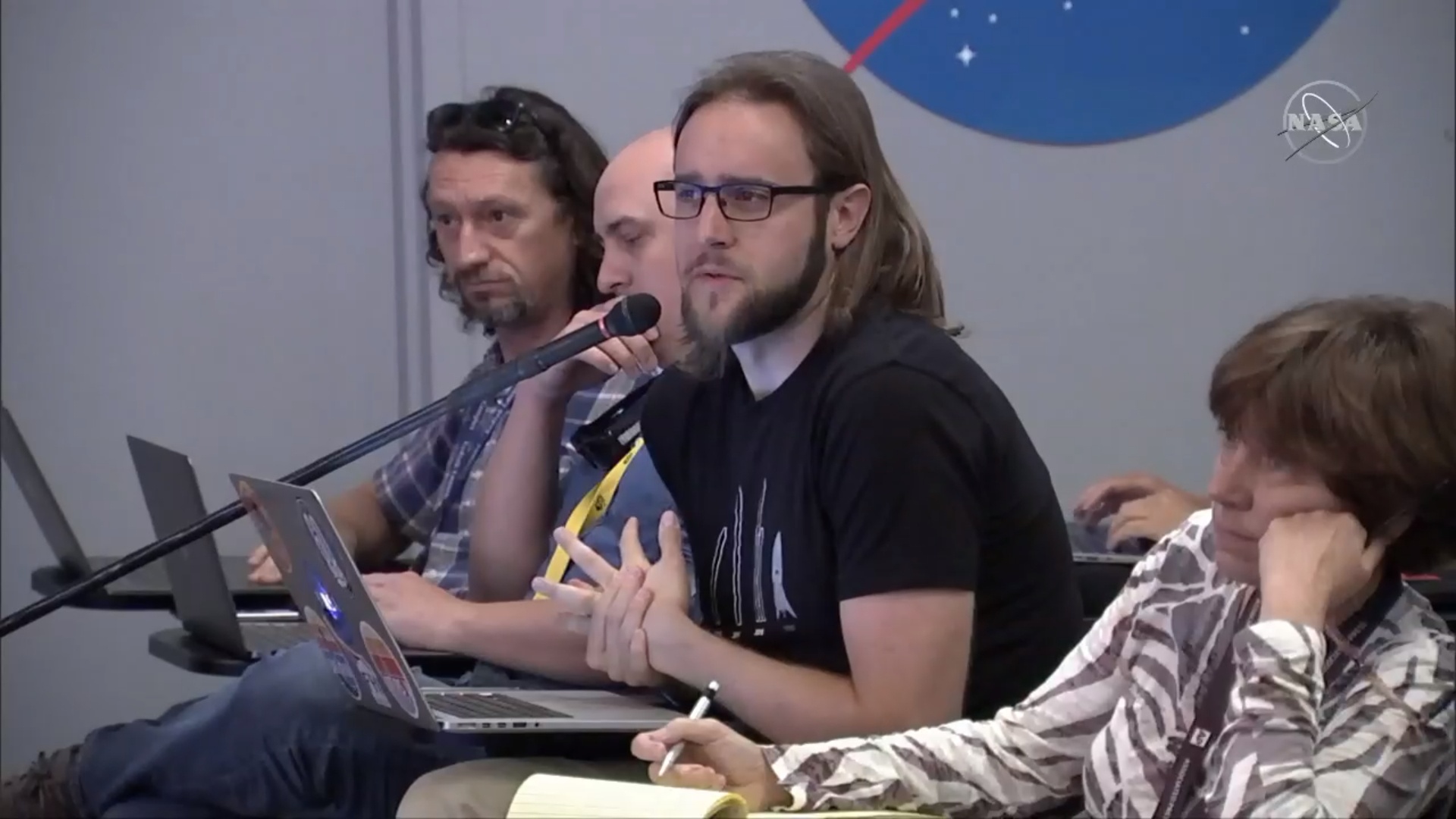
С. Янг, Стив Кларк (оба - Spaceflight Now (https://twitter.com/SpaceflightNow)), Крис Г (NASASpaceflight)
Название: Dragon SpX-17 (CRS-17), OCO-3, STP-H6 - Falcon 9-071 (B1056.1) - CCAFS SLC-40 - NET 25.04.2019, 10:20 UTC
Отправлено: tnt22 от 02.05.2019 18:33:41
Отправлено: tnt22 от 02.05.2019 18:33:41
ЦитироватьChris G - NSF @ChrisG_NSF (https://twitter.com/ChrisG_NSF) 2 мин. назад (https://twitter.com/ChrisG_NSF/status/1123973228895117313)
Precise launch time for 3 May is 03:11:33 EDT (0711.33 UTC). Could shift by a second or two based on day-off ISS position calculations.
Название: Dragon SpX-17 (CRS-17), OCO-3, STP-H6 - Falcon 9-071 (B1056.1) - CCAFS SLC-40 - NET 25.04.2019, 10:20 UTC
Отправлено: tnt22 от 02.05.2019 18:36:23
Отправлено: tnt22 от 02.05.2019 18:36:23
ЦитироватьChris G - NSF @ChrisG_NSF (https://twitter.com/ChrisG_NSF) 3 мин. назад (https://twitter.com/ChrisG_NSF/status/1123973371316854785)
For landing the booster at sea this close to Port:
Hans, "Not as harsh on teams. Easier for teams when booster lands closer to shore. Procedure and protocol same as way out at sea landings. No change based on proximity to Port Canaveral.
Название: Dragon SpX-17 (CRS-17), OCO-3, STP-H6 - Falcon 9-071 (B1056.1) - CCAFS SLC-40 - NET 25.04.2019, 10:20 UTC
Отправлено: tnt22 от 02.05.2019 18:37:45
Отправлено: tnt22 от 02.05.2019 18:37:45
Название: Dragon SpX-17 (CRS-17), OCO-3, STP-H6 - Falcon 9-071 (B1056.1) - CCAFS SLC-40 - NET 25.04.2019, 10:20 UTC
Отправлено: tnt22 от 02.05.2019 18:44:40
Отправлено: tnt22 от 02.05.2019 18:44:40
ЦитироватьChris G - NSF @ChrisG_NSF (https://twitter.com/ChrisG_NSF) 33 сек. назад (https://twitter.com/ChrisG_NSF/status/1123975810740891649)
Hans reiterates that the system they are looking at for Crew Dragon anomaly is not a system that is on Cargo Dragon.
Название: Dragon SpX-17 (CRS-17), OCO-3, STP-H6 - Falcon 9-071 (B1056.1) - CCAFS SLC-40 - NET 25.04.2019, 10:20 UTC
Отправлено: tnt22 от 02.05.2019 18:49:31
Отправлено: tnt22 от 02.05.2019 18:49:31
Эмре Келли
Название: Dragon SpX-17 (CRS-17), OCO-3, STP-H6 - Falcon 9-071 (B1056.1) - CCAFS SLC-40 - NET 25.04.2019, 10:20 UTC
Отправлено: tnt22 от 02.05.2019 18:50:27
Отправлено: tnt22 от 02.05.2019 18:50:27
ЦитироватьChris G - NSF @ChrisG_NSF (https://twitter.com/ChrisG_NSF) 3 мин. назад (https://twitter.com/ChrisG_NSF/status/1123977006335627264)
After May 4th, Range has a WEEK-LONG stand down period, and CRS-17 would have to wait out that week until the 12th or 13th.
Название: Dragon SpX-17 (CRS-17), OCO-3, STP-H6 - Falcon 9-071 (B1056.1) - CCAFS SLC-40 - NET 25.04.2019, 10:20 UTC
Отправлено: tnt22 от 02.05.2019 18:55:06
Отправлено: tnt22 от 02.05.2019 18:55:06
ЦитироватьChris G - NSF @ChrisG_NSF (https://twitter.com/ChrisG_NSF) 3 мин. назад (https://twitter.com/ChrisG_NSF/status/1123978516905779201)
New Falcon 9 booster on CRS-17. It's luck of the draw. No thinking change on NASA's part for using flight-proven cores.
Hans talks about need to fly new boosters to replenish the Falcon 9 fleet.
Название: Dragon SpX-17 (CRS-17), OCO-3, STP-H6 - Falcon 9-071 (B1056.1) - CCAFS SLC-40 - NET 25.04.2019, 10:20 UTC
Отправлено: tnt22 от 02.05.2019 18:59:28
Отправлено: tnt22 от 02.05.2019 18:59:28
ЦитироватьChris G - NSF @ChrisG_NSF (https://twitter.com/ChrisG_NSF) 1 мин. назад (https://twitter.com/ChrisG_NSF/status/1123979465791627264)
If Dragon launches on 3 May, unberthing and splashdown will be roughly 31 May.
Название: Dragon SpX-17 (CRS-17), OCO-3, STP-H6 - Falcon 9-071 (B1056.1) - CCAFS SLC-40 - NET 25.04.2019, 10:20 UTC
Отправлено: tnt22 от 02.05.2019 19:02:41
Отправлено: tnt22 от 02.05.2019 19:02:41
Пресс-конференция завершена
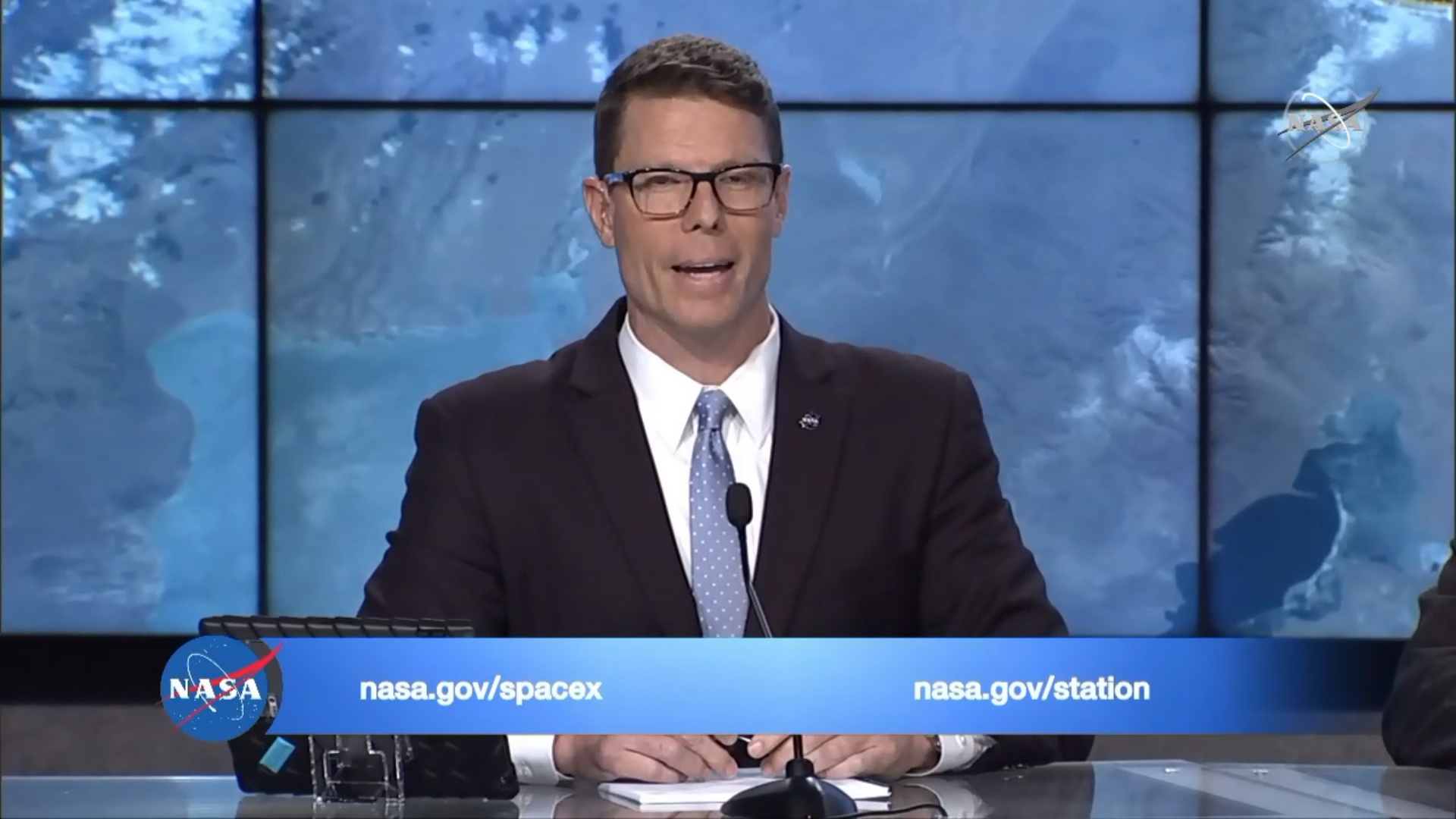
Название: Dragon SpX-17 (CRS-17), OCO-3, STP-H6 - Falcon 9-071 (B1056.1) - CCAFS SLC-40 - NET 25.04.2019, 10:20 UTC
Отправлено: tnt22 от 02.05.2019 19:03:03
Отправлено: tnt22 от 02.05.2019 19:03:03
SpaceX опубликовала брошюру миссии
crs-17_press_kit.pdf (http://www.spacex.com/sites/spacex/files/crs-17_press_kit.pdf) - 0.4 MB, 2 стр, 2019-05-02 12:56:04 UTC
crs-17_press_kit.pdf (http://www.spacex.com/sites/spacex/files/crs-17_press_kit.pdf) - 0.4 MB, 2 стр, 2019-05-02 12:56:04 UTC
Название: Dragon SpX-17 (CRS-17), OCO-3, STP-H6 - Falcon 9-071 (B1056.1) - CCAFS SLC-40 - NET 25.04.2019, 10:20 UTC
Отправлено: tnt22 от 02.05.2019 19:03:39
Отправлено: tnt22 от 02.05.2019 19:03:39
Эмблема миссии
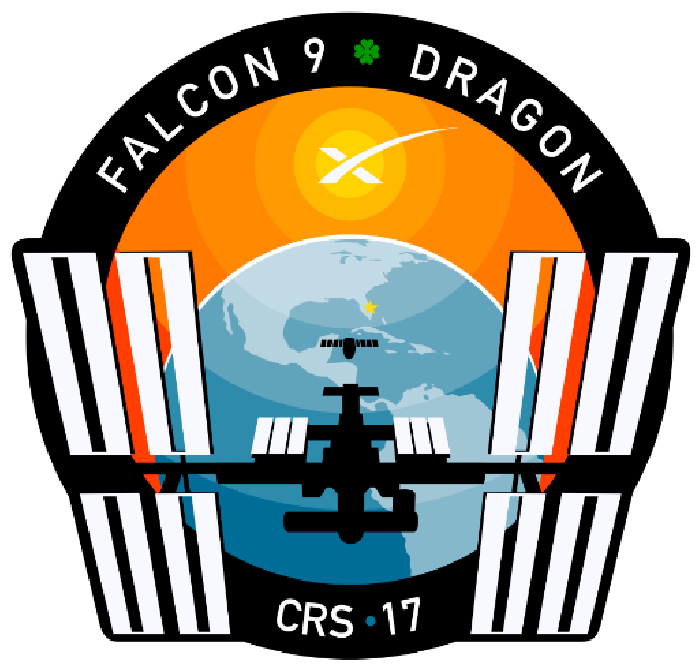
Название: Dragon SpX-17 (CRS-17), OCO-3, STP-H6 - Falcon 9-071 (B1056.1) - CCAFS SLC-40 - NET 25.04.2019, 10:20 UTC
Отправлено: tnt22 от 02.05.2019 19:04:16
Отправлено: tnt22 от 02.05.2019 19:04:16
Название: Dragon SpX-17 (CRS-17), OCO-3, STP-H6 - Falcon 9-071 (B1056.1) - CCAFS SLC-40 - NET 25.04.2019, 10:20 UTC
Отправлено: tnt22 от 02.05.2019 19:04:38
Отправлено: tnt22 от 02.05.2019 19:04:38
Название: Dragon SpX-17 (CRS-17), OCO-3, STP-H6 - Falcon 9-071 (B1056.1) - CCAFS SLC-40 - NET 25.04.2019, 10:20 UTC
Отправлено: tnt22 от 02.05.2019 19:04:58
Отправлено: tnt22 от 02.05.2019 19:04:58
Название: Dragon SpX-17 (CRS-17), OCO-3, STP-H6 - Falcon 9-071 (B1056.1) - CCAFS SLC-40 - NET 25.04.2019, 10:20 UTC
Отправлено: tnt22 от 02.05.2019 19:05:15
Отправлено: tnt22 от 02.05.2019 19:05:15
Название: Dragon SpX-17 (CRS-17), OCO-3, STP-H6 - Falcon 9-071 (B1056.1) - CCAFS SLC-40 - NET 25.04.2019, 10:20 UTC
Отправлено: tnt22 от 02.05.2019 19:06:55
Отправлено: tnt22 от 02.05.2019 19:06:55
Трансляция пуска
Цитироватьна сайте SpaceXspacex.com/webcast (http://www.spacex.com/webcast)
или
на ТыТрубеyoutube.com/watch?v=VKoGHJppW7c (https://www.youtube.com/watch?v=VKoGHJppW7c)
Название: Dragon SpX-17 (CRS-17), OCO-3, STP-H6 - Falcon 9-071 (B1056.1) - CCAFS SLC-40 - NET 25.04.2019, 10:20 UTC
Отправлено: tnt22 от 02.05.2019 20:21:43
Отправлено: tnt22 от 02.05.2019 20:21:43
https://blogs.nasa.gov/spacex/2019/05/02/weather-a-concern-for-crs-17-launch/
ЦитироватьWeather a Concern for CRS-17 Launch
James Cawley (https://blogs.nasa.gov/spacex/author/jjcawley/)
Posted May 2, 2019 at 12:44 pm(https://blogs.nasa.gov/spacex/wp-content/uploads/sites/227/2019/05/Prelaunch-Press-Conference-.jpg)
A prelaunch news conference for SpaceX's CRS-17 launch, targeted for Friday, May 3, at 3:11 a.m. EDT, was held at Kennedy Space Center in Florida on Thursday, May 2. Participants included, from left to right: Derrol Nail, NASA Communications; Kenny Todd, manager, International Space Station Operations and Integration, JSC; Hans Koenigsmann, VP, Build and Flight Reliability, SpaceX, and Will Ulrich, launch weather officer, U.S. Air Force 45th Space Wing.
Following this morning's prelaunch news conference at Kennedy Space Center in Florida, SpaceX is continuing to target Friday, May 3, for an instantaneous launch of its 17th Commercial Resupply Services Mission at 3:11 a.m. EDT from Space Launch Complex 40 at Cape Canaveral Air Force Station.
One factor to watch will be the weather.
"Normally I'm not the bearer of bad news but I kind of feel like I am today," said Will Ulrich, a launch weather officer with the U.S. Air Force 45th Space Wing. "We've been monitoring an area of disturbed weather over the Bahamas for the past few days, and that area of disturbed weather is encroaching upon the Space Coast."
The launch day forecast calls for a 40 percent chance of favorable weather for liftoff of the SpaceX Dragon spacecraft aboard the company's Falcon 9 rocket. That prediction includes winds between 15-20 mph. The primary weather concerns are cumulus and thick cloud rule, and flight through precipitation.
The Dragon spacecraft will deliver supplies including critical materials to support dozens of the more than 250 science and research investigations that will occur during Expeditions 59 and 60. The spacecraft's unpressurized trunk will transport NASA's Orbiting Carbon Observatory (https://ocov3.jpl.nasa.gov/) 3 (OCO-3) and Space Test Program-Houston 6 (https://www.nasa.gov/mission_pages/station/research/experiments/explorer/Investigation.html?#id=7947) (STP-H6).
Follow along here on the blog and on NASA Television (http://www.nasa.gov/live) tomorrow beginning at 2:45 a.m. EDT for updates from the countdown.
Название: Dragon SpX-17 (CRS-17), OCO-3, STP-H6 - Falcon 9-071 (B1056.1) - CCAFS SLC-40 - NET 25.04.2019, 10:20 UTC
Отправлено: tnt22 от 02.05.2019 20:25:41
Отправлено: tnt22 от 02.05.2019 20:25:41
Запись предпусковой пресс-конференции
ЦитироватьNASA | Prelaunch news conference for the next SpaceX cargo mission to the ISShttps://www.youtube.com/watch?v=UkZ1xpgucAUhttps://www.youtube.com/watch?v=UkZ1xpgucAU (https://www.youtube.com/watch?v=UkZ1xpgucAU) (1:00:14)
space googlevesaire (https://www.youtube.com/channel/UC6Iv92nZE21XWt0B1ZTCd6Q)
Трансляция началась 2 часа назад
Launch date has been updated to no earlier than Friday, May 3. The prelaunch news conference will be held on Tuesday, April 30, at 1 p.m. (Updated April 30, 2019)
Название: Dragon SpX-17 (CRS-17), OCO-3, STP-H6 - Falcon 9-071 (B1056.1) - CCAFS SLC-40 - NET 25.04.2019, 10:20 UTC
Отправлено: tnt22 от 02.05.2019 20:33:46
Отправлено: tnt22 от 02.05.2019 20:33:46
ЦитироватьChris G - NSF @ChrisG_NSF (https://twitter.com/ChrisG_NSF) 5 мин. назад (https://twitter.com/ChrisG_NSF/status/1124002783777128450)
Greetings fr om SLC-40 wh ere late load operations are underway ahead of Friday morning's planned 03:11:33 EDT (07:11:33 UTC) launch of #SpaceX (https://twitter.com/hashtag/SpaceX?src=hash) #Falcon9 (https://twitter.com/hashtag/Falcon9?src=hash) #Dragon (https://twitter.com/hashtag/Dragon?src=hash) #CRS17 (https://twitter.com/hashtag/CRS17?src=hash) launch to the Station.
Название: Dragon SpX-17 (CRS-17), OCO-3, STP-H6 - Falcon 9-071 (B1056.1) - CCAFS SLC-40 - NET 25.04.2019, 10:20 UTC
Отправлено: tnt22 от 02.05.2019 22:03:34
Отправлено: tnt22 от 02.05.2019 22:03:34
ЦитироватьWhat is SpaceX Launching to the International Space Station?https://www.youtube.com/watch?v=QmvY8ZmN0Ichttps://www.youtube.com/watch?v=QmvY8ZmN0Ic (https://www.youtube.com/watch?v=QmvY8ZmN0Ic) (5:18)
NASA (https://www.youtube.com/channel/UCLA_DiR1FfKNvjuUpBHmylQ)
Опубликовано: 2 мая 2019 г.
When it launches on Friday, May 3, SpaceX's Dragon spacecraft will carry crew supplies, scientific research and hardware to the International Space Station to support dozens of the more than 250 science and research investigations.
Название: Dragon SpX-17 (CRS-17), OCO-3, STP-H6 - Falcon 9-071 (B1056.1) - CCAFS SLC-40 - NET 25.04.2019, 10:20 UTC
Отправлено: tnt22 от 02.05.2019 23:27:04
Отправлено: tnt22 от 02.05.2019 23:27:04
Цитировать05/02/2019 23:02 Stephen Clark
SpaceX ground crews at Cape Canaveral are pressing ahead with a planned Falcon 9 launch attempt early Friday on a mission to resupply the International Space Station.
After the replacement overnight of a failed power distribution box on the space station, NASA and SpaceX teams gave the green light this morning to proceed with final launch preps, including the final installment of time-sensitive cargo into the Dragon supply ship.
The Falcon 9 and Dragon will be rotated vertical at Cape Canaveral's Complex 40 launch pad later this afternoon in preparation for the launch countdown.
Liftoff is timed for 3:11:33 a.m. EDT (0711:33 GMT) Friday, and the Falcon 9's first stage will target a landing on SpaceX's drone ship just off the coast of Cape Canaveral.
But forecasters predict iffy weather tonight, with a chance of rain showers from a tropical disturbance moving through the Bahamas.
There is a 60 percent probability that weather conditions will prevent launch Friday, primarily due to concerns with cumulus clouds, thick clouds, and precipitation in the Falcon 9's flight path.
Flight through precipitation is a concern for Falcon 9 launches with Dragon cargo capsules because the supply ship does not fly inside a payload fairing, and is exposed to the elements.
Weather conditions for a backup launch opportunity at 2:48 a.m. EDT (0648 GMT) Saturday look better.
Название: Dragon SpX-17 (CRS-17), OCO-3, STP-H6 - Falcon 9-071 (B1056.1) - CCAFS SLC-40 - NET 25.04.2019, 10:20 UTC
Отправлено: tnt22 от 03.05.2019 00:27:29
Отправлено: tnt22 от 03.05.2019 00:27:29
:!:
ЦитироватьSpaceXFleet Updates @SpaceXFleet (https://twitter.com/SpaceXFleet) 22 мин. назад (https://twitter.com/SpaceXFleet/status/1124056182606503937)
Tracking suggests that Hollywood, OCISLY and GO Quest are returning to Port Canaveral.
Looks like we may be about get an announcement of a scrub due to weather.Chris B - NSF @NASASpaceflight (https://twitter.com/NASASpaceflight) 10 мин. назад (https://twitter.com/NASASpaceflight/status/1124059510434410502)
Uh oh. Really would be very low chance per weather forecast (mixed in with the single shot instantaneous window). ISS is now "fixed" per the MBSU.
6 мин. назад (https://twitter.com/NASASpaceflight/status/1124060438491291648)
So the word is there's bad weather off the coast and they could be just dodging it via repositioning.Michael Baylor @nextspaceflight (https://twitter.com/nextspaceflight) 4 мин. назад (https://twitter.com/nextspaceflight/status/1124061018672574487)
Unclear if they are repositioning the droneship for some reason (possibly weather), forgot @julia_bergeron (https://twitter.com/julia_bergeron)'s cookies, or if the launch attempt is off. Don't panic yet...SpaceXFleet Updates @SpaceXFleet (https://twitter.com/SpaceXFleet) 1 мин. назад (https://twitter.com/SpaceXFleet/status/1124062587107385344)
GO Quest has slowed quite a bit and has also changed trajectory so that they are no longer aligning with the port entrance channel. This continues to reinforce the suggestion that they are moving a bit to dodge some poor conditions.
Название: Dragon SpX-17 (CRS-17), OCO-3, STP-H6 - Falcon 9-071 (B1056.1) - CCAFS SLC-40 - NET 25.04.2019, 10:20 UTC
Отправлено: tnt22 от 03.05.2019 00:34:00
Отправлено: tnt22 от 03.05.2019 00:34:00
https://ria.ru/20190503/1553237291.html
ЦитироватьРакета Falcon 9 отправит к МКС грузовой корабль Dragon
00:20
ВАШИНГТОН, 3 мая - РИА Новости. Ракета-носитель Falcon 9 стартует во Флориде с космическим кораблем Dragon с грузом для Международной космической станции (МКС), сообщили представители НАСА в четверг.
Старт Falcon 9 должен состояться с космодрома на мысе Канаверал (Флорида) в 10.11 мск 3 мая. Ракета выведет на орбиту корабль с 2,7 тонны груза для международной космической станции.
Старт корабля должен был состояться ранее на этой неделе, но был отложен из-за неполадок электросистемы МКС, которая потребовала замены вышедшего из строя элемента. Как сообщили в НАСА в четверг, проблема была устранена, препятствий к запуску грузового корабля нет.
Как рассказал на предстартовом брифинге вице-президент SpaceX Ханс Кенигсман, для старта компания использует уже латавшую на МКС грузовую капсулу Dragon и новую ракету-носитель. Он сообщил, что в ходе запуска первая ступень Falcon 9 совершит посадку на плавучую платформу у побережья Флориды.
Между тем, предупредили метеорологи, запуску в пятницу может помешать погода: в сторону побережья Флориды идет циклон. По прогнозу специалистов, вероятность того, что погодные условия помешают старту, составляет 60%. В случае отмены старта в пятницу, попытка запуска повторится в субботу.
Как сообщили в НАСА, на корабле на станцию будут доставлены материалы для более чем 200 идущих на орбите экспериментов в сфере здравоохранения, космической медицины и других областях. На станцию также доставят инструмент OCO-3, предназначенный для измерения углекислого газа в атмосфере Земли. По прибытии на МКС инструмент будет установлен на внешней поверхности японского модуля международной космической станции.
Прибытие корабля на станцию ожидается 5 мая, его захват механическим манипулятором Canadarm осуществит канадский астронавт Давид Сан-Жак, ассистировать которому будут астронавты НАСА Ник Хейг и Кристина Кук. Стыковку грузового корабля с американским модулем "Гармония" осуществят специалисты с Земли.
С прибытием Dragon на МКС, число "припаркованных" на МКС кораблей увеличится до шести, в настоящее время там находится американский грузовой аппарат Cygnus, а также по паре российских грузовиков "Прогресс" и пилотируемых кораблей "Союз". Планируется, что Dragon будет оставаться на станции около месяца, после чего вернется на Землю с материалами научных экспериментов. Принадлежащий компании SpaceX корабль является на сегодня единственным грузовым аппаратом, доставляющим материалы с МКС на Землю.
Название: Dragon SpX-17 (CRS-17), OCO-3, STP-H6 - Falcon 9-071 (B1056.1) - CCAFS SLC-40 - NET 25.04.2019, 10:20 UTC
Отправлено: tnt22 от 03.05.2019 06:39:42
Отправлено: tnt22 от 03.05.2019 06:39:42
Цитировать05/03/2019 03:06 Stephen Clark
The Falcon 9 rocket was raised vertical this evening at Cape Canaveral in preparation for a countdown leading toward a scheduled liftoff time of 3:11 a.m. EDT (0711 GMT).(https://photo.24liveblog.com/2242762235231691057/20190503000630_679894.jpg)
Название: Dragon SpX-17 (CRS-17), OCO-3, STP-H6 - Falcon 9-071 (B1056.1) - CCAFS SLC-40 - NET 25.04.2019, 10:20 UTC
Отправлено: tnt22 от 03.05.2019 07:48:53
Отправлено: tnt22 от 03.05.2019 07:48:53
Цитировать05/03/2019 07:42 Stephen Clark
Two-and-a-half hours until launch. Rain showers so far tonight are staying offshore over the Atlantic Ocean.(https://photo.24liveblog.com/2242762235231691057/20190503044247_428790.jpg)
Название: Dragon SpX-17 (CRS-17), OCO-3, STP-H6 - Falcon 9-071 (B1056.1) - CCAFS SLC-40 - NET 25.04.2019, 10:20 UTC
Отправлено: tnt22 от 03.05.2019 08:46:02
Отправлено: tnt22 от 03.05.2019 08:46:02
ЦитироватьChris G - NSF @ChrisG_NSF (https://twitter.com/ChrisG_NSF) 1 мин. назад (https://twitter.com/ChrisG_NSF/status/1124187371807956992)
T-90mins. Everything still proceeding at this time. Bulk of the rain is holding offshore (at this time). #SpaceX (https://twitter.com/hashtag/SpaceX?src=hash) #Falcon9 (https://twitter.com/hashtag/Falcon9?src=hash) #Dragon (https://twitter.com/hashtag/Dragon?src=hash) #CRS17 (https://twitter.com/hashtag/CRS17?src=hash)
Название: Dragon SpX-17 (CRS-17), OCO-3, STP-H6 - Falcon 9-071 (B1056.1) - CCAFS SLC-40 - NET 25.04.2019, 10:20 UTC
Отправлено: tnt22 от 03.05.2019 08:48:52
Отправлено: tnt22 от 03.05.2019 08:48:52
ЦитироватьSpaceflight Now @SpaceflightNow (https://twitter.com/SpaceflightNow) 6 мин. назад (https://twitter.com/SpaceflightNow/status/1124188219094990848)
Good morning from NASA's Kennedy Space Center in Florida. A SpaceX Falcon 9 rocket is standing vertical a few miles away at Cape Canaveral Air Force Station for liftoff at 3:11am EDT (0711 GMT) on a resupply flight to the International Space Station.
https://spaceflightnow.com/2019/05/02/spacex-crs-17-mission-status-center/ ... (https://t.co/GzEhq4O1pL)
Название: Dragon SpX-17 (CRS-17), OCO-3, STP-H6 - Falcon 9-071 (B1056.1) - CCAFS SLC-40 - NET 25.04.2019, 10:20 UTC
Отправлено: tnt22 от 03.05.2019 09:01:31
Отправлено: tnt22 от 03.05.2019 09:01:31
https://gist.github.com/theinternetftw/d3b11690c2f473d34419673af6a3d995
ЦитироватьCRS-17 Pre-Launch Presser
2019-05-02
Moderator:[/li]
Participants:- Derrol Nail, NASA Communications
[/li]
Derrol Nail, Moderator: Hello and welcome to NASA's Kennedy Space Center in Florida for our pre-launch coverage of CRS-17 by SpaceX and NASA. As the name suggests, this is the 17th resupply mission the International Space Station by SpaceX. I'm Derrol Nail with NASA Communications. We have guests here to help us break down this mission. And so we want to go over to those now. To my left is Kenny Todd, the manager of the International Space Station Operation and Integration at Johnson Space Center. And we have Hans Koenigsmann, Vice President of Build and Flight Reliability for SpaceX. Also, Will Ulrich, Launch Weather Officer for the United States Air Force's 45th Space Wing. And on the phone we have Kirt Costello, he's the Acting Chief Scientist for the International Space Station. We're going to take your questions in just a bit, but first we want to start with opening statements. And Kenny, why don't you get us started?
Kenny Todd, Manager, International Space Station Operations and Integration, JSC
Hans Koenigsmann, Vice President of Build and Flight Reliability, SpaceX
Kirt Costello, ISS Program Acting Chief Scientist
Will Ulrich, Launch Weather Officer, 45th Space WingСпойлер
Kenny Todd, ISS Program: Alright. Good morning to everyone. It's great to be here. I'm very excited about the opportunity to get the SpaceX-17 mission off the ground tonight. Hopefully the weather will cooperate with us and we can get going. I was just out at the pad a few minutes ago watching the closing parts of the late load for our cargo that's going in. Which is kind of cool, because a lot of that cargo is some of our critical research that we'll want to carry out over the next 30 days. So it's great to see it going in, and I can't wait to see the hatch open in a couple of days, and we can get working on it. So, this particular Dragon, we've got about 1,700kg worth of cargo for the ISS on there. When you take that coupled with the cargo that we brought up a couple weeks ago on the Cygnus module, about 4,700kg, 4,800kg of cargo. So needless to say, the crew's very busy right now. They're enjoying it. This is a fantastic crew on orbit, and the more you give them to do, the more they do. So it's pretty incredible how well they're working together. As far as the Increment goes, Increment 59, we've got about seven weeks left, so I think we won't have any trouble getting this mission done in this Increment, and the majority of the Cygnus mission done as well. So June 24th is currently our plan to bring Anne, and David, and Oleg home, and that'll close out this particular Increment.
Fr om a space station standpoint, I'm happy to report that things are a lot better today than they were yesterday. At this time, as most of you have known, early Monday morning we got a surprise with the loss of one of our Main Bus Switching Units. There are four of them on Station, and we lost the one that helps feed power fr om Channels 3A and 3B. And so we had to essentially try to look at all of our options. Could we live with this problem? Could we go do this mission knowing that we only had six of eight power channels? And we exhausted all of our options quickly trying to cross-strap power to allow us to get the power redundancy we need for some of our critical systems. So once we exhausted those options, we then had to look at our best option to try to replace the MBSU. We decided, these particular boxes, we've replaced one robotically. We've also done one via EVA. So we knew that we had both of those options available to us and in our toolkit, based on our experience with those particular boxes. In the end, we decided the best course was to do it robotically, and we challenged our robotics team, and I'm talking about the team here as well as our friends and our partners in Canada, who have the responsibility for that arm, and they just did a fantastic job since this problem occurred in pulling together all the necessary products and procedures, and putting us in a position to be able to go execute that operation yesterday. So about 5AM this morning Florida time, I got the thumbs up that things were in good shape, and we're back to having good redundancy fr om a power standpoint. So that puts us in a lot better position and ready to go do this mission. As far as the rest of Station, everything else is on track. Everything's working well. No huge anomalies that stand in the way of us doing the mission.
The last thing I'll bring up is, I know there's a lot of conversation and talk about what happened with the Demo-1 capsule. I know Hans is going to talk about that as well. But fr om a NASA perspective, we have worked very closely with the SpaceX team. Our first goal when this incident happened was to try to find out fr om a Station Program perspective, do we have any issues with this particular Dragon. And very quickly we partnered well with the SpaceX team. They were thinking the very same thing, and so we were able to get our arms around the common areas that we had to look at, that they had to look at. And at the end of the day, we didn't see any change in our overall measurable risk in going into the mission as a result of that. And anyway, I just wanted to get that out there. And now, I know there's a lot of conversation about it. But we looked very hard fr om the Space Station Program at what that particular issue meant for us. I know all our friends at the Commercial Crew Program, obviously they're very interested in what happened in that particular incident, and they're also closely aligned with the SpaceX team in their investigation, and that's going to continue to go on for some time. And that's, we'll let our Commercial Crew Program go work with SpaceX and try to figure out their path forward. But we feel very comfortable in moving forward with this particular mission.
So with that, I'll pass it on to Hans.
Hans Koenigsmann, SpaceX: Alright. Thank you very much, and good morning. I'm happy to be back in Florida for another launch. I do want to start today by addressing the test anomaly that occurred on April 21st, this year. And please keep in mind, this is still very early in the investigation. The investigation is led by both SpaceX and NASA. Both teams are carefully reviewing the telemetry data and all the data that was collected during that test. High-speed imagery, telemetry, and it will include eventually the analysis of the recovered hardware fr om the test. Our priority at this moment is to allow the teams to conduct a thorough analysis before we come to any conclusions. That said, here's what we can confirm at this point in time.
At the test stand, we powered up Dragon, and it powered up as expected. We completed tests with the Draco thrusters. The Draco thrusters are the smaller thrusters that are also on Dragon 1 and the Cargo Dragon. We fired them in two sets, each for five seconds, and that went very well. And then just before we wanted to fire the SuperDraco, there was an anomaly and the vehicle was destroyed. There were no injuries. SpaceX had taken all safety measures prior to this test, as we always do. And because this is a ground test, we have a higher amount of data, a huge amount of data fr om the vehicle and the ground sensors. It is too early to confirm any cause, whether probable or root. But the initial data indicates that the anomaly occurred during the activation of the SuperDraco system. That said, we're looking at all possible issues and the investigation is ongoing.
We have no reason to believe that there's an issue with the SuperDracos themselves. Those have been through about 600 tests at our test facility in Texas. And you also know about the pad abort. We did some hover tests. So there was a lot of testing going on, on the SuperDraco. We continue to have high confidence in that particular thruster. And as you mentioned already, Crew Dragon is built on the heritage of Cargo Dragon, but these are different spacecraft. Dragon does not use SuperDraco and its propellant systems. We have looked at all the common links between the two spacecraft. We reviewed that, and we approved them for flight by both teams, NASA and SpaceX in common. Also, I want to point out, CRS-17, that spacecraft has flown as CRS-12 already, which means it has been tested very well, like, flight, basically. Again, I'd like to reiterate during a test, not during flight. That is why we test. If this has to happen, I'd rather it happens on the ground, in the development program. And I believe what we learn fr om this test will make us basically a better company, and Dragon 2 at the end a safer vehicle. So we will take the lessons learned fr om this. And I'm convinced this will help us to ensure that Crew Dragon's one of the safest human spaceflight vehicles ever built.
So that said, back to the mission at hand, CRS-17. I do have a few slides here. There we go. We're targeting a launch at 3:11 AM, which is an unfortunate time, in the middle of the night. That's how it is. When you want to dock, sorry, berth to the space station, you've got to go to the space station. And the plane crosses the launch site at that point in time, more or less. So that's our launch time. I think the backup day is, I want to say 2:48, or something like that. Twenty minutes, roughly, per-day shift. We started late-load of cargo yesterday night. I saw them basically finishing up on the launch pad when we drove by. The vehicle will go vertical later today.
And let's see, I already mentioned that this was the same Dragon that was flying on CRS-12 in August 2017. It's the sixth resupply mission that uses a previously flown Dragon spacecraft. And then CRS-17, as the name implies, is the 17th of up to 20 missions to the ISS. Next one, please. This is hard to read for me. But I do want to just point out a few things on this one here. So we start loading the first stage at T-35 minutes, and what always amazes me, and I've been through a lot of these launches, is that we start loading the second stage at T-16 minutes. Sounds like a short time. On the other side, we empty the stage in actually less time than that. So you've got to put those in relation. It's chilled LOX, so you want to load it fast, and you want to go basically right at that time. That's how we launch our rockets, and Dragon, obviously. Then, again, at one minute before launch, the vehicle takes over completely and we start pressing up for flight. Next one, please. In-flight, pretty much like all the other flights. We will return the first stage and attempt a, in this case, droneship landing. But pretty nearby. Both landing and orbit insertion always happens at almost the same time. I'm always torn, what to look at, basically. But the first stage lands a couple seconds before the second stage engine cutoff happens. And then, after that Dragon deploys fr om the stage and goes on its mission.
And then, let's see, the last one, the last slide, please. That's an inspirational video. You'll see a little bit how Dragon basically lim it cycles before it gets captured by the arm, and then the arm moves it over to the Node 2 zenith? Sorry, nadir. Not zenith. And docks the spacecraft. And if you were to look fr om the door, that's how it looks in the last cut here. One second. Yeah, exactly, that's how it looks if you were inside the door. And you see Dragon berthing, as it comes closer and closer.
That's all I have for now. Thank you.
Derrol Nail, Moderator: Alright, thank you Hans. We're going to take just a brief moment to let our audience know that we are taking questions on social media with the hashtag #askNASA on Twitter. We're going to get to those in just a second. But we want to go to the phone now for an opening statement fr om Kirt Costello, the Chief Scientist for the International Space Station. Kirt, are you with us?
Kirt Costello, ISS: Yes I am. Thank you, Derrol. I'd like to point out that our SpaceX CRS-17 flight is going to be delivering 1,700kg of research cargo and supplies to the space station. Including two new external payloads, the Orbiting Carbon Observatory 3, OCO-3, and the Space Test Program - Houston 6, STP-H6. The International Space Station is an amazing multidisciplinary lab supporting all types of research and technology development furthering our NASA goals to advance human exploration capabilities, return benefits to people here on Earth, through our partnership with the National Lab, build a low-Earth orbit commercial marketplace, and continue to work with our international partners. Today I'll be going over a few of the investigations with you. In the area of biology and biotechnology, the National Laboratory is flying four separate tissue-on-chip investigations. These are being done in collaboration with the National Center for Advancing Translational Sciences at the National Institutes of Health. The investigations are looking at four different biological systems using microphysiological systems and live human cells. This eliminates questions that may arise sometimes when we're using animal model systems, and it may allow for multiple samples to stow and be flown in minimal hardware space with a minimum of crew interaction. The first of these experiments is the kidney cells experiment. This will examine how kidney health is affected by microgravity and other factors of space travel, including increased chemical exposure, water conservation and recycling, and altered dietary intake. Serious medical conditions can be caused by poor kidney health, including proteinuria, osteoporosis, and kidney stones. These occur more quickly in space. Knowledge can help protect the health of astronauts and contribute to better treatments for kidney-related conditions on Earth. This is coming to us from the University of Washington and the Kidney Research Institute.
The second experiment, the Lung Host Defense in Microgravity, explores why the space environment makes astronauts more prone to sickness than people on Earth. It uses an organ-on-a-chip technology to create three dimensional models of lung and bone marrow and then purposely infects those lung cells. The response is measured in the bone marrow and the blood stream and is compared in the microgravity situation to that on Earth. This investigation is coming to us from George S. Worthen, M.D. at the Children's Hospital of Philadelphia.
The third of these investigations is studying the blood-brain barrier, in an organ-on-a-chip. The blood-brain barrier is an important physiological feature to understand how toxins and nasty stuff in our blood is prevented from entering our brain and causing inflammation and disease. This particular investigation will be looking at better understanding neurogenerative diseases such as Alzheimer's and Parkinson's. This comes to us from EmulateBio in Boston, MA.
And finally, the last of these tissue-on-a-chip investigations is the cartilage-bone synovium microphysiological system using MVP, or multi-purpose variable-G platform. This investigation is looking at the effects of musculoskeletal disease on biology, motivated by a disease called post-traumatic osteoarthritis, in which a traumatic joint injury may lead to arthritis or the loss of cartilage and bone. The ability of potential drugs to treat the progression of this disease is going to be tested in both space and on Earth.
From the biological side, we'll switch over to the physical sciences side, wh ere we have a new facility being flown on-board called Hermes. Hermes is an experimental facility which holds cassettes about the size of a Pringles can. Many different types of science can be done in this, but Hermes Cassette-1, the first of these investigations, will be looking at asteroid-building and regolith. So, many small particles are placed in these cassettes, and video is taken of them as they expand on-orbit and self-sort. It's interesting to look at these in the microgravity environment to get a better understanding of how asteroids and other space-based bodies come together dynamically.
External to the ISS, we'll be flying two new payloads in the trunk of the Dragon capsule. The first is the Orbiting Carbon Observatory, or OCO-3, and it will be installed on the Japanese Experiment Module - Exposed Facility. This is designed to observe and measure the total carbon in a carbon-averaged carbon column, as it flies over various parts of the surface, in a 50x50 mile swath. This can be used to look at phenomena located just in one area, or, over time, to build up a map of all the carbon sources and sinks. This is related to the free-flying investigation OCO-2 and uses flight-heritage equipment from that program.
Also, we have the Space Test Program - Houston 6, which is comprised of seven separate payloads. These payloads are focused on advancing technologies, including advancing our space-based supercomputing capabilities, determining the attitude and position knowledge for nanosatellites, measuring the space plasma charging environment and airglow in the upper atmosphere. There's even an investigation looking at X-ray communication testing. So a very multitalented payload external to the space station.
Our last category of payloads that I wish to talk about are student and educational payloads that also fly on Dragon and bring the next generation of researchers into the spaceflight community. NASA researchers are also looking into the effects of the microgravity environment on biology in the Microalgae Biosynthesis in Microgravity experiment. This studies the effects of microgravity on Haematococcus pluvialis, an algae capable of producing a powerful antioxidant. It is hypothesized that this algae will be able to produce more of this antioxidant, and it could become an in-situ resource available for future space exploration. This comes to us from the Des Moines Area Community College in Des Moines, IA.
And on our National Lab side, the Genes in Space-6 competition winners will be flying their payload as part of the National Lab science complement. Genes in Space-6 looks at the yeast Saccharomyces cerevisiae and its ability to repair double-strand DNA breaks due to environmental damage. This is the first investigation that is looking at creating that damage in space so they can look at the hypothesis as to whether the repairs DNA undergo in space are more error-prone or less error-prone than those that we undergo on Earth.
Derrol Nail, Moderator: Alright, thank you very much Kirt. Before we continue, we want to get a little bit from the weather. The biggest story of the hour, and that goes to our Launch Weather Officer, Will Ulrich. Will, we hear some rain is on the way.
Will Ulrich, 45th Space Wing: Thank you, Derrol. Normally I'm not the bearer of bad news, but I kind of feel like I am today. Unfortunately, we've been monitoring an area of disturbed weather over the Bahamas for that past few days. And that area of disturbed weather is encroaching upon the space coast this afternoon and tonight, and it will be very near the area overnight tonight. So we will be looking at a higher than usual chance of shower activity. A slightly lower chance of lightning activity. But plenty of clouds that will kind of throw a kink into the plans for this afternoon, or for tonight. If we take a look at the satellite imagery right now, you'll see that area of disturbed weather over the Bahamas. It continues to slowly move to the northwest, and it is expected to move over the area later tonight and overnight tonight, bringing an unusual surge of moisture for this time of year. Atmospheric moisture values are near record values, unfortunately, overnight tonight. And that will feed in to the possibility of multiple levels of clouds and shower activity. We're also monitoring another storm system out over the central United States, stretching from about Chicago down into the Texas area. That storm system will remain far enough away to not have any impact on our local weather. However, it will direct that storm system that's currently over the Bahamas. It will move in our general vicinity before getting kicked out, out ahead of that storm system currently over the central US. So this is the time of year, May, wh ere we typically worry about afternoon showers and thunderstorms. But with the presence of this storm system over the Bahamas, this disturbance, as it moves over the area, we are anticipating a higher than usual chance of showers overnight.
So if we take a look at the forecast, the launch forecast for tonight, we do have a 60% chance probability of violation, for three primary concerns, including the Cumulus Cloud Rule, Thick Cloud Rule, and Flight through Precipitation. Temperatures will be hovering in the middle 70s, which is not atypical for this time of year, and we will see a nice breeze out of the south-southeast, between 15 and 20 mph. I mention that storm system currently over the central United States. As it encroaches a little nearer to the space coast, it will push out that system, beginning tomorrow afternoon. So the system that's currently en-route to affect us overnight tonight will begin to move into the western Atlantic and offshore of the Carolina coast. So if we look at the backup day forecast, conditions are expected to improve as we see that moisture move out into the Atlantic and drier air filter in. We are, for probability of violation, currently forecasting 30%, or 70% go for launch. Still concerned about the same three constraints, including Cumulus and Thick Cloud Rule, and Flight through Precipitation. However, as you can imagine, we're just not expecting as many clouds and showers in the vicinity of the spaceport during that time. Temperature also hovering in the low 70s.
So I wish I had better news for you folks, but hopefully we can find a gap around that time and get this rocket up. Thanks.
Marcia Dunn, Associated Press: Marcia Dunn, Associated Press for you, Hans. What does the accident do the SpaceX's effort to get astronauts flying on the Crew Dragon this year. Is that even a possibility anymore? Just sort of a look ahead at what you anticipate. And also a status of the landing zone. When do you expect that to be back in action?
Hans Koenigsmann, SpaceX: Yeah. So for the overall program, I mean, first of all, we're going to learn a lot, and I think this will make the program actually safer, at the end of the day. In terms of schedule, I feel like that finishing this investigation and resolving this anomaly is our prime focus, certainly for me, right now. So we will see, also, what comes out of it, to some extent. So what I'm saying is it depends a little bit on what we find and what shapes the schedule ahead of time. I hope this is a relatively smooth investigation at the end of the day. And I don't want to completely preclude the current schedule. It's certainly not great news for the schedule overall, but I hope we can recover. And part of this is also based on the fact that we have multiple spacecraft in work. Basically, we've started production. So we have several spacecraft in different shape and form right now, with respect to that. So that we don't turn around and build a new one now, this is basically in the works the entire time. So I hope we can mitigate the impact on that. And then, the question regarding the landing site. The landing site and test site were very close. We wanted to basically make sure that we can focus on the evidence and not disturb that and make sure that we analyze this properly. That's why we separated the landing, basically. We are pretty close to getting, we can get back to the site right now, overall. But we can't get close to some of the, to the test stand, basically, and Dragon itself. So there's still some safety precautions right now for certain areas we can't get to. But, also you heard, we're getting close, getting close to basically get full control of the site. But I've heard that for a couple of days, too. So it's going to be, you know, day by day.
Marcia Dunn, Associated Press: If I can just follow up. Do you believe that SpaceX will be able to launch astronauts on a Dragon by year's end. At this point, today, if I were to just--
Hans Koenigsmann, SpaceX: Yeah, I know what you're saying. If I personally believe that. I certainly hope so. It's a complete carte blanche when you start investigations of that. I've done this a couple times. I've done a lot of anomaly investigation by now. And whatever I knew in the second week was never really what happened to be the result in the end. So this will take a little more time.
Chris Gebhardt, NASASpaceflight: Chris Gebhardt with NASASpaceflight. Two questions for Hans. I'm wondering, are there any operational changes to how the recovery teams for the booster have to operate, landing it at sea, but this close to Port Canaveral, with all the cruise ship and commercial traffic? And also, my standard question, what's the precise launch time, down to the second?
Hans Koenigsmann, SpaceX: Alright. Let's start with number two. It's 3:11:33. However, that sometimes shifts in the last couple of hours. So if you see something else, that's not me, it's just Station. [laughter] [off-mic comment from audience] Exactly. So with respect to the recovery operations, I want to say, it's harsher for the team to be on the trip a couple of days out, and then do it there, and come back in a couple of days. It's certainly easier the closer they are to the shore. It makes it more benign. Their cell phones still work. But the protocol itself and the procedures we do are the same here.
Ken Kremer, RocketSTEM/SpaceUpClose: Hi, Ken Kremer. RocketSTEM/SpaceUpClose. For Hans. Can you talk a little bit more about how you investigated, and maybe Kenny Todd, too, the commonality between the Dragon 1 and the Dragon 2. How were you able to confirm, talk about the investigation, how were you able to confirm that there isn't a commonality that would cause a problem? Okay, there must be other things, besides the SuperDracos, that are in common. And the other thing I want to ask you is about, you said just now you can't get to the test site. Can you talk a little about why that is? Is it so contaminated that people just can't get there except in suits or whatever? Thanks.
Hans Koenigsmann, SpaceX: Sure. So how you do this in general, you look at the list of components on both spacecraft, basically. And there's a team that actually reviews what is on the configuration of both spacecraft. And so they have all the necessary and information and data to see if parts are the same, if parts have changed, if parts are operating in a different way. So we have this as basically part, not quite that, but part of our review for each launch is to go through the list of components, make sure they're qualified, make sure they have the right pedigree, and so on and so forth. So that team's in place that can do this relatively quickly. I can tell you that I personally reviewed some of the data to make sure that, for example, the scales are properly calibrated, and so there's, a lot of work went into that. And a certain amount of brainstorming to make sure we did not miss anything, basically. And one factor, keep in mind that CRS-17 was also the same spacecraft that flew on CRS-12.
Regarding the test site, there are several hazards. For example, there are still pressurized COPVs. In terms of COPVs, it's a good thing if they hold pressure that long, right? But we've got to be cautious. Make sure that all safety protocols are being adhered to. We also should point out that we're working with the Air Force to make sure that this is safe for personnel.
James Dean, Florida Today: Thanks, Derrol. Yeah, Hans, even though these are for different programs, is it difficult for the CRS team and Falcon teams to press ahead with a launch this quickly after such a dramatic mishap as we just saw, you know, with a different capsule, but similar?
Hans Koenigsmann, SpaceX: I don't think so. We had time enough to answer that question, and we had people that addressed the question of separation between the programs. Specifically, we're going very systematic on this test anomaly. It's certainly that is a shock to some engineers, obviously. And I also want to point out that there's always this positive thing of learning things and making things better. But overall I feel like we're ready on CRS-17. The team's focused on that. We're a big company, and I feel Cargo Dragon is safe to fly to the station. So is Falcon 9.
Samantha Masunaga, L.A. Times: Hi. Sorry, my line was on mute. A question for Hans. Can you talk a little bit about what exactly happened when Crew Dragon was on that test stand. I know there's that leaked video showing what appears to be a fireball. Is that accurate? Thanks.
Hans Koenigsmann, SpaceX: Yeah, I can't comment on a video that wasn't produced by SpaceX. I will not mention that. And then regarding what happened on the test stand, like I said, it happened after we did a successful test on the Dracos and just before we wanted to go into a test on the SuperDracos. We have tons of data, and we're sifting over this, but we don't have currently something wh ere we currently can say, oh, it was most likely this or that. We do think, I think it was not a SuperDraco thruster itself, but that's pretty much all I can say at this point in time. It will take some time for us to go through the data and figure out what it was.
NASA Social Media: Alright, we've got a cute one with gif of a sleepy girl blinking, and [username unintelligible] wants to know, "Why are you launching in the middle of the night? I mean, I will wake up to launch, but dang." Could you explain a little more?
Kenny Todd, ISS Program: Well, as Hans said, it's all about orbital mechanics. Unfortunately, that's something we can't control. Station's going to be wh ere it's going to be, going around the Earth, and at certain times of year, this is wh ere we find ourselves. This is the optimum point. A lot of the time you're trying to manage the performance on the launching vehicle. You want to be able to put as much cargo on there as you can, so the quicker you can get to orbit and get in behind station, that's what we want to do. Because that allows us to then maybe not fly as much fuel, and maybe we can put more cargo on. So it's an optimization problem, but it's driven primarily by orbital mechanics. And I feel her pain. And often.
Hans Koenigsmann, SpaceX: I do want to point out that actually I like launching at night, to some extent. The weather is usually calmer. So for us, it's actually good.
Will Ulrich, 45th Space Wing: Usually. [laughter]
Stephen Clark, Spaceflight Now: Hi, Stephen Clark from Spaceflight Now. Hans, another question on the anomaly earlier, or last month. You mentioned the anomaly occurred during the activation sequence for the SuperDracos. I'm curious if you could talk about the SuperDraco pressurization system, what happens during that activation process, and the role of COPVs in that process. And just walk us through what's supposed to happen during that process.
Hans Koenigsmann, SpaceX: Alright. So, basically what you do during activation is you pressurize the system and you make sure everything's primed in. You open valves, you close valves, and, that's basically what an activation system does, right? Regarding COPVs, you do not pressurize COPVs at that point in time. You actually take pressure away. I want to point out the COPVs are different from Falcon 9. These are a different material, they have a different form. I'm fairly confident that the COPVs are going to be fine, but again, like I said, I was wrong in the past, too, after a couple of days, and you look at it longer. But I want to say there's still several COPVs there. So.
Stephen Clark, Spaceflight Now: Just a quick follow up. We heard during the ASAP meeting, I think last week, about vibroacoustic loads during this test. Were you doing any testing in the vibroacoustic environment during that activation?
Hans Koenigsmann, SpaceX: Right. We did do some testing, I've forgot, I don't think we did it with this particular Dragon, but we generally do vibroacoustic testing in the test chamber, so we know things are basically designed for that environment. That test itself, when you fire your thrusters, is also a good test for that. But we didn't get to this point. [off-mic comment] Yes, exactly, we weren't at the point wh ere the thrust would create vibroacoustic noise at that point in time. Like I said, you know, this is all pretty new for us in a sense. The investigation is going on. I don't have a lot of information wh ere this is going. And every guess that I would give you would probably just turn out to be the wrong guess in the end anyways, unfortunately.
Melonie Holt, WFTV: Thank you, Derrol. Melonie Holt, WFTV. And this is regarding the anomaly, so you'll have to forgive me. I haven't heard an answer to this one yet, though. You were talking about a different propellant for the Crew Dragon versus the Cargo Dragon. Can you talk to us a little bit about the propellant that would have been aboard the Crew Dragon? And it's been described to me as hypergolic. Just kind of what that is, and that orange-tinged smoke that was seen on April 20th. I mean, how is that contained to the site wh ere everything obviously obviously occurred?
Hans Koenigsmann, SpaceX: There's probably a misunderstanding. It uses the same propellants as, propellants itself, the propellant system is different. In other words, and in particular the one the main difference is Dragon 1, or the Cargo Dragon, does not have SuperDracos and a propellant system, or propulsion system, rather, that has a high flow... thicker lines, basically, is what is boils down to. But it does have the same Draco system which it uses for orbital maneuvers and for attitude control. So it is very similar in that aspect, and uses the same propellant. It also uses less. There's more on Crew Dragon. So overall there's some commonality, but the system that we believe, that we have been kind of looking at closely here, is not one that is on Cargo Dragon for the next flight.
Melonie Holt, WFTV: And then what about the containment. Obviously, when you see that smoke, I know there were no injuries, clearly. But how do you contain all of that to the site wh ere that happened.
Hans Koenigsmann, SpaceX: Alright, so public safety was not a risk at all. We make sure that the wind goes from the right direction in those tests, too. And the orange cloud that you see is NTO at the end of the day, but it is safe once it disperses in the atmosphere. Once you mix it basically with air. At a reasonable rate.
Irene Klotz, Aviation Week: Oh, I haven't been with Reuters for a while. Irene Klotz with Aviation Week. That's okay. Thanks. [laughs] Forgot my question. Two questions for Hans. First of all, were the SuperDracos tested at all on Demo-1?
Hans Koenigsmann, SpaceX: Sorry, the system on Demo-1 was isolated and was never used on Demo-1.
Irene Klotz, Aviation Week: Thanks. And of the 600 SuperDraco tests that you mentioned, were any of those with equipment that had been in the water? Previously?
Hans Koenigsmann, SpaceX: Um. No? Actually that's a good question. Because we had the pad abort, too, and that was in the water. So I can't answer that question. Possibly. But I do appreciate you staggering the questions so I can actually remember them, too. [laughs]
Irene Klotz, Aviation Week: Thanks. And have you been able to eliminate anything like ground support equipment, contamination in the lines, anything that has come off the fault tree?
Hans Koenigsmann, SpaceX: We did, but the fault tree is pretty long, and at this point in time those are preliminary, I want to say preliminary judgments. But we do need to still collect evidence, we need to make sure that we don't miss anything from any of these sources. So right now we need to keep an open mind and make sure that we consider basically everything.
Mary Beth Griggs, The Verge: Yes, hi. Thank you so much for doing this. I'm curious if the anomaly, if you have any idea how this might delay test flights going forward?
Hans Koenigsmann, SpaceX: Yeah. I feel like I'm running the same answer every time a little bit. Because I don't know what happens, coming out of the investigation, basically, I don't know what the impact is to the spacecraft. Is it a small change, is it a big change, is it an operational change? There's all sorts of different solutions that can come out of that. And they obviously drive the schedule because like I said, we do have Dragon in production at this point in time. And that basically mitigates the impact. But if we have to go back and make changes, then that obviously is going to cost some time. So it's really, I'm really sorry that I can't give you a good estimate on how much this will delay, or if it delays at all. It's just depending on what we find and wh ere we go from here.
Marina Koren, The Atlantic: Okay. Hi, thanks for doing this. This is a question for Hans. Have you or anyone else at SpaceX spoken to Bob Behnken and Doug Hurley since the anomaly. And what would you say in general to kind of reassure them, based on what happened with the capsule?
Hans Koenigsmann, SpaceX: Yeah. That was actually interesting. We did talk to Bob and Doug, of course. And I almost feel like, they were very sympathetic and reached out to us. So I almost feel like they are encouraging us right now. And they're helping us in keeping our motivation and not fall into a hole, basically, and get worked up over all this, but rather stay focused and get the investigation going, and not miss anything. We work with them very closely, I feel I can always go back and ask them to help me motivate the team, and get this done basically in the most safe way we can possibly do. Yeah.
Unidentified questioner: I'm not sure if this is for Kenny or Hans, but if the weather doesn't cooperate for the next two days, what's the range availability, are there any Station issues that might affect your launch options?
Kenny Todd, ISS Program: Well, we know for a fact that we have the 3rd and the 4th. The challenge is going to be, after that, the range has a planned stand down for the next week. So we'll pick up on the other side if we have to. But I don't, you know, once we get on the back side of that, I don't know that there's any huge constraints that would keep us from pressing. We've just got to get through. So hopefully we can get off today or tomorrow, and we don't have to worry about it. But if so, we'll have to pick back up sometime in the 12th to 13th timeframe.
Kenny Todd, ISS Program: Emre. Over here. [unidentified questioner interrupts]
Unidentified questioner: Just a quick question on the anomaly. Hans, how many seconds before the planned ignition did the anomaly occur? Can you give us some kind of idea of the timeframe?
Hans Koenigsmann, SpaceX: I want to say half a second.
Emre Kelly, Florida Today: This is not CRS-17 related. I'm sorry. Hans, Dragon 1 and Dragon 2. Can we just get like a, Dragon 2 is 95% unique components? Or 5%? Is there any kind of way of quantifying how similar they really are, so the public can kind of understand that?
Hans Koenigsmann, SpaceX: It's a really good question. Boy, I wish I would have paid more attention to that earlier, to answer that. I want to say it's really, really low, probably. I mean, I would call this it's a heritage design. In other words, the same engineer who designed something for Dragon 1 designs a better system for Dragon 2 based on the experience that we had on Dragon 1. But I think there's only a few parts per se that are really the same.
Jim Siegel, SpaceFlight Insider: Hi, I'm Jim Siegel. I'm with SpaceFlight Insider. I have a question about, if there is a weather delay, are there any cargo that need to be replaced because of the delay? Because they're perishable or whatever? And regardless of whether that happens or not, does the rocket go horizontal, and then put back vertical tomorrow? Or, how does that work?
Kenny Todd, ISS Program: Well, from a cargo standpoint with our science, right now we're good for the 3rd and the 4th. So if we have to recycle after that and go to the other side of the range downtime, then we'll be refreshing at least our samples and so forth. Absolutely.
Jim Siegel, SpaceFlight Insider: Okay, and so does the rocket just stay vertical on the launch pad then. Or would it go--
Hans Koenigsmann, SpaceX: It would go horizontal to allow access to the science.
Jim Siegel, SpaceFlight Insider: So that's going to happen regardless of whether anything is replaced in the cargo hold?
Hans Koenigsmann, SpaceX: Sorry, maybe I misspoke a little bit. I assume right now that after two days, we would have to have access to the cargo, and that means the vehicle needs to go horizontal, and then, yeah.
Kenny Todd, ISS Program: I assume it would remain horizontal until we'd get ready to try again.
Jim Siegel, SpaceFlight Insider: Alright. So if it's delayed one day--
Hans Koenigsmann, SpaceX: If it's delayed one day, we're fine.
Kenny Todd, ISS Program: The samples we have on there now, everything is good to go for the 3rd and the 4th.
Jim Siegel, SpaceFlight Insider: And so the rocket stays vertical.
Hans Koenigsmann, SpaceX: Correct.
Jim Siegel, SpaceFlight Insider: Okay. Thank you.
Chabeli Herrera, Orlando Sentinel: Hi, Chabeli Herrera with the Orlando Sentinel. I'm sorry, Hans, this is about the anomaly, too. [laughs] I'm just wondering whether you've determined at this point whether any of the anomaly was in any way related to the Demo test. If anything that happened there could have affected this test that you were having on the 20th. If any of that was related to--
Hans Koenigsmann, SpaceX: Sorry, are you asking if this mission has an impact on--
Chabeli Herrera, Orlando Sentinel: No, if the anomaly was in any way impacted by the test that you did in March. The Demo-1. Yeah.
Hans Koenigsmann, SpaceX: Yeah. I don't think so, frankly? It's a system that like I said was isolated during the flight, basically. But it could be an interaction. It could be some really subtlety that is related to that. But I wouldn't put this on the top of my list of issues at this point in time. But it is certainly something that we need to look into. And likewise that it was in the water and recovered. All these things need to be looked into.
Chris Gebhardt, NASASpaceflight: For Hans and Kenny, maybe. You know, NASA had a, there were a string of CRS flights for NASA that used flight-proven Falcon 9 cores, and I believe this is another brand new core for this flight. And I'm just wondering, two back-to-back brand new core flights. Was there something that changed within NASA's thinking about using flight-proven cores, or is this just luck of the draw of wh ere the missions happened to fall on the schedule?
Kenny Todd, ISS Program: Yeah, from my perspective, there's nothing that's changed in our thinking on that. On how we're doing flight-proven.
Hans Koenigsmann, SpaceX: I love the question. Why do we fly new boosters? [laughter] Obviously. It's a good question. Every once and a while, we need new boosters. [laughter] That's how I would phrase it, basically. Just to replenish the fleet and keep it fresh. But it is interesting how the thinking changed overall. That we went from, you always fly new boosters, right? And you throw them away. To suddenly, why is this actually a new booster, versus a reused booster. It's a very interesting way of how the thinking changed in the world of space.
John McGill, Wyandotte Cable and News: John McGill with Wyandotte Cable and News. This one's for Ken. As far as on the space station, with the bus, do we know if that was just a failure of the bus, or was there something upline or downstream that caused it?
Kenny Todd, ISS Program: At this point it's hard to tell. If you look inside that box, it has a power supply. Based on the testing that we did post-failure, just in-situ, trying to command certain components within the box, it has an internal power supply. And our best guess right now is that it's the power supply in the box that drives all these valves. And the fact that we were still able to talk to the box but not command the valves inside the box kind of leads us to think it might be that power supply that specifically drives those valves. So that's what we're thinking right now but at the end of the day, it didn't provide us the function we needed. So we'll bring it back home at some point and try to figure out what really happened. But that's our lean right now, that it's the power supply.
John McGill, Wyandotte Cable and News: Okay, and I have one weather related, so, wake up. [laughs] As far as CRS-16, when that one went off, there was lightning off to the south. Is this the same type of weather pattern? Or, how big a hole are we looking for?
Will Ulrich, 45th Space Wing: Sure. We have different standoff differences that we look for. Typically, with regards to the pad, we're looking for five to ten miles away from the pad, any type of lightning activity. But we also have to take into account the path that the rocket goes up until it gets into the stratosphere and far enough removed from weather on the ground. But typically we look for a ten mile standoff away from that flight path. That storm that you reference, I believe, was the CRS-16 you said, that was, I believe we estimated around 30 to 35 miles away. So while it looked pretty in pictures, it had no impact on operations for us during that particular mission.
Stephen Clark, Spaceflight Now: Hi. Two quick ones I hope for Kenny and Hans. One each. Kenny, what's the current target date with this delay of a couple of days, what's the target date for Dragon's departure and re-entry? And Hans, can you tell us when your next launch might be after this?
Kenny Todd, ISS Program: Sure. The thinking right now is probably at the end of the month. [looks down at sheet] I brought that just in case, here. We are, if we get off on the 3rd, we'll probably, somewh ere around the 31st of May, is what we're thinking right now. But we'll have to reevaluate that. Typically the way the process works is, once we get off the pad and get to Station, we have to get all the science out. That takes some amount of time. And our duration is mostly driven by, what does it take to get the science done? Some of it has a minimum duration, and then some of it has a maximum duration. So we usually meet with the SpaceX team about a week into the flight and start laying out, you know, what do we think? But if you put your thumb in the air right now, you'll probably say at the end of May.
Hans Koenigsmann, SpaceX: And regarding the next launch, I would look at mid-May at this point in time.
Derrol Nail, Moderator: Alright. Gentlemen, thank you very much for your time, and answering the questions, along with your patience. And we're going to wrap up the press conference for today. As a reminder, the launch is scheduled for Friday, May 3rd at 3:11 in the morning Eastern Daylight Time. Our launch coverage here on NASA television starts at 2:48 in the morning. And you can learn more about the mission at nasa.gov/spacex. And at nasa.gov/station. Thank you.[свернуть]
Название: Dragon SpX-17 (CRS-17), OCO-3, STP-H6 - Falcon 9-071 (B1056.1) - CCAFS SLC-40 - NET 25.04.2019, 10:20 UTC
Отправлено: tnt22 от 03.05.2019 09:13:28
Отправлено: tnt22 от 03.05.2019 09:13:28
ЦитироватьJonathan McDowellПодлинная учетная запись @planet4589 (https://twitter.com/planet4589) 51 мин. назад (https://twitter.com/planet4589/status/1124181067731218433)
In CRS-17's trunk there are two payloads, OCO-3 and STP-H6. Each has a mass of about 500 kg.
47 мин. назад (https://twitter.com/planet4589/status/1124181967606550530)
The JPL/NASA OCO-3 Orbiting Carbon Observatory will map CO2 sources and sinks. It will join the free-flying OCO-2 which was launched in 2014. (OCO-1 was lost in a launch failure)
45 мин. назад (https://twitter.com/planet4589/status/1124182599210086400)
The USAF Space Test Program's STP-H6 carries a bunch of technology experiments. STP-H6 stands for Space Test Program - Houston 6. (Usually STP projects are run from LA, but ISS related ones are managed from an STP office in Houston.)
43 мин. назад (https://twitter.com/planet4589/status/1124183125167419394)
I haven't found a good list of STP-H6 experiments but I've pieced it together. There appears to be an airglow experiment; a plasma probe for ionosphere studies from NRL; the iMESA electrostatic analyser for ionospheric studies from the USAF Academy; [continued...]
41 мин. назад (https://twitter.com/planet4589/status/1124183445851262976)
the SSIVP (Supercomputing for Image and Video Processing) from U Pittsburgh, with Earth imaging cameras; ACES-RED, a US Army Space/Missile Defense Command project; and XCOM . [Cont...]
40 мин. назад (https://twitter.com/planet4589/status/1124183718686490624)
ACES-RED (Army Cost Efficient Spaceflight Research Experiments and Demonstrations) has experiments built by student interns for future cubesat tech, including a RaspPi and a GoPro [Cont..]
39 мин. назад (https://twitter.com/planet4589/status/1124183998375264256)
XCOM, from NASA-Goddard, is the big one on STP-H6 though. It has a collimated X-ray source which will shine X-rays at the ISS NICER X-ray observatory to test using X-rays for communications. Very cool!
38 мин. назад (https://twitter.com/planet4589/status/1124184200624648192)
STP-H6 will be installed on the ELC-3 pallet on ISS. OCO-3 is going to the EFU3 location on the Kibo Exposed Facility.
Название: Dragon SpX-17 (CRS-17), OCO-3, STP-H6 - Falcon 9-071 (B1056.1) - CCAFS SLC-40 - NET 25.04.2019, 10:20 UTC
Отправлено: tnt22 от 03.05.2019 09:26:32
Отправлено: tnt22 от 03.05.2019 09:26:32
ЦитироватьSpaceflight Now @SpaceflightNow (https://twitter.com/SpaceflightNow) 2 мин. назад (https://twitter.com/SpaceflightNow/status/1124198027504300032)
SpaceX plans to land the Falcon 9 rocket's first stage booster on a drone ship parked around 17 miles (28 kilometers) southeast of launch pad 40. SpaceX's onshore landing site at Cape Canaveral is unavailable after last month's Crew Dragon test accident.
https://spaceflightnow.com/2019/05/02/spacex-crs-17-mission-status-center/ ... (https://t.co/GzEhq4O1pL)
Название: Dragon SpX-17 (CRS-17), OCO-3, STP-H6 - Falcon 9-071 (B1056.1) - CCAFS SLC-40 - NET 25.04.2019, 10:20 UTC
Отправлено: tnt22 от 03.05.2019 09:29:31
Отправлено: tnt22 от 03.05.2019 09:29:31
Название: Dragon SpX-17 (CRS-17), OCO-3, STP-H6 - Falcon 9-071 (B1056.1) - CCAFS SLC-40 - NET 25.04.2019, 10:20 UTC
Отправлено: tnt22 от 03.05.2019 09:31:45
Отправлено: tnt22 от 03.05.2019 09:31:45
Цитировать05/03/2019 09:31 Stephen Clark
T-minus 41 minutes. Here are some statistics on today's launch:[/li]
- 70th launch of a Falcon 9 rocket since 2010
- 77th launch of Falcon rocket family since 2006
- 1st launch of Falcon 9 Vehicle No. 56
- 56th Falcon 9 launch from Cape Canaveral
- 41st Falcon 9 launch from pad 40
- 17th SpaceX CRS mission to the space station
- 19th flight of a Dragon spacecraft
- 4th Falcon 9 launch of 2019
- 5th launch by SpaceX in 2019
- 5th launch overall from Cape Canaveral in 2019
- 6th time SpaceX has flown a reused Dragon capsule
Название: Dragon SpX-17 (CRS-17), OCO-3, STP-H6 - Falcon 9-071 (B1056.1) - CCAFS SLC-40 - NET 25.04.2019, 10:20 UTC
Отправлено: tnt22 от 03.05.2019 09:36:28
Отправлено: tnt22 от 03.05.2019 09:36:28
Цитировать05/03/2019 09:36 Stephen Clark
SpaceX's launch conductor has polled his team, and all stations are "go" to begin filling the Falcon 9 rocket with propellants.
Название: Dragon SpX-17 (CRS-17), OCO-3, STP-H6 - Falcon 9-071 (B1056.1) - CCAFS SLC-40 - NET 25.04.2019, 10:20 UTC
Отправлено: tnt22 от 03.05.2019 09:37:31
Отправлено: tnt22 от 03.05.2019 09:37:31
Цитировать05/03/2019 09:37 Stephen Clark
T-minus 35 minutes and counting. "Launch auto has started."
The beginning of the launch autosequence kicks off the first steps to begin pumping propellants into the 213-foot-tall Falcon 9 at pad 40 at Cape Canaveral Air Force Station.
RP-1 kerosene and liquid oxygen are now being pumped into the Falcon 9 rocket. The liquid oxygen is chilled to near minus 340 degrees Fahrenheit (minus 206 degrees Celsius).
Название: Dragon SpX-17 (CRS-17), OCO-3, STP-H6 - Falcon 9-071 (B1056.1) - CCAFS SLC-40 - NET 25.04.2019, 10:20 UTC
Отправлено: tnt22 от 03.05.2019 09:41:09
Отправлено: tnt22 от 03.05.2019 09:41:09
Название: Dragon SpX-17 (CRS-17), OCO-3, STP-H6 - Falcon 9-071 (B1056.1) - CCAFS SLC-40 - NET 25.04.2019, 10:20 UTC
Отправлено: tnt22 от 03.05.2019 09:48:47
Отправлено: tnt22 от 03.05.2019 09:48:47
Название: Dragon SpX-17 (CRS-17), OCO-3, STP-H6 - Falcon 9-071 (B1056.1) - CCAFS SLC-40 - NET 25.04.2019, 10:20 UTC
Отправлено: tnt22 от 03.05.2019 09:48:58
Отправлено: tnt22 от 03.05.2019 09:48:58
Название: Dragon SpX-17 (CRS-17), OCO-3, STP-H6 - Falcon 9-071 (B1056.1) - CCAFS SLC-40 - NET 25.04.2019, 10:20 UTC
Отправлено: tnt22 от 03.05.2019 09:49:19
Отправлено: tnt22 от 03.05.2019 09:49:19
Название: Dragon SpX-17 (CRS-17), OCO-3, STP-H6 - Falcon 9-071 (B1056.1) - CCAFS SLC-40 - NET 25.04.2019, 10:20 UTC
Отправлено: tnt22 от 03.05.2019 09:49:52
Отправлено: tnt22 от 03.05.2019 09:49:52
Название: Dragon SpX-17 (CRS-17), OCO-3, STP-H6 - Falcon 9-071 (B1056.1) - CCAFS SLC-40 - NET 25.04.2019, 10:20 UTC
Отправлено: tnt22 от 03.05.2019 09:51:38
Отправлено: tnt22 от 03.05.2019 09:51:38
Название: Dragon SpX-17 (CRS-17), OCO-3, STP-H6 - Falcon 9-071 (B1056.1) - CCAFS SLC-40 - NET 25.04.2019, 10:20 UTC
Отправлено: tnt22 от 03.05.2019 09:52:17
Отправлено: tnt22 от 03.05.2019 09:52:17
Цитировать05/03/2019 09:49 Stephen Clark
The weather forecast has improved this morning, with forecasters now predicting a 70 percent chance of favorable conditions for today's instantaneous launch opportunity at 3:11:33 a.m. EDT (0711:33 GMT). The remaining weather concerns are with thick clouds and ground winds, but the threat of rain showers has dissipated.
Название: Dragon SpX-17 (CRS-17), OCO-3, STP-H6 - Falcon 9-071 (B1056.1) - CCAFS SLC-40 - NET 25.04.2019, 10:20 UTC
Отправлено: tnt22 от 03.05.2019 10:00:25
Отправлено: tnt22 от 03.05.2019 10:00:25
Цитировать05/03/2019 09:52 Stephen Clark
Loading of RP-1 kerosene fuel into the Falcon 9's second stage is complete. Liquid oxygen loading into the second stage will begin in around three minutes.
Название: Dragon SpX-17 (CRS-17), OCO-3, STP-H6 - Falcon 9-071 (B1056.1) - CCAFS SLC-40 - NET 25.04.2019, 10:20 UTC
Отправлено: tnt22 от 03.05.2019 10:02:13
Отправлено: tnt22 от 03.05.2019 10:02:13
Название: Dragon SpX-17 (CRS-17), OCO-3, STP-H6 - Falcon 9-071 (B1056.1) - CCAFS SLC-40 - NET 25.04.2019, 10:20 UTC
Отправлено: tnt22 от 03.05.2019 10:03:21
Отправлено: tnt22 от 03.05.2019 10:03:21
ЦитироватьChris G - NSF @ChrisG_NSF (https://twitter.com/ChrisG_NSF) 4 мин. назад (https://twitter.com/ChrisG_NSF/status/1124206667137257472)
A HOLD was called over the net. Teams are aborting the autosequence. We have scrubbed for today. Waiting to hear reason.
Название: Dragon SpX-17 (CRS-17), OCO-3, STP-H6 - Falcon 9-071 (B1056.1) - CCAFS SLC-40 - NET 25.04.2019, 10:20 UTC
Отправлено: tnt22 от 03.05.2019 10:06:55
Отправлено: tnt22 от 03.05.2019 10:06:55
Брошюра миссии (НАСА)
spacex_crs-17_mission_overview.pdf (https://www.nasa.gov/sites/default/files/atoms/files/spacex_crs-17_mission_overview.pdf) - 0.6 MB, 4 стр, 2019-05-01 19:10:51 UTC
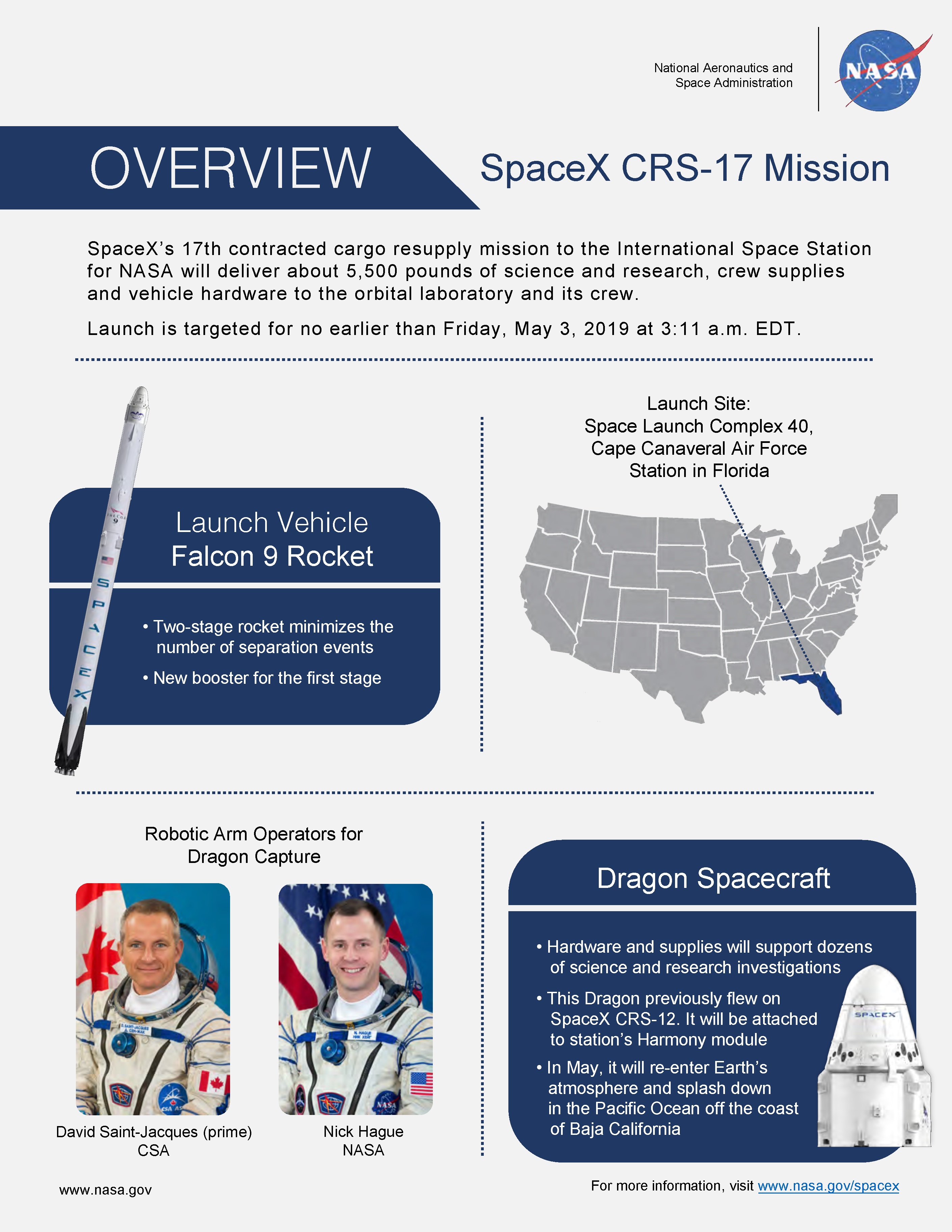

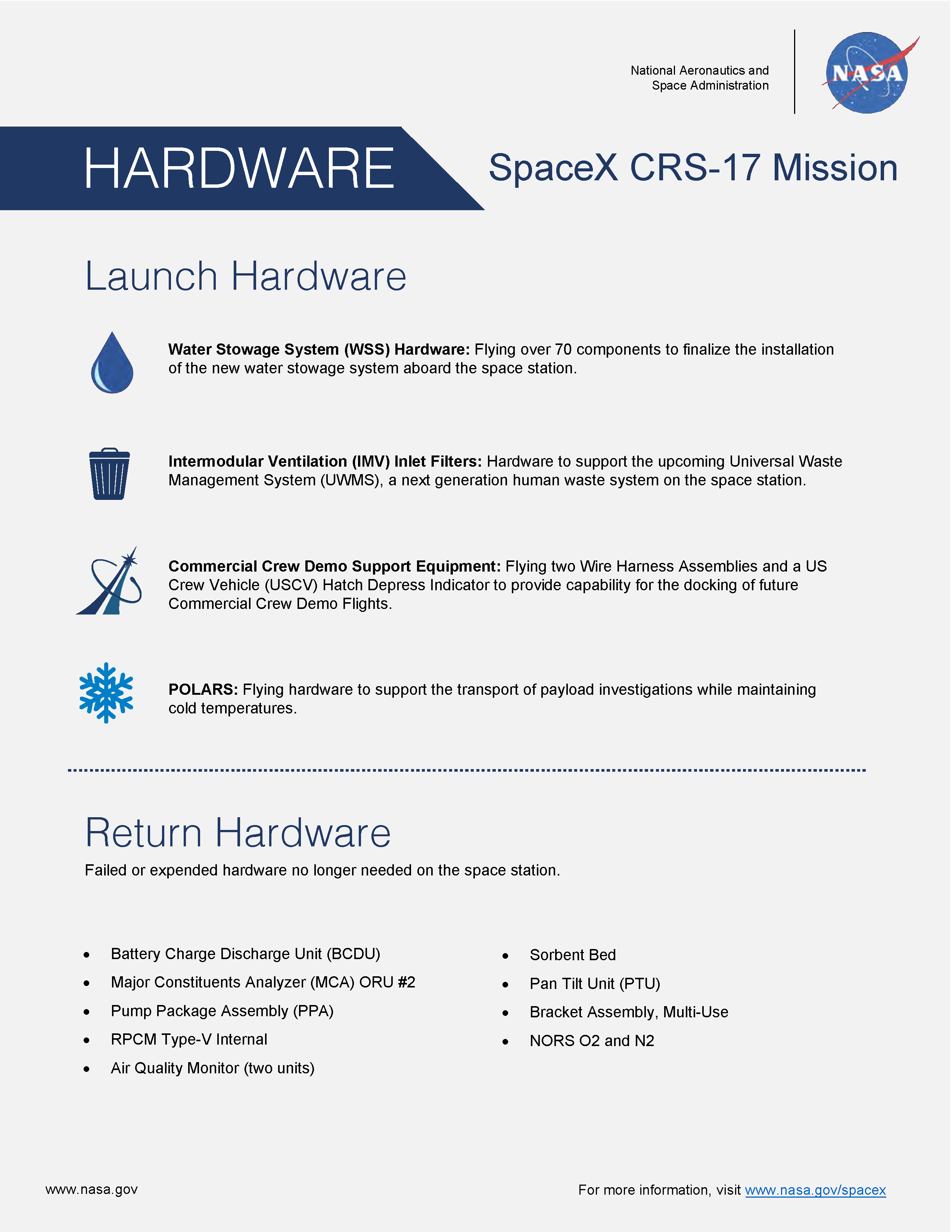
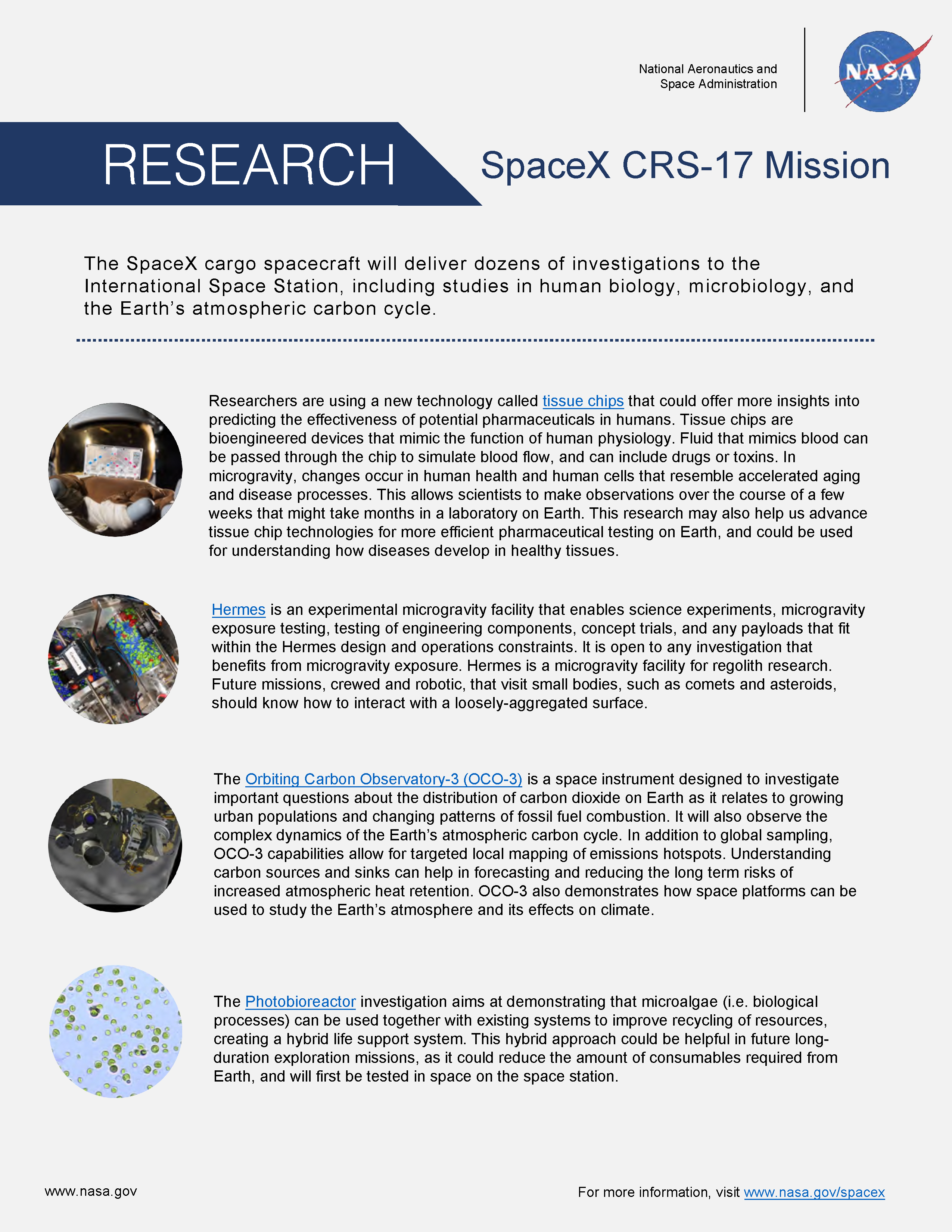
spacex_crs-17_mission_overview.pdf (https://www.nasa.gov/sites/default/files/atoms/files/spacex_crs-17_mission_overview.pdf) - 0.6 MB, 4 стр, 2019-05-01 19:10:51 UTC
Название: Dragon SpX-17 (CRS-17), OCO-3, STP-H6 - Falcon 9-071 (B1056.1) - CCAFS SLC-40 - NET 25.04.2019, 10:20 UTC
Отправлено: tnt22 от 03.05.2019 10:09:27
Отправлено: tnt22 от 03.05.2019 10:09:27
ЦитироватьChris G - NSF @ChrisG_NSF (https://twitter.com/ChrisG_NSF) 7 мин. назад (https://twitter.com/ChrisG_NSF/status/1124207203488075776)
Two issues. Drone Ship unable to maintain power.
AND Helium leak on Quick Disconnect on Stage 2.
Setting up for 24hr recycle at this time.
Название: Dragon SpX-17 (CRS-17), OCO-3, STP-H6 - Falcon 9-071 (B1056.1) - CCAFS SLC-40 - NET 25.04.2019, 10:20 UTC
Отправлено: tnt22 от 03.05.2019 10:12:40
Отправлено: tnt22 от 03.05.2019 10:12:40
ЦитироватьChris G - NSF @ChrisG_NSF (https://twitter.com/ChrisG_NSF) 9 мин. назад (https://twitter.com/ChrisG_NSF/status/1124207372489101313)
Tomorrow's launch time is 02:48 EDT (0648 UTC).
Название: Dragon SpX-17 (CRS-17), OCO-3, STP-H6 - Falcon 9-071 (B1056.1) - CCAFS SLC-40 - NET 25.04.2019, 10:20 UTC
Отправлено: tnt22 от 03.05.2019 10:16:49
Отправлено: tnt22 от 03.05.2019 10:16:49
ЦитироватьSpaceXПодлинная учетная запись @SpaceX (https://twitter.com/SpaceX) 51 сек. назад (https://twitter.com/SpaceX/status/1124210054478028800)
Standing down today due to an electrical issue on the Of Course I Still Love You droneship.
Teams will also address the ground side helium leak before tomorrow's backup launch opportunity at 2:48 a.m. EDT, 6:48 UTC.
Название: Dragon SpX-17 (CRS-17), OCO-3, STP-H6 - Falcon 9-071 (B1056.1) - CCAFS SLC-40 - NET 25.04.2019, 10:20 UTC
Отправлено: tnt22 от 03.05.2019 10:19:18
Отправлено: tnt22 от 03.05.2019 10:19:18
ЦитироватьWilliam Harwood @cbs_spacenews (https://twitter.com/cbs_spacenews) 14 мин. назад (https://twitter.com/cbs_spacenews/status/1124208321429483520)
F9/CRS-17: If weather or technical issues prevent takeoff Saturday, the launch will slip to no earlier than May 12 because of other activities on the Air Force Eastern Range.
Название: Dragon SpX-17 (CRS-17), OCO-3, STP-H6 - Falcon 9-071 (B1056.1) - CCAFS SLC-40 - NET 25.04.2019, 10:20 UTC
Отправлено: tnt22 от 03.05.2019 10:23:08
Отправлено: tnt22 от 03.05.2019 10:23:08
Цитировать05/03/2019 10:12 Stephen Clark
SpaceX plans to lower the Falcon 9 rocket horizontal later today to address a helium leak on a connector on the launcher's second stage. The Falcon 9 launch conductor said the next launch attempt will come Saturday.
Saturday's instantaneous launch opportunity is set for 2:48:58 a.m. EDT (0648:58 GMT).
Название: Dragon SpX-17 (CRS-17), OCO-3, STP-H6 - Falcon 9-071 (B1056.1) - CCAFS SLC-40 - NET 25.04.2019, 10:20 UTC
Отправлено: tnt22 от 03.05.2019 10:27:08
Отправлено: tnt22 от 03.05.2019 10:27:08
ЦитироватьChris G - NSF @ChrisG_NSF (https://twitter.com/ChrisG_NSF) 8 мин. назад (https://twitter.com/ChrisG_NSF/status/1124211318603616257)
If launch occurs tomorrow, 4 May, launch will be at 02:48:58 EDT. Checking on when berthing would be for new launch date.
Название: Dragon SpX-17 (CRS-17), OCO-3, STP-H6 - Falcon 9-071 (B1056.1) - CCAFS SLC-40 - NET 25.04.2019, 10:20 UTC
Отправлено: tnt22 от 03.05.2019 10:45:04
Отправлено: tnt22 от 03.05.2019 10:45:04
https://ria.ru/20190503/1553240332.html
ЦитироватьЗапуск ракеты Falcon 9 с кораблем Dragon к МКС перенесли на субботу
10:19
МОСКВА, 3 мая - РИА Новости. Запуск ракеты-носителя Falcon 9 с космическим кораблем Dragon, который должен доставить груз на Международную космическую станцию (МКС), отложен, следующая попытка состоится в субботу, сообщает космический центр имени Кеннеди, принадлежащий НАСА.
"Сегодня запуск отменен. Присоединяйтесь к нам в 2.48 по времени EDT (9.48 мск), (чтобы следить) за попыткой запуска", - говорится в официальном Twitter (https://twitter.com/NASA/status/1124210989283414016)-аккаунте центра.
Как сообщила компания SpaceX, запуск ракеты был отменен "из-за проблем с электрооборудованием на беспилотном корабле Of Course I Still Love You", плавучей платформе, на которую должна была совершить посадку первая ступень ракеты.
Старт корабля должен был состояться ранее на этой неделе, но был отложен на пятницу из-за неполадок электросистемы МКС, которая потребовала замены вышедшего из строя элемента. Как сообщили в НАСА в четверг, проблема была устранена, препятствий к запуску грузового корабля нет. Ранее сообщалось, что в случае отмены старта в пятницу, попытка запуска повторится в субботу.
Название: Dragon SpX-17 (CRS-17), OCO-3, STP-H6 - Falcon 9-071 (B1056.1) - CCAFS SLC-40 - NET 25.04.2019, 10:20 UTC
Отправлено: tnt22 от 03.05.2019 10:48:58
Отправлено: tnt22 от 03.05.2019 10:48:58
https://blogs.nasa.gov/spacex/2019/05/03/drone-ship-power-issue-forces-scrub-of-crs-17-launch/
ЦитироватьDrone Ship Power Issue Forces Scrub of CRS-17 Launch
James Cawley (https://blogs.nasa.gov/spacex/author/jjcawley/)
Posted May 3, 2019 at 3:16 am
This morning's launch attempt has scrubbed due to a drone ship power issue. The next launch opportunity will be at 2:48 a.m. EDT Saturday, May 4.
Launch coverage for the SpaceX CRS-17 mission to the International Space Station will begin at 2:30 a.m. EDT on NASA Television and the agency's website (http://www.nasa.gov/live). A launch of the SpaceX cargo Dragon spacecraft on Saturday will result in its arrival at the space station on Monday, May 6.
Название: Dragon SpX-17 (CRS-17), OCO-3, STP-H6 - Falcon 9-071 (B1056.1) - CCAFS SLC-40 - NET 25.04.2019, 10:20 UTC
Отправлено: tnt22 от 03.05.2019 17:09:08
Отправлено: tnt22 от 03.05.2019 17:09:08
ЦитироватьJustin CampbellПодлинная учетная запись @JCampbellNews6 (https://twitter.com/JCampbellNews6) 3 ч. назад (https://twitter.com/JCampbellNews6/status/1124274945289330688)
SpaceX Drone pad "Of Course I Still Love You" coming back to Port Canaveral after electrical issues this morning
Video (https://twitter.com/i/videos/tweet/1124274945289330688) (0:10)
Название: Dragon SpX-17 (CRS-17), OCO-3, STP-H6 - Falcon 9-071 (B1056.1) - CCAFS SLC-40 - NET 25.04.2019, 10:20 UTC
Отправлено: tnt22 от 03.05.2019 17:16:49
Отправлено: tnt22 от 03.05.2019 17:16:49
Прогноз погоды L-1 (на 4 мая)
L-1 Forecast 4 May Launch (https://www.patrick.af.mil/Portals/14/Weather/L-1%20Forecast%204%20May%2019%20Launch.pdf?ver=2019-05-03-034555-250)
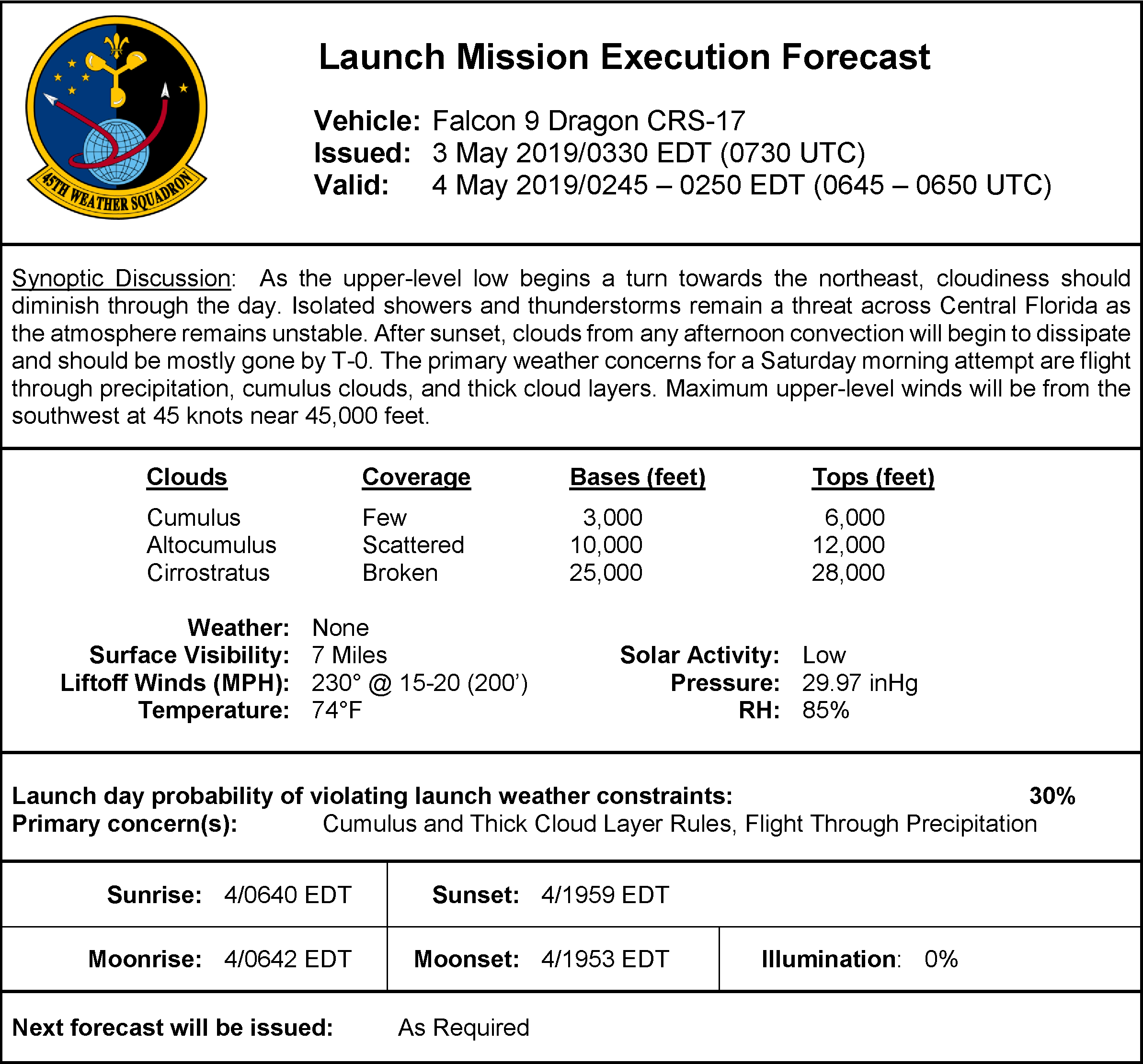
Пусковой день (04.05) - 70 % GO
Резерв - нет - полигон закрывается на профилактику
L-1 Forecast 4 May Launch (https://www.patrick.af.mil/Portals/14/Weather/L-1%20Forecast%204%20May%2019%20Launch.pdf?ver=2019-05-03-034555-250)
Пусковой день (04.05) - 70 % GO
Резерв - нет - полигон закрывается на профилактику
Название: Dragon SpX-17 (CRS-17), OCO-3, STP-H6 - Falcon 9-071 (B1056.1) - CCAFS SLC-40 - NET 25.04.2019, 10:20 UTC
Отправлено: tnt22 от 03.05.2019 19:30:49
Отправлено: tnt22 от 03.05.2019 19:30:49
ЦитироватьSpace to Ground: The Droids You're Looking For: 05/03/2019https://www.youtube.com/watch?v=c27zrOh6qkYhttps://www.youtube.com/watch?v=c27zrOh6qkY (https://www.youtube.com/watch?v=c27zrOh6qkY) (2:26)
NASA Johnson (https://www.youtube.com/channel/UCmheCYT4HlbFi943lpH009Q)
Опубликовано: 3 мая 2019 г.
Название: Dragon SpX-17 (CRS-17), OCO-3, STP-H6 - Falcon 9-071 (B1056.1) - CCAFS SLC-40 - NET 25.04.2019, 10:20 UTC
Отправлено: tnt22 от 03.05.2019 20:18:51
Отправлено: tnt22 от 03.05.2019 20:18:51
ЦитироватьSpaceXFleet Updates @SpaceXFleet (https://twitter.com/SpaceXFleet) 23 мин. назад (https://twitter.com/SpaceXFleet/status/1124356823384035329)
Troublesome generator being removed from OCISLY...
Название: Dragon SpX-17 (CRS-17), OCO-3, STP-H6 - Falcon 9-071 (B1056.1) - CCAFS SLC-40 - NET 25.04.2019, 10:20 UTC
Отправлено: tnt22 от 03.05.2019 20:30:13
Отправлено: tnt22 от 03.05.2019 20:30:13
ЦитироватьSpaceXFleet Updates @SpaceXFleet (https://twitter.com/SpaceXFleet) 8 мин. назад (https://twitter.com/SpaceXFleet/status/1124363249288384513)
Of Course I Still Love You and the #SpaceXFleet (https://twitter.com/hashtag/SpaceXFleet?src=hash) are about to get underway again from Port Canaveral!ЦитироватьOLHZN Space Balloons #NASASocial #CRS17 @OLHZN (https://twitter.com/OLHZN) 23 мин. назад (https://twitter.com/OLHZN/status/1124359354596167680)
Looks like the tug, #Hollywood (https://twitter.com/hashtag/Hollywood?src=hash) may be preparing to start bringing #OCISLY (https://twitter.com/hashtag/OCISLY?src=hash) back to the landing site for #SpaceX (https://twitter.com/hashtag/SpaceX?src=hash) #CRS17 (https://twitter.com/hashtag/CRS17?src=hash)#NASASocial (https://twitter.com/hashtag/NASASocial?src=hash) @SpaceXFleet (https://twitter.com/SpaceXFleet) #SpaceXFleet (https://twitter.com/hashtag/SpaceXFleet?src=hash)
Название: Dragon SpX-17 (CRS-17), OCO-3, STP-H6 - Falcon 9-071 (B1056.1) - CCAFS SLC-40 - NET 25.04.2019, 10:20 UTC
Отправлено: tnt22 от 03.05.2019 20:31:37
Отправлено: tnt22 от 03.05.2019 20:31:37
ЦитироватьMichael Baylor @nextspaceflight (https://twitter.com/nextspaceflight) 8 мин. назад (https://twitter.com/nextspaceflight/status/1124363898226868225)
OCISLY is departing Port Canaveral after crews swapped out a faulty generator this morning. #SpaceX (https://twitter.com/hashtag/SpaceX?src=hash) looks to be on track for a #CRS17 (https://twitter.com/hashtag/CRS17?src=hash) launch attempt tomorrow morning.
Название: Dragon SpX-17 (CRS-17), OCO-3, STP-H6 - Falcon 9-071 (B1056.1) - CCAFS SLC-40 - NET 25.04.2019, 10:20 UTC
Отправлено: tnt22 от 03.05.2019 20:49:16
Отправлено: tnt22 от 03.05.2019 20:49:16
ЦитироватьGreg Scott @lake_sea_mtns (https://twitter.com/lake_sea_mtns) 6 мин. назад (https://twitter.com/lake_sea_mtns/status/1124368330977157120)
Apparently all issues on OCISLY are fixed. She's pulling out of port at this time behind tug Florida and tug Hollywood in the pouring rain
Название: Dragon SpX-17 (CRS-17), OCO-3, STP-H6 - Falcon 9-071 (B1056.1) - CCAFS SLC-40 - NET 25.04.2019, 10:20 UTC
Отправлено: tnt22 от 03.05.2019 21:03:12
Отправлено: tnt22 от 03.05.2019 21:03:12
ЦитироватьSpaceXFleet Updates @SpaceXFleet (https://twitter.com/SpaceXFleet) 2 мин. назад (https://twitter.com/SpaceXFleet/status/1124373073996713985)
Departure! Hollywood and Of Course I Still Love You have departed Port Canaveral. They are heading 28km downrange, not a long journey at all. Photo via Jetty Park Webcam
Название: Dragon SpX-17 (CRS-17), OCO-3, STP-H6 - Falcon 9-071 (B1056.1) - CCAFS SLC-40 - NET 25.04.2019, 10:20 UTC
Отправлено: tnt22 от 03.05.2019 21:44:00
Отправлено: tnt22 от 03.05.2019 21:44:00
Обновлено расписание трансляцмй НАСА (на 4 и 6 мая)
https://www.nasa.gov/multimedia/nasatv/schedule.html
https://www.nasa.gov/multimedia/nasatv/schedule.html
ЦитироватьNASA Television Upcoming EventsUTC = EDT + 4 h
Watch NASA TV (https://www.nasa.gov/multimedia/nasatv/index.html#public)
All times Eastern
MAY
May 4, Saturday
2:30 a.m. – Coverage of the launch of the SpaceX CRS-17 Dragon Cargo Craft Mission to the International Space Station; launch is scheduled at 2:48 a.m. ET (All Channels)
4 a.m. - SpaceX CRS-17 Post-Launch News Conference (time subject to change) (All Channels)
May 6, Monday
5:30 a.m. - Coverage of the rendezvous and capture of the SpaceX CRS-17 Dragon Cargo Craft at the International Space Station; capture scheduled at 7 a.m. ET (All Channels)
9 a.m. - Coverage of the installation of the SpaceX CRS-17 Dragon Cargo Craft to the International Space Station (All Channels)
Название: Dragon SpX-17 (CRS-17), OCO-3, STP-H6 - Falcon 9-071 (B1056.1) - CCAFS SLC-40 - NET 25.04.2019, 10:20 UTC
Отправлено: tnt22 от 03.05.2019 21:51:13
Отправлено: tnt22 от 03.05.2019 21:51:13
Цитировать05/03/2019 21:41 Stephen Clark(https://photo.24liveblog.com/2242762235231691057/20190503184147_958865.jpg)
An electrical problem on SpaceX's drone ship parked just off the coast of Cape Canaveral prompted SpaceX to scrub a Falcon 9 launch attempt early Friday, delaying the start of a resupply mission to the International Space Station by 24 hours.
The Falcon 9 countdown halted around 14 minutes prior to the rocket's appointed launch time at 3:11 a.m. EDT (0711 GMT) Friday. SpaceX's launch director announced over the countdown net that the company's drone ship — the landing vessel where the Falcon 9's first stage will attempt to land offshore — was unable to maintain power.
SpaceX was also evaluating a helium leak in a quick-disconnect interface at the launch pad, but officials cited the drone ship issue as the reason for Friday's scrubbed launch attempt.
Teams lowered the Falcon 9 rocket horizontal to address the helium leak, while the football field-sized drone ship returned to Port Canaveral later Friday morning, presumably for servicing of the vessel's electrical power system.
The drone ship, named "Of Course I Still Love You," departed Port Canaveral a few hours later Friday afternoon to head back to the Falcon 9 booster's targeted landing site 17 miles (28 kilometers) southeast of the rocket's launch pad, or roughly due east of the easternmost point of Cape Canaveral.
A new launch attempt is scheduled for 2:48:58 a.m. EDT (0648:58 GMT) Saturday to begin a cargo resupply mission set to deliver 5,472 pounds (2,482 kilograms) of logistics, equipment and experiments to the International Space Station and its six-person crew.
Название: Dragon SpX-17 (CRS-17), OCO-3, STP-H6 - Falcon 9-071 (B1056.1) - CCAFS SLC-40 - NET 25.04.2019, 10:20 UTC
Отправлено: tnt22 от 03.05.2019 22:06:46
Отправлено: tnt22 от 03.05.2019 22:06:46
https://blogs.nasa.gov/spacestation/2019/05/03/crew-researches-immunity-response-leading-up-to-next-dragon-launch-attempt/
ЦитироватьCrew Researches Immunity Response Leading Up to Next Dragon Launch Attempt
Catherine Williams (https://blogs.nasa.gov/spacestation/author/cewilli3/)
Posted May 3, 2019 at 2:37 pm
A SpaceX Falcon 9 rocket is in position at Space Launch Complex 40 on Cape Canaveral Air Force Station in Florida, which will boost a Dragon cargo module to the International Space Station on the company's 17th Commercial Resupply Services mission for NASA. Image Credit: NASA
This morning's SpaceX Dragon launch was scrubbed due to a drone ship power issue. Launch coverage for the next attempt begins at 2:30 a.m. EDT Saturday, May 4, for a 2:48 a.m. launch. Viewers can watch it unfold on NASA Television and the agency's website (https://www.nasa.gov/nasalive). This cargo delivery will replenish the International Space Station (https://www.nasa.gov/mission_pages/station/main/index.html) with nearly 5,500 pounds of science, supplies and hardware.
...
Saint-Jacques and Hague spent some time to reviewing training and procedures for when they command the Canadarm2 robotic arm (https://www.nasa.gov/mission_pages/station/structure/elements/mobile-servicing-system.html) to capture the Dragon cargo craft at the International Space Station, which is now scheduled for Monday, May 6, at 7 a.m. following a May 4 launch.
Название: Dragon SpX-17 (CRS-17), OCO-3, STP-H6 - Falcon 9-071 (B1056.1) - CCAFS SLC-40 - NET 25.04.2019, 10:20 UTC
Отправлено: tnt22 от 03.05.2019 22:26:02
Отправлено: tnt22 от 03.05.2019 22:26:02
ЦитироватьSpaceXFleet Updates @SpaceXFleet (https://twitter.com/SpaceXFleet) 8 сек. назад (https://twitter.com/SpaceXFleet/status/1124394649781702658)
GO Quest is departing Port Canaveral in support of tonight's landing attempt.
Название: Dragon SpX-17 (CRS-17), OCO-3, STP-H6 - Falcon 9-071 (B1056.1) - CCAFS SLC-40 - NET 25.04.2019, 10:20 UTC
Отправлено: tnt22 от 03.05.2019 23:21:12
Отправлено: tnt22 от 03.05.2019 23:21:12
ЦитироватьJulia @julia_bergeron (https://twitter.com/julia_bergeron) 18 мин. назад (https://twitter.com/julia_bergeron/status/1124403878311727104)
The @PortCanaveral (https://twitter.com/PortCanaveral) Jetty Park will be opening at 2:00 am on Saturday for the @SpaceX (https://twitter.com/SpaceX) #CRS17 (https://twitter.com/hashtag/CRS17?src=hash) launch attempt. (Yes, I know, FB, but it works)
Название: Dragon SpX-17 (CRS-17), OCO-3, STP-H6 - Falcon 9-071 (B1056.1) - CCAFS SLC-40 - NET 25.04.2019, 10:20 UTC
Отправлено: tnt22 от 04.05.2019 00:35:34
Отправлено: tnt22 от 04.05.2019 00:35:34
ЦитироватьSpaceXFleet Updates @SpaceXFleet (https://twitter.com/SpaceXFleet) 34 мин. назад (https://twitter.com/SpaceXFleet/status/1124418830720221186)
The #SpaceXFleet (https://twitter.com/hashtag/SpaceXFleet?src=hash) are approaching the LZ. Hollywood and the newly-repaired OCISLY are just ahead of GO Quest.
Название: Dragon SpX-17 (CRS-17), OCO-3, STP-H6 - Falcon 9-071 (B1056.1) - CCAFS SLC-40 - NET 25.04.2019, 10:20 UTC
Отправлено: tnt22 от 04.05.2019 01:03:41
Отправлено: tnt22 от 04.05.2019 01:03:41
Флот на позиции
ЦитироватьSpaceXFleet Updates @SpaceXFleet (https://twitter.com/SpaceXFleet) 2 мин. назад (https://twitter.com/SpaceXFleet/status/1124433701008547840)
The #SpaceXFleet (https://twitter.com/hashtag/SpaceXFleet?src=hash) have arrived at the LZ!
8h45m until launch!
Название: Dragon SpX-17 (CRS-17), OCO-3, STP-H6 - Falcon 9-071 (B1056.1) - CCAFS SLC-40 - NET 25.04.2019, 10:20 UTC
Отправлено: tnt22 от 04.05.2019 01:16:27
Отправлено: tnt22 от 04.05.2019 01:16:27
Трансляция SpaceX на 4 мая (обновление)
Цитироватьна сайте SpaceXspacex.com/webcast (http://www.spacex.com/webcast)
или
на ТыТрубеyoutube.com/watch?v=AQFhX5TvP0M (https://www.youtube.com/watch?v=AQFhX5TvP0M)
Название: Dragon SpX-17 (CRS-17), OCO-3, STP-H6 - Falcon 9-071 (B1056.1) - CCAFS SLC-40 - NET 25.04.2019, 10:20 UTC
Отправлено: tnt22 от 04.05.2019 01:33:37
Отправлено: tnt22 от 04.05.2019 01:33:37
Полигон обновил на дату пуска 04.05.2019
Airspace Closure Area (https://www.patrick.af.mil/Portals/14/CRS%2017%20ACA%203%235%2C%20RS%2C%2004%20May%2019.pdf)
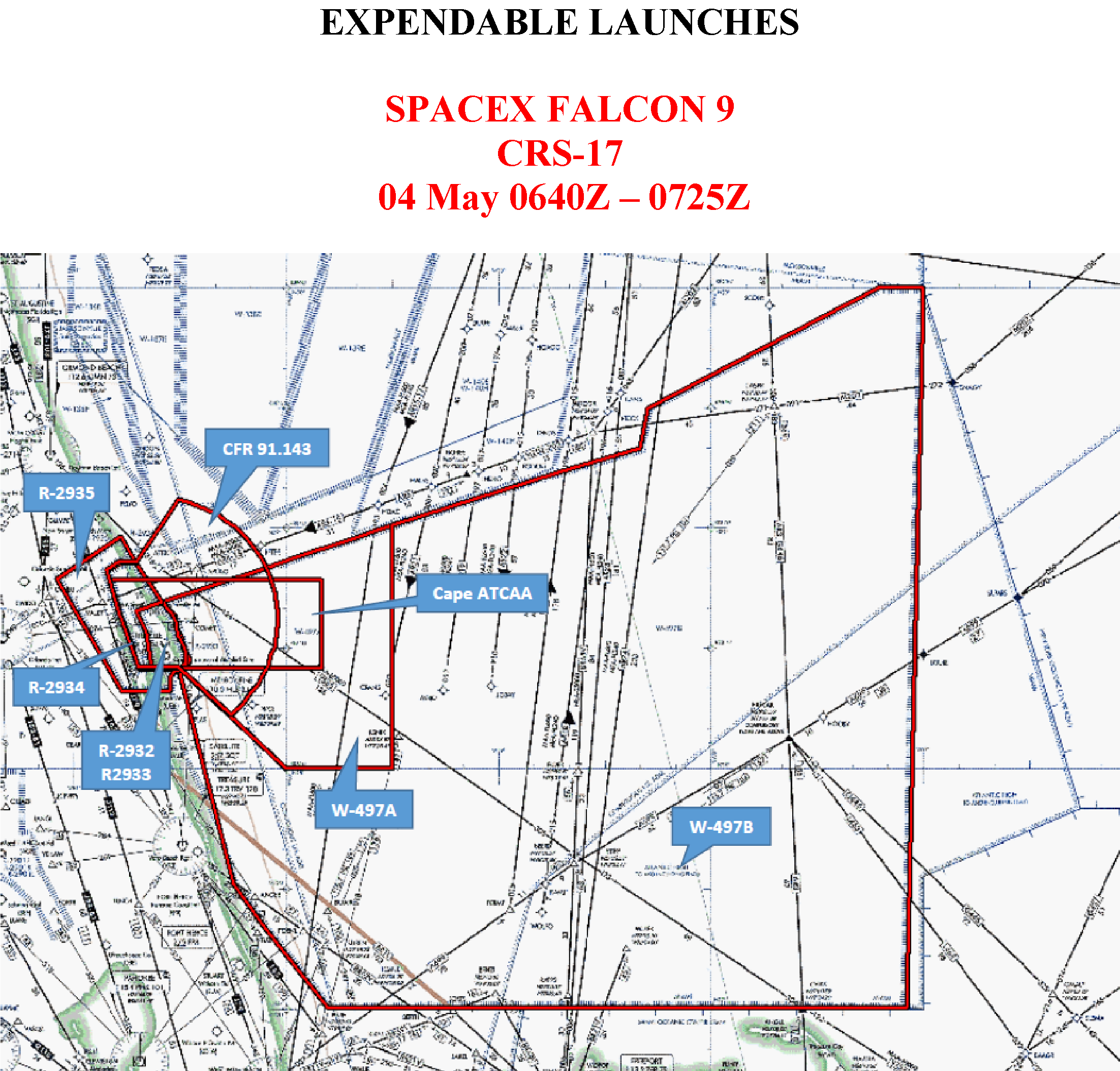
Launch Hazard Area (https://www.patrick.af.mil/Portals/14/CRS%2017%20LHA%202%235%2C%20SEA%2C%20RS%2004%20May%2019.pdf)
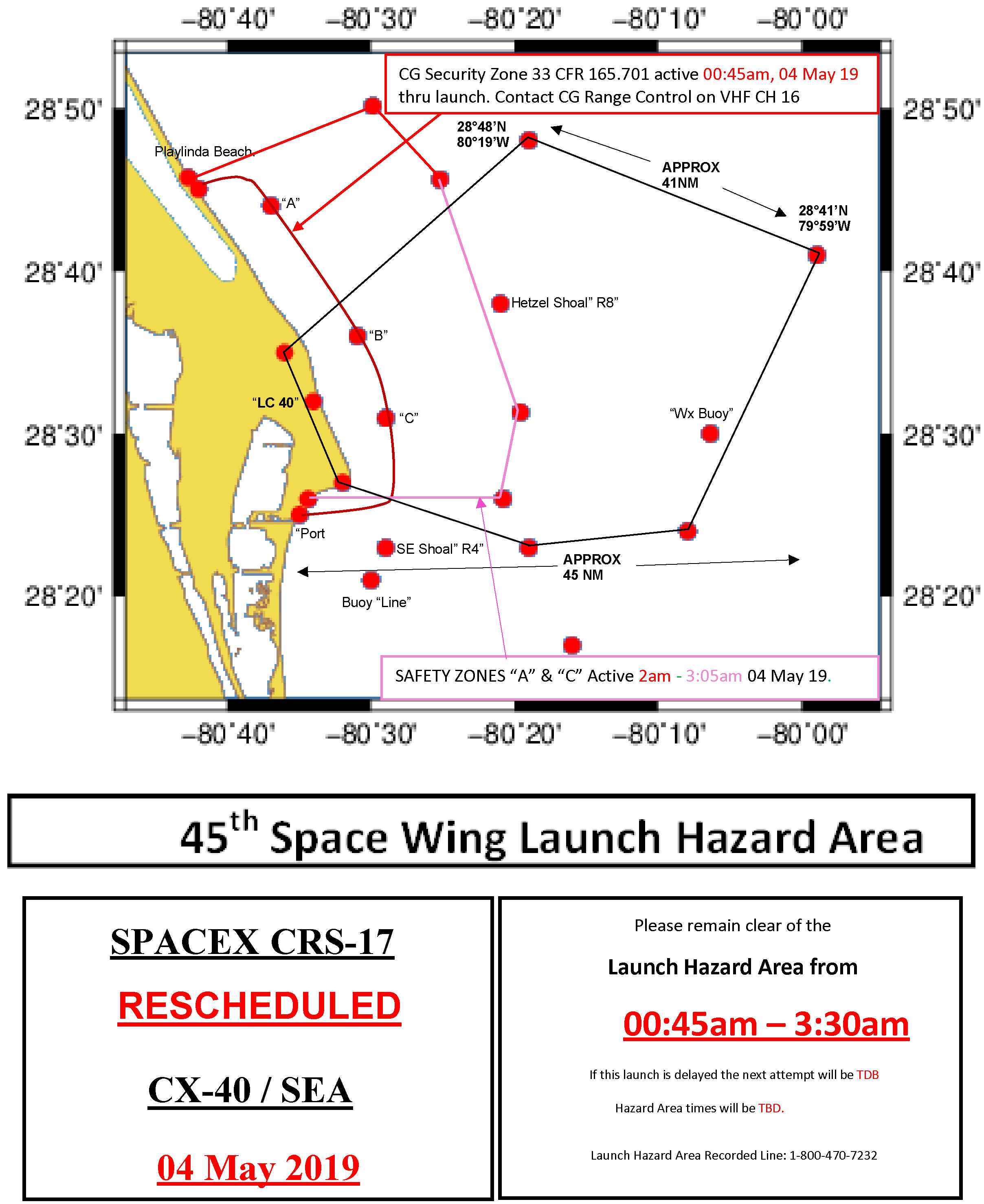
Airspace Closure Area (https://www.patrick.af.mil/Portals/14/CRS%2017%20ACA%203%235%2C%20RS%2C%2004%20May%2019.pdf)
Launch Hazard Area (https://www.patrick.af.mil/Portals/14/CRS%2017%20LHA%202%235%2C%20SEA%2C%20RS%2004%20May%2019.pdf)
Название: Dragon SpX-17 (CRS-17), OCO-3, STP-H6 - Falcon 9-071 (B1056.1) - CCAFS SLC-40 - NET 25.04.2019, 10:20 UTC
Отправлено: tnt22 от 04.05.2019 02:38:10
Отправлено: tnt22 от 04.05.2019 02:38:10
ЦитироватьSpaceXПодлинная учетная запись @SpaceX (https://twitter.com/SpaceX) 16:27 PDT (https://twitter.com/SpaceX/status/1124455478543691782) - 3 мая 2019 г.
All systems are currently go and weather is 70% favorable for launch of Dragon's seventeenth resupply mission on May 4 at 2:48 a.m. EDT, 6:48 UTC.
Название: Dragon SpX-17 (CRS-17), OCO-3, STP-H6 - Falcon 9-071 (B1056.1) - CCAFS SLC-40 - NET 25.04.2019, 10:20 UTC
Отправлено: tnt22 от 04.05.2019 07:13:08
Отправлено: tnt22 от 04.05.2019 07:13:08
https://spaceflightnow.com/2019/05/02/launch-timeline-for-spacexs-17th-space-station-resupply-mission/
ЦитироватьLaunch timeline for SpaceX's 17th space station resupply mission
May 2, 2019 (https://spaceflightnow.com/2019/05/) | Stephen Clark (https://spaceflightnow.com/author/stephen-clark/)
SpaceX's Falcon 9 rocket will go from Cape Canaveral to low Earth orbit in less than 10 minutes Saturday with a Dragon capsule heading for the International Space Station carrying nearly 5,500 pounds of supplies and experiments.
Liftoff is set for 0648 GMT (2:48 a.m. EDT) Saturday from Cape Canaveral's Complex 40 launch pad.
It will be the 70th flight of a Falcon 9 rocket, and SpaceX's fifth launch of the year. Working under contract to NASA, Saturday's launch will be the 17th of least 26 SpaceX resupply missions to depart for the space station under two separate cargo transportation contracts.
The illustrated timeline below outlines the launch sequence for the Falcon 9 flight with the Dragon spacecraft. It does not include times for the descent and landing of the first stage booster on SpaceX's drone ship around 17 miles (28 kilometers) southeast of pad 40.
Three ignitions of the first stage engines after separation will steer the booster back toward Florida's Space Coast from the northeast. Here are key times for the landing maneuvers:[/li]
Touchdown on SpaceX's drone ship "Of Course I Still Love You" should occur during a landing burn with only the first stage's center Merlin 1D engine firing.- T+plus 2 minutes, 34 seconds: First stage boost-back burn begins
- T+plus 6 minutes, 39 seconds: First stage entry burn begins
- T+plus 8 minutes, 27 seconds: First stage landing
Спойлер
T-0:00:00: Liftoff
After the rocket's nine Merlin engines pass an automated health check, hold-down clamps will release the Falcon 9 booster for liftoff from pad 40.
T+0:01:12: Max Q(https://img.novosti-kosmonavtiki.ru/143766.jpg)
The Falcon 9 rocket reaches Max Q, the point of maximum aerodynamic pressure.
T+0:02:17: MECO(https://img.novosti-kosmonavtiki.ru/31294.jpg)
The Falcon 9's nine Merlin 1D engines shut down.
T+0:02:21: Stage 1 Separation(https://img.novosti-kosmonavtiki.ru/31295.jpg)
The Falcon 9's first stage separates from the second stage moments after MECO.
T+0:02:28: Second Stage Ignition(https://img.novosti-kosmonavtiki.ru/143769.jpg)
The second stage Merlin 1D vacuum engine ignites for an approximately six-minute burn to put the Dragon spacecraft into orbit.
T+0:08:39: SECO(https://img.novosti-kosmonavtiki.ru/143770.jpg)
The second stage of the Falcon 9 rocket shuts down after reaching a elliptical target orbit at an inclination of 51.6 degrees. The second stage will later reignite for a de-orbit burn, falling back into the atmosphere for a destructive re-entry.
T+0:09:38: Dragon Separation(https://img.novosti-kosmonavtiki.ru/143771.jpg)
The Dragon spacecraft separates from the Falcon 9 rocket's second stage.
T+0:12:08: Solar Arrays Deployed(https://img.novosti-kosmonavtiki.ru/143772.jpg)
The Dragon spacecraft's two solar array wings extend one-at-a-time to a span of 54 feet (16.5 meters).[свернуть]
Название: Dragon SpX-17 (CRS-17), OCO-3, STP-H6 - Falcon 9-071 (B1056.1) - CCAFS SLC-40 - NET 25.04.2019, 10:20 UTC
Отправлено: tnt22 от 04.05.2019 07:54:17
Отправлено: tnt22 от 04.05.2019 07:54:17
Цитировать05/04/2019 07:43 Stephen Clark(https://photo.24liveblog.com/2242762235231691057/20190504044319_926258.jpg)
Название: Dragon SpX-17 (CRS-17), OCO-3, STP-H6 - Falcon 9-071 (B1056.1) - CCAFS SLC-40 - NET 25.04.2019, 10:20 UTC
Отправлено: tnt22 от 04.05.2019 08:36:47
Отправлено: tnt22 от 04.05.2019 08:36:47
ЦитироватьChris G - NSF @ChrisG_NSF (https://twitter.com/ChrisG_NSF) 3 мин. назад (https://twitter.com/ChrisG_NSF/status/1124547547815653377)
T-1hr 15mins. All proceeding well at this time.
Название: Dragon SpX-17 (CRS-17), OCO-3, STP-H6 - Falcon 9-071 (B1056.1) - CCAFS SLC-40 - NET 25.04.2019, 10:20 UTC
Отправлено: tnt22 от 04.05.2019 09:04:58
Отправлено: tnt22 от 04.05.2019 09:04:58
Название: Dragon SpX-17 (CRS-17), OCO-3, STP-H6 - Falcon 9-071 (B1056.1) - CCAFS SLC-40 - NET 25.04.2019, 10:20 UTC
Отправлено: tnt22 от 04.05.2019 09:13:33
Отправлено: tnt22 от 04.05.2019 09:13:33
Цитировать05/04/2019 09:13 Stephen Clark
SpaceX's launch conductor has polled his team, and all stations are "go" to begin filling the Falcon 9 rocket with propellants.
Название: Dragon SpX-17 (CRS-17), OCO-3, STP-H6 - Falcon 9-071 (B1056.1) - CCAFS SLC-40 - NET 25.04.2019, 10:20 UTC
Отправлено: tnt22 от 04.05.2019 09:15:12
Отправлено: tnt22 от 04.05.2019 09:15:12
Цитировать05/04/2019 09:14 Stephen Clark
T-minus 35 minutes and counting. "Launch auto sequence has started."
The beginning of the launch autosequence kicks off the first steps to begin pumping propellants into the 213-foot-tall Falcon 9 at pad 40 at Cape Canaveral Air Force Station.
RP-1 kerosene and liquid oxygen are now being pumped into the Falcon 9 rocket. The liquid oxygen is chilled to near minus 340 degrees Fahrenheit (minus 206 degrees Celsius).
Название: Dragon SpX-17 (CRS-17), OCO-3, STP-H6 - Falcon 9-071 (B1056.1) - CCAFS SLC-40 - NET 25.04.2019, 10:20 UTC
Отправлено: us2-star от 04.05.2019 08:18:52
Отправлено: us2-star от 04.05.2019 08:18:52
https://www.youtube.com/watch?v=JPAhGFrcQ34 (https://www.youtube.com/watch?v=JPAhGFrcQ34)
https://www.youtube.com/watch?v=JPAhGFrcQ34
https://www.youtube.com/watch?v=R3NHqN5Zf2Y (https://www.youtube.com/watch?v=R3NHqN5Zf2Y)
https://www.youtube.com/watch?v=R3NHqN5Zf2Y
https://www.youtube.com/watch?v=JPAhGFrcQ34
https://www.youtube.com/watch?v=R3NHqN5Zf2Y (https://www.youtube.com/watch?v=R3NHqN5Zf2Y)
https://www.youtube.com/watch?v=R3NHqN5Zf2Y
Название: Dragon SpX-17 (CRS-17), OCO-3, STP-H6 - Falcon 9-071 (B1056.1) - CCAFS SLC-40 - NET 25.04.2019, 10:20 UTC
Отправлено: tnt22 от 04.05.2019 09:22:45
Отправлено: tnt22 от 04.05.2019 09:22:45
ЦитироватьChris G - NSF @ChrisG_NSF (https://twitter.com/ChrisG_NSF) 4 мин. назад (https://twitter.com/ChrisG_NSF/status/1124558973825425408)
Weather odds now 90% favorable... and there are currently NO constraints being worked.
Название: Dragon SpX-17 (CRS-17), OCO-3, STP-H6 - Falcon 9-071 (B1056.1) - CCAFS SLC-40 - NET 25.04.2019, 10:20 UTC
Отправлено: tnt22 от 04.05.2019 09:24:53
Отправлено: tnt22 от 04.05.2019 09:24:53
Цитировать05/04/2019 09:23 Stephen Clark
The second stage cryogenic helium load is active.
Название: Dragon SpX-17 (CRS-17), OCO-3, STP-H6 - Falcon 9-071 (B1056.1) - CCAFS SLC-40 - NET 25.04.2019, 10:20 UTC
Отправлено: tnt22 от 04.05.2019 09:26:55
Отправлено: tnt22 от 04.05.2019 09:26:55
Название: Dragon SpX-17 (CRS-17), OCO-3, STP-H6 - Falcon 9-071 (B1056.1) - CCAFS SLC-40 - NET 25.04.2019, 10:20 UTC
Отправлено: tnt22 от 04.05.2019 09:29:48
Отправлено: tnt22 от 04.05.2019 09:29:48
Цитировать05/04/2019 09:28 Stephen Clark
Loading of RP-1 kerosene fuel into the Falcon 9's second stage is complete. Liquid oxygen loading into the second stage will begin in around three minutes.
Название: Dragon SpX-17 (CRS-17), OCO-3, STP-H6 - Falcon 9-071 (B1056.1) - CCAFS SLC-40 - NET 25.04.2019, 10:20 UTC
Отправлено: tnt22 от 04.05.2019 09:35:46
Отправлено: tnt22 от 04.05.2019 09:35:46
Название: Dragon SpX-17 (CRS-17), OCO-3, STP-H6 - Falcon 9-071 (B1056.1) - CCAFS SLC-40 - NET 25.04.2019, 10:20 UTC
Отправлено: tnt22 от 04.05.2019 09:35:50
Отправлено: tnt22 от 04.05.2019 09:35:50
Название: Dragon SpX-17 (CRS-17), OCO-3, STP-H6 - Falcon 9-071 (B1056.1) - CCAFS SLC-40 - NET 25.04.2019, 10:20 UTC
Отправлено: tnt22 от 04.05.2019 09:36:27
Отправлено: tnt22 от 04.05.2019 09:36:27
Название: Dragon SpX-17 (CRS-17), OCO-3, STP-H6 - Falcon 9-071 (B1056.1) - CCAFS SLC-40 - NET 25.04.2019, 10:20 UTC
Отправлено: tnt22 от 04.05.2019 09:36:37
Отправлено: tnt22 от 04.05.2019 09:36:37
Название: Dragon SpX-17 (CRS-17), OCO-3, STP-H6 - Falcon 9-071 (B1056.1) - CCAFS SLC-40 - NET 25.04.2019, 10:20 UTC
Отправлено: tnt22 от 04.05.2019 09:36:52
Отправлено: tnt22 от 04.05.2019 09:36:52
Название: Dragon SpX-17 (CRS-17), OCO-3, STP-H6 - Falcon 9-071 (B1056.1) - CCAFS SLC-40 - NET 25.04.2019, 10:20 UTC
Отправлено: tnt22 от 04.05.2019 09:43:49
Отправлено: tnt22 от 04.05.2019 09:43:49
ЦитироватьChris G - NSF @ChrisG_NSF (https://twitter.com/ChrisG_NSF) 3 мин. назад (https://twitter.com/ChrisG_NSF/status/1124564104629424129)
T-10mins. All going well. No issues at this time.
Название: Dragon SpX-17 (CRS-17), OCO-3, STP-H6 - Falcon 9-071 (B1056.1) - CCAFS SLC-40 - NET 25.04.2019, 10:20 UTC
Отправлено: tnt22 от 04.05.2019 09:44:29
Отправлено: tnt22 от 04.05.2019 09:44:29
Название: Dragon SpX-17 (CRS-17), OCO-3, STP-H6 - Falcon 9-071 (B1056.1) - CCAFS SLC-40 - NET 25.04.2019, 10:20 UTC
Отправлено: tnt22 от 04.05.2019 09:46:20
Отправлено: tnt22 от 04.05.2019 09:46:20
Цитировать05/04/2019 09:45 Stephen Clark
The strongback structure at pad 40 has retracted to a position around 1.5 degrees from the Falcon 9 rocket.
Название: Dragon SpX-17 (CRS-17), OCO-3, STP-H6 - Falcon 9-071 (B1056.1) - CCAFS SLC-40 - NET 25.04.2019, 10:20 UTC
Отправлено: tnt22 от 04.05.2019 09:48:31
Отправлено: tnt22 от 04.05.2019 09:48:31
Пуск!!!

Название: Dragon SpX-17 (CRS-17), OCO-3, STP-H6 - Falcon 9-071 (B1056.1) - CCAFS SLC-40 - NET 25.04.2019, 10:20 UTC
Отправлено: tnt22 от 04.05.2019 09:49:56
Отправлено: tnt22 от 04.05.2019 09:49:56
MaxQ
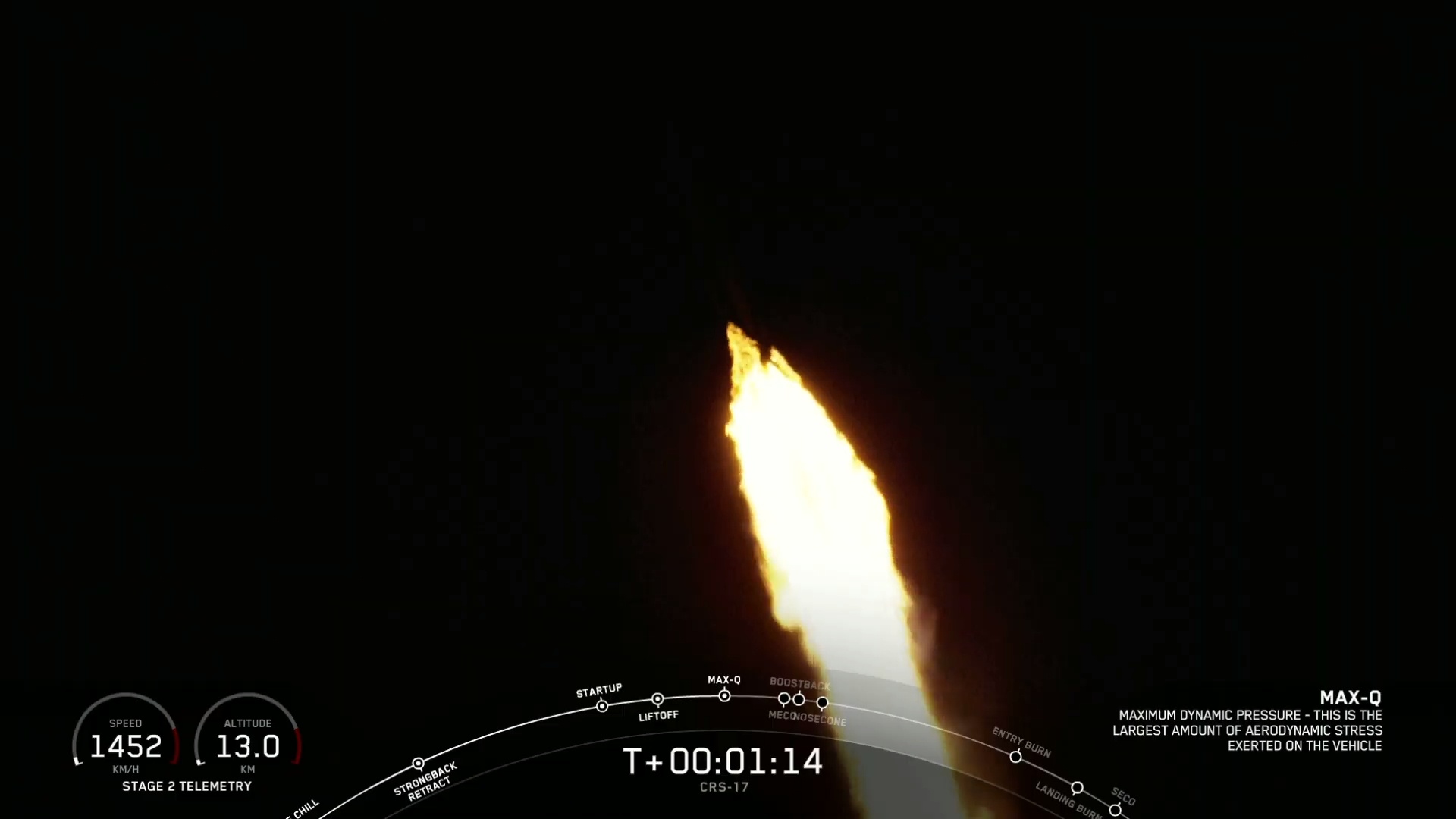
Название: Dragon SpX-17 (CRS-17), OCO-3, STP-H6 - Falcon 9-071 (B1056.1) - CCAFS SLC-40 - NET 25.04.2019, 10:20 UTC
Отправлено: tnt22 от 04.05.2019 09:52:26
Отправлено: tnt22 от 04.05.2019 09:52:26
Отделение 1-й ст РН
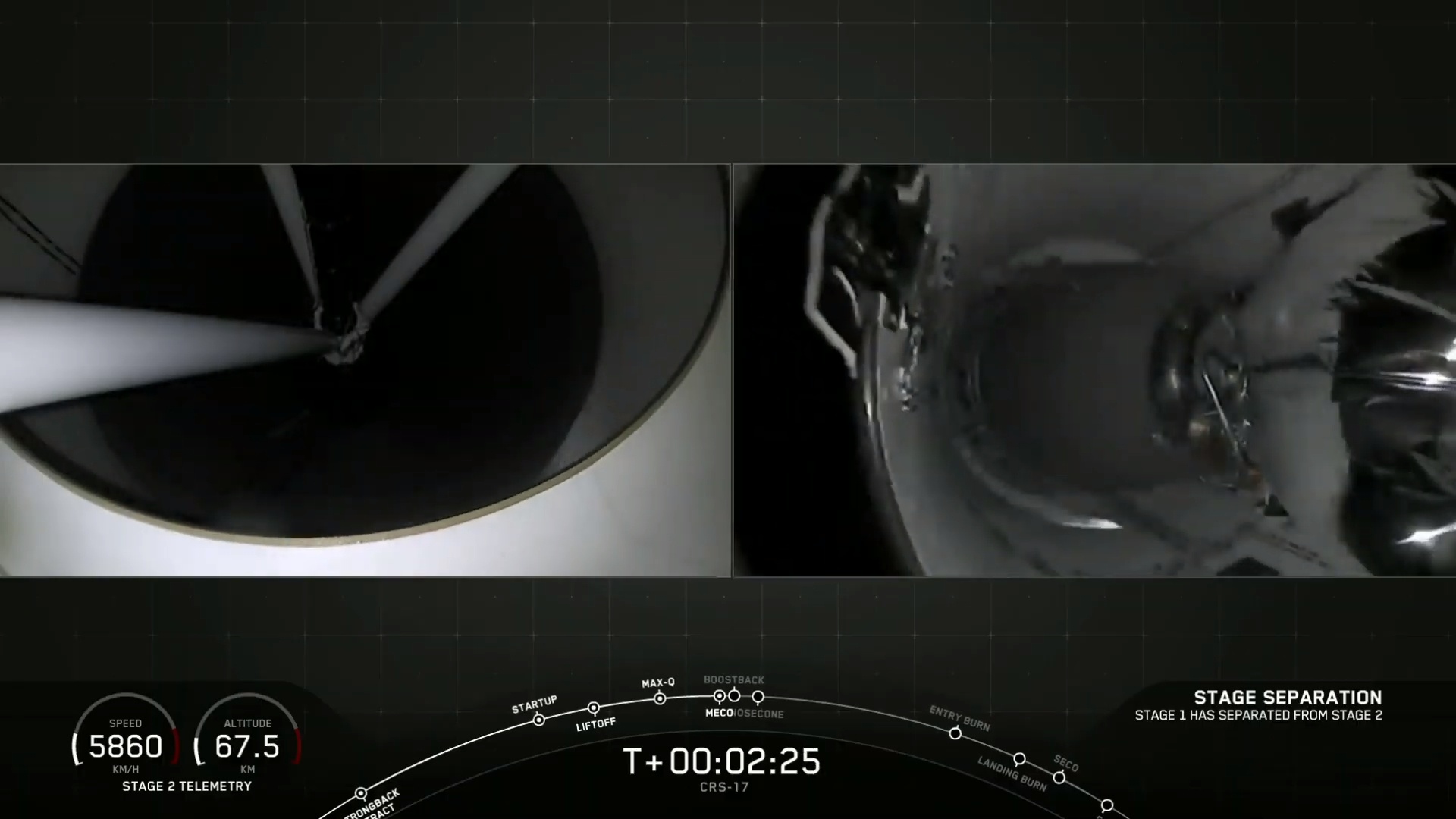
Название: Dragon SpX-17 (CRS-17), OCO-3, STP-H6 - Falcon 9-071 (B1056.1) - CCAFS SLC-40 - NET 25.04.2019, 10:20 UTC
Отправлено: tnt22 от 04.05.2019 09:54:29
Отправлено: tnt22 от 04.05.2019 09:54:29
Вкл ДУ 2-й ст РН
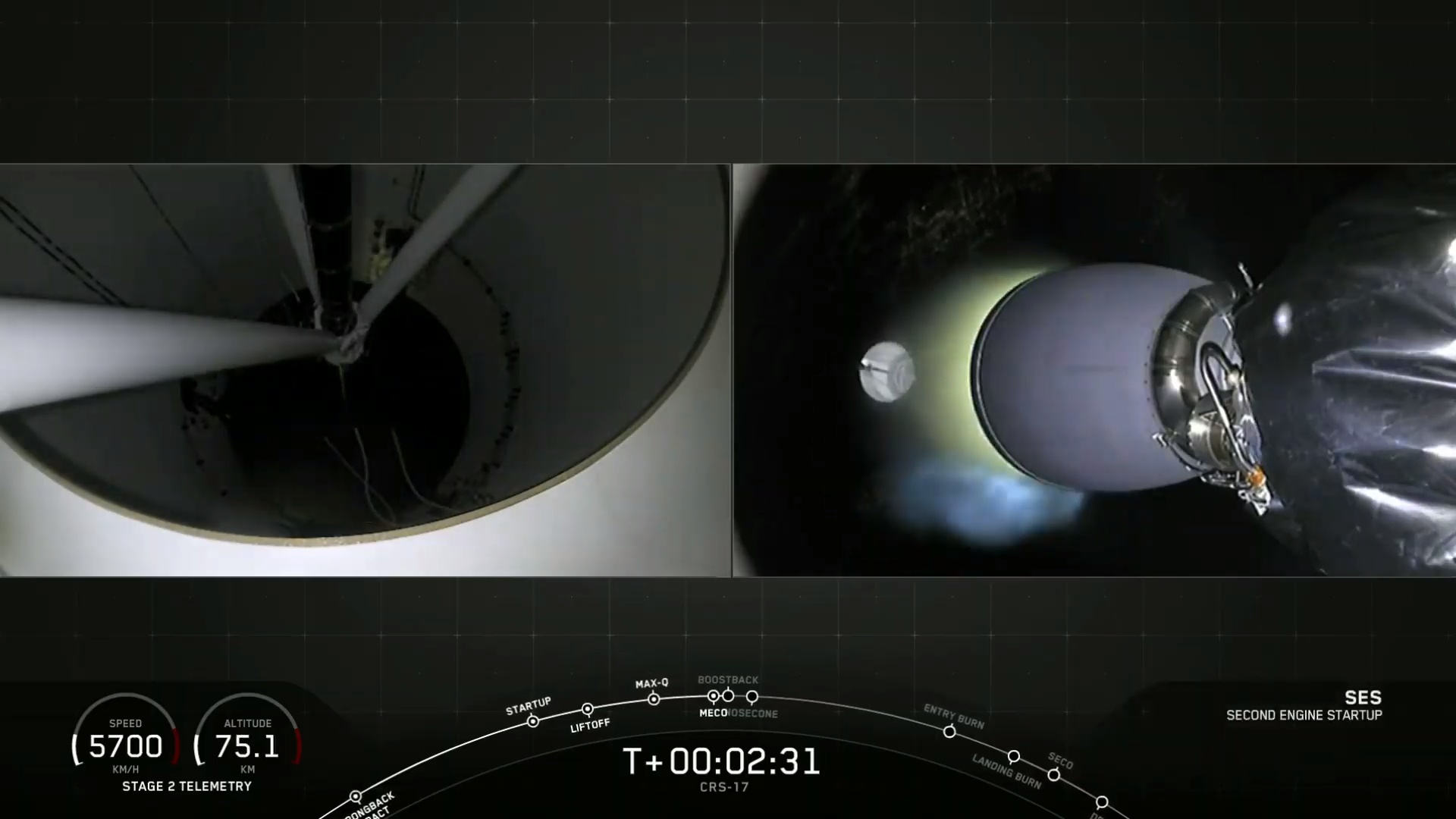
Название: Dragon SpX-17 (CRS-17), OCO-3, STP-H6 - Falcon 9-071 (B1056.1) - CCAFS SLC-40 - NET 25.04.2019, 10:20 UTC
Отправлено: tnt22 от 04.05.2019 10:07:00
Отправлено: tnt22 от 04.05.2019 10:07:00
Entry burn
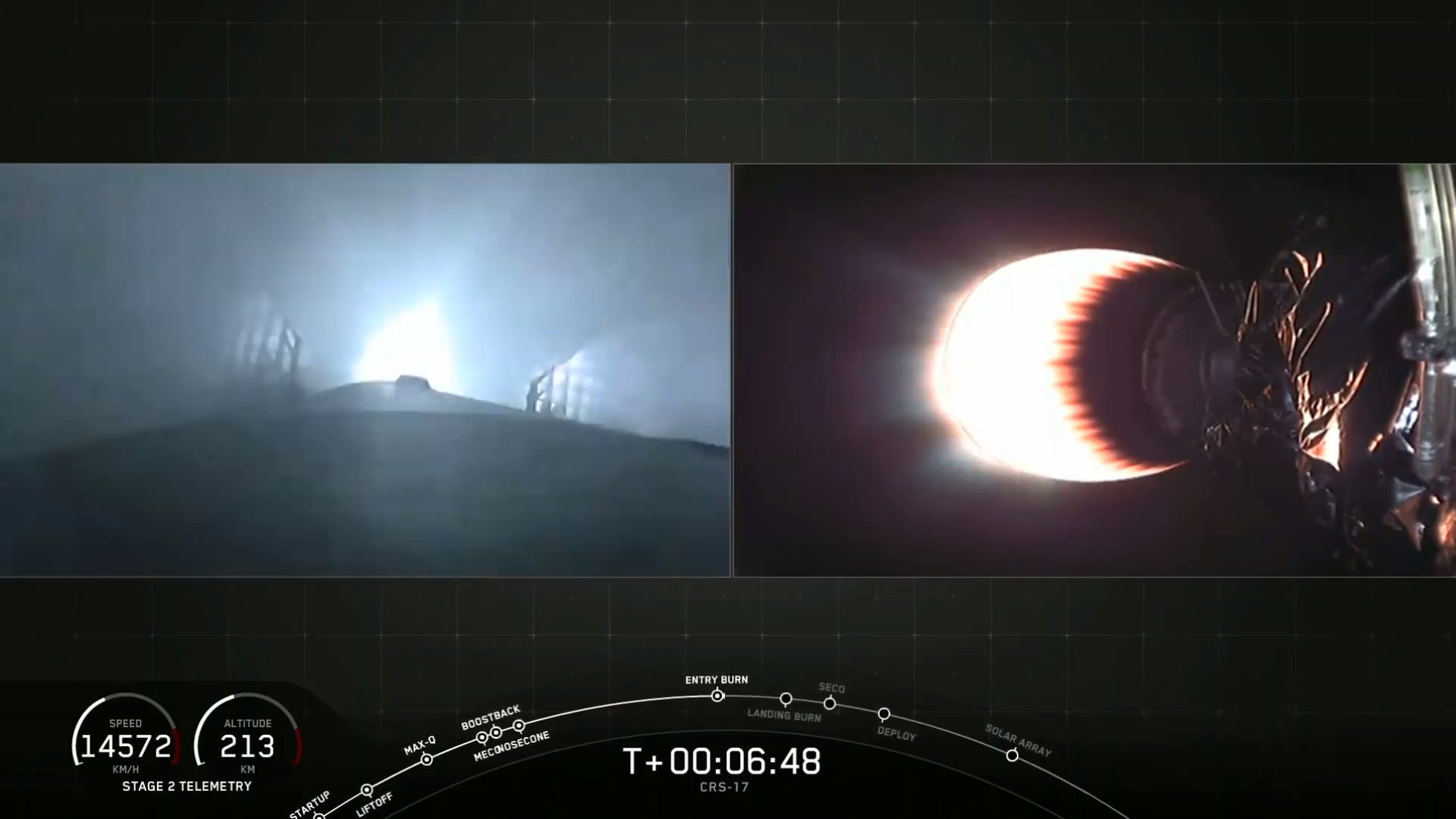
Название: Dragon SpX-17 (CRS-17), OCO-3, STP-H6 - Falcon 9-071 (B1056.1) - CCAFS SLC-40 - NET 25.04.2019, 10:20 UTC
Отправлено: tnt22 от 04.05.2019 10:10:49
Отправлено: tnt22 от 04.05.2019 10:10:49
Посадка 1-й ст РН на морскую платформу
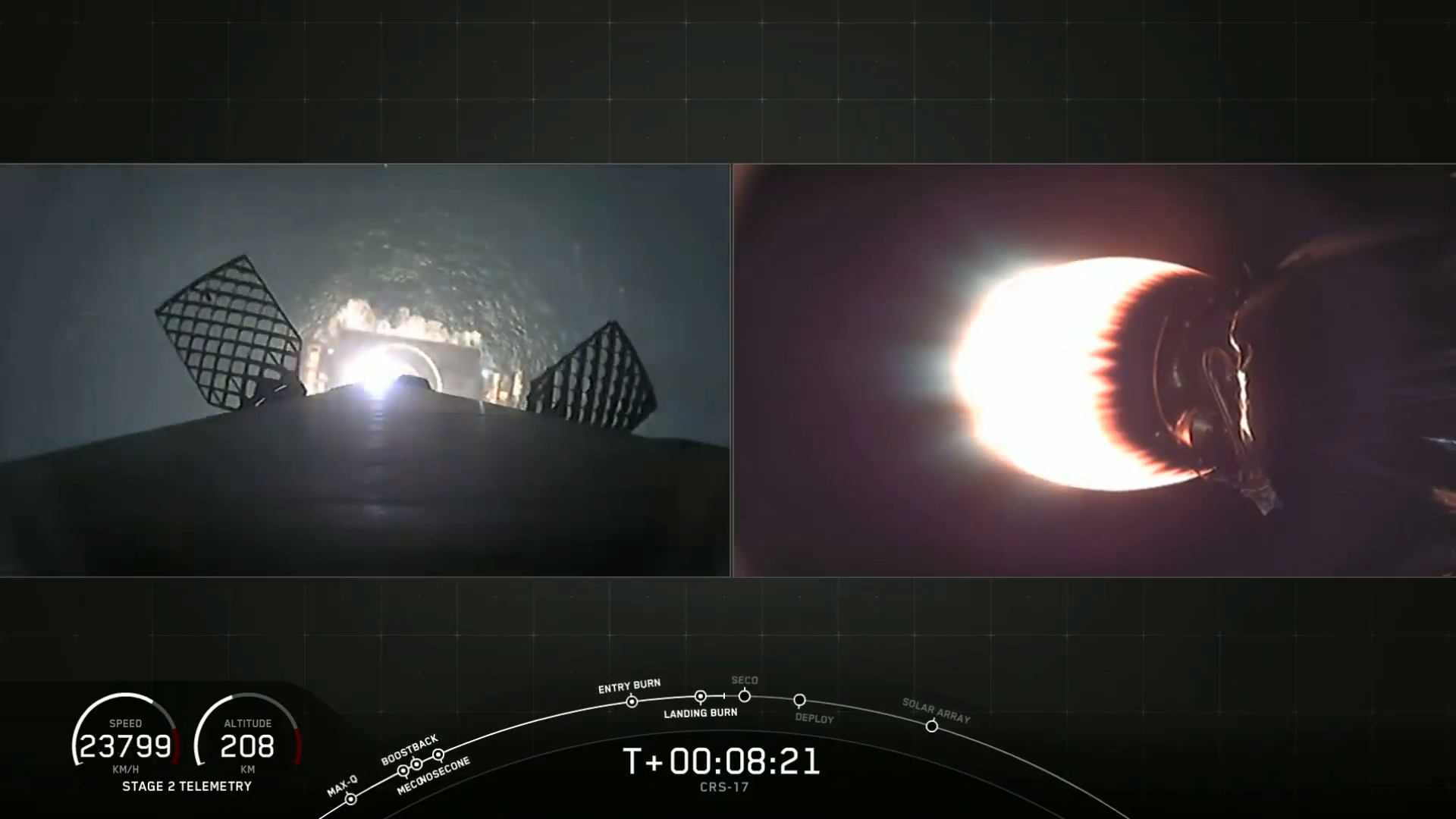
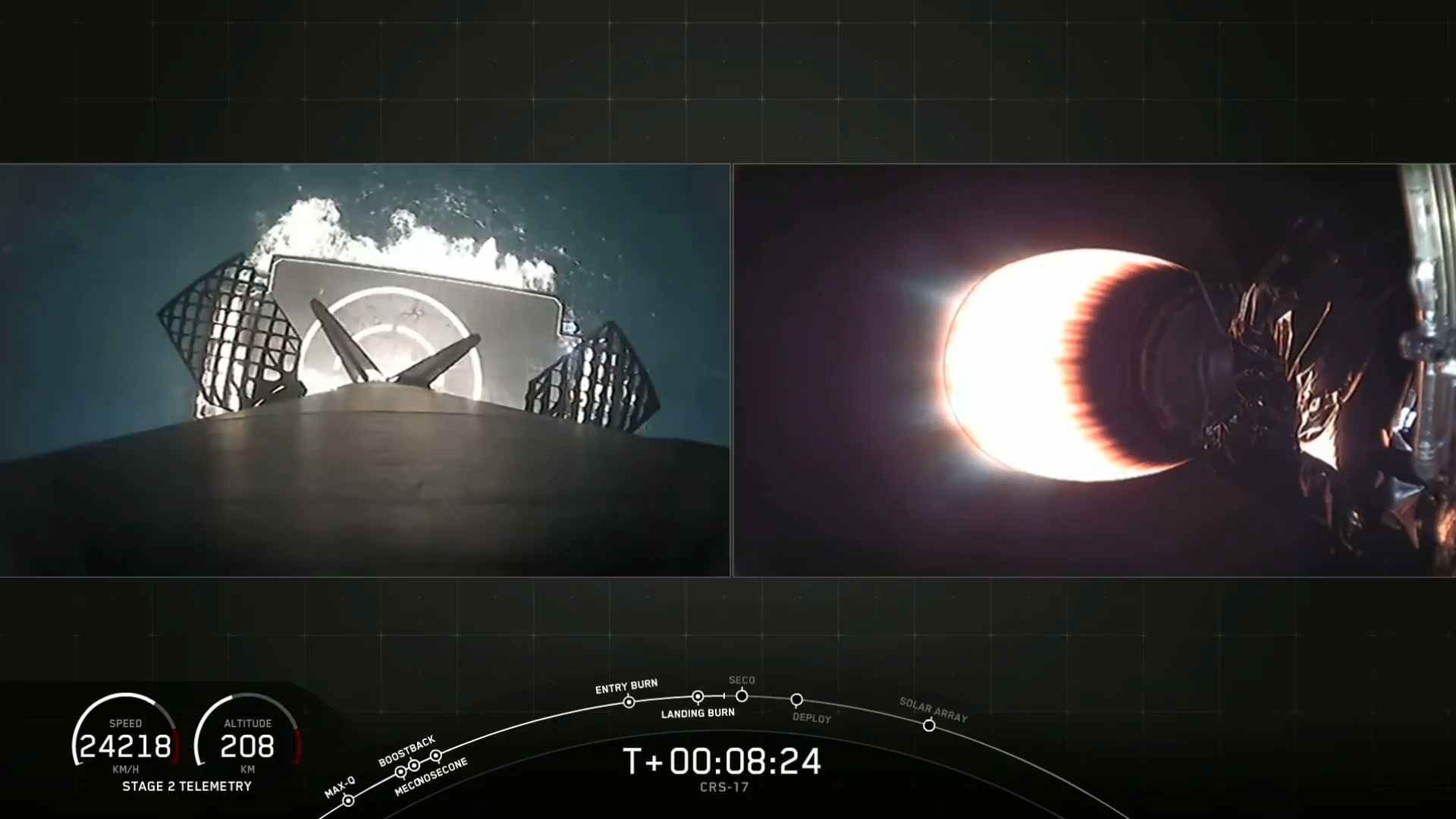
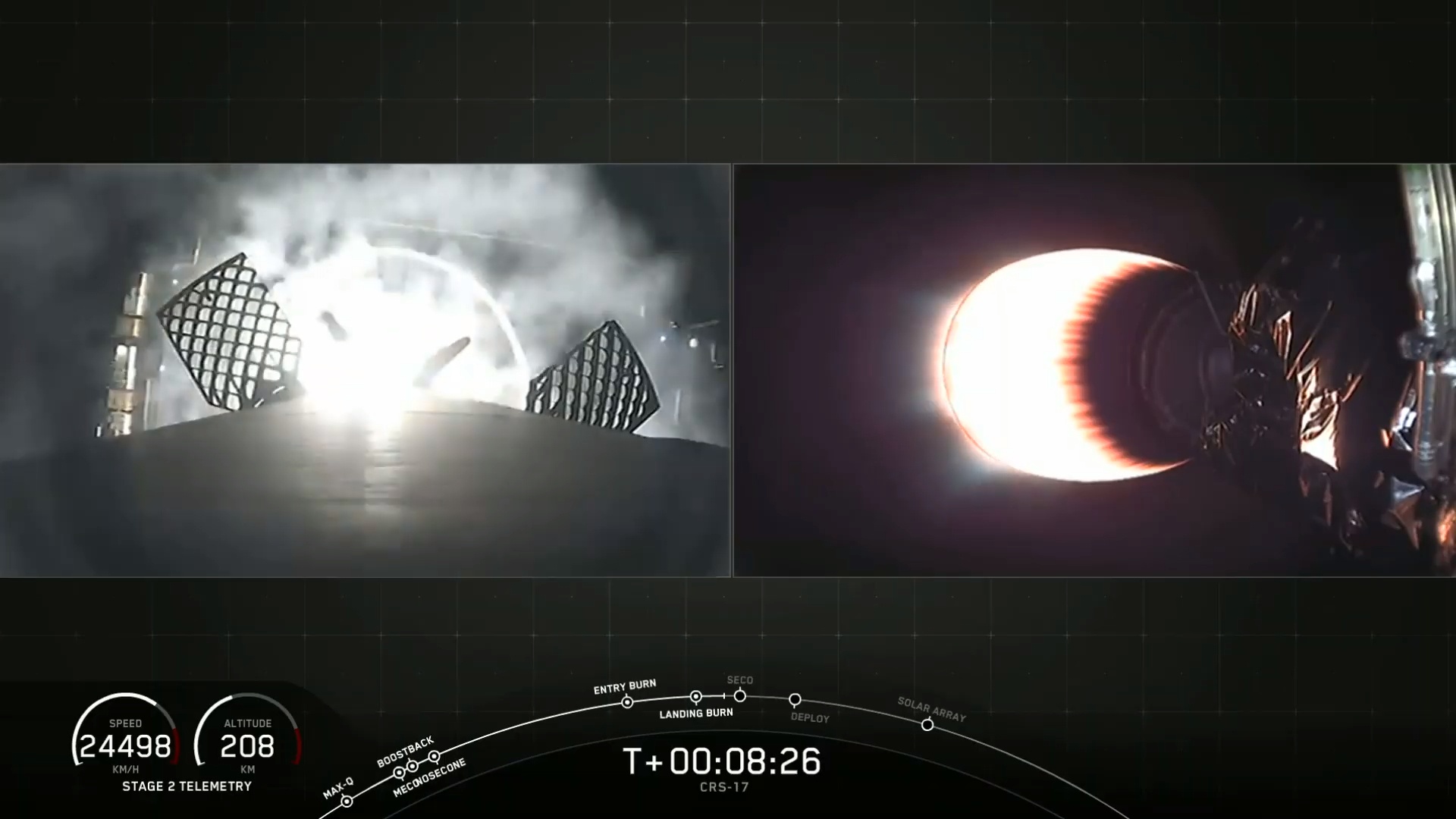
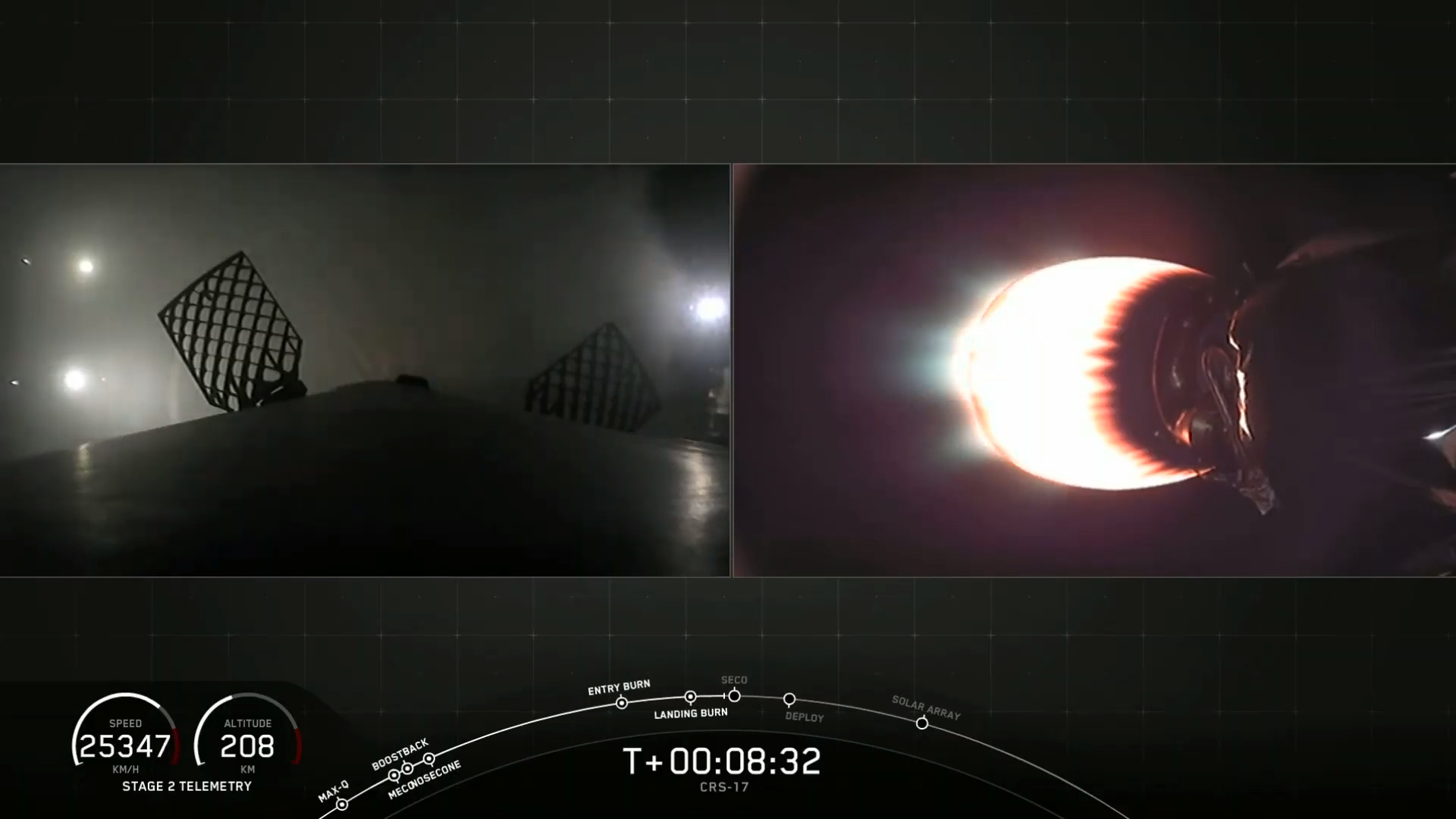
Название: Dragon SpX-17 (CRS-17), OCO-3, STP-H6 - Falcon 9-071 (B1056.1) - CCAFS SLC-40 - NET 25.04.2019, 10:20 UTC
Отправлено: opinion от 04.05.2019 10:10:56
Отправлено: opinion от 04.05.2019 10:10:56
Прикольно, сегодня 4-е мая, всемирный день звездных войн. На NSF пишут, что "May the 4th be with you!" перед пуском таки прозвучало по трансляции.
Название: Dragon SpX-17 (CRS-17), OCO-3, STP-H6 - Falcon 9-071 (B1056.1) - CCAFS SLC-40 - NET 25.04.2019, 10:20 UTC
Отправлено: tnt22 от 04.05.2019 10:12:05
Отправлено: tnt22 от 04.05.2019 10:12:05
Название: Dragon SpX-17 (CRS-17), OCO-3, STP-H6 - Falcon 9-071 (B1056.1) - CCAFS SLC-40 - NET 25.04.2019, 10:20 UTC
Отправлено: tnt22 от 04.05.2019 10:12:33
Отправлено: tnt22 от 04.05.2019 10:12:33
Есть отделение КА!
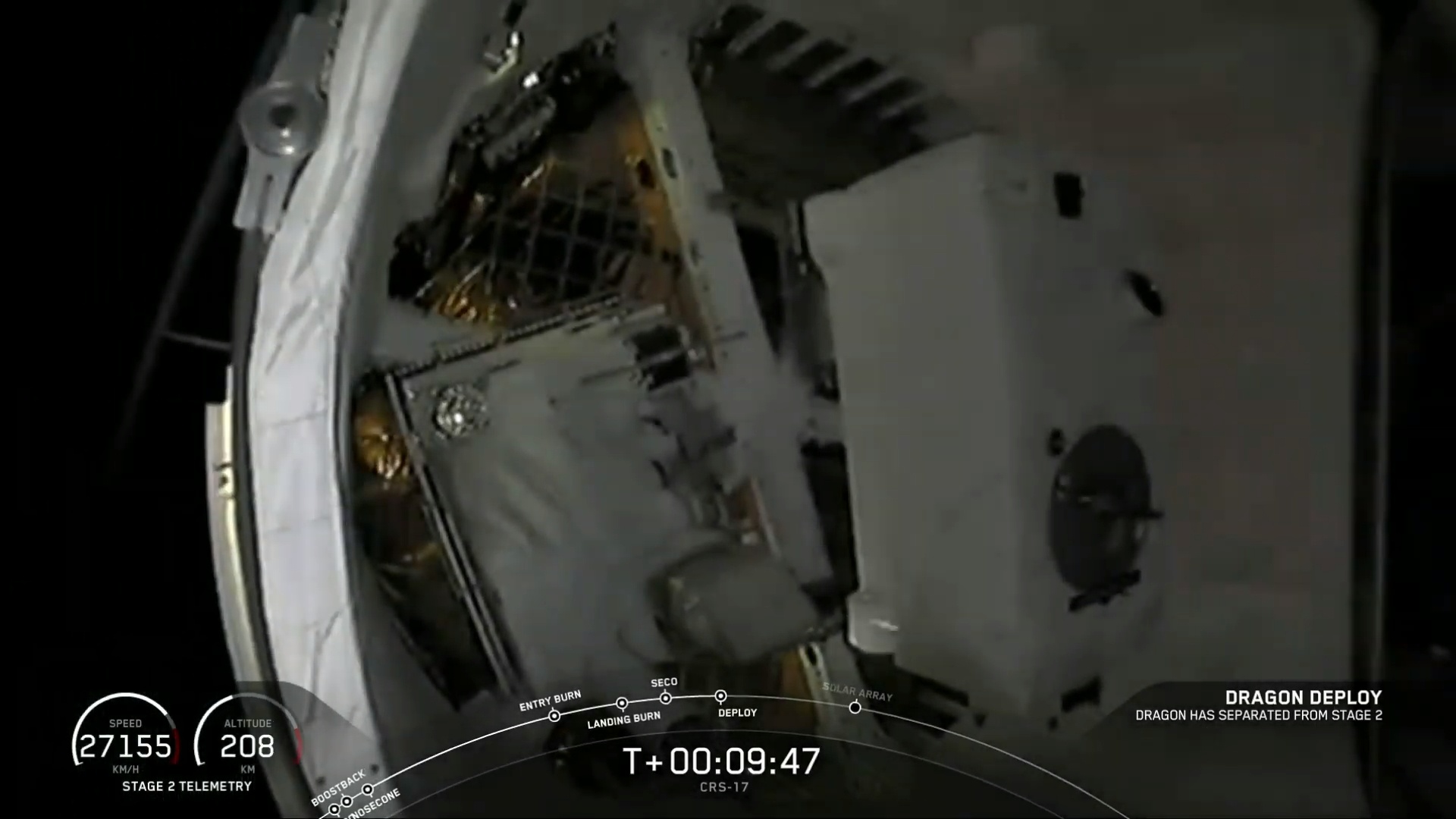


Название: Dragon SpX-17 (CRS-17), OCO-3, STP-H6 - Falcon 9-071 (B1056.1) - CCAFS SLC-40 - NET 25.04.2019, 10:20 UTC
Отправлено: tnt22 от 04.05.2019 10:13:44
Отправлено: tnt22 от 04.05.2019 10:13:44
Есть раскрытие панелей СБ
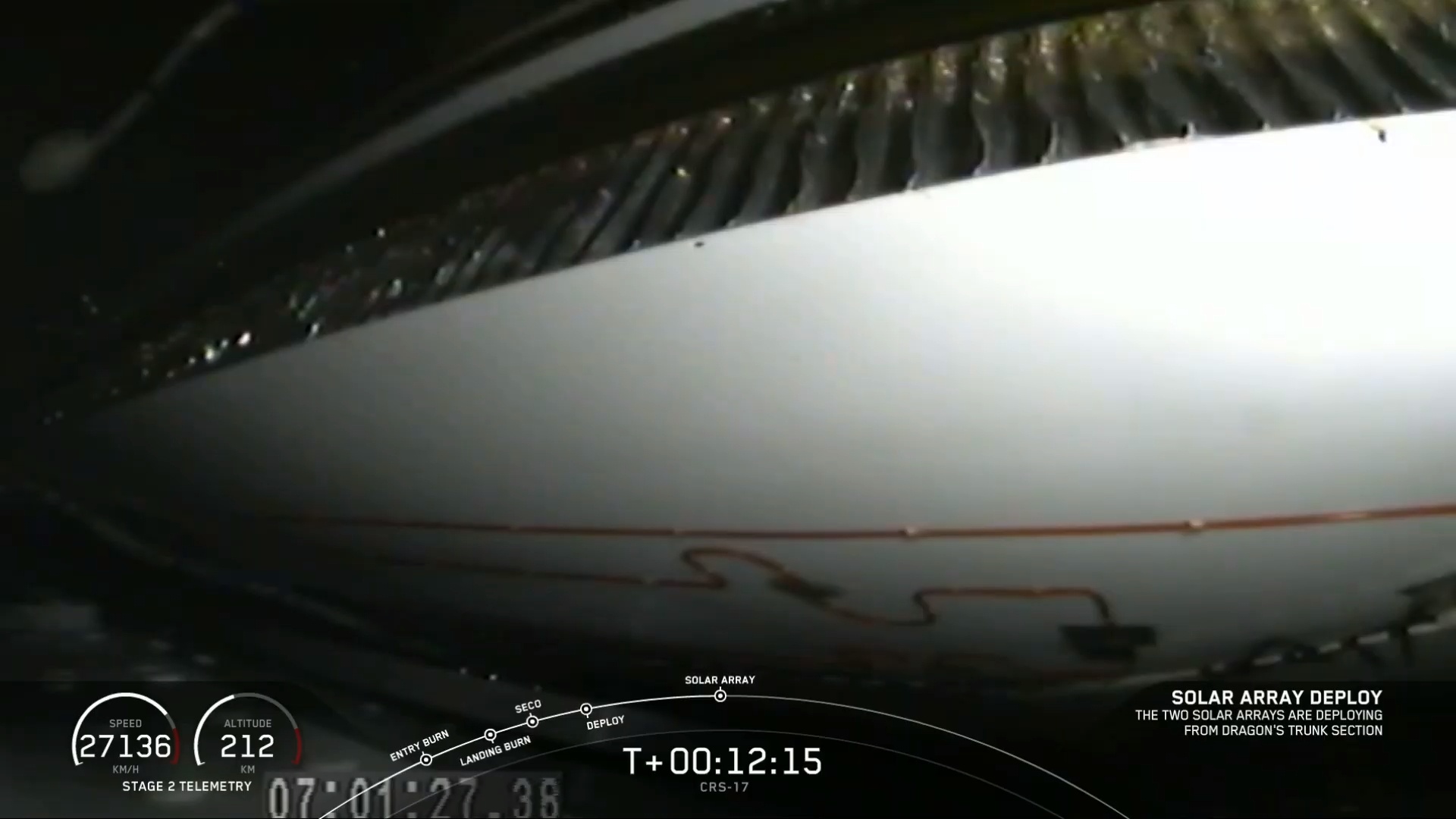
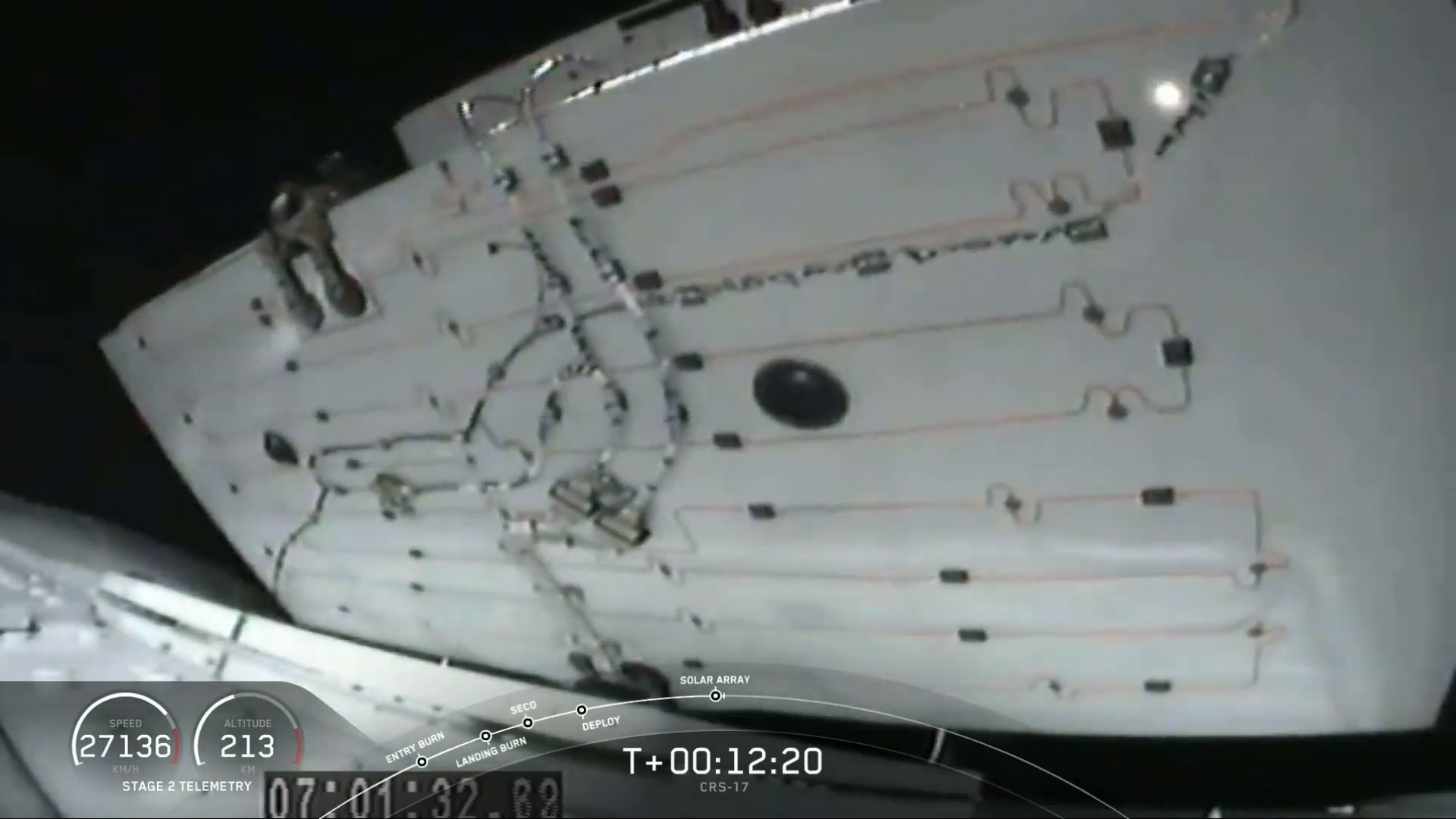
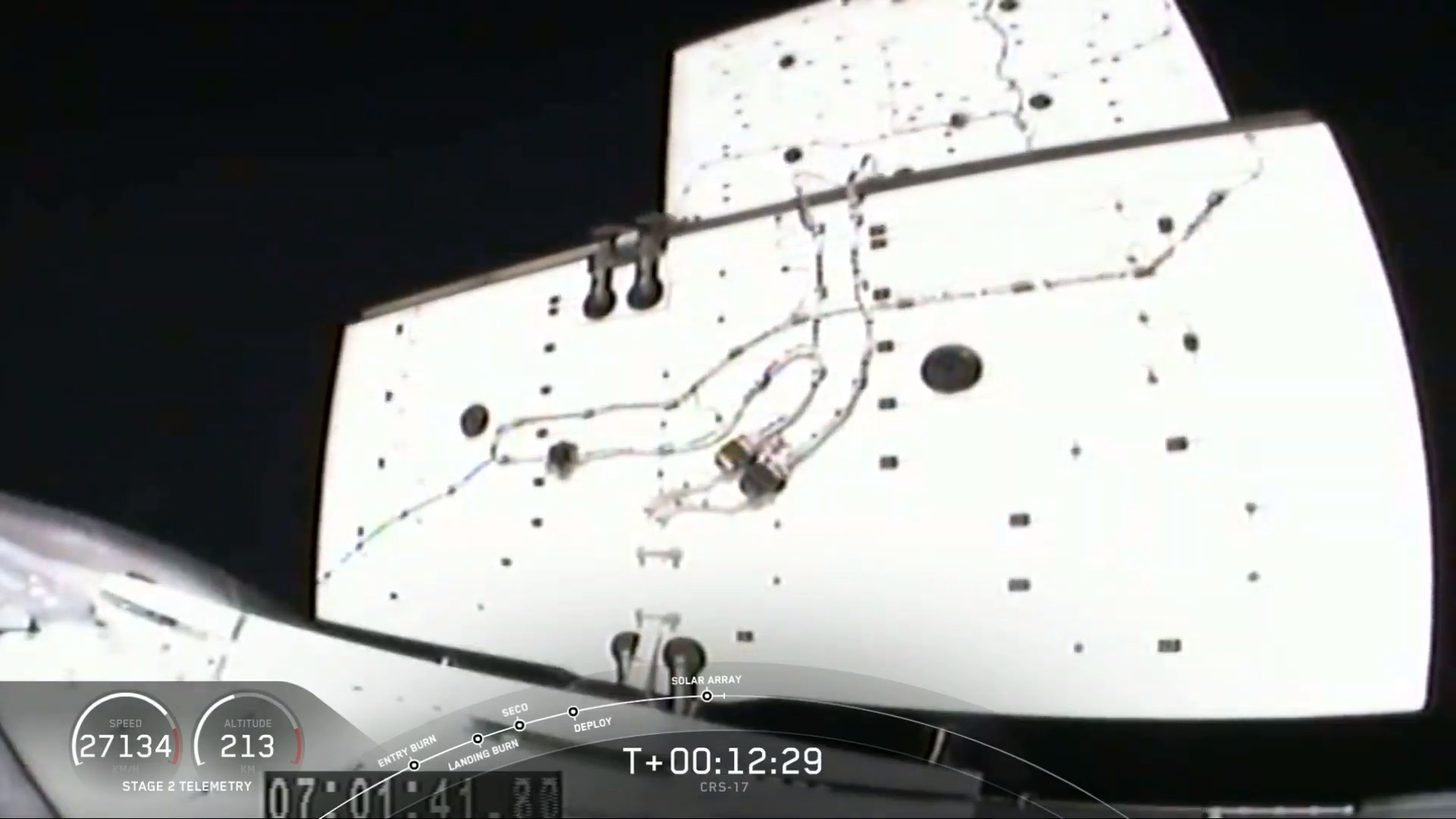
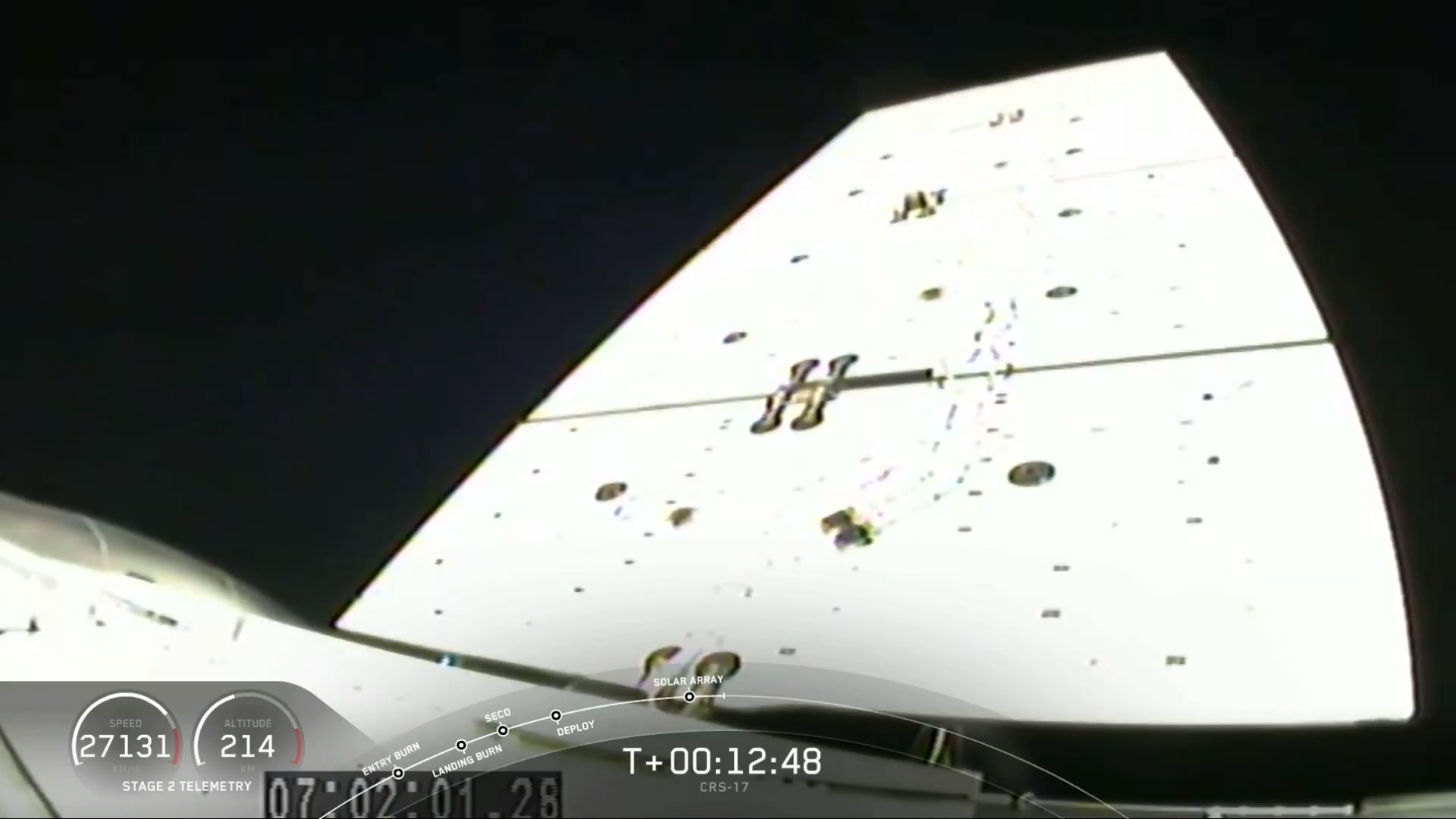

Название: Dragon SpX-17 (CRS-17), OCO-3, STP-H6 - Falcon 9-071 (B1056.1) - CCAFS SLC-40 - NET 25.04.2019, 10:20 UTC
Отправлено: tnt22 от 04.05.2019 10:16:04
Отправлено: tnt22 от 04.05.2019 10:16:04
Трансляция SpaceX завершена
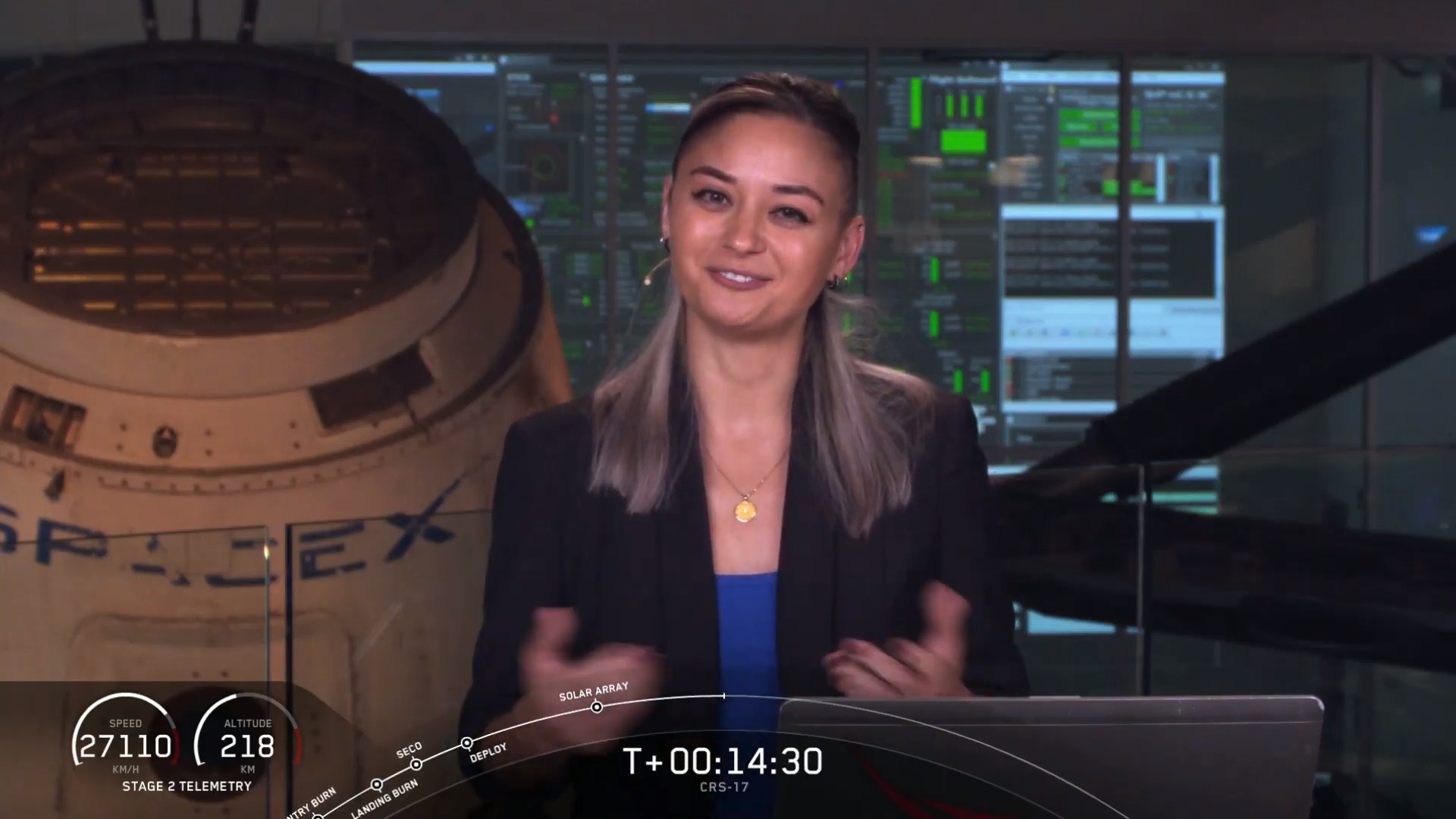
Название: Dragon SpX-17 (CRS-17), OCO-3, STP-H6 - Falcon 9-071 (B1056.1) - CCAFS SLC-40 - NET 25.04.2019, 10:20 UTC
Отправлено: tnt22 от 04.05.2019 10:19:54
Отправлено: tnt22 от 04.05.2019 10:19:54
ЦитироватьSpaceXПодлинная учетная запись @SpaceX (https://twitter.com/SpaceX) 11 мин. назад (https://twitter.com/SpaceX/status/1124570580559077376)
Dragon is on its way to the International Space Station! Capture by the @Space_Station (https://twitter.com/Space_Station) crew set for early Monday morning
Название: Dragon SpX-17 (CRS-17), OCO-3, STP-H6 - Falcon 9-071 (B1056.1) - CCAFS SLC-40 - NET 25.04.2019, 10:20 UTC
Отправлено: tnt22 от 04.05.2019 10:22:57
Отправлено: tnt22 от 04.05.2019 10:22:57
Цитировать05/04/2019 10:07 Stephen Clark
The next step in the Dragon's mission will be the activation and priming of its Draco maneuvering thrusters. A door to the craft's guidance, navigation and control bay -- where its rendezvous sensors and grapple fixture are mounted -- is scheduled open a little more than 2 hours after launch.
Название: Dragon SpX-17 (CRS-17), OCO-3, STP-H6 - Falcon 9-071 (B1056.1) - CCAFS SLC-40 - NET 25.04.2019, 10:20 UTC
Отправлено: tnt22 от 04.05.2019 10:27:11
Отправлено: tnt22 от 04.05.2019 10:27:11
Цитировать05/04/2019 10:13 Stephen Clark
With today's first stage landing, SpaceX has successfully recovered 38 Falcon boosters on the company's drone ships and at landing zones at Cape Canaveral Air Force Station and Vandenberg Air Force Base. Another Falcon rocket core from the Falcon Heavy's second launch last month landed on SpaceX's drone ship, but tipped before before it could be brought back to port.
Название: Dragon SpX-17 (CRS-17), OCO-3, STP-H6 - Falcon 9-071 (B1056.1) - CCAFS SLC-40 - NET 25.04.2019, 10:20 UTC
Отправлено: tnt22 от 04.05.2019 10:28:10
Отправлено: tnt22 от 04.05.2019 10:28:10
ЦитироватьMarek Cyzio @MarekCyzio (https://twitter.com/MarekCyzio) 27 мин. назад (https://twitter.com/MarekCyzio/status/1124568468446228480)
#CRS17 (https://twitter.com/hashtag/CRS17?src=hash) #spacex (https://twitter.com/hashtag/spacex?src=hash) @NASASpaceflight (https://twitter.com/NASASpaceflight)
Название: Dragon SpX-17 (CRS-17), OCO-3, STP-H6 - Falcon 9-071 (B1056.1) - CCAFS SLC-40 - NET 25.04.2019, 10:20 UTC
Отправлено: tnt22 от 04.05.2019 10:28:44
Отправлено: tnt22 от 04.05.2019 10:28:44
ЦитироватьJohn Kraus @johnkrausphotos (https://twitter.com/johnkrausphotos) 23 мин. назад (https://twitter.com/johnkrausphotos/status/1124569629509156864)
#MayThe4thBeWithYou (https://twitter.com/hashtag/MayThe4thBeWithYou?src=hash), Falcon 9! SpaceX's Falcon 9 rocket launches at 2:48am ET, carrying a Dragon capsule full of cargo headed to the International Space Station. The first stage landed 12 miles offshore on SpaceX's droneship.
Название: Dragon SpX-17 (CRS-17), OCO-3, STP-H6 - Falcon 9-071 (B1056.1) - CCAFS SLC-40 - NET 25.04.2019, 10:20 UTC
Отправлено: tnt22 от 04.05.2019 10:29:32
Отправлено: tnt22 от 04.05.2019 10:29:32
ЦитироватьMarek Cyzio @MarekCyzio (https://twitter.com/MarekCyzio) 28 мин. назад (https://twitter.com/MarekCyzio/status/1124569545874735104)
Reentry and landing
#CRS17 (https://twitter.com/hashtag/CRS17?src=hash) #spacex (https://twitter.com/hashtag/spacex?src=hash) @NASASpaceflight (https://twitter.com/NASASpaceflight)
Название: Dragon SpX-17 (CRS-17), OCO-3, STP-H6 - Falcon 9-071 (B1056.1) - CCAFS SLC-40 - NET 25.04.2019, 10:20 UTC
Отправлено: tnt22 от 04.05.2019 10:32:18
Отправлено: tnt22 от 04.05.2019 10:32:18
ЦитироватьFalcon 9 launches CRS-17 Dragon & Falcon 9 first stage landinghttps://www.youtube.com/watch?v=Q3dFNzP5wokhttps://www.youtube.com/watch?v=Q3dFNzP5wok (https://www.youtube.com/watch?v=Q3dFNzP5wok) (5:16)
SciNews (https://www.youtube.com/channel/UCjU6ZwoTQtKWfz1urL7XcbA)
Опубликовано: 4 мая 2019 г.
Название: Dragon SpX-17 (CRS-17), OCO-3, STP-H6 - Falcon 9-071 (B1056.1) - CCAFS SLC-40 - NET 25.04.2019, 10:20 UTC
Отправлено: tnt22 от 04.05.2019 10:35:13
Отправлено: tnt22 от 04.05.2019 10:35:13
ЦитироватьSpaceX Falcon 9 with Dragon Spacecraft Onboard Launches on CRS-17https://www.youtube.com/watch?v=g5tWIbOnwYYhttps://www.youtube.com/watch?v=g5tWIbOnwYY (https://www.youtube.com/watch?v=g5tWIbOnwYY) (1:59)
NASAKennedy (https://www.youtube.com/channel/UCjJtr2fFcUp6yljzJOzpHUg)
Опубликовано: 4 мая 2019 г.
Countdown and liftoff of the SpaceX Falcon 9 rocket with the company's Dragon spacecraft onboard for the company's 17th Commercial Resupply Services mission to the International Space Station. Launch occurred at 2:48 a.m. EST on May 4 from Launch Complex 40 at Cape Canaveral Air Force Station in Florida.
Название: Dragon SpX-17 (CRS-17), OCO-3, STP-H6 - Falcon 9-071 (B1056.1) - CCAFS SLC-40 - NET 25.04.2019, 10:20 UTC
Отправлено: tnt22 от 04.05.2019 10:42:02
Отправлено: tnt22 от 04.05.2019 10:42:02
https://blogs.nasa.gov/spacex/2019/05/04/postlaunch-press-conference-set-for-4-a-m/
ЦитироватьPostlaunch Press Conference Set for 4 a.m.
James Cawley (https://blogs.nasa.gov/spacex/author/jjcawley/)
Posted May 4, 2019 at 3:20 am(https://blogs.nasa.gov/spacex/wp-content/uploads/sites/227/2019/05/Glenn-photo.jpg)
The two-stage Falcon 9 launch vehicle lifts off Space Launch Complex 40 at Cape Canaveral Air Force Station carrying the SpaceX's Dragon resupply spacecraft to the International Space Station. Liftoff was at 2:48 a.m. EDT, May 4, 2019. Photo credit: NASA/Glenn Benson
The SpaceX Dragon spacecraft is on its way to the International Space Station, after launching on the company's Falcon 9 rocket at 2:48 a.m. EDT on May 4, 2019. A postlaunch press conference will take place today at 4 a.m. on NASA Television and the agency's website (http://www.nasa.gov/live).
Participants are:[/li]
Live coverage of the rendezvous and capture of the Dragon will air on NASA Television and the agency's website (http://www.nasa.gov/live) beginning at 5:30 a.m. Monday, May 6. Capture is scheduled for 7:30 a.m.; installation coverage is set to begin at 9 a.m.- Kenny Todd, manager, International Space Station Operations and Integration, NASA's Johnson Space Center
- Hans Koenigsmann, vice president, Build and Flight Reliability, SpaceX
The Dragon spacecraft will remain at the space station for about four weeks before returning to Earth with more than 4,200 pounds of research and return cargo.
Название: Dragon SpX-17 (CRS-17), OCO-3, STP-H6 - Falcon 9-071 (B1056.1) - CCAFS SLC-40 - NET 25.04.2019, 10:20 UTC
Отправлено: tnt22 от 04.05.2019 10:52:56
Отправлено: tnt22 от 04.05.2019 10:52:56
ЦитироватьSpaceX CRS-17 Dragon Spacecraft Separationhttps://www.youtube.com/watch?v=bim4HgqKC2Mhttps://www.youtube.com/watch?v=bim4HgqKC2M (https://www.youtube.com/watch?v=bim4HgqKC2M) (0:29)
NASAKennedy (https://www.youtube.com/channel/UCjJtr2fFcUp6yljzJOzpHUg)
Опубликовано: 4 мая 2019 г.
Название: Dragon SpX-17 (CRS-17), OCO-3, STP-H6 - Falcon 9-071 (B1056.1) - CCAFS SLC-40 - NET 25.04.2019, 10:20 UTC
Отправлено: tnt22 от 04.05.2019 10:57:50
Отправлено: tnt22 от 04.05.2019 10:57:50
Название: Dragon SpX-17 (CRS-17), OCO-3, STP-H6 - Falcon 9-071 (B1056.1) - CCAFS SLC-40 - NET 25.04.2019, 10:20 UTC
Отправлено: tnt22 от 04.05.2019 11:06:14
Отправлено: tnt22 от 04.05.2019 11:06:14
ЦитироватьChris G - NSF @ChrisG_NSF (https://twitter.com/ChrisG_NSF) 53 сек. назад (https://twitter.com/ChrisG_NSF/status/1124585353959170053)
Grapple is Monday at ~0800 EDT (1200 UTC). About 1.5 hours later will berth to Harmony module. Hatch open on Monday afternoon (crew time).
Название: Dragon SpX-17 (CRS-17), OCO-3, STP-H6 - Falcon 9-071 (B1056.1) - CCAFS SLC-40 - NET 25.04.2019, 10:20 UTC
Отправлено: tnt22 от 04.05.2019 11:06:21
Отправлено: tnt22 от 04.05.2019 11:06:21
Название: Dragon SpX-17 (CRS-17), OCO-3, STP-H6 - Falcon 9-071 (B1056.1) - CCAFS SLC-40 - NET 25.04.2019, 10:20 UTC
Отправлено: tnt22 от 04.05.2019 11:06:26
Отправлено: tnt22 от 04.05.2019 11:06:26
Название: Dragon SpX-17 (CRS-17), OCO-3, STP-H6 - Falcon 9-071 (B1056.1) - CCAFS SLC-40 - NET 25.04.2019, 10:20 UTC
Отправлено: tnt22 от 04.05.2019 11:06:32
Отправлено: tnt22 от 04.05.2019 11:06:32
Название: Dragon SpX-17 (CRS-17), OCO-3, STP-H6 - Falcon 9-071 (B1056.1) - CCAFS SLC-40 - NET 25.04.2019, 10:20 UTC
Отправлено: tnt22 от 04.05.2019 11:07:28
Отправлено: tnt22 от 04.05.2019 11:07:28
ЦитироватьChris G - NSF @ChrisG_NSF (https://twitter.com/ChrisG_NSF) 3 мин. назад (https://twitter.com/ChrisG_NSF/status/1124585572595576833)
3 June is new unberth/come home date. Progress undock around that time too. Will talk to Russian colleagues about that and the planned Russian EVA around that time.
Название: Dragon SpX-17 (CRS-17), OCO-3, STP-H6 - Falcon 9-071 (B1056.1) - CCAFS SLC-40 - NET 25.04.2019, 10:20 UTC
Отправлено: tnt22 от 04.05.2019 11:10:37
Отправлено: tnt22 от 04.05.2019 11:10:37
Кен Кремер
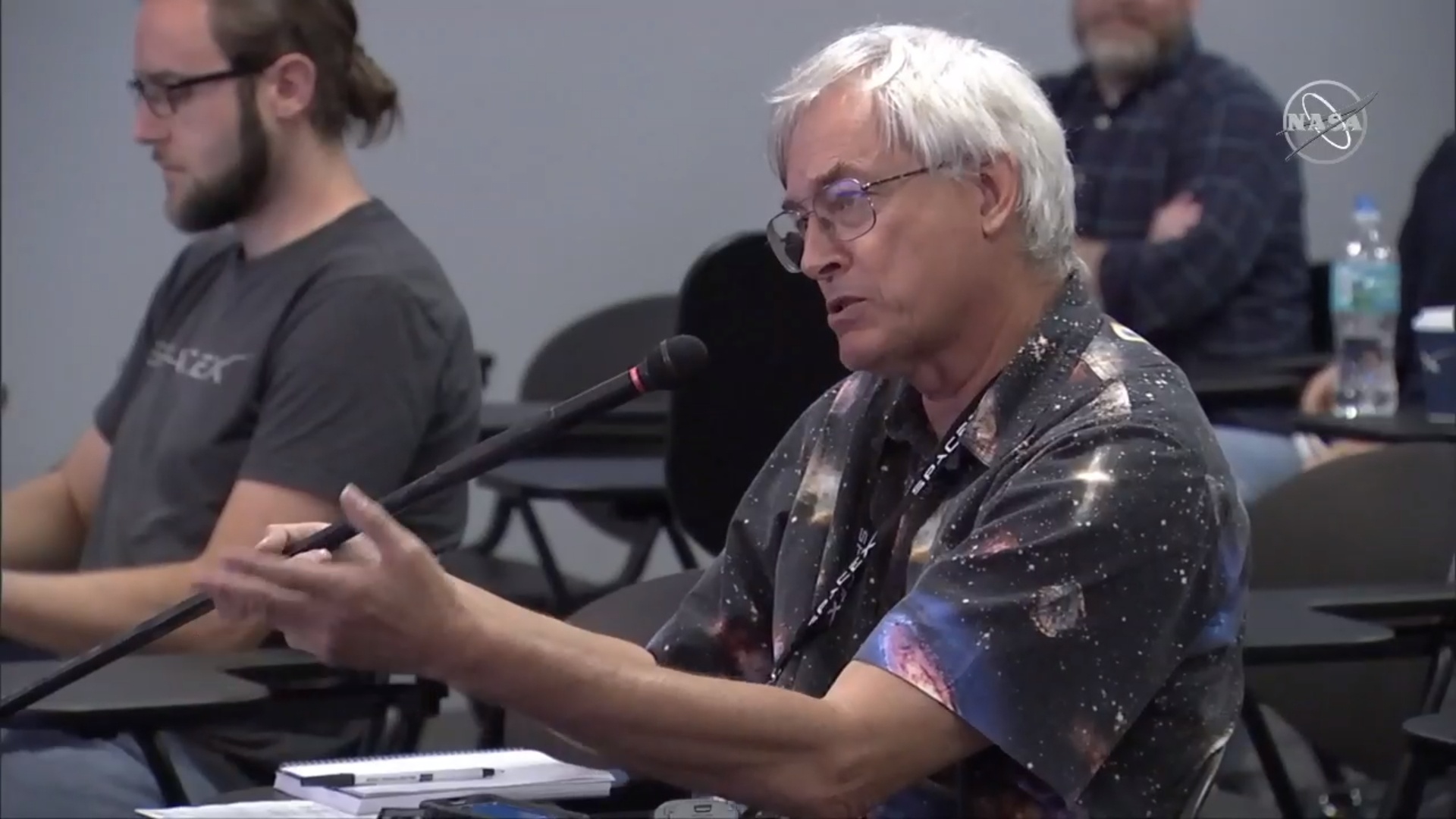
Название: Dragon SpX-17 (CRS-17), OCO-3, STP-H6 - Falcon 9-071 (B1056.1) - CCAFS SLC-40 - NET 25.04.2019, 10:20 UTC
Отправлено: tnt22 от 04.05.2019 11:11:25
Отправлено: tnt22 от 04.05.2019 11:11:25
ЦитироватьSpaceX CRS-17 Dragon Solar Arrays Deployedhttps://www.youtube.com/watch?v=fUJQ1tXyTPshttps://www.youtube.com/watch?v=fUJQ1tXyTPs (https://www.youtube.com/watch?v=fUJQ1tXyTPs) (0:37)
NASAKennedy (https://www.youtube.com/channel/UCjJtr2fFcUp6yljzJOzpHUg)
Опубликовано: 4 мая 2019 г.
Название: Dragon SpX-17 (CRS-17), OCO-3, STP-H6 - Falcon 9-071 (B1056.1) - CCAFS SLC-40 - NET 25.04.2019, 10:20 UTC
Отправлено: tnt22 от 04.05.2019 11:19:51
Отправлено: tnt22 от 04.05.2019 11:19:51
ЦитироватьChris G - NSF @ChrisG_NSF (https://twitter.com/ChrisG_NSF) 1 мин. назад (https://twitter.com/ChrisG_NSF/status/1124589009521582081)
Per helium ground leak last night...
Hans: "Didn't get to the point last night to determine if that would have a been a scrub situation (not enough Helium onboard)."
Helium leak was not a reason for the scrub but was fixed after the scrub.
Название: Dragon SpX-17 (CRS-17), OCO-3, STP-H6 - Falcon 9-071 (B1056.1) - CCAFS SLC-40 - NET 25.04.2019, 10:20 UTC
Отправлено: tnt22 от 04.05.2019 11:20:51
Отправлено: tnt22 от 04.05.2019 11:20:51
ЦитироватьChris G - NSF @ChrisG_NSF (https://twitter.com/ChrisG_NSF) 14 сек. назад (https://twitter.com/ChrisG_NSF/status/1124589567577870337)
#NASA (https://twitter.com/hashtag/NASA?src=hash) says this Falcon 9 might be the first one NASA uses three times (with 2 reflights). Confirms it's the booster for CRS-18 and might be used again for CRS-19.
Название: Dragon SpX-17 (CRS-17), OCO-3, STP-H6 - Falcon 9-071 (B1056.1) - CCAFS SLC-40 - NET 25.04.2019, 10:20 UTC
Отправлено: tnt22 от 04.05.2019 11:23:38
Отправлено: tnt22 от 04.05.2019 11:23:38
ЦитироватьChris B - NSF @NASASpaceflight (https://twitter.com/NASASpaceflight) 3 мин. назад (https://twitter.com/NASASpaceflight/status/1124589424921186304)
Past 4am so only the hardcore at this briefing.
@ChrisG_NSF (https://twitter.com/ChrisG_NSF) asking about MBSUs and the Helium QD.
Название: Dragon SpX-17 (CRS-17), OCO-3, STP-H6 - Falcon 9-071 (B1056.1) - CCAFS SLC-40 - NET 25.04.2019, 10:20 UTC
Отправлено: tnt22 от 04.05.2019 11:27:28
Отправлено: tnt22 от 04.05.2019 11:27:28
Пресс-конференция завершена

Название: Dragon SpX-17 (CRS-17), OCO-3, STP-H6 - Falcon 9-071 (B1056.1) - CCAFS SLC-40 - NET 25.04.2019, 10:20 UTC
Отправлено: tnt22 от 04.05.2019 11:31:12
Отправлено: tnt22 от 04.05.2019 11:31:12
Запись трансляции пуска (SpaceX)
ЦитироватьCRS-17 Missionhttps://www.youtube.com/watch?v=AQFhX5TvP0Mhttps://www.youtube.com/watch?v=AQFhX5TvP0M (https://www.youtube.com/watch?v=AQFhX5TvP0M) (35:05)
SpaceX (https://www.youtube.com/channel/UCtI0Hodo5o5dUb67FeUjDeA)
Трансляция началась 2 часа назад
Название: Dragon SpX-17 (CRS-17), OCO-3, STP-H6 - Falcon 9-071 (B1056.1) - CCAFS SLC-40 - NET 25.04.2019, 10:20 UTC
Отправлено: tnt22 от 04.05.2019 11:34:03
Отправлено: tnt22 от 04.05.2019 11:34:03
https://www.spacex.com/webcast
ЦитироватьCRS-17 MISSIONOn Saturday, May 4, SpaceX launched its seventeenth Commercial Resupply Services mission (CRS-17) at 2:48 a.m. EDT, or 6:48 UTC, from Space Launch Complex 40 (SLC-40) at Cape Canaveral Air Force Station, Florida. Dragon separated from Falcon 9's second stage about 9 minutes after liftoff and will attach to the space station on Monday, May 6.
The Dragon spacecraft supporting the CRS-17 mission previously supported the CRS-12 mission in August 2017. Following stage separation, SpaceX landed Falcon 9's first stage on the Of Course I Still Love You droneship, which was stationed in the Atlantic Ocean.
Название: Dragon SpX-17 (CRS-17), OCO-3, STP-H6 - Falcon 9-071 (B1056.1) - CCAFS SLC-40 - NET 25.04.2019, 10:20 UTC
Отправлено: tnt22 от 04.05.2019 11:48:54
Отправлено: tnt22 от 04.05.2019 11:48:54
https://www.militarynews.ru/story.asp?rid=1&nid=507513&lang=RU (https://www.militarynews.ru/story.asp?rid=1&nid=507513&lang=RU)
ЦитироватьАмериканский космический корабль Cargo Dragon вышел на орбиту (версия 2)
04.05.2019 10:08:08
*** На корабле раскрылись солнечные батареи
Вашингтон. 4 мая. ИНТЕРФАКС - Ракета-носитель Falcon 9 в субботу вывела на орбиту Земли грузовой космический корабль Cargo Dragon американской компании SpaceX, который затем должен будет состыковаться с Международной космической станцией (МКС), сообщило Национальное управление США по аэронавтике и исследованию космического пространства (NASA).
В 9:58 мск космический корабль Crew Dragon успешно отделился от второй ступени ракеты-носителя Falcon 9, начав самостоятельный полет. Замтем на корабле успешно раскрылились солнечные батерии, которые обеспечать его энергией.
Тем временем первая многоразовая ступень ракеты-носителя Falcon 9 совершила посадку на плавучей платформе в Атлантике
17-й по счету запуск данного "грузовика" к МКС в рамках коммерческого контракта между NASA и компанией SpaceX был осуществлен с 40-го пускового комплекса на космодроме NASA на мысе Канаверал в штате Флорида в 02:48 по восточноамериканскому времени (9:48 мск).
Космический корабль должен доставить на МКС около 2,5 тонн продовольствия, а также оборудования и материалов для проведения десятков научных экспериментов экипажем станции.
Стыковка "грузовика" с МКС запланирована на 6 мая. Она будет осуществляться путем захвата "грузовика" рукой-манипулятором Canadarm-2 МКС и последующим присоединением его к американскому сегменту станции - модулю Harmony. Процессом захвата корабля и его стыковки со станцией будут управлять члены экипажа МКС канадец Давид Сен-Жак и американец Ник Хейг.
Запуск грузового корабля Cargo Dragon, который должен был стартовать к МКС еще 25 апреля, неоднократно откладывался. 29 апреля экипаж МКС обнаружил проблему с одним из коммутационных блоков, который распределяет энергию на два из восьми каналов электропитания станции. По этим каналам на все системы станции поступает электроэнергия, вырабатываемая солнечными батареями станции.
Вышедший из строя блок MBSU на 25% снизил подачу электроэнергии системам станции. В результате запуск грузовика Cargo Dragon пришлось отложить. 2 мая наземные службы в центре управления полетами в Хьюстоне с помощью дистанционной руки-манипулятора МКС провели успешную операцию по замене вышедшего из строя электрического распределительного щита MBSU на аналогичный запасной агрегат. Последующая проверка показала штатную работу системы электроснабжения МКС по номинальным параметрам, а также возможность дополнительных мощностей, необходимых для проведения захвата рукой-манипулятором Canadarm-2 "грузовика" и его стыковки со станцией.
Однако перенесенный на 3 мая старт вновь был отменен в связи проблемой в электрооборудовании на плавучей платформе, предназначенной для посадки многоразовой первой ступени ракеты-носителя Falcon 9.Спойлер
В настоящее время экипаж МКС состоит из российских космонавтов Олега Кононенко и Алексея Овчинина, американских астронавтов Энн Макклейн, Кристины Кох и Ника Хейга и канадского астронавта Давида Сен-Жака.[свернуть]
Название: Dragon SpX-17 (CRS-17), OCO-3, STP-H6 - Falcon 9-071 (B1056.1) - CCAFS SLC-40 - NET 25.04.2019, 10:20 UTC
Отправлено: tnt22 от 04.05.2019 11:52:27
Отправлено: tnt22 от 04.05.2019 11:52:27
https://tass.ru/kosmos/6400099
Цитировать4 МАЯ, 09:50 Обновлено 09:59
SpaceX провела запуск ракеты с кораблем Dragon с грузом для МКС
Это 17-й коммерческий полет, который осуществляет компания для снабжения Международной космической станции
НЬЮ-ЙОРК, 4 мая. /ТАСС/. Компания SpaceX в субботу осуществила запуск ракеты-носителя Falcon-9 с кораблем Dragon с грузом, предназначенным для экипажа Международной космической станции (МКС). Старт носителя с пускового комплекса 40 на базе ВВС США на мысе Канаверал (штат Флорида) состоялся в 02:48 по времени Восточного побережья США (09:48 мск), трансляция ведется на сайте SpaceX (https://www.spacex.com/).
Первоначально запуск планировался на утро пятницы, однако был отменен из-за проблем с электрооборудованием на плавучей платформе в Атлантическом океане под названием Of Course I Still Love You ("Конечно, я все еще люблю тебя"). На нее планируется посадить первую ступень ракеты-носителя для повторного использования в будущем. Для нынешнего полета повторно используется капсула Dragon, уже совершавшая полет в августе 2017 года.
Это 17-й коммерческий полет, выполняемый компанией SpaceX по снабжению МКС, уточнило Национальное управление США по аэронавтике и исследованию космического пространства (NASA). Dragon должен доставить на орбитальную станцию более 2,5 тонны грузов - принадлежности и вспомогательные материалы для проведения нескольких десятков научных экспериментов, запланированных на период экспедиции МКС-59/60. На борту космического грузовика находятся такие приборы, как Orbiting Carbon Observatory-3 (OCO-3) и Space Test Program-Houston 6 (STP-H6).
OCO-3 планируется установить на внешней поверхности МКС для того, чтобы из космоса измерять содержание углекислого газа в атмосфере Земли и помочь углубить познания ученых о взаимосвязи между углекислым газом и климатом нашей планеты, информировало NASA. STP-H6 предназначен для демонстрации в условиях космического пространства новой технологии генерации пучков переменного рентгеновского излучения.
"Эта технология может оказаться полезной для обеспечения надежной связи с зондами или гиперзвуковыми аппаратами, когда плазменная оболочка, возникающая при гиперзвуковых скоростях, блокирует прохождение обычного радиосигнала", - пояснило космическое ведомство США.
После сближения с МКС корабль будет захвачен дистанционным манипулятором длиной 17,6 метра и пристыкован к станции. Эту задачу будет выполнять астронавт Канадского космического агентства Давид Сен-Жак. Страховать его будут астронавты NASA Ник Хейг и Кристина Кох. Через четыре недели корабль будет отстыкован от МКС и вернется на Землю. Он приводнится в Тихом океане у побережья Калифорнии.
Название: Dragon SpX-17 (CRS-17), OCO-3, STP-H6 - Falcon 9-071 (B1056.1) - CCAFS SLC-40 - NET 25.04.2019, 10:20 UTC
Отправлено: tnt22 от 04.05.2019 12:05:06
Отправлено: tnt22 от 04.05.2019 12:05:06
https://blogs.nasa.gov/spacex/2019/05/04/spacex-dragon-heads-to-space-station-after-successful-launch-2/
ЦитироватьSpaceX Dragon Heads to Space Station After Successful Launch
James Cawley (https://blogs.nasa.gov/spacex/author/jjcawley/)
Posted May 4, 2019 at 4:45 am(https://blogs.nasa.gov/spacex/wp-content/uploads/sites/227/2019/05/crs-17-conf-1.jpg)
Fr om left to right, Joshua Santora, NASA Communications; Kenny Todd, manager, International Space Station Operations and Integration, NASA's Johnson Space Center; and Hans Koenigsmann, vice president, Build and Flight Reliability, SpaceX, participate in a postlaunch press conference at Kennedy Space Center following the SpaceX CRS-17 launch on May 4, 2019. The Dragon spacecraft will arrive at the International Space Station on Monday, May 6. Photo credit: NASA
More than 5,500 pounds of cargo is on its way to the International Space Station aboard a SpaceX Dragon spacecraft. The company's 17th commercial cargo mission to resupply the space station began at 2:48 a.m. EDT on May 4, 2019, with liftoff aboard a SpaceX Falcon 9 rocket fr om Space Launch Complex 40 at Cape Canaveral Air Force Station in Florida.
Kenny Todd, International Space Station Operations and Integration manager at NASA's Johnson Space Center in Houston, explained during the postlaunch press conference that launch success far overshadowed fatigue with the early morning launch.
"If you have to be up, I can't think of a better reason than to see one of these launches — it was absolutely spectacular," Todd said. "We're really excited to get Dragon on board in a couple of days."
After a successful climb into space, the Dragon spacecraft now is in orbit with its solar arrays deployed and drawing power.
"We had a beautiful launch today; it was really great," said Hans Koenigsmann, SpaceX's vice president, Build and Flight Reliability. "Dragon is on the way, the orbiter is great — it's right on the money."
The Dragon spacecraft will deliver science, supplies and hardware to the orbiting laboratory. Science experiments include NASA's Orbiting Carbon Observatory (https://ocov3.jpl.nasa.gov/) 3 (OCO-3) and Space Test Program-Houston 6 (https://www.nasa.gov/mission_pages/station/research/experiments/explorer/Investigation.html?#id=7947) (STP-H6).
OCO-3 will be robotically installed on the exterior of the space station's Japanese Experiment Module Exposed Facility Unit, wh ere it will measure and map carbon dioxide from space to increase our understanding of the relationship between carbon and climate.
STP-H6 is an X-ray communication investigation that will be used to perform a space-based demonstration of a new technology for generating beams of modulated X-rays. This technology may be useful for providing efficient communication to deep space probes, or communicating with hypersonic vehicles wh ere plasma sheaths prevent traditional radio communications.
Live coverage of the rendezvous and capture will air on NASA Television and the agency's website beginning at 5:30 a.m. on Monday, May 6. Capture is scheduled for 7 a.m.; installation coverage is set to begin at 9 a.m. Astronauts aboard the station will capture the Dragon using the space station's robotic arm and then install it on the station's Harmony module.
The Dragon spacecraft will spend about four weeks attached to the space station, returning to Earth with more than 4,200 pounds of research, hardware and crew supplies.
Название: Dragon SpX-17 (CRS-17), OCO-3, STP-H6 - Falcon 9-071 (B1056.1) - CCAFS SLC-40 - NET 25.04.2019, 10:20 UTC
Отправлено: tnt22 от 04.05.2019 12:10:12
Отправлено: tnt22 от 04.05.2019 12:10:12
Фото (https://img.novosti-kosmonavtiki.ru/155854.jpg) пуска от SpaceX
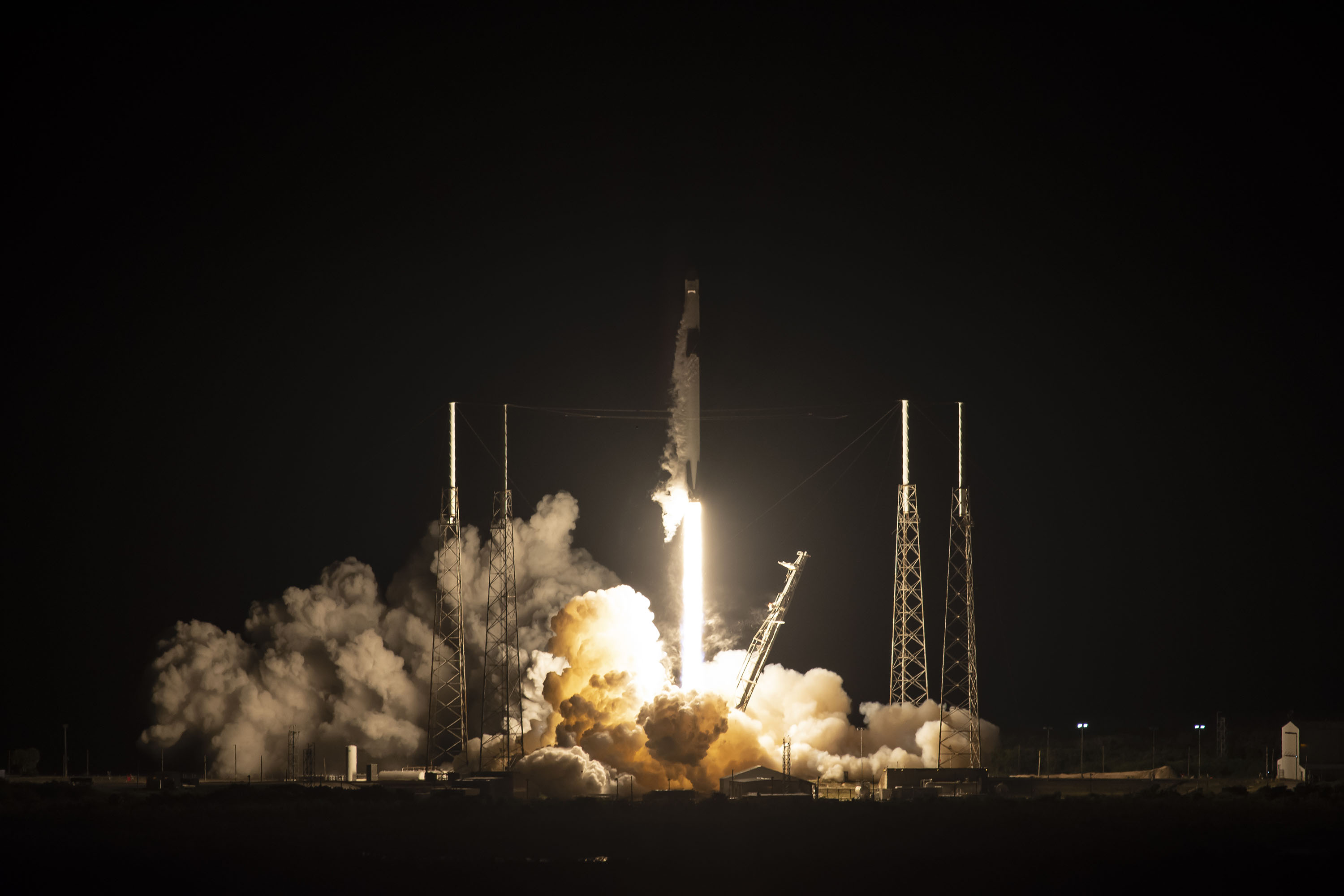

Название: Dragon SpX-17 (CRS-17), OCO-3, STP-H6 - Falcon 9-071 (B1056.1) - CCAFS SLC-40 - NET 25.04.2019, 10:20 UTC
Отправлено: tnt22 от 04.05.2019 13:06:59
Отправлено: tnt22 от 04.05.2019 13:06:59
Обнаружены 3 объекта запуска (судя по всему - ТГК и 2 крышки от СБ)
44223 / 2019-025B : 205 x 384 km x 51.644°
44224 / 2019-025C : 205 x 378 km x 51.623°
Код Выделить
0 TBA - TO BE ASSIGNED
1 44222U 19025A 19124.36543545 -.00003554 11233-4 00000+0 0 9994
2 44222 51.6329 219.3388 0132778 47.6088 74.0434 15.93174869 13
0 TBA - TO BE ASSIGNED
1 44223U 19025B 19124.36558576 -.00003550 11223-4 00000+0 0 9990
2 44223 51.6435 219.3644 0133945 48.1563 74.2334 15.92714978 19
0 TBA - TO BE ASSIGNED
1 44224U 19025C 19124.36556778 -.00003558 11248-4 00000+0 0 9998
2 44224 51.6231 219.3081 0129870 47.3565 75.2526 15.93841132 1244222 / 2019-025A : 205 x 382 km x 51.633°44223 / 2019-025B : 205 x 384 km x 51.644°
44224 / 2019-025C : 205 x 378 km x 51.623°
Название: Dragon SpX-17 (CRS-17), OCO-3, STP-H6 - Falcon 9-071 (B1056.1) - CCAFS SLC-40 - NET 25.04.2019, 10:20 UTC
Отправлено: tnt22 от 04.05.2019 13:20:27
Отправлено: tnt22 от 04.05.2019 13:20:27
ЦитироватьTomCross @_TomCross_ (https://twitter.com/_TomCross_) 2 ч. назад (https://twitter.com/_TomCross_/status/1124583514593275904)
Full screen CRS-17 launch and landing sequence in its entirety. It couldn't have been a more flawless launch. You make it look easy and beautiful
@SpaceX (https://twitter.com/SpaceX) #CRS17 (https://twitter.com/hashtag/CRS17?src=hash)
Название: Dragon SpX-17 (CRS-17), OCO-3, STP-H6 - Falcon 9-071 (B1056.1) - CCAFS SLC-40 - NET 25.04.2019, 10:20 UTC
Отправлено: кукушка от 04.05.2019 17:06:27
Отправлено: кукушка от 04.05.2019 17:06:27
После успешного начала миссии CRS-17 NASA объявило (https://vk.com/spacex?w=wall-41152133_132277) о намерении использовать вернувшуюся ступень для следующих двух миссий к МКС.
На пресс-конференции, проходившей сегодня после запуска, Kenny Todd (менеджер NASA, ответственный за снабжение МКС) сделал следующее заявление по поводу причины переноса запуска с пятницы на субботу:
"... у нас (NASA) была своя причина отложить запуск на сутки, чтобы дать возможность SpaceX исправить проблему с генератором на посадочной платформе OCILSY. Вернувшуюся ступень мы считаем "своей" и планируем использовать ее как минимум для миссии CRS-18, а, возможно, и для CRS-19".
Если так и произойдет, то миссия CRS-19 будет первым запуском в интересах NASA на уже дважды до этого летавшей ступени.
Многоразовое использование имеет для NASA вполне ощутимую выгоду, так как SpaceX возвращает часть сэкономленных денег космическому агентству.
На пресс-конференции, проходившей сегодня после запуска, Kenny Todd (менеджер NASA, ответственный за снабжение МКС) сделал следующее заявление по поводу причины переноса запуска с пятницы на субботу:
"... у нас (NASA) была своя причина отложить запуск на сутки, чтобы дать возможность SpaceX исправить проблему с генератором на посадочной платформе OCILSY. Вернувшуюся ступень мы считаем "своей" и планируем использовать ее как минимум для миссии CRS-18, а, возможно, и для CRS-19".
Если так и произойдет, то миссия CRS-19 будет первым запуском в интересах NASA на уже дважды до этого летавшей ступени.
Многоразовое использование имеет для NASA вполне ощутимую выгоду, так как SpaceX возвращает часть сэкономленных денег космическому агентству.
Название: Dragon SpX-17 (CRS-17), OCO-3, STP-H6 - Falcon 9-071 (B1056.1) - CCAFS SLC-40 - NET 25.04.2019, 10:20 UTC
Отправлено: tnt22 от 04.05.2019 18:16:48
Отправлено: tnt22 от 04.05.2019 18:16:48
По состоянию на 16:45 ДМВ - ступень на дроне, дрон всё ещё на позиции LZ (посадочная зона)
ЦитироватьSpaceXFleet Updates @SpaceXFleet (https://twitter.com/SpaceXFleet) 1 ч. назад (https://twitter.com/SpaceXFleet/status/1124671890554011650)
Through the haze, a booster can be seen on the horizon!
They are still at the LZ at the moment but the top half of the booster is visible at this distance.ЦитироватьA Harn @nalawod (https://twitter.com/nalawod) 06:45 PDT (https://twitter.com/nalawod/status/1124671490648047616) - 4 мая 2019 г.
В ответ @SpaceXFleet (https://twitter.com/SpaceXFleet)
For those that can't see it off the back of the ship- here it is dehazed
Название: Dragon SpX-17 (CRS-17), OCO-3, STP-H6 - Falcon 9-071 (B1056.1) - CCAFS SLC-40 - NET 25.04.2019, 10:20 UTC
Отправлено: tnt22 от 04.05.2019 19:17:56
Отправлено: tnt22 от 04.05.2019 19:17:56
ЦитироватьErik Kuna @erikkuna (https://twitter.com/erikkuna) 6 ч. назад (https://twitter.com/erikkuna/status/1124617800331538432)
Congrats @SpaceX (https://twitter.com/SpaceX)on another successful launch of the #falcon9 (https://twitter.com/hashtag/falcon9?src=hash) - Fitting on #MayTheFourth (https://twitter.com/hashtag/MayTheFourth?src=hash), a rocket named after the Millennium Falcon would produce an image like this of the second stage going to the #ISS (https://twitter.com/hashtag/ISS?src=hash) and first stage boostback burn to #OCISLY (https://twitter.com/hashtag/OCISLY?src=hash) - photo credit:@erikkuna (https://twitter.com/erikkuna) – Kennedy Space Center (https://twitter.com/search?q=place%3A07d9df471c480003)
Название: Dragon SpX-17 (CRS-17), OCO-3, STP-H6 - Falcon 9-071 (B1056.1) - CCAFS SLC-40 - NET 25.04.2019, 10:20 UTC
Отправлено: tnt22 от 04.05.2019 20:04:46
Отправлено: tnt22 от 04.05.2019 20:04:46
ЦитироватьSteven Young @stevenyoungsfn (https://twitter.com/stevenyoungsfn) 1 мин. назад (https://twitter.com/stevenyoungsfn/status/1124721165421948928)
Nearly three hours after launch the pre-dawn sky over @NASAKennedy (https://twitter.com/NASAKennedy) painted by the Falcon 9 #CRS17 (https://twitter.com/hashtag/CRS17?src=hash)
Название: Dragon SpX-17 (CRS-17), OCO-3, STP-H6 - Falcon 9-071 (B1056.1) - CCAFS SLC-40 - NET 25.04.2019, 10:20 UTC
Отправлено: tnt22 от 04.05.2019 20:10:19
Отправлено: tnt22 от 04.05.2019 20:10:19
https://spaceflightnow.com/2019/05/04/spacex-launches-space-station-resupply-mission-lands-rocket-on-drone-ship/
ЦитироватьSpaceX launches space station resupply mission, lands rocket on drone ship
May 4, 2019 (https://spaceflightnow.com/2019/05/) | Stephen Clark (https://spaceflightnow.com/author/stephen-clark/)
SpaceX's Falcon 9 rocket lifted off from Cape Canaveral's Complex 40 launch pad at 2:48:58 a.m. EDT (0648:58 GMT) Saturday. Credit: SpaceX
With a thundering, sky-lighting predawn blastoff from Cape Canaveral, a Falcon 9 rocket fired into orbit early Saturday with a Dragon cargo capsule in pursuit of the International Space Station.
Less than nine minutes later, the rocket's first stage booster fell from the sky and executed a pinpoint propulsive landing just offshore, setting the stage for another resupply mission for NASA using the same rocket this summer using the same vehicle.
The 213-foot-tall (65-meter) rocket lifted off with a flash from its nine Merlin 1D main engines at 2:48:58 a.m. EDT (0648:58 GMT), roughly the moment Cape Canaveral rotated under space station's orbital plane.
The Falcon 9 tilted toward the northeast to align with the space station's flight path, riding 1.7 million pounds of thrust as roared into a starry sky. Less than two-and-a-half minutes later, the rocket's first stage booster shut down and separated to begin a descent back to Earth, targeting SpaceX's drone ship "Of Course I Still Love You" parked around 14 miles (22 kilometers) east of Cape Canaveral in the Atlantic Ocean.
The first stage lit three of its engines to begin a boost-back burn to reverse course and head back toward Florida's Space Coast, while the Falcon 9's upper stage continued with the primary objective of Saturday's mission — the delivery into orbit of a Dragon cargo craft packed with 5,472 pounds (2,482 kilograms) of supplies, provisions and experiments for the station and its six-person crew.
The interaction exhaust plumes from the Falcon 9's first and second stage Merlin engines produced a spectacular lighting effect, giving the appearance of a cosmic nebula high above the Florida spaceport.
The Falcon 9's first and second stages, appearing as two bright dots in the night sky, simultaneously fire their engines to return to landing and head into orbit, respectively. Credit: Steven Young/Spaceflight Now
The second stage fired for six minutes to place the Dragon supply ship in a preliminary orbit. Moments later, the automated spaceship deploy from the Falcon 9's upper stage and unfurled two power-generating solar panels, setting the stage for a sequence of thruster firings over the next two days, culminating in the spacecraft's approach to the space station early Monday.
Astronauts on the station will use a robotic arm to grapple the Dragon spacecraft, which will be berthed to a port on the Harmony module for a nearly one-month stay.
The Dragon cargo craft, which uses the same pressurized section that previously flew to the space station in August 2017, is carrying crew supplies, spare parts, and a host of experiments, ranging from biological investigations into spaceflight's effects on the body, to an instrument measuring carbon dioxide in Earth's atmosphere, to a U.S. military experiment developed in concert with NASA to demonstrate X-ray communications in space for the first time.
The resupply mission is the 17th cargo launch to the station by SpaceX under a $3.04 billion contract for 20 cargo deliveries through early 2020. SpaceX has a separate follow-on contract for at least six more resupply missions to the station through 2024, along with a $2.6 billion contract to build an upgraded Crew Dragon spaceship to ferry astronauts to and from the space station.
The Dragon spacecraft is scheduled to depart the space station June 3 and head for splashdown in the Pacific Ocean, bringing home research specimens and other equipment.Спойлер
In this infrared camera view, SpaceX's Falcon 9 first stage booster executes its landing burn to slow down for touchdown on the drone ship "Of Course I Still Love You" roughly 14 miles east of Cape Canaveral. Credit: SpaceX
The successful landing on the drone ship of the Falcon 9 rocket's first stage booster after Saturday's liftoff signaled the start of SpaceX's launch campaign for the next resupply flight to the space station, currently scheduled for no earlier than July 8 from Cape Canaveral.
NASA and SpaceX have agreed to use the same first stage that flew Saturday on the next cargo mission, designated SpaceX CRS-18, and possibly on the following CRS-19 launch in December, officials said in a press conference Saturday morning.
The rocket's first stage, which stands 15 stories tall, made its first trip to the edge of space and back on Saturday's flight. SpaceX has reused first stage boosters up to three times before, and the company says the latest generation of Falcon 9 boosters can fly up to 10 times before requiring major refurbishment.
SpaceX called off a launch attempt early Friday to resolve an electrical issue on the drone ship, a football field-sized ocean-going platform used for rocket landings at sea. It was the first time SpaceX delayed a launch to ensure the recovery of the first stage for reuse, a practice the company says reduces costs and eases the cadence of rocket production at the company's headquarters in Hawthorne, California.
"This is a case-by-case decision," said Hans Koenigsmann, SpaceX's vice president of build and flight reliability. "This is a new vehicle. The booster is worth a lot of money. We want to recover it, obviously. This is more and more part of the mission, and important to keep the manifest going. This particular one is planned, right now, for the next CRS mission. We'll see how it goes, depending on inspection and some other refurbishment items."
SpaceX has given up on landing its Falcon 9 boosters before, most recently on a mission last year. Bad weather and rough seas prevented SpaceX's drone ship from reaching a distant offshore landing site in the Atlantic Ocean for a launch in March 2018 carrying the Hispasat 30W-6 communications satellite.
SpaceX elected to proceed with the launch on schedule without recovering the first stage booster.
After the abort of Friday's launch attempt, SpaceX returned the drone ship to Port Canaveral for repairs. The vessel depart port again Friday afternoon.
The landing location for the Falcon 9's first stage on Saturday's mission was unusual. Most resupply missions to the space station do not use the full capability of SpaceX's Falcon 9 rocket, leaving ample leftover propellant for the first stage to reverse course and return to Cape Canaveral for an onshore landing.
But SpaceX's Landing Zone 1, located at Cape Canaveral Air Force Station, is unavailable for this launch after the explosion April 20 of SpaceX's Crew Dragon capsule during a ground test. Parts of the landing zone are still off-limits for safety reasons, according to Hans Koenigsmann, SpaceX's vice president of build and flight reliability.
Read our earlier story (https://spaceflightnow.com/2019/05/02/spacex-clears-cargo-mission-for-launch-confirms-destruction-of-crew-capsule/) for the latest details on the Crew Dragon accident.
For heavier missions that require more of a boost from the first stage, SpaceX typically positions the drone ship hundreds of miles offshore, allowing the rocket to arc on a ballistic trajectory downrange, then slow down for landing without having to return to Florida.
The parking spot for the drone ship in the Atlantic Ocean around 17 miles (28 kilometers) southeast of launch pad 40 allowed the Falcon 9 first stage to follow a return profile similar to the one originally planned to bring the booster back to Landing Zone 1.
A "close-in" drone ship landing had been accomplished before, after a launch from Vandenberg Air Force Base in California in December.
Because the drone ship was so close to shore, SpaceX had time to resolve the electrical issue on the landing platform in time for another launch attempt Saturday.
NASA agreed with the decision.
Kenny Todd, NASA's manager of space station operations, told reporters after Saturday's launch that the one-day delay would have no meaningful impact to the station's science or maintenance schedules.
"In the end, when they said this is what they wanted to do, knowing that we had today (and) the (weather) conditions were going to look much better today, I certainly thought it was an OK trade," Todd said. "From a space station program standpoint, if we got off the pad today, it would be OK for our research and we would be able to move forward with our mission.
"Had the situation been different from a station perspective, we certainly would have engaged that conversation at a different level," Todd said. "But it certainly didn't feel like it was necessary yesterday."
SpaceX's launch team also contended with the threat of storms during Friday's countdown, and a helium link in ground equipment at the launch pad. It turned out neither issue would have likely prevented launch Friday, but SpaceX wanted to recover the first stage booster.
The Falcon 9's first stage on the previous cargo launch, SpaceX CRS-16, in December suffered a malfunction during descent, forcing it to autonomously divert from a planned return to Landing Zone 1 at Cape Canaveral to a water landing offshore.
The booster landed intact, but it tipped over in the sea. SpaceX towed the stage back to port, but the rockets are not designed to be reused after landing in salt water.
SpaceX planned to re-fly that booster earlier this year from Vandenberg Air Force Base in California on a mission to deploy three Canadian Radarsat observation satellites into orbit. That launch was scheduled for February, but the booster's landing mishap in December forced SpaceX to find a different rocket for the Radarsat mission, delaying its liftoff by months.
The Radarsat Constellation Mission's launch from California is now scheduled for June 11, using a Falcon 9 booster that first flew in March on a launch from Florida.
Todd said NASA had a "vested interest" in a successful first stage recovery after Saturday's cargo launch.
"We're going to require it, and the intent is to use it for us for SpaceX-18, for sure, and potentially 19," Todd said. "So from our standpoint, it made a difference. That was in the back of minds as well."[свернуть]
Название: Dragon SpX-17 (CRS-17), OCO-3, STP-H6 - Falcon 9-071 (B1056.1) - CCAFS SLC-40 - NET 25.04.2019, 10:20 UTC
Отправлено: tnt22 от 04.05.2019 21:43:50
Отправлено: tnt22 от 04.05.2019 21:43:50
ЦитироватьSpaceXПодлинная учетная запись @SpaceX (https://twitter.com/SpaceX) 7 мин. назад (https://twitter.com/SpaceX/status/1124744797896491009)
Falcon 9 launches Dragon on SpaceX's 17th resupply mission to the @Space_Station (https://twitter.com/Space_Station) #MayThe4thBeWithYou (https://twitter.com/hashtag/MayThe4thBeWithYou?src=hash)
Название: Dragon SpX-17 (CRS-17), OCO-3, STP-H6 - Falcon 9-071 (B1056.1) - CCAFS SLC-40 - NET 25.04.2019, 10:20 UTC
Отправлено: tnt22 от 04.05.2019 23:02:52
Отправлено: tnt22 от 04.05.2019 23:02:52
ЦитироватьJulia @julia_bergeron (https://twitter.com/julia_bergeron) 7 мин. назад (https://twitter.com/julia_bergeron/status/1124764275157999622)
You can see OCISLY in and out of the haze on the horizon from Jetty Pier. #SpaceXFleet (https://twitter.com/hashtag/SpaceXFleet?src=hash) #CRS17 (https://twitter.com/hashtag/CRS17?src=hash)
4 мин. назад (https://twitter.com/julia_bergeron/status/1124765224605769729)
The cell coverage just pushed that tweet throughWhen I left they were considerably easier to see. Sigh. Hello booster. #SpaceXFleet (https://twitter.com/hashtag/SpaceXFleet?src=hash)
Название: Dragon SpX-17 (CRS-17), OCO-3, STP-H6 - Falcon 9-071 (B1056.1) - CCAFS SLC-40 - NET 25.04.2019, 10:20 UTC
Отправлено: tnt22 от 04.05.2019 23:14:52
Отправлено: tnt22 от 04.05.2019 23:14:52
НОРАД пока не определился с объектами запуска

Название: Dragon SpX-17 (CRS-17), OCO-3, STP-H6 - Falcon 9-071 (B1056.1) - CCAFS SLC-40 - NET 25.04.2019, 10:20 UTC
Отправлено: tnt22 от 04.05.2019 23:30:55
Отправлено: tnt22 от 04.05.2019 23:30:55
ЦитироватьSpaceXFleet Updates @SpaceXFleet (https://twitter.com/SpaceXFleet) 9 мин. назад (https://twitter.com/SpaceXFleet/status/1124771175140352000)
I've had confirmation that Of Course I Still Love You and B1056.1 will be entering Port Canaveral at 16:50 EDT.
Название: Dragon SpX-17 (CRS-17), OCO-3, STP-H6 - Falcon 9-071 (B1056.1) - CCAFS SLC-40 - NET 25.04.2019, 10:20 UTC
Отправлено: tnt22 от 04.05.2019 23:59:42
Отправлено: tnt22 от 04.05.2019 23:59:42
Название: Dragon SpX-17 (CRS-17), OCO-3, STP-H6 - Falcon 9-071 (B1056.1) - CCAFS SLC-40 - NET 25.04.2019, 10:20 UTC
Отправлено: tnt22 от 05.05.2019 00:00:19
Отправлено: tnt22 от 05.05.2019 00:00:19
ЦитироватьSpaceXFleet Updates @SpaceXFleet (https://twitter.com/SpaceXFleet) 1 мин. назад (https://twitter.com/SpaceXFleet/status/1124780517797388290)
CONFIRMED: Of Course I Still Love You is to turn around and head back out to sea to wait for heavy wind and rains to pass.
No new arrival time confirmed.
Название: Dragon SpX-17 (CRS-17), OCO-3, STP-H6 - Falcon 9-071 (B1056.1) - CCAFS SLC-40 - NET 25.04.2019, 10:20 UTC
Отправлено: Ну-и-ну от 05.05.2019 08:30:26
Отправлено: Ну-и-ну от 05.05.2019 08:30:26
Оказывается, сташный ветер во Флориде - обычное дело, только метеоролухи не в курсе :)
Название: Dragon SpX-17 (CRS-17), OCO-3, STP-H6 - Falcon 9-071 (B1056.1) - CCAFS SLC-40 - NET 25.04.2019, 10:20 UTC
Отправлено: tnt22 от 05.05.2019 01:46:01
Отправлено: tnt22 от 05.05.2019 01:46:01
Попытка №1




ЦитироватьSpaceXFleet Updates @SpaceXFleet (https://twitter.com/SpaceXFleet) 2 ч. назад (https://twitter.com/SpaceXFleet/status/1124783050397712384)
Hollywood, OCISLY and GO Quest turning away from Port Canaveral to come around again later.
They were just 2km from the entrance. Not safe to bring it in under current conditions.
Photo via Jetty Park Webcam
ЦитироватьSpaceXFleet Updates @SpaceXFleet (https://twitter.com/SpaceXFleet) 6 мин. назад (https://twitter.com/SpaceXFleet/status/1124805062235250688)
Attempt #2 at entering Port Canaveral coming up!
Tugboats and a @CanaveralPilots (https://twitter.com/CanaveralPilots) Pilot are preparing for Hollywood's arrival.
Название: Dragon SpX-17 (CRS-17), OCO-3, STP-H6 - Falcon 9-071 (B1056.1) - CCAFS SLC-40 - NET 25.04.2019, 10:20 UTC
Отправлено: tnt22 от 05.05.2019 02:03:16
Отправлено: tnt22 от 05.05.2019 02:03:16
Вошли в канал
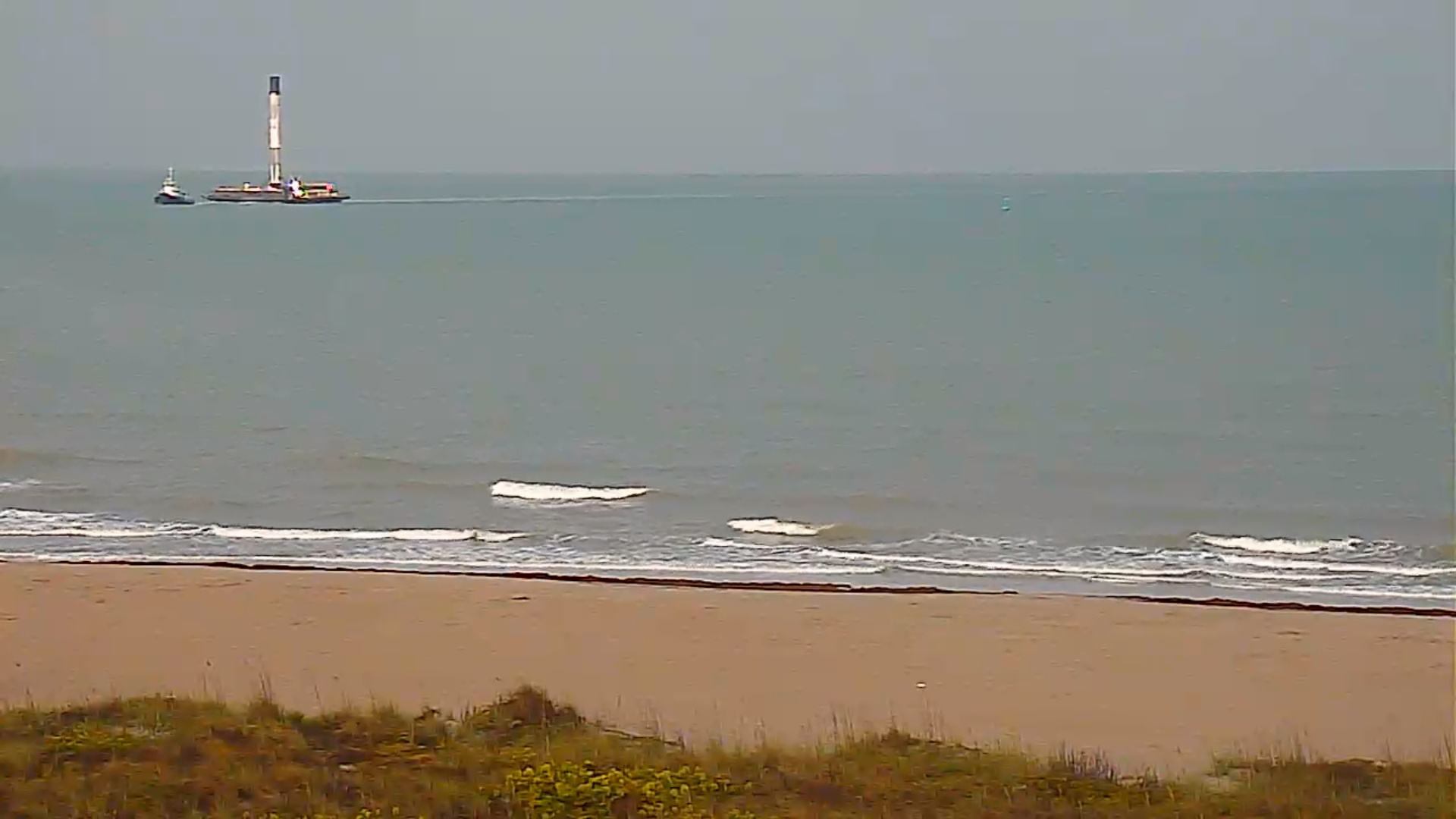




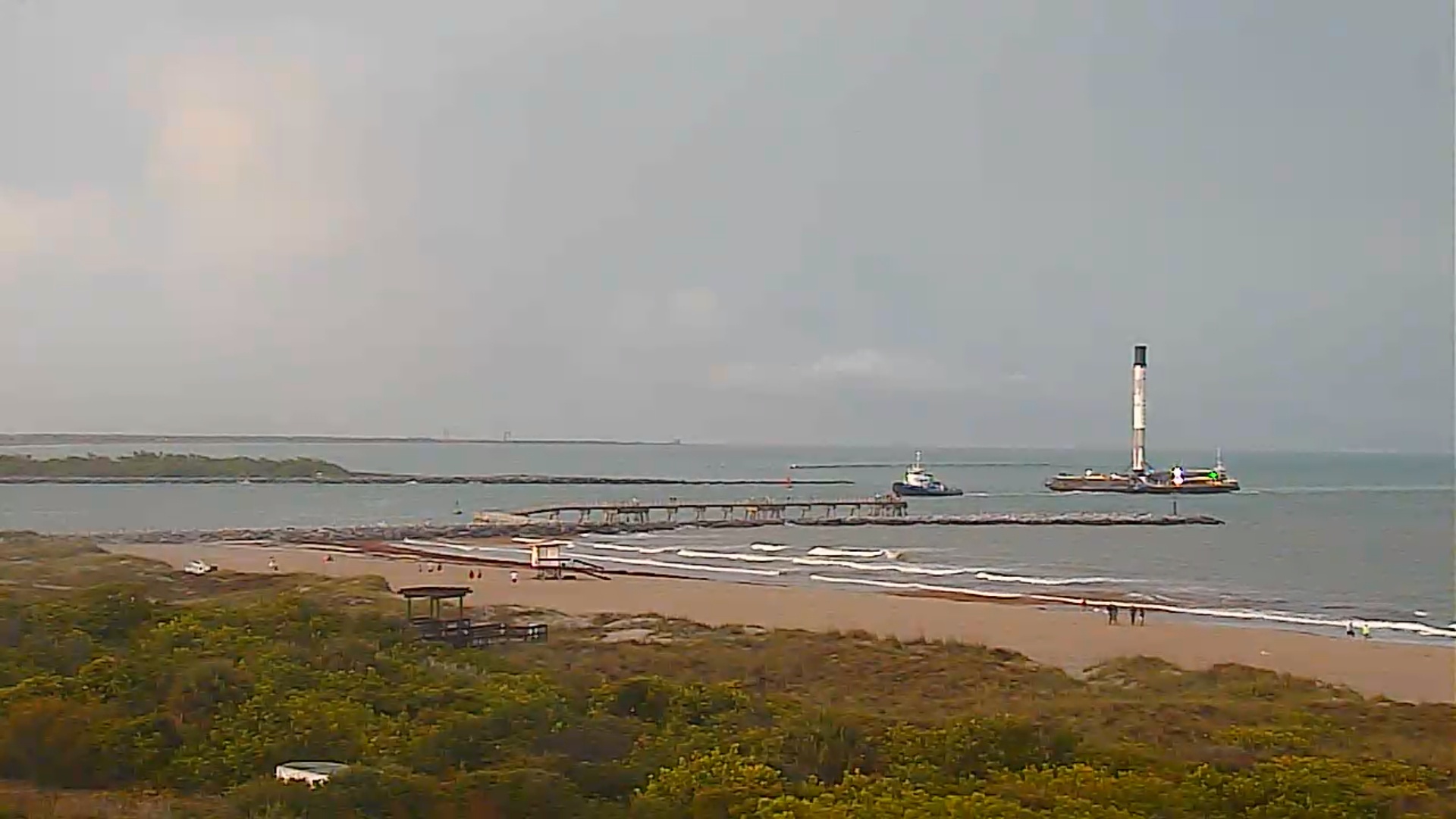



Название: Dragon SpX-17 (CRS-17), OCO-3, STP-H6 - Falcon 9-071 (B1056.1) - CCAFS SLC-40 - NET 25.04.2019, 10:20 UTC
Отправлено: tnt22 от 05.05.2019 02:06:43
Отправлено: tnt22 от 05.05.2019 02:06:43
ЦитироватьSpaceXFleet Updates @SpaceXFleet (https://twitter.com/SpaceXFleet) 7 мин. назад (https://twitter.com/SpaceXFleet/status/1124810332822822913)
Arrival! Just 16 hours after delivering Dragon to orbit and landing on Of Course I Still Love You, B1056 has returned to Port Canaveral!
Photo: http://visitspacecoast.com (https://t.co/pgQByOrhhT)
Название: Dragon SpX-17 (CRS-17), OCO-3, STP-H6 - Falcon 9-071 (B1056.1) - CCAFS SLC-40 - NET 25.04.2019, 10:20 UTC
Отправлено: tnt22 от 05.05.2019 02:07:08
Отправлено: tnt22 от 05.05.2019 02:07:08
ЦитироватьSpaceXFleet Updates @SpaceXFleet (https://twitter.com/SpaceXFleet) 50 сек. назад (https://twitter.com/SpaceXFleet/status/1124812235711352832)
Good deployment of OctaGrabber! Photo: http://visitspacecoast.com (https://t.co/pgQByOrhhT)
Название: Dragon SpX-17 (CRS-17), OCO-3, STP-H6 - Falcon 9-071 (B1056.1) - CCAFS SLC-40 - NET 25.04.2019, 10:20 UTC
Отправлено: tnt22 от 05.05.2019 02:09:39
Отправлено: tnt22 от 05.05.2019 02:09:39
А из-за этого болтались в окияне...
ЦитироватьMarcus Cote @marcuscotephoto (https://twitter.com/marcuscotephoto) 35 мин. назад (https://twitter.com/marcuscotephoto/status/1124804364646928385)
Here's a panorama of an incredible #shelfcloud (https://twitter.com/hashtag/shelfcloud?src=hash) and turquoise rain core associated with a severe-warned thunderstorm that passed over Satellite Beach, Florida moments ago. The shelf made way to strong wind gusts, extreme precipitation, and very frequent CG lightning. #flwx (https://twitter.com/hashtag/flwx?src=hash)
Название: Dragon SpX-17 (CRS-17), OCO-3, STP-H6 - Falcon 9-071 (B1056.1) - CCAFS SLC-40 - NET 25.04.2019, 10:20 UTC
Отправлено: tnt22 от 05.05.2019 02:32:38
Отправлено: tnt22 от 05.05.2019 02:32:38
ЦитироватьGreg Scott @lake_sea_mtns (https://twitter.com/lake_sea_mtns) 12 мин. назад (https://twitter.com/lake_sea_mtns/status/1124815938321301504)
OCISLY and the flotilla finally navigate the storms and get into port. @nextspaceflight (https://twitter.com/nextspaceflight) @SpaceXFleet (https://twitter.com/SpaceXFleet) #CRS17 (https://twitter.com/hashtag/CRS17?src=hash) #SpaceX (https://twitter.com/hashtag/SpaceX?src=hash) @NASASpaceflight (https://twitter.com/NASASpaceflight)
3 мин. назад (https://twitter.com/lake_sea_mtns/status/1124818095644848128)
Happy to get CRS17 home, time to recondition for next launch @nextspaceflight (https://twitter.com/nextspaceflight) @SpaceXUpdates (https://twitter.com/SpaceXUpdates) @ChrisG_NSF (https://twitter.com/ChrisG_NSF) #SpaceX (https://twitter.com/hashtag/SpaceX?src=hash) #CRS17 (https://twitter.com/hashtag/CRS17?src=hash) #OCISLY (https://twitter.com/hashtag/OCISLY?src=hash) #CRS17 (https://twitter.com/hashtag/CRS17?src=hash)
Название: Dragon SpX-17 (CRS-17), OCO-3, STP-H6 - Falcon 9-071 (B1056.1) - CCAFS SLC-40 - NET 25.04.2019, 10:20 UTC
Отправлено: tnt22 от 05.05.2019 02:43:02
Отправлено: tnt22 от 05.05.2019 02:43:02
Название: Dragon SpX-17 (CRS-17), OCO-3, STP-H6 - Falcon 9-071 (B1056.1) - CCAFS SLC-40 - NET 25.04.2019, 10:20 UTC
Отправлено: tnt22 от 05.05.2019 02:43:49
Отправлено: tnt22 от 05.05.2019 02:43:49
Название: Dragon SpX-17 (CRS-17), OCO-3, STP-H6 - Falcon 9-071 (B1056.1) - CCAFS SLC-40 - NET 25.04.2019, 10:20 UTC
Отправлено: tnt22 от 05.05.2019 03:00:46
Отправлено: tnt22 от 05.05.2019 03:00:46
Швартовка на закате (местный закат на 4 мая - 19:59 EDT)

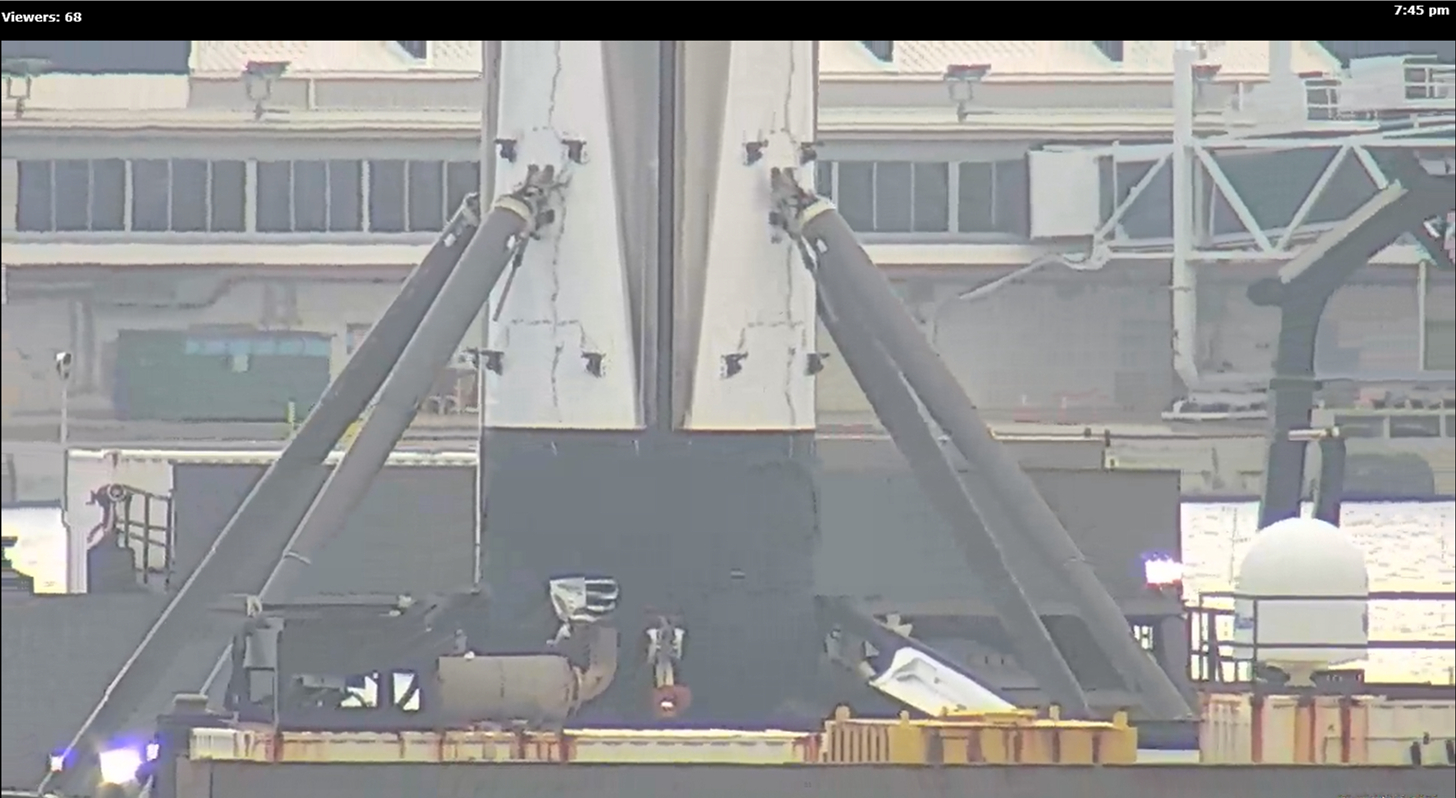
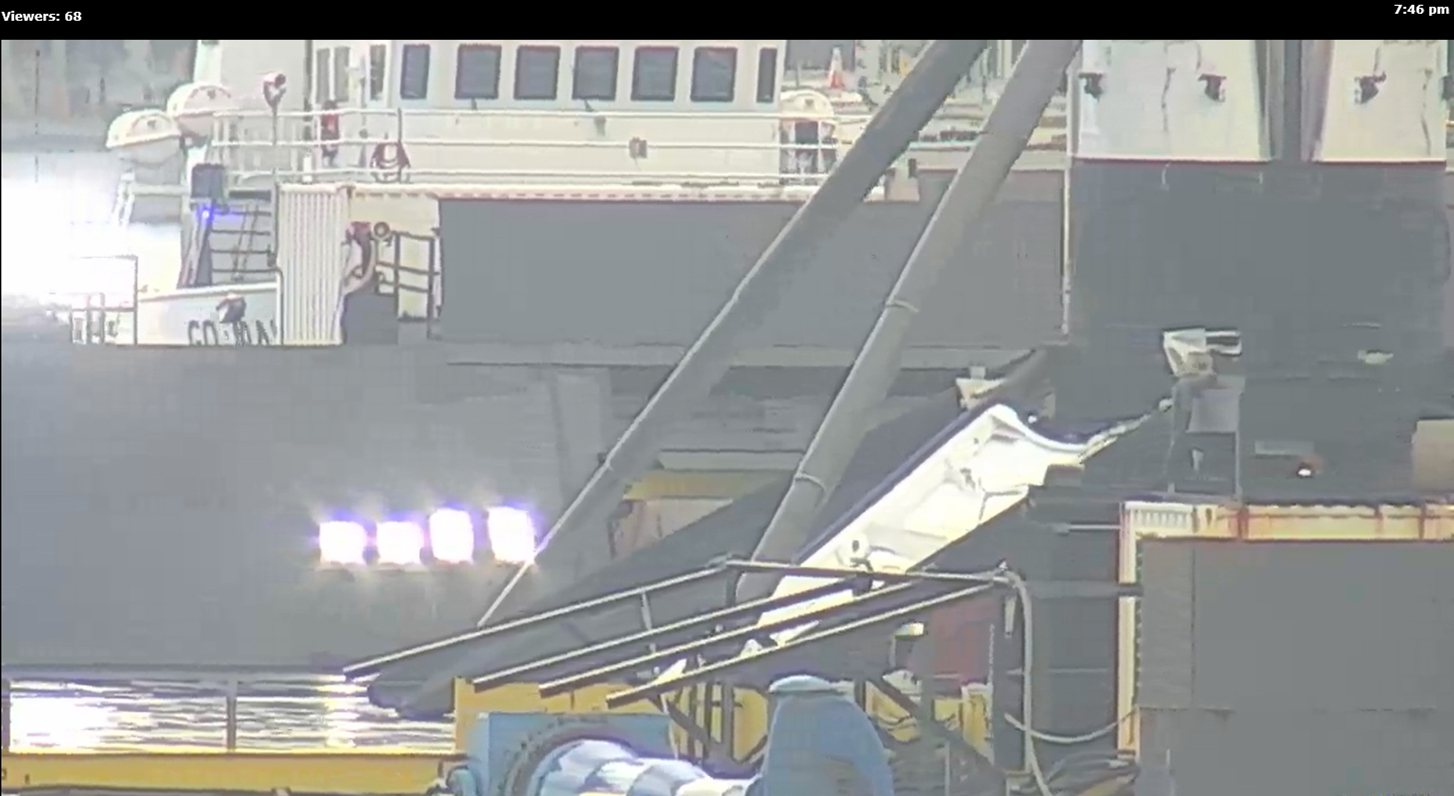




Название: Dragon SpX-17 (CRS-17), OCO-3, STP-H6 - Falcon 9-071 (B1056.1) - CCAFS SLC-40 - NET 25.04.2019, 10:20 UTC
Отправлено: tnt22 от 05.05.2019 03:02:25
Отправлено: tnt22 от 05.05.2019 03:02:25
ЦитироватьSpaceXFleet Updates @SpaceXFleet (https://twitter.com/SpaceXFleet) 7 мин. назад (https://twitter.com/SpaceXFleet/status/1124824692794232833)
Of Course I Still Love You and B1056.1 have been berthed in Port Canaveral.
Название: Dragon SpX-17 (CRS-17), OCO-3, STP-H6 - Falcon 9-071 (B1056.1) - CCAFS SLC-40 - NET 25.04.2019, 10:20 UTC
Отправлено: tnt22 от 05.05.2019 03:09:24
Отправлено: tnt22 от 05.05.2019 03:09:24
Название: Dragon SpX-17 (CRS-17), OCO-3, STP-H6 - Falcon 9-071 (B1056.1) - CCAFS SLC-40 - NET 25.04.2019, 10:20 UTC
Отправлено: tnt22 от 05.05.2019 10:44:44
Отправлено: tnt22 от 05.05.2019 10:44:44
ЦитироватьJulia @julia_bergeron (https://twitter.com/julia_bergeron) 7 ч. назад (https://twitter.com/julia_bergeron/status/1124832280298577920)
Ummmm this is not normal. #CRS17 (https://twitter.com/hashtag/CRS17?src=hash) #SpaceXFleet (https://twitter.com/hashtag/SpaceXFleet?src=hash)
7 ч. назад (https://twitter.com/julia_bergeron/status/1124836824072036353)
I had just got out of the truck and walked in to this. There was no green and something was flaming under the booster on deck. Nobody appears to be on deck. Crane not swung over yet. Also, why did most of the crew have on white jumpsuits on deck when they came in?
7 ч. назад (https://twitter.com/julia_bergeron/status/1124838393958027264)
Are you ok over there @octagrabber (https://twitter.com/octagrabber)?
7 ч. назад (https://twitter.com/julia_bergeron/status/1124844293355724802)
I'm not sure what the plan is for the night but I have to get going. Booster on deck not capped, crane not moving and I don't see anybody around. *dunno*
Название: Dragon SpX-17 (CRS-17), OCO-3, STP-H6 - Falcon 9-071 (B1056.1) - CCAFS SLC-40 - NET 25.04.2019, 10:20 UTC
Отправлено: Ну-и-ну от 05.05.2019 22:38:06
Отправлено: Ну-и-ну от 05.05.2019 22:38:06
Cжигали TEA-TEB?
Название: Dragon SpX-17 (CRS-17), OCO-3, STP-H6 - Falcon 9-071 (B1056.1) - CCAFS SLC-40 - NET 25.04.2019, 10:20 UTC
Отправлено: opinion от 05.05.2019 16:34:24
Отправлено: opinion от 05.05.2019 16:34:24
Цитироватьtnt22 пишет:А что, раньше и по ночам работали?ЦитироватьJulia @julia_bergeron 7 ч. назад (https://twitter.com/julia_bergeron/status/1124832280298577920)
Booster on deck not capped, crane not moving and I don't see anybody around.
Название: Dragon SpX-17 (CRS-17), OCO-3, STP-H6 - Falcon 9-071 (B1056.1) - CCAFS SLC-40 - NET 25.04.2019, 10:20 UTC
Отправлено: tnt22 от 05.05.2019 16:53:48
Отправлено: tnt22 от 05.05.2019 16:53:48
ЦитироватьJenniferKrafftPhotography @KrafftJennifer (https://twitter.com/KrafftJennifer) 9 ч. назад (https://twitter.com/KrafftJennifer/status/1124905619230810112)
#SpaceX (https://twitter.com/hashtag/SpaceX?src=hash) #Falcon9 (https://twitter.com/hashtag/Falcon9?src=hash) on the droneship in Port Canaveral giving us a show. Not sure why exactly this is happening but it was cool sight to see!Спойлер
[свернуть]
Название: Dragon SpX-17 (CRS-17), OCO-3, STP-H6 - Falcon 9-071 (B1056.1) - CCAFS SLC-40 - NET 25.04.2019, 10:20 UTC
Отправлено: tnt22 от 05.05.2019 16:59:33
Отправлено: tnt22 от 05.05.2019 16:59:33
К #276 (http://novosti-kosmonavtiki.ru/forum/messages/forum10/topic16730/message1851127/#message1851127), #274 (http://novosti-kosmonavtiki.ru/forum/messages/forum10/topic16730/message1851116/#message1851116)
ЦитироватьJulia @julia_bergeron (https://twitter.com/julia_bergeron) 4 ч. назад (https://twitter.com/julia_bergeron/status/1124977500948443136)
It has been decided that what I saw last night was most likelly a TEA/TAB burnoff event. This is normal, just usually not seen in port. Kudos to @KrafftJennifer (https://twitter.com/KrafftJennifer) for having your camera at the ready to capture the green sparks.
Название: Dragon SpX-17 (CRS-17), OCO-3, STP-H6 - Falcon 9-071 (B1056.1) - CCAFS SLC-40 - NET 25.04.2019, 10:20 UTC
Отправлено: tnt22 от 05.05.2019 20:51:25
Отправлено: tnt22 от 05.05.2019 20:51:25
К #273 (http://novosti-kosmonavtiki.ru/forum/messages/forum10/topic16730/message1851089/#message1851089), #274 (http://novosti-kosmonavtiki.ru/forum/messages/forum10/topic16730/message1851116/#message1851116), #276 (http://novosti-kosmonavtiki.ru/forum/messages/forum10/topic16730/message1851127/#message1851127)
ЦитироватьPatrick Lambrich @lambrichpat (https://twitter.com/lambrichpat) 6 ч. назад (https://twitter.com/lambrichpat/status/1125011061470584833)
Helium detanking process of arrived Falcon 9 booster at Port Canaveral.
6 ч. назад (https://twitter.com/lambrichpat/status/1125011579819393029)
Short engine ignition directly in Port Canaveral. Could be remaining engine ignition fluid that has to be burnt up.
Название: Dragon SpX-17 (CRS-17), OCO-3, STP-H6 - Falcon 9-071 (B1056.1) - CCAFS SLC-40 - NET 25.04.2019, 10:20 UTC
Отправлено: tnt22 от 05.05.2019 20:51:37
Отправлено: tnt22 от 05.05.2019 20:51:37
ЦитироватьMurfam Post @Restrantek (https://twitter.com/Restrantek) 54 мин. назад (https://twitter.com/Restrantek/status/1125080356372267009)
Activity on #OCISLY (https://twitter.com/hashtag/OCISLY?src=hash) this morning. #SpaceX (https://twitter.com/hashtag/SpaceX?src=hash)Спойлер
[свернуть]
Название: Dragon SpX-17 (CRS-17), OCO-3, STP-H6 - Falcon 9-071 (B1056.1) - CCAFS SLC-40 - NET 25.04.2019, 10:20 UTC
Отправлено: tnt22 от 06.05.2019 01:34:59
Отправлено: tnt22 от 06.05.2019 01:34:59
ЦитироватьISS National LabПодлинная учетная запись @ISS_CASIS (https://twitter.com/ISS_CASIS) 14 мин. назад (https://twitter.com/ISS_CASIS/status/1125163264579649536)
The @SpaceX (https://twitter.com/SpaceX) Dragon cargo spacecraft is expected to arrive at the @Space_Station (https://twitter.com/Space_Station) early tomorrow after Saturday's successful launch. Get up early and catch live coverage of the rendezvous and capture on http://nasa.gov/live (https://t.co/xU5g32CT7L) beginning at 5:30 a.m. EDT.
Image credit: NASA
Название: Dragon SpX-17 (CRS-17), OCO-3, STP-H6 - Falcon 9-071 (B1056.1) - CCAFS SLC-40 - NET 25.04.2019, 10:20 UTC
Отправлено: tnt22 от 06.05.2019 11:45:48
Отправлено: tnt22 от 06.05.2019 11:45:48
ЦитироватьNASAПодлинная учетная запись @NASA (https://twitter.com/NASA) 6 ч. назад (https://twitter.com/NASA/status/1125234083460722689)
After launching Saturday, @SpaceX (https://twitter.com/SpaceX)'s #Dragon (https://twitter.com/hashtag/Dragon?src=hash) spacecraft is set to deliver science, supplies and hardware to the @Space_Station (https://twitter.com/Space_Station) on Monday morning.
Join us starting at 5:30am ET as it rendezvous with the orbiting laboratory. Capture set for 7:30am ET. Watch: https://go.nasa.gov/2PWxH5n (https://t.co/sZscIVi2cW)
Название: Dragon SpX-17 (CRS-17), OCO-3, STP-H6 - Falcon 9-071 (B1056.1) - CCAFS SLC-40 - NET 25.04.2019, 10:20 UTC
Отправлено: tnt22 от 06.05.2019 12:27:47
Отправлено: tnt22 от 06.05.2019 12:27:47
Название: Dragon SpX-17 (CRS-17), OCO-3, STP-H6 - Falcon 9-071 (B1056.1) - CCAFS SLC-40 - NET 25.04.2019, 10:20 UTC
Отправлено: tnt22 от 06.05.2019 12:40:19
Отправлено: tnt22 от 06.05.2019 12:40:19
250 м

Название: Dragon SpX-17 (CRS-17), OCO-3, STP-H6 - Falcon 9-071 (B1056.1) - CCAFS SLC-40 - NET 25.04.2019, 10:20 UTC
Отправлено: tnt22 от 06.05.2019 12:41:34
Отправлено: tnt22 от 06.05.2019 12:41:34
Название: Dragon SpX-17 (CRS-17), OCO-3, STP-H6 - Falcon 9-071 (B1056.1) - CCAFS SLC-40 - NET 25.04.2019, 10:20 UTC
Отправлено: tnt22 от 06.05.2019 12:43:34
Отправлено: tnt22 от 06.05.2019 12:43:34
Название: Dragon SpX-17 (CRS-17), OCO-3, STP-H6 - Falcon 9-071 (B1056.1) - CCAFS SLC-40 - NET 25.04.2019, 10:20 UTC
Отправлено: tnt22 от 06.05.2019 12:44:30
Отправлено: tnt22 от 06.05.2019 12:44:30
200 м

Название: Dragon SpX-17 (CRS-17), OCO-3, STP-H6 - Falcon 9-071 (B1056.1) - CCAFS SLC-40 - NET 25.04.2019, 10:20 UTC
Отправлено: tnt22 от 06.05.2019 12:45:42
Отправлено: tnt22 от 06.05.2019 12:45:42
Название: Dragon SpX-17 (CRS-17), OCO-3, STP-H6 - Falcon 9-071 (B1056.1) - CCAFS SLC-40 - NET 25.04.2019, 10:20 UTC
Отправлено: tnt22 от 06.05.2019 12:52:28
Отправлено: tnt22 от 06.05.2019 12:52:28
Название: Dragon SpX-17 (CRS-17), OCO-3, STP-H6 - Falcon 9-071 (B1056.1) - CCAFS SLC-40 - NET 25.04.2019, 10:20 UTC
Отправлено: tnt22 от 06.05.2019 13:05:18
Отправлено: tnt22 от 06.05.2019 13:05:18
https://blogs.nasa.gov/spacestation/2019/05/06/nasa-tv-coverage-begins-of-the-spacex-dragon-approaching-station/
ЦитироватьNASA TV Coverage Begins of the SpaceX Dragon Approaching Station
Norah Moran (https://blogs.nasa.gov/spacestation/author/nfmoran/)
Posted May 6, 2019 at 5:52 am(https://img.novosti-kosmonavtiki.ru/131706.jpg)
The SpaceX Dragon cargo craft approaches the International Space Station for a robotic capture
Flight control teams for the International Space Station (http://www.nasa.gov/station) and SpaceX are proceeding toward grapple of the Dragon cargo spacecraft this morning. Capture is expected around 7 a.m. EDT. NASA Television coverage has begun. Watch live at http://www.nasa.gov/live.
Expedition 59 astronauts David Saint-Jacques of the Canadian Space Agency and Nick Hague (https://www.nasa.gov/astronauts/biographies/tyler-nick-hague) of NASA will use the space station's robotic arm to grapple Dragon around 7 a.m. Coverage of robotic installation to the Earth-facing port of the Harmony module will begin at 9 a.m.
The Dragon lifted off on a SpaceX Falcon 9 rocket from Space Launch Complex 40 at Cape Canaveral Air Force Station in Florida Saturday, May 4 with more than 5,500 pounds of research (https://www.nasa.gov/mission_pages/station/research/news/spx17-research), equipment, cargo and supplies that will support dozens of investigations aboard the orbiting laboratory.
Название: Dragon SpX-17 (CRS-17), OCO-3, STP-H6 - Falcon 9-071 (B1056.1) - CCAFS SLC-40 - NET 25.04.2019, 10:20 UTC
Отправлено: tnt22 от 06.05.2019 13:08:09
Отправлено: tnt22 от 06.05.2019 13:08:09
ЦитироватьChris B - NSF @NASASpaceflight (https://twitter.com/NASASpaceflight) 6 мин. назад (https://twitter.com/NASASpaceflight/status/1125339340035506176)
There's the ISS symbol on the C113.2 Dragon, earned during her previous flight on CRS-12.
Название: Dragon SpX-17 (CRS-17), OCO-3, STP-H6 - Falcon 9-071 (B1056.1) - CCAFS SLC-40 - NET 25.04.2019, 10:20 UTC
Отправлено: tnt22 от 06.05.2019 13:16:09
Отправлено: tnt22 от 06.05.2019 13:16:09
Название: Dragon SpX-17 (CRS-17), OCO-3, STP-H6 - Falcon 9-071 (B1056.1) - CCAFS SLC-40 - NET 25.04.2019, 10:20 UTC
Отправлено: tnt22 от 06.05.2019 13:16:58
Отправлено: tnt22 от 06.05.2019 13:16:58
Название: Dragon SpX-17 (CRS-17), OCO-3, STP-H6 - Falcon 9-071 (B1056.1) - CCAFS SLC-40 - NET 25.04.2019, 10:20 UTC
Отправлено: tnt22 от 06.05.2019 13:28:45
Отправлено: tnt22 от 06.05.2019 13:28:45
ЦитироватьChris B - NSF @NASASpaceflight (https://twitter.com/NASASpaceflight) 4 мин. назад (https://twitter.com/NASASpaceflight/status/1125343499082248192)
So there's a cable - as people spotted in earlier views - running down the side of Dragon that is now causing some interest to MCC-H.
3 мин. назад (https://twitter.com/NASASpaceflight/status/1125343834693611521)
You can see this cable here. No idea where it's from....either from Falcon 9 or Dragon itself.
2 мин. назад (https://twitter.com/NASASpaceflight/status/1125344067880128512)
MCC-H say it is off-nominal, but shouldn't be an issue for ROBO ops at this time.
Название: Dragon SpX-17 (CRS-17), OCO-3, STP-H6 - Falcon 9-071 (B1056.1) - CCAFS SLC-40 - NET 25.04.2019, 10:20 UTC
Отправлено: tnt22 от 06.05.2019 13:38:14
Отправлено: tnt22 от 06.05.2019 13:38:14
Цитировать05/06/2019 13:26 Stephen Clark
Engineers in NASA's space station flight control room in Houston just informed the space station crew that a cable or line coming out of the Dragon capsule is not expected to interfere with today's capture of the ship using the station's robotic arm.
"We noticed a line on Dragon that we weren't expecting to be there," spacecraft communicator Brandon Lloyd just radioed the station crew from Houston. "Our initial looks at it is that we don't expect any interference with the operations today."
"We noticed," said Nick Hague, a flight engineer on the station. "It looks like a cable that's maybe 6-to-10 feet in length running down from maybe the bottom of the capsule down into the service module."
Mission control says the assessment of engineers on the ground is that the line is not interfering with the grapple fixture, which is needed for the robotic arm to capture the Dragon cargo craft.
"We haven't seen any gross motion out of it," Hague said. "Looks like it's connected close to the grapple fixture (and) maybe loose on the other end. If we see anything squirrelly happen, we'll let you know."
05/06/2019 13:28 Stephen Clark
Mission control has instructed the station crew to abort the capture of the Dragon cargo craft of the loose line on Dragon drifts into the path of the robotic arm during the grapple sequence.
Название: Dragon SpX-17 (CRS-17), OCO-3, STP-H6 - Falcon 9-071 (B1056.1) - CCAFS SLC-40 - NET 25.04.2019, 10:20 UTC
Отправлено: tnt22 от 06.05.2019 13:41:31
Отправлено: tnt22 от 06.05.2019 13:41:31
Название: Dragon SpX-17 (CRS-17), OCO-3, STP-H6 - Falcon 9-071 (B1056.1) - CCAFS SLC-40 - NET 25.04.2019, 10:20 UTC
Отправлено: tnt22 от 06.05.2019 13:42:45
Отправлено: tnt22 от 06.05.2019 13:42:45
30 м

Название: Dragon SpX-17 (CRS-17), OCO-3, STP-H6 - Falcon 9-071 (B1056.1) - CCAFS SLC-40 - NET 25.04.2019, 10:20 UTC
Отправлено: tnt22 от 06.05.2019 13:43:59
Отправлено: tnt22 от 06.05.2019 13:43:59
Название: Dragon SpX-17 (CRS-17), OCO-3, STP-H6 - Falcon 9-071 (B1056.1) - CCAFS SLC-40 - NET 25.04.2019, 10:20 UTC
Отправлено: tnt22 от 06.05.2019 13:44:49
Отправлено: tnt22 от 06.05.2019 13:44:49
Название: Dragon SpX-17 (CRS-17), OCO-3, STP-H6 - Falcon 9-071 (B1056.1) - CCAFS SLC-40 - NET 25.04.2019, 10:20 UTC
Отправлено: tnt22 от 06.05.2019 13:46:50
Отправлено: tnt22 от 06.05.2019 13:46:50
Цитировать05/06/2019 13:31 Stephen Clark
The Dragon spacecraft has resumed its automated approach toward the capture box around 10 meters, or 32, feet from the space station.
Название: Dragon SpX-17 (CRS-17), OCO-3, STP-H6 - Falcon 9-071 (B1056.1) - CCAFS SLC-40 - NET 25.04.2019, 10:20 UTC
Отправлено: tnt22 от 06.05.2019 13:56:16
Отправлено: tnt22 от 06.05.2019 13:56:16
12 м
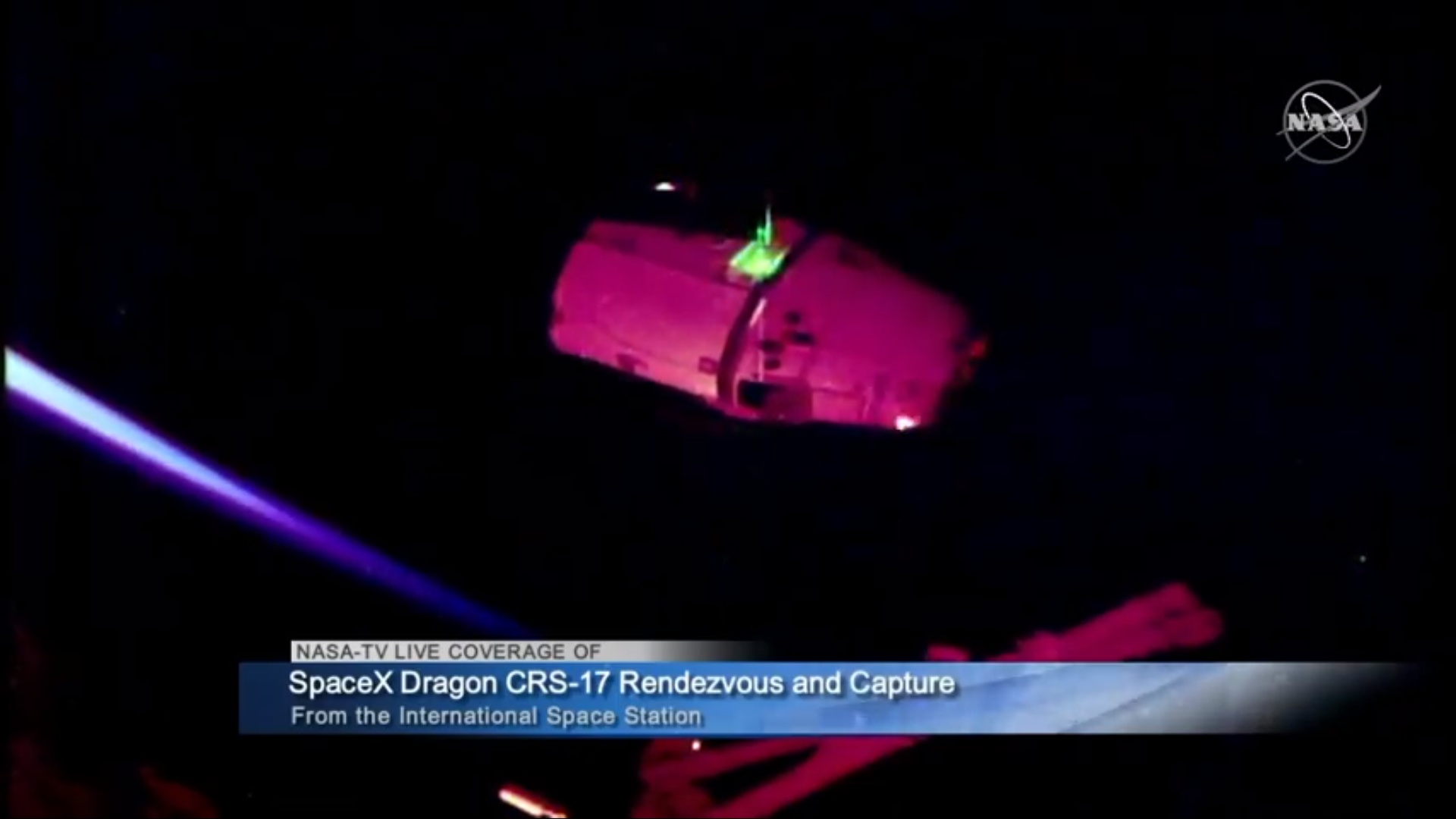
Название: Dragon SpX-17 (CRS-17), OCO-3, STP-H6 - Falcon 9-071 (B1056.1) - CCAFS SLC-40 - NET 25.04.2019, 10:20 UTC
Отправлено: tnt22 от 06.05.2019 14:00:52
Отправлено: tnt22 от 06.05.2019 14:00:52
Цитировать05/06/2019 13:48 Stephen Clark
Dragon has arrived at the capture point 10 meters, or 32 feet, beneath the space station and within the reach of the 58-foot robotic arm.
Название: Dragon SpX-17 (CRS-17), OCO-3, STP-H6 - Falcon 9-071 (B1056.1) - CCAFS SLC-40 - NET 25.04.2019, 10:20 UTC
Отправлено: tnt22 от 06.05.2019 14:09:27
Отправлено: tnt22 от 06.05.2019 14:09:27
ЦитироватьSpaceXПодлинная учетная запись @SpaceX (https://twitter.com/SpaceX) 49 сек. назад (https://twitter.com/SpaceX/status/1125352113876291584)
Dragon is ~10 meters from @Space_Station (https://twitter.com/Space_Station). Capture sequence starting shortly → http://nasa.gov/ntv (https://t.co/rdhLIxXhnI)
Название: Dragon SpX-17 (CRS-17), OCO-3, STP-H6 - Falcon 9-071 (B1056.1) - CCAFS SLC-40 - NET 25.04.2019, 10:20 UTC
Отправлено: tnt22 от 06.05.2019 14:19:12
Отправлено: tnt22 от 06.05.2019 14:19:12
10 м
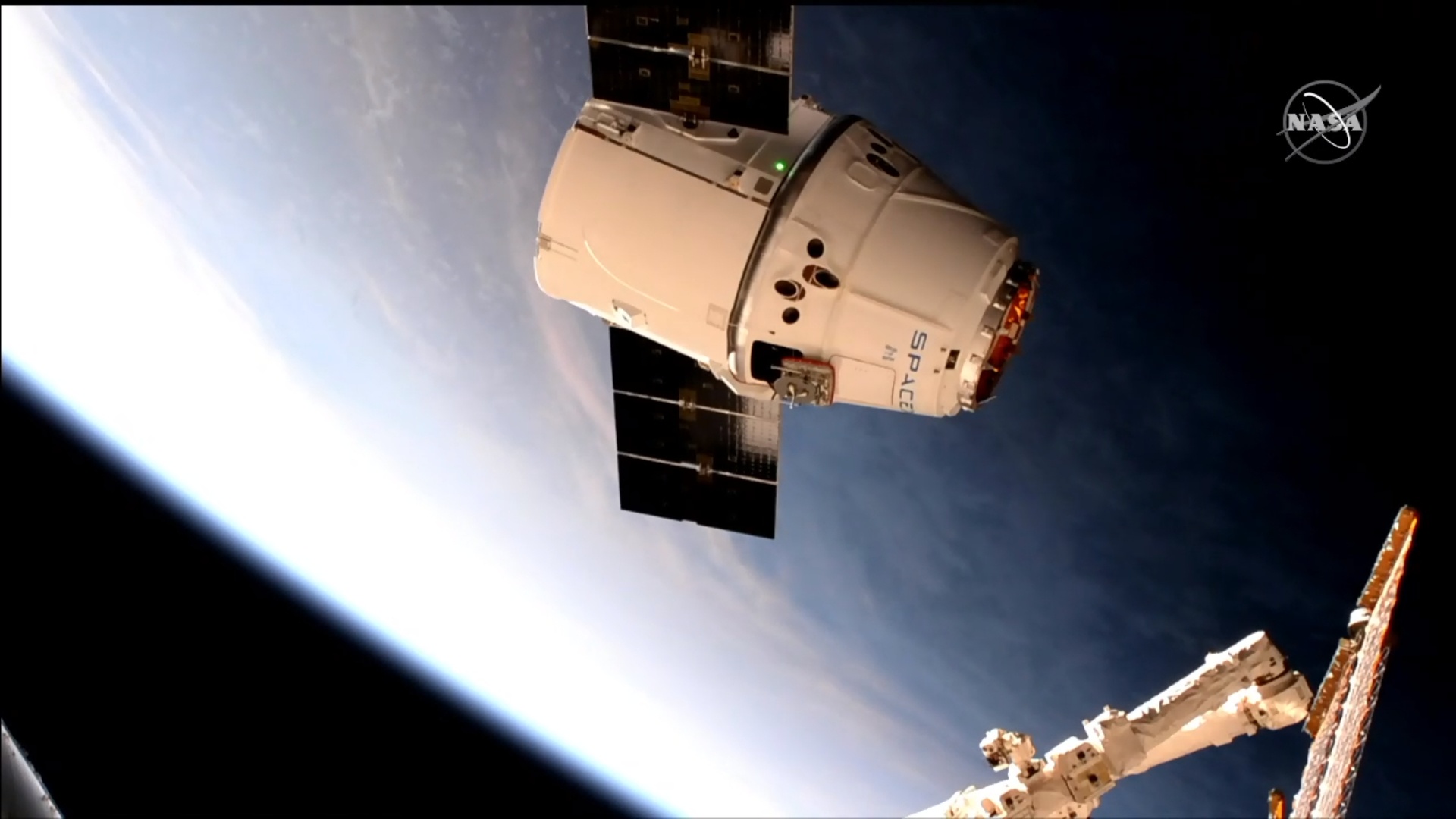
Название: Dragon SpX-17 (CRS-17), OCO-3, STP-H6 - Falcon 9-071 (B1056.1) - CCAFS SLC-40 - NET 25.04.2019, 10:20 UTC
Отправлено: tnt22 от 06.05.2019 14:23:14
Отправлено: tnt22 от 06.05.2019 14:23:14
Название: Dragon SpX-17 (CRS-17), OCO-3, STP-H6 - Falcon 9-071 (B1056.1) - CCAFS SLC-40 - NET 25.04.2019, 10:20 UTC
Отправлено: tnt22 от 06.05.2019 14:26:59
Отправлено: tnt22 от 06.05.2019 14:26:59
Цитировать05/06/2019 13:58 Stephen Clark
The Canadarm 2 is now in motion to maneuver toward the Dragon spacecraft's grapple fixture.
Название: Dragon SpX-17 (CRS-17), OCO-3, STP-H6 - Falcon 9-071 (B1056.1) - CCAFS SLC-40 - NET 25.04.2019, 10:20 UTC
Отправлено: tnt22 от 06.05.2019 14:30:00
Отправлено: tnt22 от 06.05.2019 14:30:00
4 м
Название: Dragon SpX-17 (CRS-17), OCO-3, STP-H6 - Falcon 9-071 (B1056.1) - CCAFS SLC-40 - NET 25.04.2019, 10:20 UTC
Отправлено: tnt22 от 06.05.2019 15:08:12
Отправлено: tnt22 от 06.05.2019 15:08:12
1 м


Есть захват!!!


Есть захват!!!
Название: Dragon SpX-17 (CRS-17), OCO-3, STP-H6 - Falcon 9-071 (B1056.1) - CCAFS SLC-40 - NET 25.04.2019, 10:20 UTC
Отправлено: tnt22 от 06.05.2019 15:12:15
Отправлено: tnt22 от 06.05.2019 15:12:15
Цитировать05/06/2019 14:02 Stephen Clark
Capture confirmed! The robotic arm grappled Dragon as the space station flew more than 250 miles in altitude over the North Atlantic Ocean.(https://photo.24liveblog.com/2242762235231691057/20190506110249_134262.jpg)
Название: Dragon SpX-17 (CRS-17), OCO-3, STP-H6 - Falcon 9-071 (B1056.1) - CCAFS SLC-40 - NET 25.04.2019, 10:20 UTC
Отправлено: tnt22 от 06.05.2019 15:13:39
Отправлено: tnt22 от 06.05.2019 15:13:39
Цитировать05/06/2019 14:03 Stephen Clark
Capture occurred at 7:01 a.m. EDT (1101 GMT).
Название: Dragon SpX-17 (CRS-17), OCO-3, STP-H6 - Falcon 9-071 (B1056.1) - CCAFS SLC-40 - NET 25.04.2019, 10:20 UTC
Отправлено: tnt22 от 06.05.2019 15:14:25
Отправлено: tnt22 от 06.05.2019 15:14:25
ЦитироватьSpaceXПодлинная учетная запись @SpaceX (https://twitter.com/SpaceX) 04:04 PDT (https://twitter.com/SpaceX/status/1125355546549207044) - 6 мая 2019 г.
Capture confirmed! Dragon is now attached to the @Space_Station (https://twitter.com/Space_Station) robotic arm
Название: Dragon SpX-17 (CRS-17), OCO-3, STP-H6 - Falcon 9-071 (B1056.1) - CCAFS SLC-40 - NET 25.04.2019, 10:20 UTC
Отправлено: tnt22 от 06.05.2019 15:15:26
Отправлено: tnt22 от 06.05.2019 15:15:26
Название: Dragon SpX-17 (CRS-17), OCO-3, STP-H6 - Falcon 9-071 (B1056.1) - CCAFS SLC-40 - NET 25.04.2019, 10:20 UTC
Отправлено: tnt22 от 06.05.2019 15:18:38
Отправлено: tnt22 от 06.05.2019 15:18:38
ЦитироватьChris B - NSF @NASASpaceflight (https://twitter.com/NASASpaceflight) 04:03 PDT (https://twitter.com/NASASpaceflight/status/1125355462067740672) - 6 мая 2019 г.
CAPTURE CONFIRMED. SpaceX's CRS-17 Dragon has been captured by the SSRMS ahead of berthing on the ISS.
ARTICLE:
https://www.nasaspaceflight.com/2019/05/spacex-falcon-9-dragons-crs-17-mission-iss/ ... (https://t.co/atmnHEIkcp)
Название: Dragon SpX-17 (CRS-17), OCO-3, STP-H6 - Falcon 9-071 (B1056.1) - CCAFS SLC-40 - NET 25.04.2019, 10:20 UTC
Отправлено: tnt22 от 06.05.2019 15:39:35
Отправлено: tnt22 от 06.05.2019 15:39:35
https://ria.ru/20190506/1553298037.html
ЦитироватьСнаружи корабля Dragon при сближении с МКС обнаружили болтающийся кабель
14:01
МОСКВА, 6 мая - РИА Новости. Болтающийся кабель обнаружен снаружи американского грузового корабля Dragon при его сближении с Международной космической станцией (МКС), однако, по мнению специалистов, он не должен помешать астронавтам захватить корабль манипулятором станции.
Корабль Dragon с грузами для экипажа МКС был выведен на орбиту 4 мая, в понедельник он должен пристыковаться к станции. Трансляция сближения Dragon с МКС ведется на сайте НАСА.
Специалисты центра управления полетами в Хьюстоне проинформировали экипаж об обнаружении болтающегося кабеля снаружи Dragon, астронавты подтвердили, что тоже его видят. Специалисты сказали астронавтам, что кабель не должен помешать ловле корабля манипулятором, однако порекомендовали экипажу выдать команду на увод Dragon от МКС, если кабель попадет в узел захвата корабля.
Во время трансляции также добавили, что кабель не отделился от корабля при старте ракеты-носителя Falcon-9.
На борту МКС находится экипаж из россиян Олега Кононенко и Алексея Овчинина, американцев Энн Макклейн, Ника Хейга и Кристины Кук, а также канадца Давида Сен-Жака.
С прибытием Dragon число "припаркованных" на МКС кораблей увеличится до шести, в настоящее время там находится американский грузовой аппарат Cygnus, а также по паре российских грузовиков "Прогресс" и пилотируемых кораблей "Союз". Планируется, что Dragon будет оставаться на станции около месяца, после чего вернется на Землю с материалами научных экспериментов.
Название: Dragon SpX-17 (CRS-17), OCO-3, STP-H6 - Falcon 9-071 (B1056.1) - CCAFS SLC-40 - NET 25.04.2019, 10:20 UTC
Отправлено: tnt22 от 06.05.2019 15:45:24
Отправлено: tnt22 от 06.05.2019 15:45:24
https://blogs.nasa.gov/spacestation/2019/05/06/astronaut-commands-robotic-arm-to-capture-dragon-cargo-craft/
ЦитироватьAstronaut Commands Robotic Arm to Capture Dragon Cargo Craft
Norah Moran (https://blogs.nasa.gov/spacestation/author/nfmoran/)
Posted May 6, 2019 at 7:09 am(https://img.novosti-kosmonavtiki.ru/131707.jpg)
The SpaceX Dragon CRS-17 Cargo Craft captured and attached to the CanadaArm2.
While the International Space Station (http://www.nasa.gov/station) was traveling over the north Atlantic Ocean, astronauts David Saint-Jacques of the Canadian Space Agency and Nick Hague (https://www.nasa.gov/astronauts/biographies/tyler-nick-hague) of NASA grappled Dragon at 7:01 a.m. EDT using the space station's robotic arm Canadarm2.
Ground controllers will now send commands to begin the robotic installation of the spacecraft on bottom of the station's Harmony module. NASA Television coverage of installation is scheduled to begin at 9 a.m. Watch online at www.nasa.gov/live (http://www.nasa.gov/live).
The Dragon lifted off on a SpaceX Falcon 9 rocket from Space Launch Complex 40 at Cape Canaveral Air Force Station in Florida Saturday, May 4 with more than 5,500 pounds of research (https://www.nasa.gov/mission_pages/station/research/news/spx17-research), equipment, cargo and supplies that will support dozens of investigations aboard the orbiting laboratory.
Here's some of the research arriving at station:
NASA's Orbiting Carbon Observatory-3 (OCO-3 (https://ocov3.jpl.nasa.gov/)) examines the complex dynamics of Earth's atmospheric carbon cycle by collecting measurements to track variations in a specific type of atmospheric carbon dioxide. Understanding carbon sources can aid in forecasting increased atmospheric heat retention and reduce its long-term risks.
The Photobioreactor (https://www.nasa.gov/mission_pages/station/research/news/photobioreactor-better-life-support) investigation aims to demonstrate how microalgae can be used together with existing life support systems on the space station to improve recycling of resources. The cultivation of microalgae for food, and as part of a life support system to generate oxygen and consume carbon dioxide, could be helpful in future long-duration exploration missions, as it could reduce the amount of consumables required from Earth.
Название: Dragon SpX-17 (CRS-17), OCO-3, STP-H6 - Falcon 9-071 (B1056.1) - CCAFS SLC-40 - NET 25.04.2019, 10:20 UTC
Отправлено: tnt22 от 06.05.2019 15:51:03
Отправлено: tnt22 от 06.05.2019 15:51:03
Цитировать05/06/2019 14:11 Stephen Clark
"Well done, well-captured, way to make it look easy," spacecraft communicator Brandon Lloyd radioed from mission control in Houston.
"To all the teams around the world, we welcome to the ISS the Dragon spacecraft," said David Saint-Jacques, a Canadian Space Agency flight engineer who controlled the space station's Canadian-built robotic arm for this morning's capture.
"Dragon left Cape Canaveral two days ago and brings to ISS more than 2,500 kilos of supplies, equipment and scientific equipments from institutions and companies around the world.
"As a Canadian, I'm proud every time we use Canadarm 2 for free-flyer capture," Saint-Jacques said.
NASA officials asked SpaceX last week to delay the Dragon's launch from Cape Canaveral by two days to allow time for ground controllers to replace a failed power distribution box outside the space station. The main bus distribution unit was replaced using the robotic arm and the Canadian-built Dextre robot, restoring a backup power supply to the arm in preparation for today's capture sequence.
"Even before the launch, Canadian robotics was involved in repairs to the ISS power system that were required for today's operations," Saint-Jacques said. "The extra efforts of the joint Canadian and U.S. operations and engineering teams working around the clock saved the day. Such is the value of the partnership of this international program."
Название: Dragon SpX-17 (CRS-17), OCO-3, STP-H6 - Falcon 9-071 (B1056.1) - CCAFS SLC-40 - NET 25.04.2019, 10:20 UTC
Отправлено: tnt22 от 06.05.2019 16:06:34
Отправлено: tnt22 от 06.05.2019 16:06:34
Название: Dragon SpX-17 (CRS-17), OCO-3, STP-H6 - Falcon 9-071 (B1056.1) - CCAFS SLC-40 - NET 25.04.2019, 10:20 UTC
Отправлено: tnt22 от 06.05.2019 16:12:36
Отправлено: tnt22 от 06.05.2019 16:12:36
Название: Dragon SpX-17 (CRS-17), OCO-3, STP-H6 - Falcon 9-071 (B1056.1) - CCAFS SLC-40 - NET 25.04.2019, 10:20 UTC
Отправлено: tnt22 от 06.05.2019 16:15:28
Отправлено: tnt22 от 06.05.2019 16:15:28
Название: Dragon SpX-17 (CRS-17), OCO-3, STP-H6 - Falcon 9-071 (B1056.1) - CCAFS SLC-40 - NET 25.04.2019, 10:20 UTC
Отправлено: tnt22 от 06.05.2019 16:26:52
Отправлено: tnt22 от 06.05.2019 16:26:52
Название: Dragon SpX-17 (CRS-17), OCO-3, STP-H6 - Falcon 9-071 (B1056.1) - CCAFS SLC-40 - NET 25.04.2019, 10:20 UTC
Отправлено: tnt22 от 06.05.2019 16:33:20
Отправлено: tnt22 от 06.05.2019 16:33:20
Название: Dragon SpX-17 (CRS-17), OCO-3, STP-H6 - Falcon 9-071 (B1056.1) - CCAFS SLC-40 - NET 25.04.2019, 10:20 UTC
Отправлено: tnt22 от 06.05.2019 16:35:41
Отправлено: tnt22 от 06.05.2019 16:35:41
Пришвартован!!!

Название: Dragon SpX-17 (CRS-17), OCO-3, STP-H6 - Falcon 9-071 (B1056.1) - CCAFS SLC-40 - NET 25.04.2019, 10:20 UTC
Отправлено: tnt22 от 06.05.2019 16:40:52
Отправлено: tnt22 от 06.05.2019 16:40:52
Название: Dragon SpX-17 (CRS-17), OCO-3, STP-H6 - Falcon 9-071 (B1056.1) - CCAFS SLC-40 - NET 25.04.2019, 10:20 UTC
Отправлено: tnt22 от 06.05.2019 16:52:49
Отправлено: tnt22 от 06.05.2019 16:52:49
Все защелки стянуты и замки зафиксированы! (пролетая над Австралией)

Название: Dragon SpX-17 (CRS-17), OCO-3, STP-H6 - Falcon 9-071 (B1056.1) - CCAFS SLC-40 - NET 25.04.2019, 10:20 UTC
Отправлено: tnt22 от 06.05.2019 16:59:37
Отправлено: tnt22 от 06.05.2019 16:59:37
ЦитироватьChris B - NSF @NASASpaceflight (https://twitter.com/NASASpaceflight) 06:35 PDT (https://twitter.com/NASASpaceflight/status/1125393663755018240) - 6 мая 2019 г.
Parked it. CRS-17 Dragon second stage capture complete. Hatch opening later today.
Название: Dragon SpX-17 (CRS-17), OCO-3, STP-H6 - Falcon 9-071 (B1056.1) - CCAFS SLC-40 - NET 25.04.2019, 10:20 UTC
Отправлено: tnt22 от 06.05.2019 17:06:53
Отправлено: tnt22 от 06.05.2019 17:06:53
https://tass.ru/kosmos/6405764
Цитировать6 МАЯ, 16:26
Dragon пристыковался к МКС
Корабль доставил на станцию более 2,5 т грузов
НЬЮ-ЙОРК, 6 мая. /ТАСС/. Грузовой корабль Dragon, созданный компанией SpaceX, совершил в понедельник стыковку с Международной космической станцией (МКС).
Захват корабля и его подводка к шлюзовому люку модуля Harmony были осуществлены с помощью дистанционного манипулятора Canadarm 2. Трансляция велась на сайте NASA.
Это 17-й коммерческий полет с целью снабжения МКС, выполняемый SpaceX по заказу NASA. Dragon доставил на станцию более 2,5 т грузов - продовольствие, оборудование и материалы для проведения нескольких десятков научных экспериментов, запланированных на период экспедиции МКС-59/60. В том числе такие приборы, как Orbiting Carbon Observatory-3 и Space Test Program-Houston 6.
Как ранее сообщили представители NASA, OCO-3 планируется установить на корпусе МКС для того, чтобы измерять содержание углекислого газа в атмосфере Земли. STP-H6 предназначен для демонстрации в условиях космоса новой технологии генерации пучков переменного рентгеновского излучения. "Эта технология может оказаться полезной для обеспечения надежной связи с зондами или гиперзвуковыми аппаратами, когда плазменная оболочка, возникающая при гиперзвуковых скоростях, блокирует прохождение обычного радиосигнала", - пояснило космическое ведомство США.
Для нынешней миссии используется возвращаемая капсула Dragon, уже совершавшая полет в августе 2017 года. На этот раз корабль стартовал в субботу с космодрома на мысе Канаверал с помощью ракеты-носителя Falcon-9. Через четыре недели он будет отстыкован от МКС и приводнится в Тихом океане у побережья Калифорнии.Спойлер
Сейчас в составе экипажа МКС работают россияне Олег Кононенко и Алексей Овчинин, американцы Энн Макклейн, Кристина Кох, Ник Хейг и канадец Давид Сен-Жак.[свернуть]
Название: Dragon SpX-17 (CRS-17), OCO-3, STP-H6 - Falcon 9-071 (B1056.1) - CCAFS SLC-40 - NET 25.04.2019, 10:20 UTC
Отправлено: tnt22 от 06.05.2019 17:38:17
Отправлено: tnt22 от 06.05.2019 17:38:17
https://blogs.nasa.gov/spacestation/2019/05/06/spacex-cargo-craft-attached-to-station/
ЦитироватьSpaceX Cargo Craft Attached to Station
Norah Moran (https://blogs.nasa.gov/spacestation/author/nfmoran/)
Posted May 6, 2019 at 10:07 am(https://img.novosti-kosmonavtiki.ru/131703.jpg)
May 6, 2019: International Space Station Configuration. Six spaceships are docked at the space station including the SpaceX Dragon, Northrop Grumman's Cygnus space freighter and Russia's Progress 71 and 72 resupply ships and the Soyuz MS-11 and MS-12 crew ships.
Two days after its launch from Florida, the SpaceX Dragon cargo spacecraft was installed on the Earth-facing side of the International Space Station (http://www.nasa.gov/station)'s Harmony module at 9:32 a.m. EDT.
The 17th contracted commercial resupply mission from SpaceX (CRS-17) delivers more than 5,500 pounds of research, crew supplies and hardware (https://www.nasa.gov/mission_pages/station/research/news/spx17-research) to the orbiting laboratory.
Here's some of the science arriving at station:
Scientists are using a new technology called tissue chips (https://www.nasa.gov/tissue-chips), which could help predict the effectiveness of potential medicines in humans. Fluid that mimics blood can be passed through the chip to simulate blood flow, and can include drugs or toxins. In microgravity, changes occur in human health and human cells that resemble accelerated aging and disease processes. This investigation allows scientists to make observations over the course of a few weeks in microgravity rather than the months it would take in a laboratory on Earth.
The Hermes (https://www.nasa.gov/feature/hermes-to-bring-asteroid-research-to-the-iss) facility allows scientists to study the dusty, fragmented debris covering asteroids and moons, called regolith. Once installed by astronauts on the space station, scientists will be able to take over the experiment from Earth to study how regolith particles behave in response to long-duration exposure to microgravity, including changes to pressure, temperate and shocks from impacts and other forces. The investigations will provide insight into the formation and behavior of asteroids, comets, impact dynamics and planetary evolution.
These are just a few of the hundreds of investigations (https://www.nasa.gov/mission_pages/station/research/index.html) that will help us learn how to keep astronauts healthy during long-duration space travel and demonstrate technologies for future human and robotic exploration beyond low-Earth orbit to the Moon and Mars (https://www.nasa.gov/topics/moon-to-mars). Space station research also provides opportunities for other U.S. government agencies, private industry, and academic and research institutions to conduct microgravity research that leads to new technologies, medical treatments, and products that improve life on Earth.
After Dragon spends approximately one month attached to the space station, the spacecraft will return to Earth with about XX pounds of cargo and research.
Название: Dragon SpX-17 (CRS-17), OCO-3, STP-H6 - Falcon 9-071 (B1056.1) - CCAFS SLC-40 - NET 25.04.2019, 10:20 UTC
Отправлено: tnt22 от 06.05.2019 19:28:55
Отправлено: tnt22 от 06.05.2019 19:28:55
ЦитироватьNASA | Capture of the SpaceX Dragon cargo spacecraft at the ISShttps://www.youtube.com/watch?v=YWRN32r-EOQhttps://www.youtube.com/watch?v=YWRN32r-EOQ (https://www.youtube.com/watch?v=YWRN32r-EOQ) (3:33)
space googlevesaire (https://www.youtube.com/channel/UC6Iv92nZE21XWt0B1ZTCd6Q)
Опубликовано: 6 мая 2019 г.
Название: Dragon SpX-17 (CRS-17), OCO-3, STP-H6 - Falcon 9-071 (B1056.1) - CCAFS SLC-40 - NET 25.04.2019, 10:20 UTC
Отправлено: tnt22 от 06.05.2019 19:32:45
Отправлено: tnt22 от 06.05.2019 19:32:45
ЦитироватьNASA | SpaceX Dragon cargo approaching the International Space Station with robotic armhttps://www.youtube.com/watch?v=Dry4vItEc70https://www.youtube.com/watch?v=Dry4vItEc70 (https://www.youtube.com/watch?v=Dry4vItEc70) (38:49)
space googlevesaire (https://www.youtube.com/channel/UC6Iv92nZE21XWt0B1ZTCd6Q)
Опубликовано: 6 мая 2019 г.
Название: Dragon SpX-17 (CRS-17), OCO-3, STP-H6 - Falcon 9-071 (B1056.1) - CCAFS SLC-40 - NET 25.04.2019, 10:20 UTC
Отправлено: tnt22 от 06.05.2019 19:44:11
Отправлено: tnt22 от 06.05.2019 19:44:11
ЦитироватьNASA | Rendezvous of the SpaceX Dragon cargo spacecraft at the ISShttps://www.youtube.com/watch?v=c3NpwKZSdmchttps://www.youtube.com/watch?v=c3NpwKZSdmc (https://www.youtube.com/watch?v=c3NpwKZSdmc) (16:29)
space googlevesaire (https://www.youtube.com/channel/UC6Iv92nZE21XWt0B1ZTCd6Q)
Опубликовано: 6 мая 2019 г.
Название: Dragon SpX-17 (CRS-17), OCO-3, STP-H6 - Falcon 9-071 (B1056.1) - CCAFS SLC-40 - NET 25.04.2019, 10:20 UTC
Отправлено: tnt22 от 06.05.2019 19:52:51
Отправлено: tnt22 от 06.05.2019 19:52:51
ЦитироватьLIVE – David Saint-Jacques catches and berths Dragon cargo ship using Canadarm2https://www.youtube.com/watch?v=7L3lBkybLYYhttps://www.youtube.com/watch?v=7L3lBkybLYY (https://www.youtube.com/watch?v=7L3lBkybLYY) (29:50)
Canadian Space Agency (https://www.youtube.com/channel/UCdNtqpHlU1pCaVy2wlzxHKQ)
Трансляция началась 5 часов назад
Название: Dragon SpX-17 (CRS-17), OCO-3, STP-H6 - Falcon 9-071 (B1056.1) - CCAFS SLC-40 - NET 25.04.2019, 10:20 UTC
Отправлено: tnt22 от 06.05.2019 22:17:26
Отправлено: tnt22 от 06.05.2019 22:17:26
https://blogs.nasa.gov/spacestation/2019/05/06/busy-monday-as-astronauts-grapple-dragon-and-store-critical-experiments/
ЦитироватьBusy Monday as Astronauts Grapple Dragon and Store Critical Experiments
Catherine Williams (https://blogs.nasa.gov/spacestation/author/cewilli3/)
Posted May 6, 2019 at 2:40 pm
This morning, just two days following its nighttime launch from the Florida coast, SpaceX's Dragon cargo spacecraft was captured and installed on the Earth-facing side of the International Space Station's (http://www.nasa.gov/station) Harmony module at 9:32 a.m. EDT.
Expedition 59 (https://www.nasa.gov/mission_pages/station/expeditions/expedition59/index.html) astronauts David Saint-Jacques (http://www.asc-csa.gc.ca/eng/astronauts/canadian/active/bio-david-saint-jacques.asp) of the Canadian Space Agency and Nick Hague (https://www.nasa.gov/astronauts/biographies/tyler-nick-hague) of NASA successfully employed the space station's robotic arm to grapple Dragon at 7:01 a.m., which brings the number of spaceships docked at the space station to six. Other vehicles visiting include Russia's Progress 71 and 72 resupply ships and the Soyuz MS-11 and MS-12 crew ships, as well as Northrop Grumman's Cygnus space freighter.
Dragon's arrival heralds a busy week for the crew. Today, NASA astronauts Anne McClain (https://www.nasa.gov/astronauts/biographies/anne-c-mcclain) and Christina Koch (https://www.nasa.gov/astronauts/biographies/christina-h-koch) unpacked and activated time-critical experiments after completing checkout of the spacecraft. Fresh biological samples, such as kidney cells (https://www.nasa.gov/mission_pages/station/research/experiments/explorer/Investigation.html?#id=7819), were stowed in science freezers and incubators for later analysis. New lab mice were also quickly transferred and housed in specialized habitats to enhance research for an immune system study (https://www.nasa.gov/mission_pages/station/research/experiments/explorer/Investigation.html?#id=7868) that aims to keep astronauts healthy for long-duration missions in space, which will become even more commonplace as our destinations extend to the Moon and beyond.
SpaceX's 17th cargo flight to the space station under NASA's Commercial Resupply Services (https://www.nasa.gov/mission_pages/station/structure/launch/index.html) contract supports dozens of new and existing investigations. NASA's research and development work aboard the space station contributes to the agency's deep space exploration plans, including returning astronauts to the Moon's surface (https://www.nasa.gov/specials/moon2mars/) in five years.
This latest commercial cargo delivery refreshed the orbiting laboratory with 5,500 pounds of research, crew supplies and hardware (https://www.nasa.gov/mission_pages/station/research/news/spx17-research).
Название: Dragon SpX-17 (CRS-17), OCO-3, STP-H6 - Falcon 9-071 (B1056.1) - CCAFS SLC-40 - NET 25.04.2019, 10:20 UTC
Отправлено: tnt22 от 07.05.2019 01:25:20
Отправлено: tnt22 от 07.05.2019 01:25:20
Официальная запись НАСА трансляции захвата SpaceX CRS 17
ЦитироватьExpedition 59 SpaceX CRS 17 Rendezvous and Capture May 6, 2019https://www.youtube.com/watch?v=mflfD6wLFwMhttps://www.youtube.com/watch?v=mflfD6wLFwM (https://www.youtube.com/watch?v=mflfD6wLFwM) (1:50:23)
NASA Video (https://www.youtube.com/channel/UC_aP7p621ATY_yAa8jMqUVA)
Опубликовано: 6 мая 2019 г.
U.S. COMMERCIAL CARGO CRAFT ARRIVES AT THE INTERNATIONAL SPACE STATION
Название: Dragon SpX-17 (CRS-17), OCO-3, STP-H6 - Falcon 9-071 (B1056.1) - CCAFS SLC-40 - NET 25.04.2019, 10:20 UTC
Отправлено: tnt22 от 07.05.2019 01:31:05
Отправлено: tnt22 от 07.05.2019 01:31:05
Официальная запись НАСА трансляции пристыковки SpaceX CRS 17
ЦитироватьExpedition 59 SpaceX CRS 17 Installation May 6, 2019https://www.youtube.com/watch?v=SGxGiD6rI9whttps://www.youtube.com/watch?v=SGxGiD6rI9w (https://www.youtube.com/watch?v=SGxGiD6rI9w) (41:04)
NASA Johnson (https://www.youtube.com/channel/UCmheCYT4HlbFi943lpH009Q)
Опубликовано: 6 мая 2019 г.
Название: Dragon SpX-17 (CRS-17), OCO-3, STP-H6 - Falcon 9-071 (B1056.1) - CCAFS SLC-40 - NET 25.04.2019, 10:20 UTC
Отправлено: tnt22 от 07.05.2019 16:17:08
Отправлено: tnt22 от 07.05.2019 16:17:08
ЦитироватьChristina H KochПодлинная учетная запись @Astro_Christina (https://twitter.com/Astro_Christina) 21 ч. назад (https://twitter.com/Astro_Christina/status/1125440723237711877)
Capture complete! Great teamwork from @Astro_DavidS (https://twitter.com/Astro_DavidS) and @AstroHague (https://twitter.com/AstroHague) who captured the @SpaceX (https://twitter.com/SpaceX) #Dragon (https://twitter.com/hashtag/Dragon?src=hash) this morning using @Space_Station (https://twitter.com/Space_Station)'s robotic arm Canadarm2. Ready to unpack all of the awesome science, hardware and supplies onboard!
Название: Dragon SpX-17 (CRS-17), OCO-3, STP-H6 - Falcon 9-071 (B1056.1) - CCAFS SLC-40 - NET 25.04.2019, 10:20 UTC
Отправлено: tnt22 от 07.05.2019 16:26:30
Отправлено: tnt22 от 07.05.2019 16:26:30
ЦитироватьNick HagueПодлинная учетная запись @AstroHague (https://twitter.com/AstroHague) 17 ч. назад (https://twitter.com/AstroHague/status/1125501473071280129)
Robotics training came in handy today! I assisted @Astro_DavidS (https://twitter.com/Astro_DavidS) in capturing the @SpaceX (https://twitter.com/SpaceX) #Dragon (https://twitter.com/hashtag/Dragon?src=hash) with Canadarm2, the robotic arm on @Space_Station (https://twitter.com/Space_Station). Now it's time to unpack!
Название: Dragon SpX-17 (CRS-17), OCO-3, STP-H6 - Falcon 9-071 (B1056.1) - CCAFS SLC-40 - NET 25.04.2019, 10:20 UTC
Отправлено: tnt22 от 07.05.2019 18:19:11
Отправлено: tnt22 от 07.05.2019 18:19:11
https://blogs.nasa.gov/stationreport/2019/05/06/iss-daily-summary-report-5062019/
ЦитироватьISS Daily Summary Report – 5/06/2019:?:
SpaceX (SpX)-17 Capture/Berthing:
SpX-17 launched successfully Saturday carrying approximately 5,500 pounds of research, crew supplies, and hardware to the ISS. The vehicle was captured today at 6:03 AM CT with berthing to the Node 2 Nadir (N2N) port at 9:22 AM CT. The crew completed vestibule pressurization, leak check and vestibule outfitting and has begun cargo transfer. Dragon will remain berthed to the ISS until May 31, 2019.
Mobile Servicing System (MSS) Operations:
Yesterday Robotic Ground Controllers used the Station Remote Manipulator System (SSRMS) to complete a survey of the Node 2 Nadir (N2N) Active Common Berthing System (CBM). Today the crew monitored the SpaceX-17 approach and captured the vehicle using the SSRMS. Ground Controllers then inspected the Dragon Passive CBM sealing surface and installed Dragon on the N2N CBM.
Название: Dragon SpX-17 (CRS-17), OCO-3, STP-H6 - Falcon 9-071 (B1056.1) - CCAFS SLC-40 - NET 25.04.2019, 10:20 UTC
Отправлено: tnt22 от 07.05.2019 19:24:56
Отправлено: tnt22 от 07.05.2019 19:24:56
(Не прошло и полгода...)
НОРАД определился с объектами запуска

НОРАД определился с объектами запуска
Название: Dragon SpX-17 (CRS-17), OCO-3, STP-H6 - Falcon 9-071 (B1056.1) - CCAFS SLC-40 - NET 25.04.2019, 10:20 UTC
Отправлено: tnt22 от 07.05.2019 22:57:05
Отправлено: tnt22 от 07.05.2019 22:57:05
https://blogs.nasa.gov/spacestation/2019/05/07/new-science-being-unpacked-and-worked-aboard-orbital-lab/
ЦитироватьNew Science Being Unpacked and Worked Aboard Orbital Lab
Mark Garcia (https://blogs.nasa.gov/spacestation/author/magarcia/)
Posted May 7, 2019 at 2:25 pm(https://flic.kr/p/S4eGjv)
The SpaceX Dragon cargo craft is installed to the Harmony module's Earth-facing port a few hours after it was captured by astronauts David Saint-Jacques and Nick Hague with the Canadarm2 robotic arm on May 6, 2019.
Six spaceships are now parked at the International Space Station (https://www.nasa.gov/mission_pages/station/main/index.html) and the Expedition 59 (https://www.nasa.gov/mission_pages/station/expeditions/expedition59/index.html) crew is working on the newest science delivered Monday. Astronauts will continue to live and work in space longer and scientists want to know how humans and a variety of other organisms adapt to support these missions.
NASA astronaut Anne McClain (https://www.nasa.gov/astronauts/biographies/anne-c-mcclain) tended to several dozen mice delivered to the orbital lab Monday (https://blogs.nasa.gov/spacestation/2019/05/06/spacex-cargo-craft-attached-to-station/) on the SpaceX Dragon cargo craft. The rodents' immune systems are similar to humans and scientists are monitoring them to detect any changes caused microgravity.
...
Koch and McClain both started Tuesday unpacking frozen biological samples from Dragon. The duo stowed the samples into different science freezers aboard the station for later analysis and experimental work.
Название: Dragon SpX-17 (CRS-17), OCO-3, STP-H6 - Falcon 9-071 (B1056.1) - CCAFS SLC-40 - NET 25.04.2019, 10:20 UTC
Отправлено: tnt22 от 08.05.2019 00:24:17
Отправлено: tnt22 от 08.05.2019 00:24:17
ЦитироватьTomCross @_TomCross_ (https://twitter.com/_TomCross_) 2 ч. назад (https://twitter.com/_TomCross_/status/1125844276078837760)
SpaceX has completed the first landing leg retraction, crews locked it in place and removed the cable.
This is one of the upgraded features on Falcon 9 Block 5, for rapid reusability.
Here's a quick video of the lift.
@Teslarati (https://twitter.com/Teslarati) @SpaceX (https://twitter.com/SpaceX) #Falcon9Block5 (https://twitter.com/hashtag/Falcon9Block5?src=hash)
Video (https://twitter.com/i/videos/tweet/1125844276078837760) (0:33)
Название: Dragon SpX-17 (CRS-17), OCO-3, STP-H6 - Falcon 9-071 (B1056.1) - CCAFS SLC-40 - NET 25.04.2019, 10:20 UTC
Отправлено: tnt22 от 08.05.2019 00:40:02
Отправлено: tnt22 от 08.05.2019 00:40:02
Из переписки
ЦитироватьTomCross @_TomCross_ (https://twitter.com/_TomCross_) 2 ч. назад (https://twitter.com/_TomCross_/status/1125853252128522240)
After SpaceX engineers retracted and locked 1 leg, they immediately moved over to leg 2.
It took just 15 minutes for them to lift and lock leg 2!
Here's a closeup look at the locking mechanism, it has cables attached. Can't see the mechanism on leg 1.
@Teslarati (https://twitter.com/Teslarati) #Falcon9block5 (https://twitter.com/hashtag/Falcon9block5?src=hash)Elon MuskПодлинная учетная запись @elonmusk (https://twitter.com/elonmusk) 2 ч. назад (https://twitter.com/elonmusk/status/1125854279808450560)
В ответ @_TomCross_ (https://twitter.com/_TomCross_) @Teslarati (https://twitter.com/Teslarati) и еще 2
One of the biggest reusability improvements was fast leg stow. Version 1 sometimes took days.
Название: Dragon SpX-17 (CRS-17), OCO-3, STP-H6 - Falcon 9-071 (B1056.1) - CCAFS SLC-40 - NET 25.04.2019, 10:20 UTC
Отправлено: tnt22 от 08.05.2019 00:48:52
Отправлено: tnt22 от 08.05.2019 00:48:52
ЦитироватьTomCross @_TomCross_ (https://twitter.com/_TomCross_) 31 мин. назад (https://twitter.com/_TomCross_/status/1125870912065110017)
Quick video of leg 2 retraction. This process took 15 minutes. Stowing legs used to take days. @Teslarati (https://twitter.com/Teslarati) #Falcon9Block5 (https://twitter.com/hashtag/Falcon9Block5?src=hash)
Video (https://twitter.com/i/videos/tweet/1125870912065110017) (0:38)
Название: Dragon SpX-17 (CRS-17), OCO-3, STP-H6 - Falcon 9-071 (B1056.1) - CCAFS SLC-40 - NET 25.04.2019, 10:20 UTC
Отправлено: tnt22 от 08.05.2019 01:51:48
Отправлено: tnt22 от 08.05.2019 01:51:48
ЦитироватьKen Kremer @ken_kremer (https://twitter.com/ken_kremer) 16 мин. назад (https://twitter.com/ken_kremer/status/1125891755373674498)
3rd & 4th #Falcon9 (https://twitter.com/hashtag/Falcon9?src=hash) Landing legs retracted quickly at 515 & 615 pm ET. All legs UP!!! @SpaceX (https://twitter.com/SpaceX) #CRS17 (https://twitter.com/hashtag/CRS17?src=hash) landed 1st stage . Hi res pics later
Название: Dragon SpX-17 (CRS-17), OCO-3, STP-H6 - Falcon 9-071 (B1056.1) - CCAFS SLC-40 - NET 25.04.2019, 10:20 UTC
Отправлено: tnt22 от 08.05.2019 14:48:09
Отправлено: tnt22 от 08.05.2019 14:48:09
https://www.teslarati.com/spacex-starts-falcon-9-landing-leg-retraction/
ЦитироватьSpaceX hits new Falcon 9 reusability milestone, retracts all four landing legsSPACEX TECHNICIANS HAVE SUCCESSFULLY RETRACTED THREE OF FALCON 9 B1056'S FOUR LANDING LEGS, A FIRST FOR THE COMPANY'S BLOCK 5 UPGRADE. (TOM CROSS)By Eric Ralph (https://www.teslarati.com/author/eric-ralph/)
Posted on May 7, 2019
SpaceX appears to have sel ected Falcon 9 B1056 to become the first booster to have all four landing legs retracted and stowed. While relatively minor in the scope full Falcon 9 booster reuse, in-situ leg retraction could save SpaceX days of recovery and preflight work, a big help for truly rapid reusability.
A handful of prior retraction attempts have been made on Block 5 boosters but unknown issues prevented the process fr om taking hold. With some modifications to the legs and their deployment/retraction mechanisms, SpaceX seems to have solved those issues and is ready to graduate to a new level of rapid and easy rocket reusability. Teslarati photographer Tom Cross was on site in Port Canaveral, Florida when SpaceX began its first operational leg retractions and was able to capture photos and videos of the process.ЦитироватьFALCON 9 DOESN'T EVEN LIFT(https://twitter.com/_TomCross_) TomCross@_TomCross_ (https://twitter.com/_TomCross_) · 15h (https://twitter.com/_TomCross_/status/1125853252128522240)
After SpaceX engineers retracted and locked 1 leg, they immediately moved over to leg 2.
It took just 15 minutes for them to lift and lock leg 2!
Here's a closeup look at the locking mechanism, it has cables attached. Can't see the mechanism on leg 1. @Teslarati (https://twitter.com/Teslarati) #Falcon9block5 (https://twitter.com/hashtag/Falcon9block5?src=hash)(https://twitter.com/elonmusk) Elon Musk✔@elonmusk (https://twitter.com/elonmusk) 11:05 PM PDT (https://twitter.com/elonmusk/status/1125854279808450560) - May 7, 2019
One of the biggest reusability improvements was fast leg stow. Version 1 sometimes took days.Спойлер
The crux of the need for a relatively complex crane-and-jig method of leg retraction rests on SpaceX's landing leg design. Put simply, after rapidly deploying with a combination of gravity and hydraulics, Falcon 9 landing legs have no built-in way to return to their stowed state. Each of the four legs are quite large, weighing around 600 kg (1300 lb) and stretching about 10m (33 ft) from hinge to tip. They use an intricate telescoping carbon fiber deployment mechanism to give the legs enough strength to stand up to the forces of Falcon 9 booster landings.
Combined, the legs' size and telescoping mechanism makes the addition of an onboard retraction mechanism impractical. All the needed hardware would struggle to find a good place for installation and would quite literally be dead weight during launches and landings, stealing from Falcon 9/Heavy payload capacity and generally serving no purpose until a booster has been lifted off the ground with a giant crane.
SpaceX's custom Falcon landing leg retractor doubles as a crane jig used to lift the entire booster when needed. (Tom Cross)
As a result, SpaceX engineers instead decided to separate leg retraction hardware from the rocket itself and designed a custom crane jig. Pictured above, the jig attaches to Falcon 9's interstage and allows the crane operator to lift the entire booster as needed. It also features four independent motors and pulleys that are meant to attach to a specific port on the outside of each booster landing leg. The jig then lefts the landing legs up, nominally retracting the telescoping deployment mechanism, at which point latches should be able to safely secure the legs to the booster's body.
This has been significantly more difficult than expected, judging fr om a number of retraction attempts over the past six or so months. Falcon 9 Block 5 debuted in May 2018 – in fact, almost exactly one year ago – and SpaceX has since built 11 boosters that have supported 15 launches. SpaceX has thus taken ~12 months to get to a point wh ere Falcon 9's landing legs can be safely retracted, perhaps owing more to the fact that said legs are of minimal monetary value relative to the rest of a recovered booster. Improving leg retractibility is a bit of a luxury in that sense, as retracting legs offers little value proposition in terms of significantly lowering the cost of launch or reuse.
SpaceX technicians monitor Falcon 9 B1056 a second landing leg begins retraction. (Tom Cross)
A few hours later, SpaceX completed retraction of all four landing legs, a first for Falcon 9. (Tom Cross)
What leg retraction does do, however, is shave a significant amount of time off of the process of booster recovery and post-recovery processing. Instead of the normal process of totally dismantling and removing the legs piece by piece, stowing Falcon 9's legs saves not only the time it takes to remove them but also the time it then takes to reinstall said legs for the next launch. At a minimum, this could save 12-24 hours of dedicated work, up to as much as several days according to CEO Elon Musk. Taken to the extreme, it's likely that SpaceX's ultimate goal is to lift a booster off the drone ship, retract its landing legs mid-air (or close), flip the booster horizontal, and lower it onto a transporter in one fluid movement.
If SpaceX can arrive at something approximating that in the near future, the company will be well on its way accomplish Musk's goal of launching the same Falcon 9 booster twice in ~24 hours. Even further down the road, if or when SpaceX manages to optimize the reusability of its Falcon 9 boosters to the extent that almost zero refurbishment or in-depth inspection is needed between launches, minimizing the amount of human effort that goes into something as basic as preparing landing legs may actually have a significant impact on launch costs. For the time being, we get to enjoy the new and unusual spectacle of a giant reusable booster carefully stowing its landing legs for another launch attempt.[свернуть]
Название: Dragon SpX-17 (CRS-17), OCO-3, STP-H6 - Falcon 9-071 (B1056.1) - CCAFS SLC-40 - NET 25.04.2019, 10:20 UTC
Отправлено: tnt22 от 08.05.2019 16:53:30
Отправлено: tnt22 от 08.05.2019 16:53:30
https://blogs.nasa.gov/stationreport/2019/05/07/iss-daily-summary-report-5072019/
ЦитироватьISS Daily Summary Report – 5/07/2019
...
JAXA Mouse Mission:
The crew transferred the mice from SpX-17 to the ISS and completed related activities to begin the experiment. Six mice were transferred to the 1G area of the CBEF and six mice were transferred to the 0G part of the CBEF (Cell Biology Experiment Facility). The Mouse Mission analyzes alterations of the gene expression patterns in several organs and the effects on the germ-cell development of mice exposed to a long-term (e.g. more than 30 days) space environment. Data collected could suggest not only experimental information about mice in the space environment, but also fundamental information about humans exposed to a prolonged space environment.
...
Dragon Cargo Transfer Status:
Following SpX-17 arrival yesterday, the crew started transferring cargo and completed ~7.5 hours of operations. Today the crew removed the Center Stack, then retrieved and unpacked the Dragon Cargo Transfer Bags (CTB) and Double Coldbags (DCB).
Название: Dragon SpX-17 (CRS-17), OCO-3, STP-H6 - Falcon 9-071 (B1056.1) - CCAFS SLC-40 - NET 25.04.2019, 10:20 UTC
Отправлено: tnt22 от 08.05.2019 19:04:30
Отправлено: tnt22 от 08.05.2019 19:04:30
+++
ЦитироватьKen Kremer @ken_kremer (https://twitter.com/ken_kremer) 5 мин. назад (https://twitter.com/ken_kremer/status/1126153673103609856)
BOOSTER DOWN! There are 4 legs attached! Today marks 1st instance 4 retracted legs stay attached #SpaceX (https://twitter.com/hashtag/SpaceX?src=hash) #Falcon9 (https://twitter.com/hashtag/Falcon9?src=hash) 4 tilting/transport back to Cape. Marks significant advance 2 cutting booster recycling time.But 24h landing 2 launch turnaround still ways off.3 days in port so far
Название: Dragon SpX-17 (CRS-17), OCO-3, STP-H6 - Falcon 9-071 (B1056.1) - CCAFS SLC-40 - NET 25.04.2019, 10:20 UTC
Отправлено: tnt22 от 08.05.2019 20:35:12
Отправлено: tnt22 от 08.05.2019 20:35:12
ЦитироватьAnimation of Dextre unloading and reloading Dragon's trunkhttps://www.youtube.com/watch?v=NhzXoOWTRPghttps://www.youtube.com/watch?v=NhzXoOWTRPg (https://www.youtube.com/watch?v=NhzXoOWTRPg) (1:00)
Canadian Space Agency (https://www.youtube.com/channel/UCdNtqpHlU1pCaVy2wlzxHKQ)
Опубликовано: 7 мая 2019 г.
2019-05-07 - Flight controllers on the ground use Canadian space robot Dextre to unload and reload the unpressurized trunk of the Dragon cargo vehicle.
This animation shows Dextre handling the Orbiting Carbon Observatory 3, Space Test Program-Houston 6, and Cloud-Aerosol Transport System payloads. (Credit: Canadian Space Agency)
Название: Dragon SpX-17 (CRS-17), OCO-3, STP-H6 - Falcon 9-071 (B1056.1) - CCAFS SLC-40 - NET 25.04.2019, 10:20 UTC
Отправлено: tnt22 от 08.05.2019 20:41:08
Отправлено: tnt22 от 08.05.2019 20:41:08
ЦитироватьChris B - NSF @NASASpaceflight (https://twitter.com/NASASpaceflight) 6 мин. назад (https://twitter.com/NASASpaceflight/status/1126178501701328898)
FEATURE ARTICLE:
Cancer treatment investigation among science delivered by SpaceX Dragon to Station -
https://www.nasaspaceflight.com/2019/05/cancer-treatment-science-delivered-dragon-station/ ... (https://t.co/HlU7Lctsxc)
- By Chris Gebhardt (@ChrisG_NSF (https://twitter.com/ChrisG_NSF))Спойлер
[свернуть]
Название: Dragon SpX-17 (CRS-17), OCO-3, STP-H6 - Falcon 9-071 (B1056.1) - CCAFS SLC-40 - NET 25.04.2019, 10:20 UTC
Отправлено: tnt22 от 08.05.2019 21:27:03
Отправлено: tnt22 от 08.05.2019 21:27:03
ЦитироватьKen Kremer @ken_kremer (https://twitter.com/ken_kremer) 12 мин. назад (https://twitter.com/ken_kremer/status/1126187970489462790)
Wide view: 1st ever #SpaceX (https://twitter.com/hashtag/SpaceX?src=hash) #Falcon9 (https://twitter.com/hashtag/Falcon9?src=hash) booster + 4 fully retracted landing legs lowered horizontal @PortCanaveral (https://twitter.com/PortCanaveral) from @Explorationtwr (https://twitter.com/Explorationtwr) . @SpaceX (https://twitter.com/SpaceX) #CRS17 (https://twitter.com/hashtag/CRS17?src=hash) @NASA (https://twitter.com/NASA) recovered 1st stage - 3 days after sailing into portSpaceXFleet Updates @SpaceXFleet (https://twitter.com/SpaceXFleet) 2 мин. назад (https://twitter.com/SpaceXFleet/status/1126190721692835841)
This wide shot really gives an impressive sense of how extensive SpaceX's operations are within @PortCanaveral (https://twitter.com/PortCanaveral)
7 мин. назад (https://twitter.com/SpaceXFleet/status/1126191580942143488)
They occupy 2/3 of North Cargo Pier 6, which is the longest single pier in the Port at ~550m
Название: Dragon SpX-17 (CRS-17), OCO-3, STP-H6 - Falcon 9-071 (B1056.1) - CCAFS SLC-40 - NET 25.04.2019, 10:20 UTC
Отправлено: tnt22 от 09.05.2019 20:15:32
Отправлено: tnt22 от 09.05.2019 20:15:32
https://blogs.nasa.gov/stationreport/2019/05/08/iss-daily-summary-report-5082019/
ЦитироватьISS Daily Summary Report – 5/08/2019
Mobile Servicing System (MSS) Operations:
Yesterday evening, the MSS was configured for SpX-17 Dragon cargo operations. The Space Station Remote Manipulator System (SSRMS) was powered up and the Mobile Transporter (MT) translated fr om Worksite (WS) 3 to WS6. The SSRMS released from Dragon and maneuvered to and grappled the Special Purpose Dexterous Manipulator (SPDM). The SPDM was maneuvered to the Dragon trunk wh ere a trunk survey was performed with no issues noted. After the survey, the SSRMS was maneuvered to a park position. Dragon external cargo operations will commence Thursday evening.
On-Board Training (OBT) Dragon Capture Debrief:
FE-2, FE-5, FE-6 and ground teams completed a debrief covering Monday's Dragon capture and berthing.
Dragon Cargo Transfer Status:
Currently the crew has completed 18 hours, 45 minutes of cargo transfer. Approximately 8.5 hours of transfer remain to be performed.
Название: Dragon SpX-17 (CRS-17), OCO-3, STP-H6 - Falcon 9-071 (B1056.1) - CCAFS SLC-40 - NET 25.04.2019, 10:20 UTC
Отправлено: tnt22 от 09.05.2019 20:26:49
Отправлено: tnt22 от 09.05.2019 20:26:49
https://blogs.nasa.gov/spacestation/2019/05/09/crew-relaxes-as-two-robotic-arms-prepare-for-payload-handoffs/
ЦитироватьCrew Relaxes as Two Robotic Arms Prepare for Payload Handoffs
Mark Garcia (https://blogs.nasa.gov/spacestation/author/magarcia/)
Posted May 9, 2019 at 8:00 am
...
Two new experiments are ready for robotic extraction from the SpaceX Dragon (https://blogs.nasa.gov/spacestation/2019/05/06/astronaut-commands-robotic-arm-to-capture-dragon-cargo-craft/) and installation on the International Space Station starting Thursday night and into the weekend. An older experiment will be removed from the station and placed back in Dragon.
The remotely controlled Canadarm2 robotic arm will first extract the Orbiting Carbon Observatory-3 (https://www.nasa.gov/mission_pages/station/research/experiments/explorer/Investigation.html?#id=1786) (OCO-3) from Dragon's trunk. Japan's robotic arm will then take hold of the OCO-3 and install the global carbon detection device on Kibo's external pallet. The Canadarm2 will then extract and install the Space Test Program-Houston 6 (https://www.nasa.gov/mission_pages/station/research/experiments/explorer/search.html?#q=%22stp-h6%22&i=&p=&c=&g=&s=) hardware for space physics research on the station's truss structure.
Finally, the Japanese robotic arm will hand off the Cloud-Aerosol Transport System (https://www.nasa.gov/mission_pages/station/research/experiments/explorer/Investigation.html?#id=1007) (CATS) to the Canadarm2 for installation in Dragon's trunk. CATS will burn up over Earth's atmosphere when Dragon's trunk separates during its reentry at the end of May. A SpaceX Dragon resupply ship delivered CATS in January of 2015 (https://blogs.nasa.gov/spacestation/2015/01/22/robotic-arms-move-cats-while-crew-studies-life-science/) for robotic installation outside Kibo. CATS successfully demonstrated low cost atmospheric monitoring techniques from the station.
Название: Dragon SpX-17 (CRS-17), OCO-3, STP-H6 - Falcon 9-071 (B1056.1) - CCAFS SLC-40 - NET 25.04.2019, 10:20 UTC
Отправлено: tnt22 от 10.05.2019 01:52:50
Отправлено: tnt22 от 10.05.2019 01:52:50
ЦитироватьChristina H KochПодлинная учетная запись @Astro_Christina (https://twitter.com/Astro_Christina) 7 мая (https://twitter.com/Astro_Christina/status/1125826943973306375)
Let the cargo ops begin! When new vehicles arrive at @Space_Station (https://twitter.com/Space_Station), we get to work stowing the new gear. For every high-tech laboratory facility, there's a storage area of equipment & supplies to support it. Constant turnover with upgrades & the latest state of the art science!
Название: Dragon SpX-17 (CRS-17), OCO-3, STP-H6 - Falcon 9-071 (B1056.1) - CCAFS SLC-40 - NET 25.04.2019, 10:20 UTC
Отправлено: tnt22 от 10.05.2019 17:09:21
Отправлено: tnt22 от 10.05.2019 17:09:21
https://blogs.nasa.gov/stationreport/2019/05/09/iss-daily-summary-report-5092019/
ЦитироватьISS Daily Summary Report – 5/09/2019
Dragon Cargo Transfer Status:
The crew has completed approximately 25.5 hours of cargo transfer. Approximately 2 hours of transfer remain to be performed.
Название: Dragon SpX-17 (CRS-17), OCO-3, STP-H6 - Falcon 9-071 (B1056.1) - CCAFS SLC-40 - NET 25.04.2019, 10:20 UTC
Отправлено: tnt22 от 10.05.2019 17:24:58
Отправлено: tnt22 от 10.05.2019 17:24:58
https://blogs.nasa.gov/spacestation/2019/05/10/human-research-as-canadian-japanese-robot-arms-swap-experiments/
ЦитироватьPosted May 10, 2019 at 10:08
...
In addition, a pair of Canadian and Japanese robotic arms on the station are coordinating to swap external payloads over the weekend. Two Earth and space research facilities inside the SpaceX Dragon (https://www.nasa.gov/spacex)'s trunk are being removed for installation on the station. An older atmospheric experiment that has completed its mission will be placed back in Dragon's trunk.
The Canadarm2 robotic arm (https://www.nasa.gov/mission_pages/station/structure/elements/mobile-servicing-system.html) removed the Orbiting Carbon Observatory-3 (https://www.nasa.gov/mission_pages/station/research/experiments/explorer/Investigation.html?#id=1786) (OCO-3) from the Dragon's unpressurized trunk. It handed off the OCO-3, a global carbon detection device, to Japan's smaller robotic arm for installation on the Kibo lab module (https://www.nasa.gov/mission_pages/station/structure/elements/japan-kibo-laboratory)'s external pallet. Next, the Canadarm2 will extract and install the Space Test Program-Houston 6 (https://www.nasa.gov/mission_pages/station/research/experiments/explorer/search.html?#q=%22stp-h6%22&i=&p=&c=&g=&s=) hardware for space physics research on the station's truss structure.
Finally, Japan's robotic arm attached to Kibo will hand off the Cloud-Aerosol Transport System (https://www.nasa.gov/mission_pages/station/research/experiments/explorer/Investigation.html?#id=1007) (CATS) to the Canadarm2 for installation in Dragon's trunk. Before Dragon splashes down in the Pacific at the end of May, its trunk with CATS inside will separate during reentry and burn up over Earth's atmosphere.
A SpaceX Dragon resupply ship delivered CATS in January of 2015 (https://blogs.nasa.gov/spacestation/2015/01/22/robotic-arms-move-cats-while-crew-studies-life-science/) for robotic installation on Kibo's external pallet. CATS successfully demonstrated low cost atmospheric monitoring techniques from the station.
Название: Dragon SpX-17 (CRS-17), OCO-3, STP-H6 - Falcon 9-071 (B1056.1) - CCAFS SLC-40 - NET 25.04.2019, 10:20 UTC
Отправлено: tnt22 от 10.05.2019 17:30:20
Отправлено: tnt22 от 10.05.2019 17:30:20
ЦитироватьSpace to Ground: Reservations for Seven: 05/10/2019https://www.youtube.com/watch?v=HVTZNb-uTf0https://www.youtube.com/watch?v=HVTZNb-uTf0 (https://www.youtube.com/watch?v=HVTZNb-uTf0) (2:26)
NASA Johnson (https://www.youtube.com/channel/UCmheCYT4HlbFi943lpH009Q)
Опубликовано: 10 мая 2019 г.
Название: Dragon SpX-17 (CRS-17), OCO-3, STP-H6 - Falcon 9-071 (B1056.1) - CCAFS SLC-40 - NET 25.04.2019, 10:20 UTC
Отправлено: tnt22 от 11.05.2019 02:14:59
Отправлено: tnt22 от 11.05.2019 02:14:59
ЦитироватьNASA EarthПодлинная учетная запись @NASAEarth (https://twitter.com/NASAEarth) 1 ч. назад (https://twitter.com/NASAEarth/status/1126970244667514880)
An international handshakein space! This morning Canadarm2 unloaded @NASA (https://twitter.com/NASA)'s Orbiting Carbon Observatory-3 handing it off to the Kibo robotic arm which placed #OCO3 (https://twitter.com/hashtag/OCO3?src=hash) among a fleet of Earth
observation instruments in the Japanese Experiment Module aboard the @Space_Station (https://twitter.com/Space_Station).
https://video.twimg.com/tweet_video/D6PDiZkWAAAXGme.mp4 (https://video.twimg.com/tweet_video/D6PDiZkWAAAXGme.mp4)
Название: Dragon SpX-17 (CRS-17), OCO-3, STP-H6 - Falcon 9-071 (B1056.1) - CCAFS SLC-40 - NET 25.04.2019, 10:20 UTC
Отправлено: tnt22 от 11.05.2019 02:30:38
Отправлено: tnt22 от 11.05.2019 02:30:38
https://www.nasa.gov/feature/jpl/oco-3-ready-to-extend-nasas-study-of-carbon
ЦитироватьMay 9, 201907:00 ДМВ 10.05.2019
NASA's OCO-3 was removed from the Dragon spacecraft and robotically installed on the exterior of the space station's Japanese Experiment Module-Exposed Facility as of approximately 9 p.m. PDT on May 9 (12 a.m. EDT on May 10).
Название: Dragon SpX-17 (CRS-17), OCO-3, STP-H6 - Falcon 9-071 (B1056.1) - CCAFS SLC-40 - NET 25.04.2019, 10:20 UTC
Отправлено: tnt22 от 11.05.2019 02:41:29
Отправлено: tnt22 от 11.05.2019 02:41:29
ЦитироватьJonathan McDowellПодлинная учетная запись @planet4589 (https://twitter.com/planet4589) 1 ч. назад (https://twitter.com/planet4589/status/1126979635768643584)
Since NASA reports OCO-3 now on the Kibo Exposed Facility, looks like this is probably the second Dragon trunk payload, STP-H6, being transferred
Название: Dragon SpX-17 (CRS-17), OCO-3, STP-H6 - Falcon 9-071 (B1056.1) - CCAFS SLC-40 - NET 25.04.2019, 10:20 UTC
Отправлено: tnt22 от 12.05.2019 18:10:41
Отправлено: tnt22 от 12.05.2019 18:10:41
ЦитироватьBerth of a Dragon [ Timelapse ]https://www.youtube.com/watch?v=QUjJgIC3a_ghttps://www.youtube.com/watch?v=QUjJgIC3a_g (https://www.youtube.com/watch?v=QUjJgIC3a_g) (3:42)
Seán Doran (https://www.youtube.com/channel/UC28l88GMXXqZYfY0Ru9h50w)
Опубликовано: 10 мая 2019 г.
NASA / ESRSU / Seán Doran
'The Second Waltz' by Dmitri Shostakovich
Название: Dragon SpX-17 (CRS-17), OCO-3, STP-H6 - Falcon 9-071 (B1056.1) - CCAFS SLC-40 - NET 25.04.2019, 10:20 UTC
Отправлено: tnt22 от 13.05.2019 17:00:23
Отправлено: tnt22 от 13.05.2019 17:00:23
ЦитироватьKen Kremer @ken_kremer (https://twitter.com/ken_kremer) 11 ч. назад (https://twitter.com/ken_kremer/status/1127770439068024832)
"Photos: Recovered @SpaceX (https://twitter.com/SpaceX) Falcon 9 with 1st Fully Retracted Landing Legs Transported to Cape, Achieving Recycling Milestone" #SpaceX (https://twitter.com/hashtag/SpaceX?src=hash) #Falcon9 (https://twitter.com/hashtag/Falcon9?src=hash) #CRS17 (https://twitter.com/hashtag/CRS17?src=hash) #CargoDragon (https://twitter.com/hashtag/CargoDragon?src=hash) #RocketRecycling (https://twitter.com/hashtag/RocketRecycling?src=hash) #OCISLY (https://twitter.com/hashtag/OCISLY?src=hash) #NASA (https://twitter.com/hashtag/NASA?src=hash) #ISS (https://twitter.com/hashtag/ISS?src=hash) @Space_Station (https://twitter.com/Space_Station) #CCAFS (https://twitter.com/hashtag/CCAFS?src=hash). Story/photos: @ken_kremer (https://twitter.com/ken_kremer) https://kenkremer.blogspot.com/2019/05/photos-recovered-spacex-falcon-9-with.html ... (https://t.co/oOIJExZomO)Спойлер
[свернуть]
Название: Dragon SpX-17 (CRS-17), OCO-3, STP-H6 - Falcon 9-071 (B1056.1) - CCAFS SLC-40 - NET 25.04.2019, 10:20 UTC
Отправлено: tnt22 от 13.05.2019 19:00:03
Отправлено: tnt22 от 13.05.2019 19:00:03
https://blogs.nasa.gov/stationreport/2019/05/10/iss-daily-summary-report-5102019/
ЦитироватьISS Daily Summary Report – 5/10/2019
Mobile Servicing System (MSS) Orbiting Carbon Observatory (OCO)-3:
Last night Robotics Ground Controllers powered up the Mobile Servicing System (MSS) and maneuvered the Space Station Remote Manipulator System (SSRMS) and Special Purpose Dexterous Manipulator (SPDM) to extract OCO-3 from the Dragon trunk. The MSS then handed off OCO-3 to the Japanese Experiment Module (JEM) Remote Manipulator System (RMS) which was used to install OCO-3 on the JEM Exposed Facility (JEM-EF). The payload was subsequently activated successfully. ...
Название: Dragon SpX-17 (CRS-17), OCO-3, STP-H6 - Falcon 9-071 (B1056.1) - CCAFS SLC-40 - NET 25.04.2019, 10:20 UTC
Отправлено: tnt22 от 13.05.2019 20:13:16
Отправлено: tnt22 от 13.05.2019 20:13:16
https://blogs.nasa.gov/spacestation/2019/05/13/robotics-and-space-biology-today-as-cosmonauts-look-to-next-spacewalk/
ЦитироватьRobotics and Space Biology Today as Cosmonauts Look to Next Spacewalk
Mark Garcia (https://blogs.nasa.gov/spacestation/author/magarcia/)
Posted May 13, 2019 at 12:56 pm
A pair of robotic arms from Canada and Japan continued swapping experiment hardware on the International Space Station (https://www.nasa.gov/mission_pages/station/main/index.html) over the weekend. ...
The 57.7-foot-long Canadarm2 robotic arm (https://www.nasa.gov/mission_pages/station/structure/elements/mobile-servicing-system.html) started removing a pair of external investigations last week from the SpaceX Dragon's unpressurized trunk. The remotely controlled Canadarm2 first grabbed the new Orbiting Carbon Observatory-3 (https://www.nasa.gov/mission_pages/station/research/experiments/explorer/Investigation.html?#id=1786) (OCO-3) then handed it off to the Japan Aerospace Exploration Agency (http://global.jaxa.jp/)'s (JAXA) robotic arm for installation on the Kibo lab module (https://www.nasa.gov/mission_pages/station/structure/elements/japan-kibo-laboratory)'s external pallet.
The Canadarm2 next removed the Space Test Program-Houston 6 (https://www.nasa.gov/mission_pages/station/research/experiments/explorer/search.html?#q=%22stp-h6%22&i=&p=&c=&g=&s=) (STP-H6) experiment from Dragon and installed it on the station's truss structure. STP-H6 provides a platform for studying space physics to improve spacecraft navigation and communication techniques. The Canadian robotic arm then removed the completed SCAN (https://www.nasa.gov/mission_pages/station/research/experiments/explorer/Investigation.html?#id=156) radio communications study from the truss and placed it inside Dragon's trunk.
JAXA's robotic arm also retrieved the Cloud-Aerosol Transport System (https://www.nasa.gov/mission_pages/station/research/experiments/explorer/Investigation.html?#id=1007) (CATS) experiment from the station and handed it off to the Canadarm2 for installation inside Dragon's trunk. CATS successfully began demonstrating atmospheric monitoring after its delivery aboard a SpaceX Dragon cargo craft in January 2015 (https://blogs.nasa.gov/spacestation/2015/01/22/robotic-arms-move-cats-while-crew-studies-life-science/). CATS and SCAN will now burn up in the atmosphere when Dragon's trunk separates from the resupply ship before it returns to Earth at the end of May.
Название: Dragon SpX-17 (CRS-17), OCO-3, STP-H6 - Falcon 9-071 (B1056.1) - CCAFS SLC-40 - NET 25.04.2019, 10:20 UTC
Отправлено: tnt22 от 14.05.2019 18:16:28
Отправлено: tnt22 от 14.05.2019 18:16:28
https://blogs.nasa.gov/stationreport/2019/05/13/iss-daily-summary-report-5132019/
ЦитироватьISS Daily Summary Report – 5/13/2019
Mobile Servicing System (MSS) Operations:
Friday night, Robotics Ground Controllers powered up the MSS and positioned it over the Dragon trunk. They then maneuvered the Special Purpose Dexterous Manipulator (SPDM) Arm 2 to stow the SCAN Testbed payload in the Dragon trunk for return.
Название: Dragon SpX-17 (CRS-17), OCO-3, STP-H6 - Falcon 9-071 (B1056.1) - CCAFS SLC-40 - NET 25.04.2019, 10:20 UTC
Отправлено: tnt22 от 14.05.2019 22:37:25
Отправлено: tnt22 от 14.05.2019 22:37:25
ЦитироватьChris B - NSF @NASASpaceflight (https://twitter.com/NASASpaceflight) 30 мин. назад (https://twitter.com/NASASpaceflight/status/1128376140127666176)
All the ISS robots involved with CRS-17! Latest was the Cloud Aerosol Transport System (CATS) payload being removed from the Exposed Facility Unit (EFU) 8, handed over from the (JAXA) JEM RMS to (CSA) Dextre and installed and latched in the Dragon trunk.
Название: Dragon SpX-17 (CRS-17), OCO-3, STP-H6 - Falcon 9-071 (B1056.1) - CCAFS SLC-40 - NET 25.04.2019, 10:20 UTC
Отправлено: tnt22 от 15.05.2019 18:26:11
Отправлено: tnt22 от 15.05.2019 18:26:11
https://blogs.nasa.gov/stationreport/2019/05/14/iss-daily-summary-report-5142019/
ЦитироватьISS Daily Summary Report – 5/14/2019
Genes in Space-6:
The crew performed Genes in Space 6 Freeze and Fly Run Part 1 and recorded a congratulatory message for the four student winners of the 2018 contest. Part 1 involved the crew setting up the miniPCR, preparing samples for the miniPCR, and running the miniPCR. Part 1 looks at ground-prepared DNA samples and the goal is to process and return some of the samples on SpX-17 and use some of the samples in Freeze and Fly Part 2 and Part 3. Genes in Space-6 determines the optimal DNA repair mechanisms that cells use in the spaceflight environment. The investigation evaluates the entire process in space for the first time by inducing DNA damage in cells and assessing mutation and repair at the molecular level using the miniPCR and the Biomolecule Sequencer tools aboard the ISS.
Kakuda Imagery:
The crew took multiple photos and a video of the Kakuda Space Rice Seed experiment which will return on SpX-17. The Kakuda Space Rice is a JAXA commercial mission designed to attract public attention for local commercial activities to promote the brand equity of the City of Kakuda, located in the Miyagi prefecture. A local farmer grows rice seeds that are, in turn, flown to the ISS aboard a cargo vehicle. The rice seeds are stored internally in the Japanese Experiment Module (JEM) on the ISS, and later returned to Earth.
Mobile Servicing System (MSS) Operations:
Yesterday afternoon, robotics teams in Japan removed the Cloud Aerosol Transport System (CATS) payload from Exposed Facility Unit (EFU) 8. CATS was then handed over from the Japanese Experiment Module Remote Manipulator System (JEMRMS) to the Special Purpose Dexterous Manipulator (SPDM). Houston robotics ground controllers then used the Space Station Remote Manipulator System (SSRMS) to maneuver and install CATS into the SpX-17 trunk for disposal.
Название: Dragon SpX-17 (CRS-17), OCO-3, STP-H6 - Falcon 9-071 (B1056.1) - CCAFS SLC-40 - NET 25.04.2019, 10:20 UTC
Отправлено: tnt22 от 16.05.2019 20:18:27
Отправлено: tnt22 от 16.05.2019 20:18:27
https://blogs.nasa.gov/stationreport/2019/05/15/iss-daily-summary-report-5152019/
ЦитироватьISS Daily Summary Report – 5/15/2019
Mobile Servicing System (MSS) Ops:
Overnight, Robotics Ground Controllers translated the Mobile Transporter (MT) from Worksite (WS)6 to WS7. Tonight, Special Purpose Dexterous Manipulator (SPDM) will remove the failed Battery Charge Discharge Unit (BCDU) from ELC-1, maneuver it to the Japanese Experiment Module (JEM) Airlock, and install it on the JEM ORU Transfer Interface (JOTI). This activity is in preparation for crew packing of the failed BCDU for return on SpX-17.
Название: Dragon SpX-17 (CRS-17), OCO-3, STP-H6 - Falcon 9-071 (B1056.1) - CCAFS SLC-40 - NET 25.04.2019, 10:20 UTC
Отправлено: tnt22 от 17.05.2019 17:03:45
Отправлено: tnt22 от 17.05.2019 17:03:45
https://blogs.nasa.gov/stationreport/2019/05/16/iss-daily-summary-report-5162019/
ЦитироватьISS Daily Summary Report – 5/16/2019
Mobile Servicing System (MSS) Operations:
Last night and this morning ground controllers used the Special Purpose Dexterous Manipulator (SPDM) to remove the failed Battery Charge Discharge Unit (BCDU) from ELC-1 and placed it onto the Japanese Experiment Module (JEM) Airlock ORU Transfer Interface (JOTI). The crew will bring the failed BCDU inside ISS tomorrow in preparation for its return on SpX-17 currently planned for June 3.
Название: Dragon SpX-17 (CRS-17), OCO-3, STP-H6 - Falcon 9-071 (B1056.1) - CCAFS SLC-40 - NET 25.04.2019, 10:20 UTC
Отправлено: tnt22 от 17.05.2019 19:22:17
Отправлено: tnt22 от 17.05.2019 19:22:17
https://blogs.nasa.gov/spacestation/2019/05/17/multitude-of-space-biology-research-as-crew-looks-to-next-spacewalk/
ЦитироватьMark Garcia (https://blogs.nasa.gov/spacestation/author/magarcia/)
Posted May 17, 2019 at 11:22 am
...
Anne McClain (https://www.nasa.gov/astronauts/biographies/anne-c-mcclain) of NASA turned her attention Friday to old hardware disconnected during a spacewalk earlier this year. She will retrieve a failed Battery Charge Discharge Unit (BCDU) resting outside the Kibo laboratory module (https://www.nasa.gov/mission_pages/station/structure/elements/japan-kibo-laboratory)'s airlock and bring it inside the station. The Canadarm2 (https://www.nasa.gov/mission_pages/station/structure/elements/mobile-servicing-system.html)'s robotic hand, known as Dextre, removed the BCDU early Thursday from a truss structure logistics carrier and placed it outside Kibo. The BCDU will be packed aboard the SpaceX Dragon cargo craft for analysis after it returns to Earth June 3.
Название: Dragon SpX-17 (CRS-17), OCO-3, STP-H6 - Falcon 9-071 (B1056.1) - CCAFS SLC-40 - NET 25.04.2019, 10:20 UTC
Отправлено: tnt22 от 20.05.2019 18:24:40
Отправлено: tnt22 от 20.05.2019 18:24:40
https://blogs.nasa.gov/stationreport/2019/05/17/iss-daily-summary-report-5172019/
ЦитироватьISS Daily Summary Report – 5/17/2019
Battery Charge/Discharge Unit (BCDU) Retrieval:
Today the crew retrieved the failed channel 4A3 BCDU from the Japanese Experiment Module Airlock (JEMAL) and packaged it for return on SpaceX-17. This BCDU showed anomalous behavior during activation after US EVA 52 and, by bringing it home for Test, Teardown and Evaluation (TT&E), experts hope to understand why it failed.
Название: Dragon SpX-17 (CRS-17), OCO-3, STP-H6 - Falcon 9-071 (B1056.1) - CCAFS SLC-40 - NET 25.04.2019, 10:20 UTC
Отправлено: tnt22 от 29.05.2019 17:44:46
Отправлено: tnt22 от 29.05.2019 17:44:46
https://blogs.nasa.gov/stationreport/2019/05/28/iss-daily-summary-report-5282019/
ЦитироватьISS Daily Summary Report – 5/28/2019
SpaceX-17 Cargo Operations:
After today's operations, the crew has completed approximately 50 hours of cargo loading with 19 hours remaining to be completed.
Mobile Servicing System (MSS) Operations:
Robotics Ground Controllers powered up the Space Station Remote Manipulator System (SSRMS) and performed Latching End Effector (LEE) Checkouts and SSRMS Joint Diagnostics on both Strings in preparation for Space-X 17 unberth on June 3. Additionally, controllers powered up the Special Purpose Dexterous Manipulator (SPDM) and are currently performing SPDM Direct Drive Tests of both SPDM Arms. Assuming all of today's tests are satisfactory, controllers will end today's operations by grappling the SpX-17 Dragon vehicle.
Название: Dragon SpX-17 (CRS-17), OCO-3, STP-H6 - Falcon 9-071 (B1056.1) - CCAFS SLC-40 - NET 25.04.2019, 10:20 UTC
Отправлено: tnt22 от 29.05.2019 17:58:31
Отправлено: tnt22 от 29.05.2019 17:58:31
https://blogs.nasa.gov/spacestation/2019/05/28/station-readies-for-spacewalk-begins-packing-dragon-with-science/
ЦитироватьStation Readies for Spacewalk, Begins Packing Dragon With Science
Mark Garcia (https://blogs.nasa.gov/spacestation/author/magarcia/)
Posted May 28, 2019 at 12:21 pm
..., the orbital residents are also readying completed experiments for return to Earth inside the SpaceX Dragon cargo craft next week.
...
The SpaceX Dragon (https://www.nasa.gov/spacex) launched a multitude of life science experiments studying immunology (https://www.nasa.gov/mission_pages/station/research/experiments/explorer/Investigation.html?#id=7868), crystallography (https://www.nasa.gov/mission_pages/station/research/experiments/explorer/Investigation.html?#id=7809), microphysiology (https://www.nasa.gov/mission_pages/station/research/experiments/explorer/Investigation.html?#id=7819) and other space phenomena to the station May 4 (https://blogs.nasa.gov/spacex/2019/05/04/liftoff-spacex-crs-17-on-its-way-to-the-space-station/). The completed research samples and science hardware will now return to Earth inside Dragon after it departs the station's Harmony module June 3. NASA Flight Engineer Anne McClain (https://www.nasa.gov/astronauts/biographies/anne-c-mcclain) is readying the commercial space freighter for departure and beginning the work to pack the finalized experiments for analysis in labs across the globe.
Название: Dragon SpX-17 (CRS-17), OCO-3, STP-H6 - Falcon 9-071 (B1056.1) - CCAFS SLC-40 - NET 25.04.2019, 10:20 UTC
Отправлено: tnt22 от 31.05.2019 00:31:06
Отправлено: tnt22 от 31.05.2019 00:31:06
https://www.nasa.gov/press-release/nasa-tv-set-to-air-us-cargo-ship-departure-from-space-station
ЦитироватьMay 30, 2019
MEDIA ADVISORY M19-046
NASA TV Set to Air US Cargo Ship Departure fr om Space Station(https://www.nasa.gov/sites/default/files/thumbnails/image/47797891751_875f596638_k.jpg)
The Canadarm2 robotic arm, commanded by astronaut David Saint-Jacques, reaches out to grapple the SpaceX Dragon cargo craft at its capture point 10 meters from the International Space Station. Astronaut Nick Hague backed up Saint-Jacques and monitored systems.
Credits: NASA
Filled with more than 4,200 pounds of valuable scientific experiments and other cargo, a SpaceX Dragon cargo spacecraft is set to return to Earth from the International Space Station (https://www.nasa.gov/station) Monday, June 3. NASA Television and the agency's website (https://www.nasa.gov/live) will provide live coverage of the craft's release beginning at 11:45 a.m. EDT.
Around noon, flight controllers at mission control in Houston will deliver remote commands to the station's Canadarm2 robotic arm to detached Dragon from the Earth-facing port of the Harmony module. Expedition 59 (https://www.nasa.gov/mission_pages/station/expeditions/expedition59/index.html) Flight Engineer David Saint-Jacques of the Canadian Space Agency will back up the operation and monitor Dragon's systems as it departs the orbital laboratory.
After firing its thrusters to move a safe distance away from the station, Dragon will execute a deorbit burn around 4:56 p.m. to leave orbit, as it heads for a parachute-assisted splashdown in the Pacific Ocean, 202 miles southwest of Long Beach, California, at 2:55 p.m. PDT. There will be no live coverage of deorbit burn or splashdown.
Dragon launched on the SpaceX Falcon 9 rocket May 4 from Space Launch Complex 40 at Cape Canaveral Air Force Station in Florida, and arrived at the station two days later.
Some of the scientific investigations Dragon will return to Earth include:
Observing Protein Crystal Growth
NASA's Biophysics-6 (https://www.nasa.gov/mission_pages/station/research/experiments/explorer/Investigation.html?#id=7743) experiment looks at the growth of two proteins of interest in cancer treatment and radiation protection. Scientists are using ground-based predictions and in-space X-ray crystallography to determine which proteins benefit from crystallization in microgravity, wh ere some proteins can grow larger and with fewer imperfections.
Microalgae Biosynthesis in Microgravity
Microalgae Biosynthesis in Microgravity (MicroAlgae (https://www.nasa.gov/mission_pages/station/research/experiments/explorer/Investigation.html?#id=7689)) studies the effects of microgravity on Haematococcus pluvialis, an algae capable of producing a powerful antioxidant, astaxanthin. It could provide a readily available dietary supplement to promote astronaut health on long-duration space exploration missions. A community college student and alumnae of the NASA Community College Aerospace Scholars (NCAS (https://www.nasa.gov/audience/foreducators/stem_on_station/ncas_microalgae/ncas/index.html)) program proposed the research, and NCAS is engaging community colleges (https://www.nasa.gov/feature/community-college-contributes-to-nasa-research-on-the-international-space-station/) across the U.S. to conduct ground studies for comparison to the in-orbit investigation.
Genes in Space
On May 23, astronauts aboard the space station successfully edited DNA using CRISPR/Cas9 technology for the first time in space, working on the Genes in Space 6 (https://www.nasa.gov/mission_pages/station/research/news/studying-dna-breaks-in-space) investigation. This milestone advances understanding of how DNA repair mechanisms function in space and supports better safeguards to protect space explorers from DNA damage. Genetic damage caused by cosmic radiation poses a serious risk to space travelers, especially those on long-duration missions to the Moon and Mars. CRISPR/Cas9 now joins a growing portfolio of molecular biology techniques available on the ISS National Lab (https://www.issnationallab.org/).
These are just a few of the hundreds of investigations (https://www.nasa.gov/mission_pages/station/research/index.html) aimed at keeping astronauts healthy during space travel and demonstrating technologies for future human and robotic exploration beyond low-Earth orbit, including missions to the Moon by 2024 and on to Mars (https://www.nasa.gov/topics/moon-to-mars). Space station research also provides opportunities for other U.S. government agencies, private industry, and academic and research institutions to conduct microgravity research that leads to new technologies, medical treatments, and products that improve life on Earth.
For more than 18 years, humans have lived and worked continuously aboard the International Space Station, advancing scientific knowledge and demonstrating new technologies, making research breakthroughs not possible on Earth that will enable long-duration human and robotic exploration into deep space. A global endeavor, more than 230 people from 18 countries have visited the unique microgravity laboratory that has hosted more than 2,500 research investigations from researchers in 106 countries.-end-Last Updated: May 30, 2019
Editor: Sean Potter
Название: Dragon SpX-17 (CRS-17), OCO-3, STP-H6 - Falcon 9-071 (B1056.1) - CCAFS SLC-40 - NET 25.04.2019, 10:20 UTC
Отправлено: tnt22 от 31.05.2019 00:41:04
Отправлено: tnt22 от 31.05.2019 00:41:04
https://ria.ru/20190530/1555129226.html
ЦитироватьКосмический грузовик Dragon вернется с МКС на Землю в понедельникО5 РИА налажало - 202 мили превратило в 32 км (двоеШники)
30 мая, 23:57
ВАШИНГТОН, 30 мая – РИА Новости. Американский грузовой космический корабль Dragon покинет Международную космическую станцию в понедельник 3 июня, сообщило НАСА в четверг.
"Корабль Dragon компании SpaceX с более чем 4,2 тысячи фунтов ценных научных экспериментов (1,9 тонны) на борту должен вернуться на Землю с МКС в понедельник 3 июня", - сообщило американское космическое ведомство. НАСА планирует вести прямую трансляцию на своем сайте. Отстыковка корабля от американского модуля "Гармония" (Harmony), где он находился около месяца, намечена на полдень по времени Восточного побережья США (19.00 мск).
По расчетам НАСА, грузовой корабль сойдет с орбиты ориентировочно в 16.56 по местному времени (23.56 мск) и в 17.55 (00.55 мск) аппарат приводнится в Тихом Океане в 32 километрах от побережья Калифорнии.
Dragon является на сегодня единственным космическим кораблем, способным доставлять грузы с МКС на Землю. В этот раз на его борту "домой" вернутся результаты проведенных в космосе экспериментов в области онкологических заболеваний и исследований по влиянию космоса на организм человека.
Название: Dragon SpX-17 (CRS-17), OCO-3, STP-H6 - Falcon 9-071 (B1056.1) - CCAFS SLC-40 - NET 25.04.2019, 10:20 UTC
Отправлено: tnt22 от 31.05.2019 00:46:25
Отправлено: tnt22 от 31.05.2019 00:46:25
https://www.nasa.gov/multimedia/nasatv/schedule.html
ЦитироватьNASA Television Upcoming Events15:45 / 16:05 UTC, 18:45 / 19:05 ДМВ
Watch NASA TV (https://www.nasa.gov/multimedia/nasatv/index.html#public)
All times Eastern
JUNE
June 3, Monday
11:45 a.m. – Coverage of the release of the SpaceX CRS-17 Dragon cargo craft and departure from the International Space Station; release scheduled at 12:05 p.m. EDT (All Channels)
Название: Dragon SpX-17 (CRS-17), OCO-3, STP-H6 - Falcon 9-071 (B1056.1) - CCAFS SLC-40 - NET 25.04.2019, 10:20 UTC
Отправлено: tnt22 от 31.05.2019 17:39:21
Отправлено: tnt22 от 31.05.2019 17:39:21
https://blogs.nasa.gov/spacestation/2019/05/31/science-results-packed-for-return-to-earth-aboard-dragon-monday/
ЦитироватьScience Results Packed for Return to Earth Aboard Dragon Monday
Mark Garcia (https://blogs.nasa.gov/spacestation/author/magarcia/)
Posted May 31, 2019 at 9:46 am(https://flic.kr/p/25daaMH)
The SpaceX Dragon cargo craft approaches the International Space Station on May 6, 2019, to deliver than 5,500 pounds of research, equipment, cargo and supplies to the Expedition 59 crew.
The Expedition 59 (https://www.nasa.gov/mission_pages/station/expeditions/expedition59/index.html) crew is starting the weekend preparing the SpaceX Dragon (https://www.nasa.gov/spacex) cargo craft for its departure fr om the International Space Station (https://www.nasa.gov/mission_pages/station/main/index.html) on Monday. ...
NASA TV is broadcasting the robotic release of Dragon from the station live on NASA TV (https://www.nasa.gov/live) beginning Monday at 11:45 a.m. EDT (https://www.nasa.gov/press-release/nasa-tv-set-to-air-us-cargo-ship-departure-from-space-station). Robotics controllers will command the Canadarm2 robotic arm (https://www.nasa.gov/mission_pages/station/structure/elements/mobile-servicing-system.html) to release the space freighter around 12:09 p.m. while astronaut David Saint-Jacques (http://www.asc-csa.gc.ca/eng/astronauts/canadian/active/bio-david-saint-jacques.asp) monitors from the cupola. Dragon will splashdown in the Pacific about 5:48 p.m. and will not be seen on NASA TV.
Several critical experiments have wrapped up aboard the orbiting lab with the completed results and hardware being packed inside the Dragon this weekend. After the space freighter splashes down Monday, it will be towed to shore wh ere the finalized research will be distributed to labs around the world for analysis.
Astronauts Anne McClain (https://www.nasa.gov/astronauts/biographies/anne-c-mcclain) and David Saint-Jacques (http://www.asc-csa.gc.ca/eng/astronauts/canadian/active/bio-david-saint-jacques.asp) are cleaning up and inspecting the Life Sciences Glovebox (https://www.nasa.gov/mission_pages/station/research/experiments/explorer/Facility.html?#id=7676) (LSG) today. This comes after the crew completed a month-long study of the immune system's response to weightlessness (https://www.nasa.gov/mission_pages/station/research/experiments/explorer/Investigation.html?#id=7868) inside the LSG. Samples from that study will also return to Earth aboard Dragon Monday.
The pair first joined Flight Engineer Nick Hague (https://www.nasa.gov/astronauts/biographies/tyler-nick-hague) during the morning checking out space biology hardware and transferring more frozen research samples into Dragon's science freezers. ...
Название: Dragon SpX-17 (CRS-17), OCO-3, STP-H6 - Falcon 9-071 (B1056.1) - CCAFS SLC-40 - NET 25.04.2019, 10:20 UTC
Отправлено: tnt22 от 31.05.2019 17:45:46
Отправлено: tnt22 от 31.05.2019 17:45:46
ЦитироватьSpace to Ground: Saluting an Icon: 05/31/2019https://www.youtube.com/watch?v=ov_O0wyMFVAhttps://www.youtube.com/watch?v=ov_O0wyMFVA (https://www.youtube.com/watch?v=ov_O0wyMFVA) (2:33)
NASA Johnson (https://www.youtube.com/channel/UCmheCYT4HlbFi943lpH009Q)
Опубликовано: 31 мая 2019 г.
Название: Dragon SpX-17 (CRS-17), OCO-3, STP-H6 - Falcon 9-071 (B1056.1) - CCAFS SLC-40 - NET 25.04.2019, 10:20 UTC
Отправлено: tnt22 от 31.05.2019 17:48:00
Отправлено: tnt22 от 31.05.2019 17:48:00
Название: Dragon SpX-17 (CRS-17), OCO-3, STP-H6 - Falcon 9-071 (B1056.1) - CCAFS SLC-40 - NET 25.04.2019, 10:20 UTC
Отправлено: tnt22 от 31.05.2019 21:14:46
Отправлено: tnt22 от 31.05.2019 21:14:46
NOTAM на приводнение Дракона
ЦитироватьKZAKОкно с 21:30 до 22:00 UTC 3 июня с.г.
05/129 (A2217/19) - AIRSPACE DCC SPACEX CRS17 DRAGON REENT STNR ALT
RESERVATION WI AN AREA DEFINED AS 3205N11946W TO 3143N12010W TO
3119N12037W TO 3055N12104W TO 3031N12132W TO 3005N12202W TO
3035N12238W TO 3105N12316W TO 3132N12246W TO 3156N12217W TO
3219N12147W TO 3240N12118W TO 3259N12050W TO POINT OF ORIGIN.
SFC-UNL. 03 JUN 21:30 2019 UNTIL 03 JUN 22:00 2019.
CREATED: 31 MAY 10:20 2019
Название: Dragon SpX-17 (CRS-17), OCO-3, STP-H6 - Falcon 9-071 (B1056.1) - CCAFS SLC-40 - NET 25.04.2019, 10:20 UTC
Отправлено: tnt22 от 02.06.2019 16:43:38
Отправлено: tnt22 от 02.06.2019 16:43:38
NOTMAR на приводнение Дракона
Резервный день 7 июня с 19:50 до 20:20 UTC
ЦитироватьNAVAREA XII 192/2019 (18,21)Плановое приводнение 3 июня с 21:30 до 22:00 UTC (A)
EASTERN NORTH PACIFIC.
CALIFORNIA.
1. HAZARDOUS OPERATIONS, SPACE DEBRIS
...032130Z TO 032200Z JUN, ALTERNATE
...071950Z TO 072020Z JUN IN AREAS BOUND BY:
...A. 32-05-16N 119-46-11W, 31-42-53N 120-10-12W,
.......31-19-26N 120-36-35W, 30-55-19N 121-03-36W,
.......30-30-57N 121-31-48W, 30-04-51N 122-01-48W,
.......30-35-02N 122-38-24W, 31-05-09N 123-15-36W,
.......31-31-44N 122-45-36W, 31-55-44N 122-16-48W,
.......32-18-32N 121-47-24W, 32-39-46N 121-17-59W,
.......32-58-55N 120-49-47W.
...B. 30-01-26N 120-15-00W, 29-38-31N 120-37-47W,
.......29-14-31N 121-02-24W, 28-49-47N 121-28-48W,
.......28-24-50N 121-55-12W, 27-58-11N 122-24-00W,
.......28-27-32N 123-00-36W, 28-56-52N 123-37-47W,
.......29-23-56N 123-09-00W, 29-48-28N 122-42-00W,
.......30-11-52N 122-13-48W, 30-33-43N 121-46-11W,
.......30-53-31N 121-18-36W.
2. CANCEL THIS MSG 072120Z JUN 19.
( 300939Z MAY 2019 )
Резервный день 7 июня с 19:50 до 20:20 UTC
Название: Dragon SpX-17 (CRS-17), OCO-3, STP-H6 - Falcon 9-071 (B1056.1) - CCAFS SLC-40 - NET 25.04.2019, 10:20 UTC
Отправлено: tnt22 от 02.06.2019 16:51:02
Отправлено: tnt22 от 02.06.2019 16:51:02
Карта зон приводнения Дракона
NOTAMs KZAK 05/129 (A2217/19) - отрепетован в KZLA 05/130 (A1335/19), NOTMAR NAVAREA XII 192/2019 (A), NAVAREA XII 192/2019 (B)
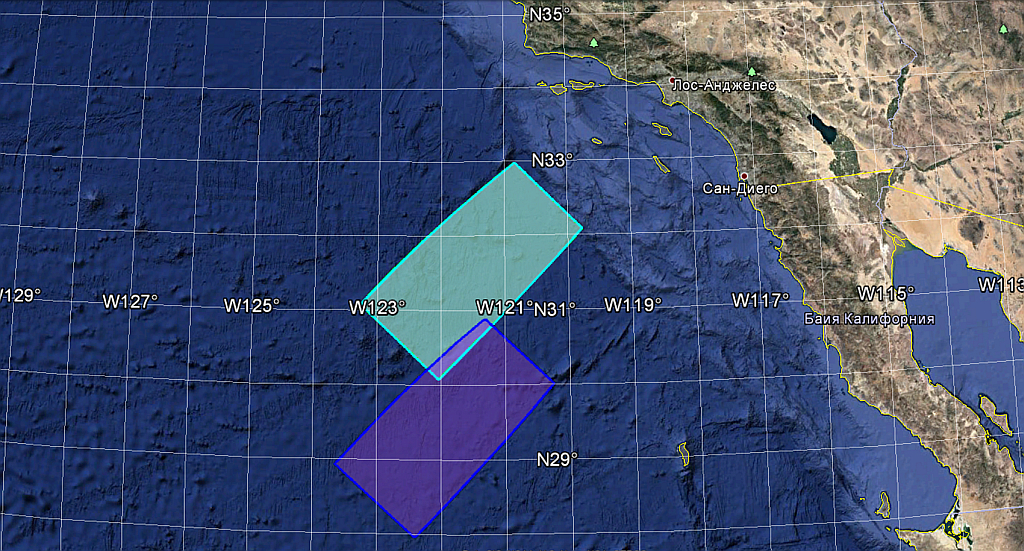
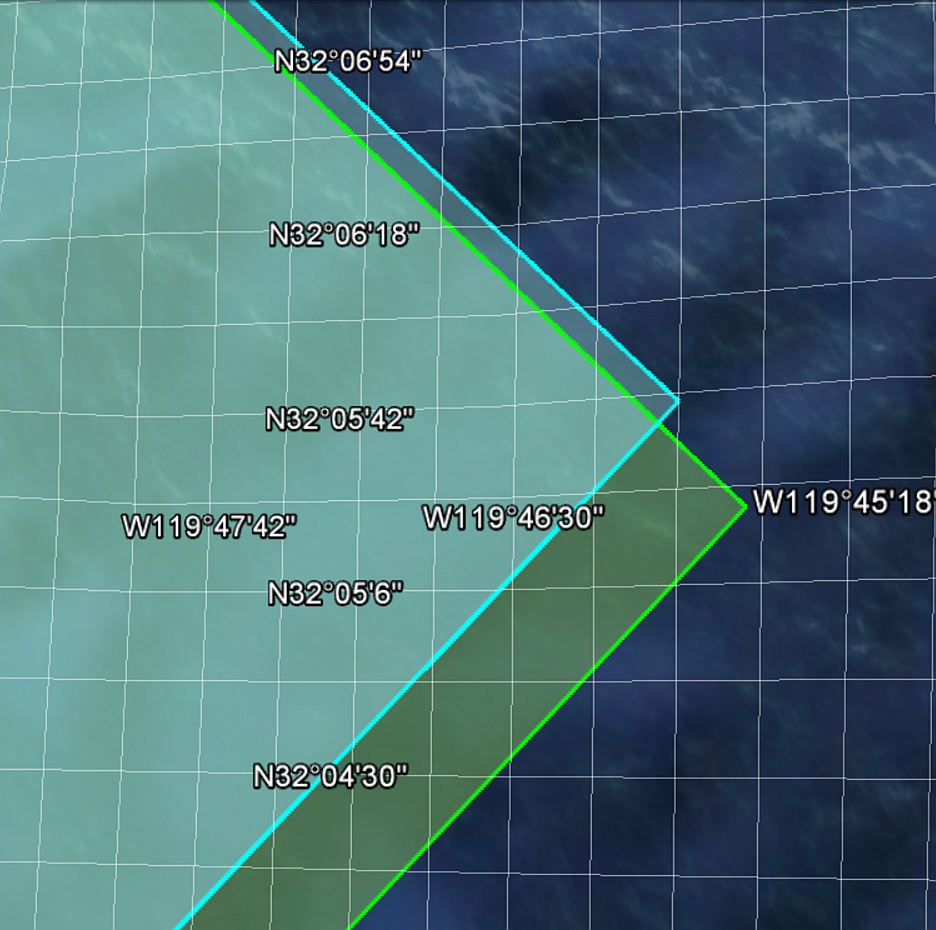
NOTAMs KZAK 05/129 (A2217/19) - отрепетован в KZLA 05/130 (A1335/19), NOTMAR NAVAREA XII 192/2019 (A), NAVAREA XII 192/2019 (B)
Название: Dragon SpX-17 (CRS-17), OCO-3, STP-H6 - Falcon 9-071 (B1056.1) - CCAFS SLC-40 - NET 25.04.2019, 10:20 UTC
Отправлено: tnt22 от 02.06.2019 22:45:19
Отправлено: tnt22 от 02.06.2019 22:45:19
ЦитироватьRoyce Renfrew @Tungsten_Flight (https://twitter.com/Tungsten_Flight) 2 ч. назад (https://twitter.com/Tungsten_Flight/status/1135242498920468480)
Packing day on @Space_Station (https://twitter.com/Space_Station) Crew getting @SpaceX (https://twitter.com/SpaceX) #Dragon (https://twitter.com/hashtag/Dragon?src=hash) 17 ready for its return to Earth on 6/3. You can follow along http://www.nasa.gov/ntv (https://t.co/vDIZO4lNvq) from @NASA_Johnson (https://twitter.com/NASA_Johnson) starting at 10:45 CT
Название: Dragon SpX-17 (CRS-17), OCO-3, STP-H6 - Falcon 9-071 (B1056.1) - CCAFS SLC-40 - NET 25.04.2019, 10:20 UTC
Отправлено: tnt22 от 02.06.2019 23:37:42
Отправлено: tnt22 от 02.06.2019 23:37:42
ЦитироватьSpaceXПодлинная учетная запись @SpaceX (https://twitter.com/SpaceX) 11 мин. назад (https://twitter.com/SpaceX/status/1135280641493200896)
Last month, Dragon delivered 5,500 pounds of science and supplies to the @space_station (https://twitter.com/Space_Station). Having since completed its four-week stay, Dragon will depart tomorrow morning at about 9:00 a.m. PDTIntl. Space StationПодлинная учетная запись @Space_Station (https://twitter.com/Space_Station) 7 мин. назад (https://twitter.com/Space_Station/status/1135281746365206528)
There are six spaceships parked at the space station today. There will be five after the @SpaceX (https://twitter.com/SpaceX) #Dragon (https://twitter.com/hashtag/Dragon?src=hash) cargo ship departs Monday at 12:09pm ET. @NASA (https://twitter.com/NASA) TV begins its live coverage of Dragon's release tomorrow at 11:45am. https://www.nasa.gov/live (https://t.co/yuOTrZ4Jut)
Название: Dragon SpX-17 (CRS-17), OCO-3, STP-H6 - Falcon 9-071 (B1056.1) - CCAFS SLC-40 - NET 25.04.2019, 10:20 UTC
Отправлено: tnt22 от 03.06.2019 01:25:50
Отправлено: tnt22 от 03.06.2019 01:25:50
https://www.militarynews.ru/story.asp?rid=1&nid=509422&lang=RU (https://www.militarynews.ru/story.asp?rid=1&nid=509422&lang=RU)
ЦитироватьАмериканский космический корабль в понедельник должен отстыковаться от МКС и вернуться на Землю
03.06.2019 0:02:36
Вашингтон. 3 июня. ИНТЕРФАКС - Грузовой космический корабль Cargo Dragon американской компании SpaceX в понедельник должен расстыковаться с Международной космической станцией (МКС) и затем после схождения с орбиты совершить приводнение у побережья Калифорнии в Тихом океане, сообщило Национальное управление по аэронавтике и исследованию космического пространства США (NASA).
По данным американского космического агентства, приводнение спускаемого аппарата планируется в Тихом океане в 325 км от города Лонг-Бич. "Грузовик" доставит на Землю более 1,9 тонн груза, в том числе результаты ценных научных экспериментов, проведённых на МКС. Контролировать процесс расстыковки будет член экипажа МКС канадский астронавт Давид Сен-Жак
Отстыковка грузового корабля от американского сегмента МКС - модуля Harmony будет осуществлена с помощью 17-метровой руки-манипулятора Canadarm-2, которая после отвода "грузовика" на безопасное расстояние от станции выпустит его для последующего схода с орбиты.Спойлер
Как сообщалось, выведенный на орбиту 4 мая ракетой-носителем Falcon 9 компании SpaceX грузовой космический корабль Cargo Dragon через два дня успешно состыковался с МКС.
Он доставил на станцию около 2,5 тонн груза, в том числе продовольствие, а также оборудование и материалы для проведения десятков научных исследований.
Это уже 17-й по счету полет Cargo Dragon к МКС в рамках коммерческого контракта между NASA и американской компанией SpaceX, которой принадлежит ракета-носитель и автоматический грузовой космический корабль.
После того, как Cargo Dragon покинет МКС, к ней останутся пристыкованными американский "грузовик" Cygnus корпорации Northrop Grumman, два российских грузовых корабля "Прогресс" и два пилотируемых корабля "Союз".
В настоящее время экипаж МКС состоит из российских космонавтов Олега Кононенко и Алексея Овчинина, американских астронавтов Энн Макклейн, Кристины Кох и Ника Хейга и канадского астронавта Давида Сен-Жака.[свернуть]
Название: Dragon SpX-17 (CRS-17), OCO-3, STP-H6 - Falcon 9-071 (B1056.1) - CCAFS SLC-40 - NET 25.04.2019, 10:20 UTC
Отправлено: tnt22 от 03.06.2019 18:42:32
Отправлено: tnt22 от 03.06.2019 18:42:32
Название: Dragon SpX-17 (CRS-17), OCO-3, STP-H6 - Falcon 9-071 (B1056.1) - CCAFS SLC-40 - NET 25.04.2019, 10:20 UTC
Отправлено: tnt22 от 03.06.2019 18:50:12
Отправлено: tnt22 от 03.06.2019 18:50:12
https://blogs.nasa.gov/spacestation/2019/06/03/u-s-cargo-craft-poised-to-depart-station-and-return-to-earth/
ЦитироватьU.S. Cargo Craft Poised to Depart Station and Return to Earth
Mark Garcia (https://blogs.nasa.gov/spacestation/author/magarcia/)
Posted Jun 3, 2019 at 11:43 am(https://flic.kr/p/2eqLFqi)
The SpaceX Dragon cargo craft arrived at the International Space Station May 6, 2019 and was captured with the Canadarm2 robotic arm.
NASA Television (https://www.nasa.gov/nasatv) coverage is now underway for departure of the SpaceX Dragon (https://www.nasa.gov/spacex) spacecraft from the International Space Station (https://www.nasa.gov/station). The spacecraft is scheduled for release at 12:09 p.m. EDT.
Dragon was detached from the Earth-facing port of the Harmony module (https://www.nasa.gov/mission_pages/station/structure/elements/harmony) at 8:30 a.m. after flight controllers at mission control in Houston delivered remote commands to the station's Canadarm2 robotic arm (https://www.nasa.gov/mission_pages/station/structure/elements/mobile-servicing-system.html). Expedition 59 Flight Engineer David Saint-Jacques (http://www.asc-csa.gc.ca/eng/astronauts/canadian/active/bio-david-saint-jacques.asp) of the Canadian Space Agency will back up the operation and monitor Dragon's systems as it departs the orbital laboratory.
After firing its thrusters to move a safe distance away from the station, Dragon will execute a deorbit burn around 4:56 p.m. to leave orbit, as it heads for a parachute-assisted splashdown in the Pacific Ocean, 202 miles southwest of Long Beach, California, at approximately 5:48 p.m. (2:48 p.m. PDT). There will be no live coverage of deorbit burn or splashdown.
Dragon launched on the SpaceX Falcon 9 rocket May 4 (https://blogs.nasa.gov/spacex/2019/05/04/liftoff-spacex-crs-17-on-its-way-to-the-space-station/) from Space Launch Complex 40 at Cape Canaveral Air Force Station in Florida, and arrived at the station two days later (https://blogs.nasa.gov/spacestation/2019/05/06/astronaut-commands-robotic-arm-to-capture-dragon-cargo-craft/) with almost 5,500 pounds of science, supplies and cargo on SpaceX's 17th commercial resupply mission to the station for NASA.
Название: Dragon SpX-17 (CRS-17), OCO-3, STP-H6 - Falcon 9-071 (B1056.1) - CCAFS SLC-40 - NET 25.04.2019, 10:20 UTC
Отправлено: tnt22 от 03.06.2019 18:54:39
Отправлено: tnt22 от 03.06.2019 18:54:39
Название: Dragon SpX-17 (CRS-17), OCO-3, STP-H6 - Falcon 9-071 (B1056.1) - CCAFS SLC-40 - NET 25.04.2019, 10:20 UTC
Отправлено: tnt22 от 03.06.2019 18:54:59
Отправлено: tnt22 от 03.06.2019 18:54:59
Название: Dragon SpX-17 (CRS-17), OCO-3, STP-H6 - Falcon 9-071 (B1056.1) - CCAFS SLC-40 - NET 25.04.2019, 10:20 UTC
Отправлено: tnt22 от 03.06.2019 18:57:59
Отправлено: tnt22 от 03.06.2019 18:57:59
Название: Dragon SpX-17 (CRS-17), OCO-3, STP-H6 - Falcon 9-071 (B1056.1) - CCAFS SLC-40 - NET 25.04.2019, 10:20 UTC
Отправлено: tnt22 от 03.06.2019 18:58:20
Отправлено: tnt22 от 03.06.2019 18:58:20
Название: Dragon SpX-17 (CRS-17), OCO-3, STP-H6 - Falcon 9-071 (B1056.1) - CCAFS SLC-40 - NET 25.04.2019, 10:20 UTC
Отправлено: tnt22 от 03.06.2019 19:03:04
Отправлено: tnt22 от 03.06.2019 19:03:04
ЦитироватьChris B - NSF @NASASpaceflight (https://twitter.com/NASASpaceflight) 4 мин. назад (https://twitter.com/NASASpaceflight/status/1135576431487004673)
David told GO for release at the top of the hour.
Название: Dragon SpX-17 (CRS-17), OCO-3, STP-H6 - Falcon 9-071 (B1056.1) - CCAFS SLC-40 - NET 25.04.2019, 10:20 UTC
Отправлено: tnt22 от 03.06.2019 19:08:30
Отправлено: tnt22 от 03.06.2019 19:08:30
Освобождён
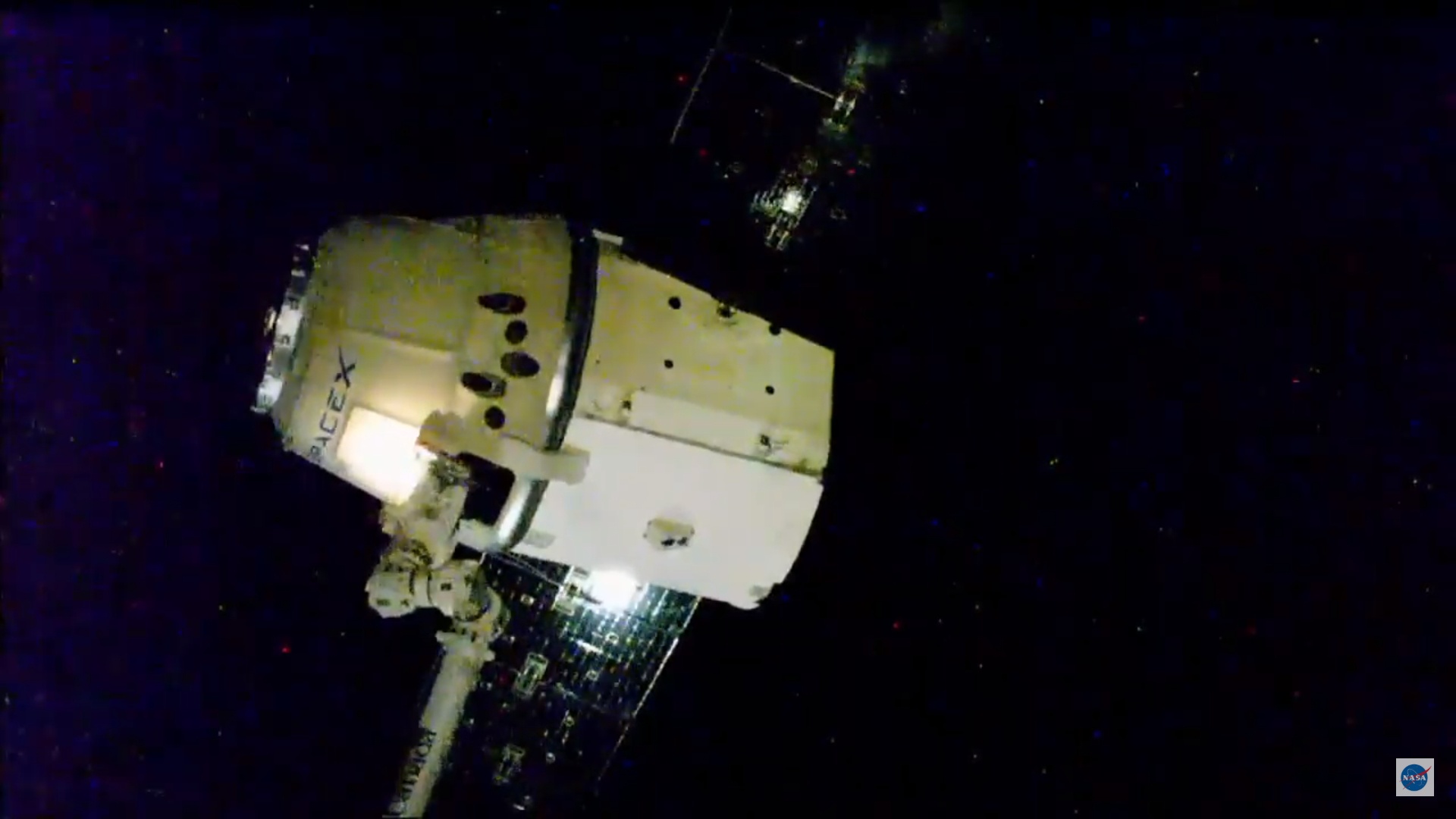


Название: Dragon SpX-17 (CRS-17), OCO-3, STP-H6 - Falcon 9-071 (B1056.1) - CCAFS SLC-40 - NET 25.04.2019, 10:20 UTC
Отправлено: tnt22 от 03.06.2019 19:15:31
Отправлено: tnt22 от 03.06.2019 19:15:31
Название: Dragon SpX-17 (CRS-17), OCO-3, STP-H6 - Falcon 9-071 (B1056.1) - CCAFS SLC-40 - NET 25.04.2019, 10:20 UTC
Отправлено: tnt22 от 03.06.2019 19:17:05
Отправлено: tnt22 от 03.06.2019 19:17:05
Название: Dragon SpX-17 (CRS-17), OCO-3, STP-H6 - Falcon 9-071 (B1056.1) - CCAFS SLC-40 - NET 25.04.2019, 10:20 UTC
Отправлено: tnt22 от 03.06.2019 19:17:44
Отправлено: tnt22 от 03.06.2019 19:17:44
Название: Dragon SpX-17 (CRS-17), OCO-3, STP-H6 - Falcon 9-071 (B1056.1) - CCAFS SLC-40 - NET 25.04.2019, 10:20 UTC
Отправлено: tnt22 от 03.06.2019 19:20:10
Отправлено: tnt22 от 03.06.2019 19:20:10
https://spaceflightnow.com/2019/06/03/dragon-crs-17-return/
Цитировать06/03/2019 19:07 Stephen Clark
Dragon is now flying on its own, having been released from the grasp of the space station robotic arm at 11:01 a.m. EDT (1601 GMT) as the craft flew at an altitude of around 259 miles over Myanmar.
Название: Dragon SpX-17 (CRS-17), OCO-3, STP-H6 - Falcon 9-071 (B1056.1) - CCAFS SLC-40 - NET 25.04.2019, 10:20 UTC
Отправлено: tnt22 от 03.06.2019 19:21:51
Отправлено: tnt22 от 03.06.2019 19:21:51
Цитировать06/03/2019 19:08 Stephen Clark
The robotic arm has backed away to a distance of more than 10 feet. The first of three rocket burns to guide Dragon away from the space station is complete.
Название: Dragon SpX-17 (CRS-17), OCO-3, STP-H6 - Falcon 9-071 (B1056.1) - CCAFS SLC-40 - NET 25.04.2019, 10:20 UTC
Отправлено: tnt22 от 03.06.2019 19:22:38
Отправлено: tnt22 от 03.06.2019 19:22:38
Цитировать06/03/2019 19:10 Stephen Clark
The Dragon spacecraft has finished its second departure burn. A yaw maneuver is coming up next, then a final departure maneuver is planned about a minute later.
Название: Dragon SpX-17 (CRS-17), OCO-3, STP-H6 - Falcon 9-071 (B1056.1) - CCAFS SLC-40 - NET 25.04.2019, 10:20 UTC
Отправлено: tnt22 от 03.06.2019 19:23:20
Отправлено: tnt22 от 03.06.2019 19:23:20
Цитировать06/03/2019 19:15 Stephen Clark
Dragon's third and final departure burn is complete, moving the craft beyond the 200-meter keep-out sphere, an imaginary bubble around the space station.
Название: Dragon SpX-17 (CRS-17), OCO-3, STP-H6 - Falcon 9-071 (B1056.1) - CCAFS SLC-40 - NET 25.04.2019, 10:20 UTC
Отправлено: tnt22 от 03.06.2019 19:32:51
Отправлено: tnt22 от 03.06.2019 19:32:51
Название: Dragon SpX-17 (CRS-17), OCO-3, STP-H6 - Falcon 9-071 (B1056.1) - CCAFS SLC-40 - NET 25.04.2019, 10:20 UTC
Отправлено: tnt22 от 03.06.2019 19:34:19
Отправлено: tnt22 от 03.06.2019 19:34:19
Название: Dragon SpX-17 (CRS-17), OCO-3, STP-H6 - Falcon 9-071 (B1056.1) - CCAFS SLC-40 - NET 25.04.2019, 10:20 UTC
Отправлено: tnt22 от 03.06.2019 19:35:28
Отправлено: tnt22 от 03.06.2019 19:35:28
ЦитироватьSpaceXПодлинная учетная запись @SpaceX (https://twitter.com/SpaceX) 18 мин. назад (https://twitter.com/SpaceX/status/1135580812613578752)
The three departure burns to move Dragon away from the @Space_Station (https://twitter.com/Space_Station) are complete.
Название: Dragon SpX-17 (CRS-17), OCO-3, STP-H6 - Falcon 9-071 (B1056.1) - CCAFS SLC-40 - NET 25.04.2019, 10:20 UTC
Отправлено: tnt22 от 03.06.2019 19:36:59
Отправлено: tnt22 от 03.06.2019 19:36:59
ЦитироватьSpaceXПодлинная учетная запись @SpaceX (https://twitter.com/SpaceX) 17 мин. назад (https://twitter.com/SpaceX/status/1135581061616766981)
Dragon will re-enter Earth's atmosphere in ~5 hours. Pacific Ocean splashdown around 2:50 p.m. PDT
Название: Dragon SpX-17 (CRS-17), OCO-3, STP-H6 - Falcon 9-071 (B1056.1) - CCAFS SLC-40 - NET 25.04.2019, 10:20 UTC
Отправлено: tnt22 от 03.06.2019 19:42:39
Отправлено: tnt22 от 03.06.2019 19:42:39
НАСА завершила трансляцию отстыковки Дракона 
Название: Dragon SpX-17 (CRS-17), OCO-3, STP-H6 - Falcon 9-071 (B1056.1) - CCAFS SLC-40 - NET 25.04.2019, 10:20 UTC
Отправлено: tnt22 от 03.06.2019 19:43:04
Отправлено: tnt22 от 03.06.2019 19:43:04
https://blogs.nasa.gov/spacestation/2019/06/03/dragon-resupply-ship-leaves-station-heads-for-pacific-splashdown/
ЦитироватьDragon Resupply Ship Leaves Station, Heads for Pacific Splashdown
Mark Garcia (https://blogs.nasa.gov/spacestation/author/magarcia/)
Posted Jun 3, 2019 at 12:07 pm
The SpaceX Dragon resupply ship is in the grips of the Canadarm2 robotic arm moments before its release from the International pace Station.
The SpaceX Dragon (https://www.nasa.gov/spacex) cargo spacecraft released from the International Space Station (https://www.nasa.gov/station) at 12:01 p.m. EDT after flight controllers in Houston delivered remote commands to the station's Canadarm2 robotic arm. Expedition 59 Flight Engineer David Saint-Jacques of the Canadian Space Agency monitored Dragon's systems as it departed the microgravity laboratory.
Next up, Dragon will fire its thrusters to move a safe distance from the station and execute a deorbit burn around 4:56 p.m. to leave orbit. Splashdown down is targeted for approximately 5:55 p.m. EDT (2:55 p.m. PDT).
Название: Dragon SpX-17 (CRS-17), OCO-3, STP-H6 - Falcon 9-071 (B1056.1) - CCAFS SLC-40 - NET 25.04.2019, 10:20 UTC
Отправлено: tnt22 от 03.06.2019 19:46:41
Отправлено: tnt22 от 03.06.2019 19:46:41
ЦитироватьRoyce Renfrew @Tungsten_Flight (https://twitter.com/Tungsten_Flight) 4 ч. назад (https://twitter.com/Tungsten_Flight/status/1135531115576348677)
Release the #Dragon (https://twitter.com/hashtag/Dragon?src=hash). @SpaceX (https://twitter.com/SpaceX) 17 returns to Earth today. Prime team coming on console lead by @Astro_TJ (https://twitter.com/Astro_TJ) Follow here in a few hours http://www.nasa.gov/ntv (https://t.co/vDIZO4lNvq)
@NASA_Johnson (https://twitter.com/NASA_Johnson) @Space_Station (https://twitter.com/Space_Station)
Название: Dragon SpX-17 (CRS-17), OCO-3, STP-H6 - Falcon 9-071 (B1056.1) - CCAFS SLC-40 - NET 25.04.2019, 10:20 UTC
Отправлено: tnt22 от 03.06.2019 19:47:58
Отправлено: tnt22 от 03.06.2019 19:47:58
ЦитироватьRoyce Renfrew @Tungsten_Flight (https://twitter.com/Tungsten_Flight) 3 ч. назад (https://twitter.com/Tungsten_Flight/status/1135542912517697536)
The @Space_Station (https://twitter.com/Space_Station) icon on the side of the #Dragon (https://twitter.com/hashtag/Dragon?src=hash) capsule means this capsule has already visited ISS once.
@NASA_Johnson (https://twitter.com/NASA_Johnson)
Название: Dragon SpX-17 (CRS-17), OCO-3, STP-H6 - Falcon 9-071 (B1056.1) - CCAFS SLC-40 - NET 25.04.2019, 10:20 UTC
Отправлено: tnt22 от 03.06.2019 19:50:02
Отправлено: tnt22 от 03.06.2019 19:50:02
ЦитироватьRoyce Renfrew @Tungsten_Flight (https://twitter.com/Tungsten_Flight) 37 мин. назад (https://twitter.com/Tungsten_Flight/status/1135579724783149058)
Y'all come back now, hear? @SpaceX (https://twitter.com/SpaceX) #Dragon (https://twitter.com/hashtag/Dragon?src=hash) jettisoned ISS and is heading back to Earth.
@NASA_Johnson (https://twitter.com/NASA_Johnson) @Space_Station (https://twitter.com/Space_Station)
Название: Dragon SpX-17 (CRS-17), OCO-3, STP-H6 - Falcon 9-071 (B1056.1) - CCAFS SLC-40 - NET 25.04.2019, 10:20 UTC
Отправлено: tnt22 от 03.06.2019 19:58:22
Отправлено: tnt22 от 03.06.2019 19:58:22
https://tass.ru/kosmos/6503288
Цитировать3 ИЮН, 19:11 Обновлено 19:48
Грузовой корабль Dragon отошел от МКС
По расчетам в 17:55 (00:55 мск 4 июня) корабль с помощью парашютной системы приводнится в Тихом океане
НЬЮ-ЙОРК, 3 июня. /ТАСС/. Грузовой корабль Dragon американской компании SpaceX в понедельник расстыковался с Международной космической станцией (МКС). Прямая трансляция с борта МКС шла на сайте NASA (https://www.nasa.gov/).
Корабль с помощью дистанционного манипулятора Canadarm был отведен от станции на расстояние 10 метров. В 12:01 (19:01 мск) по времени восточного побережья США была отдана команда на отделение корабля от захвата дистанционного манипулятора. После отвода манипулятора от корабля последовала команда на включение двигателя для начала маневра схода с орбиты. Первые два включения двигателей продолжались около трех секунд, третье включение - 22 секунды.
По расчетам, в 17:55 (00:55 мск) корабль с помощью парашютной системы приводнится в Тихом океане примерно в 325 км к юго-востоку от города Лонг-Бич (штат Калифорния). Он доставит на Землю 1902 кг полезного груза, в том числе - результаты научных экспериментов, проводимых на борту МКС.Спойлер
4 мая SpaceX осуществила запуск ракеты-носителя Falcon-9 с кораблем Dragon с грузом, предназначенным для экипажа МКС. Это 17-й коммерческий полет с целью снабжения МКС, выполняемый SpaceX по заказу NASA. Dragon доставил на станцию более 2,5 тонны грузов - продовольствие, оборудование и материалы для проведения нескольких десятков научных экспериментов, запланированных на период экспедиции МКС-59/60.
Сейчас в составе экипажа МКС работают россияне Олег Кононенко и Алексей Овчинин, американцы Энн Макклейн, Кристина Кох, Ник Хейг и канадец Давид Сен-Жак.[свернуть]
Название: Dragon SpX-17 (CRS-17), OCO-3, STP-H6 - Falcon 9-071 (B1056.1) - CCAFS SLC-40 - NET 25.04.2019, 10:20 UTC
Отправлено: tnt22 от 03.06.2019 20:04:51
Отправлено: tnt22 от 03.06.2019 20:04:51
ЦитироватьNASA | SpaceX (CRS-17) Dragon Disconnects from ISS with Robotic Armhttps://www.youtube.com/watch?v=AVCZChnPTEEhttps://www.youtube.com/watch?v=AVCZChnPTEE (https://www.youtube.com/watch?v=AVCZChnPTEE) (22:19)
space googlevesaire (https://www.youtube.com/channel/UC6Iv92nZE21XWt0B1ZTCd6Q)
Опубликовано: 3 июн. 2019 г.
Название: Dragon SpX-17 (CRS-17), OCO-3, STP-H6 - Falcon 9-071 (B1056.1) - CCAFS SLC-40 - NET 25.04.2019, 10:20 UTC
Отправлено: tnt22 от 03.06.2019 20:06:43
Отправлено: tnt22 от 03.06.2019 20:06:43
ЦитироватьNASA | SpaceX (CRS-17) Dragon has received a turn position with the help of the robotic armhttps://www.youtube.com/watch?v=CxPEJVkwTfkhttps://www.youtube.com/watch?v=CxPEJVkwTfk (https://www.youtube.com/watch?v=CxPEJVkwTfk) (21:09)
space googlevesaire (https://www.youtube.com/channel/UC6Iv92nZE21XWt0B1ZTCd6Q)
Опубликовано: 3 июн. 2019 г.
Название: Dragon SpX-17 (CRS-17), OCO-3, STP-H6 - Falcon 9-071 (B1056.1) - CCAFS SLC-40 - NET 25.04.2019, 10:20 UTC
Отправлено: tnt22 от 03.06.2019 20:09:18
Отправлено: tnt22 от 03.06.2019 20:09:18
ЦитироватьSpaceX CRS-17: Dragon unberthing and departurehttps://www.youtube.com/watch?v=E22rNzrjzxshttps://www.youtube.com/watch?v=E22rNzrjzxs (https://www.youtube.com/watch?v=E22rNzrjzxs) (4:45)
SciNews (https://www.youtube.com/channel/UCjU6ZwoTQtKWfz1urL7XcbA)
Опубликовано: 3 июн. 2019 г.
Название: Dragon SpX-17 (CRS-17), OCO-3, STP-H6 - Falcon 9-071 (B1056.1) - CCAFS SLC-40 - NET 25.04.2019, 10:20 UTC
Отправлено: tnt22 от 03.06.2019 22:53:53
Отправлено: tnt22 от 03.06.2019 22:53:53
ЦитироватьChris B - NSF @NASASpaceflight (https://twitter.com/NASASpaceflight) 4 ч. назад (https://twitter.com/NASASpaceflight/status/1135577917935820800)
RELEASE! CRS-17 Dragon has been released by the SSRMS. Dragon departing for a return to Earth with splashdown in the Pacific Ocean.
ARTICLE:
https://www.nasaspaceflight.com/2019/06/crs-17-dragon-eom-homecoming/ ... (https://t.co/scytnHbQfr)
Название: Dragon SpX-17 (CRS-17), OCO-3, STP-H6 - Falcon 9-071 (B1056.1) - CCAFS SLC-40 - NET 25.04.2019, 10:20 UTC
Отправлено: tnt22 от 03.06.2019 23:03:26
Отправлено: tnt22 от 03.06.2019 23:03:26
ЦитироватьDragon Resupply Ship Leaves Station, Heads for Pacific Splashdownhttps://www.youtube.com/watch?v=XzDaOnTCMPwhttps://www.youtube.com/watch?v=XzDaOnTCMPw (https://www.youtube.com/watch?v=XzDaOnTCMPw) (1:00)
NASA Video (https://www.youtube.com/channel/UC_aP7p621ATY_yAa8jMqUVA)
Опубликовано: 3 июн. 2019 г.
The SpaceX Dragon was released from the station's Canadarm2 robotic arm at 12:01 p.m. EDT today. It will splashdown in the Pacific with about 4,200 pounds of cargo and research later this afternoon.
Название: Dragon SpX-17 (CRS-17), OCO-3, STP-H6 - Falcon 9-071 (B1056.1) - CCAFS SLC-40 - NET 25.04.2019, 10:20 UTC
Отправлено: tnt22 от 04.06.2019 00:30:00
Отправлено: tnt22 от 04.06.2019 00:30:00
ЦитироватьSpaceXПодлинная учетная запись @SpaceX (https://twitter.com/SpaceX) 14:19 PDT (https://twitter.com/SpaceX/status/1135657208618704896) - 3 июн. 2019 г.
Dragon's de-orbit burn is complete and its trunk has been jettisoned. Pacific Ocean splashdown in ~30 minutes.
Название: Dragon SpX-17 (CRS-17), OCO-3, STP-H6 - Falcon 9-071 (B1056.1) - CCAFS SLC-40 - NET 25.04.2019, 10:20 UTC
Отправлено: tnt22 от 04.06.2019 00:32:50
Отправлено: tnt22 от 04.06.2019 00:32:50
ЦитироватьChristina H KochПодлинная учетная запись @Astro_Christina (https://twitter.com/Astro_Christina) 3 ч. назад (https://twitter.com/Astro_Christina/status/1135614920676978693)
Caught a shot of #Dragon (https://twitter.com/hashtag/Dragon?src=hash) being maneuvered by the #canadarm2 (https://twitter.com/hashtag/canadarm2?src=hash) fr om its docking port to the position wh ere it got released earlier today. Can you guess what continent we were flying over?
Название: Dragon SpX-17 (CRS-17), OCO-3, STP-H6 - Falcon 9-071 (B1056.1) - CCAFS SLC-40 - NET 25.04.2019, 10:20 UTC
Отправлено: tnt22 от 04.06.2019 00:35:04
Отправлено: tnt22 от 04.06.2019 00:35:04
ЦитироватьDavid Saint-JacquesПодлинная учетная запись @Astro_DavidS (https://twitter.com/Astro_DavidS) 2 ч. назад (https://twitter.com/Astro_DavidS/status/1135633721430855680)
Yesterday we packed up and closed the hatch on the Dragon cargo capsule. Signed the traditional docking port sticker, as the main operator during Dragon capture a few weeks ago! #DareToExplore (https://twitter.com/hashtag/DareToExplore?src=hash)
Название: Dragon SpX-17 (CRS-17), OCO-3, STP-H6 - Falcon 9-071 (B1056.1) - CCAFS SLC-40 - NET 25.04.2019, 10:20 UTC
Отправлено: tnt22 от 04.06.2019 00:51:57
Отправлено: tnt22 от 04.06.2019 00:51:57
ЦитироватьSpaceXПодлинная учетная запись @SpaceX (https://twitter.com/SpaceX) 14:46 PDT (https://twitter.com/SpaceX/status/1135664048807170048) - 3 июн. 2019 г.
Dragon's drogue chutes deployed nominally
Название: Dragon SpX-17 (CRS-17), OCO-3, STP-H6 - Falcon 9-071 (B1056.1) - CCAFS SLC-40 - NET 25.04.2019, 10:20 UTC
Отправлено: tnt22 от 04.06.2019 00:53:06
Отправлено: tnt22 от 04.06.2019 00:53:06
ЦитироватьSpaceXПодлинная учетная запись @SpaceX (https://twitter.com/SpaceX) 14:47 PDT (https://twitter.com/SpaceX/status/1135664211286081536) - 3 июн. 2019 г.
Dragon's main parachutes have been deployed
Название: Dragon SpX-17 (CRS-17), OCO-3, STP-H6 - Falcon 9-071 (B1056.1) - CCAFS SLC-40 - NET 25.04.2019, 10:20 UTC
Отправлено: tnt22 от 04.06.2019 00:55:02
Отправлено: tnt22 от 04.06.2019 00:55:02
ЦитироватьSpaceXПодлинная учетная запись @SpaceX (https://twitter.com/SpaceX) 14:52 PDT (https://twitter.com/SpaceX/status/1135665584211865600) - 3 июн. 2019 г.
Good splashdown of Dragon confirmed, completing SpaceX's seventeenth resupply mission to and from the @Space_Station (https://twitter.com/Space_Station)!
Название: Dragon SpX-17 (CRS-17), OCO-3, STP-H6 - Falcon 9-071 (B1056.1) - CCAFS SLC-40 - NET 25.04.2019, 10:20 UTC
Отправлено: tnt22 от 04.06.2019 01:02:29
Отправлено: tnt22 от 04.06.2019 01:02:29
https://blogs.nasa.gov/spacestation/2019/06/03/dragon-completes-cargo-return-mission-with-splashdown-in-pacific/
ЦитироватьDragon Completes Cargo Return Mission with Splashdown in Pacific
Mark Garcia (https://blogs.nasa.gov/spacestation/author/magarcia/)
Posted Jun 3, 2019 at 5:54 pm(https://twitter.com/Astro_DavidS/status/1135633721430855680)
The SpaceX Dragon resupply ship is pictured moments before its release fr om the International Space Station's Canadarm2 robotic arm.
Credit: @Astro_DavidS (https://twitter.com/Astro_DavidS/status/1135633721430855680)
SpaceX (https://www.nasa.gov/spacex)'s Dragon cargo spacecraft splashed down in the Pacific Ocean at 5:48 p.m. EDT (2:48 p.m PDT), approximately 202 miles southwest of Long Beach, California, marking the end of the company's 17th contracted cargo resupply mission to the International Space Station (https://www.nasa.gov/mission_pages/station/main/index.html) for NASA. The spacecraft returned more than 4,200 pounds of valuable scientific experiments (https://www.nasa.gov/mission_pages/station/research/index.html) and other cargo.
Some of the scientific investigations Dragon returned to Earth include:
Observing Protein Crystal GrowthMicroalgae Biosynthesis in MicrogravityСпойлер
NASA's Biophysics-6 (https://www.nasa.gov/mission_pages/station/research/experiments/explorer/Investigation.html?#id=7743) experiment looks at the growth of two proteins of interest in cancer treatment and radiation protection. Scientists are using ground-based predictions and in-space X-ray crystallography to determine which proteins benefit from crystallization in microgravity, wh ere some proteins can grow larger and with fewer imperfections.[свернуть]Genes in SpaceСпойлер
Microalgae Biosynthesis in Microgravity (https://www.nasa.gov/mission_pages/station/research/experiments/explorer/Investigation.html?#id=7689) (MicroAlgae) studies the effects of microgravity on Haematococcus pluvialis, an algae capable of producing a powerful antioxidant, astaxanthin. It could provide a readily available dietary supplement to promote astronaut health on long-duration space exploration missions. A community college student and alumnae of the NASA Community College Aerospace Scholars (NCAS) program proposed the research, and NCAS is engaging community colleges across the U.S. to conduct ground studies for comparison to the in-orbit investigation.[свернуть]These are just a few of the hundreds of investigations aimed at keeping astronauts healthy during space travel and demonstrating technologies for future human and robotic exploration beyond low-Earth orbit, including missions to the Moon by 2024 and on to Mars. Space station research also provides opportunities for other U.S. government agencies, private industry, and academic and research institutions to conduct microgravity research that leads to new technologies, medical treatments, and products that improve life on Earth.Спойлер
On May 23, astronauts aboard the space station successfully edited DNA using CRISPR/Cas9 technology for the first time in space, working on the Genes in Space-6 (https://www.nasa.gov/mission_pages/station/research/experiments/explorer/Investigation.html?#id=7893) investigation. This milestone advances understanding of how DNA repair mechanisms function in space and supports better safeguards to protect space explorers from DNA damage. Genetic damage caused by cosmic radiation poses a serious risk to space travelers, especially those on long-duration missions to the Moon and Mars. CRISPR/Cas9 now joins a growing portfolio of molecular biology techniques available on the ISS National Lab (https://www.issnationallab.org/).[свернуть]
For more than 18 years, humans have lived and worked continuously aboard the International Space Station, advancing scientific knowledge and demonstrating new technologies, making research breakthroughs not possible on Earth that will enable long-duration human and robotic exploration into deep space. A global endeavor, more than 230 people from 18 countries have visited the unique microgravity laboratory that has hosted more than 2,500 research investigations from researchers in 106 countries.
Название: Dragon SpX-17 (CRS-17), OCO-3, STP-H6 - Falcon 9-071 (B1056.1) - CCAFS SLC-40 - NET 25.04.2019, 10:20 UTC
Отправлено: tnt22 от 04.06.2019 01:07:18
Отправлено: tnt22 от 04.06.2019 01:07:18
https://tass.ru/kosmos/6504070
Цитировать4 ИЮН, 01:00
Грузовой корабль Dragon приводнился в Тихом океане
Корабль доставил на Землю 1902 кг полезного груза, в том числе результаты научных экспериментов, проводимых на борту Международной космической станции
НЬЮ-ЙОРК, 4 июня. /ТАСС/. Грузовой корабль Dragon компании SpaceX, завершив очередную миссию по обслуживанию Международной космической станции (МКС), совершил в понедельник в 17:55 (00:55 вторника мск) приводнение в Тихом океане примерно в 325 км к юго-востоку от города Лонг-Бич (штат Калифорния). Об этом сообщила SpaceX.
"Благополучное приводнение Dragon подтверждено. 17-я миссия SpaceX к космической станции и обратно завершена!" - говорится в Twitter (https://twitter.com/SpaceX/status/1135665584211865600) компании.
Dragon доставил на Землю 1902 кг полезного груза, в том числе результаты научных экспериментов, проводимых на борту МКС.
Название: Dragon SpX-17 (CRS-17), OCO-3, STP-H6 - Falcon 9-071 (B1056.1) - CCAFS SLC-40 - NET 25.04.2019, 10:20 UTC
Отправлено: tnt22 от 04.06.2019 17:18:08
Отправлено: tnt22 от 04.06.2019 17:18:08
ЦитироватьSpaceXFleet Updates @SpaceXFleet (https://twitter.com/SpaceXFleet) 8 ч. назад (https://twitter.com/SpaceXFleet/status/1135795799525384192)
NRC Quest has recovered Dragon and is on the way to the Port of LA. The ship is reporting an ETA of 14:30 UTC, June 4th (8 hours from now!)
1 ч. назад (https://twitter.com/SpaceXFleet/status/1135897635594936322)
The ship is going to be a lot later then the reported ETA, which was for about 90 minutes from now. The ship is still 110km offshore.
Название: Dragon SpX-17 (CRS-17), OCO-3, STP-H6 - Falcon 9-071 (B1056.1) - CCAFS SLC-40 - NET 25.04.2019, 10:20 UTC
Отправлено: tnt22 от 04.06.2019 17:31:51
Отправлено: tnt22 от 04.06.2019 17:31:51
https://blogs.nasa.gov/stationreport/2019/06/03/iss-daily-summary-report-6032019/
ЦитироватьISS Daily Summary Report – 6/03/2019
SpaceX (SpX)-17 Departure:
Following yesterday's cargo transfer, Dragon egress and hatch closure operations, ground controllers successfully unberthed the vehicle from the Node 2 Nadir port at 7:25 AM CT. After a nominal release at 11:00 AM CT, Dragon completed a series of separation burns and is progressing towards a splashdown in the Pacific Ocean today at 4:50 PM CT.
Название: Dragon SpX-17 (CRS-17), OCO-3, STP-H6 - Falcon 9-071 (B1056.1) - CCAFS SLC-40 - NET 25.04.2019, 10:20 UTC
Отправлено: tnt22 от 04.06.2019 22:36:31
Отправлено: tnt22 от 04.06.2019 22:36:31
ЦитироватьIntl. Space StationПодлинная учетная запись @Space_Station (https://twitter.com/Space_Station) 2 ч. назад (https://twitter.com/Space_Station/status/1135961358585876480)
The @SpaceX (https://twitter.com/SpaceX) #Dragon (https://twitter.com/hashtag/Dragon?src=hash) cargo craft on its 17th contracted mission to resupply the station is pictured June 3, 2019, moments before being released from the Canadarm2 robotic arm.
https://flic.kr/s/aHskiJyhQX (https://t.co/N3bP9qnrJ4)
Название: Dragon SpX-17 (CRS-17), OCO-3, STP-H6 - Falcon 9-071 (B1056.1) - CCAFS SLC-40 - NET 25.04.2019, 10:20 UTC
Отправлено: tnt22 от 04.06.2019 22:37:31
Отправлено: tnt22 от 04.06.2019 22:37:31
ЦитироватьSpaceXПодлинная учетная запись @SpaceX (https://twitter.com/SpaceX) 38 мин. назад (https://twitter.com/SpaceX/status/1135984202678120448)
Dragon returns to Earth after its four-week stay at the @space_station (https://twitter.com/Space_Station), completing SpaceX's seventeenth flight to and from the ISS and sixth with a flight-proven spacecraft
Название: Dragon SpX-17 (CRS-17), OCO-3, STP-H6 - Falcon 9-071 (B1056.1) - CCAFS SLC-40 - NET 25.04.2019, 10:20 UTC
Отправлено: tnt22 от 04.06.2019 22:48:30
Отправлено: tnt22 от 04.06.2019 22:48:30
ЦитироватьPauline Acalin @w00ki33 (https://twitter.com/w00ki33) 2 ч. назад (https://twitter.com/w00ki33/status/1135961733116227584)
Interesting to see no cranes at Port of LA in anticipation of NRC Quest's supposed arrival today. The ship is currently rounding Catalina Island carrying SpaceX's Dragon capsule back from its CRS-17 mission. Looks pretty quiet. #spacex (https://twitter.com/hashtag/spacex?src=hash) #CRS17 (https://twitter.com/hashtag/CRS17?src=hash) #portofla (https://twitter.com/hashtag/portofla?src=hash)
2 ч. назад (https://twitter.com/w00ki33/status/1135963469906190336)
Dragon cargo container is waiting dockside. #spacex (https://twitter.com/hashtag/spacex?src=hash) #crs17 (https://twitter.com/hashtag/crs17?src=hash)
Название: Dragon SpX-17 (CRS-17), OCO-3, STP-H6 - Falcon 9-071 (B1056.1) - CCAFS SLC-40 - NET 25.04.2019, 10:20 UTC
Отправлено: tnt22 от 04.06.2019 22:50:44
Отправлено: tnt22 от 04.06.2019 22:50:44
ЦитироватьSpaceXFleet Updates @SpaceXFleet (https://twitter.com/SpaceXFleet) 14 мин. назад (https://twitter.com/SpaceXFleet/status/1135993488665993248)
NRC Quest and Dragon are inbound for the Port of LA.Pauline Acalin @w00ki33 (https://twitter.com/w00ki33) 8 мин. назад (https://twitter.com/w00ki33/status/1135994973352890368)
NRC Quest coming up the hazy Pacific coast heading to port carrying the Dragon capsule back from its CRS-17 mission. #spacex (https://twitter.com/hashtag/spacex?src=hash) #CRS17 (https://twitter.com/hashtag/CRS17?src=hash)
Название: Dragon SpX-17 (CRS-17), OCO-3, STP-H6 - Falcon 9-071 (B1056.1) - CCAFS SLC-40 - NET 25.04.2019, 10:20 UTC
Отправлено: tnt22 от 04.06.2019 23:12:30
Отправлено: tnt22 от 04.06.2019 23:12:30
ЦитироватьPauline Acalin @w00ki33 (https://twitter.com/w00ki33) 14 мин. назад (https://twitter.com/w00ki33/status/1135998537815252992)
And the crane has arrived last minute lolSpaceXFleet Updates @SpaceXFleet (https://twitter.com/SpaceXFleet) 10 мин.10 минут назад (https://twitter.com/SpaceXFleet/status/1135999551016525824)
ARRIVAL: NRC Quest has returned to the Port of LA with Dragon, only 22 hours after the capsule splashed-down in the Pacific Ocean.Matt Hartman @ShorealoneFilms (https://twitter.com/ShorealoneFilms) 3 мин. назад (https://twitter.com/ShorealoneFilms/status/1136001287877582848)
guess who's back! #NrcQuest (https://twitter.com/hashtag/NrcQuest?src=hash) #crs17 (https://twitter.com/hashtag/crs17?src=hash) #spacex (https://twitter.com/hashtag/spacex?src=hash)
Название: Dragon SpX-17 (CRS-17), OCO-3, STP-H6 - Falcon 9-071 (B1056.1) - CCAFS SLC-40 - NET 25.04.2019, 10:20 UTC
Отправлено: tnt22 от 04.06.2019 23:30:02
Отправлено: tnt22 от 04.06.2019 23:30:02
https://spaceflightnow.com/2019/06/03/dragon-capsule-returns-to-earth-from-space-station-with-2-1-tons-of-cargo/
ЦитироватьDragon capsule returns to Earth fr om space station with 2.1 tons of cargo
June 3, 2019 (https://spaceflightnow.com/2019/06/) | Stephen Clark (https://spaceflightnow.com/author/stephen-clark/)
SpaceX's Dragon cargo craft is grappled by the International Space Station's Canadian-built robotic arm before release Monday. Credit: David Saint-Jacques/CSA/NASA
Closing out a 30-day mission, a SpaceX Dragon cargo capsule departed the International Space Station on Monday for a fiery trip back to Earth, culminating in re-entry back into the atmosphere and a parachute-assisted splashdown in the Pacific Ocean southwest of Los Angeles.
The station's Canadian-built robotic arm pulled the Dragon spacecraft from its berthing port on the Harmony module early Monday, and ground controllers in Houston commanded the arm to release the supply ship at 12:01 p.m. EDT (1601 GMT). A series of three thruster firings by the Dragon's Draco control jets pushed the capsule away from the station, setting up for a deorbit burn nearly five hours later.
The deorbit burn set up the Dragon for re-entry, slowing the craft's velocity enough to dip into the atmosphere over the Pacific Ocean. Fitted with a protective heat shield, the capsule plunged back to Earth before deploying a series of parachutes to slow for splashdown in the Pacific Ocean around 202 miles (325 kilometers) southwest of Long Beach, California, at 5:48 p.m. EDT (2148 GMT; 2:48 p.m. PDT).
The unpiloted supply ship returned to Earth with more than 4,200 pounds (1,900 kilograms) of equipment.
SpaceX recovery teams were on station in the Pacific to hoist the capsule aboard a boat for the trip back to the Port of Los Angeles, wh ere time-sensitive human and animal research specimens will be turned over to science teams around the world.
The mission was SpaceX's 17th resupply flight to the space station under a $3.04 billion contract with NASA. The capsule arrived at the orbiting complex May 6, two days after a predawn launch from Cape Canaveral aboard a Falcon 9 rocket.
Cargo bags were packed inside the Dragon spacecraft's pressurized cabin before the capsule's departure Monday from the International Space Station. Credit: NASA
The automated Dragon cargo capsule delivered 5,472 pounds (2,482 kilograms) to the space station, including a $110 million NASA instrument mounted outside the space station to monitor carbon dioxide in Earth's atmosphere. The cargo mission also carried a payload package sponsored by the U.S. Air Force with experiments in X-ray communications, space-based supercomputing, plasma measurements, and attitude control and determination.
Before re-entering the atmosphere Monday, the Dragon jettisoned its unpressurized trunk to burn up during re-entry with a pair of decommissioned NASA instruments loaded into the external payload bay of the SpaceX cargo craft.Спойлер
NASA's Cloud-Aerosol Transport System, or CATS, instrument was fastened outside the space station after its delivery on a previous SpaceX cargo mission in January 2015. The CATS instrument measured clouds and tiny particles in the atmosphere that play a role in Earth's climate and weather.
NASA's SCaN Testbed experiment, which arrived at the station in 2012, was also tagged for disposal during re-entry of the Dragon's trunk Monday. During its mission, SCaN Testbed demonstrated the use of software-defined radios for space communications.
SpaceX is gearing up for its next resupply mission to the space station, which is set for launch from Cape Canaveral in July.
More photos from Monday's return of the Dragon spacecraft are posted below.
SpaceX's Dragon spacecraft perched on the end of the space station's robotic arm Monday. Credit: NASA
SpaceX's Dragon spacecraft perched on the end of the space station's robotic arm Monday. Credit: NASA
SpaceX's Dragon spacecraft perched on the end of the space station's robotic arm Monday. Credit: NASA
SpaceX's Dragon spacecraft perched on the end of the space station's robotic arm Monday. Credit: NASA
SpaceX's Dragon spacecraft was released from the space station's robotic arm Monday. Credit: NASA
The Dragon cargo craft was hoisted from the Pacific Ocean onto a SpaceX recovery ship. Credit: SpaceX[свернуть]
Название: Dragon SpX-17 (CRS-17), OCO-3, STP-H6 - Falcon 9-071 (B1056.1) - CCAFS SLC-40 - NET 25.04.2019, 10:20 UTC
Отправлено: tnt22 от 04.06.2019 23:34:07
Отправлено: tnt22 от 04.06.2019 23:34:07
ЦитироватьMatt Hartman @ShorealoneFilms (https://twitter.com/ShorealoneFilms) 9 мин. назад (https://twitter.com/ShorealoneFilms/status/1136005760956141571)
#CRS17 (https://twitter.com/hashtag/CRS17?src=hash) looking toasty! #SPACEX (https://twitter.com/hashtag/SPACEX?src=hash) #dragon (https://twitter.com/hashtag/dragon?src=hash)
Название: Dragon SpX-17 (CRS-17), OCO-3, STP-H6 - Falcon 9-071 (B1056.1) - CCAFS SLC-40 - NET 25.04.2019, 10:20 UTC
Отправлено: tnt22 от 04.06.2019 23:43:43
Отправлено: tnt22 от 04.06.2019 23:43:43
ЦитироватьPauline Acalin @w00ki33 (https://twitter.com/w00ki33) 1 мин. назад (https://twitter.com/w00ki33/status/1136010094200512512)
A quick peek into the tent as Dragon glided into port. #spacex (https://twitter.com/hashtag/spacex?src=hash) #crs17 (https://twitter.com/hashtag/crs17?src=hash)
Название: Dragon SpX-17 (CRS-17), OCO-3, STP-H6 - Falcon 9-071 (B1056.1) - CCAFS SLC-40 - NET 25.04.2019, 10:20 UTC
Отправлено: tnt22 от 05.06.2019 00:54:04
Отправлено: tnt22 от 05.06.2019 00:54:04
ЦитироватьPauline Acalin @w00ki33 (https://twitter.com/w00ki33) 1 мин. назад (https://twitter.com/w00ki33/status/1136027862039912448)
SpaceX's toasty Dragon has been lifted off NRC Quest at Port of LA. The capsule splashed down in the Pacific on Monday after spending the month at the International Space Station. Wow.
Название: Dragon SpX-17 (CRS-17), OCO-3, STP-H6 - Falcon 9-071 (B1056.1) - CCAFS SLC-40 - NET 25.04.2019, 10:20 UTC
Отправлено: tnt22 от 05.06.2019 21:12:03
Отправлено: tnt22 от 05.06.2019 21:12:03
ЦитироватьPauline Acalin @w00ki33 (https://twitter.com/w00ki33) 10 ч. назад (https://twitter.com/w00ki33/status/1136180221445492741)
A few more toasty shots of Dragon at Port of LA, freshly recovered from its stay at our orbiting science lab. Don't you just wanna touch it?
#spacex (https://twitter.com/hashtag/spacex?src=hash) #crs17 (https://twitter.com/hashtag/crs17?src=hash) #portoflosangeles (https://twitter.com/hashtag/portoflosangeles?src=hash)
Название: Dragon SpX-17 (CRS-17), OCO-3, STP-H6 - Falcon 9-071 (B1056.1) - CCAFS SLC-40 - NET 25.04.2019, 10:20 UTC
Отправлено: tnt22 от 07.06.2019 17:20:24
Отправлено: tnt22 от 07.06.2019 17:20:24
ЦитироватьSpace to Ground: Release the Dragon: 06/07/2019https://www.youtube.com/watch?v=mLQn0hI7CC0https://www.youtube.com/watch?v=mLQn0hI7CC0 (https://www.youtube.com/watch?v=mLQn0hI7CC0) (2:32)
NASA Johnson (https://www.youtube.com/channel/UCmheCYT4HlbFi943lpH009Q)
Опубликовано: 7 июн. 2019 г.
Название: Dragon SpX-17 (CRS-17), OCO-3, STP-H6 - Falcon 9-071 (B1056.1) - CCAFS SLC-40 - NET 25.04.2019, 10:20 UTC
Отправлено: tnt22 от 08.06.2019 00:10:41
Отправлено: tnt22 от 08.06.2019 00:10:41
Официальная запись отстыковки Дракона SpX-17
ЦитироватьSpaceX CRS-17 Dragon Release June 3, 2019https://www.youtube.com/watch?v=BTSy3_iXjiwhttps://www.youtube.com/watch?v=BTSy3_iXjiw (https://www.youtube.com/watch?v=BTSy3_iXjiw) (46:53)
NASA Video (https://www.youtube.com/channel/UC_aP7p621ATY_yAa8jMqUVA)
Опубликовано: 6 июн. 2019 г.
Название: Dragon SpX-17 (CRS-17), OCO-3, STP-H6 - Falcon 9-071 (B1056.1) - CCAFS SLC-40 - NET 25.04.2019, 10:20 UTC
Отправлено: tnt22 от 09.06.2019 09:35:06
Отправлено: tnt22 от 09.06.2019 09:35:06
https://www.roscosmos.ru/25915/#p25986
Расстыковка грузового корабля Dragon SpX-17 03.06.2019. Фото: Олег Кононенко / Роскосмос
Расстыковка грузового корабля Dragon SpX-17 03.06.2019. Фото: Олег Кононенко / Роскосмос
Цитировать(https://www.roscosmos.ru/media/gallery/big/25988/3562878448.jpg)
(https://www.roscosmos.ru/media/gallery/big/25988/3635224348.jpg)
(https://www.roscosmos.ru/media/gallery/big/25988/2427541889.jpg)
(https://www.roscosmos.ru/media/gallery/big/25988/4126004303.jpg)
(https://www.roscosmos.ru/media/gallery/big/25988/5699825228.jpg)
(https://www.roscosmos.ru/media/gallery/big/25988/5962469527.jpg)
(https://www.roscosmos.ru/media/gallery/big/25988/3631235992.jpg)
(https://www.roscosmos.ru/media/gallery/big/25988/4640013300.jpg)

